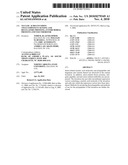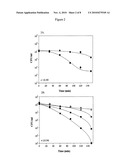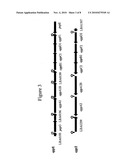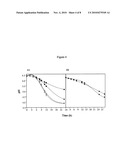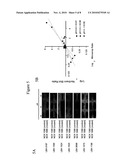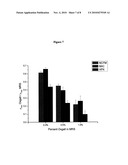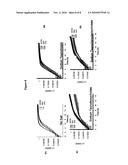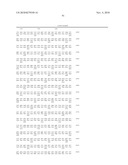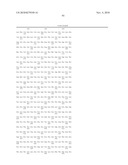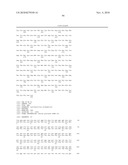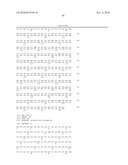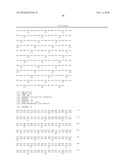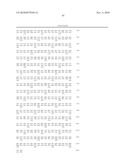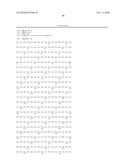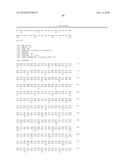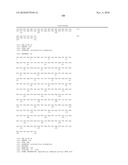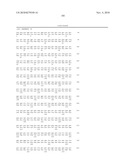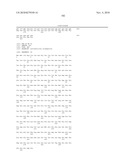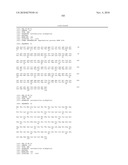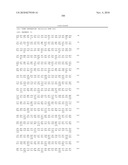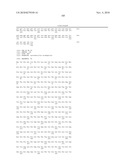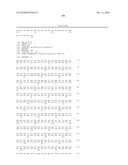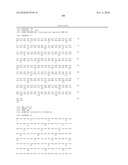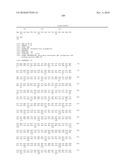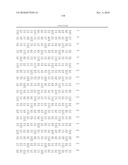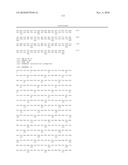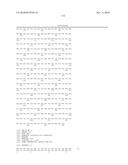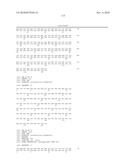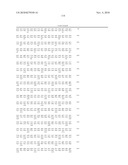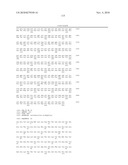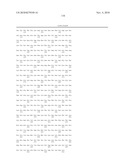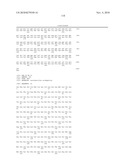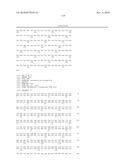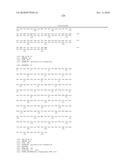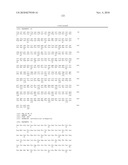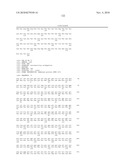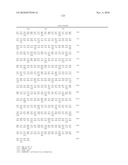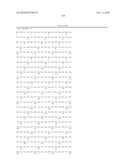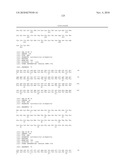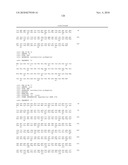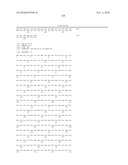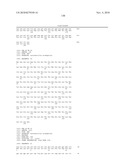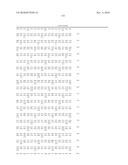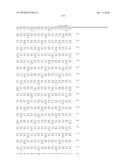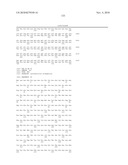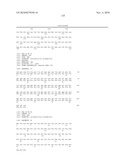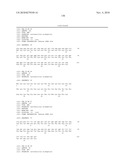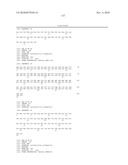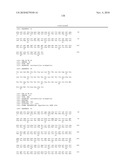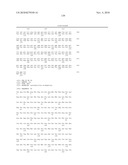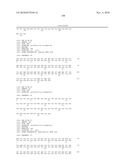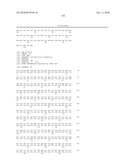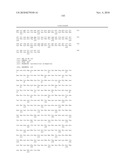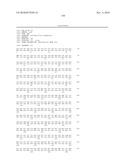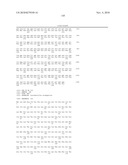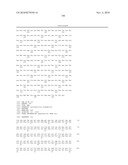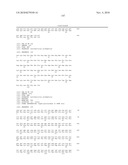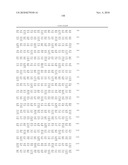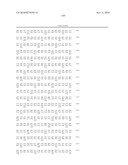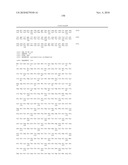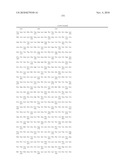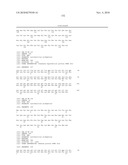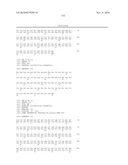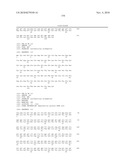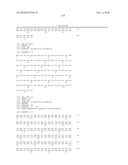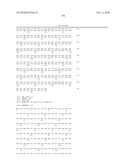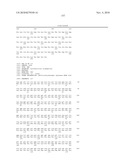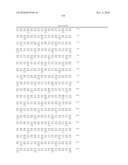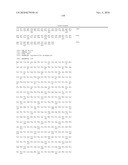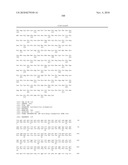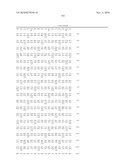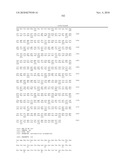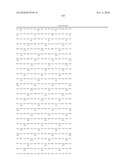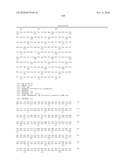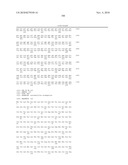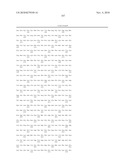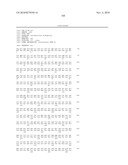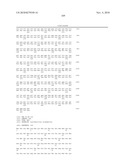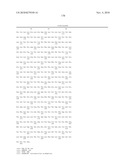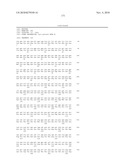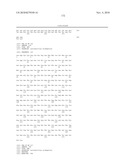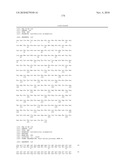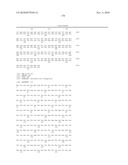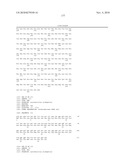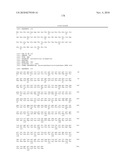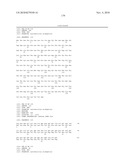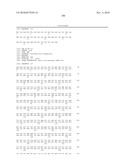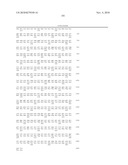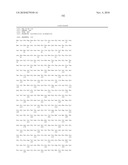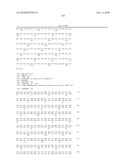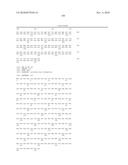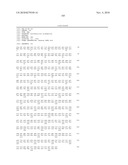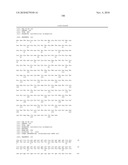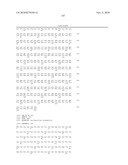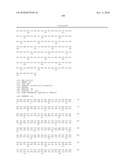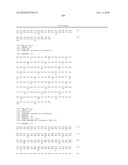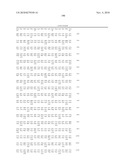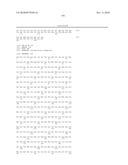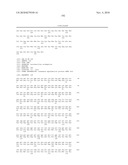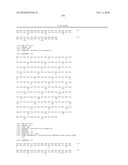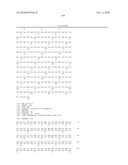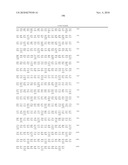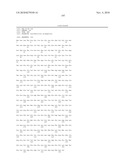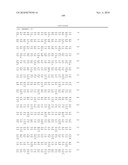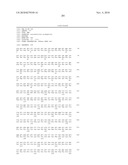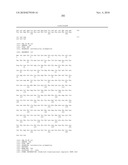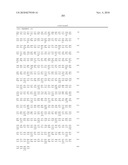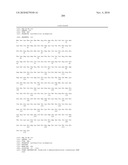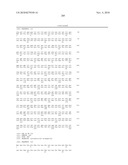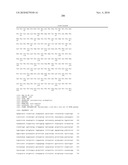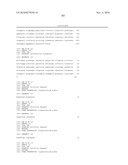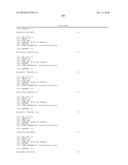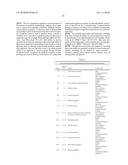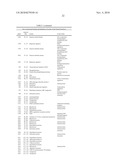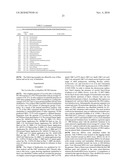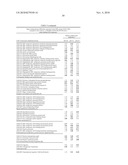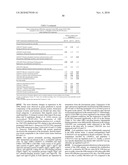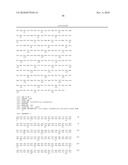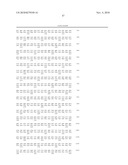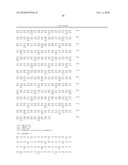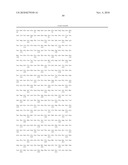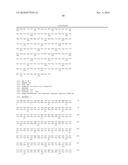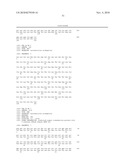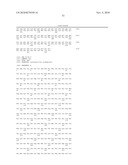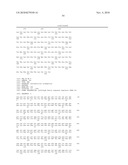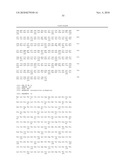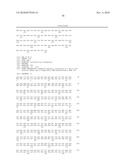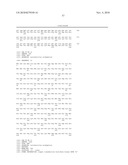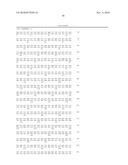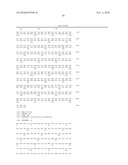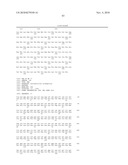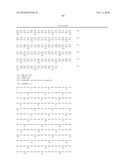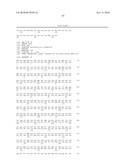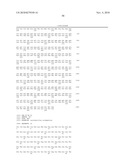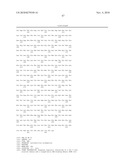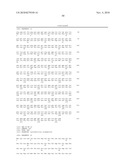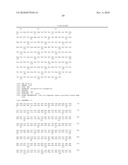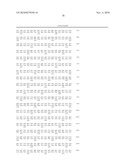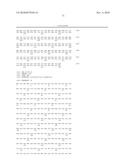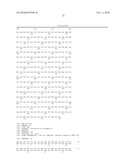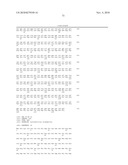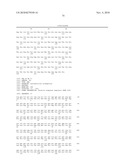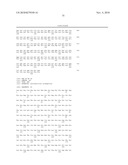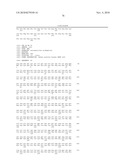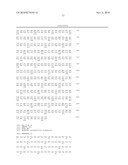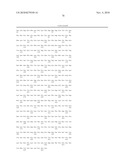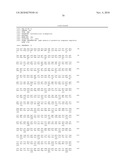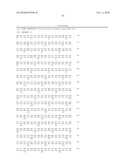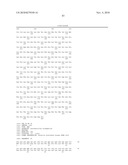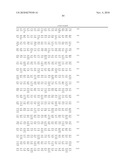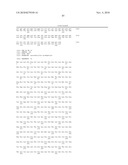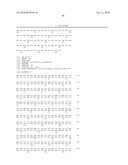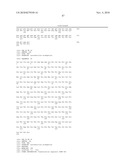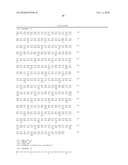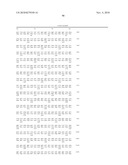Patent application title: NUCLEIC ACIDS ENCODING TWO-COMPONENT SENSING AND REGULATORY PROTEINS, ANTIMICROBIAL PROTEINS AND USES THEREFOR
Inventors:
Todd R. Klaenhammer (Raleigh, NC, US)
William M. Russell (Newburgh, IN, US)
Eric Altermann (Palmerston North, NZ)
Andrea Azcarate-Peril (Raleigh, NC, US)
Assignees:
NORTH CAROLINA STATE UNIVERSITY
IPC8 Class: AC12P2100FI
USPC Class:
435 691
Class name: Chemistry: molecular biology and microbiology micro-organism, tissue cell culture or enzyme using process to synthesize a desired chemical compound or composition recombinant dna technique included in method of making a protein or polypeptide
Publication date: 2010-11-04
Patent application number: 20100279349
Claims:
1. An isolated nucleic acid molecule comprising:a) a nucleic acid molecule
comprising the nucleotide sequence of SEQ ID NO:1, 3, 5, 7, 9, 11, 13,
15, 17, 19, 21, 23, 25, 27, 29, 31, 33, 35, 37, 49, 51 53, 73, 75, 77,
79, 81, 83, 85, 87, 89, 91, 93, 95, 97, 99, 101, 113, 115, 117, 119, 121,
123, 125, 127, 129, 143, 145, 147, 149, 151, 153, 155, 157, 159, 161 or
163;b) a nucleic acid molecule comprising a nucleotide sequence having at
least 80% sequence identity to the nucleotide sequence of SEQ ID NO:1, 3,
5, 7, 9, 11, 13, 15, 17, 19, 21, 23, 25, 27, 29, 31, 33, 35, 37, 49, 51
53, 73, 75, 77, 79, 81, 83, 85, 87, 89, 91, 93, 95, 97, 99, 101, 113,
115, 117, 119, 121, 123, 125, 127, 129, 143, 145, 147, 149, 151, 153,
155, 157, 159, 161 or 163;c) a nucleic acid molecule that encodes a
polypeptide comprising the amino acid sequence of SEQ ID NO:2, 4, 6, 8,
10, 12, 14, 16, 18, 20, 22, 24, 26, 28, 30, 32, 34, 36, 38, 50, 52, 54,
74, 76, 78, 80, 82, 84, 86, 88, 90, 92, 94, 96, 98, 100, 102, 114, 116,
118, 120, 122, 124, 126, 128, 130, 144, 146, 148, 150, 152, 154, 156,
158, 160, 162 or 164;d) a nucleic acid molecule comprising a nucleotide
sequence encoding a polypeptide having at least 80% amino acid sequence
identity to the amino acid sequence of SEQ ID NO:2, 4, 6, 8, 10, 12, 14,
16, 18, 20, 22, 24, 26, 28, 30, 32, 34, 36, 38, 50, 52, 54, 74, 76, 78,
80, 82, 84, 86, 88, 90, 92, 94, 96, 98, 100, 102, 114, 116, 118, 120,
122, 124, 126, 128, 130, 144, 146, 148, 150, 152, 154, 156, 158, 160, 162
or 164; ore) a complement of any of (a)-(d).
2. A vector comprising the nucleic acid molecule of claim 1.
3. The vector of claim 2, further comprising a nucleic acid molecule encoding a heterologous polypeptide.
4. A cell comprising the vector of claim 2.
5. The cell of claim 4 that is a bacterial cell.
6. An isolated polypeptide comprising:a) a polypeptide comprising the amino acid sequence of SEQ ID NO:2, 4, 6, 8, 10, 12, 14, 16, 18, 20, 22, 24, 26, 28, 30, 32, 34, 36, 38, 50, 52, 54, 74, 76, 78, 80, 82, 84, 86, 88, 90, 92, 94, 96, 98, 100, 102, 114, 116, 118, 120, 122, 124, 126, 128, 130, 144, 146, 148, 150, 152, 154, 156, 158, 160, 162 or 164;b) a polypeptide comprising an amino acid sequence having at least 80% sequence identity to the amino acid sequence of SEQ ID NO:2, 4, 6, 8, 10, 12, 14, 16, 18, 20, 22, 24, 26, 28, 30, 32, 34, 36, 38, 50, 52, 54, 74, 76, 78, 80, 82, 84, 86, 88, 90, 92, 94, 96, 98, 100, 102, 114, 116, 118, 120, 122, 124, 126, 128, 130, 144, 146, 148, 150, 152, 154, 156, 158, 160, 162 or 164, wherein said polypeptide retains activity;c) a polypeptide encoded by the nucleotide sequence of SEQ ID NO:1, 3, 5, 7, 9, 11, 13, 15, 17, 19, 21, 23, 25, 27, 29, 31, 33, 35, 37, 49, 51 53, 73, 75, 77, 79, 81, 83, 85, 87, 89, 91, 93, 95, 97, 99, 101, 113, 115, 117, 119, 121, 123, 125, 127, 129, 143, 145, 147, 149, 151, 153, 155, 157, 159, 161 or 163; ord) a polypeptide that is encoded by a nucleic acid molecule comprising a nucleotide sequence having at least 80% sequence identity to the nucleotide sequence of SEQ ID NO:1, 3, 5, 7, 9, 11, 13, 15, 17, 19, 21, 23, 25, 27, 29, 31, 33, 35, 37, 49, 51 53, 73, 75, 77, 79, 81, 83, 85, 87, 89, 91, 93, 95, 97, 99, 101, 113, 115, 117, 119, 121, 123, 125, 127, 129, 143, 145, 147, 149, 151, 153, 155, 157, 159, 161 or 163, wherein said polypeptide retains activity.
7. The polypeptide of claim 6, further comprising heterologous amino acid sequences.
8. An antibody that selectively binds to a polypeptide of claim 6.
9. A method for producing a polypeptide, comprising culturing the cell of claim 4 under conditions in which a nucleic acid molecule encoding the polypeptide is expressed, said polypeptide comprising:a) a polypeptide comprising the amino acid sequence of SEQ ID NO: 2, 4, 6, 8, 10, 12, 14, 16, 18, 20, 22, 24, 26, 28, 30, 32, 34, 36, 38, 50, 52, 54, 74, 76, 78, 80, 82, 84, 86, 88, 90, 92, 94, 96, 98, 100, 102, 114, 116, 118, 120, 122, 124, 126, 128, 130, 144, 146, 148, 150, 152, 154, 156, 158, 160, 162 or 164;b) a polypeptide encoded by the nucleic acid sequence of SEQ ID NO: 1, 3, 5, 7, 9, 11, 13, 15, 17, 19, 21, 23, 25, 27, 29, 31, 33, 35, 37, 49, 51 53, 73, 75, 77, 79, 81, 83, 85, 87, 89, 91, 93, 95, 97, 99, 101, 113, 115, 117, 119, 121, 123, 125, 127, 129, 143, 145, 147, 149, 151, 153, 155, 157, 159, 161 or 163;c) a polypeptide comprising an amino acid sequence having at least 80% sequence identity to the amino acid sequence of SEQ ID NO: 2, 4, 6, 8, 10, 12, 14, 16, 18, 20, 22, 24, 26, 28, 30, 32, 34, 36, 38, 50, 52, 54, 74, 76, 78, 80, 82, 84, 86, 88, 90, 92, 94, 96, 98, 100, 102, 114, 116, 118, 120, 122, 124, 126, 128, 130, 144, 146, 148, 150, 152, 154, 156, 158, 160, 162 or 164, wherein said polypeptide retains activity; ord) a polypeptide encoded by a nucleotide sequence having at least 80% sequence identity to the nucleotide sequence of SEQ ID NO: 1, 3, 5, 7, 9, 11, 13, 15, 17, 19, 21, 23, 25, 27, 29, 31, 33, 35, 37, 49, 51 53, 73, 75, 77, 79, 81, 83, 85, 87, 89, 91, 93, 95, 97, 99, 101, 113, 115, 117, 119, 121, 123, 125, 127, 129, 143, 145, 147, 149, 151, 153, 155, 157, 159, 161 or 163, wherein said polypeptide retains activity.
10. A method for detecting the presence of a polypeptide in a sample, comprising contacting the sample with a compound that selectively binds to the polypeptide and detecting the binding of the compound to the polypeptide, wherein said polypeptide comprises:a) a polypeptide encoded by the nucleotide sequence of SEQ ID NO: 1, 3, 5, 7, 9, 11, 13, 15, 17, 19, 21, 23, 25, 27, 29, 31, 33, 35, 37, 49, 51 53, 73, 75, 77, 79, 81, 83, 85, 87, 89, 91, 93, 95, 97, 99, 101, 113, 115, 117, 119, 121, 123, 125, 127, 129, 143, 145, 147, 149, 151, 153, 155, 157, 159, 161 or 163;b) a polypeptide comprising the amino acid sequence of SEQ ID NO: 2, 4, 6, 8, 10, 12, 14, 16, 18, 20, 22, 24, 26, 28, 30, 32, 34, 36, 38, 50, 52, 54, 74, 76, 78, 80, 82, 84, 86, 88, 90, 92, 94, 96, 98, 100, 102, 114, 116, 118, 120, 122, 124, 126, 128, 130, 144, 146, 148, 150, 152, 154, 156, 158, 160, 162 or 164;c) a polypeptide encoded by a nucleic acid sequence having at least 80% sequence identity to the nucleotide sequence of SEQ ID NO: 1, 3, 5, 7, 9, 11, 13, 15, 17, 19, 21, 23, 25, 27, 29, 31, 33, 35, 37, 49, 51 53, 73, 75, 77, 79, 81, 83, 85, 87, 89, 91, 93, 95, 97, 99, 101, 113, 115, 117, 119, 121, 123, 125, 127, 129, 143, 145, 147, 149, 151, 153, 155, 157, 159, 161 or 163, wherein said polypeptide retains activity; ord) a polypeptide comprising an amino acid sequence having at least 80% sequence identity to the amino acid sequence of SEQ ID NO: 2, 4, 6, 8, 10, 12, 14, 16, 18, 20, 22, 24, 26, 28, 30, 32, 34, 36, 38, 50, 52, 54, 74, 76, 78, 80, 82, 84, 86, 88, 90, 92, 94, 96, 98, 100, 102, 114, 116, 118, 120, 122, 124, 126, 128, 130, 144, 146, 148, 150, 152, 154, 156, 158, 160, 162 or 164, wherein said polypeptide retains activity.
11. The method of claim 10, wherein the compound that binds to the polypeptide is an antibody.
12. A kit comprising a compound for use in the method of claim 10 and instructions for use.
13. A method for detecting the presence of the nucleic acid molecule of claim 1 in a sample, comprising:a) contacting the sample with a nucleic acid probe or primer that selectively hybridizes to the nucleic acid molecule; and,b) detecting hybridization of the nucleic acid probe or primer with the nucleic acid molecule.
14. The method of claim 13, wherein the sample comprises mRNA molecules and is contacted with a nucleic acid probe.
15. A kit comprising a nucleic acid molecule that selectively hybridizes to the nucleic acid molecule of claim 1 and instructions for use.
16. A method for increasing the ability of a microorganism to survive stressful conditions, comprising introducing into said microorganism a nucleic acid molecule comprising at least one nucleotide sequence comprising:a) the nucleotide sequence of SEQ ID NO: 1, 3, 5, 7, 9, 11, 13, 15, 17, 19, 21, 23, 25, 27, 29, 31, 33, 35, 37, 49, 51 53, 73, 75, 77, 79, 81, 83, 85, 87, 89, 91, 93, 95, 97, 99, 101, 113, 115, 117, 119, 121, 123, 125, 127, 129, 143, 145, 147, 149, 151, 153, 155, 157, 159, 161 or 163;b) a nucleotide sequence encoding a polypeptide comprising the amino acid sequence of SEQ ID NO: 2, 4, 6, 8, 10, 12, 14, 16, 18, 20, 22, 24, 26, 28, 30, 32, 34, 36, 38, 50, 52, 54, 74, 76, 78, 80, 82, 84, 86, 88, 90, 92, 94, 96, 98, 100, 102, 114, 116, 118, 120, 122, 124, 126, 128, 130, 144, 146, 148, 150, 152, 154, 156, 158, 160, 162 or 164;c) a nucleotide sequence that is at least 80% identical to the sequence of SEQ ID NO: 1, 3, 5, 7, 9, 11, 13, 15, 17, 19, 21, 23, 25, 27, 29, 31, 33, 35, 37, 49, 51 53, 73, 75, 77, 79, 81, 83, 85, 87, 89, 91, 93, 95, 97, 99, 101, 113, 115, 117, 119, 121, 123, 125, 127, 129, 143, 145, 147, 149, 151, 153, 155, 157, 159, 161 or 163, wherein said nucleotide sequence encodes a polypeptide that retains activity; or,d) a nucleotide sequence encoding a polypeptide comprising an amino acid sequence having at least 80% sequence identity to the amino acid sequence of SEQ ID NO: 2, 4, 6, 8, 10, 12, 14, 16, 18, 20, 22, 24, 26, 28, 30, 32, 34, 36, 38, 50, 52, 54, 74, 76, 78, 80, 82, 84, 86, 88, 90, 92, 94, 96, 98, 100, 102, 114, 116, 118, 120, 122, 124, 126, 128, 130, 144, 146, 148, 150, 152, 154, 156, 158, 160, 162 or 164, wherein said polypeptide retains activity.
17. The method of claim 16, wherein said stressful conditions comprise osmotic stress.
18. A method for enhancing the ability of a microorganism to survive passage through the gastrointestinal tract, comprising introducing into said microorganism a nucleic acid molecule comprising at least one nucleotide sequence comprises:a) the nucleotide sequence of SEQ ID NO: 1, 3, 5, 7, 9, 11, 13, 15, 17, 19, 21, 23, 25, 27, 29, 31, 33, 35, 37, 49, 51 53, 73, 75, 77, 79, 81, 83, 85, 87, 89, 91, 93, 95, 97, 99, 101, 113, 115, 117, 119, 121, 123, 125, 127, 129, 143, 145, 147, 149, 151, 153, 155, 157, 159, 161 or 163;b) a nucleotide sequence encoding a polypeptide comprising the amino acid sequence of SEQ ID NO: 2, 4, 6, 8, 10, 12, 14, 16, 18, 20, 22, 24, 26, 28, 30, 32, 34, 36, 38, 50, 52, 54, 74, 76, 78, 80, 82, 84, 86, 88, 90, 92, 94, 96, 98, 100, 102, 114, 116, 118, 120, 122, 124, 126, 128, 130, 144, 146, 148, 150, 152, 154, 156, 158, 160, 162 or 164;c) a nucleotide sequence that is at least 80% identical to the sequence of SEQ ID NO: 1, 3, 5, 7, 9, 11, 13, 15, 17, 19, 21, 23, 25, 27, 29, 31, 33, 35, 37, 49, 51 53, 73, 75, 77, 79, 81, 83, 85, 87, 89, 91, 93, 95, 97, 99, 101, 113, 115, 117, 119, 121, 123, 125, 127, 129, 143, 145, 147, 149, 151, 153, 155, 157, 159, 161 or 163, wherein said nucleotide sequence encodes a polypeptide that retains activity; or,d) a nucleotide sequence encoding a polypeptide comprising an amino acid sequence having at least 80% sequence identity to the amino acid sequence of SEQ ID NO: 2, 4, 6, 8, 10, 12, 14, 16, 18, 20, 22, 24, 26, 28, 30, 32, 34, 36, 38, 50, 52, 54, 74, 76, 78, 80, 82, 84, 86, 88, 90, 92, 94, 96, 98, 100, 102, 114, 116, 118, 120, 122, 124, 126, 128, 130, 144, 146, 148, 150, 152, 154, 156, 158, 160, 162 or 164, wherein said polypeptide retains activity.
19. A method for increasing the ability of a microorganism to survive in the presence of an antimicrobial, comprising introducing into said microorganism a nucleic acid molecule comprising at least one nucleotide sequence comprising:a) the nucleotide sequence of SEQ ID NO: 1, 3, 5, 7, 9, 11, 13, 15, 17, 19, 21, 23, 25, 27, 29, 31, 33, 35, 37, 49, 51 53, 73, 75, 77, 79, 81, 83, 85, 87, 89, 91, 93, 95, 97, 99, 101, 113, 115, 117, 119, 121, 123, 125, 127, 129, 143, 145, 147, 149, 151, 153, 155, 157, 159, 161 or 163;b) a nucleotide sequence encoding a polypeptide comprising the amino acid sequence of SEQ ID NO: 2, 4, 6, 8, 10, 12, 14, 16, 18, 20, 22, 24, 26, 28, 30, 32, 34, 36, 38, 50, 52, 54, 74, 76, 78, 80, 82, 84, 86, 88, 90, 92, 94, 96, 98, 100, 102, 114, 116, 118, 120, 122, 124, 126, 128, 130, 144, 146, 148, 150, 152, 154, 156, 158, 160, 162 or 164;c) a nucleotide sequence that is at least 80% identical to the sequence of SEQ ID NO: 1, 3, 5, 7, 9, 11, 13, 15, 17, 19, 21, 23, 25, 27, 29, 31, 33, 35, 37, 49, 51 53, 73, 75, 77, 79, 81, 83, 85, 87, 89, 91, 93, 95, 97, 99, 101, 113, 115, 117, 119, 121, 123, 125, 127, 129, 143, 145, 147, 149, 151, 153, 155, 157, 159, 161 or 163, wherein said nucleotide sequence encodes a polypeptide that retains activity; or,d) a nucleotide sequence encoding a polypeptide comprising an amino acid sequence having at least 80% sequence identity to the amino acid sequence of SEQ ID NO: 2, 4, 6, 8, 10, 12, 14, 16, 18, 20, 22, 24, 26, 28, 30, 32, 34, 36, 38, 50, 52, 54, 74, 76, 78, 80, 82, 84, 86, 88, 90, 92, 94, 96, 98, 100, 102, 114, 116, 118, 120, 122, 124, 126, 128, 130, 144, 146, 148, 150, 152, 154, 156, 158, 160, 162 or 164, wherein said polypeptide retains activity.
20. A method for enabling an organism to respond to an environmental stimuli, comprising introducing into said organism a vector comprising at least one nucleotide sequence encoding a histidine kinase comprising SEQ ID NOS:4, 8, 14, 16, 20, 24, 30, 34, or 36, and a response regulator comprising of SEQ ID NOS:2, 6, 10, 12, 18, 22, 26, 28, 32, or 38.
21. The method of claim 20, wherein said environmental stimuli is selected from the group consisting of turgor pressure, a chemical stimulus, heavy-metal cations, oxygen, iron, an antimicrobial, and glucose.
Description:
CROSS REFERENCE TO RELATED APPLICATION
[0001]This application is a divisional of U.S. patent application Ser. No. 12/046,080, filed Mar. 11, 2008, which is a divisional of U.S. patent application Ser. No. 11/199,489, filed Aug. 8, 2005 and claims the benefit of U.S. Provisional Application Ser. No. 60/599,972, filed Aug. 9, 2004, the contents of which are herein incorporated by reference in their entirety.
REFERENCE TO SEQUENCE LISTING SUBMITTED ELECTRONICALLY
[0002]The official copy of the sequence listing is submitted electronically via EFS-Web as an ASCII formatted sequence listing with a file named 341683seqlist.txt, created on Apr. 30, 2010, and having a size of 563 KB and is filed concurrently with the specification. The sequence listing contained in this ASCII formatted document is part of the specification and is herein incorporated by reference in its entirety.
FIELD OF THE INVENTION
[0003]This invention relates to polynucleotides and polypeptides encoded by them, as well as methods for using the polypeptides and microorganisms producing them.
BACKGROUND OF THE INVENTION
[0004]Lactobacillus acidophilus is a Gram-positive, rod-shaped, non-spore forming, homofermentative bacterium that is a normal inhabitant of the gastrointestinal and genitourinary tracts. Since its original isolation by Moro (1900) from infant feces, the "acid loving" organism has been found in the intestinal tract of humans, breast-fed infants, and persons consuming high milk, lactose, or dextrin diets. Historically, L. acidophilus is the Lactobacillus species most often implicated as an intestinal probiotic capable of eliciting beneficial effects on the microflora of the gastrointestinal tract (Klaenhammer and Russell (2000) "Species of the Lactobacillus acidophilus complex" Encyclopedia of Food Microbiology, Volume 2, pp. 1151-1157. Robinson et al., eds. (Academic Press, San Diego, Calif.). L. acidophilus can ferment hexoses, including lactose and more complex oligosaccharides, to produce lactic acid and lower the pH of the environment where the organism is cultured. Acidified environments (e.g., food, vagina, and regions within the gastrointestinal tract) can interfere with the growth of undesirable bacteria, pathogens, and yeasts. The organism is well known for its acid tolerance, survival in cultured dairy products, and viability during passage through the stomach and gastrointestinal tract. Lactobacilli and other commensal bacteria, some of which are considered as probiotic bacteria that "favor life," are generally recognized for their role in flavor and aroma development and to spoilage retardation in fermented food products, and have been studied extensively for their effects on human health, particularly in the prevention or treatment of enteric infections, diarrheal disease, prevention of cancer, and stimulation of the immune system.
[0005]During fermentation, lactic acid bacteria are exposed to toxic byproducts of their growth, such as lactic acid and hydrogen peroxide, antimicrobial agents produced by neighboring microorganisms, and the harsh environmental conditions that is encountered during proper fermentation of a raw food item. They must also adapt to the extreme conditions found in the stomach during ingestion, and severe temperatures associated with storage or production conditions, as well as compete with other microorganisms for resources. These bacteria have evolved sensory and regulatory mechanisms, which enable them to monitor external conditions and respond accordingly. One such mechanism is referred to as the "two-component" system, and is structured around two proteins: a histidine protein kinase and a response regulator protein. Furthermore, one of the major responses controlled by these sensory and regulatory systems of these bacteria is the production of their own antimicrobial agents, of which bacteriocins are an example. Two-component regulatory systems have been shown to control many diverse processes in bacteria, such as sporulation, chemotaxis, nitrogen assimilation, outer membrane protein expression, response to osmolarity, regulation of competence and virulence, as well as the production of antimicrobials.
[0006]Microorganisms that can respond to changes in the environment, such as those present during commercial fermentation and storage, as well as those microorganisms that can compete more effectively with other microorganisms are advantageous. Therefore, isolated nucleic acid sequences encoding these proteins are desirable for use in engineering microorganisms, including Lactobacillus acidophilus, to have an increased ability to tolerate changes in growth environment and an improved ability to inhibit food-borne pathogens.
BRIEF SUMMARY OF THE INVENTION
[0007]Compositions and methods for modifying Lactobacillus organisms are provided. Compositions of the invention include isolated nucleic acid molecules encoding proteins involved in and those produced under the control of two-component sensing and regulatory systems.
[0008]Compositions comprise isolated nucleic acid molecules comprising a) a nucleic acid molecule comprising any one of even numbered SEQ ID NOS:1-164; b) a nucleic acid molecule comprising a nucleotide sequence having at least 80% sequence identity to any one of even numbered SEQ ID NOS:1-164; c) a nucleic acid molecule that encodes a polypeptide comprising the amino acid sequence as set forth in any one of odd numbered SEQ ID NOS:1-164; d) a nucleic acid molecule comprising a nucleotide sequence encoding a polypeptide having at least 80% amino acid sequence identity to the amino acid sequence as set forth in any one of odd numbered SEQ ID NOS:1-164; and e) a complement of any of a)-d).
[0009]Additional compositions include a polypeptide selected from the group consisting of a) a polypeptide comprising the amino acid sequence as set forth in any one of odd numbered SEQ ID NOS:1-164; b) a polypeptide comprising an amino acid sequence having at least 80% sequence identity to the amino acid sequence as set forth in any one of odd numbered SEQ ID NOS:1-164, wherein said polypeptide retains activity; c) a polypeptide encoded by the nucleotide sequence as set forth in any one of odd numbered SEQ ID NOS:1-164; and d) a polypeptide that is encoded by a nucleic acid molecule comprising a nucleotide sequence having at least 80% sequence identity to the nucleotide sequence as set forth in any one of odd numbered SEQ ID NOS:1-164.
[0010]Variant nucleic acid molecules, peptides and polypeptides sufficiently identical to and/or functionally equivalent to the nucleotide and amino acid sequences set forth in the attached Sequence Listing are encompassed by the present invention. Additionally, fragments and sufficiently identical fragments of the nucleotide and amino acid sequences are encompassed. Nucleotide sequences that are complementary to a nucleotide sequence of the invention, or that hybridize to a sequence of the invention, are also encompassed.
[0011]Compositions of this invention further include vectors and cells comprising the nucleic acid molecules described herein, as well as, cells and transgenic microbial populations comprising the vectors. Also included in the invention are methods for the recombinant production of the peptides and polypeptides of the invention, and methods for their use. Further included are methods and kits for detecting the presence of a nucleic acid and/or peptide and/or polypeptide sequence of the invention in a sample. Additionally provided are antibodies that bind to a peptide and/or polypeptide of the invention, methods of making the antibodies of this invention and methods for using the antibodies of this invention to detect a peptide and/or polypeptide of this invention.
[0012]Compositions also provided herein include a polypeptide of the invention further comprising one or more heterologous amino acid sequences, and antibodies that selectively bind to a polypeptide of the invention.
[0013]The two-component sensing and regulatory response molecules and molecules under the control of two-component sensing and regulatory response molecules of the present invention are useful for the selection and production of recombinant bacteria, particularly the production of bacteria with improved ability to survive under stressful conditions.
[0014]Additionally provided herein are methods for producing a polypeptide, comprising culturing a cell of the invention under conditions in which a nucleic acid molecule encoding the polypeptide is expressed, said polypeptide being selected from the group consisting of: a) a polypeptide comprising the amino acid sequence as set forth below; b) a polypeptide encoded by the nucleic acid sequence as set forth below; c) a polypeptide comprising an amino acid sequence having at least 80% sequence identity to the amino acid sequence as set forth below, wherein said polypeptide retains activity; and d) a polypeptide encoded by a nucleotide sequence having at least 80% sequence identity to the nucleotide sequence as set forth below, wherein said polypeptide retains activity.
[0015]Additionally provided are methods for detecting the presence of a polypeptide of the invention in a sample comprising contacting the sample with a compound that selectively binds to a polypeptide and determining whether the compound binds to the polypeptide in the sample.
[0016]Further provided are methods for detecting the presence of a polypeptide in a sample wherein the compound that binds to the polypeptide is an antibody, as well as kits comprising a compound for use in methods of the invention for detecting the presence of a polypeptide in a sample and instructions for use.
[0017]The present invention also provides methods for detecting the presence of a nucleic acid molecule and/or fragments thereof, of this invention in a sample, comprising: a) contacting the sample with a nucleic acid probe or primer that selectively hybridizes to the nucleic acid molecule; and b) detecting hybridization of the nucleic acid probe or primer with the nucleic acid molecule.
[0018]Also provided are methods for detecting the presence of a nucleic acid molecule and/or fragment of the invention in a sample wherein the sample comprises mRNA molecules and is contacted with a nucleic acid probe. Additionally provided herein is a kit comprising a compound that selectively hybridizes to a nucleic acid of the invention, and instructions for use.
[0019]Further provided herein are methods for increasing the ability of a microorganism to survive stressful conditions, comprising introducing into said microorganism a nucleic acid molecule of the invention and expressing the nucleic acid molecule. In specific embodiments, the nucleotide sequence encodes a protein of a two-component regulatory system, a histidine protein kinase and/or a response regulator of a two-component regulatory system, a protein under the control of a two-component regulatory system, or a bacteriocin. In further aspects of the invention, the stressful conditions comprise osmotic stress, oxidative stress and/or starvation conditions.
[0020]Methods are also provided herein for enhancing the ability of a microorganism to survive passage through the gastrointestinal tract, comprising introducing into the microorganism a nucleic acid molecule comprising at least one nucleotide sequence selected from the group consisting of: a) the nucleotide sequence as set forth in any one of odd numbered SEQ ID NO:1-164; b) a nucleotide sequence encoding a polypeptide comprising the amino acid sequence as set forth in any one of even numbered SEQ ID NO:1-164; c) a nucleotide sequence that is at least 80% identical to the sequence as set forth in any one of odd numbered SEQ ID NO:1-164, wherein said nucleotide sequence encodes a polypeptide that retains activity; and, d) a nucleotide sequence encoding a polypeptide comprising an amino acid sequence having at least 80% sequence identity to the amino acid sequence as set forth in any one of even numbered SEQ ID NO:1-164, wherein said polypeptide retains activity.
[0021]Methods are also provided herein for enhancing the ability of a microorganism to survive passage through the gastrointestinal tract, comprising introducing into the microorganism at least one nucleic acid molecule of the invention. In specific embodiments, the nucleotide sequence encodes a protein of a two-component regulatory system, a histidine protein kinase of a two-component regulatory system, a response regulator of a two-component regulatory system, a bacteriocin, and/or encodes a protein under the control of a two-component regulatory system.
[0022]Additional aspects of the invention comprise methods for increasing the ability of a microorganism to survive in the presence of an antimicrobial, comprising introducing into said microorganism a nucleic acid molecule comprising at least one nucleotide sequence of the invention. In specific embodiments, the nucleotide sequence encodes a protein of a two-component regulatory system, the nucleotide sequence encodes a histidine protein kinase of a two-component regulatory system and/or a response regulator of a two-component regulatory system, and/or the nucleotide sequence encodes a protein or proteins that is under the control of a two-component regulatory system.
[0023]Also provided are methods for enabling an organism to respond to environmental stimuli, comprising introducing into the organism a vector comprising at least one nucleotide sequence of the invention. In specific embodiments, the nucleotide sequence encodes a protein of a two-component regulatory system, a histidine protein kinase of a two-component regulatory system, a response regulator of a two-component regulatory system, a bacteriocin, and/or encodes a protein under the control of a two-component regulatory system. The environmental stimuli can be selected from the group consisting of turgor pressure, a chemical stimulus, heavy-metal cations, oxygen, iron, an antimicrobial compound, various carbohydrates, including glucose.
[0024]Yet another embodiment of the invention comprises a Lactobacillus acidophilus cell with an increased ability to survive stressful conditions compared to a wild-type Lactobacillus acidophilus cell, wherein said increased ability to survive stressful conditions is the result of overexpression of a nucleic acid molecule encoding an amino acid sequence as set forth herein. In specific embodiments, the stressful conditions comprise osmotic stress, oxidative stress, starvation, or the presence of antimicrobials.
BRIEF DESCRIPTION OF THE DRAWINGS
[0025]FIG. 1 shows the organization of 1524HPK-1525RR two-component regulatory system in Lactobacillus acidophilus NCFM. The disrupted HPK gene is represented by a grey arrow. Putative terminator regions and their calculated free energy are indicated by hairpin structures. The start, putative ribosome binding site, potential promoter and transcription start are indicated. The sequence is set forth in SEQ ID NO:166.
[0026]FIG. 2A shows the survival of Lactobacillus acidophilus NCK1398 (NCFMΔlacL, squares) and the HPK mutant NCK1686 (circles) in MRS adjusted to pH 3.5 with lactic acid.
[0027]FIG. 2B shows the survival of Lactobacillus acidophilus NCK1398 (NCFMΔlacL, squares) and the HPK mutant NCK1686 (circles) following exposure to pH 5.5 (open symbols) or pH 6.8 (filled symbols) for 1 h prior to challenge at pH 3.5 (adjusted with lactate).
[0028]FIG. 3 shows the organization of the oligopeptide transport (opp) operons in Lactobacillus acidophilus NCFM. Predicted rho-independent terminators with a free energy over -10 kcal/mol (continuous line) and under -10 Kcal/mol (dotted line) are indicated.
[0029]FIG. 4A shows the growth of Lactobacillus acidophilus NCFM (.box-solid.) and NCK1686 (NCFMΔ1524HPK, ) in milk (filled symbols) and milk supplemented with yeast extract (open symbols).
[0030]FIG. 4B shows the growth of Lactobacillus acidophilus NCFM (.box-solid.) and NCK1686 (NCFMΔ1524HPK, ) in milk (filled symbols) and milk supplemented with 0.25% casamino acids. r=0.99
[0031]FIG. 5A shows a Northern blot analysis of seven genes which was performed using RNA isolated in three independent experiments from Lactobacillus acidophilus NCK1398 (NCFMΔlacL) and NCK1686 (NCFMΔ1524HPK) exposed to pH 6.8, 5.5 and 4.5 for 30 minutes. RNA ratios were calculated from data obtained by the Northern blot by densitometry analysis.
[0032]FIG. 5B shows a comparison of expression measurements by Microarray and Northern blot analysis. The correlation coefficient for each condition is given in the figure.
[0033]FIG. 6A and 6 shows a bacteriocin assay which compares the wildtype NCFM (A) versus the NCFM integrant.
[0034]FIG. 7 shows the ratio of maximum growth rates in MRS compared to MRS+Oxgall. Bars with * represent significantly different means within their group. Error bars represent the standard error of the mean.
[0035]FIG. 8 provides a series of growth curves using 0.3% of individual bile salts: no salt (A), sodium taurocholate (B), sodium taurodeoxycholate (C) and sodium taurochendodeoxycholate (D).
DETAILED DESCRIPTION OF THE INVENTION
[0036]The present inventions now will be described more fully hereinafter with reference to the accompanying drawings, in which some, but not all embodiments of the inventions are shown. Indeed, these inventions may be embodied in many different forms and should not be construed as limited to the embodiments set forth herein; rather, these embodiments are provided so that this disclosure will satisfy applicable legal requirements. Like numbers refer to like elements throughout.
[0037]Many modifications and other embodiments of the inventions set forth herein will come to mind to one skilled in the art to which these inventions pertain having the benefit of the teachings presented in the foregoing descriptions and the associated drawings. Therefore, it is to be understood that the inventions are not to be limited to the specific embodiments disclosed and that modifications and other embodiments are intended to be included within the scope of the appended claims. Although specific terms are employed herein, they are used in a generic and descriptive sense only and not for purposes of limitation. The present invention relates to two-component sensing and regulatory system proteins and proteins under the control of the two-component regulatory system. These proteins include, but are not limited to, histidine protein kinases, response regulators and bacteriocins. Examples of nucleic acid sequences encoding two-component sensing and regulatory system, related antimicrobial proteins and proteins under the control of two-component sensing and regulatory molecules are provided in Table 1.
[0038]Two-component regulatory system molecules and molecules expressed under the control of two-component regulatory system molecules are provided. The full-length gene sequences, referred to as "two-component regulatory system sequences," have similarity to two-component regulatory system genes. The invention further provides fragments and variants of these two-component regulatory system sequences, which can also be used to practice the methods of the present invention. As used herein, the terms "gene" and "recombinant gene" refer to nucleic acid molecules comprising an open reading frame, particularly those encoding a two-component regulatory system protein. Isolated nucleic acid molecules of the present invention comprise nucleic acid sequences encoding two-component regulatory system proteins and proteins under the control of two-component regulatory system proteins, nucleic acid sequences encoding the amino acid sequences set forth in SEQ ID NOS:2, 4, 6, 8, 10, 12, 14, 16, 18, 20, 22, 24, 26, 28, 30, 32, 34, 36, 38, 40, 42, 44, 46, 48, 50, 52, 54, 56, 58, 60, 62, 64, 66, 68, 70, 72, 74, 76, 80, 82, 84, 86, 88, 90, 92, 94, 96, 98, 100, 102, 104, 106, 108, 110, 112, 114, 116, 118, 120, 122, 124, 126, 128, 130, 132, 134, 136, 138, 140, 142, 146, 148, 150, 152, 154, 156, 158, 160, 162, 164, the nucleic acid sequences set forth in SEQ ID NOS:1, 3, 5, 7, 9, 11, 13, 15, 17, 19, 21, 23, 25, 27, 29, 31, 33, 35, 37, 39, 43, 45, 47, 49, 51, 53, 55, 57, 59, 61, 63, 65, 67, 69, 71, 73, 75, 77, 79, 81, 83, 85, 87, 89, 91, 93, 95, 97, 99, 101, 103, 105, 107, 109, 111, 113, 115, 117, 119, 121, 123, 125, 127, 129, 131, 132, 135, 137, 139, 1143, 145, 147, 149, 151, 153, 155, 157, 159, 161, 163, 164, and variants and fragments thereof. The present invention also encompasses antisense nucleic acid molecules, as described herein.
[0039]In addition, isolated peptides, polypeptides and proteins of a two-component regulatory system or that are produced under the control of a two-component regulatory system, and variants and fragments thereof are encompassed, as well as, methods for producing all of these. For purposes of the present invention, the terms "protein" and "polypeptide" are used interchangeably. A representative amino acid sequence of the present invention is set forth in SEQ ID NO:2. In some embodiments, peptides and/or polypeptides of the present invention affect a stress-related protective activity. Stress-related protective activity refers to a biological or functional activity as determined in vivo or in vitro according to standard assay techniques. These techniques could involve, for example, measuring bacterial survival or growth under adverse environmental conditions. See, for example, Varcamonti et al. (2003) Appl. Environ. Microbiol. 69:1287-1289, herein incorporated by reference. By "adverse environmental conditions" or "stressful environmental conditions" is meant an environmental condition or state that is not conducive for growth of the microorganism, and includes, but is not limited to, acidic conditions, alkaline conditions, non-optimal osmotic stress conditions, non-optimal oxidative stress conditions, starvation conditions, and in the presence of antimicrobials.
[0040]As used herein, the terms peptide and polypeptide are used to describe a chain of amino acids, which correspond to those encoded by a nucleic acid. A peptide usually describes a chain of amino acids of from two to about 30 amino acids and polypeptide usually describes a chain of amino acids having more than about 30 amino acids. The term polypeptide can refer to a linear chain of amino acids or it can refer to a chain of amino acids, which have been processed and folded into a functional protein. It is understood, however, that 30 is an arbitrary number with regard to distinguishing peptides and polypeptides and the terms may be used interchangeably for a chain of amino acids around 30. The peptides and polypeptides of the present invention are obtained by isolation and purification of the peptides and polypeptides from cells where they are produced naturally or by expression of a recombinant and/or synthetic nucleic acid encoding the peptide or polypeptide. The peptides and polypeptides of this invention can be obtained by chemical synthesis, by proteolytic cleavage of a polypeptide and/or by synthesis from nucleic acid encoding the peptide or polypeptide.
[0041]It is also understood that the peptides and polypeptides of this invention may also contain conservative substitutions where a naturally occurring amino acid is replaced by one having similar properties and which does not alter the function of the polypeptide. Such conservative substitutions are well known in the art. Thus, it is understood that, where desired, modifications and changes, which are distinct from the substitutions which enhance immunogenicity, may be made in the nucleic acid and/or amino acid sequence of the peptides and polypeptides of the present invention and still obtain a peptide or polypeptide having like or otherwise desirable characteristics. Such changes may occur in natural isolates or may be synthetically introduced using site-specific mutagenesis, the procedures for which, such as mis-match polymerase chain reaction (PCR), are well known in the art. One of skill in the art will also understand that polypeptides and nucleic acids that contain modified amino acids and nucleotides, respectively (e.g., to increase the half-life and/or the therapeutic efficacy of the molecule), can be used in the methods of the invention.
[0042]The nucleic acid and protein compositions encompassed by the present invention are isolated or substantially purified. By "isolated" or "substantially purified" is intended that the nucleic acid or protein molecules, or biologically active fragments or variants, are substantially or essentially free from components normally found in association with the nucleic acid or protein in its natural state. Such components include other cellular material, culture media from recombinant production, and various chemicals used in chemically synthesizing the proteins or nucleic acids. Preferably, an "isolated" nucleic acid of the present invention is free of nucleic acid sequences that flank the nucleic acid of interest in the genomic DNA of the organism from which the nucleic acid was derived (such as coding sequences present at the 5' or 3' ends). However, the molecule can include some additional bases or moieties, which do not deleteriously affect the basic characteristics of the composition. For example, in various embodiments, the isolated nucleic acid contains less than 5 kb, 4 kb, 3 kb, 2 kb, 1 kb, 0.5 kb, or 0.1 kb of nucleic acid sequence normally associated with the genomic DNA in the cells from which it was derived. Similarly, an isolated or substantially purified protein has less than about 30%, 20%, 10%, 5%, or 1% (by dry weight) of contaminating protein, or non-two-component regulatory protein. When the protein is recombinantly produced, preferably culture medium represents less than 30%, 20%, 10%, or 5% of the volume of the protein preparation, and when the protein is produced chemically, preferably the preparations have less than about 30%, 20%, 10%, or 5% (by dry weight) of chemical precursors, or non-two-component regulatory chemicals.
[0043]The compositions and methods of the present invention can be used to modulate the function of the two-component regulatory molecules of the invention or the sequences under the control of the two component sensing or regulatory molecules. By "modulate," "alter," or "modify" is intended the up- or down-regulation of a target biological activity. In accordance with the present invention, the level or activity of a sequence of the invention is modulated (i.e., overexpressed or underexpressed) if the level and/or activity of the sequence is statistically lower or higher than the level and/or activity of the same sequence in an appropriate control. Concentration and/or activity can be increased or decreased by at least 0.5%, 1%, 5%, 10%, 20%, 30%, 40%, 50%, 60%, 70%, 80%, or 90% relative to an appropriate control. Proteins of the invention are useful in modifying the biological activities of lactic acid bacteria, especially lactic acid bacteria that are used to ferment foods with nutritional or health-promoting characteristics. Nucleic acid molecules of the invention are useful in modulating production of the sequences of the invention by lactic acid bacteria. Up- or down-regulation of expression of a nucleic acid of the present invention is encompassed. Up-regulation can be accomplished by providing multiple nucleic acid copies, modulating expression by modifying regulatory elements, promoting transcriptional or translational mechanisms, or other means. Down-regulation can be accomplished by using known antisense and gene silencing techniques. By "lactic acid bacteria" is intended bacteria from a genus selected from the following: Aerococcus, Carnobacterium, Enterococcus, Lactococcus, Lactobacillus, Leuconostoc, Oenococcus, Pediococcus, Streptococcus, Melissococcus, Alloiococcus, Dolosigranulum, Lactosphaera, Tetragenococcus, Vagococcus, and Weissella (Holzapfel et al. (2001) Am. J. Clin. Nutr. 73:365S-373S; Bergey's Manual of Systematic Bacteriology, Vol. 2 (Williams and Wilkins, Baltimore (1986)) pp. 1075-1079).
[0044]Microorganisms expressing the nucleic acid molecules to produce the polypeptides of the present invention are useful as additives in dairy and fermentation processing. The nucleic acid sequences, encoded polypeptides, and microorganisms expressing them are useful in the manufacture of milk-derived products, such as cheeses, yogurt, fermented milk products, sour milks, and buttermilk. Microorganisms that produce polypeptides of the invention may be probiotic organisms. By "probiotic" is intended a live microorganism that survives passage through the gastrointestinal tract and has a beneficial effect on the subject. By "subject" is intended an organism that comes into contact with a microorganism producing a protein of the present invention. Subject may refer to humans and other animals.
[0045]In addition to the sequences disclosed herein, and fragments and variants thereof, the isolated nucleic acid molecules of the current invention also encompass homologous nucleic acid sequences identified and isolated from other organisms or cells by hybridization with entire or partial sequences obtained from the two-component regulatory nucleotide sequences disclosed herein, or variants and fragments thereof.
[0046]In another embodiment of the invention, nucleotide sequences and fragments thereof that are expressed under the control of proteins and polypeptides of a two-component regulatory system and the proteins and polypeptides encoded by those nucleotide sequences are provided. In a preferred embodiment, the protein or polypeptide produced from a nucleotide sequence under control of a two-component regulatory system is a bacteriocin. By "bacteriocin" is intended a group of polypeptides produced by a bacterium as an antimicrobial substance. Included in this group are: Class I bacteriocins or lantibiotics which contain the unusual amino acids lantionine, β-methyl-lanthionine and dehydrated residues dehydroalanine and dehydrobutyrine; Class II bacteriocins, i.e., small heat-stable, non-lanthionine containing, membrane-active peptides; and Class III bacteriocins, i.e., large, heat-labile proteins.
Fragments and Variants
[0047]The invention provides isolated nucleic acid molecules comprising nucleotide sequences encoding two-component regulatory proteins, as well as peptides and/or proteins encoded thereby. By "two-component regulatory protein" or "two-component sensing protein" is meant proteins comprising, consisting of and/or consisting essentially of the amino acid sequences set forth in even numbered SEQ ID NOS:1-38. By "proteins under the control of two-component sensing and regulatory molecules" is meant proteins having the amino acid sequences set forth in even numbered SEQ ID NOS:40-164. Fragments and variants of these nucleotide sequences and encoded proteins are also provided. By "fragment" of a nucleotide sequence or protein is intended a portion of the nucleotide or amino acid sequence.
[0048]Fragments and variants of the nucleic acid molecules disclosed herein can be used as hybridization probes to identify two-component regulatory protein-encoding nucleic acids and/or proteins under the control of two-component sensing and regulatory molecules, or they can be used as primers in amplification protocols (e.g., polymerase chain reaction) or mutation of two-component regulatory nucleic acid molecules, proteins under the control of two-component sensing and regulatory molecules and/or stress-related nucleic acid molecules. Such fragments or variants need not encode function polypeptides. Fragments of nucleic acids can also be bound to a physical substrate to comprise a macro- or microarray (for example, U.S. Pat. No. 5,837,832; U.S. Pat. No. 5,861,242). Such arrays of nucleic acids can be used to study gene expression or to identify nucleic acid molecules with sufficient identity to the target sequences.
[0049]By "nucleic acid molecule" is meant DNA molecules (e.g., cDNA or genomic DNA) and RNA molecules (e.g., mRNA) and analogs of the DNA or RNA generated using nucleotide analogs. The nucleic acid molecule can be single-stranded or double-stranded, but preferably is double-stranded DNA. A fragment of a nucleic acid molecule encoding a protein of the invention may encode a protein fragment that is biologically active, or it may be used as a hybridization probe or PCR primer as described below. A biologically active fragment of a polypeptide disclosed herein can be prepared by isolating a portion of one of the nucleotide sequences of the invention, expressing the encoded portion of the protein (e.g., by recombinant expression in vitro), and assessing the activity of the encoded portion.
[0050]Fragments of nucleic acid molecules of the invention comprise at least about 15, 20, 50, 75, 100, 200, 250, 300, 350, 400, 450, 500, 550, 600, 650, 700, 750, 800, 850, 900, 950, 1000, 1100, 1200, 1400, 1600, 1800, 2000, 2200, 2415 nucleotides (for example, 714 for SEQ ID NO:1, 1854 for SEQ ID NO:3, etc.), including any value between these numbers recited here, e.g., 36 nucleotides or 423 nucleotides up to the total number of nucleotides present in a full-length nucleotide sequence as disclosed herein.
[0051]Fragments of amino acid sequences of this invention can include polypeptide fragments that function as immunogens for example, for the production of antibodies to two-component regulatory system proteins or to proteins under the control of two-component sensing and regulatory molecules. Fragments of this invention include peptides comprising amino acid sequences sufficiently identical to and/or derived from the amino acid sequence of a protein of the invention, or partial-length protein of the invention and exhibiting at least one activity of the protein, but which include fewer amino acids than the full-length proteins disclosed herein. Typically, biologically active fragments of this invention comprise a domain or motif with at least one activity of the protein. A biologically active portion or fragment of a two-component regulatory protein or a protein under the control of two-component sensing and regulatory molecules can be a peptide or polypeptide that is, for example, 10, 25, 50, 100, 150, 200, 250, 300, 400, 500, 600, 700, 805 contiguous amino acids in length, or up to the total number of amino acids present in a full-length protein of the current invention (for example, 238 for SEQ ID NO:2, 618 for SEQ ID NO:4, etc.), including any value in between these explicitly listed herein, e.g., 17 amino acids or 106 amino acids up to the total number of amino acids present in a full-length protein sequence of the invention. Such biologically active fragments can be prepared by recombinant techniques and evaluated for one or more of the functional activities according to standard protocols. As used herein, a fragment can comprise at least 5 contiguous amino acids of even numbered SEQ ID NOS:1-164. The invention encompasses other fragments, however, such as any fragment of a protein of this invention comprising greater than 6, 7, 8, or 9 amino acids.
[0052]Variants of the nucleotide and amino acid sequences are encompassed in the present invention. By "variant" is meant a sufficiently identical sequence. Accordingly, the invention encompasses isolated nucleic acid molecules that are sufficiently identical to the nucleotide sequences of the invention set forth in the odd numbered SEQ ID NOS:1-164, or nucleic acid molecules that hybridize to a nucleic acid molecule of odd numbered SEQ ID NOS:1-164, or a complement thereof, under stringent conditions. Variants also include variant polypeptides encoded by the nucleotide sequences of the present invention. In addition, polypeptides of the current invention have an amino acid sequence that is sufficiently identical to an amino acid sequence set forth in even numbered SEQ ID NOS:1-164. By "sufficiently identical" is meant that one amino acid or nucleotide sequence contains or encodes a sufficient or minimal number of equivalent or identical amino acid residues or nucleotides as compared to a second amino acid or nucleotide sequence, thus providing a common structural domain and/or a common functional activity. Conservative variants include those sequences that differ due to the degeneracy of the genetic code.
[0053]In general, amino acids or nucleotide sequences that have at least about 45%, 55%, 65%, 70%, 75%, 80%, 85%, 90%, 91%, 92%, 93%, 94%, 95%, 95%, 96%, 97%, 98%, 99%, or 99.5% sequence identity to any of the amino acid sequences of even numbered SEQ ID NOS:1-164 or any of the nucleotide sequences of odd numbered SEQ ID NOS:1-164, respectively, are defined herein as sufficiently identical. Variant proteins encompassed by the present invention are biologically active, that is they retain a desired biological activity of the native protein. Such activities are discussed in detail elsewhere herein. By "two-component regulatory system activity" is intended the ability of an organism to respond to an environmental stimuli to enable the organism to better survive. This encompasses both stressful environmental conditions, as described above, and beneficial environmental conditions, wherein a molecule desired by the organism is present, such as glucose. Assays to measure the activity of two-component regulatory system proteins or the proteins under the control of the two-component sensing and regulatory molecules are well known in the art. See, for example, Lee et al. (2004) Infect. Immun. 72:3968-3973; Walker and Miller (2004) J. Bacteriol. 186:4056-4066; Saini et al. (2004) Microbiology. 150:865-875; Abo-Amer et al. (2004) J. Bacteriol. 186:1879-1889. A biologically active variant of a protein of the invention can differ from that protein by as few as 1-15 amino acid residues, as few as 1-10, such as 6-10, as few as 5, as few as 4, 3, 2, or even 1 amino acid residue.
[0054]In one embodiment, the sequence according to the present invention or for use in the methods of the invention may be one or more of the nucleotide sequences set forth in 3, 7, 13, 15, 19, 23, 29, 33, and 35, which can encode a histidine kinase. Variants of such nucleotide sequences are also included including sequences that have at least about 45%, 55%, 65%, 70%, 75%, 80%, 85%, 90%, 91%, 92%, 93%, 94%, 95%, 95%, 96%, 97%, 98%, 99%, or 99.5%.
[0055]In one embodiment, the sequence according to the present invention or for use in the methods of the invention may be one or more of the nucleotide sequences set forth in 73, 75, 85, 89, 91, 95, and 113, which can encode a bacteriocin. Variants of such nucleotide sequences are also included including sequences that have at least about 45%, 55%, 65%, 70%, 75%, 80%, 85%, 90%, 91%, 92%, 93%, 94%, 95%, 95%, 96%, 97%, 98%, 99%, or 99.5%.
[0056]In one embodiment, the sequence according to the present invention or for use in the methods of the invention may be one or more of the nucleotide sequences set forth in 1, 9, 11, 17, 21, 25, 27, 31, and 37, which can encode a response regulator. Variants of such nucleotide sequences are also included including sequences that have at least about 45%, 55%, 65%, 70%, 75%, 80%, 85%, 90%, 91%, 92%, 93%, 94%, 95%, 95%, 96%, 97%, 98%, 99%, or 99.5%.
[0057]In one embodiment, the sequence according to the present invention or for use in the methods of the invention may be one or more of the nucleotide sequences set forth in 5, 49, 51, 53, 73, 75, 77, 79, 81, 83, 85, 87, 89, 91, 93, 95, 97, 99, 101, 113, 115, 117, 119, 121, 151, 153, 155, 157, 159, 161, and 163, which can encode a polypeptide produced under the control of a two-component regulatory system. Variants of such nucleotide sequences are also included including sequences that have at least about 45%, 55%, 65%, 70%, 75%, 80%, 85%, 90%, 91%, 92%, 93%, 94%, 95%, 95%, 96%, 97%, 98%, 99%, or 99.5%.
[0058]In one embodiment, the sequence according to the present invention or for use in the methods of the invention may be one or more of the amino acid sequences set forth in 4, 8, 14, 16, 20, 24, 30, 34, and 36, which can encode a histidine kinase. Variants of such amino acid sequences are also included including sequences that have at least about 45%, 55%, 65%, 70%, 75%, 80%, 85%, 90%, 91%, 92%, 93%, 94%, 95%, 95%, 96%, 97%, 98%, 99%, or 99.5%.
[0059]In one embodiment, the sequence according to the present invention or for use in the methods of the invention may be one or more of the amino acid sequences set forth in 74, 76, 90, 92, 96, and 114, which can encode a bacteriocin. Variants of such amino acid sequences are also included including sequences that have at least about 45%, 55%, 65%, 70%, 75%, 80%, 85%, 90%, 91%, 92%, 93%, 94%, 95%, 95%, 96%, 97%, 98%, 99%, or 99.5%.
[0060]In one embodiment, the sequence according to the present invention or for use in the methods of the invention may be one or more of the amino acid sequences set forth in 2, 10, 12, 18, 22, 26, 28, 32, and 38, which can encode a response regulator. Variants of such amino acid sequences are also included including sequences that have at least about 45%, 55%, 65%, 70%, 75%, 80%, 85%, 90%, 91%, 92%, 93%, 94%, 95%, 95%, 96%, 97%, 98%, 99%, or 99.5%.
[0061]In one embodiment, the sequence according to the present invention or for use in the methods of the invention may be one or more of the amino acid sequences set forth in 6, 50, 52, 54, 74, 76, 78, 80, 82, 84, 66, 68, 90, 92, 94, 96, 98, 100, 102, 114, 116, 118, 120, 122, 152, 154, 156, 158, 160, 163, and 164, which can encode a polypeptide produced under the control of a two-component regulatory system. Variants of such amino acid sequences are also included including sequences that have at least about 45%, 55%, 65%, 70%, 75%, 80%, 85%, 90%, 91%, 92%, 93%, 94%, 95%, 95%, 96%, 97%, 98%, 99%, or 99.5%.
[0062]Full-length or partial nucleic acid sequences can be used to obtain homologues and orthologs encompassed by the present invention. By "orthologs" is intended genes derived from a common ancestral gene and which are found in different species as a result of speciation. Genes found in different species are considered orthologs when their nucleotide sequences and/or their encoded amino acid sequences share substantial identity as defined elsewhere herein. Functions of orthologs are often highly conserved among species.
[0063]Naturally occurring variants can exist within a population (e.g., the Lactobacillus acidophilus population). Such variants can be identified by using well-known molecular biology techniques, such as the polymerase chain reaction (PCR), and hybridization as described herein. Synthetically derived nucleotide sequences, for example, sequences generated by site-directed mutagenesis or PCR-mediated mutagenesis that still encode a two-component regulatory protein, are also included as variants. One or more nucleotide or amino acid substitutions, additions, and/or deletions can be introduced into a nucleotide or amino acid sequence disclosed herein, such that the substitutions, additions, or deletions are introduced into the encoded protein. The additions (insertions) and/or deletions (truncations) can be made at the N-terminal and/or C-terminal end of the native protein, and/or at one or more sites in the native protein. Similarly, a substitution of one or more nucleotides or amino acids can be made at one or more sites in the native protein.
[0064]For example, conservative amino acid substitutions can be made at one or more predicted, preferably nonessential amino acid residues. A "nonessential" amino acid residue is a residue that can be altered from the wild-type sequence of a protein without altering the biological activity, whereas an "essential" amino acid is required for biological activity. A "conservative amino acid substitution" is one in which the amino acid residue is replaced with an amino acid residue with a similar side chain. Families of amino acid residues having similar side chains are known in the art. These families include amino acids with basic side chains (e.g., lysine, arginine, histidine), acidic side chains (e.g., aspartic acid, glutamic acid), uncharged polar side chains (e.g., glycine, asparagine, glutamine, serine, threonine, tyrosine, cysteine), nonpolar side chains (e.g., alanine, valine, leucine, isoleucine, proline, phenylalanine, methionine, tryptophan), beta-branched side chains (e.g., threonine, valine, isoleucine) and aromatic side chains (e.g., tyrosine, phenylalanine, tryptophan, histidine). Such substitutions would not be made for conserved amino acid residues, or for amino acid residues residing within a conserved motif, where such residues are essential for protein activity.
[0065]Alternatively, mutations can be made randomly along all or part of the length of the two-component regulatory coding sequence or along all or part of the length of the sequences under the control of two-component sensing and regulatory molecules, such as by saturation mutagenesis. The mutants can be expressed recombinantly, and screened for those that retain biological activity e.g., by assaying for two-component regulatory system activity using standard assay techniques. Methods for mutagenesis and nucleotide sequence alterations are known in the art. See, for example, Kunkel (1985) Proc. Natl. Acad. Sci. USA 82:488-492, Kunkel et al. (1987) Methods in Enzymol. Molecular Biology (MacMillan Publishing Company, New York) and the references sited therein. Obviously the mutations made in the DNA encoding the variant must not disrupt the reading frame and preferably will not create complementary regions that could produce secondary mRNA structure. See, EP Patent Application Publication No. 75,444. Guidance as to appropriate amino acid substitutions that do not affect biological activity of the protein of interest may be found in the model of Dayhoff et al. (1978) Atlas of Protein Sequence and Structure (Natl. Biomed. Res. Found., Washington, D.C.), herein incorporated by reference in its entirety for these teachings.
[0066]The deletions, insertions, and substitutions of the amino acid sequences encompassed herein are not expected to produce radical changes in the characteristics of the protein. However, when it is difficult to predict the exact effect of the substitution, deletion, or insertion in advance of doing so, one skilled in the art will appreciate that the effect will be evaluated by routine screening assays. That is, the activity can be evaluated by comparing the activity of the modified sequence with the activity of the original sequence. See, for example, Baruah et al. (2004) J. Bacteriol. 186:1694-1704; Wang et al. (2001) J. Bacteriol. 183:2795-2802; and, Piazza et al. (1999) J. Bacteriol. 181:4540-4548), each of which is herein incorporated by reference in their entireties for these teachings.
[0067]Variant nucleotide and amino acid sequences of the present invention also encompass sequences derived from mutagenic and recombinogenic procedures such as DNA shuffling. With such a procedure, one or more different polypeptides of the invention can be used to create a new polypeptide possessing the desired properties. In this manner, libraries of recombinant polynucleotides are generated from a population of related sequence polynucleotides comprising sequence regions that have substantial sequence identity and can be homologously recombined in vitro or in vivo. For example, using this approach, sequence motifs encoding a domain of interest can be shuffled between the two-component regulatory nucleic acid of the invention and other known two-component regulatory nucleic acid to obtain a new nucleic acid encoding for a peptide, polypeptide or protein with an improved property of interest, such as an increased Km in the case of an enzyme. Strategies for such DNA shuffling are known in the art. See, for example, Stemmer (1994) Proc. Natl. Acad. Sci. USA 91:10747-10751; Stemmer (1994) Nature 370:389-391; Crameri et al. (1997) Nature Biotech. 15:436-438; Moore et al. (1997) J. Mol. Biol. 272:336-347; Zhang et al. (1997) Proc. Natl. Acad. Sci. USA 94:4504-4509; Crameri et al. (1998) Nature 391:288-291; and U.S. Pat. Nos. 5,605,793 and 5,837,458.
[0068]Variants of the two-component regulatory proteins can function as either two-component-related agonists (mimetics) or as two-component-related antagonists. An agonist of the two-component-related protein can retain substantially the same, or a subset, of the biological activities of the naturally occurring form of the two-component regulatory protein. An antagonist of the two-component regulatory protein can inhibit one or more of the activities of the naturally occurring form of the two-component regulatory protein by, for example, competitively binding to a downstream or upstream member of a cellular signaling cascade that includes the two-component regulatory protein.
[0069]Variants of a two-component regulatory protein or variants of polypeptides under the control of the two-component sensing and regulatory molecules that function as either agonists or antagonists can be identified by screening combinatorial libraries of mutants, e.g., truncation mutants, of a two-component regulatory protein for stress-related protein agonist or antagonist activity. In one embodiment, a variegated library of two-component regulatory variants is generated by combinatorial mutagenesis at the nucleic acid level and is encoded by a variegated gene library. A variegated library of two-component regulatory variants can be produced by, for example, enzymatically ligating a mixture of synthetic oligonucleotides into gene sequences such that a degenerate set of potential two-component regulatory sequences is expressible as individual polypeptides, or alternatively, as a set of larger fusion proteins (e.g., for phage display) containing the set of two-component regulatory sequences therein. There are a variety of methods that can be used to produce libraries of variants from a degenerate oligonucleotide sequence. Chemical synthesis of a degenerate gene sequence can be performed in an automatic DNA syntheizer, and the synthetic gene then ligated into an appropriate expression vector. Use of a degenerate set of genes allows for the provision, in one mixture, of all of the sequences encoding the desired set of potential two-component regulatory sequences. Methods for synthesizing degenerate oligonucleotides are known in the art (see, e.g., Narang (1983) Tetrahedron 39:3; Itakura et al. (1984) Annu. Rev. Biochem. 53:323; Itakura et al. (1984) Science 198:1056; Ike et al. (1983) Nucleic Acids Res. 11:477).
[0070]In addition, libraries of fragments of a two-component regulatory protein coding sequence can be used to generate a variegated population of two-component regulatory fragments for screening and subsequent selection of variants of a two-component regulatory protein. In one embodiment, a library of coding sequence fragments can be generated by treating a double-stranded PCR fragment of a two-component regulatory coding sequence with a nuclease under conditions wherein nicking occurs only about once per molecule, denaturing the double-stranded DNA, renaturing the DNA to form double-stranded DNA which can include sense/antisense pairs from different nicked products, removing single-stranded portions from reformed duplexes by treatment with Si nuclease, and ligating the resulting fragment library into an expression vector. By this method, one can derive an expression library that encodes N-terminal and internal fragments of various sizes of the protein.
[0071]Several techniques are known in the art for screening gene products of combinatorial libraries made by point mutations or truncation and for screening cDNA libraries for gene products having a selected property. Such techniques are adaptable for rapid screening of the gene libraries generated by the combinatorial mutagenesis of proteins. The most widely used techniques, which are amenable to high through-put analysis, for screening large gene libraries typically include cloning the gene library into replicable expression vectors, transforming appropriate cells with the resulting library of vectors, and expressing the combinatorial genes under conditions in which detection of a desired activity facilitates isolation of the vector encoding the gene whose product was detected. Recursive ensemble mutagenesis (REM), a technique that enhances the frequency of functional mutants in the libraries, can be used in combination with the screening assays to identify two-component regulatory variants (Arkin and Yourvan (1992) Proc. Natl. Acad. Sci. USA 89:7811-7815; Delgrave et al. (1993) Protein Engineering 6(3):327-331).
Sequence Identity
[0072]The two-component regulatory sequences and the sequences under the control of two-component sensing and regulatory molecules are members of various families of molecules with conserved functional features. By "family" is intended two or more proteins or nucleic acid molecules having sufficient nucleotide or amino acid sequence identity. By "sequence identity" is intended the nucleotide or amino acid residues that are the same when aligning two sequences for maximum correspondence over a specified comparison window. By "comparison window" is intended a contiguous segment of the two nucleotide or amino acid sequences for optimal alignment, wherein the second sequence can contain additions or deletions (i.e., gaps) as compared to the first sequence. Generally, for nucleic acid alignments, the comparison window is at least 20 contiguous nucleotides in length, and optionally can be 30, 40, 50, 100, or longer. For amino acid sequence alignments, the comparison window is at least 6 contiguous amino acids in length, and optionally can be 10, 15, 20, 30, or longer. Those of skill in the art understand that to avoid a high similarity due to inclusion of gaps, a gap penalty is typically introduced and is subtracted from the number of matches.
[0073]Family members can be from the same or different species, and can include homologues as well as distinct proteins. Often, members of a family display common functional characteristics. Homologues can be isolated based on their identity to the Lactobacillus acidophilus nucleic acid sequences disclosed herein using the cDNA, or a portion thereof, as a hybridization probe according to standard hybridization techniques under stringent hybridization conditions as disclosed herein.
[0074]To determine the percent identity of two amino acid or nucleotide sequences, an alignment is performed. Percent identity of the two sequences is a function of the number of identical residues shared by the two sequences in the comparison window (i.e., percent identity=number of identical residues/total number of residues×100). In one embodiment, the sequences are the same length. Methods similar to those mentioned below can be used to determine the percent identity between two sequences. The methods can be used with or without allowing gaps. Alignment can also be performed manually by inspection.
[0075]When amino acid sequences differ in conservative substitutions, the percent identity can be adjusted upward to correct for the conservative nature of the substitution. Means for making this adjustment are known in the art. Typically the conservative substitution is scored as a partial, rather than a full mismatch, thereby increasing the percentage sequence identity.
[0076]Mathematical algorithms can be used to determine the percent identity of two sequences. Non-limiting examples of mathematical algorithms are the algorithm of Karlin and Altschul (1990) Proc. Natl. Acad. Sci. USA 87:2264, modified as in Karlin and Altschul (1993) Proc. Natl. Acad. Sci. USA 90:5873-5877; the algorithm of Myers and Miller (1988) CABIOS 4:11-17; the local alignment algorithm of Smith et al. (1981) Adv. Appl. Math. 2:482; the global alignment algorithm of Needleman and Wunsch (1970) J. Mol. Biol. 48:443-453; and the search-for-local alignment-method of Pearson and Lipman (1988) Proc. Natl. Acad. Sci. USA 85:2444-2448.
[0077]Various computer implementations based on these mathematical algorithms have been designed to enable the determination of sequence identity. The BLAST programs of Altschul et al. (1990) J. Mol. Biol. 215:403 are based on the algorithm of Karlin and Altschul (1990) supra. Searches to obtain nucleotide sequences that are homologous to nucleotide sequences of the present invention can be performed with the BLASTN program, score=100, wordlength=12. To identify amino acid sequences homologous to amino acid sequences of the proteins of the present invention, the BLASTX program can be used, score=50, wordlength=3. Gapped alignments can be obtained by using Gapped BLAST (in BLAST 2.0) as described in Altschul et al. (1997) Nucleic Acids Res. 25:3389. To detect distant relationships between molecules, PSI-BLAST can be used. See Altschul et al. (1997) supra. For all of the BLAST programs, the default parameters of the respective programs can be used. Alignment can also be performed manually by inspection.
[0078]Another program that can be used to determine percent sequence identity is the ALIGN program (version 2.0), which uses the mathematical algorithm of Myers and Miller (1988) supra. A PAM120 weight residue table, a gap length penalty of 12, and a gap penalty of 4 can be used with this program when comparing amino acid sequences.
[0079]In addition to the ALIGN and BLAST programs, the BESTFIT, GAP, FASTA and TFASTA programs are part of the GCG Wisconsin Genetics Software Package, Version 10 (available from Accelrys Inc., 9685 Scranton Rd., San Diego, Calif., USA), and can be used for performing sequence alignments. The preferred program is GAP version 10, which used the algorithm of Needleman and Wunsch (1970) supra. Unless otherwise stated, the sequence identity similarity values provided herein refer to the value obtained using GAP Version 10 with the following parameters: % identity and % similarity for a nucleotide sequence using GAP Weight of 50 and Length Weight of 3 and the nwsgapdna.cmp scoring matrix; % identity and % similarity for an amino acid sequence using GAP Weight of 8 and Length Weight of 2, and the BLOSUM62 scoring matrix; or any equivalent program. By "equivalent program" is intended any sequence comparison program that, for any two sequences in question, generates an alignment having identical nucleotide or amino acid residue matches and an identical percent sequence identity when compared to the corresponding alignment generated by GAP Version 10
Identification and Isolation of Homologous Sequences
[0080]Two-component regulatory nucleotide sequences or proteins under the control of two-component sensing and regulatory molecules identified based on their sequence identity to the sequences set forth herein or to fragments and variants thereof are encompassed by the present invention. Methods such as PCR or hybridization can be used to identify sequences from a cDNA or genomic library, for example, that are substantially identical to a sequence of the invention. See, for example, Sambrook et al. (1989) Molecular Cloning: Laboratory Manual (2d ed., Cold Spring Harbor Laboratory Press, Plainview, N.Y.) and Innis, et al. (1990) PCR Protocols: A Guide to Methods and Applications (Academic Press, New York). Methods for construction of such cDNA and genomic libraries are generally known in the art and are also disclosed in the above reference.
[0081]In hybridization techniques, the hybridization probes can be genomic DNA fragments, cDNA fragments, RNA fragments, and/or other oligonucleotides, and can consist of all or part of a known nucleotide sequence disclosed herein. In addition, they can be labeled with a detectable group such as 32P, or any other detectable marker, such as other radioisotopes, a fluorescent compound, an enzyme, or an enzyme co-factor. Probes for hybridization can be made by labeling synthetic oligonucleotides based on the known two-component regulatory nucleotide sequences disclosed herein. Degenerate primers designed on the basis of conserved nucleotides or amino acid residues in a known two-component regulatory nucleotide sequence or encoded amino acid sequence can additionally be used. The hybridization probe typically comprises a region of nucleotide sequence that hybridizes under stringent conditions to at least about 10, or about 20, or about 50, 75, 100, 125, 150, 175, 200, 250, 300, 350, or 400 consecutive nucleotides of a two-component regulatory nucleotide sequence of the invention or a fragment or variant thereof. To achieve specific hybridization under a variety of conditions, such probes include sequences that are unique among two-component regulatory protein sequences or unique among proteins under the control of two-component sensing and regulatory molecules. Preparation of probes for hybridization is generally known in the art and is disclosed in Sambrook et al. (1989) Molecular Cloning: A Laboratory Manual (2d ed., Cold Spring Harbor Laboratory Press, Plainview, N.Y.), herein incorporated by reference in its entirety for these teachings.
[0082]In one embodiment, the entire nucleotide sequence of the invention is used as a probe to identify novel sequences and messenger RNAs. In another embodiment, the probe is a fragment of a nucleotide sequence disclosed herein. In some embodiments, the nucleotide sequence that hybridizes under stringent conditions to the probe can be at least about 300, 325, 350, 375, 400, 425, 450, 500, 550, 600, 650, 700, 800, 900, 1000, 1500, 2000, 2500, 3000, 3500, or 4000 nucleotides in length (including any value not explicitly stated herein).
[0083]Substantially identical sequences will hybridize to each other under stringent conditions. By "stringent conditions" is meant conditions under which a probe will hybridize to its target sequence to a detectably greater degree than to other sequences (e.g., at least 2-fold over background). Generally, stringent conditions encompass those conditions for hybridization and washing under which nucleotides having at least about 60%, 65%, 70%, preferably 75% sequence identity typically remain hybridized to each other. Stringent conditions (e.g., high, medium, low stringency) are known in the art and can be found in Current Protocols in Molecular Biology (John Wiley & Sons, New York (1989)), 6.3.1-6.3.6, the entire contents of which are incorporated herein by reference for these teachings. Hybridization typically occurs for less than about 24 hours, usually about 4 to about 12 hours.
[0084]Stringent conditions are sequence dependent and will differ in different circumstances. When using probes, stringent conditions can be, e.g., those in which the salt concentration is less than about 1.5 M Na ion, typically about 0.01 to 1.0 M Na ion concentration (or other salts) at pH 7.0 to 8.3 and the temperature is at least about 30° C. for short probes (e.g., 10 to 50 nucleotides) and at least about 60° C. for long probes (e.g., greater than 50 nucleotides).
[0085]The post-hybridization washes are instrumental in controlling specificity. The two factors are ionic strength and temperature of the final wash solution. For the detection of sequences that hybridize to a full-length or approximately full-length target sequence, the temperature under stringent conditions is selected to be about 5° C. lower than the thermal melting point (Tm) for the specific sequence at a defined ionic strength and pH. However, stringent conditions would encompass temperatures in the range of 1° C. to 20° C. lower than the Tm, depending on the desired degree of stringency as otherwise qualified herein. For DNA-DNA hybrids, the Tm can be determined using the equation of Meinkoth and Wahl (1984) Anal. Biochem. 138:267-284: Tm=81.5° C.+16.6(logM)+0.41(% GC)-0.61(% form)-500/L; where M is the molarity of monovalent cations, % GC is the percentage of guanosine and cytosine nucleotides in the DNA, % form is the percentage of formamide in the hybridization solution, and L is the length of the hybrid in base pairs. The Tm is the temperature (under defined ionic strength and pH) at which 50% of a complementary target sequence hybridizes to a perfectly matched probe.
[0086]The ability to detect sequences with varying degrees of homology can be obtained by varying the stringency of the hybridization and/or washing conditions. To target sequences that are 100% identical (homologous probing), stringency conditions must be obtained that do not allow mismatching. By allowing mismatching of nucleotide residues to occur, sequences with a lower degree of similarity can be detected (heterologous probing). For every 1% of mismatching, the Tm is reduced about 1° C.; therefore, hybridization and/or wash conditions can be manipulated to allow hybridization of sequences of a target percentage identity. For example, if sequences with ≧90% sequence identity are preferred, the Tm can be decreased by 10° C. Two nucleotide sequences could be substantially identical, but fail to hybridize to each other under stringent conditions, if the polypeptides they encode are substantially identical. This situation could arise, for example, if the maximum codon degeneracy of the genetic code is used to create a copy of a nucleic acid.
[0087]Exemplary low stringency conditions include hybridization with a buffer solution of 30-35% formamide, 1 M NaCl, 1% SDS (sodium dodecyl sulfate) at 37° C., and a wash in 1× to 2×SSC (20×SSC=3.0 M NaCl/0.3 M trisodium citrate) at 50 to 55° C. Exemplary moderate stringency conditions include hybridization in 40 to 45% formamide, 1.0 M NaCl, 1% SDS at 37° C., and a wash in 0.5× to 1×SSC at 55 to 60° C. Exemplary high stringency conditions include hybridization in 50% formamide, 1 M NaCl, 1% SDS at 37° C., and a wash in 0.1×SSC at 60 to 65° C. Optionally, wash buffers can comprise about 0.1% to about 1% SDS. Duration of hybridization is generally less than about 24 hours, and is usually about 4 to about 12 hours. An extensive guide to the hybridization of nucleic acids is found in Tijssen (1993) Laboratory Techniques in Biochemistry and Molecular Biology--Hybridization with Nucleic Acid Probes, Part I, Chapter 2 (Elsevier, New York); and Ausubel et al., eds. (1995) Current Protocols in Molecular Biology, Chapter 2 (Greene Publishing and Wiley-Interscience, New York). See Sambrook et al. (1989) Molecular Cloning: A Laboratory Manual (2d ed.; Cold Spring Harbor Laboratory Press, Plainview, N.Y.), the entire contents of which are incorporated herein by reference for these teachings.
[0088]In a PCR approach, oligonucleotide primers can be designed for use in PCR reactions to amplify corresponding DNA sequences from cDNA or genomic DNA extracted from any organism of interest. PCR primers can be preferably at least about 10 nucleotides in length, or at least about 20 nucleotides in length. Methods for designing PCR primers and PCR cloning are generally known in the art and are disclosed in Sambrook et al. (1989) Molecular Cloning: A Laboratory Manual (2d ed., Cold Spring Harbor Laboratory Press, Plainview, N.Y.). See also Innis et al., eds. (1990) PCR Protocols: A Guide to Methods and Applications (Academic Press, New York); Innis and Gelfand, eds. (1995) PCR Strategies (Academic Press, New York); and Innis and Gelfand, eds. (1999) PCR Methods Manual (Academic Press, New York), the entire contents of which are incorporated herein by reference for these teachings. Known methods of PCR include, but are not limited to, methods using paired primers, nested primers, single specific primers, degenerate primers, gene-specific primers, vector-specific primers, partially-mismatched primers, and the like.
Assays
[0089]Diagnostic assays to detect expression of the peptides, polypeptides and/or nucleic acid molecules of this invention, as well as, their disclosed activity in a sample are disclosed. An exemplary method for detecting the presence or absence of a nucleic acid or protein of this invention in a sample comprises obtaining a sample from a food/dairy/feed product, starter culture (mother, seed, bulk/set, concentrated, dried, lyophilized, frozen), cultured food/dairy/feed product, dietary supplement, bioprocessing fermentate, a subject (e.g., a subject that has ingested a probiotic material), etc., and contacting the sample with a compound or an agent that interacts with or combines with the peptides, polypeptides or nucleic acids of this invention in a detectable manner (e.g., an mRNA or genomic DNA comprising the disclosed nucleic acid or fragment thereof) such that the presence of the peptide or nucleic acid is detected in the sample. Results obtained with a sample from the food, supplement, culture, product, or subject can be compared to results obtained with a sample from a control culture, product, or subject and a qualitative and/or quantitative determination of the presence of a polypeptide or nucleic acid of this invention in the sample can be made.
[0090]One agent for detecting the mRNA and/or genomic DNA comprising a disclosed nucleotide sequence of this invention is a labeled nucleic acid probe capable of hybridizing to the nucleotide sequence present in the mRNA and/or genomic DNA. The nucleic acid probe can be, for example, a disclosed nucleic acid molecule, such as the nucleic acid of odd numbered SEQ ID NOS:1-164, or a fragment thereof, such as a nucleic acid molecule of at least 15, 30, 50, 100, 250, or 500 nucleotides in length and sufficient to specifically hybridize under stringent conditions to the mRNA or genomic DNA comprising the disclosed nucleic acid sequence. Other suitable probes for use in the diagnostic assays of the invention are described herein.
[0091]One agent for detecting a protein of this invention is an antibody or ligand that specifically binds a peptide or protein of this invention. In some embodiments, the antibody or ligand can comprise a detectable label. Antibodies of this invention can be polyclonal, or monoclonal. An intact antibody, or a fragment thereof (e.g., Fab or F(abN)2) can be used. The term "labeled," with regard to the probe or antibody, is intended to encompass direct labeling of the probe or antibody by coupling (i.e., physically linking) a detectable substance to the probe or antibody, as well as indirect labeling of the probe or antibody, by reactivity with another reagent that is directly labeled. Examples of indirect labeling include detection of a primary antibody using a fluorescently labeled secondary antibody and end-labeling of a DNA probe with biotin such that it can be detected with fluorescently labeled streptavidin.
[0092]An isolated peptide, polypeptide or protein of the present invention can be used as an antigen or immunogen to generate antibodies that specifically bind two-component regulatory proteins or proteins under the control of two-component sensing and regulatory molecules or generate antibodies that stimulate production of antibodies in vivo. The full-length polypeptide of the invention can be used as an immunogen or, alternatively, antigenic peptide fragments. The antigenic peptide can comprise at least 8, 10, 15, 20, or 30 or more amino acid residues of the amino acid sequence shown in even numbered SEQ ID NOS:1-164 and encompasses an epitope of a two-component regulatory protein or a protein under the control of two-component sensing and regulatory molecules such that an antibody raised against the peptide forms a specific immune complex with the protein or fragment thereof. An epitope encompassed by the antigenic peptide can comprise are regions of a protein that are located on the surface of the protein, e.g., a hydrophilic region.
[0093]The term "sample" is intended to include tissues, cells, and biological fluids present in or isolated from a subject, as well as cells from starter cultures or food products carrying such cultures, or derived from the use of such cultures. That is, the detection method of the invention can be used to detect mRNA, protein, or genomic DNA comprising a nucleic acid molecule or amino acid sequence of this invention in a sample both in vitro and in vivo. In vitro techniques for detection of mRNA comprising a disclosed sequence include, but are not limited to, Northern hybridizations and in situ hybridizations. In vitro techniques for detection of a protein comprising a disclosed polypeptide include, but are not limited to, enzyme linked immunosorbent assays (ELISAs), Western blots, immunoprecipitations, and immunofluorescence. In vitro techniques for detection of genomic DNA comprising the disclosed nucleotide sequences include, but are not limited to, Southern hybridizations. Furthermore, in vivo techniques for detection of a protein of this invention include introducing into a subject a labeled antibody or ligand that specifically binds the protein. For example, the antibody or ligand can be labeled with a radioactive marker whose presence and location in a subject can be detected by standard imaging techniques.
[0094]In one embodiment, the sample of this invention comprises protein molecules from a subject that has consumed a probiotic material. Alternatively, the sample can contain mRNA or genomic DNA from a starter culture.
[0095]The invention also encompasses kits for detecting the presence of the nucleic acids or proteins of this invention in a sample. Such kits can be used to determine if a microbe producing a specific polypeptide of the invention is present in a food product or starter culture, or in a subject that has consumed a probiotic material. For example, the kit can comprise a labeled compound or agent capable of detecting a disclosed polypeptide or mRNA in a sample and means for determining the amount of a the disclosed polypeptide in the sample (e.g., an antibody or ligand that specifically binds the disclosed polypeptide or nucleic acid probe that hybridizes with nucleic acid sequences encoding a disclosed polypeptide, e.g., odd numbered SEQ ID NOS:1-164). Kits can also include instructions detailing the use of such compounds.
[0096]For antibody-based kits, the kit can comprise, for example: (1) a first antibody (e.g., attached to a solid support) that binds to a disclosed polypeptide; and, optionally, (2) a second, different antibody that binds to the disclosed polypeptide or the first antibody and is conjugated to a detectable agent. For nucleic acid-based kits, the kit can comprise, for example: (1) a nucleic acid molecule, e.g., a detectably labeled oligonucleotide, that hybridizes to a disclosed nucleic acid sequence or (2) a pair of primers useful for amplifying a disclosed nucleic acid molecule.
[0097]The kit can also comprise, e.g., a buffering agent, a preservative, and/or a protein stabilizing agent. The kit can also comprise components necessary for detecting the detectable agent (e.g., an enzyme or a substrate). The kit can also contain a control sample or a series of control samples that can be assayed and compared to the test sample. Each component of the kit can be enclosed within an individual container, and all of the various containers can be within a single package along with instructions for use.
[0098]In one embodiment, the kit comprises multiple probes in an array format, such as those described, for example, in U.S. Pat. Nos. 5,412,087 and 5,545,531, and International Publication No. WO 95/00530, herein incorporated by reference in their entireties. Probes for use in the array can be synthesized either directly onto the surface of the array, as disclosed in International Publication No. WO 95/00530, or prior to immobilization onto the array surface (Gait, ed. (1984), Oligonucleotide Synthesis a Practical Approach IRL Press Oxford, England). The probes can be immobilized onto the surface using techniques well known to one of skill in the art, such as those described in U.S. Pat. No. 5,412,087. Probes can be a nucleic acid or amino acid sequence, preferably purified, or an antibody.
[0099]The arrays can be used to screen organisms, samples, or products for differences in their genomic, cDNA, polypeptide, or antibody content, including the presence or absence of specific sequences or proteins, as well as the concentration of those materials. Binding to a capture probe is detected, for example, by signal generated from a label attached to the nucleic acid molecule comprising the disclosed nucleic acid sequence, a polypeptide comprising the disclosed amino acid sequence, or an antibody. The method can include contacting the molecule comprising the disclosed nucleic acid, polypeptide, or antibody with a first array having a plurality of capture probes and a second array having a different plurality of capture probes. The results of each hybridization can be compared to analyze differences in expression between a first and second sample. The first plurality of capture probes can be from a control sample, e.g., a wild type lactic acid bacteria, or control subject, e.g., a food, dietary supplement, starter culture sample or a biological fluid. The second plurality of capture probes can be from an experimental sample, e.g., a mutant type lactic acid bacteria, or subject that has consumed a probiotic material, e.g., a starter culture sample, or a biological fluid.
[0100]These assays can be especially useful in microbial selection and quality control procedures where the detection of unwanted materials is essential. The detection of particular nucleotide sequences or polypeptides can also be useful in determining the genetic composition of food, fermentation products, or industrial microbes, or microbes present in the digestive system of animals or humans that have consumed probiotics.
[0101]The present invention further provides a nucleic acid array or chip, i.e., a multitude of nucleic acids (e.g., DNA) as molecular probes precisely organized or arrayed on a solid support, which allow for the sequencing of genes, the study of mutations contained therein and/or the analysis of the expression of genes, as such arrays and chips are currently of interest given their very small size and their high capacity in terms of number of analyses.
[0102]For an analysis, the carrier, such as in a DNA array/chip, is coated with DNA probes (e.g., oligonucleotides) that are arranged at a predetermined location or position on the carrier. A sample containing a target nucleic acid and/or fragments thereof to be analyzed, for example DNA or RNA or cDNA, that has been labeled beforehand, is contacted with the DNA array/chip leading to the formation, through hybridization, of a duplex. After a washing step, analysis of the surface of the chip allows any hybridizations to be located by means of the signals emitted by the labeled target. A hybridization fingerprint results, which, by computer processing, allows retrieval of information such as the expression of genes, the presence of specific fragments in the sample, the determination of sequences and/or the identification of mutations.
[0103]In one embodiment of this invention, hybridization between target nucleic acids and nucleic acids of the invention, used in the form of probes and deposited or synthesized in situ on a DNA chip/array, can be determined by means of fluorescence, radioactivity, electronic detection or the like, as are well known in the art.
[0104]In another embodiment, the nucleotide sequences of the invention can be used in the form of a DNA array/chip to carry out analyses of the expression of Lactobacillus acidophilus genes. This analysis is based on DNA array/chips on which probes, chosen for their specificity to characterize a given gene or nucleotide sequence, are present. The target sequences to be analyzed are labeled before being hybridized onto the chip. After washing, the labeled complexes are detected and quantified. Comparative analyses of the signal intensities obtained with respect to the same probe for different samples and/or for different probes with the same sample, allows, for example, for differential transcription of RNA derived from the sample.
[0105]In yet another embodiment, arrays/chips containing nucleotide sequences of the invention can comprise nucleotide sequences specific for other microorganisms, which allows for serial testing and rapid identification of the presence of a microorganism in a sample.
[0106]In a further embodiment, the principle of the DNA array/chip can also be used to produce protein arrays/chips on which the support has been coated with a polypeptide and/or an antibody of this invention, or arrays thereof, in place of the nucleic acid. These protein arrays/chips make it possible, for example, to analyze the biomolecular interactions induced by the affinity capture of targets onto a support coated, e.g., with proteins, by surface plasma resonance (SPR). The polypeptides or antibodies of this invention, capable of specifically binding antibodies or polypeptides derived from the sample to be analyzed, can be used in protein arrays/chips for the detection and/or identification of proteins and/or peptides in a sample.
[0107]Thus, the present invention provides a microarray or microchip comprising various nucleic acids of this invention in any combination, including repeats, as well as a microarray comprising various polypeptides of this invention in any combination, including repeats. Also provided is a microarray comprising one or more antibodies that specifically react with various polypeptides of this invention, in any combination, including repeats.
Antisense Nucleotide Sequences
[0108]The present invention also encompasses antisense nucleic acid molecules, i.e., molecules that are complementary to a sense nucleic acid encoding a protein, e.g., complementary to the coding strand of a double-stranded cDNA molecule, or complementary to an mRNA sequence. Accordingly, an antisense nucleic acid can hydrogen bond to a sense nucleic acid. The antisense nucleic acid can be complementary to an entire sequence, or to only a portion thereof, e.g., all or part of the protein coding region (or open reading frame). An antisense nucleic acid molecule can be antisense to a noncoding region of the coding strand of a nucleotide sequence of the invention. The noncoding regions are the 5' and 3' sequences that flank the coding region and are not translated into amino acids. Antisense nucleotide sequences are useful in disrupting the expression of the target gene. Antisense constructions having 70%, 80%, or 85% sequence identity to the corresponding sequence can be used.
[0109]Given the coding-strand sequence encoding a protein disclosed herein (e.g., odd numbered SEQ ID NOS:1-164), antisense nucleic acids of the invention can be designed according to the rules of Watson and Crick base pairing. The antisense nucleic acid molecule can be complementary to the entire coding region of the mRNA, but can also be an oligonucleotide that is antisense to only a portion of the coding or noncoding region of the mRNA. An antisense oligonucleotide can be, for example, about 5, 10, 15, 20, 25, 30, 35, 40, 45, or 50 nucleotides in length, or it can be 100, 200 nucleotides, or greater in length, including any value in between those listed herein. An antisense nucleic acid of the invention can be constructed using chemical synthesis and enzymatic ligation procedures known in the art.
[0110]An antisense nucleic acid molecule of the invention can be an α-anomeric nucleic acid molecule (Gaultier et al. (1987) Nucleic Acids Res. 15:6625-6641). The antisense nucleic acid molecule can also comprise a 2'-O-methylribonucleotide (Inoue et al. (1987) Nucleic Acids Res. 15:6131-6148) or a chimeric RNA-DNA analogue (Inoue et al. (1987) FEBS Lett. 215:327-330). The invention also encompasses ribozymes, which are catalytic RNA molecules with ribonuclease activity that are capable of cleaving a single-stranded nucleic acid, such as an mRNA, to which they have a complementary region. The invention also encompasses nucleic acid molecules that form triple helical structures. See generally Helene (1991) Anticancer Drug Des. 6(6):569; Helene (1992) Ann. N.Y. Acad. Sci. 660:27; and Maher (1992) Bioassays 14(12):807, the entire contents of each of which are incorporated herein by reference for these teachings.
[0111]In some embodiments, the nucleic acid molecules of the invention can be modified at the base moiety, sugar moiety, or phosphate backbone to improve, e.g., the stability, hybridization, or solubility of the molecule. As used herein, the terms "peptide nucleic acids" or "PNAs" refer to nucleic acid mimics, e.g., DNA mimics, in which the deoxyribose phosphate backbone is replaced by a pseudopeptide backbone and only the four natural nucleobases are retained. The neutral backbone of PNAs has been shown to allow for specific hybridization to DNA and RNA under conditions of low ionic strength. The synthesis of PNA oligomers can be performed using standard solid-phase peptide synthesis protocols as described, for example, in Hyrup et al. (1996) supra; Perry-O'Keefe et al. (1996) Proc. Natl. Acad. Sci. USA 93:14670, the entire contents of each of which are incorporated herein by reference for these teachings.
[0112]In another embodiment, PNAs of a sequence can be modified, e.g., to enhance stability, specificity, or cellular uptake, by attaching lipophilic or other helper groups to PNA, by the formation of PNA-DNA chimeras, or by the use of liposomes or other techniques of drug delivery known in the art. The synthesis of PNA-DNA chimeras can be performed as described in Hyrup (1996) supra; Finn et al. (1996) Nucleic Acids Res. 24(17):3357-3363; Mag et al. (1989) Nucleic Acids Res. 17:5973; and Peterson et al. (1975) Bioorganic Med. Chem. Lett. 5:1119, the entire contents of each of which are incorporated herein by reference for these teachings.
Fusion Proteins
[0113]The invention also includes chimeric or fusion proteins. A "chimeric protein" or "fusion protein" of this invention comprises a peptide or polypeptide as described herein operably linked (e.g., in frame) to a heterologous peptide or polypeptide. "Heterologous" in reference to a sequence is a sequence that originates from a foreign species, or, if from the same species, is substantially modified from its native form in composition and/or genomic locus by deliberate human intervention. For example, a promoter operably linked to a heterlogous polypeptide is from a species different from the species from which the polynucleotide was derived, or, if from the same/analogous species, one or both are substantially from their original genomic locus, or the promoter is not the native promoter for the operably linked polynucleotide. A "heterologous peptide or polypeptide" refers to a peptide or polypeptide having an amino acid sequence corresponding to a protein that is not substantially identical to the amino acid sequence or protein of this invention, and which is derived from the same or a different organism. Within a fusion protein of this invention, the two-component regulatory peptide or polypeptide or the protein under the control of two-component sensing and regulatory molecules can comprise all or a portion of a polypeptide of the invention, preferably including at least one biologically active portion of the polypeptide. Within the fusion protein, the term "linked" is intended to indicate that the two-component regulatory peptide or polypeptide or the protein under the control of two-component sensing and regulatory molecules and the heterologous peptide or polypeptide are fused or joined or connected in-frame to each other. The heterologous peptide or polypeptide can be fused to the N-terminus and/or C-terminus of a peptide or polypeptide of this invention.
[0114]Expression of the linked coding sequences (e.g., a nucleotide sequence encoding the peptide or polypeptide of the invention linked in frame with a nucleotide sequence encoding the heterologous peptide or polypeptide) in some embodiments results in production of the fusion protein. The heterologous sequence can be a polypeptide that potentiates or increases production of the fusion protein in a cell. The portion of the fusion protein encoded by the heterologous sequence, i.e., the heterologous polypeptide, can be a protein fragment or peptide, an entire functional moiety, or an entire protein sequence. The heterologous peptide or polypeptide can be designed to be used in purifying the fusion protein, either with antibodies or with affinity purification specific for the heterologous polypeptide. Likewise, physical properties of the heterologous polypeptide can be exploited to allow selective purification of the fusion protein. Particular heterologous polypeptides of interest include superoxide dismutase (SOD), maltose-binding protein (MBP), glutathione-S-transferase (GST), an N-terminal histidine (His) tag, GST, immunoglobulin, and the like. This list is not intended to be limiting, as any heterologous polypeptide (e.g., a protein that potentiates production of the two-component regulatory protein as a fusion protein can be used in the compositions and methods of the invention. In one embodiment, the fusion protein is a GST-two-component regulatory fusion protein in which the two-component regulatory sequences are fused to the C-terminus of the GST sequences. In another embodiment, the fusion protein is a two-component regulatory-immunoglobulin fusion protein in which all or part of a two-component regulatory protein is fused to sequences derived from a member of the immunoglobulin protein family.
[0115]The immunoglobulin fusion proteins of the invention can be used as immunogens to produce antibodies in a subject to purify ligands, and in screening assays to identify molecules that inhibit the interaction of a protein of the invention with a ligand.
[0116]One of skill in the art will recognize that the particular heterologous polypeptide is chosen with the purification scheme in mind. For example, His tags, GST, and maltose-binding protein represent heterologous polypeptides that have readily available affinity columns to which they can be bound and eluted. Thus, where the heterologous polypeptide is an N-terminal His tag such as hexahistidine (His6 tag), the two-component regulatory fusion protein can be purified using a matrix comprising a metal-chelating resin, for example, nickel nitrilotriacetic acid (Ni-NTA), nickel iminodiacetic acid (Ni-IDA), and cobalt-containing resin (Co-resin). See, for example, Steinert et al. (1997) QIAGEN News 4:11-15, herein incorporated by reference in its entirety for these teachings. Where the heterologous polypeptide is GST, the fusion protein can be purified using a matrix comprising glutathione-agarose beads (Sigma or Pharmacia Biotech); where the heterologous polypeptide is a maltose-binding protein (MBP), the fusion protein can be purified using a matrix comprising an agarose resin derivatized with amylose.
[0117]Preferably, a chimeric or fusion protein of the invention is produced by standard recombinant DNA techniques. For example, nucleic acid fragments coding for the different polypeptide sequences can be ligated together in-frame, or the fusion nucleic acid can be synthesized, such as with automated DNA synthesizers. Alternatively, PCR amplification of gene fragments can be carried out using anchor primers that give rise to complementary overhangs between two consecutive nucleic fragments, which can subsequently be annealed and re-amplified to generate a chimeric nucleic acid sequence (see, e.g., Ausubel et al., eds. (1995) Current Protocols in Molecular Biology (Greene Publishing and Wiley-Interscience, New York). Moreover, the sequences of the invention can be cloned into a commercially available expression vector such that it is linked in-frame to an existing fusion moiety. Thus, the present invention also provides a vector comprising a nucleic acid encoding a fusion protein of this invention.
[0118]A fusion protein expression vector is typically designed for ease of removing the heterologous polypeptide to allow the two-component regulatory protein or the protein under the control of two-component sensing and regulatory molecules to retain the native biological activity associated with it. Methods for cleavage of fusion proteins are known in the art. See, for example, Ausubel et al., eds. (1998) Current Protocols in Molecular Biology (John Wiley & Sons, Inc.). Chemical cleavage of the fusion protein can be accomplished with reagents such as cyanogen bromide, 2-(2-nitrophenylsulphenyl)-3-methyl-3'-bromoindolenine, hydroxylamine, or low pH. Chemical cleavage is often accomplished under denaturing conditions to cleave otherwise insoluble fusion proteins.
[0119]Where separation of the polypeptide from the heterologous polypeptide is desired and a cleavage site at the junction between these fused polypeptides is not naturally occurring, the fusion construct can be designed to contain a specific protease cleavage site to facilitate enzymatic cleavage and removal of the heterologous polypeptide. In this manner, a linker sequence comprising a coding sequence for a peptide that has a cleavage site specific for an enzyme of interest can be fused in-frame between the coding sequence for the heterologous polypeptide (for example, MBP, GST, SOD, or an N-terminal His tag) and the coding sequence for the two-component regulatory polypeptide. Suitable enzymes having specificity for cleavage sites include, but are not limited to, factor Xa, thrombin, enterokinase, remin, collagenase, and tobacco etch virus (TEV) protease. Cleavage sites for these enzymes are well known in the art. Thus, for example, where factor Xa is to be used to cleave the heterologous polypeptide from the two-component regulatory polypeptide, the fusion construct can be designed to comprise a linker sequence encoding a factor Xa-sensitive cleavage site, for example, the sequence IEGR (see, for example, Nagai and Thogersen (1984) Nature 309:810-812, Nagai and Thogersen (1987) Meth. Enzymol. 153:461-481, and Pryor and Leiting (1997) Protein Expr. Pur 10(3):309-319, herein incorporated by reference). Where thrombin is to be used to cleave the heterologous polypeptide from the two-component regulatory polypeptide, the fusion construct can be designed to comprise a linker sequence encoding a thrombin-sensitive cleavage site, for example the sequence LVPRGS or VIAGR (see, for example, Pryor and Leiting (1997) Protein Expr. Purif. 10(3):309-319, and Hong et al. (1997) Chin. Med. Sci. J. 12(3):143-147, respectively, herein incorporated by reference). Cleavage sites for TEV protease are known in the art. See, for example, the cleavage sites described in U.S. Patent No. 5,532,142, herein incorporated by reference in its entirety. See also the discussion in Ausubel et al., eds. (1998) Current Protocols in Molecular Biology (John Wiley & Sons, Inc.), Chapter 16.
Antibodies
[0120]An isolated polypeptide of the present invention can be used as an immunogen to generate antibodies that specifically bind to the sequence of the invention or stimulate production of antibodies in vivo. A full-length polypeptide of the invention can be used as an immunogen or, alternatively, antigenic peptide fragments of the polypeptides described herein can be used. The antigenic peptide of the polypeptide comprises at least 8, preferably 10, 15, 20, or 30 amino acid residues of the amino acid sequence shown in even SEQ ID NOS:2-164 and encompasses an epitope of a protein of the invention such that an antibody raised against the peptide forms a specific immune complex with the related protein. Specific epitopes encompassed by the antigenic peptide are regions of can be located on the surface of the protein, e.g., hydrophilic regions.
Recombinant Expression Vectors and Cells
[0121]The nucleic acid molecules of the present invention can be included in vectors, which can be expression vectors. "Vector" refers to a nucleic acid molecule capable of transporting another nucleic acid to which it has been linked. Expression vectors include one or more regulatory sequences and direct the expression of nucleic acids to which they are operably linked. By "operably linked" is intended that the nucleotide sequence of interest is linked to the regulatory sequence(s) such that expression of the nucleotide sequence is allowed (e.g., in an in vitro transcription/translation system or in a cell when the vector is introduced into the cell). The term "regulatory sequence" is intended to include controllable transcriptional promoters, operators, enhancers, transcriptional terminators, and other expression control elements such as translational control sequences (e.g., Shine-Dalgarno consensus sequence, initiation and termination codons). These regulatory sequences will differ, for example, depending on the cell being used.
[0122]The vectors can be autonomously replicated in a cell (episomal vectors), or can be integrated into the genome of a cell, and replicated along with the host genome (non-episomal mammalian vectors). Integrating vectors can contain at least one sequence homologous to the bacterial chromosome that allows for recombination to occur between homologous DNA in the vector and the bacterial chromosome. Integrating vectors can also comprise bacteriophage or transposon sequences. Episomal vectors, or plasmids are circular double-stranded DNA loops into which additional DNA segments can be ligated. Plasmids capable of stable maintenance in a cell are generally the preferred form of expression vectors when using recombinant DNA techniques.
[0123]The expression constructs or vectors encompassed in the present invention comprise a nucleic acid construct of the invention in a form suitable for expression of the nucleic acid in a cell. Expression in prokaryotic cells is encompassed in the present invention. It will be appreciated by those skilled in the art that the design of the expression vector can depend on such factors as the choice of the cell to be transformed, the level of expression of protein desired, etc. The expression vectors of the invention can be introduced into cells to thereby produce proteins or peptides, including fusion proteins or peptides, encoded by nucleic acids as described herein (e.g., two-component regulatory proteins, mutant forms of two-component regulatory proteins, fusion proteins, etc.).
[0124]Regulatory sequences include those that direct constitutive expression of a nucleotide sequence as well as those that direct inducible expression of the nucleotide sequence only under certain conditions. A bacterial promoter is any DNA sequence capable of binding bacterial RNA polymerase and initiating the downstream (3') transcription of a coding sequence into mRNA. A promoter can have a transcription initiation region, which is usually placed proximal to the 5' end of the coding sequence. This transcription initiation region typically includes an RNA polymerase binding site and a transcription initiation site. A bacterial promoter can also have a second domain called an operator, which can overlap an adjacent RNA polymerase binding site at which RNA synthesis begins. The operator permits negative regulated (inducible) transcription, as a gene repressor protein can bind the operator and thereby inhibit transcription of a specific gene. Constitutive expression can occur in the absence of negative regulatory elements, such as the operator. In addition, positive regulation can be achieved by a gene activator protein binding sequence, which, if present is usually proximal (5') to the RNA polymerase binding sequence.
[0125]An example of a gene activator protein is the catabolite activator protein (CAP), which helps initiate transcription of the lac operon in Escherichia coli (Raibaud et al. (1984) Annu. Rev. Genet. 18:173). Regulated expression can therefore be either positive or negative, thereby either enhancing or reducing transcription. Other examples of positive and negative regulatory elements are well known in the art. Various promoters that can be included in the protein expression system include, but are not limited to, a T7/LacO hybrid promoter, a trp promoter, a T7 promoter, a lac promoter, and a bacteriophage lambda promoter. Any suitable promoter can be used to carry out the present invention, including the native promoter or a heterologous promoter. Heterologous promoters can be constitutively active or inducible. A non-limiting example of a heterologous promoter is given in U.S. Pat. No. 6,242,194 to Kullen and Klaenhammer.
[0126]Sequences encoding metabolic pathway enzymes provide particularly useful promoter sequences. Examples include promoter sequences derived from sugar metabolizing enzymes, such as galactose, lactose (lac) (Chang et al. (1987) Nature 198:1056), and maltose. Additional examples include promoter sequences derived from biosynthetic enzymes such as tryptophan (trp) (Goeddel et al. (1980) Nucleic Acids Res. 8:4057; Yelverton et al. (1981) Nucleic Acids Res. 9:731; U.S. Pat. No. 4,738,921; EPO Publication Nos. 36,776 and 121,775). The beta-lactamase (bla) promoter system (Weissmann, (1981) "The Cloning of Interferon and Other Mistakes," in Interferon 3 (ed. I. Gresser); bacteriophage lambda PL (Shimatake et al. (1981) Nature 292:128); the arabinose-inducible araB promoter (U.S. Pat. No. 5,028,530); and T5 (U.S. Pat. No. 4,689,406) promoter systems also provide useful promoter sequences. See also Balbas (2001) Mol. Biotech. 19:251-267, where E. coli expression systems are discussed.
[0127]In addition, synthetic promoters that do not occur in nature also function as bacterial promoters. For example, transcription activation sequences of one bacterial or bacteriophage promoter can be joined with the operon sequences of another bacterial or bacteriophage promoter, creating a synthetic hybrid promoter (U.S. Pat. No. 4,551,433). For example, the tac (Amann et al. (1983) Gene 25:167; de Boer et al. (1983) Proc. Natl. Acad. Sci. 80:21) and trc (Brosius et al. (1985) J. Biol. Chem. 260:3539-3541) promoters are hybrid trp-lac promoters comprised of both trp promoter and lac operon sequences that are regulated by the lac repressor. The tac promoter has the additional feature of being an inducible regulatory sequence. Thus, for example, expression of a coding sequence operably linked to the tac promoter can be induced in a cell culture by adding isopropyl-1-thio-β-D-galactoside (IPTG). Furthermore, a bacterial promoter can include naturally occurring promoters of non-bacterial origin that have the ability to bind bacterial RNA polymerase and initiate transcription. A naturally occurring promoter of non-bacterial origin can also be coupled with a compatible RNA polymerase to produce high levels of expression of some genes in prokaryotes. The bacteriophage T7 RNA polymerase/promoter system is an example of a coupled promoter system (Studier et al. (1986) J. Mol. Biol. 189:113; Tabor et al. (1985) Proc. Natl. Acad. Sci. 82:1074). In addition, a hybrid promoter can also be comprised of a bacteriophage promoter and an E. coli operator region (EPO Publication No. 267,851).
[0128]The vector can additionally contain a nucleotide sequence encoding the repressor (or inducer) for that promoter. For example, an inducible vector of the present invention can regulate transcription from the Lac operator (LacO) by expressing the nucleotide sequence encoding the Lad repressor protein. Other examples include the use of the lexA gene to regulate expression of pRecA, and the use of trpO to regulate ptrp. Alleles of such genes that increase the extent of repression (e.g., lacIq) or that modify the manner of induction (e.g., lambda CI857, rendering lambda pL thermo-inducible, or lambda CI+, rendering lambda pL chemo-inducible) can be employed. In addition to a functioning promoter sequence, an efficient ribosome-binding site is also useful for the expression of the fusion construct. In prokaryotes, the ribosome binding site is called the Shine-Dalgarno (SD) sequence and includes an initiation codon (ATG) and a sequence 3-9 nucleotides in length located 3-11 nucleotides upstream of the initiation codon (Shine et al. (1975) Nature 254:34). The SD sequence is thought to promote binding of mRNA to the ribosome by the pairing of bases between the SD sequence and the 3' end of bacterial 16S rRNA (Steitz et al. (1979) "Genetic Signals and Nucleotide Sequences in Messenger RNA," in Biological Regulation and Development: Gene Expression (ed. R. F. Goldberger, Plenum Press, NY).
[0129]Two-component regulatory proteins and proteins under the control of two-component sensing and regulatory molecules can also be secreted from the cell by creating chimeric DNA molecules that encode a protein comprising a signal peptide sequence fragment that provides for secretion of the two-component regulatory polypeptides in bacteria (U.S. Pat. No. 4,336,336). The signal sequence fragment typically encodes a signal peptide comprised of hydrophobic amino acids that direct the secretion of the protein from the cell. The protein is either secreted into the growth medium (Gram-positive bacteria) or into the periplasmic space, located between the inner and outer membrane of the cell (Gram-negative bacteria). Preferably there are processing sites, which can be cleaved either in vivo or in vitro, encoded between the signal peptide fragment and the protein of the invention.
[0130]DNA encoding suitable signal sequences can be derived from genes for secreted bacterial proteins, such as the E. coli outer membrane protein gene (ompA) (Masui et al. (1983) FEBS Lett. 151(1):159-164; Ghrayeb et al. (1984) EMBO J. 3:2437-2442) and the E. coli alkaline phosphatase signal sequence (phoA) (Oka et al. (1985) Proc. Natl. Acad. Sci. 82:7212). Other prokaryotic signals include, for example, the signal sequence from penicillinase, Ipp, or heat stable enterotoxin II leaders.
[0131]Typically, transcription termination sequences recognized by bacteria are regulatory regions located 3' to the translation stop codon and thus, together with the promoter, flank the coding sequence. These sequences direct the transcription of an mRNA that can be translated into the polypeptide encoded by the DNA. Transcription termination sequences frequently include DNA sequences (of about 50 nucleotides) that are capable of forming stem loop structures that aid in terminating transcription. Examples include transcription termination sequences derived from genes with strong promoters, such as the trp gene in E. coli as well as other biosynthetic genes.
[0132]Bacteria such as Lactobacillus acidophilus generally utilize the translation start codon ATG, which specifies the amino acid methionine (which is modified to N-formylmethionine in prokaryotic organisms). Bacteria also recognize alternative translation start codons, such as the codons GTG and TTG, which code for valine and leucine, respectively. However, when these alternative translation start codons are used as the initiation codon, these codons direct the incorporation of methionine rather than of the amino acid that they normally encode. Lactobacillus acidophilus NCFM recognizes these alternative translation start sites and incorporates methionine as the first amino acid.
[0133]The expression vectors will have a plurality of restriction sites for insertion of the sequence of the invention so that it is under transcriptional regulation of the regulatory regions. Selectable marker genes that ensure maintenance of the vector in the cell can also be included in the expression vector. Preferred selectable markers include those which confer resistance to drugs such as ampicillin, chloramphenicol, erythromycin, kanamycin (neomycin), and tetracycline (Davies et al. (1978) Annu. Rev. Microbiol. 32:469). Selectable markers can also allow a cell to grow on minimal medium, or in the presence of toxic metabolite and can include biosynthetic genes, such as those in the histidine, tryptophan, and leucine biosynthetic pathways.
[0134]The regulatory regions can be native (homologous), or can be foreign (heterologous) to the cell and/or the nucleotide sequence of the invention. The regulatory regions can also be natural or synthetic. Where the region is "foreign" or "heterologous" to the cell, it is intended that the region is not found in the native cell into which the region is introduced. Where the region is "foreign" or "heterologous" to the sequence of the invention, it is intended that the region is not the native or naturally occurring region for the operably linked two-component regulatory nucleotide sequence of the invention. For example, the region can be derived from phage. While the sequences could be expressed using heterologous regulatory regions, native regions can be used. Such constructs would be expected in some cases to alter expression levels of two-component regulatory proteins in the cell. Thus, the phenotype of the cell could be altered.
[0135]In preparing the expression cassette, the various DNA fragments can be manipulated, so as to provide for the DNA sequences in the proper orientation and, as appropriate, in the proper reading frame. Toward this end, adapters or linkers can be employed to join the DNA fragments or other manipulations can be involved to provide for convenient restriction sites, removal of superfluous DNA, removal of restriction sites, or the like. For this purpose, in vitro mutagenesis, primer repair, restriction, annealing, resubstitutions, e.g., transitions and transversions, can be involved.
[0136]The invention further provides a vector comprising a nucleic acid molecule of the invention cloned into the vector in an antisense orientation. That is, the nucleic acid molecule is operably linked to a regulatory sequence in a manner that allows for expression (by transcription of the DNA molecule) of an RNA molecule that is antisense to two-component regulatory mRNA. Regulatory sequences operably linked to a nucleic acid cloned in the antisense orientation can be chosen to direct the continuous or inducible expression of the antisense RNA molecule. The antisense expression vector can be in the form of a recombinant plasmid or phagemid in which antisense nucleic acids are produced under the control of a high efficiency regulatory region, the activity of which can be determined by the cell type into which the vector is introduced. For a discussion of the regulation of gene expression using antisense genes see Weintraub et al. (1986) Reviews--Trends in Genetics, Vol. 1(1).
[0137]Alternatively, some of the above-described components can be put together in transformation vectors. Transformation vectors are typically comprised of a selectable marker that is either maintained in a replicon or developed into an integrating vector, as described above.
Microbial or Bacterial Cells
[0138]The production of bacteria containing heterologous genes, the preparation of starter cultures of such bacteria, and methods of fermenting substrates, particularly food substrates such as milk, can be carried out in accordance with known techniques, including but not limited to those described in Mayra-Makinen and Bigret (1993) Lactic Acid Bacteria. Salminen and vonWright eds. Marcel Dekker, Inc. New York. 65-96; Sandine (1996) Dairy Starter Cultures Cogan and Accolas eds. VCH Publishers, New York. 191-206; Gilliland (1985) Bacterial Starter Cultures for Food. CRC Press, Boca Raton, Fla.
[0139]By "fermenting" is intended the energy-yielding, metabolic breakdown of organic compounds by microorganisms that generally proceeds under anaerobic conditions and with the evolution of gas.
[0140]Nucleic acid molecules of the invention can be introduced into cells by methods known in the art. By "introducing" is intended introduction into prokaryotic cells via conventional transformation or transfection techniques, or by phage-mediated infection. As used herein, the terms "transformation," "transduction," "conjugation," and "protoplast fusion" are intended to refer to a variety of art-recognized techniques for introducing foreign nucleic acid (e.g., DNA) into a cell, including calcium phosphate or calcium chloride co-precipitation, DEAE-dextran-mediated transfection, lipofection, or electroporation. Suitable methods for transforming or transfecting cells can be found in Sambrook et al. (1989) Molecular Cloning: A Laboratory Manual (2d ed., Cold Spring Harbor Laboratory Press, Plainview, N.Y.) and other laboratory manuals.
[0141]Bacterial cells used to express the sequences of the invention are cultured in suitable media, as described generally in Sambrook et al. (1989) Molecular Cloning, A Laboratory Manual (2d ed., Cold Spring Harbor Laboratory Press, Plainview, N.Y.).
Two-Component Regulatory Response System Proteins and Related Domains
[0142]Bacteria respond to their environment through the interation of two regulatory proteins in a two-component transduction system. One protein, generally located in the cytoplasmic membrane, is a sensor that monitors the environment, while the other is a response regulator that mediates an adaptive response, often through effecting a change in the expression of one or more genes. Two-component regulatory system proteins from different bacterial species share considerable amino acid sequence homology. The sensor protein, a histidine kinase, has an N-terminal domain (input domain) (PFAM Accession No. PF00512) that detects stimuli either directly, or though interaction with a receptor. This domain is a dimerization and phosphoacceptor domain. The cytoplasmic region (transmitter domain) of the sensor protein is highly conserved, and comprises two independently folding domains: the phosphotransfer domain and the ATP-binding kinase domain (PFAM Accession No. PF02518). The N-terminal domain may be linked through the phosphotransfer domain to the kinase domain by a HAMP domain (PFAM Accession PF00672). The phosphotransfer domain has a histidine residue in a region called the H box, that is involved in protein autophosphorylation and phosphatase activity. The catalytic (ATP-binding) domain contains regions of amino acid similarity, including the N, G1, F, and G2 boxes, which have been classically defined in alignments of the histidine kinase superfamily. The G1 and G2 boxes are glycine-rich sequences that resemble the nucleotide-binding motifs of other proteins, and the F box is named by a conserved phenyalanine residue. Histidine kinases fall into three subfamilies, with proteins containing the transmitter domain preceded by an amino-terminal input domain, as described above, in the classical protein subfamily. More complex histidine kinases possess a receiver domain that follows the transmitter domain. This receiver domain is similar to those from response regulators and is linked to an Hpt module (Histidine containing PhosphoTransfer). The phosphotransfer domain is remote from the kinase domain and separate from the sensor domain. These proteins are members of the unorthodox protein subfamily. The third subfamily, the hybrid proteins, are similar to the unorthodox proteins, but the Hpt module is not linked to the receiver.
[0143]Histidine kinases may also act as phosphoprotein phosphatases, increasing the dephosphorylation of their cognate response regulators in an ATP-dependent fashion. These phosphorylation/dephosphorylation reactions allow precise control over the amount of the phosphorylated form of the response regulator in the cell.
[0144]Assays to measure histidine kinase activity are well known in the art (see, for example, Stewart et al. (1998) Biochemistry 37:12269-12279; Levit et al. (1999) Biochemistry. 38:6651-6658). Methods for identifying active variants of histidine kinase proteins are well known in the art (see, for example, Tawa and Stewart (1994) J. Bacteriol. 176:4210-4218; Hirschman et al. (2001) Biochemistry. 40:13876-13887; Marina et al. (2001) J. Biol. Chem. 276:41182-41190). Methods to identify essential amino acids in the HAMP domain are well known in the art (see, for example, Appleman and Stewart (2003) J. Bacteriol. 185:89-97).
[0145]The response regulator generally has two domains, a conserved amino-terminal region termed the receiver domain (PFAM Accession No. PF00072), and a C-terminal output domain (or effector domain) (PFAM Accession No. PF00486), which is typically a transcriptional regulator (Pao and Saier (1995) J. Mol. Evol. 40:136-154). The receiver domain contains three conserved aspartyl and one conserved lysine residue that characterize the response regulator family. The conserved residues fold together to form the active site, where an aspartate residue accepts the phosphoryl group from the transmitter histidine residue, or alternatively, from a variety of small molecules (not
[0146]ATP). The phosphorylation state of the receiver domain affects the activity of the output domain to elicit a response.
[0147]The transcriptional regulatory protein, C terminal domain is almost always found associated with the response regulator receiver domain. It may play a role in DNA binding (Martinez-Hackert and Stock (1997) Structure January 5:109-124). Most output domains have a helix-turn-helix DNA-binding motif. Assays to measure activity of two-component regulatory systems are well known in the art (see, for example, Lee et al. (2004) Infect. Immun. 72:3968-3973; Walker and Miller (2004) J. Bacteriol. 186:4056-4066; Saini et al. (2004) Microbiology. 150:865-875; Abo-Amer et al. (2004) J. Bacteriol. 186:1879-1889). Methods to identify variants that retain activity are well known in the art (see, for example, Baruah et al. (2004) J. Bacteriol. 186:1694-1704; Wang et al. (2001) J. Bacteriol. 183:2795-2802; Piazza et al. (1999) J. Bacteriol. 181:4540-4548).
[0148]Proteins of the present invention having a response regulator receiver domain and/or a transcriptional regulatory protein, C terminal domain include those set forth in SEQ ID NOS:2, 12, 22, 26 and 28. Proteins with a histidine kinase A (phosphoacceptor) N-terminal domain of the present invention include those set forth in SEQ ID NOS:4, 14, 20, 24, 30 and 36. Proteins with a histidine kinase-, DNA gyrase B-, and HSP90-like ATPase domain of the present invention include those set forth in SEQ ID NOS:4, 14, 20, 24, 30, 34,and 36. Proteins with a HAMP domain of the present invention include those set forth in SEQ ID NOS:4, 14 and 24. Additional proteins with a response regulator domain of PFAM 00072 include SEQ ID NO:32.
[0149]The GGDEF domain (PFAM Accession No. PF00990) is found linked to a wide range of non-homologous domains in a variety of bacteria. It has been shown to be homologous to the adenyl cyclase catalytic domain (Pei and Grishin (2001) Proteins 42:210-216) and has diguanylate cyclase activity (Paul et al. (2004) Genes Dev. 18:715-727; Galperin et al. (2001) FEMS Microbiol. Lett. 203:11-21). This observation correlates with the functional information available on two GGDEF-containing proteins, namely diguanylate cyclase and phosphodiesterase A of Acetobacter xylinum, both of which regulate the turnover of cyclic diguanosine monophosphate. Assays to measure diguanylate cyclase activity are well known in the art (see, for example, Paul et al. (2004) Genes Dev. 18:715-727). Proteins with a GGDEF domain of the present invention include those set forth in SEQ ID NO:16.
[0150]The EAL domain (PFAM Accession No. PF00563) is found in diverse bacterial signaling proteins. It is called EAL for its conserved residues. The EAL domain is a good candidate for a diguanylate phosphodiesterase function (Galperin et al. (2001) FEMS Microbiol. Lett. 203:11-21). The domain contains many conserved acidic residues that could participate in metal binding and might form the phosphodiesterase active site. It often but not always occurs along with PAS and DUF9 domains that are also found in many signaling proteins. Assays to measure phosphodiesterase activity are well known in the art (see, for example, Ausmees et al. (2001) FEMS Microbiol. Lett. 204:163-167). Proteins with a EAL domain of the present invention include those set forth in SEQ ID NO:18.
[0151]Many bacterial transcription regulatory proteins bind DNA via a helix-turn-helix (HTH) motif These proteins are very diverse, but for convenience may be grouped into subfamilies on the basis of sequence similarity (Dehoux and Cossart (1995) Mol. Microbiol. 15:591). The deoR family (PFAM Accession No. PF00455) groups together a range of proteins, including lacR, deor, fucR and gutR. Within this family, the HTH motif is situated towards the N-terminus (Mortensen et al. (1989) EMBO J. 8:325-331; Rosey and Stewart (1992) J. Bacteriol. 174:6159-6170; Lu and Lin (1989) Nucleic Acids Res. 17:4883-4884). One other such family, marR, groups together a range of proteins, including emrR, hpcR, hpR, marR, pecS, petP, papX, prsX, ywaE, yxaD and yybA. The Mar proteins are involved in the multiple antibiotic resistance, a non-specific resistance system. The expression of the mar operon is controlled by a repressor, MarR. A large number of compounds induce transcription of the mar operon. This is thought to be due to the compound binding to MarR, and the resulting complex stops MarR binding to the DNA. With the MarR repression lost, transcription of the operon proceeds (Sulavik et al. (1997) J. Bacteriol. 179:1857-1866). Assays to measure transcription factor activity are well known in the art (see, for example, Sulavik et al. (1997) J. Bacteriol. 179:1857-1866). Proteins with a bacterial regulatory protein, deoR domain of the present invention include those set forth in SEQ ID NO:40. Proteins in the marR family of the present invention include those set forth in SEQ ID NO:58.
Proteins Under the Control of Two-Component Regulatory System Proteins
[0152]The Patatin-like phospholipase family (PFAM Accession No. PF01734) consists of various patatin glycoproteins from the total soluble protein in potato tubers, with some members also found in vertebrates. Patatin is a storage protein but it also has the enzymatic activity of lipid acyl hydrolase, catalysing the cleavage of fatty acids from membrane lipids (Mignery et al. (1988) Gene 62:27-44). Proteins in the patatin-like phospholipase family of the present invention include those set forth in SEQ ID NO:44.
[0153]The band 7 protein (PFAM Accession No. PF01145) is an integral membrane protein which is thought to regulate cation conductance by interacting with other proteins of the junctional complex of the membrane skeleton. A variety of proteins belong to this family. These include the prohibitins, cytoplasmic anti-proliferative proteins and stomatin, an erythrocyte membrane protein. Bacterial HflC protein also belongs to this family. Structurally, these proteins consist of a short N-terminal domain which is followed by a transmembrane region and a variable size (from 170 to 350 residues) C-terminal domain. Proteins in the band 7 protein family of the present invention include those set forth in SEQ ID NO:50.
[0154]ABC transporters form a large family of proteins responsible for translocation of a variety of compounds across biological membranes. They are minimally composed of four domains, with two transmembrane domains (TMDs) (PFAM Accession PF00664) responsible for allocrite binding and transport and two nucleotide-binding domains (NBDs) (PFAM Accession PF00005) responsible for coupling the energy of ATP hydrolysis to conformational changes in the TMDs. Both NBDs are capable of ATP hydrolysis, and inhibition of hydrolysis at one NBD effectively abrogates hydrolysis at the other. The proteins belonging to this family also contain one or two copies of the `A` consensus sequence (Walker et al. (1982) EMBO J. 1:945-951) or the `P-loop` (Saraste et al. (1990) Trends Biochem Sci. 15:430-434). Methods for measuring ATP-binding and transport are well known in the art (see, for example, Hung et al. (1998) Nature 396:703-707; Higgins et al. (1990) J. Bioenerg. Biomembr. 22:571-592). ABC transporter proteins of the present invention include those set forth in SEQ ID NOS:60 and 82.
[0155]Characterized members of the Multi Antimicrobial Extrusion (MATE) family (PFAM Accession No. PF01554) function as drug/sodium antiporters. These proteins mediate resistance to a wide range of cationic dyes, fluroquinolones, aminoglycosides and other structurally diverse antibiotics and drugs. MATE proteins are found in bacteria, archaea and eukaryotes. These proteins are predicted to have 12-helical transmembrane regions, some of the animal proteins may have an additional C-terminal helix. Methods for measuring antibiotic and drug resistance are well known in the art (see, for example, Mitchell et al. (1998) Antimicrob. Agents Chemother. 42:475-477; Mitchell et al. (1999) J. Biol. Chem. 274:3541-3548). Multi Antimicrobial Extrusion (MATE) family proteins of the present invention include those set forth in SEQ ID NO:72.
[0156]Lantibiotic and non-lantibiotic bacteriocins are synthesized as precursor peptides containing N-terminal extensions (leader peptides), which are cleaved off during maturation. Most non-lantibiotics and also some lantibiotics have leader peptides of the so-called double-glycine type. These leader peptides share consensus sequences and also a common processing site with two conserved glycine residues in positions -1 and -2. The double-glycine-type leader peptides are unrelated to the N-terminal signal sequences, which direct proteins across the cytoplasmic membrane via the sec pathway. Various methods can be used to assay for bacteriocin activity including, for example, the experimental section herein, Ogunbanwo et al. (2003) Afr. J. Biotechnology 2: 219-227, Allison et al. (1994) J. Bacteriol. 176:2235-2241 and Van Loveren et al. (2000) Caries Research 34:481-485. Examples of amino acid sequences of the present invention that have double-glycine-type leader peptides include those set forth in SEQ ID NOS:74, 76, 84, 86, 90, 92, 96 and 114.
[0157]The processing sites of these peptides are different from typical signal peptidase cleavage sites, suggesting that a different processing enzyme is involved. Peptide bacteriocins are exported across the cytoplasmic membrane by a dedicated ATP-binding cassette (ABC) transporter. The ABC transporter is the maturation protease and its proteolytic domain resides in the N-terminal part of the protein (Havarstein et al. (1995) Mol. Microbiol. 16:229-240). This peptidase domain is found in a wide range of ABC transporters, however the presumed catalytic cysteine and histidine are not conserved in all members of this family. Peptidases are grouped into clans and families. Clans are groups of families for which there is evidence of common ancestry. Families are grouped by their catalytic type, the first character representing the catalytic type: S, serine; T, threonine; C, cysteine; A, aspartic; M, metallo and U, unknown. A clan that contains families of more than one type is described as being of type P. The serine, threonine and cysteine peptidases utilise the catalytic part of an amino acid as a nucleophile and form an acyl intermediate--these peptidases can also readily act as transferases. In the case of aspartic and metallopeptidases, the nucleophile is an activated water molecule.
[0158]Cysteine peptidases have characteristic molecular topologies, which can be seen not only in their three-dimensional structures, but commonly also in the two-dimensional structures. The peptidase domain is responsible for peptide bond hydrolysis; in Merops this is termed the peptidase unit. These are peptidases in which the nucleophile is the sulphydryl group of a cysteine residue. Cysteine proteases are divided into clans (proteins which are evolutionary related), and further sub-divided into families, on the basis of the architecture of their catalytic dyad or triad (Barrett and Rawlings (2001) Biol. Chem. 382:727-733). The peptidase C39 family (clan CA) (PFAM Accession No. PF03412) is found in a wide range of ABC transporters, which are maturation proteases for peptide bacteriocins, the proteolytic domain residing in the N-terminal region of the protein (Rawlings and Barrett (1995) Methods Enzymol. 248:183-228). Assays for measuring peptidase activity are well known in the art (see, for example, (Havarstein et al. (1995) Mol. Microbiol. 16:229-240). Proteins of the present invention in the peptidase C39 family include those set forth in SEQ ID NO:82.
[0159]RelE and RelB form a toxin-antitoxin system. RelE represses translation, probably through binding ribosomes (Pedersen et al. (2002) Mol Microbiol 45:501-510 and Terry et al. (2001) J. Bacteriol 183:2700-2703). A polypeptide having a RelE and RelB domain is set forth in SEQ ID NO:52.
[0160]Viruses, parasites and bacteria are covered in protein and sugar molecules that help them gain entry into a host by counteracting the host's defences. One such molecule is the M protein produced by certain streptococcal bacteria. M proteins embody a motif that is now known to be shared by many Gram-positive bacterial surface proteins. The motif includes a conserved hexapeptide, which precedes a hydrophobic C-terminal membrane anchor, which itself precedes a cluster of basic residues. It has been proposed that this hexapeptide sequence is responsible for a post-translational modification necessary for the proper anchoring of the proteins which bear it, to the cell wall. A polypeptide having such a domain is found in SEQ ID NO:78.
[0161]The LytTr domain is found in a variety of bacterial transcriptional regulators. The domain binds to a specific DNA sequence pattern (see Nikolskya et al. (2002) Nucleic Acid Research 30:2453-459). The LytTr domain is a DNA-binding, potential winged helix-turn-helix domain (˜100 residues) present in a variety of bacterial transcriptional regulators of the algR/agrA/lytR family. It is named after the lytR response regulators involved in the regulation of cell autolysis. The LytTr domain binds to a specific DNA sequence pattern in the upstream regions of target genes. The N-terminal of the protein contains a response regulator receiver domain. The consensus sequence for this domain is in PFAM04397. A polypeptide having this domain is set forth in SEQ ID NO:32.
[0162]Members of the CAAX amino terminal protease family are probably proteases. The family contains CAAX prenyl protease. The proteins contain a highly conserved Glu-Glu motif at the amino end of the alignment. The alignment also contains two histidine residues that may be involved in zinc binding. This family consists of various hypothetical protein sequences for which the function is unknown. One of the proteins is an abortive infection protein that confers resistance to the bacteriophage Phi 712. AbiG is an abortive infection (Abi) mechanism encoded by the conjugative plasmid pCI750 originally isolated from Lactococcus lactis subsp. cremoris UC653. The resistance mechanism acts at neither the phage adsorption or phage DNA restriction level. Also in this family is a series of bacteriocin-like peptides PlnP, PlnI, PlnT, PlnP and PlnU from Lactobacillus plantarum C11. Lactobacillus plantarum C11 secretes a small cationic peptide, plantaricin A, that serves as an induction signal for bacteriocin production as well as transcription of plnABCD. The plnABCD operon encodes the plantaricin A precursor (PlnA) itself and determinants (PlnBCD) for a signal transducing pathway. The consensus sequence for this domain is in PFAM12517. A polypeptide having this domain is set forth in SEQ ID NO:98 and 102.
[0163]Glycosyl hydrolases are key enzymes of carbohydrate metabolism. Family 31 comprises of enzymes that are, or similar to, alpha-galactosidases. O-Glycosyl hydrolases (EC 3.2.1.-) are a widespread group of enzymes that hydrolyse the glycosidic bond between two or more carbohydrates, or between a carbohydrate and a non-carbohydrate moiety. A classification system for glycosyl hydrolases, based on sequence similarity, has led to the definition of 85 different families. This classification is available on the CAZy (CArbohydrate-Active EnZymes) web site PUBMED:PUB00007032.
[0164]Because the fold of proteins is better conserved than their sequences, some of the families can be grouped in `clans`. Glycoside hydrolase family 31 comprises enzymes with several known activities; α-glucosidase (EC:3.2.1.20), α-galactosidase (EC:3.2.1.22); glucoamylase (EC:3.2.1.3), sucrase-isomaltase (EC:3.2.1.48) (EC:3.2.1.10); α-xylosidase (EC:3.2.1); α-glucan lyase (EC:4.2.2.13). Glycoside hydrolase family 31 groups a number of glycosyl hydrolases on the basis of sequence similarities PUBMED:1747104, PUBMED:1761061, PUBMED:1743281 An aspartic acid has been implicated PUBMED:1856189 in the catalytic activity of sucrase, isomaltase, and lysosomal α-glucosidase. The consensus sequence for this domain is in PFAM01055. A polypeptide having this domain is set forth in SEQ ID NO:116.
[0165]The mur ligase family, glutamate ligase domain contains a number of related ligase enzymes which have EC numbers 6.3.2. This family includes: MurC, MurD, MurE, MurF, Mpl and FolC. MurC, MurD, Mure and MurF catalyse consecutive steps in the synthesis of peptidoglycan. Peptidoglycan consists of a sheet of two sugar derivatives, with one of these N-acetylmuramic acid attaching to a small pentapeptide. The pentapeptide is is made of L-alanine, D-glutamic acid, Meso-diaminopimelic acid and D-alanyl alanine. The peptide moiety is synthesised by successively adding these amino acids to UDP-N-acetylmuramic acid. MurC transfers the L-alanine, MurD transfers the D-glutamate, MurE transfers the diaminopimelic acid, and MurF transfers the D-alanyl alanine This family also includes Folylpolyglutamate synthase that transfers glutamate to folylpolyglutamate. Proteins containing this domain include a number of related ligase enzymes that catalyse consecutive steps in the synthesis of peptidoglycan. Proteins also include folylpolyglutamate synthase that transfers glutamate to folylpolyglutamate and cyanophycin synthetase that catalyses the biosynthesis of the cyanobacterial reserve material multi-L-arginyl-poly-L-aspartate (cyanophycin). The C-terminal domain is almost always associated with the cytoplasmic peptidoglycan synthetases, N-terminal domain. The consensus sequence for this domain is in PFAM02875. A polypeptide having this domain is set forth in SEQ ID NO:118.
[0166]ATP-binding cassette (ABC) transporters are multidomain membrane proteins, responsible for the controlled efflux and influx of substances (allocrites) across cellular membranes. They are minimally composed of four domains, with two transmembrane domains (TMDs) responsible for allocrite binding and transport and two nucleotide-binding domains (NBDs) responsible for coupling the energy of ATP hydrolysis to conformational changes in the TMDs. Both NBDs are capable of ATP hydrolysis, and inhibition of hydrolysis at one NBD effectively abrogates hydrolysis at the other. Hydrolysis at the two NBDs may occur in an alternative fashion although they appear substantially functionally symmetrical in terms of their binding to diverse nucleotides. A number of bacterial transport systems have been found to contain integral membrane components that have similar sequences: these systems fit the characteristics of ATP-binding cassette transporters. The proteins form homo- or hetero-oligomeric channels, allowing ATP-mediated transport. Hydropathy analysis of the proteins has revealed the presence of 6 possible transmembrane regions. These proteins belong to family 2 of ABC transporters. The consensus sequence for this domain is in PFAM01061. A polypeptide having this domain is set forth in SEQ ID NO:120 and 122.
[0167]ATP-binding cassette (ABC) transporters are multidomain membrane proteins, responsible for the controlled efflux and influx of substances (allocrites) across cellular membranes. They are minimally composed of four domains, with two transmembrane domains (TMDs) responsible for allocrite binding and transport and two nucleotide-binding domains (NBDs) responsible for coupling the energy of ATP hydrolysis to conformational changes in the TMDs. Both NBDs are capable of ATP hydrolysis, and inhibition of hydrolysis at one NBD effectively abrogates hydrolysis at the other. Hydrolysis at the two NBDs may occur in an alternative fashion although they appear substantially functionally symmetrical in terms of their binding to diverse nucleotides. A variety of ATP-binding transport proteins have a six transmembrane helical region. They are all integral membrane proteins involved in a variety of transport systems. Members of this family include; the cystic fibrosis transmembrane conductance regulator (CFTR), bacterial leukotoxin secretion ATP-binding protein, multidrug resistance proteins, the yeast leptomycin B resistance protein, the mammalian sulphonylurea receptor and antigen peptide transporter 2. Many of these proteins have two such regions. The consensus sequence for this domain is in PFAM00664. A polypeptide having this domain is set forth in SEQ ID NO:120 and 122.
[0168]GTPase of unknown function family is a member of the G-protein superfamily clan. This clan includes the following Pfam members: NOG1; MMR_HSR1; IIGP; GTP_EFTU; GTP_CDC; Dynamin_N; DUF258; Arf; AIG1; Human HSR1, has been localized to the human MHC class I region and is highly homologous to a putative GTP-binding protein, MMR1 from mouse. These proteins represent a new subfamily of GTP-binding proteins that has both prokaryote and eukaryote members. The consensus sequence for this domain is in PFAM01926. A polypeptide having this domain is set forth in SEQ ID NO:154.
[0169]Proteins containing the ParB-like nuclease domain, appear to be related to the Escherichia coli plasmid protein ParB, which preferentially cleaves single-stranded DNA. ParB also nickssupercoiled plasmid DNA preferably at sites with potential single-stranded character, like AT-rich regions and sequences that can form cruciform structures. ParB also exhibits 5-3 exonuclease activity. The consensus sequence for this domain is in PFAM02195. A polypeptide having this domain is set forth in SEQ ID NO:158 and 162.
[0170]The CobQ/CobB/MinD/ParA nucleotide binding domain family consists of various cobyrinic acid a,c-diamide synthases. These include CbiA and CbiP from S. typhimurium (Pollich et al. (1995) J. Bacteriol 177:1487-4487, and CobQ from R. capsulatus (Roth et al. (1993) J Bacteriol 175:3303-3316. These amidases catalyse amidations to various side chains of hydrogenobyrinic acid or cobyrinic acid a,c-diamide in the biosynthesis of cobalamin (vitamin B12) from uroporphyrinogen III. Vitamin B12 is an important cofactor and an essential nutrient for many plants and animals and is primarily produced by bacteria (Pollich et al. (1995) J. Bacteriol 177:1487-4487). The family also contains dethiobiotin synthetases as well as the plasmid partitioning proteins of the MinD/ParA family (Raux et al. (1998) Biochem J 335:159-166). This entry consists of various cobyrinic acid a,c-diamide synthases. These include CbiA and CbiP from Salmonella typhimurium, and CobQ from Rhodobacter capsulatus. These amidases catalyse amidations to various side chains of hydrogenobyrinic acid or cobyrinic acid a,c-diamide in the biosynthesis of cobalamin (vitamin B12) from uroporphyrinogen III. Vitamin B12 is an important cofactor and an essential nutrient for many plants and animals and is primarily produced by bacteria. The consensus sequence for this domain is in PFAM01656. A polypeptide having this domain is set forth in SEQ ID NO:160.
[0171]Glucose inhibited division protein is a family of bacterial Glucose inhibited division proteins these are probably involved in the regulation of cell division. This family is a member of the Methyltransferase superfamily clan. This clan includes the following Pfam members: CheR; CMAS; Cons_hypoth95; DNA_methylase; DOT1; Eco57I; Fibrillarin; FtsJ; GidB; MethyltransfD12; Methyltransf--10; Methyltransf--2; Methyltransf--3; Methyltransf--4; Methyltransf--5; Methyltransf--8; Methyltransf--9; Met--10; Mg-por_mtran_C; MT-A70; MTS; N6_Mtase; N6_N4_Mtase; NNMT_PNMT_TEMT; NodS; Nol1_Nop2_Fmu; PARP_regulatory; PCMT; PrmA; RrnaAD; rRNA_methylase; Spermine_synth; TehB; TPMT; TRM; tRNA_U5-meth_tr; Ubie_methyltran; UPF0020. GidB (glucose-inhibited division protein B) appears to be present and in a single copy in all complete eubacterial genomes so far. Its mode of action is unknown, but a methytransferase fold is reported from the crystal structure. It may be a family of bacterial glucose inhibited division proteins that are involved in the regulation of cell division. A polypeptide having this domain is set forth in SEQ ID NO:164.
Methods of Use
[0172]Many two-component response systems are known in bacteria, including, but not limited to, the Arc two-component signal transduction system of E. coli, which regulates numerous operons in response to respiratory growth conditions (see, for example, Kwon et al. (2000) J. Bacteriol. 182:2960-2966); PhoQ/PhoP, which responds to changes in environmental levels of Mg2+ (see, for example, Marina et al. (2001) J. Biol. Chem. 276:41182-41190; PmrAB, which modulates resistance to cationic antimicrobial peptides (see, for example, Moskowitz et al. (2004) J. Bact. 186:575-579); EnvZ/OmpR, which respond to changes in osmotic conditions (see, for example, Cai and Inouye (2002) J. Biol. Chem. 277:24155-24161); NarX/NarL, which respond to nitrite levels (see, for example, Stewart (1994) Antonie Van Leeuwenhoek 66:37-45); PhoR/PhoB, which responds to low phosphate concentrations in the environment and periplasmic space (see, for example, Pragai et al. (2004) J. Bacteriol. 186:1182-1190); covRS, which regulates expression of fructosyltransferase (see, for example, Lee et al. (2004) Infect. Immun. 72:3968-3973); and RegB/RegA, which is a highly conserved redox-responding global two-component regulatory system from Rhodobacter capsulatus and Rhodobacter sphaeroides (see, for example, Elsen et al. (2004) Microbiol. Mol. Biol. Rev. 68:263-279).
[0173]The two-component regulatory system proteins of the present are useful in regulating the response of an organism to various environmental conditions. Methods are provided wherein properties of microbes used in fermentation are modified to provide bacterial strains able to survive stressful conditions, such as acid or alkaline stress, osmotic or oxidative stress, starvation, or in the presence of other microorganisms (see, for example, Wick and Egli (2004) Adv. Biochem. Eng. Biotechnol. 89:1-45). This ability to survive stressful environmental conditions will increase the utility of these microorganisms in fermenting various foods, as well as allowing them to provide longer-lasting probiotic activity after ingestion. One way this may occur is by enhancing the ability of an organism to survive passage through the gastrointestinal tract. In general the methods comprise overexpressing one or more proteins controlled by two-component sensing and regulatory systems. In one embodiment, the protein is a bacteriocin. By "overexpressing" is meant that the protein of interest is produced in an increased amount in the modified bacterium compared to its production in a wild-type bacterium.
[0174]The proteins and nucleic acid sequences encoding them may increase the ability of a microorganism to survive in the presence of an antimicrobial (see, for example, Moskowitz et al. (2004) J. Bact. 186:575-579). They may also enable an microorganism to form a biofilm (see, for example, Danhorn et al. (2004) J. Bacteriol. 186:4492-4501).
[0175]The proteins and nucleic acid sequences encoding them may enable an organism to respond to an environmental stimuli, including, but not limited to, turgor pressure, a chemical stimulus, heavy-metal cations, oxygen, iron, an antimicrobial, and glucose.
TABLE-US-00001 TABLE 1 Two-Component Sensing and Regulatory Proteins of the Present Invention SEQ ID ORF# NO: GENE FUNCTION 78 1, 2 VicR response regulator DNA binding/transcription regulation 79 3, 4 VicK histidine kinase Two-component sensing/signal transduction/ATP binding 248 5, 6 Two-component response regulator DNA binding/transcription regulation 602 7, 8 Histidine kinase Two-component sensing/signal transduction/ATP binding 603 9, 10 Response regulator DNA binding/transcription regulation 746 11, 12 Response regulator DNA binding/transcription regulation 747 13, 14 Histidine kinase Two-component sensing/signal transduction/ATP binding 1413 15, 16 Sensory transduction system regulatory Two-component components (Histidine kinase?) sensing/signal transduction/ATP binding 1414 17, 18 Response regulator DNA binding/transcription regulation 1430 19, 20 Histidine kinase Two-component sensing/signal transduction/ATP binding 1431 21, 22 Response regulator DNA binding/transcription regulation 1524 23, 24 LisK histidine kinase Two-component sensing/signal transduction/ATP binding 1525 25, 26 LisR response regulator DNA binding/transcription regulation 1659 27, 28 Response regulator DNA binding/transcription regulation 1660 29, 30 Sensory protein kinase Two-component sensing/signal transduction/ATP binding 1798 31, 32 Response regulator DNA binding/transcription regulation 1799 33, 34 Sensory histidine kinase Two-component sensing/signal transduction/ATP binding 1819 35, 36 Sensory histidine kinase Two-component sensing/signal transduction/ATP binding 1820 37, 38 Response regulator DNA binding/transcription regulation 599 39, 40 Transcriptional regulator DeoR Transcription regulation 600 41, 42 Phosphoketolase 601 43, 44 Patatin-like phospholipase/protease Nutrient reservoir activity 604 45, 46 PlnI Bacteriocin immunity 1563 47, 48 Flavodoxin 1564 49, 50 Membrane protein Cation conductance regulation 1565 51, 52 DNA-damage-inducible protein J 1566 53, 54 Helveticin Antimicrobial 595 55, 56 Hydrolase 596 57, 58 MarR transcriptional regulator Transcription regulation 597 59, 60 Multidrug resistance ABC transporter ATP binding/transport 598 61, 62 Immunity protein Antimicrobial immunity 1567 63, 64 Aminopeptidase 1568 65, 66 Surface protein 1569 67, 68 Transposase 1570 69, 70 Transposase 1571 71, 72 MatE membrane protein Antiporter/multidrug transport 1791 73, 74 Bacteriocin Antimicrobial 1792 75, 76 Bacteriocin Antimicrobial 1793 77, 78 Hypothetical protein 1794 79, 80 ORF2, gassericin accessory protein 1796 81, 82 PlnG Peptidase/ATP binding/transport 1797 83, 84 Acidocin J1132 two-component bacteriocin Antimicrobial 1800 85, 86 Bacteriocin Antimicrobial 1801 87, 88 Unknown protein 1802 89, 90 Bacteriocin Antimicrobial 1803 91, 92 Bacteriocin Antimicrobial 1804 93, 94 Hypothetical protein 1805 95, 96 Bacteriocin Antimicrobial 1808 97, 98 Immunity protein Antimicrobial immunity 1809 99, 100 Hypothetical protein 1810 101, 102 Immunity protein Antimicrobial immunity 1811 103, 104 Hypothetical protein 1812 105, 106 Alpha-glucosidase II 1813 107, 108 Hypothetical protein 1814 109, 110 Unknown protein 1815 111, 112 Hypothetical protein 1816 113, 114 Bacteriocin Antimicrobial 1817 115, 116 Aspartate racemase 1818 117, 118 UDP-N-acetylmuramyl TP synthase 1821 119, 120 Transporter 1822 121, 122 Transporter 80 123, 124 YycH protein 81 125, 126 YycI protein 82 127, 128 Hypothetical protein 83 129, 130 HtrA serine protease 1421 131, 132 Oxidoreductase 1422 133, 134 Pyrazinamidase/nicotinamidase 1423 135, 136 Unknown protein 1424 137, 138 Amino acid permease 1425 139, 140 Hypothetical protein 1426 141, 142 Unknown protein 1427 143, 144 Oxidoreductase 1428 145, 146 Hypothetical protein 1429 147, 148 Transporter 1432 149, 150 Hypothetical protein 1823 151, 152 Uncharacterized membrane protein 1824 153, 154 GTPase 1825 155, 156 Unknown protein 1826 157, 158 Predicted transcription regulator 1827 159, 160 ParA ATPase 1828 161, 162 Predicted transcription regulator 1829 163, 164 Predicted S-adenosylmethionine transferase
[0176]The following examples are offered by way of illustration and not by way of limitation.
Experimental
Example 1
The Lactobacillus acidophlius NCFM Genome
[0177]The complete genome of Lactobacillus acidophilus NCFM consists of 1,993,570 nucleotides with an average GC content of 34.71%. In silico analyses revealed the presence of 1864 open reading frames (ORFs) resulting in a coding percentage of 87.9%. One or more protein families (PFam) were attributed to 75% of these ORFs and 89% showed similarities to at least one COG (cluster of orthologous groups of proteins). As a result of the manual annotation curation, only 11.7% of the ORFs remained unknown and 15.8% showed similarities to unclassified genes of other organisms. Of the predicted ORFs, 72.5% were assigned to a defined function. Sequences from the genome of Lactobacillus acidophilus NCFM have been described in U.S. Provisional Patent Application No. 60/465,621 filed on Apr. 23, 2003, U.S. Provisional Patent Application No. 60/480,764 filed on Jun. 23, 2003, U.S. Provisional Patent Application No. 60/546,745 filed on Feb. 23, 2004, U.S. Provisional Patent Application No. 60/551,121 filed on Mar. 8, 2004, U.S. Provisional Patent Application No. 60/551,161 filed on Mar. 8, 2004 and U.S. Provisional Patent Application No. 60/662,712 filed on Oct. 27, 2004, and U.S. patent application Ser. No. 10/831,070 filed on Apr. 23, 2004, U.S. patent application Ser. No. 10/873,467 filed on Jun. 22, 2004, U.S. patent application Ser. No. 11/074,176 filed on Mar. 7, 2005 and U.S. patent application Ser. No. 11/074,226 filed on Mar. 7, 2005, the disclosures of which are incorporated herein by reference in their entireties.
[0178]The Origin of Replication was predicted by GC-skew analysis and the ORF orientation shift. Directly adjacent to this locus, a gene showing significant similarities to dnaA was identified. Further analyses revealed the presence of a highly conserved gene arrangement (rnpA, ORF La1978; rpmH, ORF La1979; dnaA, ORF La1; dnaN, ORF La2; recF, ORF La4; and gyrB, ORF La5) which can be found in a wide range of other prokaryotes, including Bacillus subtilis, Escherichia coli, and Synechococcus (Liu and Tsinoremas (1996) Gene 172:105-109, Ogasawara et al. (1985) EMBO J. 4:3345-3350). In order to initiate the chromosome replication, DnaA requires the presence of several DnaA-boxes (Fujikawa et al. (2003) Nucleic Acids Res. 31:2077-2086). Seven DnaA-boxes with a length of 8 nucleotides were determined directly upstream of dnaA, whereas only one was identified downstream of dnaA. Accordingly, this region was designated oriC and most likely represents the DNA replication initiation locus. Subsequently, the genome sequence was rotated and starts 30 nucleotides upstream of dnaA. The Terminus of DNA replication was identified similarly by GC-skew and ORF orientation shift analysis. The exact position could not be determined, since no replication terminator protein could be identified (Griffiths et al. (1998) J. Bacteriol. 180:3360-3367). However, a chromosome segregation helicase (ORF La1077) and DnaD (ORF La1161) were identified at the proposed Terminus locus. In addition, a genome region of ˜300 kilobase pairs with the predicted Terminus in its center showed a significantly lower average GC content. This lower GC content could aid in the separation of the chromosomal strands. The Origin and the Terminus of DNA replication are placed fairly symmetrical in the genome.
[0179]Sixty-one tRNAs were identified within the genome. Only 8 tRNAs were located on the lagging strand, mostly clustered around an rRNA locus. tRNAs for all 21 amino acids were found with redundant tRNAs for all amino acids except cysteine and tryptophan. Ribosomal proteins were mainly assembled around one locus at 260 kilobase pairs. Four ribosomal RNA loci were identified throughout the genome. Three of them were clustered within the first 500 kilobase pairs and oriented in the same sense-direction, whereas the fourth rRNA locus, located at ˜1.6 megabases, is oriented in the opposite direction. Thus, all rRNA loci were in phase with the direction of DNA replication.
[0180]The COG database classifies paralogous proteins of at least three lineages into functionally related groups. Three major sections are currently described and a forth section includes proteins with poorly characterized functions. The graphical representation of the COG distribution shows that the majority of predicted proteins (64.4%) could be classified into the three functional classes and only 19% were assigned to the "poorly characterized" group. However, 6.6% of COGs could not be assigned into any classification, designated here as COG category 5. Of those, five genome regions stand out, due to their visual dominance (COG-I to COG-V). Functional annotation revealed that all of the genes present in these COG category 5 regions Ito V were predicted to be involved in cell-adherence and initial host-cell recognition (i.e., ORF La1016-ORF La1020, ORF La1377, ORF La1392: mucus binding proteins; ORF La1606-ORF La1612: fibronectin binding proteins; and ORF La1633-ORF La1636: surface bound proteins). Further analyses of other organisms might lead to a separate COG group within the extracellular structures (functional category W) to reflect this set of proteins and their common function.
[0181]Analysis of the GC-content distribution showed localized peak deviations from the average GC content of the genome. Without exceptions, GC-content spikes were found to harbor the four rRNA loci (average GC content of 50.88%), whereas the two neighboring low GC-regions at 1.75 megabases (average GC content of 28.5%) revealed the presence of a large uncharacterized region unique to Lactobacillus acidophilus NCFM and an EPS cluster. The EPS cluster consisted of fourteen genes including the highly conserved proteins EpsA-EpsF (ORF La1732-ORF La1737), EpsJ (ORF La1725 and ORF La1726), and EpsI (ORF La1724) and five variable proteins (ORF La1727-ORF La1731) representing glycosyl transferases and polysaccharide polymerases. Together, this set shows high synteny to reported exopolysaccharide (EPS) clusters in streptococci (Stingele et al. (1996) J. Bacteriol. 178:1680-1690) and recently reported in L. gasseri and L. johnsonii (Pridmore et al. (2004) Proc. Natl. Acad. Sci. U.S.A. 101:2512-2517). Scanning electron microscopy of NCFM did not detect an external polysaccharide layer (Hood and Zottola (1987) J. Food Sci. 52:791), and it remains unclear whether the EPS cluster is functional or if any EPS produced is excreted rather than anchored. Three ORFs in the NCFM EPS cluster encode for two UDP-galactopyranose mutases and a membrane protein involved with the export of O-antigen and teichoic acid. Other teichoic acid associated ORFs include a tandem set of teichoic acid biosynthesis and transport proteins (ORF La524 and ORF La525), another predicted biosynthetic protein (ORF La519), two more polysaccharide transporters specific to O-antigen and teichoic acid (ORF La1614 and ORF La1917), along with a cell wall teichoic acid glycosylation protein (ORF La621). An exaggerated inflammatory response from intestinal epithelial cells to gram-negative bacteria can be tempered by teichoic acids from lactobacilli (Vidal et al. (2002) Infect. Immun. 70:2057-2064) suggesting an intimate involvement of teichoic acids and the immune system. The uncharacterized low GC regions and the EPS cluster are centered on two divergently oriented transposases (ORF La1722, ORF La1721, and ORF La1720). The exceptionally low GC content and the presence of mobile elements could indicate the acquisition of this region via horizontal gene transfer.
[0182]The NCFM genomic DNA sequence was analyzed for repetitive DNA by a "repeat and match analysis." One intergenic region between ORF La1550 (DNA polymerase I, polA) and ORF La1551 (putative phosphoribosylamine-glycine ligase, purD) had features characteristic of a SPIDR (SPacers Interspersed Direct Repeats) locus. This region was approximately 2.4 kilobases long and contained 32 nearly perfect repeats of 29 base pairs separated by unique 32 base pair spacers. The SPIDR locus constitutes a novel family of repeat sequences that are present in Bacteria and Archaea but not in Eukarya (Jansen et al. (2002) OMICS 6:23-33). The repeat loci typically consist of repetitive stretches of nucleotides with a length of 25 to 37 base pairs alternated by nonrepetitive DNA spacers of approximately equal size as the repeats. To date, SPIDR loci have been identified in more than forty microorganisms (Jansen et al. (2002) OMICS 6:23-33), but from the lactic acid bacteria, have only been described from Streptococcus spp. Despite their discovery over 15 years ago in E. coli (Ishino et al. (1987) J. Bacteriol. 169:5429-5433), no physiological function has yet been elucidated.
Example 2
Gapped BlastP Results for Amino Acid Sequences
[0183]A Gapped BlastP sequence alignment showed that SEQ ID NO:2 (238 amino acids) has about 83% identity from amino acids 1-237 with a protein from Lactobacillus johnsonii that is a two-component regulatory system response regulator (Accession No. NP--964081), about 83% identity from amino acids 1-237 with a protein from Lactobacillus gasseri that is a response regulator consisting of a CheY-like receiver domain and a winged-helix DNA-binding domain (ZP--00046798), about 71% identity from amino acids 1-237 with a protein from Lactobacillus sakei that is a putative response regulator (Accession No. AAD10263), about 72% identity from amino acids 3-237 with a protein from Enterococcus faecalis that is a DNA-binding response regulator VicR (Accession No. NP--814922), and about 72% identity from amino acids 3-237 with a protein from Enterococcus faecalis that is a response regulator VicR (Accession No. CAB64972).
[0184]A Gapped BlastP sequence alignment showed that SEQ ID NO:4 (618 amino acids) has about 67% identity from amino acids 7-618 with a protein from Lactobacillus johnsonii that is a two-component regulatory system histidine kinase (Accession No. NP--964082), about 66% identity from amino acids 7-618 with a protein from Lactobicillus gasseri that is a signal transduction histidine kinase (Accession No. ZP--00046799), about 54% identity from amino acids 2-618 with a protein from Lactobacillus sakei that is a putative histidine kinase (Accession No. AAD 10264), about 52% identity from amino acids 4-617 with a protein from Lactobacillus plantarum that is a histidine kinase sensor protein (Accession No. NP--783897), and about 47% identity from amino acids 12-616 with a protein from Enterococcus faecalis that is a sensory box histidine kinase VicK (Accession No. NP--814923).
[0185]A Gapped BlastP sequence alignment showed that SEQ ID NO:6 (150 amino acids) has about 79% identity from amino acids 1-150 with a hypothetical protein LJ0247 from Lactobacillus johnsonii (Accession No. NP--964263), about 70% identity from amino acids 45-150 with a protein from Lactobacillus gasseri that is a response regulator of the LytR/AlgR family (Accession No. ZP--00046165), about 37% identity from amino acids 4-150 with a protein from Streptococcus mutans that is a putative transcriptional regulator (Accession No. NP--720879), about 40% identity from amino acids 18-150 with a protein from Oenococcus oeni that is a response regulator of the LytR/AlgR family (Accession No. ZP--00069670), and about 31% identity from amino acids 1-148 with a protein from Leuconostoc mesenteroides that is a response regulator of the LytR/AlgR family (Accession No. ZP--00063955).
[0186]A Gapped BlastP sequence alignment showed that SEQ ID NO:8 (426 amino acids) has about 32% identity from amino acids 20-425 with a protein from Lactobacillus johnsonii that is a lactacin F two-component system histidine kinase (Accession No. NP--964617), about 32% identity from amino acids 10-425 with a protein from Lactobacillus salvarius that is AbpK (Accession No. AAM61782), about 27% identity from amino acids 22-426 with a protein from Lactobacillus johnsonii that is a two-component system histidine kinase (Accession No. NP--964473), about 34% identity from amino acids 141-426 with a protein from Carnobacterium piscicola that is a putative histidine kinase PisK (Accession No. AAK69421), and about 31% identity from amino acids 132-426 with a protein from Lactobacillus sakei that is a histidine kinase homolog SapK (Accession No. CAA86944).
[0187]A Gapped BlastP sequence alignment showed that SEQ ID NO:10 (265 amino acids) has about 41% identity from amino acids 2-259 with a protein from Lactobacillus salivarius that is AbpR (Accession No. AAM61783), about 40% identity from amino acids 1-256 with a protein from Lactobacillus johnsonii that is a lactacin F two-component system response regulator (Accession No. NP--964619), about 32% identity from amino acids 3-242 with a protein from Lactobacillus johnsonii that is a two-component system response regulator (Accession No. NP--964474), about 29% identity from amino acids 1-250 with a protein from Lactobacillus sakei that is a sakacin A production response regulator SapR (Accession No. CAA86945), and about 29% identity from amino acids 1-246 with a protein from Carnobacterium piscicola that is a response regulator (Accession No. AAB81306).
[0188]A Gapped BlastP sequence alignment showed that SEQ ID NO:12 (240 amino acids) has about 73% identity from amino acids 3-239 with a protein from Lactobacillus gasseri that is a response regulator consisting of a CheY-like receiver domain and a winged-helix DNA-binding domain (Accession No. ZP--00046225), about 63% identity from amino acids 3-239 with a protein from Lactobacillus sakei that is a putative response regulator (Accession No. AAD10267), about 63% identity from amino acids 3-236 with a protein from Enterococcus facium that is a response regulator consisting of a CheY-like receiver domain and a winged-helix DNA-binding domain (ZP--00036862), about 62% identity from amino acids 3-240 with a protein from Lactobacillus plantarum that is a response regulator (Accession No. NP--785945), and about 62% identity from amino acids 3-236 with a protein from Enterococcus faecalis that is a DNA-binding response regulator (Accession No. NP--814983).
[0189]A Gapped BlastP sequence alignment showed that SEQ ID NO:14 (483 amino acids) has about 61% identity form amino acids 1-482 with a protein from Lactobacillus johnsonii that is a two-component system histidine kinase (Accession No. NP--964774), about 61% identity from amino acids 8-482 with a protein from Lactobacillus gasseri that is a signal transduction histidine kinase (Accession No. ZP--00046226), about 45% identity from amino acids 1-475 with a protein from Lactobacillus sakei that is a putative histidine kinase (Accession No. AAD10268;), about 44% identity from amino acids 1-479 with a protein from Lactobacillus plantarum that is a histidine kinase sensor protein (Accession No. CAD64795), and about 41% homology from amino acids 1-474 with a protein from Enterococcus faecalis that is a sensor histidine kinase (Accession No. NP--814984).
[0190]A Gapped BlastP sequence alignment showed that SEQ ID NO:16 (367 amino acids) has about 27% identity from amino acids 10-363 with a protein from Oenococcus oeni that is a COG2199: FOG: GGDEF domain (Accession No. ZP--00069778), about 32% identity from amino acids 114-366 with a protein from Listeria monocytogenes that is similar to unknown proteins (hypothetical sensory transduction histidine kinase) (Accession No. NP--465435), about 30% identity from amino acids 114-366 with a protein from Listeria innocua that is a hypothetical sensory transduction histidine kinase (Accession No. NP--471359), about 38% identity from amino acids 200-366 with a protein from Leuconostoc mesenteroides that is a COG2199: FOG: GGDEF domain (Accession No. ZP--00062660), and about 33% identity with a protein from Vibrio vulnificus that is a GGDEF family protein (Accession No. NP--936516).
[0191]A Gapped BlastP sequence alignment showed that SEQ ID NO:18 (236 amino acids) has about 33% identity from amino acids 12-228 with a protein from Leuconostoc mesenteroides that is a COG2200: FOG: EAL domain (Accession No. ZP--00062661), about 33% identity from amino acids 12-223 with a protein from Leuconostoc mesenteroides that is a COG2200: FOG: EAL domain (Accession No. ZP--00062662), about 28% identity from amino acids 12-224 with a protein from Lactococcus lactis that is a hypothetical protein (Accession No. CAA04442), about 26% identity from amino acids 6-228 with a protein from Listeria monocytogenes that is lmo0111 (Accession No. NP--463644), and about 26% identity from amino acids 8-228 with a protein from Listeria innocua that is lin0158 (Accession No. NP--469503).
[0192]A Gapped BlastP sequence alignment showed that SEQ ID NO:20 (427 amino acids) has about 59% identity from amino acids 4-427 with a protein from Lactobacillus gasseri that is a signal transduction histidine kinase (Accession No. ZP--00046476), about 62% identity from amino acids 38-427 with a protein from Lactobacillus johnsonii that is a two-component system histidine kinase (Accession No. NP--965390), about 37% identity from amino acids 4-421 with an unknown protein from Streptococcus algalactiae (Accession No. NP--735834), about 37% identity from amino acids 4-421 with a protein from Streptococcus algalactiae that is sensor histidine kinase (Accession No. NP--688325), and about 37% identity from amino acids 4-423 with a protein from Streptococcus mutans that is a putative histidine kinase (Accession No. NP--721328).
[0193]A Gapped BlastP sequence alignment showed that SEQ ID NO:22 (221 amino acids) has about 77% identity from amino acids 1-220 with a protein from Lactobacillus johnsonii that is a two-component response regulator (Accession No. NP--965391), about 77% identity from amino acids 1-220 with proteins from Lactobacillus gasseri that are response regulators consisting of a CheY-like receiver domain and a winged-helix DNA-binding domain (Accession No. ZP--00046475), about 59% identity from amino acids 1-221 with a protein from Streptococcus pyogenes that is a putative two-component response regulator (Accession No. NP--269073), about 57% identity from amino acids 1-221 with an unknown protein from Streptococcus agalactiae (Accession No. NP--735835), and about 58% identity from amino acids 1-221 with a protein from Streptococcus agalactiae that is a DNA-binding response regulator (Accession No. NP--688326).
[0194]A Gapped BlastP sequence alignment showed that SEQ ID NO:24 (525 amino acids) has about 53% identity from amino acids 1-502 with a protein from Lactobacillus johnsonii that is a two-component system histidine kinase (Accession No. NP--965436), about 55% identity from amino acids 100-509 with a protein from Lactobacillus gasseri that is a signal transduction histidine kinase (Accession No. ZP--00047348), about 39% identity from amino acids 52-518 with a protein from Lactobacillus plantarum that is a histidine protein kinase sensor protein (Accession No. NP--785147), about 39% identity from amino acids 12-500 with a protein from Enterococcus faecalis that is a sensor histidine kinase (Accession No. NP--814784), and about 47% identity from amino acids 211-507 with a protein from Leuconostoc mesenteroides that is a signal transduction histidine kinase (Accession No. ZP--00063323).
[0195]A Gapped BlastP sequence alignment showed that SEQ ID NO:26 (238 amino acids) has about 74% identity from amino acids 1-237 with a protein from Lactobacillus johnsonii that is a two-component regulatory system response regulator (Accession No. NP--965437), about 61% identity from amino acids 1-237 with a protein from Lactobacillus gasseri that are response regulators consisting of a CheY-like receiver domain and a winged-helix DNA-binding domain (Accession No. ZP--00047347), about 63% identity from amino acids 1-231 with a protein from Lactobacillus plantarum that is a response regulator (Accession No. NP--785146), about 61% identity from amino acids 1-231 with a protein from Enterococcus faecalis that is a DNA-binding response regulator (Accession No. 814783), and about 59% identity from amino acids 1-231 with a protein from Listeria innocua that is a two-component response regulator (Accession No. NP--470750).
[0196]A Gapped BlastP sequence alignment showed that SEQ ID NO:28 (247 amino acids) has about 73% identity from amino acids 21-247 with a protein from Lactobacillus johnsonii that is a two-component system response regulator (Accession No. NP--964988), about 48% identity from amino acids 21-241 with a protein from Clostridium tetani that is a transcriptional regulatory protein (Accession No. NP--781768), about 47% identity from amino acids 22-245 with a protein from Lactobacillus plantarum that is a response regulator (Accession No. NP--784099), about 48% identity from amino acids 21-247 with proteins from Thermobacter tengcongensis that are response regulators consisting of a CheY-like receiver domain and a HTH DNA_binding domain (Accession No. NP--622667), and about 46% identity from amino acids 21-241 with a protein from Clostridium acetobutylicum that is a response regulator (Accession No. NP--348326).
[0197]A Gapped BlastP sequence alignment showed that SEQ ID NO:30 (441 amino acids) has about 49% identity from amino acids 2-439 with a protein from Lactobacillus johnsonii that is a two-component system histidine kinase (Accession No. NP--964989), about 32% identity from amino acids 3-434 with a protein from Lactococcus lactis that is a sensor protein kinase (Accession No. NP--267160), about 32% identity from amino acids 2-434 with a protein from Lactococcus lactis that is a histidine kinase (Accession No. AAC45387), about 31% identity from amino acids 3-438 with a protein from Oenococcus oeni that is signal transduction histidine kinase (Accession No. ZP--00069020), and 36% identity from amino acids 79-437 with a protein from Lactobacillus plantarum that is a histidine protein kinase sensor protein (Accession No. NP--784098).
[0198]A Gapped BlastP sequence alignment showed that SEQ ID NO:32 (274 amino acids) has about 55% identity from amino acids 11-274 with a protein from Lactobacillus johnsonii that is a lactacin F two-component system response regulator (Accession No. NP--964619), about 38% identity from amino acids 9-268 with a protein from Lactobacillus salivarius that is AbpR (Accession No. AAM61783), about 32% identity from amino acids 9-262 with a protein from Lactobacillus johnsonii that is a two-component system response regulator (Accession No. NP--964474), about 47% identity from amino acids 140-274 with a protein from Lactobacillus johnsonii that is a lactacin F two-component system response regulator (Accession No. 964627), and 33% identity from amino acids 12-262 with a protein from Lactobacillus sakei that is a response regulator (Accession No. CAA86945).
[0199]A Gapped BlastP sequence alignment showed that SEQ ID NO:34 (440 amino acids) has about 39% identity from amino acids 2-435 with a protein from Lactobacillus johnsonii that is a lactacin F two-component system histidine kinase (Accession No. NP--964617), about 31% identity from amino acids 58-431 with a protein from Lactobacillus salivarius that is AbpK (Accession No. AAM61782), about 31% identity from amino acids 73-431 with a protein from Lactobacillus johnsonii that is a two-component histidine kinase (Accession No. NP--964473), about 24% identity from amino acids 59-418 with a protein from Carnobacterium piscicola that is a histidine protein kinase (Accession No. AAB81305), and about 25% identity from amino acids 59-412 with a protein from Carnobacterium piscicola that is a histidine kinase CbaK (Accession No. AAF18146).
[0200]A Gapped BlastP sequence alignment showed that SEQ ID NO:36 (381 amino acids) has about 63% identity from amino acids 1-381 with a protein from Lactobacillus gasseri that is a signal transduction histidine kinase (Accession No. ZP--00046636), about 63% identity from amino acids 1-381 with a protein from Lactobacillus johnsonii that is a two-component system histidine kinase (Accession No. NP--965691), about 52% identity from amino acids 4-375 with a protein from Lactobacillus sakei that is a putative histidine kinase (Accession No. AAD10266), about 53% identity from amino acids 6-375 with a protein from Lactobacillus plantarum that is a histidine kinase sensor protein (Accession No. NP--786468), and 52% identity from amino acids 2-379 with a protein from Enterococcus facium that is a signal transduction histidine kinase (Accession No. ZP--00036366).
[0201]A Gapped BlastP sequence alignment showed that SEQ ID NO:38 (228 amino acids) has about 89% identity from amino acids 1-228 with proteins from Lactobacillus gasseri that are response regulators consisting of a CheY-like receiver domain and a winged-helix DNA-binding domain (Accession No. ZP--00046635), about 85% identity from amino acids 1-227 with a protein from Lactobacillus sakei that is a putative response regulator (Accession No. AAD10265), about 81% identity from amino acids 1-228 with a protein from Lactobacillus plantarum that is a response regulator (Accession No. NP--786469), about 80% identity from amino acids 2-227 with proteins from Oenococcus onei that are response regulators consisting of a CheY-like receiver domain and a winged-helix DNA-binding domain (Accession No. ZP--00069111), and about 80% identity from amino acids 1-228 with a protein from Enterococcus faecalis that is a DNA-binding response regulator (Accession No. NP--816885).
[0202]A Gapped BlastP sequence alignment showed that SEQ ID NO:40 (254 amino acids) has about 42% identity from amino acids 3-254 with a protein from Lactobacillus johnsonii that is a hypothetical protein LJ0802 (Accession No. NP--964657), about 42% identity from amino acids 3-254 with proteins from Lactobacillus gasseri that are transcriptional regulators of sugar metabolism (Accession No. ZP--00046400), about 30% identity from amino acids 1-239 with a protein from Listeria monocytogenes that is similar to a transcriptional regulator (DeoR) (Accession No. NP--465631), about 30% identity from amino acids 1-231 with a protein from Oceanobacillus iheyensis that is a transcriptional repressor of the phosphotransferase system (Accession No. NP--693730), and about 28% identity from amino acids 1-239 with a protein from Listeria innocua that is similar to a transcriptional regulator (DeoR family) (Accession No. NP--471545).
[0203]A Gapped BlastP sequence alignment showed that SEQ ID NO:42 (805 amino acids) has about 84% identity from amino acids 7-805 with a protein from Lactobacillus johnsonii that is a probable xylulose-5-phosphate/fructose-6-phosphste phosphoketolase (Accession No. NP--964658), about 65% identity from amino acids 7-805 with a protein from Lactobacillus plantarum that is a phosphoketolase (Accession No. NP--786060), about 65% identity from amino acids 7-805 with a protein from Lactobacillus pentosus that is similar to a phosphoketolase (Accession No. CAC84393), about 65% identity from amino acids 6-805 with a protein from Oenococcus onei that is a phosphoketolase (Accession No. ZP--00069369), and 65% identity from amino acids 7-805 with a protein from Lactobacillus paraplantarum that is a xylulose-5-phosphate phosphoketolase (Accession No. AAQ64626).
[0204]A Gapped BlastP sequence alignment showed that SEQ ID NO:44 (286 amino acids) has about 59% identity from amino acids 5-286 with a protein from Lactobacillus johnsonii that is a hypothetical protein LJ0785 (Accession No. NP--964640), about 59% identity from amino acids 5-286 with a protein from Lactobacillus gasseri that is a predicted esterase of the alpha-beta hydrolase superfamily (Accession No. ZP--00045972), about 41% identity from amino acids 5-284 with a protein from Fasobacterium nucleatum that is a serine protease (Accession No. ZP--00143830), about 41% identity from amino acids 5-284 with a protein from Fasobacterium nucleatum that is a Serine protease (Accession No. NP--603405), and 41% identity from amino acids 5-284 with a protein from Streptococcus agalactiae that is a protein of unknown function (Accession No. NP--689045).
[0205]A Gapped BlastP sequence alignment showed that SEQ ID NO:46 (402 amino acids) has about 35% identity from amino acids 74-387 with a protein from Lactobacillus gasseri that is a predicted metal-dependent membrane protease (Accession No. ZP--00046861), about 29% identity from amino acids 1-389 with a protein from Lactobacillus johnsonii that is a hypothetical protein LJ1642 (Accession No. NP--965449), about 26% identity from amino acids 113-392 with a protein from Lactobacillus plantarum that is a CAAX family membrane-bound protease (Accession No. NP--786255), about 27% identity from amino acids 90-383 with a hypothetical protein from Lactobacillus gasseri (Accession No. ZP--00047041), and 23% identity from amino acids 104-389 with a protein from Lactobacillus johnsonii that is hypothetical protein LJ0777 (Accession No. NP--964632).
[0206]A Gapped BlastP sequence alignment showed that SEQ ID NO:48 (224 amino acids) has about 31% identity from amino acids 64-222 with proteins from Methanosarcina barkeri that are flavodoxins (Accession No. ZP--00079137), about 27% identity from amino acids 37-224 with proteins from Leuconostoc mesenteroides that are flavodoxins (Accession No. ZP--00062708), about 29% identity from amino acids 64-222 with a protein from Porphyromonas gingivalis that is a putative flavodoxin (Accession No. NP--905330), about 29% identity from amino acids 63-224 with a protein from Azobacter vinelandii that is a flavodoxin (Accession No. ZP--00092501), and about 33% identity from amino acids 74-224 with a protein from Methanosarcina barkeri that is a flavodoxin (Accession No. ZP--00079128).
[0207]A Gapped BlastP sequence alignment showed that SEQ ID NO:50 (293 amino acids) has about 85% identity from amino acids 20-287 with a protein from Lactobacillus johnsonii that is a hypothetical protein LJ1250 (Accession No. NP--965105), about 83% identity from amino acids 22-291 with proteins from Lactobacillus gasseri that are membrane protease subunits, stomatin/prohibitin homologs (Accession No. ZP--00045910), about 60% identity from amino acids 22-286 with proteins from Leuconostoc mesenteroides that are membrane protease subunits, stomatin/prohibitin homologs (Accession No. ZP--00063597), about 57% identity from amino acids 22-289 with proteins from Oenococcus oeni that are membrane protease subunits, stomatin/prohibitin homologs (Accession No. ZP--00069250), and about 43% identity from amino acids 23-283 with an unknown protein from Lactobacillus plantarum (Accession No. NP--784144).
[0208]A Gapped BlastP sequence alignment showed that SEQ ID NO:52 (105 amino acids) has about 30% identity from amino acids 7-100 with a hypothetical protein from Streptococcus pyogenes (Accession No. NP--664197), about 30% identity from amino acids 7-100 with a hypothetical protein from Streptococcus pyogenes (Accession No. NP--606807), about 34% identity from amino acids 3-72 with a hypothetical protein from Streptococcus pyogenes (Accession No. NP--268822), about 40% identity from amino acids 8-60 with a protein from Treponema denticola that is a putative DNA-damage-inducible protein J (Accession No. NP--971120), and about 30% identity from amino acids 3-58 with a protein from Desulfitobacterium hafniense that is a DNA-damage-inducible protein J (Accession No. ZP--00099746).
[0209]A Gapped BlastP sequence alignment showed that SEQ ID NO:54 (325 amino acids) has about 42% identity from amino acids 1-323 with a hypothetical protein from Lactobacillus gasseri (Accession No. ZP--00047284), about 41% identity from amino acids 9-323 with a hypothetical protein LJ0696 from Lactobacillus johnsonii (Accession No. NP--964548), about 35% identity from amino acids 17-322 with a protein from Lactobacillus helveticus that is a helveticin (Accession No. AAA63274), about 24% identity from amino acids 116-258 with a protein from Rattus norvgicus that is similar to Gli3 protein (Accession No. XP--225411), and about 21% identity from amino acids 153-289 with a protein from Saccharomyces cerevisiae that is Tom1p (Accession No. NP--010745).
[0210]A Gapped BlastP sequence alignment showed that SEQ ID NO:56 (272 amino acids) has about 38% identity from amino acids 3-272 with proteins from Lactobacillus gasseri that are predicted hydrolases of the HAD superfamily (Accession No. ZP--00046918), about 36% identity from amino acids 7-270 with a protein from Streptococcus mutans that is a conserved hypothetical protein (Accession No. NP--721496), about 34% identity from amino acids 7-272 with a protein from Streptococcus agalactiae that is unknown (Accession No. NP--735618), about 33% identity from amino acids 7-272 with a protein from Streptococcus agalactiae that is a haloacid dehalogenase-like family hydrolase (Accession No. AAM99986), and about 33% identity from amino acids 7-272 with a protein from Listeria innocua that is a conserved hypothetical protein lin0440 (Accession No. NP--469785).
[0211]A Gapped BlastP sequence alignment showed that SEQ ID NO:58 (146 amino acids) has about 35% identity from amino acids 26-145 with proteins from Lactobacillus gasseri that are transcriptional regulators (Accession No. ZP--00045996), about 35% identity from amino acids 28-142 with a protein from Lactococcus lactis that is a transcriptional regulator (Accession No. NP--267638), about 31% identity from amino acids 29-142 with a protein from Clostridium acetobutylicum that is a MarR/EmrR family transcriptional regulator (Accession No. NP--349100), about 34% identity from amino acids 14-104 with a protein from Methanothermobacter thermautotrophicus that is a transcription regulator (Accession No. NP--275456), and about 27% identity from amino acids 14-142 with a protein from Staphylococcus aureus that is a hypothetical protein (Accession No. NP--370857).
[0212]A Gapped BlastP sequence alignment showed that SEQ ID NO:60 (585 amino acids) has about 57% identity from amino acids 16-582 with a protein from Lactobacillus brevis that is a Hop-resistant MDR (multidrug resistance)-like gene (Accession No. BAA21552), about 57% identity from amino acids 16-584 with a protein from Lactobacillus plantarum that is a multidrug ABC transporter ATP-binding and permease protein (Accession No. NP--786297), about 51% identity from amino acids 11-582 with a protein from Lactococcus lactis that is a multidrug resistance protein LmrA (Accession No. AAB49750), about 51% identity from amino acids 11-582 with a protein from Lactococcus lactis that is a multidrug resistance ABC transporter ATP-binding and permease protein (Accession No. Q9CHL8), and about 51% identity from amino acids 11-582 with a protein from Lactococcus lactis that is a multidrug resistance ABC transporter ATP-binding and permease protein (Accession No. NP--266867).
[0213]A Gapped BlastP sequence alignment showed that SEQ ID NO:62 (118 amino acids) has about 33% identity from amino acids 4-115 with a protein from Lactobacillus gasseri that is a hypothetical protein (Accession No. ZP--00046399), about 26% identity from amino acids 29-115 with a protein from Carnobacterium divergens that is dvnl (Accession No. CAA11807), about 26% identity from amino acids 29-115 with a protein from Lactobacillus plantarum that is a bacteriocin immunity protein (Accession No. NP--786516), about 38% identity from amino acids 74-117 with a protein from Equine coronavirus NC99 that is a spike protein (Accession No. AAQ67205), and about 25% identity from amino acids 20-115 with a protein from Clostridium acetobutylicum that is an uncharacterized protein similar to the mesC/lccI/entI family bacteriocin immunity protein (Accession No. NP--149170).
[0214]A Gapped BlastP sequence alignment showed that SEQ ID NO:64 (505 amino acids) has about 27% identity from amino acids 3-481 with a protein from Thermoanaerobacter tengcongensis that is aminopeptidase N (Accession No. NP--624209), about 33% identity from amino acids 122-369 with a protein from Streptomyces avermitilis that is a putative metallopeptidase (Accession No. NP--821429), about 31% identity from amino acids 122-371 with a protein from Streptomyces coelicolor that is a putative metallopeptidase (Accession No. NP--631646), about 24% identity from amino acids 11-480 with a protein from Chloroflexus auranticus that is a hypothetical protein (Accession No. ZP--00017564), and about 23% identity from amino acids 282-499 with a protein from Xylella fastidiosa that is aminopeptidase N (Accession No. ZP--00042138).
[0215]A Gapped BlastP sequence alignment showed that SEQ ID NO:66 (353 amino acids) has about 22% identity from amino acids 128-344 with proteins from Haemophilus somnus that are proteins involved in heme utilization (Accession No. ZP--00133280), and about 21% identity with a protein from Homo sapiens that is unknown (Accession No. AAH62424)
[0216]A Gapped BlastP sequence alignment showed that SEQ ID NO:68 (201 amino acids) has about 27% identity from amino acids 1-134 with a protein from Xylella fastidiosa that is a transposase and inactivated derivatives (Accession No. ZP--00038374), about 58% identity from amino acids 159-201 with a protein from Lactobacillus delbrueckii that is a transposase for insertion sequence element (Accession No. AAQ06905), about 26% identity from amino acids 1-134 with a protein from Xylella fastidiosa that is a transposase and inactivated derivatives (Accession No. ZP--00038149), about 24% identity from amino acids 27-196 with a protein from Nostoc sp. that is a transposase (Accession No. NP--490351), and about 25% identity from amino acids 1-132 with a protein from Xylella fastidiosa that is a transposase and inactivated derivatives (Accession No. ZP--00038301).
[0217]A Gapped BlastP sequence alignment showed that SEQ ID NO:70 (180 amino acids) has about 67% identity from amino acids 1-138 with a protein from Lactobacillus debruekii that is a transposase for insertion sequence element (Accession No. AAQ06905), about 36% identity from amino acids 2-179 with a protein from Clostridium perfringens that is a probable transposase (Accession No. NP--561584), about 36% identity from amino acids 2-178 with a protein from Clostridium tetani that is a transposase (Accession No. NP--781063), about 36% identity from amino acids 2-179 with a protein from Clostridium perfringens that is a probable transposase (Accession No. NP--562803), and about 35% identity from amino acids 2-179 with a protein from Clostridium tetani that is a transposase (Accession No. AAO35235).
[0218]A Gapped BlastP sequence alignment showed that SEQ ID NO:72 (444 amino acids) has about 55% identity from amino acids 1-432 with a protein from Lactobacillus plantarum that is a cation efflux protein (Accession No. NP--783937), about 42% identity from amino acids 2-432 with a protein from Bifidobacterium longum that is a Na+-driven multidrug efflux pump (Accession No. ZP--00120269), about 33% identity from amino acids 3-421 with a protein from Clostridium tetani that is a Na+-driven multidrug efflux pump (Accession No. NP--781116), about 31% identity from amino acids 3-431 with a protein from Methanosarcina acetivorans that is an integral membrane protein (Accession No. NP--616062), and about 29% identity from amino acids 7-432 with a protein from Clostridium acetobutlycum that is a predicted membrane protein and probable cation efflux pump (MDR-type) (Accession No. NP--349099).
[0219]A Gapped BlastP sequence alignment showed that SEQ ID NO:74 (64 amino acids) has about 28% identity from amino acids 4-49 with a protein from Nostoc sp. that is a hypothetical protein (Accession No. NP--478212).
[0220]A Gapped BlastP sequence alignment showed that SEQ ID NO:76 (63 amino acids) has about 40% identity from amino acids 9-39 with a protein from Bacillus subtilis that is an assimilatory nitrate reductase (Accession No. NP--388214), and about 40% identity from amino acids 9-41 with a protein from Bacillus subtilis that is an assimilatory nitrite reductase (Accession No. NP--388212).
[0221]A Gapped BlastP sequence alignment showed that SEQ ID NO:78 (438 amino acids) has about 40% identity from amino acids 66-188 with a protein from Lactobacillus salavarius that is unknown (Accession No. AAM61773), about 28% identity from amino acids 4-297 with a protein from Streptococcus mutans that is a hypothetical protein (Accession No. NP--722210), about 26% identity from amino acids 101-220 with a protein from Streptococcus agalactiae that is a putative bacteriocin transport accessory protein (Accession No. NP--687482), about 27% identity from amino acids 86-216 with a protein from Brochothrix campestris that is a transport accessory protein (Accession No. AAC95141), and about 25% identity from amino acids 101-220 with a protein from Streptococcus agalactiae that is unknown (Accession No. NP--734963).
[0222]A Gapped BlastP sequence alignment showed that SEQ ID NO:80 (196 amino acids) has about 56% identity from amino acids 1-196 with a protein from Lactobacillus gasseri that is a putative gassericin K7 B accessory protein (Accession No. AAP73779), about 56% identity from amino acids 1-196 with a protein from Lactobacillus gasseri that is ORF2 (Accession No. BAA82351), about 55% identity from amino acids 10-196 with a protein from Lactobacillus gasseri that is unknown (Accession No. AAP56342), about 49% identity from amino acids 10-196 with a protein from Lactobacillus sp. that is a hypothetical protein in the LAF 5' region (ORF1) (Accession No. AAA16635), and about 28% identity from amino acids 41-195 with a protein from Lactobacillus casei that is an ABC-transporter accessory factor (Accession No. NP--542220).
[0223]A Gapped BlastP sequence alignment showed that SEQ ID NO:82 (720 amino acids) has about 68% identity from amino acids 1-720 with a protein from Lactobacillus salivarius that is AbpT (Accession No. AAM61785), about 62% identity from amino acids 9-720 with a protein from Lactobacillus plantarum that is an ATP-binding and permease protein PlnG bacteriocin ABC-transporter (Accession No. NP--784218), about 62% identity from amino acids 9-720 with a protein from Lactobacillus plantarum that is the ABC-transporter PlnG (Accession No. CAA64189), about 62% identity from amino acids 6-720 with a protein from Lactobacillus sakei that is the probable ATP-dependent translocation protein sppT (Accession No. AAA16635), and about 62% identity from amino acids 2-720 with a protein from Lactobacillus sakei that is an ABC-exporter (Accession No. CAA86946).
[0224]A Gapped BlastP sequence alignment showed that SEQ ID NO:84 (83 amino acids) has about 100% identity from amino acids 20-42 with a protein from Lactobacillus acidophilus that is the acidocin J1132 alpha peptide (N-terminal) (Accession No. AAB49523), and about 100% identity from amino acids 19-42 with a protein from Lactobacillus acidophilus that is the acidocin J1132 beta peptide (Accession No. AAB49524).
[0225]A Gapped BlastP sequence alignment showed that SEQ ID NO:94 (208 amino acids) has about 25% identity from amino acids 23-125 with a hypothetical protein from Lactobacillus helveticus (Accession No. CAA57507).
[0226]A Gapped BlastP sequence alignment showed that SEQ ID NO:98 (197 amino acids) has about 35% identity from amino acids 3-196 with a protein from Lactobacillus gasseri that is a predicted metal-dependent membrane protease (Accession No. ZP--00046861), about 38% identity from amino acids 1-151 with a protein from Lactobacillus gasseri that is a hypothetical protein (Accession No. ZP--00047041), about 26% identity from amino acids 3-183 with a protein from Lactobacillus plantarum that is a CAAX family membrane-bound protease (Accession No. NP--786255), about 30% identity from amino acids 1-142 with a protein from Lactobacillus gasseri that is a predicted metal-dependent membrane protease (Accession No. ZP--00047281), and about 35% identity from amino acids 80-156 with a protein from Lactobacillus plantarum that is the CAAX family membrane-bound protease immunity protein PlnI (Accession No. NP--784215).
[0227]A Gapped BlastP sequence alignment showed that SEQ ID NO:100 (263 amino acids) has about 23% identity from amino acids 57-263 with a protein from Lactobacillus gasseri that is a hypothetical protein (Accession No. ZP--00047041), about 33% identity from amino acids 134-201 with a protein from Halobacterium sp. that is the 3-oxoacyl-[acyl-carrier protein] reductase FabG (Accession No. NP--280196), about 29% identity from amino acids 62-245 with a protein from Lactobacillus gasseri that is a prediceted metal-dependent protease (Accession No. ZP--00046861), about 30% identity from amino acids 26-109 with a protein from Plasmodium falciparum that is a conserved hypothetical protein (Accession No. NP--701942), and about 26% identity from amino acids 83-229 with a protein from Avian infectious prochitis virus that is the replicase polyprotein lab (Accession No. AAP92673).
[0228]A Gapped BlastP sequence alignment showed that SEQ ID NO:102 (398 amino acids) has about 30% identity from amino acids 6-396 with a protein from Lactobacillus gasseri that is a predicted metal-dependent membrane protease (Accession No. ZP--00046861), about 27% identity from amino acids 4-392 with a protein from Lactobacillus gasseri that is hypothetical protein (Accession No. ZP--00047041), about 30% identity from amino acids 201-381 with a protein from Lactobacillus gasseri that is a predicted metal-dependent membrane protease (Accession No. ZP--00047281), about 24% identity from amino acids 103-394 with a protein from Lactobacillus plantarum that is a CAAX family membrane-bound protease (Accession No. NP--786255), and about 35% identity from amino acids 256-360 with a protein from Lactobacillus plantarum that is the CAAX family membrane-bound protease immunity protein PlnP (Accession No. NP--784209).
[0229]A Gapped BlastP sequence alignment showed that SEQ ID NO:104 (103 amino acids) has about 48% identity from amino acids 51-83 with a protein from Pyrococcus abyssi that is a hypothetical molybdenum cofactor (Accession No. NP--126386), about 28% identity from amino acids 1-92 with a protein from Dictyostelium discoideum that is a vacuolar proton ATPase 100 kDa subunit (Accession No. AAB49621), about 28% identity from amino acids 34-102 with a protein from Agrobacterium tumefaciens that is a conserved hypothetical protein (Accession No. NP--535397), about 40% identity from amino acids 53-94 with a protein from Ralstonia solanacearum that is a putative hemaglutanin-related protein (Accession No. NP--521309), and about 44% identity from amino acids 48-76 with a protein from Lactobacillus gasseri that is ORF3 (Accession No. BAA82352).
[0230]A Gapped BlastP sequence alignment showed that SEQ ID NO:106 (767 amino acids) has about 71% identity from amino acids 3-766 with proteins from Lactobacillus gasseri that is that are alpha-glucosidases (Accession No. ZP--00046641), about 65% identity from amino acids 5-761 with a protein from Lactobacillus plantarum that is an alpha-glucosidase (Accession No. NP--621719), about 40% identity from amino acids 15-767 with a protein from Thermoanaerobacter tengcongensis that is an alpha-glucosidase (Accession No. NP--535397), about 40% identity from amino acids 20-717 with a protein from Bacillus thermoamyloliquefaciens that is alpha-glucosidase II (Accession No. Q9F234), and about 38% identity from amino acids 10-750 with proteins from Nostoc punctiforme that are alpha-glucosidases (Accession No. ZP--00110705).
[0231]A Gapped BlastP sequence alignment showed that SEQ ID NO:116 (249 amino acids) has about 90% identity from amino acids 1-249 with a protein from Lactobacillus gasseri that is an aspartate racemase (Accession No. ZP--00046638), about 87% identity from amino acids 1-249 with a protein from Lactobacillus johnsonii that is an aspartate racemace (Accession No. NP--965689), about 52% identity from amino acids 1-234 with a protein from Pediococcus pentosaceus that is an aspartate racemance (Accession No. CAA43598), and about 48% identity from amino acids 1-235 with a protein from Streptococcus thermophilus that is an aspartate racemace (ZP00285115).
[0232]A Gapped BlastP sequence alignment showed that SEQ ID NO:118 (523 amino acids) has about 85% identity from amino acids 2-519 with a protein from Lactobacilllus johnsonii that is a UDP-N-acetylmuramoyl-L-alanyl-D-glutamate lysine ligase (Accession No. NP--965690), about 85% identity from amino acids 2-519 with a protein from Lactobaillus johnsonii that is a UDP-N-acetylmuramyl tripeptide synthase (Accession No. ZP--00046637), about 52% identity from amino acids 1-510 with a protein from Pediococcus pentosaceus that is a UDP-N-acetylmuramyl tripeptide synthase (Accession No. ZP--00323229), and about 45% identity from amino acids 1-515 with a protein from Leuconostoc mesenteroides that is a UDP-N-acetylmuramyl tripeptide synthase (Accession No. ZP--00062837).
[0233]A Gapped BlastP sequence alignment showed that SEQ ID NO:120 (621 amino acids) has about 84% identity from amino acids 7-620 with a protein from Lactobacillus johnsonii that are ABC transporter ATPase and permease components (Accession No. NP--965693), about 82% identity from amino acids 10-620 with a protein from Lactobacillus gasseri that are ABC-type multidrug transport system, ATPase and permease components (Accession No. ZP--00046634), about 52% identity with a protein from Clostridium acetobutylicum that is an ABC-type multidrug/protein/lipid transport system, ATPase component (Accession No. NP--350005), and about 52% identity from amino acids 40-621 with a protein from Desulfitobacterium hafniense that are ABC-type multidrug transport system, APTase and permease components (Accession No. ZP--00099385). A Gapped BlastP sequence alignment showed that SEQ ID NO:122 (576 amino acids) has about 83% identity from amino acids 1-576 with a protein from Lactobacillus gasseri that are ABC-type multidrug transport system ATPase and permease components (Accession No. ZP--00046633), about 83% identity from amino acids 1-576 with a protein from Lactobacillus johnsonii that are ABC transporter ATPase and permease components (Accession No. NP--965694), about 51% identity from amino acids 1-574 with a protein from Desulfitobacterium hafniense that are ABC-type multidrug transport system ATPase and permease components (Accession No. ZP--00099386), and about 50% identity from amino acids 1-569 with a protein from Bifidobacterium longum that is an ATP-binding protein of an ABC transporter (Accession No. NP--696913).
[0234]A Gapped BlastP sequence alignment showed that SEQ ID NO:124 (452 amino acids) has about 40% identity from amino acids 4-431 with a protein from Lactobacillus gasseri that is an uncharacterized protein conserved in bacteria (Accession No. ZP--00341762), about 39% identity from amino acids 4-431 with a protein from Lactobacillus johnsonii that is a hypothetical protein (Accession No. NP--964083), about 26% identity from amino acids 9-427 with a protein from Lactobacillus plantarum that is a hypothetical protein (Accession No. NP--783898), and about 25% identity from amino acids 21-427 with a protein from Pediococcus pentosaceus that is an uncharacterized protein conserved in bacteria (Accession No. ZP--00323558).
[0235]A Gapped BlastP sequence alignment showed that SEQ ID NO:126 (274 amino acids) has about 42% identity from amino acids 1-268 with a protein from Lactobacilus johnsonii that is a hypothetical protein (Accession No. NP--964084), about 40% identity from amino acids 1-268 with a protein from Lactobacillus gasseri that is an uncharacterized protein conserved in bacteria (Accession No. ZP--0046801), about 33% identity from amino acids 1-269 with a protein from Lactobacillus plantarum that is a hypothetical protein (Accession No. NP--783899), and about 27% identity from amino acids 1-266 with a protein from Pediococcus pentosaceus that is an uncharacterized protein conserved in bacteria (Accession No. ZP--00323559).
[0236]A Gapped BlastP sequence alignment showed that SEQ ID NO:128 (265 amino acids) has about 74% identity from amino acids 1-265 with a protein from Lactobacillus gasseri that are metal-dependent hydrolases of the beta-lactamase superfamily (Accession No. ZP--00046802), about 73% identity from amino acids 1-265 with a protein from Lactobacillus johnsonii that is a hypothetical protein (Accession No. NP--964085), about 52% identity from amino acids 1-265 with a protein from Lactobacillus plantarum that is a hydrolase (Accession No. NP--783900), and about 52% identity from amino acids 1-255 with a protein from Pediococcus pentosaceus that are metal-dependent hydrolases of the beta-lactamase superfamily (Accession No. ZP--00323560).
[0237]A Gapped BlastP sequence alignment showed that SEQ ID NO:130 (423 Amino acids) has about 86% identity from amino acids 12-423 with a protein from Lactobacillus helveticus that is HtrA (Accession No. CAA06668), about 60% identity from amino acids 18-420 with a protein from Lactobacillus johnsonii that is a serine protease do-like HtrA (Accession No. NP--964086), about 50% identity from amino acids 36-412 with a protein from Pediococcus pentosaceus that are trypsin-like serine proteases (Accession No. ZP--00323561), and about 41% identity from amino acids 22-420 with a protein from Exiguobacterium sp. that is a trypsin-like serine protease (Accession No. ZP--00184047).
[0238]A Gapped BlastP sequence alignment showed that SEQ ID NO:118 (236 amino acids) has about 35% identity from amino acids 25 to 221 with a protein from Oenococcus oeni that is an EAL domain (Accession No. ZP--00319350), about 33% identity from amino acids 7 to 223 with a protein from Leuconostocmesesenteroides subsp. mesenteroides ATCC 8293 that are EAL domains (Accession No. ZP--00062661), and about 33% identity with a protein from Leuconostocmesenteroides subsp. mesenteroides ATCC 8293 that is an EAL domain (Accession No. ZP--00062662).
[0239]A Gapped BlastP sequence alignment showed that SEQ ID NO:132 (56 amino acids) has about 55% identity from amino acids 1 to 56 with a protein from Oenococcus oeni PSU-1 that is a NADH:flavin oxidoreductases (Accession No. ZP--00318642), about 51% identity from amino acids 1 to 56 with a protein from Leuconostoc mesenteroides subsp. mesenteroides ATCC 8293 that are NADH:flavin oxidoreductases (Accession No. ZP--00064370), and about 50% identity from amino acids 3 to 56 with proteins from Lactococcus lactis subsp. lactis that are NADH-dependent oxidoreductase (Accession Nos. NP--267851, AAK05793, and G86836).
[0240]A Gapped BlastP sequence alignment showed that SEQ ID NO:134 (184 amino acids) has about 68% identity from amino acids 3 to 184 with a protein from Oenocossus oeni PSU-1 that is an amidase related to nicotinamidase (Accession No. ZP--00318699), about 63% identity from amino acids 2 to 183 with a protein from Lactobacillus plantarum WCFS1 that is a pyrazinamidase/nicotinamidase (Accession Nos. NP--786021 and CAD64878), and about 59% identity from amino acids 2 to 182 with the protein from Pediococcus pentosaceus ATCC 25745 that is an amidase related to nicotinamidase (Accession No. ZP--00323805).
[0241]A Gapped BlastP sequence alignment showed that SEQ ID NO:138 (498 amino acids) has about 83% identity from amino acids 1 to 493 with a protein from Lactobacillus johnsonii NCC533 that is an amino acid transporter (Accession No. NP--965275), about 82% identity from amino acids 1 to 493 with a protein from Lactobacillus gasseri that is an amino acid transporter (Accession No. ZP--00046566), and about 46% identity from amino acids 8 to 492 with the protein from Pediococcus pentosaceus ATCC 25745 that is an amino acid transporter (Accession No. ZP--00323277).
[0242]A Gapped BlastP sequence alignment showed that SEQ ID NO:140 (231 amino acids) has about 46% identity from amino acids 1 to 230 with a protein from Lactobacillus plantarum WCFS1 that is a cell surface hydrolase (putative) (Accession No. NP--785474), about 46% identity from amino acids 1 to 231 with a protein from Lactobacillus johnsonii NCC533 that is a hypothetical protein LJ0748 (Accession No. NP--964600), and about 45% identity with the protein from Lactobacillus gasseri that is an uncharacterized protein with an alpha/beta hydrolase fold (Accession No. ZP--00045991).
[0243]A Gapped BlastP sequence alignment showed that SEQ ID NO:144 (230 amino acids) has about 27% identity from amino acids 1 to 226 with a protein from Oenocossus oeni PSU-1 that is an aldo/keto reductases, related to diketogulonate reductases (Accession No. ZP--00319386), about 26% identity from amino acids 4 to 226 with a protein from Bifidobacterium longum NCC2705 that is a morphine 6-dehydrogenate (Accession No. NP--696457), and about 26% identity from amino acids 9 to 226 with a protein from Bifidobactrium longum DJO 10A that is an aldo/keto reductases related to diketogulonate reductase (Accession No. ZP--00120718).
[0244]A Gapped BlastP sequence alignment showed that SEQ ID NO:148 (392 amino acids) has about 68% identity from amino acids 1 to 389 with a protein from Lactobacillus gasseri that is a permeases of the major facilitator super family (Accession No. ZP--00046919), about 68% identity from amino acids 1 to 391 with a protein from Lactobaccillus johnsonii NCC 533 that is a major facilitator super family permease (Accession No. NP--965415), and about 46% identity from amino acids 1 to 385 with a protein from Lactobacillus plantarum WCFS1 that is a multi-drug transport protein (Accession No. NP--784617).
[0245]A Gapped BlastP sequence alignment showed that SEQ ID NO:22 (221 amino acids) has about 77% identity with a protein from Lactobacillus johnsonii NCC 533 that is a 2-component system response regulator (Accession No. NP--965391), about 77% identity from amino acids 1 to 220 with a protein from Lactobacillus gasseri that is a response regulator consisting of a CheY-like receiver domain and a winged-helix DNA-binding domain (Accession No. ZP--00046475), and about 59% identity from amino acids 1 to 221 with a protein from Streptococcus pyogenes SSI-1 that are putative to component response regulators (Accession No. NP--607078).
[0246]A Gapped BlastP sequence alignment showed that SEQ ID NO:108 (63 amino acids) has about 59% identity from amino acids 1 to 63 with a protein from Bacillus thuringiensis serovar konkukian str. 97-27 that is a flagellar hook-associated protein 1 (Accession No. YP--035858), and about 40% identity from amino acids 32 to 63 with a protein from Bacillus cereusZK that is a flagellar hook-associated protein 1 (Accession No. YP--083109).
[0247]A Gapped BlastP sequence alignment showed that SEQ ID NO:122 (576 amino acids) has about 83% identity from amino acids 1 to 576 with a protein from Lactobacillus gasseri that is an ABC-type multi-drug transport system, ATPace and permease components (Accession No. ZP--00046633), about 83% identity from amino acids 1 to 576 with a protein from Lactobacillus johnsonii NCC 533 that is an ABC transporter ATPace and permease components (Accession Nos. NP--965694 and AAS09660), and about 51% identity from amino acids 1 to 574 with a protein from Desulfitobacterium hafniense DCB-2 that is an ABC-type multi-drug transport system, ATPace and permease components (Accession No. ZP--00099386).
[0248]A Gapped BlastP sequence alignment showed that SEQ ID NO:152 (260 amino acids) has about 45% identity from amino acids 2 to 249 with a protein from Lactobacillus gasseri that is an uncharacterized membrane-bound protein conserved in bacterium (Accession No. ZP--00046632).
[0249]A Gapped BlastP sequence alignment showed that SEQ ID NO:154 (366 amino acids) has about 93% identity from amino acids 1 to 366 with a protein from Lactobacillus johnsonii NCC533 that is a probable GTP-binding protein (Accession No. AAS09662), about 93% identity from amino acids 1 to 366 with a protein from Lactobacillus gasseri that is a predicted GTPase, probable translation factor (Accession No. ZP--00046631), and about 77% identity from amino acids 1 to 366 with a protein from Pediococcus pentosaceus ATCC 25745 that is a predicted GTPase, probable translation factor (Accession No. ZP--00322452) and 76% identity from amino acid 1 to 366 with a protein from Lactobacillus plantarum WCFS1 that is a GTP-binding protein (Accession No. NP--786473).
[0250]A Gapped BlastP sequence alignment showed that SEQ ID NO:158 (294 amino acids) has about 80% identity from amino acids 1 to 293 with a protein from Lactobacillus gasseri that is a predicted transcriptional regulator (Accession No. ZP--00046630), about 78% identity from amino acids 1 to 293 with a protein from Lactobacillus johnsonii NCC 533 which is a chromosome partitioning protein ParB (Accession No. NP--965698), and about 60% identity from amino acids 5 to 293 of a protein from Lactobacillus plantarum WCFS1 that is a chromosome partitioning protein (Accession No. NP--786475) and about 59% identity from amino acids 12 to 293 to a protein from Entrococcus faecalis V583 which is a chromosome partitioning protein ParB family (Accession No. NP--816893).
[0251]A Gapped BlastP sequence alignment showed that SEQ ID NO:160 (259 amino acids) has about 85% identity from amino acids 1 to 257 to a protein from Lactobacillus johnsonii NCC533 that is a chromosome partitioning protein ParA (Accession No. NP--965699), about 85% identity from amino acids 1 to 257 to a protein from Lactobacillus gasseri that is an ATPases involved in chromosome partitioning (Accession No. ZP--00046629), and permease components (Accession No. ZP--00046629), and about 68% identity from amino acids 1 to 251 of a protein from enterococcus faecalis V583 that is an ATPase, ParA family (Accession No. NP--816894).
[0252]A Gapped BlastP sequence alignment showed that SEQ ID NO:162 (276 amino acids) has about 57% identity from amino acids 1 to 276 with a protein from Lactobacillus johnsonii NCC533 which is a probable chromosome partitioning protein ParB (Accession No. NP--96570), about 58% identity from amino acids 1 to 276 of a protein from Lactobacillus gasseri that is a predicted transcriptional regulator (Accession No. ZP--00046628), and about 50% identity from amino acids 14 to 275 of a protein from Lactobacillus plantarum WCFS1 that is a chromosome partitioning protein, DNA binding protein (Accession No. NP--786477) and about 50% identity from amino acids 19 to 276 with a protein from Geobacillus kaustophilus HTA426 which is a hypothetical protein GK3491 (Accession No. YP--149344).
[0253]A Gapped BlastP sequence alignment showed that SEQ ID NO:164 (240 amino acids) has about 67% identity from amino acids 1 to 239 with a protein from Lactobacillus johnsonii NCC533 which is a glucose inhibited division protein B (Accession No. NP--965701), and about 66% identity from amino acids 1 to 239 to a protein from Lactobacillus gasseri that is a predicted S-adenosylmethionine-dependent methyltransferase involved in bacterial cell division (Accession No. ZP--00046627), and about 62% identity from amino acids 1 to 239 a protein from Pediococcus pentosaceus ATCC 25745 that is a predicted S-adenosylmethionine-dependent methyltransferase involved in bacterial cell division (Accession No. ZP--00322449).
Example 3
PFAM Results for Amino Acid Sequences
[0254]SEQ ID NO:2 contains a predicted Response_reg domain located from about amino acids 3 to 92 and a predicted Trans_reg_C domain located from about amino acids 84 to 225, and is a member of the Response regulator receiver domain family (Response_reg) (PFAM Accession PF00072) and a member of the Transcriptional regulatory protein C family (Trans_reg_C) (PFAM Accession PF00486).
[0255]SEQ ID NO:4 contains a predicted HAMP domain from about amino acids 184 to 253, a predicted HisKA domain located from about amino acids 376 to 443 and a predicted HATPase_c domain from about amino acids 496 to 607, and is a member of the HAMP domain family (HAMP) (PFAM Accession PF00672), a member of the His Kinase A (phosphoacceptor) domain family (HisKA) (PFAM accession PF00512), and a member of the Histidine kinase-, DNA gyrase B-, and HSP90-like ATPase family (HATPase_c) (PFAM Accession PF02518).
[0256]SEQ ID NO:12 contains a predicted Response_reg domain from about amino acids 3 to 124 and a Trans_reg_C domain from about amino acids 160 to 131, and is a member of the Response regulator receiver domain family (Response_reg) (PFAM Accession PF00072) and a member of the Transcriptional regulatory protein C family (Trans_reg_C) (PFAM Accession PF00496).
[0257]SEQ ID NO:14 contains a predicted HAMP domain from about amino acids 173 to 242, a predicted HisKA domain located from about amino acids 253 to 319 and a predicted HATPase_c domain from about amino acids 364 to 475, and is a member of the HAMP domain family (HAMP) (PFAM Accession PF00672), a member of the His Kinase A (phosphoacceptor) domain family (HisKA) (PFAM accession PF00512), and a member of the Histidine kinase-, DNA gyrase B-, and HSP90-like ATPase family (HATPase_c) (PFAM Accession PF02518).
[0258]SEQ ID NO:16 contains a predicted GGDEF domain from about amino acids 200-363, and is a member of the GGDEF domain family (GGDEF) (PFAM Accession PF00990).
[0259]SEQ ID NO:18 contains a predicted EAL domain from about amino acids 4 to 234, and is a member of the EAL domain family (EAL) (PFAM Accession PF00563).
[0260]SEQ ID NO:20 contains a predicted HisKA domain located from about amino acids 208 to 270, a predicted HATPase_c domain from about amino acids 314 to 426, and is a member of the His Kinase A (phosphoacceptor) domain family (HisKA) (PFAM accession PF00512), and a member of the Histidine kinase-, DNA gyrase B-, and HSP90-like ATPase family (HATPase_c) (PFAM Accession PF02518).
[0261]SEQ ID NO:22 contains a predicted Response_reg domain from about amino acids 1 to 120, and is a member of the Response regulator receiver domain family (Response_reg) (PFAM Accession PF00072).
[0262]SEQ ID NO:24 contains a predicted HAMP domain from about amino acids 203 to 274, a predicted HisKA domain from about amino acids 278 to 345, a predicted HATPase_c domain from about amino acids 391 to 502, and is a member of the HAMP domain family (HAMP) (PFAM Accession PF00672), a member of the His Kinase A (phosphoacceptor) domain family (HisKA) (PFAM accession PF00512) and a member of the Histidine kinase-, DNA gyrase B-, and HSP90-like ATPase family (HATPase_c) (PFAM Accession PF02518).
[0263]SEQ ID NO:26 contains a predicted Response_reg domain from about amino acids 2 to 120 and a predicted Trans_reg_C domain from about amino acids 156 to 227, and is a member of the response regulator receiver domain family (Response_reg) (PFAM Accession PF00072) and a member of the Transcriptional regulatory protein C family (Trans_reg_C) (PFAM Accession PF00486).
[0264]SEQ ID NO:28 contains a predicted Response_reg domain from about amino acids 20 to 138 and a predicted Trans_reg_C domain from about amino acids 170 to 240, and is a member of the Response regulator receiver domain family (Response_reg) (PFAM Accession PF00072) and a member of the transcriptional regulatory protein C family (Trans_reg_C) (PFAM Accession PF00486).
[0265]SEQ ID NO:30 contains a predicted HisKA domain from about amino acids 223 to 290 and a predicted HATPase_c domain from about amino acids 330 to 441, and is a member of the His Kinase A (phosphoacceptor) domain family (HisKA) (PFAM accession PF00512) and a member of the Histidine kinase-, DNA gyrase B-, and HSP90-like ATPase family (HATPase_c) (PFAM Accession PF02518).
[0266]SEQ ID NO:36 contains a predicted HisKA domain from about amino acids 153 to 219 and a predicted HATPase_c domain from about amino acids 265 to 376, and is a member of the His Kinase A (phosphoacceptor) domain family (HisKA) (PFAM accession PF00512) and a member of the Histidine kinase-, DNA gyrase B-, and HSP90-like ATPase family (HATPase_c) (PFAM Accession PF02518).
[0267]SEQ ID NO:38 contains a Response_reg domain from about amino acids 1 to 120 and a predicted Trans_reg_C domain from about amino acids 150 to 226, and is a member of the Response regulator receiver domain family (Response_reg) (PFAM Accession PF00072) and a member of the Transcriptional regulatory protein C family (Trans_reg_C) (PFAM Accession PF00486).
[0268]SEQ ID NO:40 contains a predicted DeoR domain from about amino acids 6 to 231, and is a member of the Bacterial regulatory proteins, DeoR family (DeoR, PFAM Accession PF00455).
[0269]SEQ ID NO:44 contains a predicted Patatin domain from about amino acids 9 to 176, and is a member of the Patatin-like phospholipase family (Patatin) (PFAM Accession PF01734).
[0270]SEQ ID NO:50 contains a predicted Band--7 domain from about amino acids 21 to 194, and is a member of the SPFH domain/Band 7 family (Band--7) (PFAM Accession PF01145).
[0271]SEQ ID NO:58 contains a predicted MarR domain from about amino acids 35 to 138, and is a member of the MarR family (MarR) (PFAM Accession PF01047).
[0272]SEQ ID NO:60 contains an ABC_membrane domain from about amino acids 41 to 307 and an ABC_tran domain from about amino acids 377 to 582, and is a member of the ABC transporter transmembrane region family (ABC_membrane) (PFAM Accession PF00664) and a member of the ABC transporter family (ABC_tran) (PFAM Accession PF00005).
[0273]SEQ ID NO:72 contains a MatE domain from about amino acids 27 to 189, and is a member of the MatE domain family (MatE) (PFAM Accession PF01554).
[0274]SEQ ID NO:82 contains a Peptidase_C39 domain from about amino acids 10 to 145, an ABC_membrane domain from about amino acids 164 to 440 and an ABC_tran domain from about amino acids 512 to 696, and is a member of the Peptidase C39 family (Peptidase_C39) (PFAM Accession PF03412), a member of the ABC transporter transmembrane region family (ABC_membrane) (PFAM Accession PF00664) and a member of the ABC transporter family (ABC_tran) (PFAM Accession PF00005).
[0275]SEQ ID NO:124 contains a predicted YycH domain from about amino acids 12 to 429 and is a member of the YycH domain family (PFAM Accession No. PF07435).
[0276]SEQ ID NO:128 contains a predicted Lactamase_B domain from about amino acids 11 to 219 and is a member of the Lactamase_B domain family (PFAM Accession No. PF00753).
[0277]SEQ ID NO:130 contains a predicted PDZ domain from about amino acids 315 to 408, a predicted trypsin domain from about amino acids 132 to 312, and is a member of the PDZ domain family (PFAM Accession No. PF00595) and a member of the trypsin domain family (PFAM Accession No. PF00089).
[0278]SEQ ID NO:56 contains a predicted hydrolase domain from about amino acids 6 to 243, and is a member of the hydrolase domain family (PFAM Accession No. PF00702).
[0279]SEQ ID NO:8 contains a domain with an E-value of 0.015 to a predicted HAT Pase_C domain from amino acids 321 to 425, and is a member of the HATPase_C domain family (PFAM Accession No. PF02518).
[0280]SEQ ID NO:10 contains a predicted response_reg domain from about amino acids 3 to 140, a predicted LyTR domain from about amino acids 160 to 254, and is a member of the response_reg domain family (PFAM Accession No. PF00072) and a member of the LytTR domain family (PFAM Accession No. PF04397).
[0281]SEQ ID NO:138 contains a predicted amino acid permease domain from about amino acids 13 to 498, and is a member of the AA_permease domain family (PFAM Accession No. PF00324).
[0282]SEQ ID NO:144 contains a predicted aldo/keto reductase domain from about amino acids 10 to 228, and is a member of the Aldo/keto reductase family (PFAM Accession No. PF00248).
[0283]SEQ ID NO:148 contains a predicted major facilitator super family domain from about amino acid 15 to 356 and is a member of the major facilitator super family (MFS--1) domain family (PFAM Accession No. PF07609).
[0284]SEQ ID NO:150 contains a predicted region found in RelA/SpoT proteins from about amino acids 44 to 169, and is a member of the RelA_SpoT domain family (PFAM Accession No. PF04607).
[0285]SEQ ID NO:48 contains a predicted flavodoxin domain from about amino acids 67 to 224 (E-value equals 0.021) and is a member of the flavodoxin--1 domain family (PFAM Accession No. PF00258).
[0286]SEQ ID NO:52 contains a predicted RelB antitoxin domain from about amino acids 5 to 76 with an E-value of 0.0001 and is a member of the RelB domain family (PFAM Accession No. PF04221).
[0287]SEQ ID NO:64 contains a predicted peptidase family M1 domain from about amino acids 31 to 416, and is a member of the peptidase M1 domain family (PFAM Accession No. PF01433).
[0288]SEQ ID NO:70 contains a punitive transposase DNA-binding domain from about amino acids 97 to 178, and is a member of the transposase--35 domain family (PFAM Accession No. PF07282).
[0289]SEQ ID NO:78 contains a predicted gram positive anchor domain from about amino acids 393 to 433, which is a member of the gram positive anchor domain family (PFAM Accession No. PF00746).
[0290]SEQ ID NO:32 contains a predicted LytTr DNA-binding domain from about amino acids 172 to 266, a predicted response regulator receiver domain from about amino acids 12 to 152, and is a member of the LytTR DNA-binding domain family (PFAM Accession No. PF04397) and a member of the response regulator receiver domain family (PFAM Accession No. PF00072).
[0291]SEQ ID NO:34 contains a HATPase_C domain from about amino acids 320 to 434, and is a member of the histidine kinase-, DNA gyrase B-, and HSP90-like ATPace family (HATPase_C) (PFAM Accession No. PF02518).
[0292]SEQ ID NO:98 contains a predicted CAAX amino terminal protease family domain from about amino acids 38 to 148, with an E-value of 0.00025, which is a member of the ABI domain family (PFAM Accession No. PF02517).
[0293]SEQ ID NO:102 contains a predicted CAAX amino terminal protease family domain from about amino acids 243 to 353, with an E-value of 8.9e-06 and is a member of the ABI domain family (PFAM Accession No. PF02517).
[0294]SEQ ID NO:106 contains a predicted glycosylhydrolases family domain from about amino acids 185 to 296, and is a member of the glycosylhydrolases family (Gylco_hydro--31) (PFAM Accession No. PF01055).
[0295]SEQ ID NO:116 contains a predicted asp/glu/hydantoin racemase from about amino acids 2 to 231, and is a member of the asp/glu/hydantoin racemase domain family (PFAM Accession No. PF01055).
[0296]SEQ ID NO:118 contains a predicted mur ligase family, glutamate ligase domain from about amino acids 30 to 102, and is a member of the mur ligase family, glutamate ligase domain family (PFAM Accession No. PF02875).
[0297]SEQ ID NO:120 contains a predicted ABC transporter domain from about amino acids 408 to 592 and a predicted ABC transporter transmembrane region located about amino acids 36 to 315, and is a member of the ABC transporter domain family (PFAM Accession No. PF01061) and a member of the ABC transporter transmembrane region domain family (PFAM Accession No. PF00664).
[0298]SEQ ID NO:122 contains a predicted ABC transporter domain from about amino acids 360 to 544 and a predicted ABC transporter transmembrane region located from about amino acids 16 to 287, and is a member of the ABC transporter domain family (PFAM Accession No. PF01061) and a member of the ABC transporter transmembrane region domain family (PFAM Accession No. PF00664).
[0299]SEQ ID NO:154 contains a predicted GTPase of unknown function from about amino acids 3 to 145, which is a member of the MMR_HSR1 domain family (PFAM Accession No. PF01926).
[0300]SEQ ID NO:158 contains a predicted ParB-like nuclease domain from about amino acids 37 to 126, and is a member of the ParB-like nuclease domain family (PFAM Accession No. PF02195).
[0301]SEQ ID NO:160 contains a predicted CobQ-CobB/MinD/ParA nucleotide binding domain from about amino acids 5 to 221, and is a member of the CbiA domain family (PFAM Accession No. PF01656).
[0302]SEQ ID NO:162 contains a predicted ParB-like nuclease domain from about amino acids 20 to 109, and is a member of the ParBc domain family (PFAM Accession No. PF02195).
[0303]SEQ ID NO:164 contains a predicted glucose inhibited division protein from about amino acids 21 to 215, and is a member of the GidB domain family (PFAM Accession No. PF02527).
Example 4
Microarray Analysis of a Two-Component Regulatory System Involved in Acid Tolerance and Oligopeptide Transport Activity in Lactobacillus acidophilus
[0304]Survival of microorganisms during their transit through the gastrointestinal tract requires the capability to sense and respond to the various and changing conditions present in that environment. Two-component regulatory systems (2CRS) are one of the most important mechanisms for environmental sensing and signal transduction. They are found in the majority of gram-positive and gram-negative bacteria and control housekeeping functions, as well as regulating proteins important for pathogenesis, stress and adherence (Cotter et al. (1999) J. Bacteriol. 181:6840-6843; Sebert et al. (2002) Infect. Immun. 70:4059-4067; Teng et al. (2002) Infect. Immun. 70:1991-1996). A typical 2CRS consists of a membrane-associated histidine protein kinase (HPK), which detects specific environmental signals, and a cytoplasmic response regulator (RR), which regulates expression of one or more genes in a regulon (Parkinson (1993) Cell 73:857871). 2CRS are located in modules with varying arrangements of conserved domains (West and Stock (2001) TRENDS Biochem. Sci. 26:369-376). HPKs generally consist of a signal input domain and an autokinase domain, which can be divided into two sub domains: a histidine phosphotransferase sub domain and an ATP-binding sub domain. The RR is typically composed of a regulatory (receiver) domain and a DNA binding (output) domain (Hoch and Varughese (2001) J. Bacteriol. 183:4941-4949). Detection of an external signal by the input domain of the kinase controls its own activation. The active kinases will autophosphorylate via ATP hydrolysis, on a histidine residue. This phosphoryl group is then transferred to an aspartate residue in the receiver domain of the RR that activates the regulatory protein and promotes the transcriptional response (Foussard et al. (2001) Microbes Infect. 3:417-424).
[0305]Genomic sequencing of microorganisms has uncovered the presence of many 2CRS and promoted global analysis of their responses to different environments. For those studies, DNA microarray technology involving high-density arrays of open reading frame-specific fragments has been instrumental. Fabret et al. (Fabret et al. (1999) J. Bacteriol. 181:1975-1983) identified and grouped 2CRS in Bacillus subtilis in five different groups and the function of these 2CRS have been investigated by microarray analysis (Kobayashi et al. (2001) J. Bacteriol. 183:7365-7370; Ogura et al. (2001) Nucleic Acids Res. 29:3804-3813).
[0306]In lactic acid bacteria (LAB), production of some class II bacteriocins (plantaricin, sakacin P, sakacin A, carnobacteriocin 132) is transcriptionally regulated through a signal transduction pathway which consists of three components: an inducer bacteriocin-like peptide, a HPK, and a RR (for a review see 25). In fact, the production of many small antimicrobial peptides appears to be modulated by a cell-density response mechanism. Additionally, multiple 2CRS have been identified in a number of LAB (Miller and Bassler (2001) Annu. Rev. Microbiol. 55:165-199; Morel-Deville et al. (1997) Microbiology 143:1513-1520). For example, six 2CRS were detected in Lactococcus lactis, with four of them implicated in cellular responses to stress (O'Connell-Motherway et al. (2000) Microbiology 46:935-947).
[0307]Lactobacillus acidophilus NCFM is a probiotic organism that has been used extensively in yogurt, fermented foods, and dietary supplements (Sanders and Klaenhammer (2001) J. Dairy Sci. 84:319-331). The annotated genome sequence of L. acidophilus NCFM encodes nine putative 2CRS (Altermann et al. (2004) Proc. Natl. Acad. Sci. U.S.A. 102:3906-3912). In this study, we identified a 2CRS similar to the lisRK system described in Listeria monocytogenes (Cotter et al. (1999) J. Bacteriol. 181:6840-6843), which participates in both stress response and virulence in L. monocytogenes. The HPK gene from the LBA1524HPK-LBA1525RR system was disrupted to investigate its putative role in acid tolerance. A whole genome array containing 97.4% L. acidophilus annotated genes was constructed and used to compare genome-wide transcriptional patterns of the control and the HPK mutant, exposed to three different pHs.
Materials and Methods
Bacterial Strains and Growth Conditions
[0308]The bacterial strains used in this study were Escherichia coli EC 1000 (RepA+ MC1000, KmR; host for pORI28-based plasmids, [Law et al. (1995) J. Bacteriol. 177:7011-7018]), and L. acidophilus strains: NCFM (human intestinal isolate; [Barefoot and Klaenhammer (1983) Appl. Environ. Microbiol. 45:1808-1815]), NCK1398 (NCFM lacL::pTRK685, [Russell and Klaenhammer (2001) Appl. Environ. Microbiol. 67:4361-4364]) and NCK1686 (NCFM LBA1524::pTRK807, [this example]).
[0309]E. coli strains were propagated at 37° C. in Luria-Bertani (LB, Difco Laboratories Inc., Detroit, Mich.) broth with shaking Erythromycin (Em) resistant clones of E. coli were selected on brain heart infusion (BHI) agar (Difco) supplemented with Em (150 μg/ml). Lactobacilli were propagated statically at 37° C. in MRS (Difco) or on MRS supplemented with 1.5% agar. When appropriate, Em (5.0 μg/ml) and/or chloramphenicol (Cm, 7.0 μg/ml) was added. Reconstituted skim milk (10% SM) and 10% SM supplemented with 1% yeast extract (Difco) or 0.25% casaminoacids (Difco) were used for determination of acidification rates.
Standard DNA Techniques
[0310]Restriction enzymes (Roche Molecular Biochemicals, Indianapolis, Ind.) and T4 DNA ligase (New England Biolabs, Beverly, Mass.) were used according to the suppliers' recommendations. Plasmid preparations from E. coli were performed using the QIAprep Spin Plasmid Minipreps kit (QIAGEN Inc., Valencia, Calif.). Chromosomal DNA from L. acidophilus was extracted according to Walker and Klaenhammer (Walker and Klaenhammer (1994) J. Bacteriol. 176:5330-5340). Electrotransformation of L. acidophilus was carried out as described by Walker et al. (Walker et al. (1996) FEMS Microbiol. Lett. 138:233-237). PCR was performed by standard protocols using Taq DNA polymerase (RocheMolecular Biochemicals).
DNA Sequence Analysis and Data Submission
[0311]Potential coding sequences were derived from the genomic sequence of L. acidophilus NCFM (Genbank accession number CP000033, [Altermann et al. (2004) Proc. Natl. Acad. Sci. U.S.A. 102:3906-3912]). Protein sequence similarity analysis was conducted using the BlastP module (Altschul et al. (1997) Nucleic Acids Res. 25: 3389-3402) at NCBI (nebi.nlm.nih.gov/). TMHMM (cbs.dtu.dklservices/TMHMM) was used to predict transmembrane helices in proteins. CD-Search (Marchler-Bauer et al. (2003) Nucleic Acids Res. 31:383-387) was employed to identify conserved domains in protein sequences.
[0312]Microarray platform and data are available at the Gene Expression Omnibus (GEO rhtto://www.nebi.nlm.nih.goy/ge2]) under accession numbers GPL1401 (platform) and GSE1976 (series).
RNA Isolation and RNA Slot Blots
[0313]Aliquots (10 ml) of L. acidophilus cultures grown on MRS to A600=0.3 were transferred to MRS (adjusted to desired pH with lactic acid). After 30 minutes, cells were harvested by centrifugation and frozen immediately in a dry ice/ethanol bath. One ml Trizol (Life Technologies, Rockville, Md.) was added to the cell pellets and they were homogenized in a Mini-Beadbeater-8 cell disruptor (Biospec Products, Bartlesville, Okla.) for five 1-min cycles (and chilled on ice for 1 min between the cycles), the phases were separated by centrifugation (14,000 rpm, 15 min, 4° C.). The aqueous phase was removed to a fresh tube and 0.4 ml of Trizol and 0.2 ml of chloroform were added. The mixture was vortexed for 15 s and centrifuged to separate the phases. The Trizol step was repeated twice and RNA was precipitated from the final aqueous phase by adding 1 volume of isopropanol, followed by incubation at room temperature for 10 min and centrifugation (12,000 rpm, 10 min, 4° C.). Concentration and purity of RNA samples were determined by electrophoresis on agarose gels and standard spectrophotometer measurements.
[0314]Total RNA hybridizations using a slot-blot apparatus (Bio-Dot SF, Bio-Rad) and Zeta-Probe membrane (Bio-Rad Laboratories, Inc.) were carried out as previously described (Durmaz et al. (2002) J. Bacteriol. 184:6532-6543). [α-32P]dCTP-labeled probes were generated from PCR fragments using the Multiprime DNA labeling system (Amersham Pharmacia Biotech Inc., Piscataway, N.J.) and purified using the NucTrap Probe purification columns (Stratagene, La Jolla, Calif.). The primers utilized are listed in Table 2. Radioactive signals were detected by using a Kodak Biomax film and autoradiographs were analyzed by densitometry using the SpotDenso function with auto-linked background on an Alphalmager 2000 (Innotech Scientific). Primers as set forth in table 2 are denoted in the sequence listing as follows LBA 0197 (SEQ ID NO:167), for LBA 1300 (SEQ ID NO:168), for LBA 1524 (SEQ ID NO:169), for LBA 1525 (SEQ ID NO:170), for LBA 0698 (SEQ ID NO:171), for LBA 1075 (SEQ ID NO:175), for LBA 1196 (SEQ ID NO:176).
TABLE-US-00002 TABLE 2 Primers utilized for probe generation in Northern blot analysis. ORF Description Primers* LBA0l97 ABC transporter, oligopeptide binding protein OppA1 F: 5' gcagcatgtagtagtaataa 3' R: 5' cagaatcacgtaatgtgtaa 3' LBA1300 Oligopeptide ABC transporter, substrate binding protein F: 5' atgcaatagattgacgaaga 3' OppA2 R: 5' atgcaatatggtgctgaatc 3' LBA1524 Two-component sensor histidine kinase F: 5' gatctctaga-cagcgctctagca 3' R: 5' gatcagatct-tcggccaatgtg 3' LBA1525 Two component system regulator F: 5' gatctctaga-cacgaaccgtctt 3' R: 5' gatcagatct-ttggctcgatttg 3' LBA0698 Glyceraldehyde-3-P dehydrogenase F: 5' tcgtagttgacggtaagaag 3' R: 5' acctgcagtagttaccatag 3' LBA1075 Malolactic enzyme F: 5' gttgttacagacggtgaagg 3' R: 5' taatgcacgaccatcagtcc 3' LBA1196 RNA polymerase sigma factor RpoD F: 5' gatctctaga-ttccgcttcttact 3' R: 5' gatcagatct-atctgacgaatacg 3' *Dashes indicate the introduction of restriction enzyme sites.
Generation of Lactobacillus acidophilus DNA Microarray
[0315]A whole genome DNA microarray based on the PCR products of predicted ORFs from the L. acidophilus genome was used for global gene expression analysis. PCR primers for 1,966 genes were designed using GAMOLA software (Altermann and Klaenhammer (2003) OMICS 7:161-169) and purchased from Qiagen Operon (Alameda, Calif.). Total genomic DNA from L. acidophilus NCFM was used as a template for 96-well PCR amplifications. To amplify gene-specific PCR products, a 100 μl reaction mix contained: I μl L. acidophilus DNA (100 ng/l), 10 μl specific primer pairs (10 μM), 0.5 μl of dNTP mix (10 mM), 10 μl PCR buffer (10×), and 1 μl Taq DNA polymerase (5 U/μl [Roche Molecular Biochemicals]). The following PCR protocol was used: an initial denaturation step for 5 min at 94° C. followed by 40 cycles of denaturation at 94° C. for 15 sec, annealing at 50° C. for 30 sec and polymerization at 72° C. for 45 sec. Approximately 95% of ORFs produced a unique PCR product between 100-800 bp. The size of fragments was confirmed by electrophoresis in 1% agarose gels. DNA from 96-well plates were purified using the Qiagen Purification Kit. In general, the total quantity of each PCR product was greater than 1 μg. The purified PCR fragments were spotted three times in a random pattern on glass slides (Corning, Acton, Mass.) using the Affymetrix® 417® Arrayer at the NCSU Genome Research Laboratory (cals.ncsu.edu:8050/grl/). To prevent carry-over contaminations, pins were washed between uses in different wells. Humidity was controlled at 50-55% during printing. DNA was cross-linked to the surface of the slide by UV (300 mJ) and posterior incubation of the slides for 2 h at 80° C. The reliability of the microarray data was assessed by hybridization of two cDNA samples prepared from the same total RNA, labeled with Cy3 and Cy5. Hybridization data revealed a linear correlation in the relative expression level of 98.6% of 5685 spots (each gene by triplicate) with no more than a two-fold change.
cDNA Probe Preparation and Microarray Hybridization
[0316]Identical amounts (25 μg) of DNAse treated (Invitrogen) RNA were aminoallyl-labeled by reverse transcription with random hexamers in the presence of amino-allyl dUTP (Sigma Chemical Co.), using Superscript II reverse transcriptase (Life Technologies) at 42° C. overnight, followed by fluorescence-labeling of amino allylated cDNA with N-hydroxysuccinimide-activated Cy3 or Cy5 esters (Amersham Pharmacia Biotech). Labeled cDNA probes were purified using the PCR Purification Kit (Qiagen). Coupling of the Cy3 and Cy5 dyes to the AA-dUTP labeled cDNA and hybridization of samples to microarrays were performed according to the protocols outlined in the TIGR protocols website (tigr.org/tdb/microarray/protocosTGR.shtml). Briefly, combined Cy5- and Cy3-labeled cDNA probes were hybridized to the arrays for 16 h at 42° C. After hybridization, the slides were washed twice in low stringency buffer (1×SSC containing 0.2% SDS) for 5 min each. The first wash was performed at 42° C. and the second one at room temperature. Subsequently, the slides were washed in a high stringency buffer (0.1×SSC containing 0.2% SDS, for 5 min at room temperature) and finally in 0.1×SSC (2 washes of 2.5 min each at room temperature).
Data Normalization and Gene Expression Analysis
[0317]Immediately after washing of the arrays, fluorescence intensities were acquired at 10 μm resolution using a ScanArray 4000 Microarray Scanner (Packard Biochip BioScience, Biochip Technologies LLC, Mas.) and stored as TIFF images. Signal intensities were quantified, the background was subtracted and data was normalized using the QuantArray 3.0 software package (Perkin Elmer). Two slides (each containing triplicate arrays) were hybridized reciprocally to Cy3- and Cy5-labeled probes per experiment (dye swap). Spots were analyzed by adaptive quantitation. Data was median normalized. When the local background intensity was higher than the spot signal (negative values) no data was considered for those spots. The median of the six ratios per gene was recorded. The ratio between the average absolute pixel values for the replicated spots of each gene with and without treatment represented the fold change in gene expression. All genes belonging to a potential operon were considered for analysis if at least one gene of the operon showed significant expression changes, and the remaining genes showed trends toward that expression. Confidence intervals and P values on the fold change were also calculated with the use of a two-sample t test. P values of 0.05 or less were considered significant (Knudsen (2002) "A Biologist's Guide to Analysis of DNA Microarray Data," (John Wiley & Sons, Inc., New York)).
Construction of the Histidine Protein Kinase Mutant
[0318]A 766-bp internal fragment of ORF LBA1524 was amplified using L. acidophilus NCFM chromosomal DNA as template and the primers 11 524F (5'-gatctagacagcgctctagca-3') and 11 524R (5'-gatcgatcttcggccaatgtg-3'). The internal fragment was cloned in the integrative vector pORI28 (Law et al. (1995) J. Bacteriol. 177:7011-7018) generating pTRK807, and introduced by electroporation in L. acidophilus NCFM containing pTRK669 (Russell and Klaenhammer (2001) Appl. Environ. Microbiol. 67:4361-4364).
[0319]Subsequent steps to facilitate the integration event were carried out according to Russell and Klaenhammer (Russell and Klaenhammer (2001) Appl. Environ. Microbiol. 67:4361-4364). The suspected integrants were confirmed by PCR and Southern hybridization analysis, using standard procedures.
Acid Challenge and Adaptation Assays
[0320]For acid challenge analysis, cells were grown to an absorbance at 600 nm (A600) of 0.25-0.3 (pH>5.8) from a 2% inoculum in MRS broth. Cultures were centrifuged and resuspended in the same volume of MRS adjusted to pH 3.5 with lactic acid at 37° C. Survival was determined at 30 minutes intervals by plating serial dilutions in a 10% MRS broth diluent onto MRS agar using a Whitley Automatic Spiral Plater (Don Whitley Scientific Limited, West Yorkshire, England).
[0321]For acid adaptation assays, cells were grown to an A600 of 0.25-0.3 (pH>5.8). Cells were centrifuged and resuspended in the same volume of MRS pH 5.5 (adjusted with lactate) and incubation continued for 1 hour at 37° C. as described previously (Azcarate-Peril et al. (2004) Appl. Environ. Microbiol. 70:5315-5322). Controls were resuspended in MRS broth at pH 6.8. The cells from the adapted (pH 5.5) and control (pH 6.8) cultures were then centrifuged and resuspended in MRS broth at pH 3.5 (adjusted with lactic acid). Viable-cell counts were performed at 30 minutes intervals for 2.5 h by plating on MRS agar.
Ethanol Tolerance
[0322]Log phase cells at an A600 of 0.25-0.3 (pH>5.8) from a 2% inoculum in MRS broth were centrifuged and resuspended in the same volume of NMS, or MRS containing 15 or 20% (v/v) ethanol. CFU/ml were determined at 30 minutes intervals by serial dilutions in 10% MRS and enumeration on MRS agar as described above.
Results
Two-Component Regulatory Systems (2CRS)
[0323]Using CD-search (Marchler-Bauer et al. (2003) Nucleic Acids Res. 31:383-387) and BlastP (Altschul et al. (1997) Nucleic Acids Res. 25: 3389-3402) programs, we identified nine signal transduction systems consisting of a histidine protein kinase (HPK) and a response regulator (RR; [Altermann et al. (2004) Proc. Natl. Acad. Sci. U.S.A. 102:3906-3912]). These 2CRS represented almost 1% of L. acidophilus NCFM ORFs. Additionally, four RRs were identified containing a LytTR DNA binding motif that were not associated with a histidine kinase. HPKs share a characteristic kinase core composed of a dimerization domain and a catalytic domain for ATP binding and phosphate transfer. The C-terminal half of the HPK proteins showed five conserved amino acid motifs: the H box, containing the His residue that will be phosphorylated, and the N, G1, F and G2 boxes (Stock et al. (2000) Annu. Rev. Biochem. 69:183-215). ORFs LBA0079HPK, LBA0747HPK, LBA1524HPK, LBA1430HPK, LBA1660HPK and LBAI819HPK were assigned to the group IIIA/OmpR of HPKs in accordance with the region surrounding the histidine that becomes phosphorylated; whereas the HPKs LBA0602HPK and LBA1799HPK, were categorized in the Class IV (Fabret et al. (1999) J. Bacteriol. 181:1975-1983). The remaining 2CRS (LBA1413-LBA1414) could not be classified into any known category. LBA1413 showed a Domain of Unknown Function with GGDEF motif (smart00267, DUF 1), which apparently occurs exclusively in eubacteria and might participate in prokaryotic signaling processes. LBA1414 showed also a domain of unknown function (cd01948, EAL), which is found in diverse bacterial signaling proteins. Together with the GGDEF domain, EAL might be involved in regulating cell surface adhesiveness in bacteria (Galperin et al. (2001) FEMS Microbiol Lett. 203:11-21).
[0324]Response regulators contain two conserved domains. First a regulator, which receives the signal from the sensor partner in bacterial 2CRS. It contains a phosphoaceeptor site that is phosphorylated by the histidine kinase. Second, a DNA binding effector domain in the C terminus of the protein. RRs present in L. acidophilus contained these two conserved domains. The RRs ranged from 221 to 274 amino acids in size. ORFs LBA0078RR, LBA0746RR, LBA1525RR, LBA1431RR, LBA1659RR and LBA1820RR can be included in the OmpR family of response regulators according to the amino acid sequence of their output domains, where the residues involved in the hydrophobic core of the domain are conserved (Martinez-Hackert and Stock (1997) Structure 5:109124). The response regulators encoded by LBA603RR and LBAi 798RR can be defined as members of the AlgR/AgrA/LytR family of RRs (Nikolskaya and Galperin (2002) Nucleic Acids Res. 30:2453-2459).
[0325]The 2CRS composed of LBA1524HPK and LBA1525RR formed an operon flanked by two terminators with a free energy of -11.0 and -13.8 Kcal/mol, respectively. Also, a typical RBS sequence and a putative promoter were positioned upstream of LBA1525RR (FIG. 1). The histidine protein kinase gene showed a 36% identity with the HPK in the lisRK system described in Listeria monocytogenes (Cotter et al. (1999) J. Bacteriol. 181:6840-6843). This two component signal transduction system was shown to participate in the stress response and virulence of L. monocytogenes. A lisRK-defective mutant, generated by random insertional mutagenesis, grew at higher concentrations of ethanol than the parental strain, but was more sensitive to acid stress during logarithmic phase of growth (Cotter et al. (1999) J. Bacteriol. 181:6840-6843). LBA1524HPK also showed homology (32% identity and 55% similarity) to the HPK gene of csrRS, a system that represses the expression of the hyaluronic acid capsid and virulence factors of Streptococcus, SLS and SpeB (Heath et al. (1999) Infect. Immun. 67:5298-5305).
Insertional Inactivation of LBA1524UPK and Acid Stress Assays
[0326]To investigate the physiological function of LBA I 524HPK-LBA I 525RR 2CRS and to examine its putative association with acid tolerance in L. acidophilus, a chromosomally interrupted LBA1524HPK mutant was constructed. For insertional inactivation of the HPK, a 766-bp internal region was amplified by PCR using the primers I1524F-I1524R described in Materials and Methods. This fragment was cloned into pORI28 and the resulting plasmid, pTRK807, was then transferred by electroporation into L. acidophilus NCFM, already harboring the helper plasmid pTRK669. Integrants were isolated as described by Russell and Klaenhammer (Russell and Klaenhammer (2001) Appl. Environ. Microbiol. 67:4361-4364) to generate strain NCK1686. PCR experiments and Southern hybridizations were performed to confirm the integration event via junction amplicons and fragments (data not shown). Because this operon was flanked by two putative terminators, polar effects from the inactivation of LBA1524HPK were not expected. Phase-contrast microscopy analyses of the HPK mutant revealed a decrease in cell size and chain length compared to the wild type, NCFM cells (data not shown).
[0327]Two strong transmembrane regions can be predicted, by in silico analysis, in the histidine protein kinase of LBA I 524BPK-LBA 15 25RR 2CRS (from 24 to 42 aa, and 202 to 226 aa). The ATP-binding phosphotransfer (catalytic domain) and the dimerization domain can be located in the carboxy termini of the protein from 396 to 499 as and from 276 to 341 aa, respectively. The 766-bp internal region of LBA1524HPK, amplified by PCR using primers I 1524F-11524R, used to inactivate the HPK spanned from 51 to 347 aa. As a consequence, insertion of the vector would have affected the second transmembrane and/or the dimerization domain of the HPK.
[0328]The response of log phase cells to pH 3.5 was compared between the HPK mutant strain NCK1686 and control, L. acidophilus NCK1398 (NCFM::lacL). Strain NCK1398 was used as a control throughout the study so that the effects of antibiotic pressure could be accounted for. When log phase cells of NCK1686 were exposed to pH 3.5, more than a 2-log reduction in cfu was observed after 2.5 hours, compared to a half-log reduction in the control (FIG. 3A). Therefore, similar to L. monocytogenes (Cotter et al. (1999) J. Bacteriol. 181:6840-6843), the HPK mutant was more sensitive to acid indicating that the LBA1524HPK-LBA1525RR 2CRS plays a significant role in acid resistance of L. acidophilus.
Acid Adaptation of L. acidophilus
[0329]Log phase cells of L. acidophilus NCK1398 and NCK1686 were exposed to pH 5.5 for 1 h, prior to challenge by pH 3.5. Remarkably, both the control and HPK mutant exhibited a high tolerance to acid challenge (FIG. 2B). Exposure to pH 5.5 appeared to adapt the cells to a higher level of acid tolerance during challenge at pH 3.5. Acid sensitivity incurred by the LBA1524HPK mutant over 150 min was nearly abolished by the adaptation period at pH 5.5, but after 2.5 h at pH 3.5 the mutant still remained more sensitive than the control.
Global Gene Expression of the HPK Mutant
[0330]In an attempt to identify genes regulated by the 2CRS, and potentially affected by inactivation of the LBA1524HPK ORF, parallel cultures of the control strain NCK1398 (NCFM::lacL) and the HPK mutant (NCK1686) were grown in MRS broth to an optical density of 0.3 and transferred to MRS adjusted to pH 6.8, 5.5, or 4.5. After 30 minutes, RNA was isolated and used for hybridization to microarray slides printed with representative sequences of the majority of the identified ORFs on the L. acidophilus genome. Statistically significant (P≦0.05) gene expression changes were considered for ORFs exhibiting at least a two-fold change.
[0331]Comparison of the expression profiles identified 80 differentially-expressed genes showing at least two-fold changes in expression patterns (Table 3). As expected, the components of the LBA I 524HPK-LBA I 525RR 2CRS, as well as the large and small subunits of the (i-galactosidase and UDP-glucose 4-epimerase were differentially expressed, owing to the inactivation of these genes in the compared strains. Surprisingly, the inactivated HPK gene and the RR were over expressed in the NCK1686 mutant. This might be attributable to amplification of the vector in the chromosome and/or a readthrough event where a longer transcript is generated, but not translated into a functional protein. The same effect was observed for NCFM::lacL where the disrupted operon appeared to be highly expressed. Alternatively, a non-functional HPK could result in elevated transcriptional expression of the 2CRS, if the phosphorylated form of the RR was involved in the auto regulation of the 2CRS.
TABLE-US-00003 TABLE 3 Open reading frames differently expressed in the HPK mutant (NCK 1686) compared to the control L. acidophilus NCK1398 (NCFM::lacL) under different pH conditions1. Relative mRNA ratio (HPK/WT)3 COG2 Functional Classification/Gene pH 6.8 pH 5.5 pH 4.5 Amino acid transport and metabolism [E] LBA0111 Putative ABC transporter (glutamine), ATP binding protein 0.36 0.47 0.57 LBA0112 Putative ABC transporter (glutamine), substrate binding protein 0.53 0.71 0.83 LBA0197 ABC transporter, oligopeptide binding protein oppA1 6.22 4.43 1.92 LBA0198 ABC transporter, oligopeptide binding protein oppA 1B 7.42 1.96 1.59 LBA0200 ABC transporter, oligopeptide permease protein oppB1 6.70 6.31 1.67 LBA0201 ABC transporter, oligopeptide permease protein oppC1 7.27 8.09 2.55 LBA0202 Oligopeptide ABC transporter, ATP binding protein oppD1 7.44 7.09 3.89 LBA0203 Oligopeptide ABC transporter, ATP binding protein oppF1 8.01 7.10 5.57 LBA0849 Diaminopimelate epimerase 1.30 2.15 0.91 LBA0850 Aspartokinase/homoserine dehydrogenase 1.33 1.89 0.79 LBA0911 Aminopeptidase pepC 1.79 1.79 0.72 LBA0943 Cationic amino acid transporter 2.94 2.90 1.51 LBA1042 ABC transporter (glutamine) membrane-spanning permease 0.93 0.44 0.71 LBA1044 ABC transporter (glutamine) membrane-spanning permease 0.91 0.47 0.72 LBA1045 ABC transporter (glutamine) ATP-binding protein 0.78 0.39 0.82 LBA1046 ABC transporter (glutamine) substrate-binding protein 0.84 0.43 0.71 LBA1080 Putative methionine synthase metK 6.96 5.51 4.32 LBA1086 Amino acid permease 3.44 1.73 1.64 LBA1135 Macrolide efflux protein 1.12 2.00 1.21 LBA1211 Homoserine kinase khsE 1.84 1.67 1.32 LBA1212 Homoserine dehydrogenase hdh 2.25 1.50 1.20 LBA1300 Oligopeptide ABC trasporter, substrate binding protein oppA2 0.35 0.47 0.36 LBA 1301 Oligopeptide ABC trasporter, substrate binding protein oppA2B 4.92 1.74 1.37 LBA1302 Oligopeptide ABC transporter, permease protein oppC2 1.29 2.14 1.43 LBA1303 ABC transporter, oligopeptide permease protein oppB2 1.50 1.98 1.49 LBA1305 Oligopeptide ABC transporter, ATP binding protein oppF2 1.50 2.00 1.33 LBA1306 Oligopeptide ABC transporter, ATP binding protein oppD2 1.24 2.22 1.35 LBA1341 Branched-chain amino acid aminotransferase ILVE 2.13 1.08 1.26 LBA1515 Peptidase T pepT 2.26 2.05 1.32 LBA1665 Oligopeptide ABC transporter, substrate binding protein 0.38 0.15 0.58 LBA1837 Cytosol non-specific dipeptidase pepD/A 1.03 1.55 3.10 LBA1961 Oligopeptide ABC transporter, substrate binding protein 2.05 1.91 1.08 Carbohydrate transport and metabolism [G] LBA0600 Xylulose-5-phosphate/fructose phosphoketolase 1.31 3.22 0.78 LBA1467 Beta-gatactosidase large subunit (lactase) 0.07 0.17 0.27 LBA1468 Beta-galactosidase small subunit 0.17 0.43 1.05 LBA1777 PTS system, fructose-specific enzyme II 0.98 1.26 0.41 LBA1778 Fructose-1-phosphate kinase 1.00 1.30 0.29 LBA1779 Transcriptional repressor (fructose operon) 0.92 1.32 0.35 LBA1870 Maltose phosphorylase 0.67 0.90 0.21 LBA1872 Oligo-1,6-glucosidase 0.97 0.88 0.46 Inorganic ion transport and metabolism [P] LBA0319 ABC transporter, ATP binding protein 1.19 1.06 1.88 LBA0320 ABC transporter, ATP binding protein 1.25 0.87 1.96 LBA0321 ABC transporter, permease protein 1.34 1.33 2.21 LBA0904 Outer membrane lipoprotein precursor 2.11 2.11 1.19 LBA0905 ABC transporter, ATP binding protein 2.08 2.07 1.40 LBA0906 ABC transporter, permease protein 1.99 2.88 2.19 LBA1683 Cation-transporting ATPase 7.95 1.92 1.83 Signal transduction mechanisms [T] LBA0149 Hypothetical protein 1.28 1.01 0.56 LBA0403 Hypothetical protein 1.01 1.30 1.21 LBA1081 Autoinducer-2 production protein luxS 1.69 2.27 1.51 LBA1524 Two-component sensor histidine kinase 1.17 2.82 0.97 LBA1525 Two-component system regulator 2.09 1.54 1.03 Defense mechanisms [V] LBA0074 ABC transporter, ATP binding and permease protein 2.27 0.96 1.07 LBA0075 ABC transporter, ATP binding and permease protein 3.01 3.90 2.94 LBA1838 ABC transporter, ATP-binding protein 1.55 4.15 7.37 LBA1839 Putative permease 1.48 5.16 8.72 LBA1876 ABC transporter, ATP-binding/membrane spanning protein 1.79 1.98 1.59 Posttranslational modification, protein turnover, chaperones [O] LBA0165 Neutral endopeptidase pepO 2.91 3.28 1.97 LBA1512 Proteinase P precursor prtP 7.53 7.02 1.58 LBA1564 Putative membrane protein 1.42 1.47 2.08 Cell wall/membrane/envelope biogenesis [M] LBA0018 Unknown 0.90 1.00 0.55 LBA1469 UDP-glucose 4-epimerase 0.18 0.51 0.67 Transcription [K] LBA1840 Transcriptional regulator (TetR/AcrR family) 1.33 3.52 12.60 General function prediction only [R] LBA0367 Putative receptor 1.04 1.74 1.26 Energy production and conversion [C] LBA0463 Acetate kinase 2.31 1.12 1.27 Translation, ribosomal structure and biogenesis [J] LBA0672 Putative phosphate starvation induced protein yvyD 1.12 0.93 0.43 Intracellular trafficking, secretion, and vesicular transport [U] LBA1496 Putative fibrinogen-binding protein 3.56 2.35 1.22 Replication, recombination and repair [L] LBA1565 Unknown 2.02 1.43 1.37 Function unknown/General function prediction only [S], [R] LBA0555 Myosin-crossreactive antigen 1.05 0.98 0.43 LBA0872 Putative membrane protein 2.14 5.27 2.97 LBA1119 Putative inner membrane protein 4.22 3.46 6.24 LBA1869 Beta-phosphoglucomutase 0.69 0.70 0.24 LBA1952 Hypothetical protein 1.07 0.89 2.26 No COG found LBA0352 Hypothetical protein 0.94 0.87 0.47 LBA0402 Unknown 1.01 0.81 1.38 LBA0404 Hypothetical protein 0.88 0.60 0.95 LBA1495 >>Putative fibrinogen-binding protein<< 1.62 0.97 1.15 LBA1611 Surface protein fmtB 0.56 0.93 0.94 LBA1690 Putative membrane protein 1.62 1.32 2.34 1Array ratios from two biological replicates and two technical replicates for each condition were averaged. 2Clusters of Orthologous Groups (37). Genes were classified according to the COG domain present in the potentially encoded protein sequence. 3Values in boldface indicate ratios that meet the P criteria (P < 0.05).
[0332]The most dramatic changes in expression in the HPK mutant were observed in genes predicted to encode components of the proteolytic enzyme system. Proteolyitc systems of lactic acid bacteria are divided into three functional categories 1) proteinases (that degrade casein into small peptides); 2) transport systems (that import those peptides) and 3) peptidases (Kunji et al. (1996) Antonie van Leeuwenhoek 70:187-221). The expression of ORF LBA1512 encoding the proteinase precursor in L. acidophilus, PAP (39% identical and 53% similar to the cell envelope proteinase PrtR from L. rhamnosus GI27527536), increased in the HPK mutant more than 7-fold at pH 6.8 and 5.5 (Table 3). However, PrtM (LBA1588), the protein putatively involved in the maturation of the proteinase, showed expression levels comparable to the control strain (ratios between 0.8 and 1.1).
[0333]Two operons potentially encoding oligopeptide ABC transporters are present in the L. acidophilus genome (FIG. 3), opp1 (ORFs LBA0197 to LBA0203) and opp2 (ORFs LBA1300 to LBA1306). Each consist of six genes, opp1 consists of oppD1, oppF1, oppB1, oppC1, oppA1, and oppA1B, and opp2 consists of oppD2, oppF2, oppB2, oppC2, oppA2, and oppA2B, coding for two ATP-binding proteins (OppD, OppF), two membrane proteins (OppB, OppC and two substrate-binding proteins (oppA and OppA-B). The oppA and oppA-B genes in both operons are separated by terminators from the downstream genes. Expression of the opp1 operon was significantly increased in the HPK mutant at pH 6.8 and 5.5 showing increments of 6 to 8-fold in most of the genes in the operon. The ORFs encoded by opp2 showed an increased expression in the mutant at pH 5.5. Interestingly, oppA2 (LBA1300) was down regulated in the mutant under all the evaluated conditions, but the expression of oppA2B (LBA1301) increased significantly at pH 6.8 in the mutant (Table 3). Two other ORFs encoding putative oligopeptide binding proteins were differentially expressed in the mutant. LBA1665 was consistently under expressed in the HPK mutant at the three pHs. In contrast, LBA1961 was over expressed at pH 6.8 and 5.5.
[0334]Four peptidases were also differentially expressed in the HPK mutant strain. A neutral endopeptidase PepO (LBAO165) was up regulated at all pHs evaluated. The aminopeptidase encoded by LBA0911, and peptidase T (LBA1515) were up regulated at pH 5.5. Finally, a cytosol non-specific dipeptidase encoded by ORF LBA1837 was significantly up regulated at pH 4.5.
[0335]To investigate potential alterations in the proteolytic system of the HPK mutant, we compared the acidification rates of L. acidophilus NCFM (wt; since NCK 1398 does not grow in milk) versus the HPK mutant in 10% skim milk (SM) and in 10% SM plus yeast extract (FIG. 4A). The HPK mutant was not able to acidify SM below pH 5.0, compared to the control where the pH dropped to nearly pH 4.0. Supplementation of SM with 0.5% yeast extract completely restored a wild-type level of acidification activity in the HPK mutant. In addition, supplementation of SM with 0.25% casamino acids also nearly abolished the difference between the wt and the HPK mutant (FIG. 4B). These data suggest that the mutant was deficient in proteolytic activity. In addition, other component(s) present in yeast extract further stimulated the acidification rates of both the parent and mutant to equal levels in skim milk.
[0336]Expression of LBA1080 (a putative methionine synthase) and LBA1081 (luxS) was increased up to 6.9-fold under all conditions in the HPK mutant. At the amino acid level, the LuxS (LBA1081) homolog in the genome sequence of L. acidophilus was 77% identical and 84% similar to the S-ribosylhomocysteinase (autoinducer-2 production protein LuxS) from L. plantarum (Kleerebezem et al. (2003) Proc. Natl. Acad. Sci. U.S.A. 100:1990-1995), and 73% identical and 89% similar to LuxS from S. pyogenes (Lyon et al. (2001) Mol. Microbiol. 42: 145-157). Examination of the surrounding chromosomal region suggested that luxS is the second member of an operon consisting of five genes whose function is poorly characterized. A putative rho-independent terminator with a low free energy of -8.5 Kcal/mol was present downstream of luxS.
[0337]Among the global transcriptional changes observed in the HPK mutant, two key enzymes involved in lysine biosynthesis, aspartate kinase (EC 2.7.2.4, LBA0850) and diaminopimelate epimerase (EC 5.1.1.7, LBA0849), were up-regulated at pH 5.5. Additionally, a putative operon composed of a cytosol non-specific dipeptidase, an ABC transporter and a transcriptional regulator from the TetR/AcrR family (ORFs LBA1737 to LBA 1840) was highly up regulated at pH 4.5.
[0338]Given the similarity of LBA1524HPK with lisK, the HPK from L. monocytogenes (Barefoot and Klaenhammer (1983) Appl. Environ. Microbiol. 45:1808-1815), and the fact that a lisK-deficient mutant was able to grow at a higher concentration of ethanol than its parent strain, survival of the L. acidophilus HPK mutant was investigated in the presence of ethanol. No differences were observed when log-phase cells were exposed to 15% (v/v) ethanol indicating that L. acidophilus is naturally highly resistant. However, at 20% ethanol the HPK mutant showed a 4-log reduction in survival after 90 min compared to only a 1-log reduction in the control (data not shown).
Confirmation of DNA Microarray Results by Northern Blotting
[0339]Cells of the control and the HPK mutant strains were harvested at an A600 of 0.3 and exposed to pH 6.8, 5.5, and 4.5 in MRS broth for 30 minutes. Total RNA was prepared and hybridized with several labeled probes. For analysis of gene expression, DNAs of the ORFs indicated in Table 2 were amplified by PCR and labeled with α-32p. Selected for analysis by Northern blot, were oppA1 (LBA0197, up regulated in the HPK mutant), oppA2 (LBA1300, down regulated in the HPK mutant cells), and LBA1524HPK and LBA1525RR (components of the inactivated 2CRS) genes. Genes encoding a glyceraldehyde-3-P dehydrogenase (LBA0698), malolactic enzyme (LBA1075), and RNA polymerase sigma factor rpoD (LBA1196) were also evaluated as controls because these were not differentially expressed at the different pH conditions when evaluated in the microarrays (data not shown).
[0340]The hybridized membranes and comparison between relative expression ratios obtained by Microarray and Northern analysis are shown in FIGS. 5A and B. The transcription levels of the selected genes, as measured by the DNA microarray method, were consistent with those measured by Northern hybridizations, with one exception. The amounts of RNA detected for the disrupted gene LBA1524HPK showed 10-fold more RNA when measured by Northern blot, but only 2-fold according to microarray. This suggests that Northern analysis was better able to quantitate gene expression at higher levels.
Discussion
[0341]Analysis of the genome sequence of L. acidophilus revealed the presence of nine 2CRS (Altermann et al. (2004) Proc. Natl. Acad. Sci. U.S.A. 102:3906-3912). All the identified histidine protein kinases showed between two and six transmembrane domains, suggesting their location in the cell membrane. One of the identified 2CRS's, LBA1524HPK-LBA1525RR, showed homology to lisRK, a signal transduction system previously shown to participate in stress response and virulence in L. monocytogenes (Cotter et al. (1999) J. Bacteriol. 181:6840-6843). When we insertionally interrupted LBA1524HPK, log-phase cells became more sensitive to acid pH. We previously reported that L. acidophilus induces an adaptive response at pH 5.5 that provides elevated acid tolerance to the cells (Azcarate-Peril et al. (2004) Appl. Environ. Microbiol. 70:5315-5322). Both, the HPK mutant and the control NCFM::lacL exhibited an acid induced tolerance response (ATR), although this response was slightly impaired by the LBA1524HPK mutation. This indicates that while LBA1524HPK-LBAi525RR plays some role, additional mechanisms contribute to acid adaptation in L. acidophilus that are not regulated by this 2CRS.
[0342]A whole genome array comparing the expression profile between the control and the HPK mutant revealed an altered expression pattern of numerous ORFs encoding genes for major components of the proteolytic enzyme system. Based on its genome sequence, L. acidophilus has a limited capacity to synthesize amino acids, with the potential to synthesize only three amino acids (cysteine, serine, and aspartate) de novo. Additionally, cysteine and serine could be synthesized from pyruvate, and aspartate from fumarate. Based on these three amino acids, a series of other derivatives might be generated (asparagine, threonine, glycine, lysine, methionine, glutamine and glutamate). However, neither de novo or conversion pathways were predicted for the remaining 13 amino acids (Altermann et al. (2004) Proc. Natl. Acad. Sci. U.S.A. 102:3906-3912). Therefore, amino acid requirements must be satisfied by the uptake of amino acids and oligopeptides. L. acidophilus encodes two putative oligopeptide transporting systems (Altermann et al. (2004) Proc. Natl. Acad. Sci. U.S.A. 102:3906-3912), opp1 (ORFs LBA0197 to LBA0203) and opp2 (ORFs LBA1300 to LBA1306). As well, six additional genes coding for periplasmic substratebinding proteins (OppA) were identified (LBAI216, LBA1347, LBA1400, LBA1665, LBA1958, and LBA1961). One major function of oligopeptide transport (Opp) systems for bacterial cells is to internalize peptides to be used as carbon and nitrogen sources. They are also involved in the recycling of the cell wall peptides, which are likely one of the first targets of physiochemical stress. Opp systems are members of the ABC transporters family and usually consist of two ATP-binding proteins, two transmembrane proteins, and an extracellular ligand-specific binding protein. In gram-positive bacteria, the substrate-binding protein aligns with the external face of the cytoplasmic membrane (Sutcliffe and Russell (1995) J. Bacteriol. 177:1123-1128) and biochemical evidence suggests that they have a chaperone-like function in protein folding, protection against thermal denaturation, and interaction with unfolded proteins (Richarme and Caldas (1997) J. Biological Chem. 272:15607-15612). Since several components of the proteolytic system were overexpressed, we expected that the HPK mutant would be able to grow better in milk than the control. On the contrary, the mutant was not able to acidify 10% skim milk (SM) under pH 5.0. However, when SM was supplemented with yeast extract both the parent and the mutant were stimulated to the same degree. Yeast extract is the water-soluble portion of autolyzed yeast, containing vitamin B complex. It provides vitamins, nitrogen, amino acids, and carbon in growth media or supplemented milk. Furthermore, supplementation of SM with casaminoacids essentially abolished differences in acidification rate between the wild type and the mutant strains. These observations provide evidence that the proteolytic system in the HPK mutant was debilitated. An alternative possibility is that inactivation of the 2CRS resulted in the reduced expression of a specific amino acid transporter. The decreased intracellular concentration of that amino acid might trigger the cell to overexpress other options to obtain that amino acid, i.e., through peptide transport and peptidases, or through other pathways such as enzymes involved in the biosynthesis of lysine (LBA0849 and LBA0850). Two genes encoding putative opp binding proteins (LBA1300 and LBA1665) were consistently under expressed in the mutant suggesting that these transport systems are important for the organism's ability to grow in milk. It is not clear, however, why other opp transporters present in the genome would not replace any loss of capacity from the limited expression of LBA1300 and LBA1665, especially when a number of these were overexpressed.
[0343]Opp systems are also related to mechanisms of signaling since they transport signal peptides that, once inside the cell, will interact with intracellular receptors to regulate cellular functions (Lazazzera (2001) Peptides 22:1519-1527). In gram-positive bacteria, cell-density response mechanisms are well studied. A peptide signal precursor locus is translated into a precursor protein that is cleaved to produce an autoinducer signal that is transported out of the cell. When the extracellular concentration of the peptide signal accumulates to the minimal stimulatory level, a HPK of a 2CRS detects it and the phosphorylated RR activates the transcription of target genes (Miller and Bassler (2001) Annu. Rev. Microbiol. 55:165-199).
[0344]Interestingly, the autoinducer-2 production gene, luxS, was significantly overexpressed in the BPK mutant. The gene luxS is responsible for the production of an autoinducer molecule AI-2 in Vibrio harveyi and other gram-positive and gram-negative bacteria (Shauder et al. (2001) Mol. Microbiol. 41:463-476). LuxS is the autoinducer synthase, responsible for catalysis of the final step in AI-2 biosynthesis. The disruption of luxS in S. pyogenes had several effects suggesting that it is an important component of the response machinery that allows this strain to adapt to changing conditions during an infection. These effects include regulation of the SpeB protease and stress response (Lyon et al. (2001) Mol. Microbiol. 42: 145-157). The gene located upstream luxS (LBA1080) was also up-regulated in the mutant at both pH 5.5 and 4.5.
[0345]Intriguingly, the expression of the aspartate kinase (EC 2.7.2.4, LBA0850) and diaminopimelate epimerase (EC 5.1.1.7, LBA0849) was increased at pH 5.5 in the HPK mutant. These are key enzymes in the biosynthesis of lysine and are organized in an operon in L. acidophilus. However, the diaminopimelate decarboxylase (EC 4.1.1.20, LBA0851), enzyme responsible for the last step in the synthesis of lysine, was not over expressed in the HPK mutant under these conditions, we suggest D,Ldiaminopimelate, instead of being converted to L-lysine, enters the peptidoglycan biosynthesis pathway. It is unclear if the HPK mutant produces more peptidoglycan. If so, that may contribute to the changes observed in cell morphology and chain length. In summary, environmental conditions that included changes in acid concentration and fluctuations of pH were sensed by the 2CRS, LBA1524HPK. It would be expected that this protein then initiates a phosphorylation cascade that regulates expression of a number of genes in the L. acidophilus genome. Most of the differentially expressed genes were up regulated in the HPK mutant, suggesting that LBA1525RR may act as a repressor. The inactivation of this 2CRS resulted in alterations in cell morphology, acid sensitivity, ethanol sensitivity, and poor acidification rates in skim milk indicating a loss of proteolytic activity. Microarray data showed that more than 50% of the genes differentially expressed in the BPK mutant encode putative membrane proteins. Additionally, expression of multiple components of the proteolytic enzyme system, i.e. opp transporters, permeases, and peptidases, were dramatically affected by the inactivation of the HPK, but no simple correlation of higher or lower gene expression to proteolytic activity, or the loss thereof, was apparent.
Example 5
Genetic Characterization of an Operon Encoding the Bacteriocin, Lactacin B, in Lactobacillus acidophilus NCFM
[0346]Bacteriocins are a diverse group of antimicrobial peptides produced by microorganisms. Their range of inhibition is narrow, typically limited to species that inhabit the same environmental niches such as the gastrointestinal tract. Many bacteriocins are able to elicit their lethal effects by creating pores in the cellular membrane of target organisms. This results in a dissipation of the proton motive force, leakage of ATP and other essential cellular ions leading to cell death. Currently, bacteriocins produced by lactic acid bacteria (LAB), in particular, are widely used within the food industry due to their efficacy against foodborne pathogens such as Listeria monocytogenes and Clostridium botulinum. Lactacin B is a chromosomally encoded bacteriocin produced by Lactobacillus acidophilus NCFM. Recent sequencing of the NCFM genome revealed a primary region of interest possibly responsible for lactacin B production, processing, and export. The overall objective of our study was to investigate the role of this region in lactacin B production and processing
[0347]The activity of lactacin B, a bacteriocin produced by L. acidophilus NCFM, was assayed using the direct method for bacteriocin detection (Barefoot et al. (1983) Appl. Environ. Microbiol. 45:1808-1815). Zones of inhibition indicate death of indicator strain. Bacteriocin production by L. acidophilus NCFM and its derivatives was carried out under both aerobic and anaerobic conditions.
[0348]Stationary phase cultures of NCFM were carried out as follows. 5 μl of culture were aliquotted onto MRS agar plate (1.5% w/v). MRS soft agar (0.75% w/v) containing indicator strain was poured onto surface of plate. After 19-24 hour incubation, zones of inhibition were analyzed.
[0349]The consensus genetic elements necessary for production of many LAB bacteriocins have been elucidated. These elements can exist on a plasmid and/or chromosomally and include genes encoding a two-component regulatory system, one or more structural genes encoding the pre-bacteriocin peptide, a gene encoding an immunity protein and finally one or more genes encoding a dedicated export system responsible for export of the bacteriocin molecule from the cell. These coordinated processes yield a mature biologically active antimicrobial peptide as illustrated by Ennahar et al. (2000) FEMS Microbiol. Lett. 24: 85-106.
[0350]Previous analysis revealed that lactacin B is a 6.5 kDa bacteriocin with antagonistic activity against closely-related species; the genetic determinants were unknown (Barefoot et al. (1983) Appl. Environ. Microbiol. 45:1808-1815.). Recent mining of the NCFM genome revealed a region possibly responsible for lactacin B production (Altermann et al. (2004) Proc. Natl. Acad. Sci. USA 102: 3906-12). This region is flanked by two strong terminators and includes 11 putative open reading frames (ORFs) with similarities to conventional bacteriocin machinery including a regulation system, an immunity protein, and a dedicated ABC transporter protein involved in bacteriocin export. Seven additional putative open reading frames with unknown functions were also identified in the putative operon (data not shown). Table 4 provides a summary of the various open reading frames and their function.
TABLE-US-00004 TABLE 4 Homology ORF Size (aa) (accession no.) Proposed function LBA1803 53 LBA1802 63 LBA1801 38 LBA1800 47 LBA1799 440 Two-component system Regulation of protein histidine kinase lactacin B (NP_964617) LBA1798 270 Two-component system Regulation of protein histidine kinase lactacin B (NP_964619) LBA1797 83 LBA1796 720 ABC transporter permease Lactacin B export component (NP_964620) LBA1794 196 Transporter auxillary protein Lactacin B export (NP_964629) LBA1793 438 Immunity/modification Immunity to protein [Streptococcus Lactacin B thermophilus LMG18311] LBA1792 63 LBA1791 67
[0351]In order to examine the role that this region plays in lactacin B production, the gene encoding the putative ABC transporter protein (LBA1796) was functionally disrupted by homologous recombination using the targeted integration vector pORI28 as described by Russell et al. (2001) Appl. Environ. Microbiol. 67: 4361-4364. An 800 bp internal fragment of LBA1796 was PCR amplified and cloned into pORI28 using XbaI/BglII sites. Subsequent transformation into NCFM containing a temperature sensitive helper plasmid (pTRK669) selects for chromosomal integrants following a temperature increase.
[0352]Inactivation of the putative ABC transporter protein was confirmed via Southern hybridization analysis (data not shown) and by PCR to confirm junction fragments using chromosomal DNA as a template (data not shown). The integrant was assayed for lactacin B activity (FIGS. 6A and B). A bacteriocin assay was performed comparing wildtype NCFM (FIG. 6A) versus NCFM integrant (FIG. 6B). Lactacin B activity was abolished in the integrant.
[0353]ABC Transporter Protein (LabT) appears crucial for lactacin B export and activity. It is likely that this region also encodes the genetic determinants for lactacin B regulation, production, and immunity.
Example 6
Characterization of a Two-Component Regulatory System Implicated in the Bile Tolerance of Lactobacillus acidophilus NCFM
[0354]The effectiveness of any bacterium used as a probiotic or biotheraputic vector intended to act in the intestinal tract depends on its ability to survive in this region where it must be able to withstand stresses imposed by the body's physicochemical defense system. These stresses include low pH, high osmolality, and the presence of bile (Chowdhury et al. (1996) Stress Response in Pathogenic Bacteria. Indian Journal of Biosciences 21:149-160). Bile's amphipathic nature allows it to act as a detergent, dissolving the phospholipid membranes that surround bacteria leading to a loss of membrane integrity and cell death. In addition to its action as a detergent, bile has been shown to cause DNA damage and induce genes involved with DNA repair (Dashkevicz et al. (1989) Appl Environ Microbiol 55:11-6, McAuliffe et al. In Press. Appl Environ Microbiol.). Bacteria employ a plethora of mechanisms to respond to and defend against bile in their environment, including mechanisms that remove bile from the cell, modify it, and repair damage through general stress responses. The pathway to the induction of genes that mediate these responses is largely unknown, but may be mediated by a histidine protein kinase-response regulator phosphorelay pathway (Begley et al. In Press. The interaction between bacteria and bile. FEMS Microbiol Rev.). A whole-genome microarray study has shown that several genes in L. acidophilus NCFM are upregulated upon exposure to 5% Oxgall (See, Example 2). Included among these was a group of six tandem genes containing both histidine kinase and response regulator genes. This study examined this putative operon and the influence of its histidine kinase on cell growth in the presence of bile.
[0355]A microarray study of the expression of genes in L. acidophilus NCFM cells exposed to 5% Oxgall was performed that indicated the upregulation of six tandem genes (LBA1432-LBA1427) with this treatment (see, Example 2). The sequenced L. acidophilus NCFM genome (Accession NC--006814) indicates that LBA1430 encodes a histidine protein kinase and LBA1431 encodes a response regulator gene. The function of the other genes in this group remains largely unknown, although LBA1429 consists of 12 transmembrane domains and is believed to encode a transporter (Altermann et al. (2005) Proc Natl Acad Sci USA 102:3906-12). Clone Manager software indicated the presence of dyad symmetry that could lead to a stem loop structure, typical of a transcriptional terminator upstream of the putative operon. Reverse transcriptase PCR using primers designed to amplify the intergenic regions in the proposed operon was performed on RNA extracted from cells grown in MRS with no Oxgall or MRS+0.3% Oxgall for 1.5 hours. PCR amplification of cDNA from the intergenic regions indicated that these genes are cotranscribed into RNA.
[0356]The putative histidine kinase gene in the six-gene operon was selected for inactivation in order to investigate its role in bile tolerance in L. acidophilus NCFM. This inactivation was carried out by insertion of an erythromycin cassette by the method of Russell and Klaenhammer, utilizing the Ori+ and RepA- integration plasmid, pORI28 (Flahaut et al. (1996) Appl. Environ. Microbiol. 62:2416-2420). The integration vector was created through ligation of a BglII and XbaI digested pORI28 with BglII and XbaI digested PCR fragment of LBA1430. The resulting plasmid, pTRK843 was transformed into L. acidophilus NCFM containing pTRK669, a plasmid containing a functional repA gene and a chloramphenicol resistance cassette. A temperature shift from 37° to 42° resulted in the loss of pTRK669 and selection for clones where pTRK843 had integrated into the genome. Integration of pTRK843 was confirmed by Southern blot (data not shown).
[0357]Cells were grown anaerobically in MRS with 0.0%, 0.3%, or 0.5% Oxgall for 15 hours with OD600 measurements taken every 15 minutes. The resulting growth curves showed decreasing ability for the histidine kinase mutant to grow as the concentration of Oxgall in the medium increases as compared to the wild type strain. An ABC transporter, LBA1796, knockout mutant (Bac) was used in this study as a control so erythromycin pressure could be maintained indicating the continued presence of the insertional knockout (A. Dobson, personal communication). The maximum specific growth rate (μmaxh-1) for the HPK mutant was significantly different than for the controls when grown in MRS with 0.3% and 0.5% Oxgall. See FIG. 7.
[0358]Growth curve experiments were also performed using 0.3% of individual bile salts: taurocholic acid, taurodeoxycholic acid, taurochenodeoxycholic acid, glycocholic acid, glycodeoxycholic acid. Sodium taurodeoxycholate was the only salt that affected the growth of the HPK mutant as compared to wild type, however the maximum specific growth rate between the strains were not significantly different with any of the salts. See FIG. 8.
[0359]It is known that some lactobacilli and bifidobacteria strains, including L. acidophilus NCFM, possess the ability to deconjugate bile salts, or separate their amino acid moiety from the cholesterol backbone (Gilliland et al. (1977) Appl Environ Microbiol 33:15-8). Although the role of this process in bacteria is not clear, it is believed to confer some positive effect on the cell including protection against the toxic effects of bile (Flahaut et al. (1996) Appl. Environ. Microbiol. 62:2416-2420). Functional analysis of the bile salt hydrolase genes has shown that the bshB gene (LBA1078) deconjugates sodium taurodeoxycholate (McAuliffe et al. In Press. Appl Environ Microbiol.). Since the growth of the HPK mutant was decreased in this particular salt, it is possible that genes controlled by this particular HPK include the bshB gene. In order to determine if the HPK mutant retained the ability to deconjugate this bile salt, cells were plated onto MRS agar with 0.3% of each of the salts used in the growth experiments. Zones of clearing surrounding the colonies indicated the activity of the bile salt hydrolases (Dashkevicz et al. (1989) Appl Environ Microbiol 55:11-6). No difference in deconjugation was seen between the wild type L. acidophilus NCFM and the HPK mutant strain.
[0360]It has been proposed that since sodium taurodeoxycho late is more hydrophobic than other bile salts, that it imposes a more disruptive effect on bacterial cell membranes (Sung et al. (1993) Dig Dis Sci 38:2104-12). Since this particular salt lowers growth of the HPK mutant as compared to the wild type and control strains, it is possible that genes regulated by this particular histidine kinase encode proteins that may counteract this disruptive effect.
[0361]LBA1427-1432 in L. acidophilus NCFM constitute an operon involved in bile tolerance. LBA1430 in L. acidophilus NCFM encodes a histidine kinase involved in bile tolerance. Loss of histidine kinase activity from LBA1430 leads to a decreased ability of cells to grow in the presence of bile. Sodium taurodeoxycholate has a more inhibitory effect on the growth of the HPK mutant than other salts tested.
[0362]All publications, patents and patent applications mentioned in the specification are indicative of the level of those skilled in the art to which this invention pertains. All publications, patents and patent applications are herein incorporated by reference in their entireties to the same extent as if each individual publication, publication or patent application was specifically and individually indicated to be incorporated by reference for the teachings disclosed in the sentence and/or paragraph in which the publication, patent or patent application is cited.
[0363]Although the foregoing invention has been described in some detail by way of illustration and example for purposes of clarity of understanding, it will be obvious that certain changes and modifications may be practiced within the scope of the appended claims.
Sequence CWU
1
1801714DNALactobacillus acidophilusCDS(1)..(714)vicR response regulator
consisting of a Che Y-like receiver domain and a winged-helix
DNA-binding domain ORF# 78 1atg cca aaa aaa att ctc gtc gtc gac gat
gaa aag cct att tcc gat 48Met Pro Lys Lys Ile Leu Val Val Asp Asp
Glu Lys Pro Ile Ser Asp1 5 10
15att atc aaa ttt aat tta act aag gaa ggc ttt gac gtc gac act gcc
96Ile Ile Lys Phe Asn Leu Thr Lys Glu Gly Phe Asp Val Asp Thr Ala
20 25 30tat gat ggc gaa gaa gct
gtt aaa aaa gtt gac gaa tac gac cca gat 144Tyr Asp Gly Glu Glu Ala
Val Lys Lys Val Asp Glu Tyr Asp Pro Asp 35 40
45cta atg atc ttg gat tta atg ttg cca aaa aag gat gga cta
gag gtt 192Leu Met Ile Leu Asp Leu Met Leu Pro Lys Lys Asp Gly Leu
Glu Val 50 55 60gct cgt gaa gtc cgt
caa acg cat gat atg cca att att atg gta act 240Ala Arg Glu Val Arg
Gln Thr His Asp Met Pro Ile Ile Met Val Thr65 70
75 80gca aaa gat act gaa atc gat aaa gtt tta
gga ctc gaa atg ggt gcg 288Ala Lys Asp Thr Glu Ile Asp Lys Val Leu
Gly Leu Glu Met Gly Ala 85 90
95gat gat tac gta act aaa cca ttt tct aac cgt gaa tta gtt gct cgg
336Asp Asp Tyr Val Thr Lys Pro Phe Ser Asn Arg Glu Leu Val Ala Arg
100 105 110gtt aag gct aac tta cgt
cgc cgc gat att gtt aaa aaa gca gaa gct 384Val Lys Ala Asn Leu Arg
Arg Arg Asp Ile Val Lys Lys Ala Glu Ala 115 120
125gca aat caa gaa gaa ccc gat aag aat att aag atc ggt aat
ttg gtt 432Ala Asn Gln Glu Glu Pro Asp Lys Asn Ile Lys Ile Gly Asn
Leu Val 130 135 140atc atg cct gat gcc
tat att gta gaa aag aat ggt aag aag att gaa 480Ile Met Pro Asp Ala
Tyr Ile Val Glu Lys Asn Gly Lys Lys Ile Glu145 150
155 160ctt aca cat cgt gaa ttt gaa ctt ctt tac
tat tta gct caa cat atg 528Leu Thr His Arg Glu Phe Glu Leu Leu Tyr
Tyr Leu Ala Gln His Met 165 170
175ggc caa gtt atg aca cgt gaa cat tta tta caa act gtt tgg ggt tat
576Gly Gln Val Met Thr Arg Glu His Leu Leu Gln Thr Val Trp Gly Tyr
180 185 190gac tac ttt ggt gat gta
cgt act gtt gat gta act gtt cac cgt ttg 624Asp Tyr Phe Gly Asp Val
Arg Thr Val Asp Val Thr Val His Arg Leu 195 200
205aga gaa aag att gag gat aac cca att caa cct caa att ttg
gtt act 672Arg Glu Lys Ile Glu Asp Asn Pro Ile Gln Pro Gln Ile Leu
Val Thr 210 215 220cgt cgt ggt gtc ggc
tac tat gta aaa cag cca agt gaa gga 714Arg Arg Gly Val Gly
Tyr Tyr Val Lys Gln Pro Ser Glu Gly225 230
2352238PRTLactobacillus acidophilus 2Met Pro Lys Lys Ile Leu Val Val Asp
Asp Glu Lys Pro Ile Ser Asp1 5 10
15Ile Ile Lys Phe Asn Leu Thr Lys Glu Gly Phe Asp Val Asp Thr
Ala 20 25 30Tyr Asp Gly Glu
Glu Ala Val Lys Lys Val Asp Glu Tyr Asp Pro Asp 35
40 45Leu Met Ile Leu Asp Leu Met Leu Pro Lys Lys Asp
Gly Leu Glu Val 50 55 60Ala Arg Glu
Val Arg Gln Thr His Asp Met Pro Ile Ile Met Val Thr65 70
75 80Ala Lys Asp Thr Glu Ile Asp Lys
Val Leu Gly Leu Glu Met Gly Ala 85 90
95Asp Asp Tyr Val Thr Lys Pro Phe Ser Asn Arg Glu Leu Val
Ala Arg 100 105 110Val Lys Ala
Asn Leu Arg Arg Arg Asp Ile Val Lys Lys Ala Glu Ala 115
120 125Ala Asn Gln Glu Glu Pro Asp Lys Asn Ile Lys
Ile Gly Asn Leu Val 130 135 140Ile Met
Pro Asp Ala Tyr Ile Val Glu Lys Asn Gly Lys Lys Ile Glu145
150 155 160Leu Thr His Arg Glu Phe Glu
Leu Leu Tyr Tyr Leu Ala Gln His Met 165
170 175Gly Gln Val Met Thr Arg Glu His Leu Leu Gln Thr
Val Trp Gly Tyr 180 185 190Asp
Tyr Phe Gly Asp Val Arg Thr Val Asp Val Thr Val His Arg Leu 195
200 205Arg Glu Lys Ile Glu Asp Asn Pro Ile
Gln Pro Gln Ile Leu Val Thr 210 215
220Arg Arg Gly Val Gly Tyr Tyr Val Lys Gln Pro Ser Glu Gly225
230 23531854DNALactobacillus
acidophilusCDS(1)..(1854)vicK signal transduction histidine kinase ORF#
79 3atg aaa aaa ctc aga ata aaa cta aac act aca ttt aat tca att aat
48Met Lys Lys Leu Arg Ile Lys Leu Asn Thr Thr Phe Asn Ser Ile Asn1
5 10 15act aaa tta gca att
gta ttt atg ctg atg ttg ctt gca act att gaa 96Thr Lys Leu Ala Ile
Val Phe Met Leu Met Leu Leu Ala Thr Ile Glu 20
25 30gtt att ggt gct tat ttt act aga cag ctc gaa caa
act agc att gaa 144Val Ile Gly Ala Tyr Phe Thr Arg Gln Leu Glu Gln
Thr Ser Ile Glu 35 40 45aac ttt
caa tca tct att caa att caa act att gta agt aat cag tta 192Asn Phe
Gln Ser Ser Ile Gln Ile Gln Thr Ile Val Ser Asn Gln Leu 50
55 60gcc aat caa tta gct agt gat aat aaa aat gct
aat gat cgc tta aac 240Ala Asn Gln Leu Ala Ser Asp Asn Lys Asn Ala
Asn Asp Arg Leu Asn65 70 75
80cag att gtt aat gat tat aac aac gat gca att agt gaa att att gta
288Gln Ile Val Asn Asp Tyr Asn Asn Asp Ala Ile Ser Glu Ile Ile Val
85 90 95gtt gat aat aag gac
acg atc cgt gct gta tct aac tta aat gat aaa 336Val Asp Asn Lys Asp
Thr Ile Arg Ala Val Ser Asn Leu Asn Asp Lys 100
105 110agt aag att ggg caa aga att aat aat acg gat gtc
aaa caa gta att 384Ser Lys Ile Gly Gln Arg Ile Asn Asn Thr Asp Val
Lys Gln Val Ile 115 120 125tca acg
ggg cat cag atc aat aaa gtg att gat gat cat gga aat tat 432Ser Thr
Gly His Gln Ile Asn Lys Val Ile Asp Asp His Gly Asn Tyr 130
135 140atg att cag att tct cca cta acg agt gga aat
ggt tct aat aat aat 480Met Ile Gln Ile Ser Pro Leu Thr Ser Gly Asn
Gly Ser Asn Asn Asn145 150 155
160gta ggg gcg atc tat gtc aaa gca agc atg cag gat gtc ttt aat aac
528Val Gly Ala Ile Tyr Val Lys Ala Ser Met Gln Asp Val Phe Asn Asn
165 170 175tta cga caa att tct
ctt act ttc tta att gct tct tta att gca gct 576Leu Arg Gln Ile Ser
Leu Thr Phe Leu Ile Ala Ser Leu Ile Ala Ala 180
185 190tta ctt gga gca ttt ttg gca cta gtt att tcc cgt
gca att acg caa 624Leu Leu Gly Ala Phe Leu Ala Leu Val Ile Ser Arg
Ala Ile Thr Gln 195 200 205cca att
gaa gaa atg caa aaa caa gcg tta cat att gct gac gga gat 672Pro Ile
Glu Glu Met Gln Lys Gln Ala Leu His Ile Ala Asp Gly Asp 210
215 220tat tca agc cag gta aaa att tac tct aac gat
gaa tta gga cag tta 720Tyr Ser Ser Gln Val Lys Ile Tyr Ser Asn Asp
Glu Leu Gly Gln Leu225 230 235
240gga aaa gca ttc aat aca ctt tca gtt cgt att gaa cgg tcg caa gaa
768Gly Lys Ala Phe Asn Thr Leu Ser Val Arg Ile Glu Arg Ser Gln Glu
245 250 255gaa tca gac agt gaa
cgc cgt aga tta gac agc gta ctt tcc cat atg 816Glu Ser Asp Ser Glu
Arg Arg Arg Leu Asp Ser Val Leu Ser His Met 260
265 270agc gac gga gtg cta gca acc gat cgt cat ggt aat
gtt agt gta gta 864Ser Asp Gly Val Leu Ala Thr Asp Arg His Gly Asn
Val Ser Val Val 275 280 285aat cat
atg gtt ctt acc ttt ttg aat gct aaa gaa gaa gat gta atc 912Asn His
Met Val Leu Thr Phe Leu Asn Ala Lys Glu Glu Asp Val Ile 290
295 300aat aag cca att gcg gaa gta tta gga tta aaa
gat act tcg tct cag 960Asn Lys Pro Ile Ala Glu Val Leu Gly Leu Lys
Asp Thr Ser Ser Gln305 310 315
320gat ctt att tca agt cag aaa gag att gtg att act ctt gat gaa ggt
1008Asp Leu Ile Ser Ser Gln Lys Glu Ile Val Ile Thr Leu Asp Glu Gly
325 330 335acg cgt gat gaa atg
att ttg cat gct agc ttt tct tta ata aaa cgt 1056Thr Arg Asp Glu Met
Ile Leu His Ala Ser Phe Ser Leu Ile Lys Arg 340
345 350gta aca gga ttt gtt tct ggt agc gta tgt gtt ctg
cat gat gta acg 1104Val Thr Gly Phe Val Ser Gly Ser Val Cys Val Leu
His Asp Val Thr 355 360 365gaa caa
caa aag aat gaa aat tca caa cgc caa ttc gtt tct aat gta 1152Glu Gln
Gln Lys Asn Glu Asn Ser Gln Arg Gln Phe Val Ser Asn Val 370
375 380tct cat gaa ctt aga act cca tta acg agt ctg
cag gca tat att gaa 1200Ser His Glu Leu Arg Thr Pro Leu Thr Ser Leu
Gln Ala Tyr Ile Glu385 390 395
400gcg tta aat gaa ggg gca tgg aag gat cca gaa att gca cca aaa ttc
1248Ala Leu Asn Glu Gly Ala Trp Lys Asp Pro Glu Ile Ala Pro Lys Phe
405 410 415ttg gaa gta acg caa
caa gaa aca ggt cga atg att cgc atg att aac 1296Leu Glu Val Thr Gln
Gln Glu Thr Gly Arg Met Ile Arg Met Ile Asn 420
425 430gat tta ctt agt ctt tca aga atg gat cgt ggt gtt
tca aag atg gat 1344Asp Leu Leu Ser Leu Ser Arg Met Asp Arg Gly Val
Ser Lys Met Asp 435 440 445tta gaa
ttt gtt aat tta aac gat ttc gtt aac cac att ctt aat cgt 1392Leu Glu
Phe Val Asn Leu Asn Asp Phe Val Asn His Ile Leu Asn Arg 450
455 460ttt gat atg atc gtt aaa acg gat aaa aat aaa
gat cat aaa aag aaa 1440Phe Asp Met Ile Val Lys Thr Asp Lys Asn Lys
Asp His Lys Lys Lys465 470 475
480tat act att aaa cgc gaa tta gga aat caa gct ctt tgg gta gaa att
1488Tyr Thr Ile Lys Arg Glu Leu Gly Asn Gln Ala Leu Trp Val Glu Ile
485 490 495gat act gat aag atg
atg cag gta atc gat aat att atg aat aat gcg 1536Asp Thr Asp Lys Met
Met Gln Val Ile Asp Asn Ile Met Asn Asn Ala 500
505 510att aag tat tcg cca gac ggt ggt gta atc act gtt
aga tta acg caa 1584Ile Lys Tyr Ser Pro Asp Gly Gly Val Ile Thr Val
Arg Leu Thr Gln 515 520 525aat cag
aat cat gtt atc ttg agt att tct gac caa gga ttg ggt att 1632Asn Gln
Asn His Val Ile Leu Ser Ile Ser Asp Gln Gly Leu Gly Ile 530
535 540cca aga aaa gac tta gct aag atc ttt gat cga
ttc tat cgt gta gat 1680Pro Arg Lys Asp Leu Ala Lys Ile Phe Asp Arg
Phe Tyr Arg Val Asp545 550 555
560aag gct cgt tca cgt gca caa ggt ggt aca gga tta ggg ttg gca att
1728Lys Ala Arg Ser Arg Ala Gln Gly Gly Thr Gly Leu Gly Leu Ala Ile
565 570 575gcc aaa gaa att gta
gaa gct cac cac ggc cgt att tgg gct gat agt 1776Ala Lys Glu Ile Val
Glu Ala His His Gly Arg Ile Trp Ala Asp Ser 580
585 590agc gaa ggt aaa ggt tcg aca ttt tat att tcc tta
cct tat gaa cca 1824Ser Glu Gly Lys Gly Ser Thr Phe Tyr Ile Ser Leu
Pro Tyr Glu Pro 595 600 605atg aca
gag gag gat gac tgg gat gag att 1854Met Thr
Glu Glu Asp Asp Trp Asp Glu Ile 610
6154618PRTLactobacillus acidophilus 4Met Lys Lys Leu Arg Ile Lys Leu Asn
Thr Thr Phe Asn Ser Ile Asn1 5 10
15Thr Lys Leu Ala Ile Val Phe Met Leu Met Leu Leu Ala Thr Ile
Glu 20 25 30Val Ile Gly Ala
Tyr Phe Thr Arg Gln Leu Glu Gln Thr Ser Ile Glu 35
40 45Asn Phe Gln Ser Ser Ile Gln Ile Gln Thr Ile Val
Ser Asn Gln Leu 50 55 60Ala Asn Gln
Leu Ala Ser Asp Asn Lys Asn Ala Asn Asp Arg Leu Asn65 70
75 80Gln Ile Val Asn Asp Tyr Asn Asn
Asp Ala Ile Ser Glu Ile Ile Val 85 90
95Val Asp Asn Lys Asp Thr Ile Arg Ala Val Ser Asn Leu Asn
Asp Lys 100 105 110Ser Lys Ile
Gly Gln Arg Ile Asn Asn Thr Asp Val Lys Gln Val Ile 115
120 125Ser Thr Gly His Gln Ile Asn Lys Val Ile Asp
Asp His Gly Asn Tyr 130 135 140Met Ile
Gln Ile Ser Pro Leu Thr Ser Gly Asn Gly Ser Asn Asn Asn145
150 155 160Val Gly Ala Ile Tyr Val Lys
Ala Ser Met Gln Asp Val Phe Asn Asn 165
170 175Leu Arg Gln Ile Ser Leu Thr Phe Leu Ile Ala Ser
Leu Ile Ala Ala 180 185 190Leu
Leu Gly Ala Phe Leu Ala Leu Val Ile Ser Arg Ala Ile Thr Gln 195
200 205Pro Ile Glu Glu Met Gln Lys Gln Ala
Leu His Ile Ala Asp Gly Asp 210 215
220Tyr Ser Ser Gln Val Lys Ile Tyr Ser Asn Asp Glu Leu Gly Gln Leu225
230 235 240Gly Lys Ala Phe
Asn Thr Leu Ser Val Arg Ile Glu Arg Ser Gln Glu 245
250 255Glu Ser Asp Ser Glu Arg Arg Arg Leu Asp
Ser Val Leu Ser His Met 260 265
270Ser Asp Gly Val Leu Ala Thr Asp Arg His Gly Asn Val Ser Val Val
275 280 285Asn His Met Val Leu Thr Phe
Leu Asn Ala Lys Glu Glu Asp Val Ile 290 295
300Asn Lys Pro Ile Ala Glu Val Leu Gly Leu Lys Asp Thr Ser Ser
Gln305 310 315 320Asp Leu
Ile Ser Ser Gln Lys Glu Ile Val Ile Thr Leu Asp Glu Gly
325 330 335Thr Arg Asp Glu Met Ile Leu
His Ala Ser Phe Ser Leu Ile Lys Arg 340 345
350Val Thr Gly Phe Val Ser Gly Ser Val Cys Val Leu His Asp
Val Thr 355 360 365Glu Gln Gln Lys
Asn Glu Asn Ser Gln Arg Gln Phe Val Ser Asn Val 370
375 380Ser His Glu Leu Arg Thr Pro Leu Thr Ser Leu Gln
Ala Tyr Ile Glu385 390 395
400Ala Leu Asn Glu Gly Ala Trp Lys Asp Pro Glu Ile Ala Pro Lys Phe
405 410 415Leu Glu Val Thr Gln
Gln Glu Thr Gly Arg Met Ile Arg Met Ile Asn 420
425 430Asp Leu Leu Ser Leu Ser Arg Met Asp Arg Gly Val
Ser Lys Met Asp 435 440 445Leu Glu
Phe Val Asn Leu Asn Asp Phe Val Asn His Ile Leu Asn Arg 450
455 460Phe Asp Met Ile Val Lys Thr Asp Lys Asn Lys
Asp His Lys Lys Lys465 470 475
480Tyr Thr Ile Lys Arg Glu Leu Gly Asn Gln Ala Leu Trp Val Glu Ile
485 490 495Asp Thr Asp Lys
Met Met Gln Val Ile Asp Asn Ile Met Asn Asn Ala 500
505 510Ile Lys Tyr Ser Pro Asp Gly Gly Val Ile Thr
Val Arg Leu Thr Gln 515 520 525Asn
Gln Asn His Val Ile Leu Ser Ile Ser Asp Gln Gly Leu Gly Ile 530
535 540Pro Arg Lys Asp Leu Ala Lys Ile Phe Asp
Arg Phe Tyr Arg Val Asp545 550 555
560Lys Ala Arg Ser Arg Ala Gln Gly Gly Thr Gly Leu Gly Leu Ala
Ile 565 570 575Ala Lys Glu
Ile Val Glu Ala His His Gly Arg Ile Trp Ala Asp Ser 580
585 590Ser Glu Gly Lys Gly Ser Thr Phe Tyr Ile
Ser Leu Pro Tyr Glu Pro 595 600
605Met Thr Glu Glu Asp Asp Trp Asp Glu Ile 610
6155450DNALactobacillus acidophilusCDS(1)..(450)Two-component response
regulator ORF# 248 5ttg aag gtt aaa ttt cag gaa gat tcg tct cta aag agt
gga gaa ctt 48Leu Lys Val Lys Phe Gln Glu Asp Ser Ser Leu Lys Ser
Gly Glu Leu1 5 10 15caa
att gaa gta aaa gct ctt caa gag gat agt acg gtt aaa aaa tta 96Gln
Ile Glu Val Lys Ala Leu Gln Glu Asp Ser Thr Val Lys Lys Leu 20
25 30att agt tac tta aat aaa ttc ggt
aaa aga gat cga aat ctt tta ccg 144Ile Ser Tyr Leu Asn Lys Phe Gly
Lys Arg Asp Arg Asn Leu Leu Pro 35 40
45att aaa acc agt gat cgg att gta aca ata aag cgt gag gaa tta ata
192Ile Lys Thr Ser Asp Arg Ile Val Thr Ile Lys Arg Glu Glu Leu Ile
50 55 60aaa att gaa gta caa tca act act
tta act tat tac acg acc aat gaa 240Lys Ile Glu Val Gln Ser Thr Thr
Leu Thr Tyr Tyr Thr Thr Asn Glu65 70 75
80gtt att aaa act aca gga aga ctt tat cag gtc tta gat
gat ttg aat 288Val Ile Lys Thr Thr Gly Arg Leu Tyr Gln Val Leu Asp
Asp Leu Asn 85 90 95aaa
gat ttt gtg caa gtt tca cgc cac tct gta att aat cta aat tat 336Lys
Asp Phe Val Gln Val Ser Arg His Ser Val Ile Asn Leu Asn Tyr
100 105 110tta gaa tca ctt gaa agt gga
ttt gct gga aat atg att gct ata ttg 384Leu Glu Ser Leu Glu Ser Gly
Phe Ala Gly Asn Met Ile Ala Ile Leu 115 120
125gct aat aaa tta aaa act gat gta tca cgt cgg tat ttg cca gat
tta 432Ala Asn Lys Leu Lys Thr Asp Val Ser Arg Arg Tyr Leu Pro Asp
Leu 130 135 140gag aaa gag ctg gga tta
450Glu Lys Glu Leu Gly
Leu145 1506150PRTLactobacillus acidophilus 6Leu Lys Val
Lys Phe Gln Glu Asp Ser Ser Leu Lys Ser Gly Glu Leu1 5
10 15Gln Ile Glu Val Lys Ala Leu Gln Glu
Asp Ser Thr Val Lys Lys Leu 20 25
30Ile Ser Tyr Leu Asn Lys Phe Gly Lys Arg Asp Arg Asn Leu Leu Pro
35 40 45Ile Lys Thr Ser Asp Arg Ile
Val Thr Ile Lys Arg Glu Glu Leu Ile 50 55
60Lys Ile Glu Val Gln Ser Thr Thr Leu Thr Tyr Tyr Thr Thr Asn Glu65
70 75 80Val Ile Lys Thr
Thr Gly Arg Leu Tyr Gln Val Leu Asp Asp Leu Asn 85
90 95Lys Asp Phe Val Gln Val Ser Arg His Ser
Val Ile Asn Leu Asn Tyr 100 105
110Leu Glu Ser Leu Glu Ser Gly Phe Ala Gly Asn Met Ile Ala Ile Leu
115 120 125Ala Asn Lys Leu Lys Thr Asp
Val Ser Arg Arg Tyr Leu Pro Asp Leu 130 135
140Glu Lys Glu Leu Gly Leu145
15071278DNALactobacillus acidophilusCDS(1)..(1278)Predicted signal
transduction protein with C-terminal ATPase domain ORF# 602 7gtg gat
tat gtg act aca tat gat ttt ggc ttt att tca ggt gag ata 48Val Asp
Tyr Val Thr Thr Tyr Asp Phe Gly Phe Ile Ser Gly Glu Ile1 5
10 15gtt tta gtt att atc gag ctg aca
ttt ttt tat gca att acc aat act 96Val Leu Val Ile Ile Glu Leu Thr
Phe Phe Tyr Ala Ile Thr Asn Thr 20 25
30aat ttt caa aag aaa gat att tta ttc gga cta gaa atc tta ctc
tgt 144Asn Phe Gln Lys Lys Asp Ile Leu Phe Gly Leu Glu Ile Leu Leu
Cys 35 40 45ggc gtg ata act tct
tca gat ttg ttg cat att cct caa gga tta agc 192Gly Val Ile Thr Ser
Ser Asp Leu Leu His Ile Pro Gln Gly Leu Ser 50 55
60agt att ctt tgg gcg tca tta act att ctt agc tat tat tat
tac ttc 240Ser Ile Leu Trp Ala Ser Leu Thr Ile Leu Ser Tyr Tyr Tyr
Tyr Phe65 70 75 80cgt
cga aaa gta ggt agt tta cta gta ctg gcc gca att act ttg att 288Arg
Arg Lys Val Gly Ser Leu Leu Val Leu Ala Ala Ile Thr Leu Ile
85 90 95cgt tca gtt tta att ttg aat
agt tta att tgg gga ctt tta tta aca 336Arg Ser Val Leu Ile Leu Asn
Ser Leu Ile Trp Gly Leu Leu Leu Thr 100 105
110act tta cca att gat gtt gct ctt tta tgc cta cca ata aca
ttg ctt 384Thr Leu Pro Ile Asp Val Ala Leu Leu Cys Leu Pro Ile Thr
Leu Leu 115 120 125tgt ctt tac gtt
att ttt atg aag ttc cgc cag tat att cat cgt ttt 432Cys Leu Tyr Val
Ile Phe Met Lys Phe Arg Gln Tyr Ile His Arg Phe 130
135 140ttg att gat gaa aat cat aag aca gct gat tgg cta
gta atc tac cta 480Leu Ile Asp Glu Asn His Lys Thr Ala Asp Trp Leu
Val Ile Tyr Leu145 150 155
160tat gtt tgt gca tta att ttg gat ctt acg tgt aca tat ggg att agt
528Tyr Val Cys Ala Leu Ile Leu Asp Leu Thr Cys Thr Tyr Gly Ile Ser
165 170 175gct cat tca gaa tcg
ctt ttc ttt tta atc atg cta gtt caa tca att 576Ala His Ser Glu Ser
Leu Phe Phe Leu Ile Met Leu Val Gln Ser Ile 180
185 190ttt atc att gct gtt tac gtt tct agt gta aat ata
caa aag aaa tta 624Phe Ile Ile Ala Val Tyr Val Ser Ser Val Asn Ile
Gln Lys Lys Leu 195 200 205cta aaa
aga caa gag caa gag aat tta aag gtc tat tta cat agt tta 672Leu Lys
Arg Gln Glu Gln Glu Asn Leu Lys Val Tyr Leu His Ser Leu 210
215 220gaa aag agt gaa gat cgg gtt cgt aag ttt aaa
cat gat tat ctc aat 720Glu Lys Ser Glu Asp Arg Val Arg Lys Phe Lys
His Asp Tyr Leu Asn225 230 235
240ctg ctg tct act tta aga act atg gcg gta gta aat aat gat caa aaa
768Leu Leu Ser Thr Leu Arg Thr Met Ala Val Val Asn Asn Asp Gln Lys
245 250 255cta atc cag gag ctc
gaa caa tac tca agt aaa caa att aat gaa gag 816Leu Ile Gln Glu Leu
Glu Gln Tyr Ser Ser Lys Gln Ile Asn Glu Glu 260
265 270agt atg tgg cga ttt aaa gat gta aat cat tta cgt
aat aat gca tta 864Ser Met Trp Arg Phe Lys Asp Val Asn His Leu Arg
Asn Asn Ala Leu 275 280 285aag agt
tta gtc atc aat aaa ttg aac aag ata agt gaa tta ggt gtt 912Lys Ser
Leu Val Ile Asn Lys Leu Asn Lys Ile Ser Glu Leu Gly Val 290
295 300aag tat tct ttt gaa tgc gaa aag gag att gaa
act ttg cct gat cag 960Lys Tyr Ser Phe Glu Cys Glu Lys Glu Ile Glu
Thr Leu Pro Asp Gln305 310 315
320gtc aaa ttg ttt gat cta tta aga ata att ggc att gtg ttt gat aac
1008Val Lys Leu Phe Asp Leu Leu Arg Ile Ile Gly Ile Val Phe Asp Asn
325 330 335gct att gaa gca agt
cag gca atg aaa aag gaa aat gct gag att aag 1056Ala Ile Glu Ala Ser
Gln Ala Met Lys Lys Glu Asn Ala Glu Ile Lys 340
345 350gtt atg ttt tac caa gaa aag cct gga gaa tta gaa
ttc aag att caa 1104Val Met Phe Tyr Gln Glu Lys Pro Gly Glu Leu Glu
Phe Lys Ile Gln 355 360 365aat aag
tgt caa caa gta gat atg aat caa gtc aat aaa aaa ggc tat 1152Asn Lys
Cys Gln Gln Val Asp Met Asn Gln Val Asn Lys Lys Gly Tyr 370
375 380act act aag gaa ggt cat tat ggc tta gga tta
gtt acg gct cag gaa 1200Thr Thr Lys Glu Gly His Tyr Gly Leu Gly Leu
Val Thr Ala Gln Glu385 390 395
400att aat gat agt tat agc aat atg ttt att gaa tac agc aat aaa gat
1248Ile Asn Asp Ser Tyr Ser Asn Met Phe Ile Glu Tyr Ser Asn Lys Asp
405 410 415ggt tgg ttt agt ttt
act ttg gta att atc 1278Gly Trp Phe Ser Phe
Thr Leu Val Ile Ile 420
4258426PRTLactobacillus acidophilus 8Val Asp Tyr Val Thr Thr Tyr Asp Phe
Gly Phe Ile Ser Gly Glu Ile1 5 10
15Val Leu Val Ile Ile Glu Leu Thr Phe Phe Tyr Ala Ile Thr Asn
Thr 20 25 30Asn Phe Gln Lys
Lys Asp Ile Leu Phe Gly Leu Glu Ile Leu Leu Cys 35
40 45Gly Val Ile Thr Ser Ser Asp Leu Leu His Ile Pro
Gln Gly Leu Ser 50 55 60Ser Ile Leu
Trp Ala Ser Leu Thr Ile Leu Ser Tyr Tyr Tyr Tyr Phe65 70
75 80Arg Arg Lys Val Gly Ser Leu Leu
Val Leu Ala Ala Ile Thr Leu Ile 85 90
95Arg Ser Val Leu Ile Leu Asn Ser Leu Ile Trp Gly Leu Leu
Leu Thr 100 105 110Thr Leu Pro
Ile Asp Val Ala Leu Leu Cys Leu Pro Ile Thr Leu Leu 115
120 125Cys Leu Tyr Val Ile Phe Met Lys Phe Arg Gln
Tyr Ile His Arg Phe 130 135 140Leu Ile
Asp Glu Asn His Lys Thr Ala Asp Trp Leu Val Ile Tyr Leu145
150 155 160Tyr Val Cys Ala Leu Ile Leu
Asp Leu Thr Cys Thr Tyr Gly Ile Ser 165
170 175Ala His Ser Glu Ser Leu Phe Phe Leu Ile Met Leu
Val Gln Ser Ile 180 185 190Phe
Ile Ile Ala Val Tyr Val Ser Ser Val Asn Ile Gln Lys Lys Leu 195
200 205Leu Lys Arg Gln Glu Gln Glu Asn Leu
Lys Val Tyr Leu His Ser Leu 210 215
220Glu Lys Ser Glu Asp Arg Val Arg Lys Phe Lys His Asp Tyr Leu Asn225
230 235 240Leu Leu Ser Thr
Leu Arg Thr Met Ala Val Val Asn Asn Asp Gln Lys 245
250 255Leu Ile Gln Glu Leu Glu Gln Tyr Ser Ser
Lys Gln Ile Asn Glu Glu 260 265
270Ser Met Trp Arg Phe Lys Asp Val Asn His Leu Arg Asn Asn Ala Leu
275 280 285Lys Ser Leu Val Ile Asn Lys
Leu Asn Lys Ile Ser Glu Leu Gly Val 290 295
300Lys Tyr Ser Phe Glu Cys Glu Lys Glu Ile Glu Thr Leu Pro Asp
Gln305 310 315 320Val Lys
Leu Phe Asp Leu Leu Arg Ile Ile Gly Ile Val Phe Asp Asn
325 330 335Ala Ile Glu Ala Ser Gln Ala
Met Lys Lys Glu Asn Ala Glu Ile Lys 340 345
350Val Met Phe Tyr Gln Glu Lys Pro Gly Glu Leu Glu Phe Lys
Ile Gln 355 360 365Asn Lys Cys Gln
Gln Val Asp Met Asn Gln Val Asn Lys Lys Gly Tyr 370
375 380Thr Thr Lys Glu Gly His Tyr Gly Leu Gly Leu Val
Thr Ala Gln Glu385 390 395
400Ile Asn Asp Ser Tyr Ser Asn Met Phe Ile Glu Tyr Ser Asn Lys Asp
405 410 415Gly Trp Phe Ser Phe
Thr Leu Val Ile Ile 420
4259795DNALactobacillus acidophilusCDS(1)..(795)LytR/AlgR family response
regulator ORF# 603 9atg aaa tat aca gta ata att tgt gat gac aat ctt aat
cat gcc agt 48Met Lys Tyr Thr Val Ile Ile Cys Asp Asp Asn Leu Asn
His Ala Ser1 5 10 15aat
tta gct ttg aaa att ggc ata gcc gca atg gtt gac tcg ggt gat 96Asn
Leu Ala Leu Lys Ile Gly Ile Ala Ala Met Val Asp Ser Gly Asp 20
25 30aat cct gat aca gaa att gat tta
gaa ata ggc aaa att gcg caa aat 144Asn Pro Asp Thr Glu Ile Asp Leu
Glu Ile Gly Lys Ile Ala Gln Asn 35 40
45gct tta gat gta att gag tat ttg aaa gag aat ccc att agc ggt gga
192Ala Leu Asp Val Ile Glu Tyr Leu Lys Glu Asn Pro Ile Ser Gly Gly
50 55 60ata tat ttt tta gat att gaa ctg
agt caa gaa aaa aat gca atg aat 240Ile Tyr Phe Leu Asp Ile Glu Leu
Ser Gln Glu Lys Asn Ala Met Asn65 70 75
80ggt atc gat ctg gct gaa caa gtt aaa caa tta gat cca
cgt gct caa 288Gly Ile Asp Leu Ala Glu Gln Val Lys Gln Leu Asp Pro
Arg Ala Gln 85 90 95atc
att ttt gtt act gcc tat aac gaa tac atg gaa atg acg ttt gag 336Ile
Ile Phe Val Thr Ala Tyr Asn Glu Tyr Met Glu Met Thr Phe Glu
100 105 110cga cga ata ggc gca gtt gat
tac att aat aaa agt aat cct aat ttg 384Arg Arg Ile Gly Ala Val Asp
Tyr Ile Asn Lys Ser Asn Pro Asn Leu 115 120
125caa aat cgc ctg aat gag aca ttg cag gat act gta aga agg att
tca 432Gln Asn Arg Leu Asn Glu Thr Leu Gln Asp Thr Val Arg Arg Ile
Ser 130 135 140aag gaa aat tat agt aaa
aaa atg act ttt tcc tat cgt ctg gga aga 480Lys Glu Asn Tyr Ser Lys
Lys Met Thr Phe Ser Tyr Arg Leu Gly Arg145 150
155 160att att aaa aat atc aat att gat gat att tac
tac att tca act acg 528Ile Ile Lys Asn Ile Asn Ile Asp Asp Ile Tyr
Tyr Ile Ser Thr Thr 165 170
175aag gca cca cat aaa ttg aaa tta gtt aaa aat gat gga act gcc gaa
576Lys Ala Pro His Lys Leu Lys Leu Val Lys Asn Asp Gly Thr Ala Glu
180 185 190ttt gca ggg gat att aaa
agt gta gat aag caa aat gag ttt ttg act 624Phe Ala Gly Asp Ile Lys
Ser Val Asp Lys Gln Asn Glu Phe Leu Thr 195 200
205aag gtc tca caa tca tat ttg gtg aat cct aaa aat att gtc
cag atc 672Lys Val Ser Gln Ser Tyr Leu Val Asn Pro Lys Asn Ile Val
Gln Ile 210 215 220aat ttg aag aaa aaa
gag att act tta tct aat ggg gat gca att aag 720Asn Leu Lys Lys Lys
Glu Ile Thr Leu Ser Asn Gly Asp Ala Ile Lys225 230
235 240ttt tct cgt cga ttt act cac gtg atg aaa
gac atg atc aat act tac 768Phe Ser Arg Arg Phe Thr His Val Met Lys
Asp Met Ile Asn Thr Tyr 245 250
255aat tta aag caa aat aat tac cag att
795Asn Leu Lys Gln Asn Asn Tyr Gln Ile 260
26510265PRTLactobacillus acidophilus 10Met Lys Tyr Thr Val Ile Ile Cys
Asp Asp Asn Leu Asn His Ala Ser1 5 10
15Asn Leu Ala Leu Lys Ile Gly Ile Ala Ala Met Val Asp Ser
Gly Asp 20 25 30Asn Pro Asp
Thr Glu Ile Asp Leu Glu Ile Gly Lys Ile Ala Gln Asn 35
40 45Ala Leu Asp Val Ile Glu Tyr Leu Lys Glu Asn
Pro Ile Ser Gly Gly 50 55 60Ile Tyr
Phe Leu Asp Ile Glu Leu Ser Gln Glu Lys Asn Ala Met Asn65
70 75 80Gly Ile Asp Leu Ala Glu Gln
Val Lys Gln Leu Asp Pro Arg Ala Gln 85 90
95Ile Ile Phe Val Thr Ala Tyr Asn Glu Tyr Met Glu Met
Thr Phe Glu 100 105 110Arg Arg
Ile Gly Ala Val Asp Tyr Ile Asn Lys Ser Asn Pro Asn Leu 115
120 125Gln Asn Arg Leu Asn Glu Thr Leu Gln Asp
Thr Val Arg Arg Ile Ser 130 135 140Lys
Glu Asn Tyr Ser Lys Lys Met Thr Phe Ser Tyr Arg Leu Gly Arg145
150 155 160Ile Ile Lys Asn Ile Asn
Ile Asp Asp Ile Tyr Tyr Ile Ser Thr Thr 165
170 175Lys Ala Pro His Lys Leu Lys Leu Val Lys Asn Asp
Gly Thr Ala Glu 180 185 190Phe
Ala Gly Asp Ile Lys Ser Val Asp Lys Gln Asn Glu Phe Leu Thr 195
200 205Lys Val Ser Gln Ser Tyr Leu Val Asn
Pro Lys Asn Ile Val Gln Ile 210 215
220Asn Leu Lys Lys Lys Glu Ile Thr Leu Ser Asn Gly Asp Ala Ile Lys225
230 235 240Phe Ser Arg Arg
Phe Thr His Val Met Lys Asp Met Ile Asn Thr Tyr 245
250 255Asn Leu Lys Gln Asn Asn Tyr Gln Ile
260 26511720DNALactobacillus
acidophilusCDS(1)..(720)Response regulator consisting of a Che Y-like
receiver domain and a winged-helix DNA-binding domain ORF# 746 11atg agt
tta aat ata tta atg gtt gaa gat gac aac tcc gtt gct gaa 48Met Ser
Leu Asn Ile Leu Met Val Glu Asp Asp Asn Ser Val Ala Glu1 5
10 15atg atg ggg atg ttt ttc aaa aaa
gaa ggt tgg caa caa gat att gct 96Met Met Gly Met Phe Phe Lys Lys
Glu Gly Trp Gln Gln Asp Ile Ala 20 25
30gtt gac ggt gtc gaa gcc gtc gac atg ttt aga aaa aat gca gat
aag 144Val Asp Gly Val Glu Ala Val Asp Met Phe Arg Lys Asn Ala Asp
Lys 35 40 45tat gat tta att act
ttg gat ttg aat tta cct aaa aaa gac ggt att 192Tyr Asp Leu Ile Thr
Leu Asp Leu Asn Leu Pro Lys Lys Asp Gly Ile 50 55
60caa gtt gcc aaa gaa gtg aga gca att tca cct act gta cca
att att 240Gln Val Ala Lys Glu Val Arg Ala Ile Ser Pro Thr Val Pro
Ile Ile65 70 75 80atg
ctt act gct agg gga agt gaa tca gat caa gta cta ggt ctt ggt 288Met
Leu Thr Ala Arg Gly Ser Glu Ser Asp Gln Val Leu Gly Leu Gly
85 90 95att gga gct gat gaa tat gtc
act aaa cct ttt agt cca att gct tta 336Ile Gly Ala Asp Glu Tyr Val
Thr Lys Pro Phe Ser Pro Ile Ala Leu 100 105
110att gct aga atc aag gca ctt cat cgt aga gtt atg atg gaa
gaa gag 384Ile Ala Arg Ile Lys Ala Leu His Arg Arg Val Met Met Glu
Glu Glu 115 120 125ccg gat act gct
aaa gaa gat aag caa gat tat gaa att acc aca aaa 432Pro Asp Thr Ala
Lys Glu Asp Lys Gln Asp Tyr Glu Ile Thr Thr Lys 130
135 140cac cta aaa att tct aaa aat aga cga gaa gta ttg
ttt gac aag caa 480His Leu Lys Ile Ser Lys Asn Arg Arg Glu Val Leu
Phe Asp Lys Gln145 150 155
160cct gta act aat tta act cca aag gaa ttt gac ttg ctt tat acg atg
528Pro Val Thr Asn Leu Thr Pro Lys Glu Phe Asp Leu Leu Tyr Thr Met
165 170 175gct caa aag cct aag
caa gtc ttt tct cgt gaa caa tta tta gag ctg 576Ala Gln Lys Pro Lys
Gln Val Phe Ser Arg Glu Gln Leu Leu Glu Leu 180
185 190gtt tgg gga tat gaa tac tac gga gaa gaa aga aca
gta gat gct cat 624Val Trp Gly Tyr Glu Tyr Tyr Gly Glu Glu Arg Thr
Val Asp Ala His 195 200 205att aag
aaa ctg cgc caa aaa tta gag aaa gtt gga gct aaa gtt atc 672Ile Lys
Lys Leu Arg Gln Lys Leu Glu Lys Val Gly Ala Lys Val Ile 210
215 220caa acc gtt tgg gga gtt gga tat aag ttt gat
gat ttg cag gta gaa 720Gln Thr Val Trp Gly Val Gly Tyr Lys Phe Asp
Asp Leu Gln Val Glu225 230 235
24012240PRTLactobacillus acidophilus 12Met Ser Leu Asn Ile Leu Met
Val Glu Asp Asp Asn Ser Val Ala Glu1 5 10
15Met Met Gly Met Phe Phe Lys Lys Glu Gly Trp Gln Gln
Asp Ile Ala 20 25 30Val Asp
Gly Val Glu Ala Val Asp Met Phe Arg Lys Asn Ala Asp Lys 35
40 45Tyr Asp Leu Ile Thr Leu Asp Leu Asn Leu
Pro Lys Lys Asp Gly Ile 50 55 60Gln
Val Ala Lys Glu Val Arg Ala Ile Ser Pro Thr Val Pro Ile Ile65
70 75 80Met Leu Thr Ala Arg Gly
Ser Glu Ser Asp Gln Val Leu Gly Leu Gly 85
90 95Ile Gly Ala Asp Glu Tyr Val Thr Lys Pro Phe Ser
Pro Ile Ala Leu 100 105 110Ile
Ala Arg Ile Lys Ala Leu His Arg Arg Val Met Met Glu Glu Glu 115
120 125Pro Asp Thr Ala Lys Glu Asp Lys Gln
Asp Tyr Glu Ile Thr Thr Lys 130 135
140His Leu Lys Ile Ser Lys Asn Arg Arg Glu Val Leu Phe Asp Lys Gln145
150 155 160Pro Val Thr Asn
Leu Thr Pro Lys Glu Phe Asp Leu Leu Tyr Thr Met 165
170 175Ala Gln Lys Pro Lys Gln Val Phe Ser Arg
Glu Gln Leu Leu Glu Leu 180 185
190Val Trp Gly Tyr Glu Tyr Tyr Gly Glu Glu Arg Thr Val Asp Ala His
195 200 205Ile Lys Lys Leu Arg Gln Lys
Leu Glu Lys Val Gly Ala Lys Val Ile 210 215
220Gln Thr Val Trp Gly Val Gly Tyr Lys Phe Asp Asp Leu Gln Val
Glu225 230 235
240131449DNALactobacillus acidophilusCDS(1)..(1449)Signal transduction
histidine kinase ORF# 747 13atg aaa tta att tac caa aat atg cta ggg ttt
cta tta att att gta 48Met Lys Leu Ile Tyr Gln Asn Met Leu Gly Phe
Leu Leu Ile Ile Val1 5 10
15act aca att tca att att gga tat tcc gag ata ggc tat gca cgt gat
96Thr Thr Ile Ser Ile Ile Gly Tyr Ser Glu Ile Gly Tyr Ala Arg Asp
20 25 30caa gca tat atg caa aat tat
caa aga atg gaa ggt tat gct aat tct 144Gln Ala Tyr Met Gln Asn Tyr
Gln Arg Met Glu Gly Tyr Ala Asn Ser 35 40
45tta gga aat tta gca gca gct gag gga aaa gac gat aca gca ata
tta 192Leu Gly Asn Leu Ala Ala Ala Glu Gly Lys Asp Asp Thr Ala Ile
Leu 50 55 60agc aat agc ttt tta aat
cag tta gaa ttt att ctt cgc ggg gat gat 240Ser Asn Ser Phe Leu Asn
Gln Leu Glu Phe Ile Leu Arg Gly Asp Asp65 70
75 80gtt cat tta cga att ttt aat gaa aaa aat gag
caa att tat cct aag 288Val His Leu Arg Ile Phe Asn Glu Lys Asn Glu
Gln Ile Tyr Pro Lys 85 90
95act aga gaa aaa ata caa tta tct aaa aat att ttt gct act tta aaa
336Thr Arg Glu Lys Ile Gln Leu Ser Lys Asn Ile Phe Ala Thr Leu Lys
100 105 110aat ggt caa gag att cgt
att caa aat aat cac aat gaa aat gcg cca 384Asn Gly Gln Glu Ile Arg
Ile Gln Asn Asn His Asn Glu Asn Ala Pro 115 120
125att gca tca act aag gat gcc tat aca ggt gtt tta gtt cct
tgg atg 432Ile Ala Ser Thr Lys Asp Ala Tyr Thr Gly Val Leu Val Pro
Trp Met 130 135 140aat ggg aaa aat tta
att ggt gta gcg tgg ata agt tcc aga gtt aag 480Asn Gly Lys Asn Leu
Ile Gly Val Ala Trp Ile Ser Ser Arg Val Lys145 150
155 160cat gtt gaa aga ccg ata tat atg gcc aaa
cgc aat ttg ctt aga gcg 528His Val Glu Arg Pro Ile Tyr Met Ala Lys
Arg Asn Leu Leu Arg Ala 165 170
175ttg ttg act aca gtt gca gtt ggt ttg att ctg agt ttt att att tca
576Leu Leu Thr Thr Val Ala Val Gly Leu Ile Leu Ser Phe Ile Ile Ser
180 185 190tat tac tct act aaa cga
att aaa cgt tta tca cgc gct acg caa aaa 624Tyr Tyr Ser Thr Lys Arg
Ile Lys Arg Leu Ser Arg Ala Thr Gln Lys 195 200
205gta gct tca ggt aac ttt aat gtg cag atc aaa cat aaa gat
agc gat 672Val Ala Ser Gly Asn Phe Asn Val Gln Ile Lys His Lys Asp
Ser Asp 210 215 220gaa att gat cag tta
gct gaa aac ttt aat caa atg gta tta gca tta 720Glu Ile Asp Gln Leu
Ala Glu Asn Phe Asn Gln Met Val Leu Ala Leu225 230
235 240aag cga tcc aat gaa gaa gtc aag gcg caa
gaa aat cgg cgg gac caa 768Lys Arg Ser Asn Glu Glu Val Lys Ala Gln
Glu Asn Arg Arg Asp Gln 245 250
255ttt atg gca gat gct gct cat gaa atg aga aca cca tta act act att
816Phe Met Ala Asp Ala Ala His Glu Met Arg Thr Pro Leu Thr Thr Ile
260 265 270aat gga att ctc gaa gga
tta caa tat gat gca att cca gaa gaa tct 864Asn Gly Ile Leu Glu Gly
Leu Gln Tyr Asp Ala Ile Pro Glu Glu Ser 275 280
285aaa cct aaa tcg ata gca ttg atg cag aga gaa act aaa cga
tta att 912Lys Pro Lys Ser Ile Ala Leu Met Gln Arg Glu Thr Lys Arg
Leu Ile 290 295 300aga tta gtt aat gaa
aat ttg gat tat gaa aaa att cgt aat aat caa 960Arg Leu Val Asn Glu
Asn Leu Asp Tyr Glu Lys Ile Arg Asn Asn Gln305 310
315 320atc aat tta att aaa act aat ttt aat gct
acg ccg gta tta tta gac 1008Ile Asn Leu Ile Lys Thr Asn Phe Asn Ala
Thr Pro Val Leu Leu Asp 325 330
335tta aaa tcg caa tta atg cag aat gct aaa aaa gct ggc gat aag ttg
1056Leu Lys Ser Gln Leu Met Gln Asn Ala Lys Lys Ala Gly Asp Lys Leu
340 345 350att ttt gaa gta ccg act
gat cta cca att tat gcg aat cgt gat cgt 1104Ile Phe Glu Val Pro Thr
Asp Leu Pro Ile Tyr Ala Asn Arg Asp Arg 355 360
365ttc act caa gta atg gtc aat ttg gta caa aat gca att caa
ttt act 1152Phe Thr Gln Val Met Val Asn Leu Val Gln Asn Ala Ile Gln
Phe Thr 370 375 380cat gat ggt aaa att
aaa gtc tct ggt aaa aga tta aag cat gga gct 1200His Asp Gly Lys Ile
Lys Val Ser Gly Lys Arg Leu Lys His Gly Ala385 390
395 400gaa ttt agt gtt aaa gat aat ggt att ggt
atg agt gac gat caa att 1248Glu Phe Ser Val Lys Asp Asn Gly Ile Gly
Met Ser Asp Asp Gln Ile 405 410
415aaa tat att ttt gag cgt ttc ttt aaa gct gat cca tcc cgt gcg cga
1296Lys Tyr Ile Phe Glu Arg Phe Phe Lys Ala Asp Pro Ser Arg Ala Arg
420 425 430atg gga aca ggt gaa tca
gga cta gga ctt gct atc gta tct tcg ttg 1344Met Gly Thr Gly Glu Ser
Gly Leu Gly Leu Ala Ile Val Ser Ser Leu 435 440
445att aag cag cat ggt ggt aag ata acc gtt gat tct aag cct
ggt caa 1392Ile Lys Gln His Gly Gly Lys Ile Thr Val Asp Ser Lys Pro
Gly Gln 450 455 460gga gct aca ttt acg
gta act ttt tat gat aaa ggt tat gaa caa ttt 1440Gly Ala Thr Phe Thr
Val Thr Phe Tyr Asp Lys Gly Tyr Glu Gln Phe465 470
475 480att gaa aaa
1449Ile Glu Lys14483PRTLactobacillus
acidophilus 14Met Lys Leu Ile Tyr Gln Asn Met Leu Gly Phe Leu Leu Ile Ile
Val1 5 10 15Thr Thr Ile
Ser Ile Ile Gly Tyr Ser Glu Ile Gly Tyr Ala Arg Asp 20
25 30Gln Ala Tyr Met Gln Asn Tyr Gln Arg Met
Glu Gly Tyr Ala Asn Ser 35 40
45Leu Gly Asn Leu Ala Ala Ala Glu Gly Lys Asp Asp Thr Ala Ile Leu 50
55 60Ser Asn Ser Phe Leu Asn Gln Leu Glu
Phe Ile Leu Arg Gly Asp Asp65 70 75
80Val His Leu Arg Ile Phe Asn Glu Lys Asn Glu Gln Ile Tyr
Pro Lys 85 90 95Thr Arg
Glu Lys Ile Gln Leu Ser Lys Asn Ile Phe Ala Thr Leu Lys 100
105 110Asn Gly Gln Glu Ile Arg Ile Gln Asn
Asn His Asn Glu Asn Ala Pro 115 120
125Ile Ala Ser Thr Lys Asp Ala Tyr Thr Gly Val Leu Val Pro Trp Met
130 135 140Asn Gly Lys Asn Leu Ile Gly
Val Ala Trp Ile Ser Ser Arg Val Lys145 150
155 160His Val Glu Arg Pro Ile Tyr Met Ala Lys Arg Asn
Leu Leu Arg Ala 165 170
175Leu Leu Thr Thr Val Ala Val Gly Leu Ile Leu Ser Phe Ile Ile Ser
180 185 190Tyr Tyr Ser Thr Lys Arg
Ile Lys Arg Leu Ser Arg Ala Thr Gln Lys 195 200
205Val Ala Ser Gly Asn Phe Asn Val Gln Ile Lys His Lys Asp
Ser Asp 210 215 220Glu Ile Asp Gln Leu
Ala Glu Asn Phe Asn Gln Met Val Leu Ala Leu225 230
235 240Lys Arg Ser Asn Glu Glu Val Lys Ala Gln
Glu Asn Arg Arg Asp Gln 245 250
255Phe Met Ala Asp Ala Ala His Glu Met Arg Thr Pro Leu Thr Thr Ile
260 265 270Asn Gly Ile Leu Glu
Gly Leu Gln Tyr Asp Ala Ile Pro Glu Glu Ser 275
280 285Lys Pro Lys Ser Ile Ala Leu Met Gln Arg Glu Thr
Lys Arg Leu Ile 290 295 300Arg Leu Val
Asn Glu Asn Leu Asp Tyr Glu Lys Ile Arg Asn Asn Gln305
310 315 320Ile Asn Leu Ile Lys Thr Asn
Phe Asn Ala Thr Pro Val Leu Leu Asp 325
330 335Leu Lys Ser Gln Leu Met Gln Asn Ala Lys Lys Ala
Gly Asp Lys Leu 340 345 350Ile
Phe Glu Val Pro Thr Asp Leu Pro Ile Tyr Ala Asn Arg Asp Arg 355
360 365Phe Thr Gln Val Met Val Asn Leu Val
Gln Asn Ala Ile Gln Phe Thr 370 375
380His Asp Gly Lys Ile Lys Val Ser Gly Lys Arg Leu Lys His Gly Ala385
390 395 400Glu Phe Ser Val
Lys Asp Asn Gly Ile Gly Met Ser Asp Asp Gln Ile 405
410 415Lys Tyr Ile Phe Glu Arg Phe Phe Lys Ala
Asp Pro Ser Arg Ala Arg 420 425
430Met Gly Thr Gly Glu Ser Gly Leu Gly Leu Ala Ile Val Ser Ser Leu
435 440 445Ile Lys Gln His Gly Gly Lys
Ile Thr Val Asp Ser Lys Pro Gly Gln 450 455
460Gly Ala Thr Phe Thr Val Thr Phe Tyr Asp Lys Gly Tyr Glu Gln
Phe465 470 475 480Ile Glu
Lys151101DNALactobacillus acidophilusCDS(1)..(1101)Regulatory component
of sensory transduction system ORF# 1413 15gtg ttt ttt caa gtc tta
agc tca att tta ttt ctt cca ttt tta gtt 48Val Phe Phe Gln Val Leu
Ser Ser Ile Leu Phe Leu Pro Phe Leu Val1 5
10 15atg agc atg ata att gct caa gtc cac ttg gaa gga
tat tgg gat tct 96Met Ser Met Ile Ile Ala Gln Val His Leu Glu Gly
Tyr Trp Asp Ser 20 25 30aaa
att acc aag tgg cga gga aga caa tgg tct gtt ttt tat att ata 144Lys
Ile Thr Lys Trp Arg Gly Arg Gln Trp Ser Val Phe Tyr Ile Ile 35
40 45ttt tta tac ata gtt caa gaa ata tgt
atc atg gaa cta acg cta cta 192Phe Leu Tyr Ile Val Gln Glu Ile Cys
Ile Met Glu Leu Thr Leu Leu 50 55
60aat ttg aac att atg gct ttt att tat gtt atc ccc atc aca atg att
240Asn Leu Asn Ile Met Ala Phe Ile Tyr Val Ile Pro Ile Thr Met Ile65
70 75 80tta aga aat aaa cat
caa att tgg tgg ggc ctt ttt gct ctg acc cct 288Leu Arg Asn Lys His
Gln Ile Trp Trp Gly Leu Phe Ala Leu Thr Pro 85
90 95gtt tta gca tgg atg tta gat gca tat tta aaa
cga tat caa ttt ata 336Val Leu Ala Trp Met Leu Asp Ala Tyr Leu Lys
Arg Tyr Gln Phe Ile 100 105
110aat tta aga gcg act tta tta caa ctt gcc cta att ggc cta gtt tgt
384Asn Leu Arg Ala Thr Leu Leu Gln Leu Ala Leu Ile Gly Leu Val Cys
115 120 125tgg tct gtc tta cat aat aag
aga ctt tcc tac tat tat aag tat aca 432Trp Ser Val Leu His Asn Lys
Arg Leu Ser Tyr Tyr Tyr Lys Tyr Thr 130 135
140ata gct tta tac agt aac tgc ttt att cat atg tta cat tta tat ctt
480Ile Ala Leu Tyr Ser Asn Cys Phe Ile His Met Leu His Leu Tyr Leu145
150 155 160gaa cat cag ctt
caa ctt gat ttc aca gtt agt ata cta gca gga act 528Glu His Gln Leu
Gln Leu Asp Phe Thr Val Ser Ile Leu Ala Gly Thr 165
170 175ttt ttc att atc ata gct gaa aat tca aga
atg tat tat gaa caa aag 576Phe Phe Ile Ile Ile Ala Glu Asn Ser Arg
Met Tyr Tyr Glu Gln Lys 180 185
190caa aaa gaa gaa att gaa aaa cta cat tac gaa agt gtc cgt gac gac
624Gln Lys Glu Glu Ile Glu Lys Leu His Tyr Glu Ser Val Arg Asp Asp
195 200 205cta acg ggt tta ctc aac tat
cga gcc ttt gat gaa gaa atg cag gga 672Leu Thr Gly Leu Leu Asn Tyr
Arg Ala Phe Asp Glu Glu Met Gln Gly 210 215
220tta tca aaa gac gag agc aac atg cct att ttt att gca gtt ctt gat
720Leu Ser Lys Asp Glu Ser Asn Met Pro Ile Phe Ile Ala Val Leu Asp225
230 235 240att gat cac ttt
aag cag gtt aat gat act tat ggt cat cta aat ggc 768Ile Asp His Phe
Lys Gln Val Asn Asp Thr Tyr Gly His Leu Asn Gly 245
250 255aat acc gtt ttg agt act ttt tct aaa aaa
tta aaa tta gat att cac 816Asn Thr Val Leu Ser Thr Phe Ser Lys Lys
Leu Lys Leu Asp Ile His 260 265
270cat aac ttt gat cct cat tgt gct gta tat cgc ttt ggc ggt gaa gaa
864His Asn Phe Asp Pro His Cys Ala Val Tyr Arg Phe Gly Gly Glu Glu
275 280 285ttc acc atc tta att aaa act
aaa gat aat act aaa att att aaa atc 912Phe Thr Ile Leu Ile Lys Thr
Lys Asp Asn Thr Lys Ile Ile Lys Ile 290 295
300ctt aat agt atc aat aaa tat tac tca aag cat ccc gtt ata aca gat
960Leu Asn Ser Ile Asn Lys Tyr Tyr Ser Lys His Pro Val Ile Thr Asp305
310 315 320gaa gga caa aaa
atc ttt ttc tct ttc tca ggt ggt tta acc gag cat 1008Glu Gly Gln Lys
Ile Phe Phe Ser Phe Ser Gly Gly Leu Thr Glu His 325
330 335cat aat aat gaa aag ttc act aaa acc ctt
gaa aga gcc gat gag tta 1056His Asn Asn Glu Lys Phe Thr Lys Thr Leu
Glu Arg Ala Asp Glu Leu 340 345
350gtt tat caa gca aaa aag aca ggt cga gca aaa atc cta att ggt
1101Val Tyr Gln Ala Lys Lys Thr Gly Arg Ala Lys Ile Leu Ile Gly
355 360 36516367PRTLactobacillus
acidophilus 16Val Phe Phe Gln Val Leu Ser Ser Ile Leu Phe Leu Pro Phe Leu
Val1 5 10 15Met Ser Met
Ile Ile Ala Gln Val His Leu Glu Gly Tyr Trp Asp Ser 20
25 30Lys Ile Thr Lys Trp Arg Gly Arg Gln Trp
Ser Val Phe Tyr Ile Ile 35 40
45Phe Leu Tyr Ile Val Gln Glu Ile Cys Ile Met Glu Leu Thr Leu Leu 50
55 60Asn Leu Asn Ile Met Ala Phe Ile Tyr
Val Ile Pro Ile Thr Met Ile65 70 75
80Leu Arg Asn Lys His Gln Ile Trp Trp Gly Leu Phe Ala Leu
Thr Pro 85 90 95Val Leu
Ala Trp Met Leu Asp Ala Tyr Leu Lys Arg Tyr Gln Phe Ile 100
105 110Asn Leu Arg Ala Thr Leu Leu Gln Leu
Ala Leu Ile Gly Leu Val Cys 115 120
125Trp Ser Val Leu His Asn Lys Arg Leu Ser Tyr Tyr Tyr Lys Tyr Thr
130 135 140Ile Ala Leu Tyr Ser Asn Cys
Phe Ile His Met Leu His Leu Tyr Leu145 150
155 160Glu His Gln Leu Gln Leu Asp Phe Thr Val Ser Ile
Leu Ala Gly Thr 165 170
175Phe Phe Ile Ile Ile Ala Glu Asn Ser Arg Met Tyr Tyr Glu Gln Lys
180 185 190Gln Lys Glu Glu Ile Glu
Lys Leu His Tyr Glu Ser Val Arg Asp Asp 195 200
205Leu Thr Gly Leu Leu Asn Tyr Arg Ala Phe Asp Glu Glu Met
Gln Gly 210 215 220Leu Ser Lys Asp Glu
Ser Asn Met Pro Ile Phe Ile Ala Val Leu Asp225 230
235 240Ile Asp His Phe Lys Gln Val Asn Asp Thr
Tyr Gly His Leu Asn Gly 245 250
255Asn Thr Val Leu Ser Thr Phe Ser Lys Lys Leu Lys Leu Asp Ile His
260 265 270His Asn Phe Asp Pro
His Cys Ala Val Tyr Arg Phe Gly Gly Glu Glu 275
280 285Phe Thr Ile Leu Ile Lys Thr Lys Asp Asn Thr Lys
Ile Ile Lys Ile 290 295 300Leu Asn Ser
Ile Asn Lys Tyr Tyr Ser Lys His Pro Val Ile Thr Asp305
310 315 320Glu Gly Gln Lys Ile Phe Phe
Ser Phe Ser Gly Gly Leu Thr Glu His 325
330 335His Asn Asn Glu Lys Phe Thr Lys Thr Leu Glu Arg
Ala Asp Glu Leu 340 345 350Val
Tyr Gln Ala Lys Lys Thr Gly Arg Ala Lys Ile Leu Ile Gly 355
360 36517708DNALactobacillus
acidophilusCDS(1)..(708)FOG EAL ORF# 1414 17ttg aaa gga gaa aaa atg tat
aag tgg cat aat gtg ttt caa cct att 48Leu Lys Gly Glu Lys Met Tyr
Lys Trp His Asn Val Phe Gln Pro Ile1 5 10
15ttt cag ata gat caa aac atg aat cat aaa gtt gac cac
tac gag atg 96Phe Gln Ile Asp Gln Asn Met Asn His Lys Val Asp His
Tyr Glu Met 20 25 30tta tta
cgt gat gaa aac gac caa ttc cct aat cat gat ttt ttc aga 144Leu Leu
Arg Asp Glu Asn Asp Gln Phe Pro Asn His Asp Phe Phe Arg 35
40 45atc att agt act gag gaa gat aat caa aaa
tgg atc caa ata gaa gaa 192Ile Ile Ser Thr Glu Glu Asp Asn Gln Lys
Trp Ile Gln Ile Glu Glu 50 55 60aag
tca tta aaa aat cta ttt tcc ctt cat ccc aat att cat gta aat 240Lys
Ser Leu Lys Asn Leu Phe Ser Leu His Pro Asn Ile His Val Asn65
70 75 80tta aat gtt gaa ccc att
caa ttc gct tat cca agc gta tgg gaa ttc 288Leu Asn Val Glu Pro Ile
Gln Phe Ala Tyr Pro Ser Val Trp Glu Phe 85
90 95tta aga cga att tat gat aaa tat ggt caa aag gta
att att gaa att 336Leu Arg Arg Ile Tyr Asp Lys Tyr Gly Gln Lys Val
Ile Ile Glu Ile 100 105 110act
gag cgt caa tta caa gct gga aat att ggg aat cgc caa ttc gat 384Thr
Glu Arg Gln Leu Gln Ala Gly Asn Ile Gly Asn Arg Gln Phe Asp 115
120 125tgc gct ttt caa aga att aat gat att
gga ttt aaa att gct tta gac 432Cys Ala Phe Gln Arg Ile Asn Asp Ile
Gly Phe Lys Ile Ala Leu Asp 130 135
140gat gtt gat tcc ggt agt aat agt ttt agt ttt gtc aat cat cat gtt
480Asp Val Asp Ser Gly Ser Asn Ser Phe Ser Phe Val Asn His His Val145
150 155 160aat cag atc agt
gtg att aaa ctt tca tta ctt atc ttc gat aat gtt 528Asn Gln Ile Ser
Val Ile Lys Leu Ser Leu Leu Ile Phe Asp Asn Val 165
170 175tct tca gga act acc att agt ttt att gat
tct tgg gca gcc ttt gct 576Ser Ser Gly Thr Thr Ile Ser Phe Ile Asp
Ser Trp Ala Ala Phe Ala 180 185
190aaa gaa aaa cac tta gat tta gtg ata gaa gct gtt aga tca aaa gaa
624Lys Glu Lys His Leu Asp Leu Val Ile Glu Ala Val Arg Ser Lys Glu
195 200 205att gct aag cgt ttt gcc ggc
aac aag cat att ttc caa caa ggc tat 672Ile Ala Lys Arg Phe Ala Gly
Asn Lys His Ile Phe Gln Gln Gly Tyr 210 215
220tac tgg gaa aaa gca ctc aaa tta gaa gac att tat
708Tyr Trp Glu Lys Ala Leu Lys Leu Glu Asp Ile Tyr225
230 23518236PRTLactobacillus acidophilus 18Leu Lys Gly
Glu Lys Met Tyr Lys Trp His Asn Val Phe Gln Pro Ile1 5
10 15Phe Gln Ile Asp Gln Asn Met Asn His
Lys Val Asp His Tyr Glu Met 20 25
30Leu Leu Arg Asp Glu Asn Asp Gln Phe Pro Asn His Asp Phe Phe Arg
35 40 45Ile Ile Ser Thr Glu Glu Asp
Asn Gln Lys Trp Ile Gln Ile Glu Glu 50 55
60Lys Ser Leu Lys Asn Leu Phe Ser Leu His Pro Asn Ile His Val Asn65
70 75 80Leu Asn Val Glu
Pro Ile Gln Phe Ala Tyr Pro Ser Val Trp Glu Phe 85
90 95Leu Arg Arg Ile Tyr Asp Lys Tyr Gly Gln
Lys Val Ile Ile Glu Ile 100 105
110Thr Glu Arg Gln Leu Gln Ala Gly Asn Ile Gly Asn Arg Gln Phe Asp
115 120 125Cys Ala Phe Gln Arg Ile Asn
Asp Ile Gly Phe Lys Ile Ala Leu Asp 130 135
140Asp Val Asp Ser Gly Ser Asn Ser Phe Ser Phe Val Asn His His
Val145 150 155 160Asn Gln
Ile Ser Val Ile Lys Leu Ser Leu Leu Ile Phe Asp Asn Val
165 170 175Ser Ser Gly Thr Thr Ile Ser
Phe Ile Asp Ser Trp Ala Ala Phe Ala 180 185
190Lys Glu Lys His Leu Asp Leu Val Ile Glu Ala Val Arg Ser
Lys Glu 195 200 205Ile Ala Lys Arg
Phe Ala Gly Asn Lys His Ile Phe Gln Gln Gly Tyr 210
215 220Tyr Trp Glu Lys Ala Leu Lys Leu Glu Asp Ile Tyr225
230 235191281DNALactobacillus
acidophilusCDS(1)..(1281)Signal transduction histidine kinase ORF# 1430
19gtg ata agg atg att cag aaa ttt cgc tgg aag ttt att gga gct tct
48Val Ile Arg Met Ile Gln Lys Phe Arg Trp Lys Phe Ile Gly Ala Ser1
5 10 15gtt gca gca tta cta cta
gtt ttg ata att act tta ggc gga ttg gtc 96Val Ala Ala Leu Leu Leu
Val Leu Ile Ile Thr Leu Gly Gly Leu Val 20 25
30ggt att act cgt gtt caa agc caa aat gaa gtt aat cgc
gtg ctg aca 144Gly Ile Thr Arg Val Gln Ser Gln Asn Glu Val Asn Arg
Val Leu Thr 35 40 45gca ttg gta
aaa aat gaa ggt cgt tta tcg ccg cgt aat gca caa cca 192Ala Leu Val
Lys Asn Glu Gly Arg Leu Ser Pro Arg Asn Ala Gln Pro 50
55 60gct ttt ggt aat caa aaa gat att att aat cgt aat
ttt tta ggc gga 240Ala Phe Gly Asn Gln Lys Asp Ile Ile Asn Arg Asn
Phe Leu Gly Gly65 70 75
80caa tat aat ccg gag gct gtg tat cag tac cgt tat ttt gca gta act
288Gln Tyr Asn Pro Glu Ala Val Tyr Gln Tyr Arg Tyr Phe Ala Val Thr
85 90 95gta gat cct acg cag cga
ata aat gtg att aat gat aat aat gtt tat 336Val Asp Pro Thr Gln Arg
Ile Asn Val Ile Asn Asp Asn Asn Val Tyr 100
105 110aag att aat aat act gaa ata aag agt gtt aca aaa
aga gct cta gct 384Lys Ile Asn Asn Thr Glu Ile Lys Ser Val Thr Lys
Arg Ala Leu Ala 115 120 125aat cga
gat caa ttt gga gat gta aaa att ggg cag aac cga tac gca 432Asn Arg
Asp Gln Phe Gly Asp Val Lys Ile Gly Gln Asn Arg Tyr Ala 130
135 140tat aga gtt gat aaa aac gct gct gga cag aca
atg atc gtt ttc ttg 480Tyr Arg Val Asp Lys Asn Ala Ala Gly Gln Thr
Met Ile Val Phe Leu145 150 155
160aat gaa aca ctt att ttt aat cga ttc tgg ttg tta ttt aga gtg tca
528Asn Glu Thr Leu Ile Phe Asn Arg Phe Trp Leu Leu Phe Arg Val Ser
165 170 175ctt gtt tta gga gca
ttt gca tta ttg atc ttt gca gca gtt tta atc 576Leu Val Leu Gly Ala
Phe Ala Leu Leu Ile Phe Ala Ala Val Leu Ile 180
185 190ttg gtt tct ggt aaa gca att aag ccg att gtt gat
aca tat cat aag 624Leu Val Ser Gly Lys Ala Ile Lys Pro Ile Val Asp
Thr Tyr His Lys 195 200 205caa caa
gaa ttt att acc aac gcg ggt cat gaa tta aag aca cca cta 672Gln Gln
Glu Phe Ile Thr Asn Ala Gly His Glu Leu Lys Thr Pro Leu 210
215 220gcg gtt att tca gct aat act gaa atg gaa gag
atg cta ggc aat aat 720Ala Val Ile Ser Ala Asn Thr Glu Met Glu Glu
Met Leu Gly Asn Asn225 230 235
240tct gaa tgg aat gaa agt aca aaa gag caa gtt gaa aaa tta tct gag
768Ser Glu Trp Asn Glu Ser Thr Lys Glu Gln Val Glu Lys Leu Ser Glu
245 250 255tta att aat cgt cta
att tct ttg gct aga act ggt gaa aat ggt gaa 816Leu Ile Asn Arg Leu
Ile Ser Leu Ala Arg Thr Gly Glu Asn Gly Glu 260
265 270gtt gct tta agt aaa gtg gat ttt tca cag att gtt
gaa gat gtg aca 864Val Ala Leu Ser Lys Val Asp Phe Ser Gln Ile Val
Glu Asp Val Thr 275 280 285caa aat
ttt aaa tcg gtt atg aag caa aat gat tta gtg tat cag gtt 912Gln Asn
Phe Lys Ser Val Met Lys Gln Asn Asp Leu Val Tyr Gln Val 290
295 300tcc att cgt gag ggg att aat gta att gca gaa
aag cat tct tta act 960Ser Ile Arg Glu Gly Ile Asn Val Ile Ala Glu
Lys His Ser Leu Thr305 310 315
320gaa gtg gtc aat att tta ctt gat aat gct aga aaa tat tgt gat cca
1008Glu Val Val Asn Ile Leu Leu Asp Asn Ala Arg Lys Tyr Cys Asp Pro
325 330 335cat ggc aga gta aaa
gta gag tta gtc aaa agt acg cta agt aaa aat 1056His Gly Arg Val Lys
Val Glu Leu Val Lys Ser Thr Leu Ser Lys Asn 340
345 350gca att tta cga gta att aat act tat aag gaa gga
aaa aat aaa gac 1104Ala Ile Leu Arg Val Ile Asn Thr Tyr Lys Glu Gly
Lys Asn Lys Asp 355 360 365tat acg
cac ttc ttt gat cgt ttt tat cgt gaa gat gaa tct cac aat 1152Tyr Thr
His Phe Phe Asp Arg Phe Tyr Arg Glu Asp Glu Ser His Asn 370
375 380tct aaa aaa ggt ggc ttt ggt att gga tta gct
atg gct caa gaa tta 1200Ser Lys Lys Gly Gly Phe Gly Ile Gly Leu Ala
Met Ala Gln Glu Leu385 390 395
400att cat act ttc cac ggt aaa att tca gta aat cat aga gaa gaa aat
1248Ile His Thr Phe His Gly Lys Ile Ser Val Asn His Arg Glu Glu Asn
405 410 415atc gtt ttt agt gtt
agt cta aaa att gtc aaa 1281Ile Val Phe Ser Val
Ser Leu Lys Ile Val Lys 420
42520427PRTLactobacillus acidophilus 20Val Ile Arg Met Ile Gln Lys Phe
Arg Trp Lys Phe Ile Gly Ala Ser1 5 10
15Val Ala Ala Leu Leu Leu Val Leu Ile Ile Thr Leu Gly Gly
Leu Val 20 25 30Gly Ile Thr
Arg Val Gln Ser Gln Asn Glu Val Asn Arg Val Leu Thr 35
40 45Ala Leu Val Lys Asn Glu Gly Arg Leu Ser Pro
Arg Asn Ala Gln Pro 50 55 60Ala Phe
Gly Asn Gln Lys Asp Ile Ile Asn Arg Asn Phe Leu Gly Gly65
70 75 80Gln Tyr Asn Pro Glu Ala Val
Tyr Gln Tyr Arg Tyr Phe Ala Val Thr 85 90
95Val Asp Pro Thr Gln Arg Ile Asn Val Ile Asn Asp Asn
Asn Val Tyr 100 105 110Lys Ile
Asn Asn Thr Glu Ile Lys Ser Val Thr Lys Arg Ala Leu Ala 115
120 125Asn Arg Asp Gln Phe Gly Asp Val Lys Ile
Gly Gln Asn Arg Tyr Ala 130 135 140Tyr
Arg Val Asp Lys Asn Ala Ala Gly Gln Thr Met Ile Val Phe Leu145
150 155 160Asn Glu Thr Leu Ile Phe
Asn Arg Phe Trp Leu Leu Phe Arg Val Ser 165
170 175Leu Val Leu Gly Ala Phe Ala Leu Leu Ile Phe Ala
Ala Val Leu Ile 180 185 190Leu
Val Ser Gly Lys Ala Ile Lys Pro Ile Val Asp Thr Tyr His Lys 195
200 205Gln Gln Glu Phe Ile Thr Asn Ala Gly
His Glu Leu Lys Thr Pro Leu 210 215
220Ala Val Ile Ser Ala Asn Thr Glu Met Glu Glu Met Leu Gly Asn Asn225
230 235 240Ser Glu Trp Asn
Glu Ser Thr Lys Glu Gln Val Glu Lys Leu Ser Glu 245
250 255Leu Ile Asn Arg Leu Ile Ser Leu Ala Arg
Thr Gly Glu Asn Gly Glu 260 265
270Val Ala Leu Ser Lys Val Asp Phe Ser Gln Ile Val Glu Asp Val Thr
275 280 285Gln Asn Phe Lys Ser Val Met
Lys Gln Asn Asp Leu Val Tyr Gln Val 290 295
300Ser Ile Arg Glu Gly Ile Asn Val Ile Ala Glu Lys His Ser Leu
Thr305 310 315 320Glu Val
Val Asn Ile Leu Leu Asp Asn Ala Arg Lys Tyr Cys Asp Pro
325 330 335His Gly Arg Val Lys Val Glu
Leu Val Lys Ser Thr Leu Ser Lys Asn 340 345
350Ala Ile Leu Arg Val Ile Asn Thr Tyr Lys Glu Gly Lys Asn
Lys Asp 355 360 365Tyr Thr His Phe
Phe Asp Arg Phe Tyr Arg Glu Asp Glu Ser His Asn 370
375 380Ser Lys Lys Gly Gly Phe Gly Ile Gly Leu Ala Met
Ala Gln Glu Leu385 390 395
400Ile His Thr Phe His Gly Lys Ile Ser Val Asn His Arg Glu Glu Asn
405 410 415Ile Val Phe Ser Val
Ser Leu Lys Ile Val Lys 420
42521663DNALactobacillus acidophilusCDS(1)..(663)Response regulator
consisting of a Che Y-like receiver domain and a winged-helix
DNA-binding domain ORF# 1431 21atg aag att tta gtg gca gaa gat gaa ccg
cag cta cta cgt gta tta 48Met Lys Ile Leu Val Ala Glu Asp Glu Pro
Gln Leu Leu Arg Val Leu1 5 10
15aca gtt gct atg caa aaa gca gga tat gag gtt gat cca gtt gat aat
96Thr Val Ala Met Gln Lys Ala Gly Tyr Glu Val Asp Pro Val Asp Asn
20 25 30ggc tta aag gct gtg gaa
cat gcc aaa aaa aat tgc tat gac gtg atc 144Gly Leu Lys Ala Val Glu
His Ala Lys Lys Asn Cys Tyr Asp Val Ile 35 40
45att ttg gat atc atg atg ccc gtc atg gat gga att acc gct
ctt aaa 192Ile Leu Asp Ile Met Met Pro Val Met Asp Gly Ile Thr Ala
Leu Lys 50 55 60caa att aga gaa agt
ggt gat aag act tat att tta atg tta aca gcg 240Gln Ile Arg Glu Ser
Gly Asp Lys Thr Tyr Ile Leu Met Leu Thr Ala65 70
75 80aaa gct gaa att gat gat cgt gta act gga
ttg gat agt gga gct gac 288Lys Ala Glu Ile Asp Asp Arg Val Thr Gly
Leu Asp Ser Gly Ala Asp 85 90
95gat tat ctt act aag cct ttt tca tta aaa gaa tta tta gca aga ttg
336Asp Tyr Leu Thr Lys Pro Phe Ser Leu Lys Glu Leu Leu Ala Arg Leu
100 105 110cgc tca aaa gag cga cgt
gaa gaa gac ttt aca cct aat gaa tta aaa 384Arg Ser Lys Glu Arg Arg
Glu Glu Asp Phe Thr Pro Asn Glu Leu Lys 115 120
125gta ggt gat gtt tca ctg aac gtt tct gag caa gaa tta gcg
agt cac 432Val Gly Asp Val Ser Leu Asn Val Ser Glu Gln Glu Leu Ala
Ser His 130 135 140aat tca atc aga tta
agc ggt caa gaa acg caa cta atg aat tac ttt 480Asn Ser Ile Arg Leu
Ser Gly Gln Glu Thr Gln Leu Met Asn Tyr Phe145 150
155 160tta tta aat gaa ggt aaa gaa ctt tca act
gat gaa tta ttg aat cat 528Leu Leu Asn Glu Gly Lys Glu Leu Ser Thr
Asp Glu Leu Leu Asn His 165 170
175gtt tgg aaa aat gat gag gat gct aat tca gat gtt gtt tgg att tat
576Val Trp Lys Asn Asp Glu Asp Ala Asn Ser Asp Val Val Trp Ile Tyr
180 185 190gta tcg tat ttg cga caa
aaa tta caa tca att cgc agc tcg gta aaa 624Val Ser Tyr Leu Arg Gln
Lys Leu Gln Ser Ile Arg Ser Ser Val Lys 195 200
205att gag ggt gaa aaa ggt ggt aat tat gaa tta gtt gag
663Ile Glu Gly Glu Lys Gly Gly Asn Tyr Glu Leu Val Glu 210
215 22022221PRTLactobacillus acidophilus
22Met Lys Ile Leu Val Ala Glu Asp Glu Pro Gln Leu Leu Arg Val Leu1
5 10 15Thr Val Ala Met Gln Lys
Ala Gly Tyr Glu Val Asp Pro Val Asp Asn 20 25
30Gly Leu Lys Ala Val Glu His Ala Lys Lys Asn Cys Tyr
Asp Val Ile 35 40 45Ile Leu Asp
Ile Met Met Pro Val Met Asp Gly Ile Thr Ala Leu Lys 50
55 60Gln Ile Arg Glu Ser Gly Asp Lys Thr Tyr Ile Leu
Met Leu Thr Ala65 70 75
80Lys Ala Glu Ile Asp Asp Arg Val Thr Gly Leu Asp Ser Gly Ala Asp
85 90 95Asp Tyr Leu Thr Lys Pro
Phe Ser Leu Lys Glu Leu Leu Ala Arg Leu 100
105 110Arg Ser Lys Glu Arg Arg Glu Glu Asp Phe Thr Pro
Asn Glu Leu Lys 115 120 125Val Gly
Asp Val Ser Leu Asn Val Ser Glu Gln Glu Leu Ala Ser His 130
135 140Asn Ser Ile Arg Leu Ser Gly Gln Glu Thr Gln
Leu Met Asn Tyr Phe145 150 155
160Leu Leu Asn Glu Gly Lys Glu Leu Ser Thr Asp Glu Leu Leu Asn His
165 170 175Val Trp Lys Asn
Asp Glu Asp Ala Asn Ser Asp Val Val Trp Ile Tyr 180
185 190Val Ser Tyr Leu Arg Gln Lys Leu Gln Ser Ile
Arg Ser Ser Val Lys 195 200 205Ile
Glu Gly Glu Lys Gly Gly Asn Tyr Glu Leu Val Glu 210
215 220231575DNALactobacillus
acidophilusCDS(1)..(1575)lisK two-component sensor histidine kinase ORF#
1524 23atg aag atg atg atc aag aat aat aaa gaa gcg cag gaa gag acc
aag 48Met Lys Met Met Ile Lys Asn Asn Lys Glu Ala Gln Glu Glu Thr
Lys1 5 10 15cat tca tcg
cta atc att cga tgg gta agt atc gtt gca ttg acg att 96His Ser Ser
Leu Ile Ile Arg Trp Val Ser Ile Val Ala Leu Thr Ile 20
25 30acg gtc tct ttt gtc ata ttt tca gtt gtc
gtt tat caa att gtt agt 144Thr Val Ser Phe Val Ile Phe Ser Val Val
Val Tyr Gln Ile Val Ser 35 40
45caa cag tca ctt aat caa caa gaa gaa act tcg gcc aat gtg gca gta
192Gln Gln Ser Leu Asn Gln Gln Glu Glu Thr Ser Ala Asn Val Ala Val 50
55 60aca ttg gat aga act ttg agt tcg att
cca aat gaa tta gaa att tct 240Thr Leu Asp Arg Thr Leu Ser Ser Ile
Pro Asn Glu Leu Glu Ile Ser65 70 75
80aat gtg att ccg tcg ctt tct ccg tct act aga cgt gta tta
aaa ggt 288Asn Val Ile Pro Ser Leu Ser Pro Ser Thr Arg Arg Val Leu
Lys Gly 85 90 95ggt cca
gct att agt agt aaa gat gct aat aat aat gct ttt agt gac 336Gly Pro
Ala Ile Ser Ser Lys Asp Ala Asn Asn Asn Ala Phe Ser Asp 100
105 110aat ttg att tca tca att tct aat cca
gat att agt gtt gct gtt tat 384Asn Leu Ile Ser Ser Ile Ser Asn Pro
Asp Ile Ser Val Ala Val Tyr 115 120
125aat aag cat aat gaa gtt gtt ttt gct aac ggt gat aca acg cct aaa
432Asn Lys His Asn Glu Val Val Phe Ala Asn Gly Asp Thr Thr Pro Lys 130
135 140ttt aag cct ttt aaa ggt gat tca
aat gtg gtg aag atc aaa caa aat 480Phe Lys Pro Phe Lys Gly Asp Ser
Asn Val Val Lys Ile Lys Gln Asn145 150
155 160cgg cgt ttg cta tta ata act tat caa aaa gtt tat
tca tca gtt aat 528Arg Arg Leu Leu Leu Ile Thr Tyr Gln Lys Val Tyr
Ser Ser Val Asn 165 170
175aat aaa tta acg ggt tat att gtc gtc tcg aat agt atg aga tat tac
576Asn Lys Leu Thr Gly Tyr Ile Val Val Ser Asn Ser Met Arg Tyr Tyr
180 185 190aat aat ttg atg aac aac
ttg ctg cgc tta atg cta gta ctt tct ctg 624Asn Asn Leu Met Asn Asn
Leu Leu Arg Leu Met Leu Val Leu Ser Leu 195 200
205att gct att gtg gca ttt ata ggt att tct tat ata ttg gtt
gtt agt 672Ile Ala Ile Val Ala Phe Ile Gly Ile Ser Tyr Ile Leu Val
Val Ser 210 215 220gtt gtt aaa ccg att
aag aat atg tct aaa gtg gct aag gaa gtt aat 720Val Val Lys Pro Ile
Lys Asn Met Ser Lys Val Ala Lys Glu Val Asn225 230
235 240gct gat cct aat agt gtg gca aga att aaa
gag ctt aac cgg gat gat 768Ala Asp Pro Asn Ser Val Ala Arg Ile Lys
Glu Leu Asn Arg Asp Asp 245 250
255gaa tta gaa gaa ttg gca acg tca att aat aaa atg ctt gat cga atg
816Glu Leu Glu Glu Leu Ala Thr Ser Ile Asn Lys Met Leu Asp Arg Met
260 265 270caa agt tat att gag caa
caa aag caa ttt gtt ggg gat gta tct cat 864Gln Ser Tyr Ile Glu Gln
Gln Lys Gln Phe Val Gly Asp Val Ser His 275 280
285gaa ttg aga act cca gtg gcc gta att gag ggg cat ttg aat
atg cta 912Glu Leu Arg Thr Pro Val Ala Val Ile Glu Gly His Leu Asn
Met Leu 290 295 300gag cgc tgg ggt aaa
gat gat cca caa att ttg gat gaa tca att aag 960Glu Arg Trp Gly Lys
Asp Asp Pro Gln Ile Leu Asp Glu Ser Ile Lys305 310
315 320gcg tct ctt caa gaa gct gat cga atg aaa
cat ttg att cag gaa atg 1008Ala Ser Leu Gln Glu Ala Asp Arg Met Lys
His Leu Ile Gln Glu Met 325 330
335ctt gat tta act aga gct gaa caa att gat gtt caa tat cct tat gaa
1056Leu Asp Leu Thr Arg Ala Glu Gln Ile Asp Val Gln Tyr Pro Tyr Glu
340 345 350gta aca aat gtt aac gaa
aca gta aaa cga gtt gtt tct gat ttg gca 1104Val Thr Asn Val Asn Glu
Thr Val Lys Arg Val Val Ser Asp Leu Ala 355 360
365atg gtt cat tca gac ttt aag att caa ctt gat gaa gat gat
tta cca 1152Met Val His Ser Asp Phe Lys Ile Gln Leu Asp Glu Asp Asp
Leu Pro 370 375 380cca gat aca gaa att
caa att tat cat ggt cac ttg gag cag ctg tta 1200Pro Asp Thr Glu Ile
Gln Ile Tyr His Gly His Leu Glu Gln Leu Leu385 390
395 400gta att tta ata gat aat ggt att aag tat
tct act gat ata aaa caa 1248Val Ile Leu Ile Asp Asn Gly Ile Lys Tyr
Ser Thr Asp Ile Lys Gln 405 410
415att aat gtt tca gct ggt gtg act aaa aaa gaa gtt aat atc att gtt
1296Ile Asn Val Ser Ala Gly Val Thr Lys Lys Glu Val Asn Ile Ile Val
420 425 430cag gac ttc ggt gaa ggt
att tct caa gaa gat caa gag aag atc ttt 1344Gln Asp Phe Gly Glu Gly
Ile Ser Gln Glu Asp Gln Glu Lys Ile Phe 435 440
445aat cgt ttc tac cgt gtt gat aaa gca aga act cgt gaa aaa
ggt ggt 1392Asn Arg Phe Tyr Arg Val Asp Lys Ala Arg Thr Arg Glu Lys
Gly Gly 450 455 460aac ggt tta gga tta
tca ata gct caa aag tta gtt gat agc tat gat 1440Asn Gly Leu Gly Leu
Ser Ile Ala Gln Lys Leu Val Asp Ser Tyr Asp465 470
475 480ggt gaa atc agt gtt gag tcc gtt gaa gga
caa ggt agt cag ttt aag 1488Gly Glu Ile Ser Val Glu Ser Val Glu Gly
Gln Gly Ser Gln Phe Lys 485 490
495cta cgc ttc cca cgg tta acc aag aaa cag gca gct aaa ctt aga aaa
1536Leu Arg Phe Pro Arg Leu Thr Lys Lys Gln Ala Ala Lys Leu Arg Lys
500 505 510tta agt gaa aat gct aaa
aag cca aaa agt aat tta gaa 1575Leu Ser Glu Asn Ala Lys
Lys Pro Lys Ser Asn Leu Glu 515 520
52524525PRTLactobacillus acidophilus 24Met Lys Met Met Ile Lys Asn Asn
Lys Glu Ala Gln Glu Glu Thr Lys1 5 10
15His Ser Ser Leu Ile Ile Arg Trp Val Ser Ile Val Ala Leu
Thr Ile 20 25 30Thr Val Ser
Phe Val Ile Phe Ser Val Val Val Tyr Gln Ile Val Ser 35
40 45Gln Gln Ser Leu Asn Gln Gln Glu Glu Thr Ser
Ala Asn Val Ala Val 50 55 60Thr Leu
Asp Arg Thr Leu Ser Ser Ile Pro Asn Glu Leu Glu Ile Ser65
70 75 80Asn Val Ile Pro Ser Leu Ser
Pro Ser Thr Arg Arg Val Leu Lys Gly 85 90
95Gly Pro Ala Ile Ser Ser Lys Asp Ala Asn Asn Asn Ala
Phe Ser Asp 100 105 110Asn Leu
Ile Ser Ser Ile Ser Asn Pro Asp Ile Ser Val Ala Val Tyr 115
120 125Asn Lys His Asn Glu Val Val Phe Ala Asn
Gly Asp Thr Thr Pro Lys 130 135 140Phe
Lys Pro Phe Lys Gly Asp Ser Asn Val Val Lys Ile Lys Gln Asn145
150 155 160Arg Arg Leu Leu Leu Ile
Thr Tyr Gln Lys Val Tyr Ser Ser Val Asn 165
170 175Asn Lys Leu Thr Gly Tyr Ile Val Val Ser Asn Ser
Met Arg Tyr Tyr 180 185 190Asn
Asn Leu Met Asn Asn Leu Leu Arg Leu Met Leu Val Leu Ser Leu 195
200 205Ile Ala Ile Val Ala Phe Ile Gly Ile
Ser Tyr Ile Leu Val Val Ser 210 215
220Val Val Lys Pro Ile Lys Asn Met Ser Lys Val Ala Lys Glu Val Asn225
230 235 240Ala Asp Pro Asn
Ser Val Ala Arg Ile Lys Glu Leu Asn Arg Asp Asp 245
250 255Glu Leu Glu Glu Leu Ala Thr Ser Ile Asn
Lys Met Leu Asp Arg Met 260 265
270Gln Ser Tyr Ile Glu Gln Gln Lys Gln Phe Val Gly Asp Val Ser His
275 280 285Glu Leu Arg Thr Pro Val Ala
Val Ile Glu Gly His Leu Asn Met Leu 290 295
300Glu Arg Trp Gly Lys Asp Asp Pro Gln Ile Leu Asp Glu Ser Ile
Lys305 310 315 320Ala Ser
Leu Gln Glu Ala Asp Arg Met Lys His Leu Ile Gln Glu Met
325 330 335Leu Asp Leu Thr Arg Ala Glu
Gln Ile Asp Val Gln Tyr Pro Tyr Glu 340 345
350Val Thr Asn Val Asn Glu Thr Val Lys Arg Val Val Ser Asp
Leu Ala 355 360 365Met Val His Ser
Asp Phe Lys Ile Gln Leu Asp Glu Asp Asp Leu Pro 370
375 380Pro Asp Thr Glu Ile Gln Ile Tyr His Gly His Leu
Glu Gln Leu Leu385 390 395
400Val Ile Leu Ile Asp Asn Gly Ile Lys Tyr Ser Thr Asp Ile Lys Gln
405 410 415Ile Asn Val Ser Ala
Gly Val Thr Lys Lys Glu Val Asn Ile Ile Val 420
425 430Gln Asp Phe Gly Glu Gly Ile Ser Gln Glu Asp Gln
Glu Lys Ile Phe 435 440 445Asn Arg
Phe Tyr Arg Val Asp Lys Ala Arg Thr Arg Glu Lys Gly Gly 450
455 460Asn Gly Leu Gly Leu Ser Ile Ala Gln Lys Leu
Val Asp Ser Tyr Asp465 470 475
480Gly Glu Ile Ser Val Glu Ser Val Glu Gly Gln Gly Ser Gln Phe Lys
485 490 495Leu Arg Phe Pro
Arg Leu Thr Lys Lys Gln Ala Ala Lys Leu Arg Lys 500
505 510Leu Ser Glu Asn Ala Lys Lys Pro Lys Ser Asn
Leu Glu 515 520
52525714DNALactobacillus acidophilusCDS(1)..(714)lisR two-component
response regulator ORF# 1525 25atg gca aaa att cta att att gaa gat gaa
aag aat ttg gct cga ttt 48Met Ala Lys Ile Leu Ile Ile Glu Asp Glu
Lys Asn Leu Ala Arg Phe1 5 10
15gtt gag cta gaa tta caa cac gaa aat tat gag act gta gta gaa aat
96Val Glu Leu Glu Leu Gln His Glu Asn Tyr Glu Thr Val Val Glu Asn
20 25 30aat ggt cgt aaa ggg tta
gat gac gct ctt gcc caa gat ttt gat gca 144Asn Gly Arg Lys Gly Leu
Asp Asp Ala Leu Ala Gln Asp Phe Asp Ala 35 40
45ata tta ctt gac ttg atg ttg cca gat ttg aat ggt ctg gaa
att gct 192Ile Leu Leu Asp Leu Met Leu Pro Asp Leu Asn Gly Leu Glu
Ile Ala 50 55 60cgt cga gtt cgt caa
gta aag act aca cca att att atg atg act gcg 240Arg Arg Val Arg Gln
Val Lys Thr Thr Pro Ile Ile Met Met Thr Ala65 70
75 80cgt gat tct gta att gat cgt gta tct ggc
tta gac cat ggt gca gat 288Arg Asp Ser Val Ile Asp Arg Val Ser Gly
Leu Asp His Gly Ala Asp 85 90
95gat tac att gtt aag cct ttt gct att gaa gaa ctt ctt gca cgt tta
336Asp Tyr Ile Val Lys Pro Phe Ala Ile Glu Glu Leu Leu Ala Arg Leu
100 105 110cgt gcc gtc tta cgc cga
gta aag att gaa aaa gat gct tct aaa gtt 384Arg Ala Val Leu Arg Arg
Val Lys Ile Glu Lys Asp Ala Ser Lys Val 115 120
125aca gtt gca aaa caa aag ata gtt aag ttt aaa gat tta act
att gaa 432Thr Val Ala Lys Gln Lys Ile Val Lys Phe Lys Asp Leu Thr
Ile Glu 130 135 140act gct aac aga att
gtt cac cgc gga gat ggt aaa gca att gac ttg 480Thr Ala Asn Arg Ile
Val His Arg Gly Asp Gly Lys Ala Ile Asp Leu145 150
155 160act aaa cgt gaa tat aac ttg tta atg acc
tta att gaa aac aag aac 528Thr Lys Arg Glu Tyr Asn Leu Leu Met Thr
Leu Ile Glu Asn Lys Asn 165 170
175aac gta gtc agt cgt gat caa ttg ctg aac aaa att tgg ggt cca gaa
576Asn Val Val Ser Arg Asp Gln Leu Leu Asn Lys Ile Trp Gly Pro Glu
180 185 190tca aat att gaa act aat
gtt gtt gaa gtt tat gtt cgt tac tta cgt 624Ser Asn Ile Glu Thr Asn
Val Val Glu Val Tyr Val Arg Tyr Leu Arg 195 200
205aat aag atc gat gct cca ggt caa cca tct tac att aag acg
gtt cgt 672Asn Lys Ile Asp Ala Pro Gly Gln Pro Ser Tyr Ile Lys Thr
Val Arg 210 215 220ggt acc ggt tat atg
gta aga gat gaa gat gat gat caa gaa 714Gly Thr Gly Tyr Met
Val Arg Asp Glu Asp Asp Asp Gln Glu225 230
23526238PRTLactobacillus acidophilus 26Met Ala Lys Ile Leu Ile Ile Glu
Asp Glu Lys Asn Leu Ala Arg Phe1 5 10
15Val Glu Leu Glu Leu Gln His Glu Asn Tyr Glu Thr Val Val
Glu Asn 20 25 30Asn Gly Arg
Lys Gly Leu Asp Asp Ala Leu Ala Gln Asp Phe Asp Ala 35
40 45Ile Leu Leu Asp Leu Met Leu Pro Asp Leu Asn
Gly Leu Glu Ile Ala 50 55 60Arg Arg
Val Arg Gln Val Lys Thr Thr Pro Ile Ile Met Met Thr Ala65
70 75 80Arg Asp Ser Val Ile Asp Arg
Val Ser Gly Leu Asp His Gly Ala Asp 85 90
95Asp Tyr Ile Val Lys Pro Phe Ala Ile Glu Glu Leu Leu
Ala Arg Leu 100 105 110Arg Ala
Val Leu Arg Arg Val Lys Ile Glu Lys Asp Ala Ser Lys Val 115
120 125Thr Val Ala Lys Gln Lys Ile Val Lys Phe
Lys Asp Leu Thr Ile Glu 130 135 140Thr
Ala Asn Arg Ile Val His Arg Gly Asp Gly Lys Ala Ile Asp Leu145
150 155 160Thr Lys Arg Glu Tyr Asn
Leu Leu Met Thr Leu Ile Glu Asn Lys Asn 165
170 175Asn Val Val Ser Arg Asp Gln Leu Leu Asn Lys Ile
Trp Gly Pro Glu 180 185 190Ser
Asn Ile Glu Thr Asn Val Val Glu Val Tyr Val Arg Tyr Leu Arg 195
200 205Asn Lys Ile Asp Ala Pro Gly Gln Pro
Ser Tyr Ile Lys Thr Val Arg 210 215
220Gly Thr Gly Tyr Met Val Arg Asp Glu Asp Asp Asp Gln Glu225
230 23527741DNALactobacillus
acidophilusCDS(1)..(741)Putative response regulator ORF# 1659 27ttg gaa
tta att ttc cag ccg ttt ttt tct aga ggt gaa aat atg gat 48Leu Glu
Leu Ile Phe Gln Pro Phe Phe Ser Arg Gly Glu Asn Met Asp1 5
10 15gaa aaa gat gtc aaa att ctc tta
gta gaa gat gaa gaa gcc gta gcc 96Glu Lys Asp Val Lys Ile Leu Leu
Val Glu Asp Glu Glu Ala Val Ala 20 25
30agc ttc gtt aaa act gaa cta gaa ttt gaa ggt tac caa gta att
tgg 144Ser Phe Val Lys Thr Glu Leu Glu Phe Glu Gly Tyr Gln Val Ile
Trp 35 40 45gct caa gat ggc aaa
gaa gct tta gaa ctc ttt caa aaa gaa aaa ccc 192Ala Gln Asp Gly Lys
Glu Ala Leu Glu Leu Phe Gln Lys Glu Lys Pro 50 55
60act tta atc ctg ctc gac tgg atg ctt cct gta tat gat ggg
atc act 240Thr Leu Ile Leu Leu Asp Trp Met Leu Pro Val Tyr Asp Gly
Ile Thr65 70 75 80gtt
tta aga cgg att cgt aaa aaa agc gag gtc cct att att atg ctt 288Val
Leu Arg Arg Ile Arg Lys Lys Ser Glu Val Pro Ile Ile Met Leu
85 90 95act gct aaa aat tcc act tct
gac att agc tca gcc ctt gat caa gga 336Thr Ala Lys Asn Ser Thr Ser
Asp Ile Ser Ser Ala Leu Asp Gln Gly 100 105
110tta gat gac tat att act aag cca ttt gaa att gaa gaa ctt
ttt gct 384Leu Asp Asp Tyr Ile Thr Lys Pro Phe Glu Ile Glu Glu Leu
Phe Ala 115 120 125aga att cga gta
att ttg cgt cgc tta gaa aaa agt aac aaa caa aaa 432Arg Ile Arg Val
Ile Leu Arg Arg Leu Glu Lys Ser Asn Lys Gln Lys 130
135 140gaa aac tcg aca att tca ttt aac ttt gga cct ttt
aaa att gat ttg 480Glu Asn Ser Thr Ile Ser Phe Asn Phe Gly Pro Phe
Lys Ile Asp Leu145 150 155
160gtt aaa cac gaa ttc ttc tct aat gat gaa aaa atc tat ttg act cca
528Val Lys His Glu Phe Phe Ser Asn Asp Glu Lys Ile Tyr Leu Thr Pro
165 170 175aag gaa ttt gct cta
atg act gaa tta atg cgt gac ccg gaa aaa gtc 576Lys Glu Phe Ala Leu
Met Thr Glu Leu Met Arg Asp Pro Glu Lys Val 180
185 190aaa agc cgc gat gaa ttg ctt gat gta gtc tgg gga
tat gac ttt gtg 624Lys Ser Arg Asp Glu Leu Leu Asp Val Val Trp Gly
Tyr Asp Phe Val 195 200 205ggg caa
act aac aca gtt gat gtc tat atc aga acc atc cgg aat aaa 672Gly Gln
Thr Asn Thr Val Asp Val Tyr Ile Arg Thr Ile Arg Asn Lys 210
215 220ata ggt gat cct aat aaa aag tta att cag act
gtc cgt gga tta ggg 720Ile Gly Asp Pro Asn Lys Lys Leu Ile Gln Thr
Val Arg Gly Leu Gly225 230 235
240tat tgt tta aga aaa gcc gaa
741Tyr Cys Leu Arg Lys Ala Glu 24528247PRTLactobacillus
acidophilus 28Leu Glu Leu Ile Phe Gln Pro Phe Phe Ser Arg Gly Glu Asn Met
Asp1 5 10 15Glu Lys Asp
Val Lys Ile Leu Leu Val Glu Asp Glu Glu Ala Val Ala 20
25 30Ser Phe Val Lys Thr Glu Leu Glu Phe Glu
Gly Tyr Gln Val Ile Trp 35 40
45Ala Gln Asp Gly Lys Glu Ala Leu Glu Leu Phe Gln Lys Glu Lys Pro 50
55 60Thr Leu Ile Leu Leu Asp Trp Met Leu
Pro Val Tyr Asp Gly Ile Thr65 70 75
80Val Leu Arg Arg Ile Arg Lys Lys Ser Glu Val Pro Ile Ile
Met Leu 85 90 95Thr Ala
Lys Asn Ser Thr Ser Asp Ile Ser Ser Ala Leu Asp Gln Gly 100
105 110Leu Asp Asp Tyr Ile Thr Lys Pro Phe
Glu Ile Glu Glu Leu Phe Ala 115 120
125Arg Ile Arg Val Ile Leu Arg Arg Leu Glu Lys Ser Asn Lys Gln Lys
130 135 140Glu Asn Ser Thr Ile Ser Phe
Asn Phe Gly Pro Phe Lys Ile Asp Leu145 150
155 160Val Lys His Glu Phe Phe Ser Asn Asp Glu Lys Ile
Tyr Leu Thr Pro 165 170
175Lys Glu Phe Ala Leu Met Thr Glu Leu Met Arg Asp Pro Glu Lys Val
180 185 190Lys Ser Arg Asp Glu Leu
Leu Asp Val Val Trp Gly Tyr Asp Phe Val 195 200
205Gly Gln Thr Asn Thr Val Asp Val Tyr Ile Arg Thr Ile Arg
Asn Lys 210 215 220Ile Gly Asp Pro Asn
Lys Lys Leu Ile Gln Thr Val Arg Gly Leu Gly225 230
235 240Tyr Cys Leu Arg Lys Ala Glu
245291323DNALactobacillus acidophilusCDS(1)..(1323)Sensor protein kinase
ORF# 1660 29atg aaa aaa aac act act tct gct caa tta act cgc ctt ttt gtg
gga 48Met Lys Lys Asn Thr Thr Ser Ala Gln Leu Thr Arg Leu Phe Val
Gly1 5 10 15tta ttt gta
gcg att ttg ctg tta gtt aat att gct ttc ttg att att 96Leu Phe Val
Ala Ile Leu Leu Leu Val Asn Ile Ala Phe Leu Ile Ile 20
25 30tct tca agt tat att tat tac cat gct aaa
agt caa agt gaa caa gtt 144Ser Ser Ser Tyr Ile Tyr Tyr His Ala Lys
Ser Gln Ser Glu Gln Val 35 40
45att caa gcc gta gaa gaa aat tta gaa ccc aaa tac gat tgg tct tct
192Ile Gln Ala Val Glu Glu Asn Leu Glu Pro Lys Tyr Asp Trp Ser Ser 50
55 60cta ctt gat gct ttt tta gcc aaa caa
gat gat gat gca att att cta 240Leu Leu Asp Ala Phe Leu Ala Lys Gln
Asp Asp Asp Ala Ile Ile Leu65 70 75
80act acg cct aca gga aga acc tac tac tct gag gat gca cat
gaa act 288Thr Thr Pro Thr Gly Arg Thr Tyr Tyr Ser Glu Asp Ala His
Glu Thr 85 90 95ttt aaa
gta att ggt caa aaa cgg cac tac caa aat ttt gtt ttt gcc 336Phe Lys
Val Ile Gly Gln Lys Arg His Tyr Gln Asn Phe Val Phe Ala 100
105 110aaa aaa cat gtc tat ttt tta aat caa
gaa cga cac cgt gca tat caa 384Lys Lys His Val Tyr Phe Leu Asn Gln
Glu Arg His Arg Ala Tyr Gln 115 120
125att cac gtg gcg ata aat gta gat gaa ttg ctt aac tta att acc tgg
432Ile His Val Ala Ile Asn Val Asp Glu Leu Leu Asn Leu Ile Thr Trp 130
135 140tta tta ttc acg atg ctt ggc att
aat att gct gct atg ctt atc agt 480Leu Leu Phe Thr Met Leu Gly Ile
Asn Ile Ala Ala Met Leu Ile Ser145 150
155 160atc cct tta att cgt aga ttg tca tat agg tgg agt
cgt ccg att caa 528Ile Pro Leu Ile Arg Arg Leu Ser Tyr Arg Trp Ser
Arg Pro Ile Gln 165 170
175aat atg aat atg gaa att aaa gat att cga aaa aat ggt aag aaa gat
576Asn Met Asn Met Glu Ile Lys Asp Ile Arg Lys Asn Gly Lys Lys Asp
180 185 190caa att acc gtt cct act
caa cct cta gaa ata aag aac cta gct aaa 624Gln Ile Thr Val Pro Thr
Gln Pro Leu Glu Ile Lys Asn Leu Ala Lys 195 200
205tcg ttt aat aac tta tta gct ttt caa aag aaa gca ttg gaa
cgt gaa 672Ser Phe Asn Asn Leu Leu Ala Phe Gln Lys Lys Ala Leu Glu
Arg Glu 210 215 220caa caa ttt gtt agt
gat gct tca cat gaa tta aaa acg cca att gcc 720Gln Gln Phe Val Ser
Asp Ala Ser His Glu Leu Lys Thr Pro Ile Ala225 230
235 240gct atc cgc ggt cat gtc aat tta att aaa
cgc cgt gga aaa agc aat 768Ala Ile Arg Gly His Val Asn Leu Ile Lys
Arg Arg Gly Lys Ser Asn 245 250
255cca gaa att att cct act tca tta aat tat att gac gtt gaa tca aag
816Pro Glu Ile Ile Pro Thr Ser Leu Asn Tyr Ile Asp Val Glu Ser Lys
260 265 270aaa tta gaa aca cta gta
aat gag ctt ctt act tta ggt aga ata gat 864Lys Leu Glu Thr Leu Val
Asn Glu Leu Leu Thr Leu Gly Arg Ile Asp 275 280
285cat tat act aat aat gac caa aat aca gat tta gta aaa att
gtt caa 912His Tyr Thr Asn Asn Asp Gln Asn Thr Asp Leu Val Lys Ile
Val Gln 290 295 300gaa gta att agt gaa
gta caa aca gta tat cct cat act att caa gcc 960Glu Val Ile Ser Glu
Val Gln Thr Val Tyr Pro His Thr Ile Gln Ala305 310
315 320aaa tta ccc aac caa tta att tat tct att
tca aca act gat ttt tat 1008Lys Leu Pro Asn Gln Leu Ile Tyr Ser Ile
Ser Thr Thr Asp Phe Tyr 325 330
335aat atc gca cat aat ctg atc gaa aat gct gct aaa tat tcc cca gaa
1056Asn Ile Ala His Asn Leu Ile Glu Asn Ala Ala Lys Tyr Ser Pro Glu
340 345 350aat agc gac att gac att
aca ctg gta gaa aaa gac aaa cat att atc 1104Asn Ser Asp Ile Asp Ile
Thr Leu Val Glu Lys Asp Lys His Ile Ile 355 360
365ttt aaa gta gct gat cat ggc att ggt att aac tca gaa aat
aaa gat 1152Phe Lys Val Ala Asp His Gly Ile Gly Ile Asn Ser Glu Asn
Lys Asp 370 375 380aag att ttt gaa cgt
ttt tat cgt gaa gac aat tca cat tca agc aaa 1200Lys Ile Phe Glu Arg
Phe Tyr Arg Glu Asp Asn Ser His Ser Ser Lys385 390
395 400att tct ggc tcc ggt tta ggg ctt gca att
gta caa act gag gtc aac 1248Ile Ser Gly Ser Gly Leu Gly Leu Ala Ile
Val Gln Thr Glu Val Asn 405 410
415aaa tat cat ggt aaa atc gta tta aag gat aat act cct caa ggt agt
1296Lys Tyr His Gly Lys Ile Val Leu Lys Asp Asn Thr Pro Gln Gly Ser
420 425 430ata ttc ata gta agc ttg
ccc caa aaa 1323Ile Phe Ile Val Ser Leu
Pro Gln Lys 435 44030441PRTLactobacillus
acidophilus 30Met Lys Lys Asn Thr Thr Ser Ala Gln Leu Thr Arg Leu Phe Val
Gly1 5 10 15Leu Phe Val
Ala Ile Leu Leu Leu Val Asn Ile Ala Phe Leu Ile Ile 20
25 30Ser Ser Ser Tyr Ile Tyr Tyr His Ala Lys
Ser Gln Ser Glu Gln Val 35 40
45Ile Gln Ala Val Glu Glu Asn Leu Glu Pro Lys Tyr Asp Trp Ser Ser 50
55 60Leu Leu Asp Ala Phe Leu Ala Lys Gln
Asp Asp Asp Ala Ile Ile Leu65 70 75
80Thr Thr Pro Thr Gly Arg Thr Tyr Tyr Ser Glu Asp Ala His
Glu Thr 85 90 95Phe Lys
Val Ile Gly Gln Lys Arg His Tyr Gln Asn Phe Val Phe Ala 100
105 110Lys Lys His Val Tyr Phe Leu Asn Gln
Glu Arg His Arg Ala Tyr Gln 115 120
125Ile His Val Ala Ile Asn Val Asp Glu Leu Leu Asn Leu Ile Thr Trp
130 135 140Leu Leu Phe Thr Met Leu Gly
Ile Asn Ile Ala Ala Met Leu Ile Ser145 150
155 160Ile Pro Leu Ile Arg Arg Leu Ser Tyr Arg Trp Ser
Arg Pro Ile Gln 165 170
175Asn Met Asn Met Glu Ile Lys Asp Ile Arg Lys Asn Gly Lys Lys Asp
180 185 190Gln Ile Thr Val Pro Thr
Gln Pro Leu Glu Ile Lys Asn Leu Ala Lys 195 200
205Ser Phe Asn Asn Leu Leu Ala Phe Gln Lys Lys Ala Leu Glu
Arg Glu 210 215 220Gln Gln Phe Val Ser
Asp Ala Ser His Glu Leu Lys Thr Pro Ile Ala225 230
235 240Ala Ile Arg Gly His Val Asn Leu Ile Lys
Arg Arg Gly Lys Ser Asn 245 250
255Pro Glu Ile Ile Pro Thr Ser Leu Asn Tyr Ile Asp Val Glu Ser Lys
260 265 270Lys Leu Glu Thr Leu
Val Asn Glu Leu Leu Thr Leu Gly Arg Ile Asp 275
280 285His Tyr Thr Asn Asn Asp Gln Asn Thr Asp Leu Val
Lys Ile Val Gln 290 295 300Glu Val Ile
Ser Glu Val Gln Thr Val Tyr Pro His Thr Ile Gln Ala305
310 315 320Lys Leu Pro Asn Gln Leu Ile
Tyr Ser Ile Ser Thr Thr Asp Phe Tyr 325
330 335Asn Ile Ala His Asn Leu Ile Glu Asn Ala Ala Lys
Tyr Ser Pro Glu 340 345 350Asn
Ser Asp Ile Asp Ile Thr Leu Val Glu Lys Asp Lys His Ile Ile 355
360 365Phe Lys Val Ala Asp His Gly Ile Gly
Ile Asn Ser Glu Asn Lys Asp 370 375
380Lys Ile Phe Glu Arg Phe Tyr Arg Glu Asp Asn Ser His Ser Ser Lys385
390 395 400Ile Ser Gly Ser
Gly Leu Gly Leu Ala Ile Val Gln Thr Glu Val Asn 405
410 415Lys Tyr His Gly Lys Ile Val Leu Lys Asp
Asn Thr Pro Gln Gly Ser 420 425
430Ile Phe Ile Val Ser Leu Pro Gln Lys 435
44031822DNALactobacillus acidophilusCDS(1)..(822)sapR sakacin A
production response regulator ORF# 1798 31ttg ata cgg aag atg gtg
aag atg atg agt aaa ttt cca att att gtg 48Leu Ile Arg Lys Met Val
Lys Met Met Ser Lys Phe Pro Ile Ile Val1 5
10 15tgc gac gac gat aaa gac ttg gct aat caa ttg gct
aag aat att aat 96Cys Asp Asp Asp Lys Asp Leu Ala Asn Gln Leu Ala
Lys Asn Ile Asn 20 25 30gca
tct att caa gat tta act gat gac aat gaa agt tat acc gaa ttg 144Ala
Ser Ile Gln Asp Leu Thr Asp Asp Asn Glu Ser Tyr Thr Glu Leu 35
40 45gat gaa tct gtt aca ttt gtt gct aat
gat ttt gct caa gca gta gga 192Asp Glu Ser Val Thr Phe Val Ala Asn
Asp Phe Ala Gln Ala Val Gly 50 55
60tat gtc gtt gca aat gat att aaa aac tgt att tac ttc tta gat att
240Tyr Val Val Ala Asn Asp Ile Lys Asn Cys Ile Tyr Phe Leu Asp Ile65
70 75 80gaa tta agc cgt gag
tct aaa gct aag aat ggc gta gat cta gct gaa 288Glu Leu Ser Arg Glu
Ser Lys Ala Lys Asn Gly Val Asp Leu Ala Glu 85
90 95ttc att aag aag aat gat gag aat gcc cag atc
atc ttt gta acg gcg 336Phe Ile Lys Lys Asn Asp Glu Asn Ala Gln Ile
Ile Phe Val Thr Ala 100 105
110tac gac aag tac gct ccg tta aca tat cgc cgt cgt atc ggt gca att
384Tyr Asp Lys Tyr Ala Pro Leu Thr Tyr Arg Arg Arg Ile Gly Ala Ile
115 120 125gac tat ata agt aag tcc atg
tca tct gat aag att att cag cgt att 432Asp Tyr Ile Ser Lys Ser Met
Ser Ser Asp Lys Ile Ile Gln Arg Ile 130 135
140gag gaa act ttg cgt aat gct ttc gat aat tta tct agc agg att aag
480Glu Glu Thr Leu Arg Asn Ala Phe Asp Asn Leu Ser Ser Arg Ile Lys145
150 155 160ttt ggt caa cgt
gat ttt act tat aaa att ggt cgg cgt ata tgt aaa 528Phe Gly Gln Arg
Asp Phe Thr Tyr Lys Ile Gly Arg Arg Ile Cys Lys 165
170 175gta gct gaa gac aat ata ctt ttt att gaa
cat agt act acg cag cat 576Val Ala Glu Asp Asn Ile Leu Phe Ile Glu
His Ser Thr Thr Gln His 180 185
190aag gta cat atg gtt acc gaa aat gga gag gta gaa tac aag gga aat
624Lys Val His Met Val Thr Glu Asn Gly Glu Val Glu Tyr Lys Gly Asn
195 200 205att agt cag att gat aaa gaa
aac cca ttt tta gta aaa gtc tct cag 672Ile Ser Gln Ile Asp Lys Glu
Asn Pro Phe Leu Val Lys Val Ser Gln 210 215
220tct tat tta gtg aat cca aga aat att aat gcg att gat atg aaa gaa
720Ser Tyr Leu Val Asn Pro Arg Asn Ile Asn Ala Ile Asp Met Lys Glu225
230 235 240cat act att ata
ttt gat aat gat aag atg gta act tat tct aga gcg 768His Thr Ile Ile
Phe Asp Asn Asp Lys Met Val Thr Tyr Ser Arg Ala 245
250 255tac aaa gat gtg gtt aaa aca ctt gta aat
aaa ttt aaa gat att gaa 816Tyr Lys Asp Val Val Lys Thr Leu Val Asn
Lys Phe Lys Asp Ile Glu 260 265
270gtt aaa
822Val Lys32274PRTLactobacillus acidophilus 32Leu Ile Arg Lys Met Val Lys
Met Met Ser Lys Phe Pro Ile Ile Val1 5 10
15Cys Asp Asp Asp Lys Asp Leu Ala Asn Gln Leu Ala Lys
Asn Ile Asn 20 25 30Ala Ser
Ile Gln Asp Leu Thr Asp Asp Asn Glu Ser Tyr Thr Glu Leu 35
40 45Asp Glu Ser Val Thr Phe Val Ala Asn Asp
Phe Ala Gln Ala Val Gly 50 55 60Tyr
Val Val Ala Asn Asp Ile Lys Asn Cys Ile Tyr Phe Leu Asp Ile65
70 75 80Glu Leu Ser Arg Glu Ser
Lys Ala Lys Asn Gly Val Asp Leu Ala Glu 85
90 95Phe Ile Lys Lys Asn Asp Glu Asn Ala Gln Ile Ile
Phe Val Thr Ala 100 105 110Tyr
Asp Lys Tyr Ala Pro Leu Thr Tyr Arg Arg Arg Ile Gly Ala Ile 115
120 125Asp Tyr Ile Ser Lys Ser Met Ser Ser
Asp Lys Ile Ile Gln Arg Ile 130 135
140Glu Glu Thr Leu Arg Asn Ala Phe Asp Asn Leu Ser Ser Arg Ile Lys145
150 155 160Phe Gly Gln Arg
Asp Phe Thr Tyr Lys Ile Gly Arg Arg Ile Cys Lys 165
170 175Val Ala Glu Asp Asn Ile Leu Phe Ile Glu
His Ser Thr Thr Gln His 180 185
190Lys Val His Met Val Thr Glu Asn Gly Glu Val Glu Tyr Lys Gly Asn
195 200 205Ile Ser Gln Ile Asp Lys Glu
Asn Pro Phe Leu Val Lys Val Ser Gln 210 215
220Ser Tyr Leu Val Asn Pro Arg Asn Ile Asn Ala Ile Asp Met Lys
Glu225 230 235 240His Thr
Ile Ile Phe Asp Asn Asp Lys Met Val Thr Tyr Ser Arg Ala
245 250 255Tyr Lys Asp Val Val Lys Thr
Leu Val Asn Lys Phe Lys Asp Ile Glu 260 265
270Val Lys 331320DNALactobacillus
acidophilusCDS(1)..(1320)Putative sensor histidine kinase ORF# 1799 33atg
gtc tta tac cta tct ata gtt caa ttt tta ttg tcg agt gcc ata 48Met
Val Leu Tyr Leu Ser Ile Val Gln Phe Leu Leu Ser Ser Ala Ile1
5 10 15gat tta tgg atg ttt ctt aaa
ata act cgt ata aaa ttg aat ata aat 96Asp Leu Trp Met Phe Leu Lys
Ile Thr Arg Ile Lys Leu Asn Ile Asn 20 25
30tta aaa ctg gga cta aca tta gta gtt att act ata gga tcg
ata ata 144Leu Lys Leu Gly Leu Thr Leu Val Val Ile Thr Ile Gly Ser
Ile Ile 35 40 45agc ata ata tta
gat gaa tat ggt ggc tta ctt tta gca aat ata tct 192Ser Ile Ile Leu
Asp Glu Tyr Gly Gly Leu Leu Leu Ala Asn Ile Ser 50 55
60gag ata ata ggt ttt tat gta ata tat aaa aag aaa aat
aac aaa ata 240Glu Ile Ile Gly Phe Tyr Val Ile Tyr Lys Lys Lys Asn
Asn Lys Ile65 70 75
80ctt gta gca ggt gca ata gtt ttt gta tgt act tta gat cta ttt att
288Leu Val Ala Gly Ala Ile Val Phe Val Cys Thr Leu Asp Leu Phe Ile
85 90 95aat ata att cta gct ttt
gcg gca gtt ttt att aaa gta gaa ggt tat 336Asn Ile Ile Leu Ala Phe
Ala Ala Val Phe Ile Lys Val Glu Gly Tyr 100
105 110atg agt ata atc ctt tta ttt gtt gaa gcc tgg att
gta aaa aaa tat 384Met Ser Ile Ile Leu Leu Phe Val Glu Ala Trp Ile
Val Lys Lys Tyr 115 120 125aat aaa
aat att tat agt act tta gta gga caa aat aaa aaa tca ttt 432Asn Lys
Asn Ile Tyr Ser Thr Leu Val Gly Gln Asn Lys Lys Ser Phe 130
135 140ttg tac ata tta tgt tat att ttc ttg tca agt
gaa ata gta ttg ttg 480Leu Tyr Ile Leu Cys Tyr Ile Phe Leu Ser Ser
Glu Ile Val Leu Leu145 150 155
160att att tta tta act aaa tca tat aat gct ttt tat act gta gca atg
528Ile Ile Leu Leu Thr Lys Ser Tyr Asn Ala Phe Tyr Thr Val Ala Met
165 170 175gtg ttg ttt gct ttg
caa att ata ttt tca atc gtt gca tat cat gaa 576Val Leu Phe Ala Leu
Gln Ile Ile Phe Ser Ile Val Ala Tyr His Glu 180
185 190att gtt agt atc cag caa gaa ctt tta aat aaa caa
aag caa aaa gag 624Ile Val Ser Ile Gln Gln Glu Leu Leu Asn Lys Gln
Lys Gln Lys Glu 195 200 205atc ctt
gat aat caa cat cag ctc gaa gaa tat gcc tct tat ctt gaa 672Ile Leu
Asp Asn Gln His Gln Leu Glu Glu Tyr Ala Ser Tyr Leu Glu 210
215 220aaa agt gaa gat gat ctc cgt gcc ttc aga cat
gat tac aaa aat att 720Lys Ser Glu Asp Asp Leu Arg Ala Phe Arg His
Asp Tyr Lys Asn Ile225 230 235
240ctt aat tct tta aag gta agt gct caa gag ggc aac gtt aaa gaa gta
768Leu Asn Ser Leu Lys Val Ser Ala Gln Glu Gly Asn Val Lys Glu Val
245 250 255att cag aaa cta gat
aaa tac act gaa act aac tta aat tct aag gct 816Ile Gln Lys Leu Asp
Lys Tyr Thr Glu Thr Asn Leu Asn Ser Lys Ala 260
265 270cta ctc aaa tat aaa gac gta aat cac att tac gtt
aaa tca att aag 864Leu Leu Lys Tyr Lys Asp Val Asn His Ile Tyr Val
Lys Ser Ile Lys 275 280 285agt att
att att tcc aag tta aca gaa tta tac aat ttg aat att cca 912Ser Ile
Ile Ile Ser Lys Leu Thr Glu Leu Tyr Asn Leu Asn Ile Pro 290
295 300tat aac ttc gaa tgt cga agc aat att cat aat
tta cca gat cat gta 960Tyr Asn Phe Glu Cys Arg Ser Asn Ile His Asn
Leu Pro Asp His Val305 310 315
320aat gag ctt gat cta gta cgt att att ggt att acc ttt gat aat gca
1008Asn Glu Leu Asp Leu Val Arg Ile Ile Gly Ile Thr Phe Asp Asn Ala
325 330 335att gaa gaa agc aaa
gcc ttg gtt gct gag aaa cat gat att aga agc 1056Ile Glu Glu Ser Lys
Ala Leu Val Ala Glu Lys His Asp Ile Arg Ser 340
345 350gct gaa gtt caa ata atg gtc tac tct gat ggt cct
gat gag ttt gag 1104Ala Glu Val Gln Ile Met Val Tyr Ser Asp Gly Pro
Asp Glu Phe Glu 355 360 365ttc gaa
atc aga aat aaa att caa aat aaa aag atc tca act agt cag 1152Phe Glu
Ile Arg Asn Lys Ile Gln Asn Lys Lys Ile Ser Thr Ser Gln 370
375 380att caa caa cgt ggc ttt act act aag aaa gat
cat aag gga ctc gga 1200Ile Gln Gln Arg Gly Phe Thr Thr Lys Lys Asp
His Lys Gly Leu Gly385 390 395
400tta gct aat att aaa gaa att gag ggt aaa tat cct gat atg tct att
1248Leu Ala Asn Ile Lys Glu Ile Glu Gly Lys Tyr Pro Asp Met Ser Ile
405 410 415tct tat aca att caa
gat ggc tgg ttt gac ttc tat atg aca att gat 1296Ser Tyr Thr Ile Gln
Asp Gly Trp Phe Asp Phe Tyr Met Thr Ile Asp 420
425 430acg gaa gat ggt gaa gat gat gag
1320Thr Glu Asp Gly Glu Asp Asp Glu 435
44034440PRTLactobacillus acidophilus 34Met Val Leu Tyr Leu Ser Ile
Val Gln Phe Leu Leu Ser Ser Ala Ile1 5 10
15Asp Leu Trp Met Phe Leu Lys Ile Thr Arg Ile Lys Leu
Asn Ile Asn 20 25 30Leu Lys
Leu Gly Leu Thr Leu Val Val Ile Thr Ile Gly Ser Ile Ile 35
40 45Ser Ile Ile Leu Asp Glu Tyr Gly Gly Leu
Leu Leu Ala Asn Ile Ser 50 55 60Glu
Ile Ile Gly Phe Tyr Val Ile Tyr Lys Lys Lys Asn Asn Lys Ile65
70 75 80Leu Val Ala Gly Ala Ile
Val Phe Val Cys Thr Leu Asp Leu Phe Ile 85
90 95Asn Ile Ile Leu Ala Phe Ala Ala Val Phe Ile Lys
Val Glu Gly Tyr 100 105 110Met
Ser Ile Ile Leu Leu Phe Val Glu Ala Trp Ile Val Lys Lys Tyr 115
120 125Asn Lys Asn Ile Tyr Ser Thr Leu Val
Gly Gln Asn Lys Lys Ser Phe 130 135
140Leu Tyr Ile Leu Cys Tyr Ile Phe Leu Ser Ser Glu Ile Val Leu Leu145
150 155 160Ile Ile Leu Leu
Thr Lys Ser Tyr Asn Ala Phe Tyr Thr Val Ala Met 165
170 175Val Leu Phe Ala Leu Gln Ile Ile Phe Ser
Ile Val Ala Tyr His Glu 180 185
190Ile Val Ser Ile Gln Gln Glu Leu Leu Asn Lys Gln Lys Gln Lys Glu
195 200 205Ile Leu Asp Asn Gln His Gln
Leu Glu Glu Tyr Ala Ser Tyr Leu Glu 210 215
220Lys Ser Glu Asp Asp Leu Arg Ala Phe Arg His Asp Tyr Lys Asn
Ile225 230 235 240Leu Asn
Ser Leu Lys Val Ser Ala Gln Glu Gly Asn Val Lys Glu Val
245 250 255Ile Gln Lys Leu Asp Lys Tyr
Thr Glu Thr Asn Leu Asn Ser Lys Ala 260 265
270Leu Leu Lys Tyr Lys Asp Val Asn His Ile Tyr Val Lys Ser
Ile Lys 275 280 285Ser Ile Ile Ile
Ser Lys Leu Thr Glu Leu Tyr Asn Leu Asn Ile Pro 290
295 300Tyr Asn Phe Glu Cys Arg Ser Asn Ile His Asn Leu
Pro Asp His Val305 310 315
320Asn Glu Leu Asp Leu Val Arg Ile Ile Gly Ile Thr Phe Asp Asn Ala
325 330 335Ile Glu Glu Ser Lys
Ala Leu Val Ala Glu Lys His Asp Ile Arg Ser 340
345 350Ala Glu Val Gln Ile Met Val Tyr Ser Asp Gly Pro
Asp Glu Phe Glu 355 360 365Phe Glu
Ile Arg Asn Lys Ile Gln Asn Lys Lys Ile Ser Thr Ser Gln 370
375 380Ile Gln Gln Arg Gly Phe Thr Thr Lys Lys Asp
His Lys Gly Leu Gly385 390 395
400Leu Ala Asn Ile Lys Glu Ile Glu Gly Lys Tyr Pro Asp Met Ser Ile
405 410 415Ser Tyr Thr Ile
Gln Asp Gly Trp Phe Asp Phe Tyr Met Thr Ile Asp 420
425 430Thr Glu Asp Gly Glu Asp Asp Glu 435
440351143DNALactobacillus acidophilusCDS(1)..(1143)Putative
histidine kinase ORF# 1819 35atg aaa aaa gag cgc gtt aaa tta aca ggc gct
gaa aaa agc gaa tta 48Met Lys Lys Glu Arg Val Lys Leu Thr Gly Ala
Glu Lys Ser Glu Leu1 5 10
15ttt gca gaa gga atc gta acg att atc ctt ctg ctt ttg cta aat tta
96Phe Ala Glu Gly Ile Val Thr Ile Ile Leu Leu Leu Leu Leu Asn Leu
20 25 30tca att atc att tta att cac
cta gcc att ttg caa gat gag agc ttg 144Ser Ile Ile Ile Leu Ile His
Leu Ala Ile Leu Gln Asp Glu Ser Leu 35 40
45gta aat ggt att tac ttt ttg aaa aag tcg atg act ttt gtt ggt
gga 192Val Asn Gly Ile Tyr Phe Leu Lys Lys Ser Met Thr Phe Val Gly
Gly 50 55 60cga cat gtt tgg tct tgg
cag aat atc ttc att atc ata atg gca gtt 240Arg His Val Trp Ser Trp
Gln Asn Ile Phe Ile Ile Ile Met Ala Val65 70
75 80ggc gat tta gcc gtg tta tat tgg cgg cta att
aga aga tat cat cag 288Gly Asp Leu Ala Val Leu Tyr Trp Arg Leu Ile
Arg Arg Tyr His Gln 85 90
95atg cag tta cgc cac gtt att tcg gag ttg cat tat att gct aat ggg
336Met Gln Leu Arg His Val Ile Ser Glu Leu His Tyr Ile Ala Asn Gly
100 105 110cat ttt gat cat aga att
aat ttt aga gtt cga cca gaa ctt caa aga 384His Phe Asp His Arg Ile
Asn Phe Arg Val Arg Pro Glu Leu Gln Arg 115 120
125gta gtt gat tca att aat tcg tta gtt gat agt acg gtc aac
tct att 432Val Val Asp Ser Ile Asn Ser Leu Val Asp Ser Thr Val Asn
Ser Ile 130 135 140aac gaa gaa cgt gcc
att gaa aag tct aag gac gaa ttg att act aat 480Asn Glu Glu Arg Ala
Ile Glu Lys Ser Lys Asp Glu Leu Ile Thr Asn145 150
155 160gta tca cat gat att aga acg ccg cta acg
tca att att ggc tat tta 528Val Ser His Asp Ile Arg Thr Pro Leu Thr
Ser Ile Ile Gly Tyr Leu 165 170
175ggg cta tta aaa act ggc ata tca tca aaa gag gat caa caa aag tat
576Gly Leu Leu Lys Thr Gly Ile Ser Ser Lys Glu Asp Gln Gln Lys Tyr
180 185 190gtt gat atc gct tat act
aaa gca gag caa atg aaa tca tta gct gat 624Val Asp Ile Ala Tyr Thr
Lys Ala Glu Gln Met Lys Ser Leu Ala Asp 195 200
205gat tta ttt gaa tac aca aca cta aaa tca acc agt act aag
tta aac 672Asp Leu Phe Glu Tyr Thr Thr Leu Lys Ser Thr Ser Thr Lys
Leu Asn 210 215 220ttg aat gag cta cat
att tat tca atg ctt gag caa gta gct gca ggt 720Leu Asn Glu Leu His
Ile Tyr Ser Met Leu Glu Gln Val Ala Ala Gly225 230
235 240ttt gaa tta gaa gct gaa aaa aag ggt att
gat att gag ata gaa gca 768Phe Glu Leu Glu Ala Glu Lys Lys Gly Ile
Asp Ile Glu Ile Glu Ala 245 250
255cgg cct aag aat tta acg ata cag gct gat gca gaa aag tta gtg cgt
816Arg Pro Lys Asn Leu Thr Ile Gln Ala Asp Ala Glu Lys Leu Val Arg
260 265 270gta tat aac aat ttg att
tct aat gct ttt aaa tat ggt aca ggt gct 864Val Tyr Asn Asn Leu Ile
Ser Asn Ala Phe Lys Tyr Gly Thr Gly Ala 275 280
285aca aaa att aag ttg gta gca aat ttg gtt aac aaa agt gaa
gta gaa 912Thr Lys Ile Lys Leu Val Ala Asn Leu Val Asn Lys Ser Glu
Val Glu 290 295 300tta cga gtt gaa aat
aac ggt gaa cca att cct gta tca gcc caa aag 960Leu Arg Val Glu Asn
Asn Gly Glu Pro Ile Pro Val Ser Ala Gln Lys305 310
315 320aaa att ttt gat cgt ttc tat cga gta gaa
aca tca cgt aat acg aaa 1008Lys Ile Phe Asp Arg Phe Tyr Arg Val Glu
Thr Ser Arg Asn Thr Lys 325 330
335act ggt ggt aca gga ttg ggg tta tca att act aaa agt gta gta gac
1056Thr Gly Gly Thr Gly Leu Gly Leu Ser Ile Thr Lys Ser Val Val Asp
340 345 350tta cat cat ggg aca att
cgt tgt caa tca gat gaa aac tgg aca agt 1104Leu His His Gly Thr Ile
Arg Cys Gln Ser Asp Glu Asn Trp Thr Ser 355 360
365ttt att att cgt ttg cca ctt gat ccc aat aag gca aag
1143Phe Ile Ile Arg Leu Pro Leu Asp Pro Asn Lys Ala Lys 370
375 38036381PRTLactobacillus acidophilus
36Met Lys Lys Glu Arg Val Lys Leu Thr Gly Ala Glu Lys Ser Glu Leu1
5 10 15Phe Ala Glu Gly Ile Val
Thr Ile Ile Leu Leu Leu Leu Leu Asn Leu 20 25
30Ser Ile Ile Ile Leu Ile His Leu Ala Ile Leu Gln Asp
Glu Ser Leu 35 40 45Val Asn Gly
Ile Tyr Phe Leu Lys Lys Ser Met Thr Phe Val Gly Gly 50
55 60Arg His Val Trp Ser Trp Gln Asn Ile Phe Ile Ile
Ile Met Ala Val65 70 75
80Gly Asp Leu Ala Val Leu Tyr Trp Arg Leu Ile Arg Arg Tyr His Gln
85 90 95Met Gln Leu Arg His Val
Ile Ser Glu Leu His Tyr Ile Ala Asn Gly 100
105 110His Phe Asp His Arg Ile Asn Phe Arg Val Arg Pro
Glu Leu Gln Arg 115 120 125Val Val
Asp Ser Ile Asn Ser Leu Val Asp Ser Thr Val Asn Ser Ile 130
135 140Asn Glu Glu Arg Ala Ile Glu Lys Ser Lys Asp
Glu Leu Ile Thr Asn145 150 155
160Val Ser His Asp Ile Arg Thr Pro Leu Thr Ser Ile Ile Gly Tyr Leu
165 170 175Gly Leu Leu Lys
Thr Gly Ile Ser Ser Lys Glu Asp Gln Gln Lys Tyr 180
185 190Val Asp Ile Ala Tyr Thr Lys Ala Glu Gln Met
Lys Ser Leu Ala Asp 195 200 205Asp
Leu Phe Glu Tyr Thr Thr Leu Lys Ser Thr Ser Thr Lys Leu Asn 210
215 220Leu Asn Glu Leu His Ile Tyr Ser Met Leu
Glu Gln Val Ala Ala Gly225 230 235
240Phe Glu Leu Glu Ala Glu Lys Lys Gly Ile Asp Ile Glu Ile Glu
Ala 245 250 255Arg Pro Lys
Asn Leu Thr Ile Gln Ala Asp Ala Glu Lys Leu Val Arg 260
265 270Val Tyr Asn Asn Leu Ile Ser Asn Ala Phe
Lys Tyr Gly Thr Gly Ala 275 280
285Thr Lys Ile Lys Leu Val Ala Asn Leu Val Asn Lys Ser Glu Val Glu 290
295 300Leu Arg Val Glu Asn Asn Gly Glu
Pro Ile Pro Val Ser Ala Gln Lys305 310
315 320Lys Ile Phe Asp Arg Phe Tyr Arg Val Glu Thr Ser
Arg Asn Thr Lys 325 330
335Thr Gly Gly Thr Gly Leu Gly Leu Ser Ile Thr Lys Ser Val Val Asp
340 345 350Leu His His Gly Thr Ile
Arg Cys Gln Ser Asp Glu Asn Trp Thr Ser 355 360
365Phe Ile Ile Arg Leu Pro Leu Asp Pro Asn Lys Ala Lys
370 375 38037684DNALactobacillus
acidophilusCDS(1)..(684)Putative response regulator ORF# 1820 37gtg aaa
att tta gtt gtt gat gat gat aaa gaa att gta gaa ctt tta 48Val Lys
Ile Leu Val Val Asp Asp Asp Lys Glu Ile Val Glu Leu Leu1 5
10 15agt att tat ctt aaa aac gaa gga
tat gag cca gtt act gcc tat agc 96Ser Ile Tyr Leu Lys Asn Glu Gly
Tyr Glu Pro Val Thr Ala Tyr Ser 20 25
30ggt aaa gaa gca att act aag cta aca act act cca gat att gct
ttg 144Gly Lys Glu Ala Ile Thr Lys Leu Thr Thr Thr Pro Asp Ile Ala
Leu 35 40 45atg att tta gac gta
atg atg cct aat atg tca ggg att gaa gta att 192Met Ile Leu Asp Val
Met Met Pro Asn Met Ser Gly Ile Glu Val Ile 50 55
60aag gaa gtt aga aaa gat tcc gat att cca att att att gtt
tct gct 240Lys Glu Val Arg Lys Asp Ser Asp Ile Pro Ile Ile Ile Val
Ser Ala65 70 75 80aaa
aca ggt gat atg gat aag att caa ggt tta att acc ggt gca gat 288Lys
Thr Gly Asp Met Asp Lys Ile Gln Gly Leu Ile Thr Gly Ala Asp
85 90 95gat tat gtt tca aaa cca ttt
aat cca ctt gaa gta atg gct cga gta 336Asp Tyr Val Ser Lys Pro Phe
Asn Pro Leu Glu Val Met Ala Arg Val 100 105
110cgt tca ctt ctt cgt aga agt caa aag caa gtt aag gat gaa
aag cct 384Arg Ser Leu Leu Arg Arg Ser Gln Lys Gln Val Lys Asp Glu
Lys Pro 115 120 125gat att ttg gaa
gta ggg cct ttg gta att aat cgt gat tcg cat gaa 432Asp Ile Leu Glu
Val Gly Pro Leu Val Ile Asn Arg Asp Ser His Glu 130
135 140gtt aag act att gat ggt aaa gca att cag tta act
gca ctt gaa ttt 480Val Lys Thr Ile Asp Gly Lys Ala Ile Gln Leu Thr
Ala Leu Glu Phe145 150 155
160ggt att cta tat ctt ttg gct agt cac cct aat cga gta ttt tca gct
528Gly Ile Leu Tyr Leu Leu Ala Ser His Pro Asn Arg Val Phe Ser Ala
165 170 175gat gaa ata ttt gaa
cgt gta tgg caa caa gaa tct att gtt tct gct 576Asp Glu Ile Phe Glu
Arg Val Trp Gln Gln Glu Ser Ile Val Ser Ala 180
185 190aag act gta atg gtt cac gta tcc cat ctt cgt gac
aag atc caa aag 624Lys Thr Val Met Val His Val Ser His Leu Arg Asp
Lys Ile Gln Lys 195 200 205gca acg
gat ggt gaa gat gtt att caa act gtt tgg ggt gta gga tac 672Ala Thr
Asp Gly Glu Asp Val Ile Gln Thr Val Trp Gly Val Gly Tyr 210
215 220aag gtc gag gca
684Lys Val Glu Ala22538228PRTLactobacillus
acidophilus 38Val Lys Ile Leu Val Val Asp Asp Asp Lys Glu Ile Val Glu Leu
Leu1 5 10 15Ser Ile Tyr
Leu Lys Asn Glu Gly Tyr Glu Pro Val Thr Ala Tyr Ser 20
25 30Gly Lys Glu Ala Ile Thr Lys Leu Thr Thr
Thr Pro Asp Ile Ala Leu 35 40
45Met Ile Leu Asp Val Met Met Pro Asn Met Ser Gly Ile Glu Val Ile 50
55 60Lys Glu Val Arg Lys Asp Ser Asp Ile
Pro Ile Ile Ile Val Ser Ala65 70 75
80Lys Thr Gly Asp Met Asp Lys Ile Gln Gly Leu Ile Thr Gly
Ala Asp 85 90 95Asp Tyr
Val Ser Lys Pro Phe Asn Pro Leu Glu Val Met Ala Arg Val 100
105 110Arg Ser Leu Leu Arg Arg Ser Gln Lys
Gln Val Lys Asp Glu Lys Pro 115 120
125Asp Ile Leu Glu Val Gly Pro Leu Val Ile Asn Arg Asp Ser His Glu
130 135 140Val Lys Thr Ile Asp Gly Lys
Ala Ile Gln Leu Thr Ala Leu Glu Phe145 150
155 160Gly Ile Leu Tyr Leu Leu Ala Ser His Pro Asn Arg
Val Phe Ser Ala 165 170
175Asp Glu Ile Phe Glu Arg Val Trp Gln Gln Glu Ser Ile Val Ser Ala
180 185 190Lys Thr Val Met Val His
Val Ser His Leu Arg Asp Lys Ile Gln Lys 195 200
205Ala Thr Asp Gly Glu Asp Val Ile Gln Thr Val Trp Gly Val
Gly Tyr 210 215 220Lys Val Glu
Ala22539762DNALactobacillus acidophilusCDS(1)..(762)Translocation
regulator ORF# 599 39atg att caa gaa gaa cga tta ata caa att aag cat ttg
ctc aaa aaa 48Met Ile Gln Glu Glu Arg Leu Ile Gln Ile Lys His Leu
Leu Lys Lys1 5 10 15gag
cat caa gta tca act aaa gaa att gcc caa aaa ttt ggt gta tcg 96Glu
His Gln Val Ser Thr Lys Glu Ile Ala Gln Lys Phe Gly Val Ser 20
25 30ttt gat act gcc cgc cga gat gta
atc cat ctg acc aca aca ggc caa 144Phe Asp Thr Ala Arg Arg Asp Val
Ile His Leu Thr Thr Thr Gly Gln 35 40
45gct gta aga ata cat ggc ggt atg atg gaa att aat caa aat gac gta
192Ala Val Arg Ile His Gly Gly Met Met Glu Ile Asn Gln Asn Asp Val
50 55 60cct aat ttt tta gct aga aat caa
gtt cag tct cct gtg aaa ttg aaa 240Pro Asn Phe Leu Ala Arg Asn Gln
Val Gln Ser Pro Val Lys Leu Lys65 70 75
80atg gcc caa atg gca aaa aga ttc gtc cat cca ggc caa
tgc gat ttt 288Met Ala Gln Met Ala Lys Arg Phe Val His Pro Gly Gln
Cys Asp Phe 85 90 95ata
ggt cct tct acc att ctc aag cag ctc tgc cca atg ctt aat ggt 336Ile
Gly Pro Ser Thr Ile Leu Lys Gln Leu Cys Pro Met Leu Asn Gly
100 105 110ata aat atg caa ata gta acc
aac tca att gac aat gct ctg agc tta 384Ile Asn Met Gln Ile Val Thr
Asn Ser Ile Asp Asn Ala Leu Ser Leu 115 120
125ctt act acc gaa ttt cct tct gtt aga tta ttg ggc ggt atg att
aat 432Leu Thr Thr Glu Phe Pro Ser Val Arg Leu Leu Gly Gly Met Ile
Asn 130 135 140aag caa caa cgt tat att
tat tct gaa act aca ctt gaa act atc agg 480Lys Gln Gln Arg Tyr Ile
Tyr Ser Glu Thr Thr Leu Glu Thr Ile Arg145 150
155 160aga att cgt ttt aat act gct ttt ata ggt ggt
tct aaa gtt gat act 528Arg Ile Arg Phe Asn Thr Ala Phe Ile Gly Gly
Ser Lys Val Asp Thr 165 170
175gat ggt gtt tat aca act tca atg gca gat gcc gaa gtt gta cgt gca
576Asp Gly Val Tyr Thr Thr Ser Met Ala Asp Ala Glu Val Val Arg Ala
180 185 190gca atc aat cga gcc aat
caa att gta tta gtt gct gaa aag tat aaa 624Ala Ile Asn Arg Ala Asn
Gln Ile Val Leu Val Ala Glu Lys Tyr Lys 195 200
205ttc acg aat caa att act tct cca tat atg tca att ccg ttg
gat aaa 672Phe Thr Asn Gln Ile Thr Ser Pro Tyr Met Ser Ile Pro Leu
Asp Lys 210 215 220gtt gat gtc tta atc
act gac gca cct tta tct gat gaa att aaa cag 720Val Asp Val Leu Ile
Thr Asp Ala Pro Leu Ser Asp Glu Ile Lys Gln225 230
235 240cat ttt aat tct aaa gca caa att atc cca
gtt cta aag gag 762His Phe Asn Ser Lys Ala Gln Ile Ile Pro
Val Leu Lys Glu 245
25040254PRTLactobacillus acidophilus 40Met Ile Gln Glu Glu Arg Leu Ile
Gln Ile Lys His Leu Leu Lys Lys1 5 10
15Glu His Gln Val Ser Thr Lys Glu Ile Ala Gln Lys Phe Gly
Val Ser 20 25 30Phe Asp Thr
Ala Arg Arg Asp Val Ile His Leu Thr Thr Thr Gly Gln 35
40 45Ala Val Arg Ile His Gly Gly Met Met Glu Ile
Asn Gln Asn Asp Val 50 55 60Pro Asn
Phe Leu Ala Arg Asn Gln Val Gln Ser Pro Val Lys Leu Lys65
70 75 80Met Ala Gln Met Ala Lys Arg
Phe Val His Pro Gly Gln Cys Asp Phe 85 90
95Ile Gly Pro Ser Thr Ile Leu Lys Gln Leu Cys Pro Met
Leu Asn Gly 100 105 110Ile Asn
Met Gln Ile Val Thr Asn Ser Ile Asp Asn Ala Leu Ser Leu 115
120 125Leu Thr Thr Glu Phe Pro Ser Val Arg Leu
Leu Gly Gly Met Ile Asn 130 135 140Lys
Gln Gln Arg Tyr Ile Tyr Ser Glu Thr Thr Leu Glu Thr Ile Arg145
150 155 160Arg Ile Arg Phe Asn Thr
Ala Phe Ile Gly Gly Ser Lys Val Asp Thr 165
170 175Asp Gly Val Tyr Thr Thr Ser Met Ala Asp Ala Glu
Val Val Arg Ala 180 185 190Ala
Ile Asn Arg Ala Asn Gln Ile Val Leu Val Ala Glu Lys Tyr Lys 195
200 205Phe Thr Asn Gln Ile Thr Ser Pro Tyr
Met Ser Ile Pro Leu Asp Lys 210 215
220Val Asp Val Leu Ile Thr Asp Ala Pro Leu Ser Asp Glu Ile Lys Gln225
230 235 240His Phe Asn Ser
Lys Ala Gln Ile Ile Pro Val Leu Lys Glu 245
250412415DNALactobacillus acidophilusCDS(1)..(2415)Transketolase ORF#
600 41gtg ctc aaa gga gaa aaa atg aca gtt aat tac gat tcc aaa gat tac
48Val Leu Lys Gly Glu Lys Met Thr Val Asn Tyr Asp Ser Lys Asp Tyr1
5 10 15tta aag agc gtt gac
gca tat tgg cgt gca gct aat tat ttg tca gtt 96Leu Lys Ser Val Asp
Ala Tyr Trp Arg Ala Ala Asn Tyr Leu Ser Val 20
25 30gga caa tta ttt tta atg aaa aat ccg ttg tta aag
aaa cct tta aca 144Gly Gln Leu Phe Leu Met Lys Asn Pro Leu Leu Lys
Lys Pro Leu Thr 35 40 45gct gaa
gat gta aaa cct aag cca atc ggt cac tgg ggt act att gct 192Ala Glu
Asp Val Lys Pro Lys Pro Ile Gly His Trp Gly Thr Ile Ala 50
55 60cca caa aac ttt att tat gct cac tta aat cgt
gcg ctt aaa aaa tat 240Pro Gln Asn Phe Ile Tyr Ala His Leu Asn Arg
Ala Leu Lys Lys Tyr65 70 75
80gac ttg gat atg ttc tat att gaa ggt tca ggt cac ggt ggc caa gtg
288Asp Leu Asp Met Phe Tyr Ile Glu Gly Ser Gly His Gly Gly Gln Val
85 90 95atg gtt tca aat tca
tat ctt gat ggt tca tat act gaa cgt tat cca 336Met Val Ser Asn Ser
Tyr Leu Asp Gly Ser Tyr Thr Glu Arg Tyr Pro 100
105 110gaa att acc caa gat gaa aag ggt atg gct aaa ttg
ttt aag cgc ttt 384Glu Ile Thr Gln Asp Glu Lys Gly Met Ala Lys Leu
Phe Lys Arg Phe 115 120 125agt ttc
cca ggt ggt gta gct tct cac gct gct cct gaa act cca ggt 432Ser Phe
Pro Gly Gly Val Ala Ser His Ala Ala Pro Glu Thr Pro Gly 130
135 140tct att cat gaa ggt ggg gaa tta gga tac gca
ctt tca cat ggg gta 480Ser Ile His Glu Gly Gly Glu Leu Gly Tyr Ala
Leu Ser His Gly Val145 150 155
160ggt gct att tta gac aat cca gat gta att gct gcc gtt gaa att ggt
528Gly Ala Ile Leu Asp Asn Pro Asp Val Ile Ala Ala Val Glu Ile Gly
165 170 175gat ggt gaa gca gaa
act ggt cca ctt gca gct agc tgg ttc agt gac 576Asp Gly Glu Ala Glu
Thr Gly Pro Leu Ala Ala Ser Trp Phe Ser Asp 180
185 190aag ttt att aat cca att aag gat ggt gca gtt tta
cca att ctt caa 624Lys Phe Ile Asn Pro Ile Lys Asp Gly Ala Val Leu
Pro Ile Leu Gln 195 200 205att aat
ggt ttc aag att tct aac cca act atc gtt tca aga atg agc 672Ile Asn
Gly Phe Lys Ile Ser Asn Pro Thr Ile Val Ser Arg Met Ser 210
215 220gat gaa gaa tta act gaa tac ttc cgt ggc atg
ggt tgg gat ccg cac 720Asp Glu Glu Leu Thr Glu Tyr Phe Arg Gly Met
Gly Trp Asp Pro His225 230 235
240ttt gtt tca gta ttt aag ggt ggc cgc ttt gac ggt gaa aag gat cca
768Phe Val Ser Val Phe Lys Gly Gly Arg Phe Asp Gly Glu Lys Asp Pro
245 250 255atg caa gtc cac gaa
gaa atg gct aaa acc atg gac gaa gta att gaa 816Met Gln Val His Glu
Glu Met Ala Lys Thr Met Asp Glu Val Ile Glu 260
265 270gaa att aag gct att caa aag cat gct cgt gaa aat
aat gat gct act 864Glu Ile Lys Ala Ile Gln Lys His Ala Arg Glu Asn
Asn Asp Ala Thr 275 280 285ttg cca
cat tgg cca ttg att atc ttc caa tgt cca aag ggc tgg acc 912Leu Pro
His Trp Pro Leu Ile Ile Phe Gln Cys Pro Lys Gly Trp Thr 290
295 300ggt cca aag aag gat ctt gac ggc aat cca att
gaa aac tca ttt aga 960Gly Pro Lys Lys Asp Leu Asp Gly Asn Pro Ile
Glu Asn Ser Phe Arg305 310 315
320gca cac caa att cca att cct gtc tca caa tac gat atg aaa cat gtt
1008Ala His Gln Ile Pro Ile Pro Val Ser Gln Tyr Asp Met Lys His Val
325 330 335gat atg ttg act gat
tgg ctt gaa agt tat aag cca aac gaa tta ttc 1056Asp Met Leu Thr Asp
Trp Leu Glu Ser Tyr Lys Pro Asn Glu Leu Phe 340
345 350aac gaa gat ggt tca cca aag gaa att gtt act gaa
aac act gct aag 1104Asn Glu Asp Gly Ser Pro Lys Glu Ile Val Thr Glu
Asn Thr Ala Lys 355 360 365ggt gat
caa cgt atg gca atg aat ccg atc act aat ggt ggt aag gat 1152Gly Asp
Gln Arg Met Ala Met Asn Pro Ile Thr Asn Gly Gly Lys Asp 370
375 380cct aaa cga ttg aac cta cca gat tat cgc aac
ttt gca ctt aag ttt 1200Pro Lys Arg Leu Asn Leu Pro Asp Tyr Arg Asn
Phe Ala Leu Lys Phe385 390 395
400gac aag cca ggt tca gtt gaa gca caa gac atg gtt gaa tgg gct aaa
1248Asp Lys Pro Gly Ser Val Glu Ala Gln Asp Met Val Glu Trp Ala Lys
405 410 415tat tta aac gaa gtt
gct aaa ctt aac cca act act ttc cgt ggc ttt 1296Tyr Leu Asn Glu Val
Ala Lys Leu Asn Pro Thr Thr Phe Arg Gly Phe 420
425 430ggt cct gat gaa tct aaa tca aac cgt tta ttt aaa
ctt tta gat gat 1344Gly Pro Asp Glu Ser Lys Ser Asn Arg Leu Phe Lys
Leu Leu Asp Asp 435 440 445caa aag
cgt caa tgg gaa cct gaa gtt cat gaa cca aat gat gaa aac 1392Gln Lys
Arg Gln Trp Glu Pro Glu Val His Glu Pro Asn Asp Glu Asn 450
455 460ttg gca cca agt ggc cgc gtt atc gat tca caa
tta tca gaa cac caa 1440Leu Ala Pro Ser Gly Arg Val Ile Asp Ser Gln
Leu Ser Glu His Gln465 470 475
480gac gaa ggc ttc ctt gaa ggc tac gtt tta act ggt cgt cac ggc ttc
1488Asp Glu Gly Phe Leu Glu Gly Tyr Val Leu Thr Gly Arg His Gly Phe
485 490 495ttt gca acc tac gaa
gca ttt ggt cgt gta gta gat tcg atg ctt act 1536Phe Ala Thr Tyr Glu
Ala Phe Gly Arg Val Val Asp Ser Met Leu Thr 500
505 510caa cat atg aag tgg ctt aga aaa gct aaa gaa caa
tat tgg cgt cat 1584Gln His Met Lys Trp Leu Arg Lys Ala Lys Glu Gln
Tyr Trp Arg His 515 520 525gat tat
cca tca ctt aac ttt gtt gct act tca aca gta ttc caa caa 1632Asp Tyr
Pro Ser Leu Asn Phe Val Ala Thr Ser Thr Val Phe Gln Gln 530
535 540gat cac aat ggt tac act cac caa gat cca ggc
att tta act cac tta 1680Asp His Asn Gly Tyr Thr His Gln Asp Pro Gly
Ile Leu Thr His Leu545 550 555
560tat gaa aag aat cgt cca gat tta gtt cat gaa tac ttg cca tca gat
1728Tyr Glu Lys Asn Arg Pro Asp Leu Val His Glu Tyr Leu Pro Ser Asp
565 570 575act aat act tta ctt
gct gta ggt aac aag gca ttt act gat cgt gaa 1776Thr Asn Thr Leu Leu
Ala Val Gly Asn Lys Ala Phe Thr Asp Arg Glu 580
585 590tgt att aat gtt tta gta act tca aag caa cct cgt
cca caa tgg ttc 1824Cys Ile Asn Val Leu Val Thr Ser Lys Gln Pro Arg
Pro Gln Trp Phe 595 600 605tca att
gag gaa gca caa aag tta gtt gat aaa ggt tta agt tac att 1872Ser Ile
Glu Glu Ala Gln Lys Leu Val Asp Lys Gly Leu Ser Tyr Ile 610
615 620gat tgg gct tca act gat aaa ggt gta aaa cca
gat att gtc ttt gct 1920Asp Trp Ala Ser Thr Asp Lys Gly Val Lys Pro
Asp Ile Val Phe Ala625 630 635
640tca aca gaa act gaa cca aca att gaa act ttg gca gca att gat att
1968Ser Thr Glu Thr Glu Pro Thr Ile Glu Thr Leu Ala Ala Ile Asp Ile
645 650 655ttg cat gac aag ttc
cca gat ctt aag att cgc tac att aac gta att 2016Leu His Asp Lys Phe
Pro Asp Leu Lys Ile Arg Tyr Ile Asn Val Ile 660
665 670gat gtg atg aaa tta atg tca cca aag gac aat aag
aat ggt att tct 2064Asp Val Met Lys Leu Met Ser Pro Lys Asp Asn Lys
Asn Gly Ile Ser 675 680 685gat gaa
gaa ttt gat cgc tta ttc cca aag gac gtt cct gta atc ttt 2112Asp Glu
Glu Phe Asp Arg Leu Phe Pro Lys Asp Val Pro Val Ile Phe 690
695 700gca tgg cac ggc tac aag agt atg atg gaa tca
att tgg ttt gca cgt 2160Ala Trp His Gly Tyr Lys Ser Met Met Glu Ser
Ile Trp Phe Ala Arg705 710 715
720aac cgt cat aat gta cat att cac tgc tac gaa gaa aac ggt gat att
2208Asn Arg His Asn Val His Ile His Cys Tyr Glu Glu Asn Gly Asp Ile
725 730 735act acc cca ttt gat
atg cgt gtt ttg aac cac ctt gac aga ttt gat 2256Thr Thr Pro Phe Asp
Met Arg Val Leu Asn His Leu Asp Arg Phe Asp 740
745 750ctt gcc aaa gat gct gtt gaa agt gtt gat aaa ttg
aag ggc aag aac 2304Leu Ala Lys Asp Ala Val Glu Ser Val Asp Lys Leu
Lys Gly Lys Asn 755 760 765gct gac
ttt atc agt cat atg gat gac ttg ctt gaa aag cac cac caa 2352Ala Asp
Phe Ile Ser His Met Asp Asp Leu Leu Glu Lys His His Gln 770
775 780tac att cgt gat aat ggt aaa gat atg cca gaa
gtt act gaa tgg aag 2400Tyr Ile Arg Asp Asn Gly Lys Asp Met Pro Glu
Val Thr Glu Trp Lys785 790 795
800tgg aag ggc ttg aag
2415Trp Lys Gly Leu Lys 80542805PRTLactobacillus
acidophilus 42Val Leu Lys Gly Glu Lys Met Thr Val Asn Tyr Asp Ser Lys Asp
Tyr1 5 10 15Leu Lys Ser
Val Asp Ala Tyr Trp Arg Ala Ala Asn Tyr Leu Ser Val 20
25 30Gly Gln Leu Phe Leu Met Lys Asn Pro Leu
Leu Lys Lys Pro Leu Thr 35 40
45Ala Glu Asp Val Lys Pro Lys Pro Ile Gly His Trp Gly Thr Ile Ala 50
55 60Pro Gln Asn Phe Ile Tyr Ala His Leu
Asn Arg Ala Leu Lys Lys Tyr65 70 75
80Asp Leu Asp Met Phe Tyr Ile Glu Gly Ser Gly His Gly Gly
Gln Val 85 90 95Met Val
Ser Asn Ser Tyr Leu Asp Gly Ser Tyr Thr Glu Arg Tyr Pro 100
105 110Glu Ile Thr Gln Asp Glu Lys Gly Met
Ala Lys Leu Phe Lys Arg Phe 115 120
125Ser Phe Pro Gly Gly Val Ala Ser His Ala Ala Pro Glu Thr Pro Gly
130 135 140Ser Ile His Glu Gly Gly Glu
Leu Gly Tyr Ala Leu Ser His Gly Val145 150
155 160Gly Ala Ile Leu Asp Asn Pro Asp Val Ile Ala Ala
Val Glu Ile Gly 165 170
175Asp Gly Glu Ala Glu Thr Gly Pro Leu Ala Ala Ser Trp Phe Ser Asp
180 185 190Lys Phe Ile Asn Pro Ile
Lys Asp Gly Ala Val Leu Pro Ile Leu Gln 195 200
205Ile Asn Gly Phe Lys Ile Ser Asn Pro Thr Ile Val Ser Arg
Met Ser 210 215 220Asp Glu Glu Leu Thr
Glu Tyr Phe Arg Gly Met Gly Trp Asp Pro His225 230
235 240Phe Val Ser Val Phe Lys Gly Gly Arg Phe
Asp Gly Glu Lys Asp Pro 245 250
255Met Gln Val His Glu Glu Met Ala Lys Thr Met Asp Glu Val Ile Glu
260 265 270Glu Ile Lys Ala Ile
Gln Lys His Ala Arg Glu Asn Asn Asp Ala Thr 275
280 285Leu Pro His Trp Pro Leu Ile Ile Phe Gln Cys Pro
Lys Gly Trp Thr 290 295 300Gly Pro Lys
Lys Asp Leu Asp Gly Asn Pro Ile Glu Asn Ser Phe Arg305
310 315 320Ala His Gln Ile Pro Ile Pro
Val Ser Gln Tyr Asp Met Lys His Val 325
330 335Asp Met Leu Thr Asp Trp Leu Glu Ser Tyr Lys Pro
Asn Glu Leu Phe 340 345 350Asn
Glu Asp Gly Ser Pro Lys Glu Ile Val Thr Glu Asn Thr Ala Lys 355
360 365Gly Asp Gln Arg Met Ala Met Asn Pro
Ile Thr Asn Gly Gly Lys Asp 370 375
380Pro Lys Arg Leu Asn Leu Pro Asp Tyr Arg Asn Phe Ala Leu Lys Phe385
390 395 400Asp Lys Pro Gly
Ser Val Glu Ala Gln Asp Met Val Glu Trp Ala Lys 405
410 415Tyr Leu Asn Glu Val Ala Lys Leu Asn Pro
Thr Thr Phe Arg Gly Phe 420 425
430Gly Pro Asp Glu Ser Lys Ser Asn Arg Leu Phe Lys Leu Leu Asp Asp
435 440 445Gln Lys Arg Gln Trp Glu Pro
Glu Val His Glu Pro Asn Asp Glu Asn 450 455
460Leu Ala Pro Ser Gly Arg Val Ile Asp Ser Gln Leu Ser Glu His
Gln465 470 475 480Asp Glu
Gly Phe Leu Glu Gly Tyr Val Leu Thr Gly Arg His Gly Phe
485 490 495Phe Ala Thr Tyr Glu Ala Phe
Gly Arg Val Val Asp Ser Met Leu Thr 500 505
510Gln His Met Lys Trp Leu Arg Lys Ala Lys Glu Gln Tyr Trp
Arg His 515 520 525Asp Tyr Pro Ser
Leu Asn Phe Val Ala Thr Ser Thr Val Phe Gln Gln 530
535 540Asp His Asn Gly Tyr Thr His Gln Asp Pro Gly Ile
Leu Thr His Leu545 550 555
560Tyr Glu Lys Asn Arg Pro Asp Leu Val His Glu Tyr Leu Pro Ser Asp
565 570 575Thr Asn Thr Leu Leu
Ala Val Gly Asn Lys Ala Phe Thr Asp Arg Glu 580
585 590Cys Ile Asn Val Leu Val Thr Ser Lys Gln Pro Arg
Pro Gln Trp Phe 595 600 605Ser Ile
Glu Glu Ala Gln Lys Leu Val Asp Lys Gly Leu Ser Tyr Ile 610
615 620Asp Trp Ala Ser Thr Asp Lys Gly Val Lys Pro
Asp Ile Val Phe Ala625 630 635
640Ser Thr Glu Thr Glu Pro Thr Ile Glu Thr Leu Ala Ala Ile Asp Ile
645 650 655Leu His Asp Lys
Phe Pro Asp Leu Lys Ile Arg Tyr Ile Asn Val Ile 660
665 670Asp Val Met Lys Leu Met Ser Pro Lys Asp Asn
Lys Asn Gly Ile Ser 675 680 685Asp
Glu Glu Phe Asp Arg Leu Phe Pro Lys Asp Val Pro Val Ile Phe 690
695 700Ala Trp His Gly Tyr Lys Ser Met Met Glu
Ser Ile Trp Phe Ala Arg705 710 715
720Asn Arg His Asn Val His Ile His Cys Tyr Glu Glu Asn Gly Asp
Ile 725 730 735Thr Thr Pro
Phe Asp Met Arg Val Leu Asn His Leu Asp Arg Phe Asp 740
745 750Leu Ala Lys Asp Ala Val Glu Ser Val Asp
Lys Leu Lys Gly Lys Asn 755 760
765Ala Asp Phe Ile Ser His Met Asp Asp Leu Leu Glu Lys His His Gln 770
775 780Tyr Ile Arg Asp Asn Gly Lys Asp
Met Pro Glu Val Thr Glu Trp Lys785 790
795 800Trp Lys Gly Leu Lys
80543858DNALactobacillus acidophilusCDS(1)..(858)Serine protease ORF# 601
43ttg gag gaa aaa atg aaa act ggg tta gtg tta gaa ggc ggt gca atg
48Leu Glu Glu Lys Met Lys Thr Gly Leu Val Leu Glu Gly Gly Ala Met1
5 10 15cgt gga tta ttt acc gct
ggt gtg atc gat gtc tta atg gaa aac aag 96Arg Gly Leu Phe Thr Ala
Gly Val Ile Asp Val Leu Met Glu Asn Lys 20 25
30att aat ttt gat gta gca att gga gtt tcc gct gga gct
gct ttt ggc 144Ile Asn Phe Asp Val Ala Ile Gly Val Ser Ala Gly Ala
Ala Phe Gly 35 40 45gtt aat ctg
aaa tcc aaa caa att ggc cga gtt ctg cgt tat aat tta 192Val Asn Leu
Lys Ser Lys Gln Ile Gly Arg Val Leu Arg Tyr Asn Leu 50
55 60cgt ttt gca ggt aaa tct tat tat gca agt tgg aag
tca tgg cgt aga 240Arg Phe Ala Gly Lys Ser Tyr Tyr Ala Ser Trp Lys
Ser Trp Arg Arg65 70 75
80tct ggt aat ttg tat gct gct aat ttt tgc tat cat att ttg cca gat
288Ser Gly Asn Leu Tyr Ala Ala Asn Phe Cys Tyr His Ile Leu Pro Asp
85 90 95aag tta gat att ttt gat
aaa gaa act ttt atg gct aat cca atg cga 336Lys Leu Asp Ile Phe Asp
Lys Glu Thr Phe Met Ala Asn Pro Met Arg 100
105 110ttc tgt tgt gta gcg act gat gct gca acg gga gag
cct gtt tat cat 384Phe Cys Cys Val Ala Thr Asp Ala Ala Thr Gly Glu
Pro Val Tyr His 115 120 125gag ttg
tac gat gct ggg tat gta gat tta gag tgg att agg gca tcc 432Glu Leu
Tyr Asp Ala Gly Tyr Val Asp Leu Glu Trp Ile Arg Ala Ser 130
135 140tct tca att cca ttt ttt gct cat cct gtt gct
att ggt ggc cat tat 480Ser Ser Ile Pro Phe Phe Ala His Pro Val Ala
Ile Gly Gly His Tyr145 150 155
160tat ttt gac ggc gga gtt tct gat tct att cca tat gat ttt ttg ata
528Tyr Phe Asp Gly Gly Val Ser Asp Ser Ile Pro Tyr Asp Phe Leu Ile
165 170 175aag aac ggt gtt tct
aaa agg gta gta att aca acg caa cct aaa gaa 576Lys Asn Gly Val Ser
Lys Arg Val Val Ile Thr Thr Gln Pro Lys Glu 180
185 190tat cgt aaa aag caa agt aag cta tat cca att gaa
aaa att gta cta 624Tyr Arg Lys Lys Gln Ser Lys Leu Tyr Pro Ile Glu
Lys Ile Val Leu 195 200 205cgt gaa
tat cct gct gtt tta aag aaa tta gct act aga gca gaa gat 672Arg Glu
Tyr Pro Ala Val Leu Lys Lys Leu Ala Thr Arg Ala Glu Asp 210
215 220tat aat gcg gtt tta gat aag atg gaa gaa gat
gaa aat cag ggg aat 720Tyr Asn Ala Val Leu Asp Lys Met Glu Glu Asp
Glu Asn Gln Gly Asn225 230 235
240gca ttt att att cgt ccg cca tat ccg cta gaa att ggt act gtt gaa
768Ala Phe Ile Ile Arg Pro Pro Tyr Pro Leu Glu Ile Gly Thr Val Glu
245 250 255caa aat aaa gaa gag
att aaa cgg gta tat gag atc gga cga aaa aag 816Gln Asn Lys Glu Glu
Ile Lys Arg Val Tyr Glu Ile Gly Arg Lys Lys 260
265 270gca gaa gaa att ctg cca gat ttg gtt gaa tat ttg
aaa gac 858Ala Glu Glu Ile Leu Pro Asp Leu Val Glu Tyr Leu
Lys Asp 275 280
28544286PRTLactobacillus acidophilus 44Leu Glu Glu Lys Met Lys Thr Gly
Leu Val Leu Glu Gly Gly Ala Met1 5 10
15Arg Gly Leu Phe Thr Ala Gly Val Ile Asp Val Leu Met Glu
Asn Lys 20 25 30Ile Asn Phe
Asp Val Ala Ile Gly Val Ser Ala Gly Ala Ala Phe Gly 35
40 45Val Asn Leu Lys Ser Lys Gln Ile Gly Arg Val
Leu Arg Tyr Asn Leu 50 55 60Arg Phe
Ala Gly Lys Ser Tyr Tyr Ala Ser Trp Lys Ser Trp Arg Arg65
70 75 80Ser Gly Asn Leu Tyr Ala Ala
Asn Phe Cys Tyr His Ile Leu Pro Asp 85 90
95Lys Leu Asp Ile Phe Asp Lys Glu Thr Phe Met Ala Asn
Pro Met Arg 100 105 110Phe Cys
Cys Val Ala Thr Asp Ala Ala Thr Gly Glu Pro Val Tyr His 115
120 125Glu Leu Tyr Asp Ala Gly Tyr Val Asp Leu
Glu Trp Ile Arg Ala Ser 130 135 140Ser
Ser Ile Pro Phe Phe Ala His Pro Val Ala Ile Gly Gly His Tyr145
150 155 160Tyr Phe Asp Gly Gly Val
Ser Asp Ser Ile Pro Tyr Asp Phe Leu Ile 165
170 175Lys Asn Gly Val Ser Lys Arg Val Val Ile Thr Thr
Gln Pro Lys Glu 180 185 190Tyr
Arg Lys Lys Gln Ser Lys Leu Tyr Pro Ile Glu Lys Ile Val Leu 195
200 205Arg Glu Tyr Pro Ala Val Leu Lys Lys
Leu Ala Thr Arg Ala Glu Asp 210 215
220Tyr Asn Ala Val Leu Asp Lys Met Glu Glu Asp Glu Asn Gln Gly Asn225
230 235 240Ala Phe Ile Ile
Arg Pro Pro Tyr Pro Leu Glu Ile Gly Thr Val Glu 245
250 255Gln Asn Lys Glu Glu Ile Lys Arg Val Tyr
Glu Ile Gly Arg Lys Lys 260 265
270Ala Glu Glu Ile Leu Pro Asp Leu Val Glu Tyr Leu Lys Asp 275
280 285451206DNALactobacillus
acidophilusCDS(1)..(1206)PlnI ORF# 604 45gtg aag caa aga aaa atg aac tta
aaa aag tgg gat ttt gga ttt agg 48Val Lys Gln Arg Lys Met Asn Leu
Lys Lys Trp Asp Phe Gly Phe Arg1 5 10
15tat gaa act gcc atc gtt atc cta gtt tgg tgg gga atg gca
atc ttt 96Tyr Glu Thr Ala Ile Val Ile Leu Val Trp Trp Gly Met Ala
Ile Phe 20 25 30aat att agt
aaa gga aaa tca gct aca gca gga tta tgt att gca gct 144Asn Ile Ser
Lys Gly Lys Ser Ala Thr Ala Gly Leu Cys Ile Ala Ala 35
40 45agt gtt ttg cca gta ctt gtc ttt gtg ttt gat
tta ctc aag cgg cat 192Ser Val Leu Pro Val Leu Val Phe Val Phe Asp
Leu Leu Lys Arg His 50 55 60tca gac
aaa tgg aca gtg gca gca aat tgg ctg gca att gta tta atg 240Ser Asp
Lys Trp Thr Val Ala Ala Asn Trp Leu Ala Ile Val Leu Met65
70 75 80cca gca att ttg tcg att acg
tgg tac ata ctt ttt aga aat att ttg 288Pro Ala Ile Leu Ser Ile Thr
Trp Tyr Ile Leu Phe Arg Asn Ile Leu 85 90
95cag cat gtc att ttt aaa atg ttc att acg atc gtt ttt
agt tta att 336Gln His Val Ile Phe Lys Met Phe Ile Thr Ile Val Phe
Ser Leu Ile 100 105 110tta ctg
gtg atg gac tta ccg gtt gca gtt gta gca att gga caa ttg 384Leu Leu
Val Met Asp Leu Pro Val Ala Val Val Ala Ile Gly Gln Leu 115
120 125aga aat tgg ctt gga cga tta att gca gta
tgt tat ttc aac atg gta 432Arg Asn Trp Leu Gly Arg Leu Ile Ala Val
Cys Tyr Phe Asn Met Val 130 135 140ctt
tta tca tct act gta att gaa tta aag ccc cag gga att aat gtt 480Leu
Leu Ser Ser Thr Val Ile Glu Leu Lys Pro Gln Gly Ile Asn Val145
150 155 160tta att act tca ggc tta
atg gca gca atc gct acc ttt tta gct gca 528Leu Ile Thr Ser Gly Leu
Met Ala Ala Ile Ala Thr Phe Leu Ala Ala 165
170 175ata tta att gca aaa agg tgg agc ttt agt ttt aat
ccc gat ttg aaa 576Ile Leu Ile Ala Lys Arg Trp Ser Phe Ser Phe Asn
Pro Asp Leu Lys 180 185 190tgg
cag ggg tca aac gta act tta att tgg ttg gta cta ttt tgt ctt 624Trp
Gln Gly Ser Asn Val Thr Leu Ile Trp Leu Val Leu Phe Cys Leu 195
200 205att ttc gcc ttc tgg gca gaa ttt tgc
ggt caa gga aat agt cta gga 672Ile Phe Ala Phe Trp Ala Glu Phe Cys
Gly Gln Gly Asn Ser Leu Gly 210 215
220gaa att tta tta aaa cca gat ctt gct ccg cta aaa cca act tgg gtg
720Glu Ile Leu Leu Lys Pro Asp Leu Ala Pro Leu Lys Pro Thr Trp Val225
230 235 240tca ttt tgt aga
gca ata gaa gca ggg gtc ttt gag gaa act aac cgc 768Ser Phe Cys Arg
Ala Ile Glu Ala Gly Val Phe Glu Glu Thr Asn Arg 245
250 255tat tta acg att tta gct ttg att gct ggt
ttt gct tat agt aga tat 816Tyr Leu Thr Ile Leu Ala Leu Ile Ala Gly
Phe Ala Tyr Ser Arg Tyr 260 265
270cgg gtt caa att gct ttg att gtc agt gcc ata ttc ttt ggt tta cta
864Arg Val Gln Ile Ala Leu Ile Val Ser Ala Ile Phe Phe Gly Leu Leu
275 280 285cat ttt act aat ttg ggt ggt
caa gct ttt gcg gct acg cta aac caa 912His Phe Thr Asn Leu Gly Gly
Gln Ala Phe Ala Ala Thr Leu Asn Gln 290 295
300gct gtc tat gcc gca gca ctg ggc tta gtt ttc gca att atg tat tta
960Ala Val Tyr Ala Ala Ala Leu Gly Leu Val Phe Ala Ile Met Tyr Leu305
310 315 320tat act ggt aaa
tta tgg cta gcc atg ttg tat cac ttc ggg atc gat 1008Tyr Thr Gly Lys
Leu Trp Leu Ala Met Leu Tyr His Phe Gly Ile Asp 325
330 335ttt ctt aat tat gca gtt aat ggt gga gtt
aaa gca cag gtt tgg tct 1056Phe Leu Asn Tyr Ala Val Asn Gly Gly Val
Lys Ala Gln Val Trp Ser 340 345
350ggt acg ctt agt gat tgg gtc agc tca ttt gta tta gtt ctg gtg cca
1104Gly Thr Leu Ser Asp Trp Val Ser Ser Phe Val Leu Val Leu Val Pro
355 360 365gta gct att gcc gtc tgg atg
atg aca ggt aag aga aag caa gtt atg 1152Val Ala Ile Ala Val Trp Met
Met Thr Gly Lys Arg Lys Gln Val Met 370 375
380gat gaa aat att gat gaa aaa ttg aaa acg aat gaa tgg caa ata gga
1200Asp Glu Asn Ile Asp Glu Lys Leu Lys Thr Asn Glu Trp Gln Ile Gly385
390 395 400ctt agt
1206Leu
Ser46402PRTLactobacillus acidophilus 46Val Lys Gln Arg Lys Met Asn Leu
Lys Lys Trp Asp Phe Gly Phe Arg1 5 10
15Tyr Glu Thr Ala Ile Val Ile Leu Val Trp Trp Gly Met Ala
Ile Phe 20 25 30Asn Ile Ser
Lys Gly Lys Ser Ala Thr Ala Gly Leu Cys Ile Ala Ala 35
40 45Ser Val Leu Pro Val Leu Val Phe Val Phe Asp
Leu Leu Lys Arg His 50 55 60Ser Asp
Lys Trp Thr Val Ala Ala Asn Trp Leu Ala Ile Val Leu Met65
70 75 80Pro Ala Ile Leu Ser Ile Thr
Trp Tyr Ile Leu Phe Arg Asn Ile Leu 85 90
95Gln His Val Ile Phe Lys Met Phe Ile Thr Ile Val Phe
Ser Leu Ile 100 105 110Leu Leu
Val Met Asp Leu Pro Val Ala Val Val Ala Ile Gly Gln Leu 115
120 125Arg Asn Trp Leu Gly Arg Leu Ile Ala Val
Cys Tyr Phe Asn Met Val 130 135 140Leu
Leu Ser Ser Thr Val Ile Glu Leu Lys Pro Gln Gly Ile Asn Val145
150 155 160Leu Ile Thr Ser Gly Leu
Met Ala Ala Ile Ala Thr Phe Leu Ala Ala 165
170 175Ile Leu Ile Ala Lys Arg Trp Ser Phe Ser Phe Asn
Pro Asp Leu Lys 180 185 190Trp
Gln Gly Ser Asn Val Thr Leu Ile Trp Leu Val Leu Phe Cys Leu 195
200 205Ile Phe Ala Phe Trp Ala Glu Phe Cys
Gly Gln Gly Asn Ser Leu Gly 210 215
220Glu Ile Leu Leu Lys Pro Asp Leu Ala Pro Leu Lys Pro Thr Trp Val225
230 235 240Ser Phe Cys Arg
Ala Ile Glu Ala Gly Val Phe Glu Glu Thr Asn Arg 245
250 255Tyr Leu Thr Ile Leu Ala Leu Ile Ala Gly
Phe Ala Tyr Ser Arg Tyr 260 265
270Arg Val Gln Ile Ala Leu Ile Val Ser Ala Ile Phe Phe Gly Leu Leu
275 280 285His Phe Thr Asn Leu Gly Gly
Gln Ala Phe Ala Ala Thr Leu Asn Gln 290 295
300Ala Val Tyr Ala Ala Ala Leu Gly Leu Val Phe Ala Ile Met Tyr
Leu305 310 315 320Tyr Thr
Gly Lys Leu Trp Leu Ala Met Leu Tyr His Phe Gly Ile Asp
325 330 335Phe Leu Asn Tyr Ala Val Asn
Gly Gly Val Lys Ala Gln Val Trp Ser 340 345
350Gly Thr Leu Ser Asp Trp Val Ser Ser Phe Val Leu Val Leu
Val Pro 355 360 365Val Ala Ile Ala
Val Trp Met Met Thr Gly Lys Arg Lys Gln Val Met 370
375 380Asp Glu Asn Ile Asp Glu Lys Leu Lys Thr Asn Glu
Trp Gln Ile Gly385 390 395
400Leu Ser47690DNALactobacillus acidophilusCDS(1)..(690)Flavodoxin ORF#
1563 47ttg agg ata aga ggg aaa atg aaa att atg tta ggt cgt gtt tat tca
48Leu Arg Ile Arg Gly Lys Met Lys Ile Met Leu Gly Arg Val Tyr Ser1
5 10 15gat tta ggt ccc gtt
gta gga caa att aat ggt gaa gat att cat gct 96Asp Leu Gly Pro Val
Val Gly Gln Ile Asn Gly Glu Asp Ile His Ala 20
25 30aac caa cta gaa aga cgt ggt tac gac tgg gag aac
ggt tat ggt act 144Asn Gln Leu Glu Arg Arg Gly Tyr Asp Trp Glu Asn
Gly Tyr Gly Thr 35 40 45cca tcg
gat ggg aaa gat acc aac cgt gat ggt caa cca gtt aga aaa 192Pro Ser
Asp Gly Lys Asp Thr Asn Arg Asp Gly Gln Pro Val Arg Lys 50
55 60tta act aaa gat gcc aaa agt atc att atc ttt
tgg tca cgt tct ggt 240Leu Thr Lys Asp Ala Lys Ser Ile Ile Ile Phe
Trp Ser Arg Ser Gly65 70 75
80tca act aag tta tta gca agt aaa atc gcg cgt gaa acc ggt gct gat
288Ser Thr Lys Leu Leu Ala Ser Lys Ile Ala Arg Glu Thr Gly Ala Asp
85 90 95att tta gaa atc act
tta aag acg ctt tat cca gca aac tat cgt aaa 336Ile Leu Glu Ile Thr
Leu Lys Thr Leu Tyr Pro Ala Asn Tyr Arg Lys 100
105 110acg cta agt cgt gct aac cgg gag aga att caa gat
gct cca cca gag 384Thr Leu Ser Arg Ala Asn Arg Glu Arg Ile Gln Asp
Ala Pro Pro Glu 115 120 125ctt gcg
atg cag tta ccc gat ttg agc caa tat gac aca att tac tta 432Leu Ala
Met Gln Leu Pro Asp Leu Ser Gln Tyr Asp Thr Ile Tyr Leu 130
135 140ggt tat caa act tgg gca atg act tta agc cag
cca atg aag gca ttt 480Gly Tyr Gln Thr Trp Ala Met Thr Leu Ser Gln
Pro Met Lys Ala Phe145 150 155
160tta ctt caa tat ggt ggc gaa ttt tct aat aaa aag att gcc cca ttt
528Leu Leu Gln Tyr Gly Gly Glu Phe Ser Asn Lys Lys Ile Ala Pro Phe
165 170 175ctt tct gaa ggt ggc
tac ggc aca ggt gat agt atc gaa ttg atc cgt 576Leu Ser Glu Gly Gly
Tyr Gly Thr Gly Asp Ser Ile Glu Leu Ile Arg 180
185 190gaa att att gct caa aat ggt ggc aaa aat aat act
tat act tct gca 624Glu Ile Ile Ala Gln Asn Gly Gly Lys Asn Asn Thr
Tyr Thr Ser Ala 195 200 205ttg gta
gtt gat ggc aat cgt gtt gat gaa agt gat gcg gaa gtt aaa 672Leu Val
Val Asp Gly Asn Arg Val Asp Glu Ser Asp Ala Glu Val Lys 210
215 220aga tgg ttg aaa aat att
690Arg Trp Leu Lys Asn Ile225
23048230PRTLactobacillus acidophilus 48Leu Arg Ile Arg Gly Lys Met Lys
Ile Met Leu Gly Arg Val Tyr Ser1 5 10
15Asp Leu Gly Pro Val Val Gly Gln Ile Asn Gly Glu Asp Ile
His Ala 20 25 30Asn Gln Leu
Glu Arg Arg Gly Tyr Asp Trp Glu Asn Gly Tyr Gly Thr 35
40 45Pro Ser Asp Gly Lys Asp Thr Asn Arg Asp Gly
Gln Pro Val Arg Lys 50 55 60Leu Thr
Lys Asp Ala Lys Ser Ile Ile Ile Phe Trp Ser Arg Ser Gly65
70 75 80Ser Thr Lys Leu Leu Ala Ser
Lys Ile Ala Arg Glu Thr Gly Ala Asp 85 90
95Ile Leu Glu Ile Thr Leu Lys Thr Leu Tyr Pro Ala Asn
Tyr Arg Lys 100 105 110Thr Leu
Ser Arg Ala Asn Arg Glu Arg Ile Gln Asp Ala Pro Pro Glu 115
120 125Leu Ala Met Gln Leu Pro Asp Leu Ser Gln
Tyr Asp Thr Ile Tyr Leu 130 135 140Gly
Tyr Gln Thr Trp Ala Met Thr Leu Ser Gln Pro Met Lys Ala Phe145
150 155 160Leu Leu Gln Tyr Gly Gly
Glu Phe Ser Asn Lys Lys Ile Ala Pro Phe 165
170 175Leu Ser Glu Gly Gly Tyr Gly Thr Gly Asp Ser Ile
Glu Leu Ile Arg 180 185 190Glu
Ile Ile Ala Gln Asn Gly Gly Lys Asn Asn Thr Tyr Thr Ser Ala 195
200 205Leu Val Val Asp Gly Asn Arg Val Asp
Glu Ser Asp Ala Glu Val Lys 210 215
220Arg Trp Leu Lys Asn Ile225 23049879DNALactobacillus
acidophilusCDS(1)..(879)Hypothetical membrane protein ORF# 1564 49atg atg
ata aga att ata ctt gga gta att att gtt cta gct atc gtt 48Met Met
Ile Arg Ile Ile Leu Gly Val Ile Ile Val Leu Ala Ile Val1 5
10 15tat att tgt tgt ggt ttt aga att
gta ccg caa aat aat gaa ggt ttg 96Tyr Ile Cys Cys Gly Phe Arg Ile
Val Pro Gln Asn Asn Glu Gly Leu 20 25
30gtt gaa act tta ggt aaa tat tct aag acg gtt aag gca ggt ttt
atc 144Val Glu Thr Leu Gly Lys Tyr Ser Lys Thr Val Lys Ala Gly Phe
Ile 35 40 45ttt att tgg cca ctt
ttc caa aga ctt cgt aaa gtt cct ttg gca ctt 192Phe Ile Trp Pro Leu
Phe Gln Arg Leu Arg Lys Val Pro Leu Ala Leu 50 55
60cag ccc ctt gag att tct aaa tat tca att att act aaa gat
aac gct 240Gln Pro Leu Glu Ile Ser Lys Tyr Ser Ile Ile Thr Lys Asp
Asn Ala65 70 75 80gaa
atc act act agt ttg act ttg aac tac ttg gtt act gat tct tac 288Glu
Ile Thr Thr Ser Leu Thr Leu Asn Tyr Leu Val Thr Asp Ser Tyr
85 90 95cgt tat ttc tac aac aac aca
gat tca gtt gaa tca atg gtg cag cta 336Arg Tyr Phe Tyr Asn Asn Thr
Asp Ser Val Glu Ser Met Val Gln Leu 100 105
110atc aga gga cat tta cgt gac att att ggt cga atg gat ctg
aac tca 384Ile Arg Gly His Leu Arg Asp Ile Ile Gly Arg Met Asp Leu
Asn Ser 115 120 125gct ctt ggt tca
act aag gaa att aat gat caa tta ttt gta gcg act 432Ala Leu Gly Ser
Thr Lys Glu Ile Asn Asp Gln Leu Phe Val Ala Thr 130
135 140ggc gat tta act gac att tac ggt att aaa gtg gtt
cgt gtt aat gtc 480Gly Asp Leu Thr Asp Ile Tyr Gly Ile Lys Val Val
Arg Val Asn Val145 150 155
160gat gaa ctt tta cct agt cct gaa att caa aga gcc atg gat aaa caa
528Asp Glu Leu Leu Pro Ser Pro Glu Ile Gln Arg Ala Met Asp Lys Gln
165 170 175ttg acg gct gat cgt
gaa aag acc gcc gca att gcc aag gca gaa ggt 576Leu Thr Ala Asp Arg
Glu Lys Thr Ala Ala Ile Ala Lys Ala Glu Gly 180
185 190gaa gca cgc acg att gaa atg act act aaa gct aag
aat gac gct ttg 624Glu Ala Arg Thr Ile Glu Met Thr Thr Lys Ala Lys
Asn Asp Ala Leu 195 200 205gta gct
aca gcc aag gcc aat gct gaa gca gtg aag acc caa gct gat 672Val Ala
Thr Ala Lys Ala Asn Ala Glu Ala Val Lys Thr Gln Ala Asp 210
215 220gcg gat gcc tac cgt gtg aaa aag atg gaa gaa
gct ttg tcc aat gct 720Ala Asp Ala Tyr Arg Val Lys Lys Met Glu Glu
Ala Leu Ser Asn Ala225 230 235
240ggt gaa ggg tac ttc aga aat caa agt tta gac agc ttc aat caa tta
768Gly Glu Gly Tyr Phe Arg Asn Gln Ser Leu Asp Ser Phe Asn Gln Leu
245 250 255gct caa ggt cct aac
aac tta gtt gtt gta ggt aaa gat gaa atg act 816Ala Gln Gly Pro Asn
Asn Leu Val Val Val Gly Lys Asp Glu Met Thr 260
265 270gat cta ggt aag gtt cca gct ttg aaa aag gtg tgg
gat gaa agt ggt 864Asp Leu Gly Lys Val Pro Ala Leu Lys Lys Val Trp
Asp Glu Ser Gly 275 280 285caa aat
gaa gat gaa 879Gln Asn
Glu Asp Glu 29050293PRTLactobacillus acidophilus 50Met Met Ile Arg Ile
Ile Leu Gly Val Ile Ile Val Leu Ala Ile Val1 5
10 15Tyr Ile Cys Cys Gly Phe Arg Ile Val Pro Gln
Asn Asn Glu Gly Leu 20 25
30Val Glu Thr Leu Gly Lys Tyr Ser Lys Thr Val Lys Ala Gly Phe Ile
35 40 45Phe Ile Trp Pro Leu Phe Gln Arg
Leu Arg Lys Val Pro Leu Ala Leu 50 55
60Gln Pro Leu Glu Ile Ser Lys Tyr Ser Ile Ile Thr Lys Asp Asn Ala65
70 75 80Glu Ile Thr Thr Ser
Leu Thr Leu Asn Tyr Leu Val Thr Asp Ser Tyr 85
90 95Arg Tyr Phe Tyr Asn Asn Thr Asp Ser Val Glu
Ser Met Val Gln Leu 100 105
110Ile Arg Gly His Leu Arg Asp Ile Ile Gly Arg Met Asp Leu Asn Ser
115 120 125Ala Leu Gly Ser Thr Lys Glu
Ile Asn Asp Gln Leu Phe Val Ala Thr 130 135
140Gly Asp Leu Thr Asp Ile Tyr Gly Ile Lys Val Val Arg Val Asn
Val145 150 155 160Asp Glu
Leu Leu Pro Ser Pro Glu Ile Gln Arg Ala Met Asp Lys Gln
165 170 175Leu Thr Ala Asp Arg Glu Lys
Thr Ala Ala Ile Ala Lys Ala Glu Gly 180 185
190Glu Ala Arg Thr Ile Glu Met Thr Thr Lys Ala Lys Asn Asp
Ala Leu 195 200 205Val Ala Thr Ala
Lys Ala Asn Ala Glu Ala Val Lys Thr Gln Ala Asp 210
215 220Ala Asp Ala Tyr Arg Val Lys Lys Met Glu Glu Ala
Leu Ser Asn Ala225 230 235
240Gly Glu Gly Tyr Phe Arg Asn Gln Ser Leu Asp Ser Phe Asn Gln Leu
245 250 255Ala Gln Gly Pro Asn
Asn Leu Val Val Val Gly Lys Asp Glu Met Thr 260
265 270Asp Leu Gly Lys Val Pro Ala Leu Lys Lys Val Trp
Asp Glu Ser Gly 275 280 285Gln Asn
Glu Asp Glu 29051315DNALactobacillus
acidophilusCDS(1)..(315)Hypothetical protein ORF# 1565 51atg acg att atg
gca gaa aaa aca acg gga ctt tat gtc aga atg aat 48Met Thr Ile Met
Ala Glu Lys Thr Thr Gly Leu Tyr Val Arg Met Asn1 5
10 15cca gaa aag aag gaa aag gcg gaa gct att
ttg aaa aag ctg ggt ttg 96Pro Glu Lys Lys Glu Lys Ala Glu Ala Ile
Leu Lys Lys Leu Gly Leu 20 25
30aat tcg gct acg gca att aac atg ttt tat gat caa att att ttg cat
144Asn Ser Ala Thr Ala Ile Asn Met Phe Tyr Asp Gln Ile Ile Leu His
35 40 45aat ggt att cct ttt aga gtt gag
att cca aat gca tgg gat aat ttg 192Asn Gly Ile Pro Phe Arg Val Glu
Ile Pro Asn Ala Trp Asp Asn Leu 50 55
60gat caa atg aat aag tat gaa tac acc agg ttg ctt gac gaa cgt ctt
240Asp Gln Met Asn Lys Tyr Glu Tyr Thr Arg Leu Leu Asp Glu Arg Leu65
70 75 80aat acg ctt agt gga
agg gaa gat ttg tta gga gaa att gcc aag caa 288Asn Thr Leu Ser Gly
Arg Glu Asp Leu Leu Gly Glu Ile Ala Lys Gln 85
90 95ctt gat gat gac aaa aag aaa gat gaa
315Leu Asp Asp Asp Lys Lys Lys Asp Glu
100 10552105PRTLactobacillus acidophilus 52Met Thr Ile
Met Ala Glu Lys Thr Thr Gly Leu Tyr Val Arg Met Asn1 5
10 15Pro Glu Lys Lys Glu Lys Ala Glu Ala
Ile Leu Lys Lys Leu Gly Leu 20 25
30Asn Ser Ala Thr Ala Ile Asn Met Phe Tyr Asp Gln Ile Ile Leu His
35 40 45Asn Gly Ile Pro Phe Arg Val
Glu Ile Pro Asn Ala Trp Asp Asn Leu 50 55
60Asp Gln Met Asn Lys Tyr Glu Tyr Thr Arg Leu Leu Asp Glu Arg Leu65
70 75 80Asn Thr Leu Ser
Gly Arg Glu Asp Leu Leu Gly Glu Ile Ala Lys Gln 85
90 95Leu Asp Asp Asp Lys Lys Lys Asp Glu
100 10553975DNALactobacillus
acidophilusCDS(1)..(975)Helveticin ORF# 1566 53atg gtc gga agt att aca
cct aaa ttg gtt tat cgc ttg aat ggg atg 48Met Val Gly Ser Ile Thr
Pro Lys Leu Val Tyr Arg Leu Asn Gly Met1 5
10 15cac cat gta gta gca caa gtt ggt gca gta aat ggt
gat cat gtt ttt 96His His Val Val Ala Gln Val Gly Ala Val Asn Gly
Asp His Val Phe 20 25 30gct
ttg caa ctg ctt cac agc gcg cat gat gta tta gtt tat aga aag 144Ala
Leu Gln Leu Leu His Ser Ala His Asp Val Leu Val Tyr Arg Lys 35
40 45cat aag gga ctg acc aag gat att aat
tat act aat cct cac tta gta 192His Lys Gly Leu Thr Lys Asp Ile Asn
Tyr Thr Asn Pro His Leu Val 50 55
60atg acc ggc ttt ggt cat aca caa acc tgg gtt cca gca aat gat aac
240Met Thr Gly Phe Gly His Thr Gln Thr Trp Val Pro Ala Asn Asp Asn65
70 75 80gat gaa tat ttc gtt
ggt gct aaa cct aat tct ggt aac tgg act aca 288Asp Glu Tyr Phe Val
Gly Ala Lys Pro Asn Ser Gly Asn Trp Thr Thr 85
90 95caa att gca cgt gta aaa tat cca aga tta ctg
tca gaa aat tat act 336Gln Ile Ala Arg Val Lys Tyr Pro Arg Leu Leu
Ser Glu Asn Tyr Thr 100 105
110tca aat acg caa ttg cca cgt ttg tca cat tta aac cgt gta act gac
384Ser Asn Thr Gln Leu Pro Arg Leu Ser His Leu Asn Arg Val Thr Asp
115 120 125gtt cct tat gat ggt cac aat
cat ttg cac aga gtt gaa gct tca gtt 432Val Pro Tyr Asp Gly His Asn
His Leu His Arg Val Glu Ala Ser Val 130 135
140tca cca aac ggt aaa tat ttt atg att gct tca atc tgg aat aat ggt
480Ser Pro Asn Gly Lys Tyr Phe Met Ile Ala Ser Ile Trp Asn Asn Gly145
150 155 160tct ggt cac ttt
ggt ttg ttt gat cta gat gaa gta aat caa aaa tta 528Ser Gly His Phe
Gly Leu Phe Asp Leu Asp Glu Val Asn Gln Lys Leu 165
170 175gat gag aat ggt aca act aat aca cca att
act gac ctt cac tgc tta 576Asp Glu Asn Gly Thr Thr Asn Thr Pro Ile
Thr Asp Leu His Cys Leu 180 185
190agt gca ttt cat att gat aac ttt gat aat cca agt gtt gct cct gat
624Ser Ala Phe His Ile Asp Asn Phe Asp Asn Pro Ser Val Ala Pro Asp
195 200 205gaa gaa gaa cca aca atg att
gat tca gtc cag ggt tat gct att gat 672Glu Glu Glu Pro Thr Met Ile
Asp Ser Val Gln Gly Tyr Ala Ile Asp 210 215
220aat gac aag aat att tat ata tct aat caa tta tca cca aag att aac
720Asn Asp Lys Asn Ile Tyr Ile Ser Asn Gln Leu Ser Pro Lys Ile Asn225
230 235 240cat gaa act ggt
gaa gta acc act tgg gca cgt aag att gtt aag ttc 768His Glu Thr Gly
Glu Val Thr Thr Trp Ala Arg Lys Ile Val Lys Phe 245
250 255cca tgg ggc gag act gat agc aat aat tgg
caa gta gca atg att gat 816Pro Trp Gly Glu Thr Asp Ser Asn Asn Trp
Gln Val Ala Met Ile Asp 260 265
270ggt att gat tta cct gat cgc tac agc gaa gta gaa agt att cat gtt
864Gly Ile Asp Leu Pro Asp Arg Tyr Ser Glu Val Glu Ser Ile His Val
275 280 285aat gct ccc gac gat att tat
tta aca gtt gct tac cac caa aag att 912Asn Ala Pro Asp Asp Ile Tyr
Leu Thr Val Ala Tyr His Gln Lys Ile 290 295
300gtg aag ggc gat gaa tat gct tta aga aca ttg gaa aac caa atc ttt
960Val Lys Gly Asp Glu Tyr Ala Leu Arg Thr Leu Glu Asn Gln Ile Phe305
310 315 320cat att gat aat
tta 975His Ile Asp Asn
Leu 32554325PRTLactobacillus acidophilus 54Met Val Gly Ser
Ile Thr Pro Lys Leu Val Tyr Arg Leu Asn Gly Met1 5
10 15His His Val Val Ala Gln Val Gly Ala Val
Asn Gly Asp His Val Phe 20 25
30Ala Leu Gln Leu Leu His Ser Ala His Asp Val Leu Val Tyr Arg Lys
35 40 45His Lys Gly Leu Thr Lys Asp Ile
Asn Tyr Thr Asn Pro His Leu Val 50 55
60Met Thr Gly Phe Gly His Thr Gln Thr Trp Val Pro Ala Asn Asp Asn65
70 75 80Asp Glu Tyr Phe Val
Gly Ala Lys Pro Asn Ser Gly Asn Trp Thr Thr 85
90 95Gln Ile Ala Arg Val Lys Tyr Pro Arg Leu Leu
Ser Glu Asn Tyr Thr 100 105
110Ser Asn Thr Gln Leu Pro Arg Leu Ser His Leu Asn Arg Val Thr Asp
115 120 125Val Pro Tyr Asp Gly His Asn
His Leu His Arg Val Glu Ala Ser Val 130 135
140Ser Pro Asn Gly Lys Tyr Phe Met Ile Ala Ser Ile Trp Asn Asn
Gly145 150 155 160Ser Gly
His Phe Gly Leu Phe Asp Leu Asp Glu Val Asn Gln Lys Leu
165 170 175Asp Glu Asn Gly Thr Thr Asn
Thr Pro Ile Thr Asp Leu His Cys Leu 180 185
190Ser Ala Phe His Ile Asp Asn Phe Asp Asn Pro Ser Val Ala
Pro Asp 195 200 205Glu Glu Glu Pro
Thr Met Ile Asp Ser Val Gln Gly Tyr Ala Ile Asp 210
215 220Asn Asp Lys Asn Ile Tyr Ile Ser Asn Gln Leu Ser
Pro Lys Ile Asn225 230 235
240His Glu Thr Gly Glu Val Thr Thr Trp Ala Arg Lys Ile Val Lys Phe
245 250 255Pro Trp Gly Glu Thr
Asp Ser Asn Asn Trp Gln Val Ala Met Ile Asp 260
265 270Gly Ile Asp Leu Pro Asp Arg Tyr Ser Glu Val Glu
Ser Ile His Val 275 280 285Asn Ala
Pro Asp Asp Ile Tyr Leu Thr Val Ala Tyr His Gln Lys Ile 290
295 300Val Lys Gly Asp Glu Tyr Ala Leu Arg Thr Leu
Glu Asn Gln Ile Phe305 310 315
320His Ile Asp Asn Leu 32555816DNALactobacillus
acidophilusCDS(1)..(816)Consensus hypothtical ORF# 595 55atg agt aaa tta
ccc ttt aaa gtt gtt gct gtc gat atg gac ggc act 48Met Ser Lys Leu
Pro Phe Lys Val Val Ala Val Asp Met Asp Gly Thr1 5
10 15ttt atg cgt aac gat caa acc ttt gat cat
caa aga ttt aat cgt att 96Phe Met Arg Asn Asp Gln Thr Phe Asp His
Gln Arg Phe Asn Arg Ile 20 25
30ttg aat caa tta cga gca gac ggc gct cac ttt atc gtt tca agt ggt
144Leu Asn Gln Leu Arg Ala Asp Gly Ala His Phe Ile Val Ser Ser Gly
35 40 45cga cct tac act aga ttg cga gaa
gac ttt gca gga ttt tta act aga 192Arg Pro Tyr Thr Arg Leu Arg Glu
Asp Phe Ala Gly Phe Leu Thr Arg 50 55
60att gat atg att gca gat aat ggg tca tta ctc ctc aag gat aat gaa
240Ile Asp Met Ile Ala Asp Asn Gly Ser Leu Leu Leu Lys Asp Asn Glu65
70 75 80att atc agt agc cac
ctg ctt act tat caa act act gtt gat cta atc 288Ile Ile Ser Ser His
Leu Leu Thr Tyr Gln Thr Thr Val Asp Leu Ile 85
90 95aaa ttt gtg caa aag cat tat cct gaa agc tca
gtt atc gtc acc ggg 336Lys Phe Val Gln Lys His Tyr Pro Glu Ser Ser
Val Ile Val Thr Gly 100 105
110gta tat cat tca tat acc acc att gat gca tcc cct gac ttt aag aaa
384Val Tyr His Ser Tyr Thr Thr Ile Asp Ala Ser Pro Asp Phe Lys Lys
115 120 125aaa atg agc ttt tac tat cca
gaa agc att gaa gtc aac gat ctc tta 432Lys Met Ser Phe Tyr Tyr Pro
Glu Ser Ile Glu Val Asn Asp Leu Leu 130 135
140gcg gca gtc aca cct gat gat caa att aca aaa atc act tta agt tac
480Ala Ala Val Thr Pro Asp Asp Gln Ile Thr Lys Ile Thr Leu Ser Tyr145
150 155 160cga aaa gac ttt
tcg gcg gaa ctt gaa aaa gaa ttt aac aaa cac cac 528Arg Lys Asp Phe
Ser Ala Glu Leu Glu Lys Glu Phe Asn Lys His His 165
170 175act gaa aaa att cac tgt act tca agt ggt
ttc ggc ttg ctt gat att 576Thr Glu Lys Ile His Cys Thr Ser Ser Gly
Phe Gly Leu Leu Asp Ile 180 185
190gtg cca tac agc gtt aat aaa ggt agt gct tta caa tac ttc cta cgc
624Val Pro Tyr Ser Val Asn Lys Gly Ser Ala Leu Gln Tyr Phe Leu Arg
195 200 205tac ttt gac gct aag cct agc
gaa tta att gcc ttt ggc gat gga atg 672Tyr Phe Asp Ala Lys Pro Ser
Glu Leu Ile Ala Phe Gly Asp Gly Met 210 215
220aat gat aaa gaa atg cta gag ctg gct ggc tac agc tac gca atg gaa
720Asn Asp Lys Glu Met Leu Glu Leu Ala Gly Tyr Ser Tyr Ala Met Glu225
230 235 240aat gct gag cct
gca ctc aaa aaa ata gct aaa tat gaa gcc cct tct 768Asn Ala Glu Pro
Ala Leu Lys Lys Ile Ala Lys Tyr Glu Ala Pro Ser 245
250 255aat aac acc gat ggc gtt ttg gaa gtg cta
gat agt tac ttg aat aaa 816Asn Asn Thr Asp Gly Val Leu Glu Val Leu
Asp Ser Tyr Leu Asn Lys 260 265
27056272PRTLactobacillus acidophilus 56Met Ser Lys Leu Pro Phe Lys Val
Val Ala Val Asp Met Asp Gly Thr1 5 10
15Phe Met Arg Asn Asp Gln Thr Phe Asp His Gln Arg Phe Asn
Arg Ile 20 25 30Leu Asn Gln
Leu Arg Ala Asp Gly Ala His Phe Ile Val Ser Ser Gly 35
40 45Arg Pro Tyr Thr Arg Leu Arg Glu Asp Phe Ala
Gly Phe Leu Thr Arg 50 55 60Ile Asp
Met Ile Ala Asp Asn Gly Ser Leu Leu Leu Lys Asp Asn Glu65
70 75 80Ile Ile Ser Ser His Leu Leu
Thr Tyr Gln Thr Thr Val Asp Leu Ile 85 90
95Lys Phe Val Gln Lys His Tyr Pro Glu Ser Ser Val Ile
Val Thr Gly 100 105 110Val Tyr
His Ser Tyr Thr Thr Ile Asp Ala Ser Pro Asp Phe Lys Lys 115
120 125Lys Met Ser Phe Tyr Tyr Pro Glu Ser Ile
Glu Val Asn Asp Leu Leu 130 135 140Ala
Ala Val Thr Pro Asp Asp Gln Ile Thr Lys Ile Thr Leu Ser Tyr145
150 155 160Arg Lys Asp Phe Ser Ala
Glu Leu Glu Lys Glu Phe Asn Lys His His 165
170 175Thr Glu Lys Ile His Cys Thr Ser Ser Gly Phe Gly
Leu Leu Asp Ile 180 185 190Val
Pro Tyr Ser Val Asn Lys Gly Ser Ala Leu Gln Tyr Phe Leu Arg 195
200 205Tyr Phe Asp Ala Lys Pro Ser Glu Leu
Ile Ala Phe Gly Asp Gly Met 210 215
220Asn Asp Lys Glu Met Leu Glu Leu Ala Gly Tyr Ser Tyr Ala Met Glu225
230 235 240Asn Ala Glu Pro
Ala Leu Lys Lys Ile Ala Lys Tyr Glu Ala Pro Ser 245
250 255Asn Asn Thr Asp Gly Val Leu Glu Val Leu
Asp Ser Tyr Leu Asn Lys 260 265
27057438DNALactobacillus acidophilusCDS(1)..(438)Transcriptional
regulator ORF# 596 57atg cca aca aaa aaa gaa aaa ttt gct gaa gta aat cgc
ttg ctt cgg 48Met Pro Thr Lys Lys Glu Lys Phe Ala Glu Val Asn Arg
Leu Leu Arg1 5 10 15ctt
tac atg att caa aca cag cgt ttc att atg caa caa atc tcc att 96Leu
Tyr Met Ile Gln Thr Gln Arg Phe Ile Met Gln Gln Ile Ser Ile 20
25 30cta caa gtt aca ccg caa caa gcc
cat aca tta gct tat att aaa aag 144Leu Gln Val Thr Pro Gln Gln Ala
His Thr Leu Ala Tyr Ile Lys Lys 35 40
45cat ccg ggt tta att cag cgt gaa ctt agt gat ttc ttt cat tta cgt
192His Pro Gly Leu Ile Gln Arg Glu Leu Ser Asp Phe Phe His Leu Arg
50 55 60aat gct tcg gtt acg aat atg gtg
aaa aat tta gag cgt gat gga tta 240Asn Ala Ser Val Thr Asn Met Val
Lys Asn Leu Glu Arg Asp Gly Leu65 70 75
80att gaa cga aaa att gat cct aag tct gcc agg aat aaa
cga att tat 288Ile Glu Arg Lys Ile Asp Pro Lys Ser Ala Arg Asn Lys
Arg Ile Tyr 85 90 95tta
act aaa aaa ggt gaa gaa att gcc caa gat atc gag gat caa atg 336Leu
Thr Lys Lys Gly Glu Glu Ile Ala Gln Asp Ile Glu Asp Gln Met
100 105 110aat cgt tta aac cag caa att
gtt gat aga tta gat gag aaa gat att 384Asn Arg Leu Asn Gln Gln Ile
Val Asp Arg Leu Asp Glu Lys Asp Ile 115 120
125gat aat ttg ctt act agt ttg gaa aac gtt atc caa agt ctt gat
agt 432Asp Asn Leu Leu Thr Ser Leu Glu Asn Val Ile Gln Ser Leu Asp
Ser 130 135 140aaa aat
438Lys
Asn14558146PRTLactobacillus acidophilus 58Met Pro Thr Lys Lys Glu Lys Phe
Ala Glu Val Asn Arg Leu Leu Arg1 5 10
15Leu Tyr Met Ile Gln Thr Gln Arg Phe Ile Met Gln Gln Ile
Ser Ile 20 25 30Leu Gln Val
Thr Pro Gln Gln Ala His Thr Leu Ala Tyr Ile Lys Lys 35
40 45His Pro Gly Leu Ile Gln Arg Glu Leu Ser Asp
Phe Phe His Leu Arg 50 55 60Asn Ala
Ser Val Thr Asn Met Val Lys Asn Leu Glu Arg Asp Gly Leu65
70 75 80Ile Glu Arg Lys Ile Asp Pro
Lys Ser Ala Arg Asn Lys Arg Ile Tyr 85 90
95Leu Thr Lys Lys Gly Glu Glu Ile Ala Gln Asp Ile Glu
Asp Gln Met 100 105 110Asn Arg
Leu Asn Gln Gln Ile Val Asp Arg Leu Asp Glu Lys Asp Ile 115
120 125Asp Asn Leu Leu Thr Ser Leu Glu Asn Val
Ile Gln Ser Leu Asp Ser 130 135 140Lys
Asn145591770DNALactobacillus acidophilusCDS(1)..(1770)Multidrug
resistance ABC transporter ATP binding protein ORF# 597 59ttg gga
ggg tat acc atg aac cat gaa gat att tct ata gat aat ggt 48Leu Gly
Gly Tyr Thr Met Asn His Glu Asp Ile Ser Ile Asp Asn Gly1 5
10 15gct aaa gcg aat aag ttt aaa ttt
agc agc ttt ttc aaa tta att aat 96Ala Lys Ala Asn Lys Phe Lys Phe
Ser Ser Phe Phe Lys Leu Ile Asn 20 25
30agt tta aaa cca cat tat tcc aaa cta att att gga aca att ttg
gga 144Ser Leu Lys Pro His Tyr Ser Lys Leu Ile Ile Gly Thr Ile Leu
Gly 35 40 45ttt att gct aca gct
gct aat tta ttt gtt cct caa cta gca cag cgt 192Phe Ile Ala Thr Ala
Ala Asn Leu Phe Val Pro Gln Leu Ala Gln Arg 50 55
60tta att aat ggc ttt aaa aat ttg agt cct aat ttg att att
tta acg 240Leu Ile Asn Gly Phe Lys Asn Leu Ser Pro Asn Leu Ile Ile
Leu Thr65 70 75 80att
gtt att ttt att ggt gga tta gtt att agt gca cta tca gga ctt 288Ile
Val Ile Phe Ile Gly Gly Leu Val Ile Ser Ala Leu Ser Gly Leu
85 90 95att tta ggt att ttt ggt gaa
gat gtt gtt gct aaa ctg cgc aaa aaa 336Ile Leu Gly Ile Phe Gly Glu
Asp Val Val Ala Lys Leu Arg Lys Lys 100 105
110tta tgg caa aaa ttg ctc aat atg cct gtt tca tat ttt gat
aat act 384Leu Trp Gln Lys Leu Leu Asn Met Pro Val Ser Tyr Phe Asp
Asn Thr 115 120 125aaa act ggt gag
ata agt tcg cgt tta gta aat gat act tca cag gtt 432Lys Thr Gly Glu
Ile Ser Ser Arg Leu Val Asn Asp Thr Ser Gln Val 130
135 140aaa gaa tta ctt gct tca acc ttg cct aat gca atg
act tca att tta 480Lys Glu Leu Leu Ala Ser Thr Leu Pro Asn Ala Met
Thr Ser Ile Leu145 150 155
160caa ttt ttt ggt gca ttg att att atg atg gca atg gat tgg cag atg
528Gln Phe Phe Gly Ala Leu Ile Ile Met Met Ala Met Asp Trp Gln Met
165 170 175aca tta tta atg ttt
att ggt gta cca tta atc gtc tta gct gtt atc 576Thr Leu Leu Met Phe
Ile Gly Val Pro Leu Ile Val Leu Ala Val Ile 180
185 190cca att atg caa aag tcg cgt agt att ggg cgt aaa
cgg caa gat gag 624Pro Ile Met Gln Lys Ser Arg Ser Ile Gly Arg Lys
Arg Gln Asp Glu 195 200 205ttg gct
aat ttt tca agc gat tca acc agt gtt tta agc gaa att cgt 672Leu Ala
Asn Phe Ser Ser Asp Ser Thr Ser Val Leu Ser Glu Ile Arg 210
215 220ttg gtt aaa tca tct act ggt gaa aaa aaa gaa
cta aga gat ggt aat 720Leu Val Lys Ser Ser Thr Gly Glu Lys Lys Glu
Leu Arg Asp Gly Asn225 230 235
240cac cgt atc gat aat ctt tat gga att ggt gta aaa gaa gct tgg att
768His Arg Ile Asp Asn Leu Tyr Gly Ile Gly Val Lys Glu Ala Trp Ile
245 250 255agt tca ctt act tca
cct att act aac atg tta atg atg atc atg ttc 816Ser Ser Leu Thr Ser
Pro Ile Thr Asn Met Leu Met Met Ile Met Phe 260
265 270ttg ggt att tta ggt tat ggc gca att cga gta atg
aat ggt tca atg 864Leu Gly Ile Leu Gly Tyr Gly Ala Ile Arg Val Met
Asn Gly Ser Met 275 280 285acc atg
ggt gca tta gtt tct ttc tta atg tat ctt ttc caa ata atg 912Thr Met
Gly Ala Leu Val Ser Phe Leu Met Tyr Leu Phe Gln Ile Met 290
295 300tct cca gta att att att agt caa ttc ttt aat
cgc ctt tcc caa act 960Ser Pro Val Ile Ile Ile Ser Gln Phe Phe Asn
Arg Leu Ser Gln Thr305 310 315
320agt ggt tca aca gaa aga atc aac cag att ttg caa gaa gat gag gaa
1008Ser Gly Ser Thr Glu Arg Ile Asn Gln Ile Leu Gln Glu Asp Glu Glu
325 330 335aca aag act gac aaa
aag aag ata gat att gct gat aag act tta aaa 1056Thr Lys Thr Asp Lys
Lys Lys Ile Asp Ile Ala Asp Lys Thr Leu Lys 340
345 350ttt gaa gat gtt agt ttt gaa tat gaa aaa gat aag
cca att ctt cat 1104Phe Glu Asp Val Ser Phe Glu Tyr Glu Lys Asp Lys
Pro Ile Leu His 355 360 365aac gtt
aat cta aag gca gaa cct aat act gtt gta gct ttt gct gga 1152Asn Val
Asn Leu Lys Ala Glu Pro Asn Thr Val Val Ala Phe Ala Gly 370
375 380cca tct ggt ggt ggt aaa tcg act atc ttt tca
tta att gaa caa ttt 1200Pro Ser Gly Gly Gly Lys Ser Thr Ile Phe Ser
Leu Ile Glu Gln Phe385 390 395
400tat cag cca act tct ggc aaa att gta att ggt aat act gaa att gat
1248Tyr Gln Pro Thr Ser Gly Lys Ile Val Ile Gly Asn Thr Glu Ile Asp
405 410 415gat att gat tta agt
gat tgg cgt aag caa att ggc ttg gta ggg caa 1296Asp Ile Asp Leu Ser
Asp Trp Arg Lys Gln Ile Gly Leu Val Gly Gln 420
425 430aat tct gcg gta atg cct ggc aca att cgt gaa aat
tta gtt tat gga 1344Asn Ser Ala Val Met Pro Gly Thr Ile Arg Glu Asn
Leu Val Tyr Gly 435 440 445ttg aat
aaa gat gtt acc gag gcc gag cta tgg cgt gtt ttg aaa atg 1392Leu Asn
Lys Asp Val Thr Glu Ala Glu Leu Trp Arg Val Leu Lys Met 450
455 460gca tat gct gat caa ttt gta aaa gaa atg gat
gat gga ctt gat acg 1440Ala Tyr Ala Asp Gln Phe Val Lys Glu Met Asp
Asp Gly Leu Asp Thr465 470 475
480caa att ggt gaa cgt gga att aaa ttg tct gga ggt caa agg caa aga
1488Gln Ile Gly Glu Arg Gly Ile Lys Leu Ser Gly Gly Gln Arg Gln Arg
485 490 495atc gca att gcg cgt
gca ttt tta cgt gat cca aag att tta atg ctt 1536Ile Ala Ile Ala Arg
Ala Phe Leu Arg Asp Pro Lys Ile Leu Met Leu 500
505 510gat gaa gca act gct agc ctt gat tca gaa tct gaa
gca atg gta caa 1584Asp Glu Ala Thr Ala Ser Leu Asp Ser Glu Ser Glu
Ala Met Val Gln 515 520 525aaa gca
ttg aat acc tta atg aag gat aga act act cta gtt att gcg 1632Lys Ala
Leu Asn Thr Leu Met Lys Asp Arg Thr Thr Leu Val Ile Ala 530
535 540cac aga ttg agt aca att gtt gat gcc gat tgt
att tac ttt att gat 1680His Arg Leu Ser Thr Ile Val Asp Ala Asp Cys
Ile Tyr Phe Ile Asp545 550 555
560cac gga aca gtt tca ggc tct gga act cat gaa gaa tta atc aag tca
1728His Gly Thr Val Ser Gly Ser Gly Thr His Glu Glu Leu Ile Lys Ser
565 570 575aca ccg ctt tat gca
caa tat gtt cat aat caa ttt aag aag 1770Thr Pro Leu Tyr Ala
Gln Tyr Val His Asn Gln Phe Lys Lys 580 585
59060590PRTLactobacillus acidophilus 60Leu Gly Gly Tyr Thr
Met Asn His Glu Asp Ile Ser Ile Asp Asn Gly1 5
10 15Ala Lys Ala Asn Lys Phe Lys Phe Ser Ser Phe
Phe Lys Leu Ile Asn 20 25
30Ser Leu Lys Pro His Tyr Ser Lys Leu Ile Ile Gly Thr Ile Leu Gly
35 40 45Phe Ile Ala Thr Ala Ala Asn Leu
Phe Val Pro Gln Leu Ala Gln Arg 50 55
60Leu Ile Asn Gly Phe Lys Asn Leu Ser Pro Asn Leu Ile Ile Leu Thr65
70 75 80Ile Val Ile Phe Ile
Gly Gly Leu Val Ile Ser Ala Leu Ser Gly Leu 85
90 95Ile Leu Gly Ile Phe Gly Glu Asp Val Val Ala
Lys Leu Arg Lys Lys 100 105
110Leu Trp Gln Lys Leu Leu Asn Met Pro Val Ser Tyr Phe Asp Asn Thr
115 120 125Lys Thr Gly Glu Ile Ser Ser
Arg Leu Val Asn Asp Thr Ser Gln Val 130 135
140Lys Glu Leu Leu Ala Ser Thr Leu Pro Asn Ala Met Thr Ser Ile
Leu145 150 155 160Gln Phe
Phe Gly Ala Leu Ile Ile Met Met Ala Met Asp Trp Gln Met
165 170 175Thr Leu Leu Met Phe Ile Gly
Val Pro Leu Ile Val Leu Ala Val Ile 180 185
190Pro Ile Met Gln Lys Ser Arg Ser Ile Gly Arg Lys Arg Gln
Asp Glu 195 200 205Leu Ala Asn Phe
Ser Ser Asp Ser Thr Ser Val Leu Ser Glu Ile Arg 210
215 220Leu Val Lys Ser Ser Thr Gly Glu Lys Lys Glu Leu
Arg Asp Gly Asn225 230 235
240His Arg Ile Asp Asn Leu Tyr Gly Ile Gly Val Lys Glu Ala Trp Ile
245 250 255Ser Ser Leu Thr Ser
Pro Ile Thr Asn Met Leu Met Met Ile Met Phe 260
265 270Leu Gly Ile Leu Gly Tyr Gly Ala Ile Arg Val Met
Asn Gly Ser Met 275 280 285Thr Met
Gly Ala Leu Val Ser Phe Leu Met Tyr Leu Phe Gln Ile Met 290
295 300Ser Pro Val Ile Ile Ile Ser Gln Phe Phe Asn
Arg Leu Ser Gln Thr305 310 315
320Ser Gly Ser Thr Glu Arg Ile Asn Gln Ile Leu Gln Glu Asp Glu Glu
325 330 335Thr Lys Thr Asp
Lys Lys Lys Ile Asp Ile Ala Asp Lys Thr Leu Lys 340
345 350Phe Glu Asp Val Ser Phe Glu Tyr Glu Lys Asp
Lys Pro Ile Leu His 355 360 365Asn
Val Asn Leu Lys Ala Glu Pro Asn Thr Val Val Ala Phe Ala Gly 370
375 380Pro Ser Gly Gly Gly Lys Ser Thr Ile Phe
Ser Leu Ile Glu Gln Phe385 390 395
400Tyr Gln Pro Thr Ser Gly Lys Ile Val Ile Gly Asn Thr Glu Ile
Asp 405 410 415Asp Ile Asp
Leu Ser Asp Trp Arg Lys Gln Ile Gly Leu Val Gly Gln 420
425 430Asn Ser Ala Val Met Pro Gly Thr Ile Arg
Glu Asn Leu Val Tyr Gly 435 440
445Leu Asn Lys Asp Val Thr Glu Ala Glu Leu Trp Arg Val Leu Lys Met 450
455 460Ala Tyr Ala Asp Gln Phe Val Lys
Glu Met Asp Asp Gly Leu Asp Thr465 470
475 480Gln Ile Gly Glu Arg Gly Ile Lys Leu Ser Gly Gly
Gln Arg Gln Arg 485 490
495Ile Ala Ile Ala Arg Ala Phe Leu Arg Asp Pro Lys Ile Leu Met Leu
500 505 510Asp Glu Ala Thr Ala Ser
Leu Asp Ser Glu Ser Glu Ala Met Val Gln 515 520
525Lys Ala Leu Asn Thr Leu Met Lys Asp Arg Thr Thr Leu Val
Ile Ala 530 535 540His Arg Leu Ser Thr
Ile Val Asp Ala Asp Cys Ile Tyr Phe Ile Asp545 550
555 560His Gly Thr Val Ser Gly Ser Gly Thr His
Glu Glu Leu Ile Lys Ser 565 570
575Thr Pro Leu Tyr Ala Gln Tyr Val His Asn Gln Phe Lys Lys
580 585 59061363DNALactobacillus
acidophilusCDS(1)..(363)Unknown ORF# 598 61gtg att att atg ttc agc ctt
ttt aaa tca cat aca act aat gaa aaa 48Val Ile Ile Met Phe Ser Leu
Phe Lys Ser His Thr Thr Asn Glu Lys1 5 10
15gaa gta tat caa gaa ctt aaa gaa ttc tat gat agc ttt
ttc agt gat 96Glu Val Tyr Gln Glu Leu Lys Glu Phe Tyr Asp Ser Phe
Phe Ser Asp 20 25 30att tac
aat gaa atg aat atc gat cgt tac cgt caa atc aga gat gta 144Ile Tyr
Asn Glu Met Asn Ile Asp Arg Tyr Arg Gln Ile Arg Asp Val 35
40 45att ggt ctc gtt atc aat aag ttc gat gaa
aac gat cat ccc ctt gaa 192Ile Gly Leu Val Ile Asn Lys Phe Asp Glu
Asn Asp His Pro Leu Glu 50 55 60tat
acg agt aaa tta gta atg tac att caa gcc aga gtt gca atg agt 240Tyr
Thr Ser Lys Leu Val Met Tyr Ile Gln Ala Arg Val Ala Met Ser65
70 75 80cat tta cac ctt act gat
gaa caa gta aaa att atg aga aag tta aca 288His Leu His Leu Thr Asp
Glu Gln Val Lys Ile Met Arg Lys Leu Thr 85
90 95gaa tct aca aaa tat ata aat ctt tct tat gtt tat
ctg agt cca att 336Glu Ser Thr Lys Tyr Ile Asn Leu Ser Tyr Val Tyr
Leu Ser Pro Ile 100 105 110gat
tca gca gaa caa ttt gtt aag att 363Asp
Ser Ala Glu Gln Phe Val Lys Ile 115
12062121PRTLactobacillus acidophilus 62Val Ile Ile Met Phe Ser Leu Phe
Lys Ser His Thr Thr Asn Glu Lys1 5 10
15Glu Val Tyr Gln Glu Leu Lys Glu Phe Tyr Asp Ser Phe Phe
Ser Asp 20 25 30Ile Tyr Asn
Glu Met Asn Ile Asp Arg Tyr Arg Gln Ile Arg Asp Val 35
40 45Ile Gly Leu Val Ile Asn Lys Phe Asp Glu Asn
Asp His Pro Leu Glu 50 55 60Tyr Thr
Ser Lys Leu Val Met Tyr Ile Gln Ala Arg Val Ala Met Ser65
70 75 80His Leu His Leu Thr Asp Glu
Gln Val Lys Ile Met Arg Lys Leu Thr 85 90
95Glu Ser Thr Lys Tyr Ile Asn Leu Ser Tyr Val Tyr Leu
Ser Pro Ile 100 105 110Asp Ser
Ala Glu Gln Phe Val Lys Ile 115
120631530DNALactobacillus acidophilusCDS(1)..(1530)Aminopeptidase ORF#
1567 63ttg gag gta aaa cgt atg aaa aaa aga aca aca ctt tta tta tca agt
48Leu Glu Val Lys Arg Met Lys Lys Arg Thr Thr Leu Leu Leu Ser Ser1
5 10 15gca ata aca att gca
gca tta ttt agt ttt aat tca aag gct cag gcc 96Ala Ile Thr Ile Ala
Ala Leu Phe Ser Phe Asn Ser Lys Ala Gln Ala 20
25 30gct gcc gat ccc gca gtc aaa gca acc aac tac aat
atg act gta aaa 144Ala Ala Asp Pro Ala Val Lys Ala Thr Asn Tyr Asn
Met Thr Val Lys 35 40 45cta aat
act cgc aaa aat caa cta acc gaa aaa gtt acc atg cat gtc 192Leu Asn
Thr Arg Lys Asn Gln Leu Thr Glu Lys Val Thr Met His Val 50
55 60gtt aat aac ggc aat gaa cca gtt aag aac tta
ctg atc aga aat att 240Val Asn Asn Gly Asn Glu Pro Val Lys Asn Leu
Leu Ile Arg Asn Ile65 70 75
80gct aat ggt gtt tta aag tat gac cat cag cat ttt aaa att gcc aaa
288Ala Asn Gly Val Leu Lys Tyr Asp His Gln His Phe Lys Ile Ala Lys
85 90 95aat gca aaa act aca
gtt aaa agt att tcc tca gct gga gaa aat ctt 336Asn Ala Lys Thr Thr
Val Lys Ser Ile Ser Ser Ala Gly Glu Asn Leu 100
105 110tcc tat acc act ggc aaa gat aag agc aac cta ttc
gtt gat aaa agc 384Ser Tyr Thr Thr Gly Lys Asp Lys Ser Asn Leu Phe
Val Asp Lys Ser 115 120 125tta aat
gca ggt gaa tct acc gac tta act gtt aat gta gtc acc agc 432Leu Asn
Ala Gly Glu Ser Thr Asp Leu Thr Val Asn Val Val Thr Ser 130
135 140gtt ccc aaa aga caa gat cgt ttt ggc tac caa
aat att aat ggc ggt 480Val Pro Lys Arg Gln Asp Arg Phe Gly Tyr Gln
Asn Ile Asn Gly Gly145 150 155
160aaa gtt tat aac tta tcc ttc tgt ttt cct tac cta agc gat tat cgc
528Lys Val Tyr Asn Leu Ser Phe Cys Phe Pro Tyr Leu Ser Asp Tyr Arg
165 170 175aac gga aaa tgg aat
tac cat cca tat tat gac ggt ggt gaa aac cgt 576Asn Gly Lys Trp Asn
Tyr His Pro Tyr Tyr Asp Gly Gly Glu Asn Arg 180
185 190aat acc act gtc agc aat ttt cat gtt agc ttt tat
gca cca aag agt 624Asn Thr Thr Val Ser Asn Phe His Val Ser Phe Tyr
Ala Pro Lys Ser 195 200 205tac aag
gtt gct gct tca gga caa aat agc acc aaa aat ggc aag act 672Tyr Lys
Val Ala Ala Ser Gly Gln Asn Ser Thr Lys Asn Gly Lys Thr 210
215 220aca atc gtt gcg gaa aat atg aga gat ttt gct
atc gtt gct tct aat 720Thr Ile Val Ala Glu Asn Met Arg Asp Phe Ala
Ile Val Ala Ser Asn225 230 235
240aaa ttc aag gtt tct cat act tat gca gat ggt ata aga att aat aat
768Lys Phe Lys Val Ser His Thr Tyr Ala Asp Gly Ile Arg Ile Asn Asn
245 250 255tat tat ttt gcc ggt
aaa aat agt aag caa tat aac aaa ctt gcc tta 816Tyr Tyr Phe Ala Gly
Lys Asn Ser Lys Gln Tyr Asn Lys Leu Ala Leu 260
265 270ttg act gct aaa gat agt ttc aat att ttc acc aag
aaa att ggt aaa 864Leu Thr Ala Lys Asp Ser Phe Asn Ile Phe Thr Lys
Lys Ile Gly Lys 275 280 285tat cct
tat aaa gaa atc gat atg act gaa ggc tta ctt ggt aaa gat 912Tyr Pro
Tyr Lys Glu Ile Asp Met Thr Glu Gly Leu Leu Gly Lys Asp 290
295 300acc ggt gga atg gaa tat cct agt tta att atg
atc gat gcg agt ggc 960Thr Gly Gly Met Glu Tyr Pro Ser Leu Ile Met
Ile Asp Ala Ser Gly305 310 315
320ttt gta caa aag aaa cac cca atc aac aga tac aat gaa tta acc gaa
1008Phe Val Gln Lys Lys His Pro Ile Asn Arg Tyr Asn Glu Leu Thr Glu
325 330 335gat gtt tcc cat gaa
att ggt cac caa tgg ttc tac gct act gtt ggc 1056Asp Val Ser His Glu
Ile Gly His Gln Trp Phe Tyr Ala Thr Val Gly 340
345 350aat gac gaa tac acc gag cca tgg ctt gat gaa gga
ctt act aat ttc 1104Asn Asp Glu Tyr Thr Glu Pro Trp Leu Asp Glu Gly
Leu Thr Asn Phe 355 360 365ctt gaa
aac agt gtt tat gat tta act tat act aag agt aaa gcc tat 1152Leu Glu
Asn Ser Val Tyr Asp Leu Thr Tyr Thr Lys Ser Lys Ala Tyr 370
375 380act gct aaa ctt atg cac aac aaa ctt tat aat
cgt aaa aca gtg aaa 1200Thr Ala Lys Leu Met His Asn Lys Leu Tyr Asn
Arg Lys Thr Val Lys385 390 395
400aag gca aat caa gtt ctg gct aac tta gct aat acc ttt tta acc gat
1248Lys Ala Asn Gln Val Leu Ala Asn Leu Ala Asn Thr Phe Leu Thr Asp
405 410 415cat cgt caa aaa ggt
atc tac gtt aac cgt cct ctc aac aat cca cca 1296His Arg Gln Lys Gly
Ile Tyr Val Asn Arg Pro Leu Asn Asn Pro Pro 420
425 430aaa gga atc gat act gac gag atg gct tat gaa gcc
ggt agt tct ttc 1344Lys Gly Ile Asp Thr Asp Glu Met Ala Tyr Glu Ala
Gly Ser Ser Phe 435 440 445cca gca
atc tta atg atc gct atg ggt aaa aag aaa ttc ttt aat gct 1392Pro Ala
Ile Leu Met Ile Ala Met Gly Lys Lys Lys Phe Phe Asn Ala 450
455 460ttg cat gat tac tat gaa acc tac tac tta aaa
caa gct act aca cag 1440Leu His Asp Tyr Tyr Glu Thr Tyr Tyr Leu Lys
Gln Ala Thr Thr Gln465 470 475
480gat ttt ttg aat atc att cgt aag tat gac aac tca aag aaa gta aac
1488Asp Phe Leu Asn Ile Ile Arg Lys Tyr Asp Asn Ser Lys Lys Val Asn
485 490 495tat gtg att aat caa
ttt atc gat cct gat tat ttg aac aaa 1530Tyr Val Ile Asn Gln
Phe Ile Asp Pro Asp Tyr Leu Asn Lys 500 505
51064510PRTLactobacillus acidophilus 64Leu Glu Val Lys Arg
Met Lys Lys Arg Thr Thr Leu Leu Leu Ser Ser1 5
10 15Ala Ile Thr Ile Ala Ala Leu Phe Ser Phe Asn
Ser Lys Ala Gln Ala 20 25
30Ala Ala Asp Pro Ala Val Lys Ala Thr Asn Tyr Asn Met Thr Val Lys
35 40 45Leu Asn Thr Arg Lys Asn Gln Leu
Thr Glu Lys Val Thr Met His Val 50 55
60Val Asn Asn Gly Asn Glu Pro Val Lys Asn Leu Leu Ile Arg Asn Ile65
70 75 80Ala Asn Gly Val Leu
Lys Tyr Asp His Gln His Phe Lys Ile Ala Lys 85
90 95Asn Ala Lys Thr Thr Val Lys Ser Ile Ser Ser
Ala Gly Glu Asn Leu 100 105
110Ser Tyr Thr Thr Gly Lys Asp Lys Ser Asn Leu Phe Val Asp Lys Ser
115 120 125Leu Asn Ala Gly Glu Ser Thr
Asp Leu Thr Val Asn Val Val Thr Ser 130 135
140Val Pro Lys Arg Gln Asp Arg Phe Gly Tyr Gln Asn Ile Asn Gly
Gly145 150 155 160Lys Val
Tyr Asn Leu Ser Phe Cys Phe Pro Tyr Leu Ser Asp Tyr Arg
165 170 175Asn Gly Lys Trp Asn Tyr His
Pro Tyr Tyr Asp Gly Gly Glu Asn Arg 180 185
190Asn Thr Thr Val Ser Asn Phe His Val Ser Phe Tyr Ala Pro
Lys Ser 195 200 205Tyr Lys Val Ala
Ala Ser Gly Gln Asn Ser Thr Lys Asn Gly Lys Thr 210
215 220Thr Ile Val Ala Glu Asn Met Arg Asp Phe Ala Ile
Val Ala Ser Asn225 230 235
240Lys Phe Lys Val Ser His Thr Tyr Ala Asp Gly Ile Arg Ile Asn Asn
245 250 255Tyr Tyr Phe Ala Gly
Lys Asn Ser Lys Gln Tyr Asn Lys Leu Ala Leu 260
265 270Leu Thr Ala Lys Asp Ser Phe Asn Ile Phe Thr Lys
Lys Ile Gly Lys 275 280 285Tyr Pro
Tyr Lys Glu Ile Asp Met Thr Glu Gly Leu Leu Gly Lys Asp 290
295 300Thr Gly Gly Met Glu Tyr Pro Ser Leu Ile Met
Ile Asp Ala Ser Gly305 310 315
320Phe Val Gln Lys Lys His Pro Ile Asn Arg Tyr Asn Glu Leu Thr Glu
325 330 335Asp Val Ser His
Glu Ile Gly His Gln Trp Phe Tyr Ala Thr Val Gly 340
345 350Asn Asp Glu Tyr Thr Glu Pro Trp Leu Asp Glu
Gly Leu Thr Asn Phe 355 360 365Leu
Glu Asn Ser Val Tyr Asp Leu Thr Tyr Thr Lys Ser Lys Ala Tyr 370
375 380Thr Ala Lys Leu Met His Asn Lys Leu Tyr
Asn Arg Lys Thr Val Lys385 390 395
400Lys Ala Asn Gln Val Leu Ala Asn Leu Ala Asn Thr Phe Leu Thr
Asp 405 410 415His Arg Gln
Lys Gly Ile Tyr Val Asn Arg Pro Leu Asn Asn Pro Pro 420
425 430Lys Gly Ile Asp Thr Asp Glu Met Ala Tyr
Glu Ala Gly Ser Ser Phe 435 440
445Pro Ala Ile Leu Met Ile Ala Met Gly Lys Lys Lys Phe Phe Asn Ala 450
455 460Leu His Asp Tyr Tyr Glu Thr Tyr
Tyr Leu Lys Gln Ala Thr Thr Gln465 470
475 480Asp Phe Leu Asn Ile Ile Arg Lys Tyr Asp Asn Ser
Lys Lys Val Asn 485 490
495Tyr Val Ile Asn Gln Phe Ile Asp Pro Asp Tyr Leu Asn Lys 500
505 510651059DNALactobacillus
acidophilusCDS(1)..(1059)Surface protein ORF# 1568 65ttg ttt tcg gag att
ttt att tta att tta gca ctt atg aaa gtg tta 48Leu Phe Ser Glu Ile
Phe Ile Leu Ile Leu Ala Leu Met Lys Val Leu1 5
10 15aaa tca act tgt agg ttt cat tat aag gag aat
att atg aag aat aaa 96Lys Ser Thr Cys Arg Phe His Tyr Lys Glu Asn
Ile Met Lys Asn Lys 20 25
30aaa tta gta gct att gca gcg aca ctt tta atc agc gct tct cca gta
144Lys Leu Val Ala Ile Ala Ala Thr Leu Leu Ile Ser Ala Ser Pro Val
35 40 45gtt gca ctg att aat caa cca atc
cat cca gtt caa gcc gtt aat caa 192Val Ala Leu Ile Asn Gln Pro Ile
His Pro Val Gln Ala Val Asn Gln 50 55
60aca cta aaa gat aaa atc aaa tta aaa aag act ttt aac aac act att
240Thr Leu Lys Asp Lys Ile Lys Leu Lys Lys Thr Phe Asn Asn Thr Ile65
70 75 80caa gtt ttc aac agc
aaa ggt aac gct tct aca act acc aag act att 288Gln Val Phe Asn Ser
Lys Gly Asn Ala Ser Thr Thr Thr Lys Thr Ile 85
90 95aat ggt aaa aag atg acc gaa gcc tca aca gtt
aaa gct ggt caa act 336Asn Gly Lys Lys Met Thr Glu Ala Ser Thr Val
Lys Ala Gly Gln Thr 100 105
110ttt aaa tat tat ggc agt cca gta ctg atc caa ggt aaa aag ata act
384Phe Lys Tyr Tyr Gly Ser Pro Val Leu Ile Gln Gly Lys Lys Ile Thr
115 120 125gat agt acc aat aag aat tat
cac tac gca acc gct tct tat atc aat 432Asp Ser Thr Asn Lys Asn Tyr
His Tyr Ala Thr Ala Ser Tyr Ile Asn 130 135
140att ggt aaa aaa cgt tat att aaa tca ata aat gtt agt tca atg gat
480Ile Gly Lys Lys Arg Tyr Ile Lys Ser Ile Asn Val Ser Ser Met Asp145
150 155 160gga caa aat gtc
tta gtc tta agt gct aat tca cgt atc tat gat aaa 528Gly Gln Asn Val
Leu Val Leu Ser Ala Asn Ser Arg Ile Tyr Asp Lys 165
170 175aat gga cat cgt act acc ttt aac ggg ctt
aca tta att cca aaa tat 576Asn Gly His Arg Thr Thr Phe Asn Gly Leu
Thr Leu Ile Pro Lys Tyr 180 185
190atg tta ctt aag aca cct gat aaa aca cat gtg aca acc aaa aat gat
624Met Leu Leu Lys Thr Pro Asp Lys Thr His Val Thr Thr Lys Asn Asp
195 200 205atg ttt tac tat ttt tca aat
ctt aat ggt tct aaa aaa aga agc tta 672Met Phe Tyr Tyr Phe Ser Asn
Leu Asn Gly Ser Lys Lys Arg Ser Leu 210 215
220aat aca aca act att aat ggc aaa ttg tat tat tca tta ggt aag gat
720Asn Thr Thr Thr Ile Asn Gly Lys Leu Tyr Tyr Ser Leu Gly Lys Asp225
230 235 240gct tat att aga
gct tca aat gtt ggc tac atc aat ggt aat act gta 768Ala Tyr Ile Arg
Ala Ser Asn Val Gly Tyr Ile Asn Gly Asn Thr Val 245
250 255tat caa gcc tct ggt aca act act gcc act
att ttg aat aag att cac 816Tyr Gln Ala Ser Gly Thr Thr Thr Ala Thr
Ile Leu Asn Lys Ile His 260 265
270gtt ttg gat aat aaa tta aaa aca act aac aag gcc tta aaa gtt ggt
864Val Leu Asp Asn Lys Leu Lys Thr Thr Asn Lys Ala Leu Lys Val Gly
275 280 285aaa aag gtt aag gtt gat gca
aca aaa gtt act gga caa ggc gat agt 912Lys Lys Val Lys Val Asp Ala
Thr Lys Val Thr Gly Gln Gly Asp Ser 290 295
300gct gcc ctt tac ttt aga att gct ggt act aaa ggt aac aat gct caa
960Ala Ala Leu Tyr Phe Arg Ile Ala Gly Thr Lys Gly Asn Asn Ala Gln305
310 315 320tat atc tat tgg
ggc gac tat tcc gaa tat ggt atg gat cag gag agt 1008Tyr Ile Tyr Trp
Gly Asp Tyr Ser Glu Tyr Gly Met Asp Gln Glu Ser 325
330 335act acc gat gaa ttt caa ggt aac ttc aac
tta gca aat cat tta gca 1056Thr Thr Asp Glu Phe Gln Gly Asn Phe Asn
Leu Ala Asn His Leu Ala 340 345
350aat
1059Asn66353PRTLactobacillus acidophilus 66Leu Phe Ser Glu Ile Phe Ile
Leu Ile Leu Ala Leu Met Lys Val Leu1 5 10
15Lys Ser Thr Cys Arg Phe His Tyr Lys Glu Asn Ile Met
Lys Asn Lys 20 25 30Lys Leu
Val Ala Ile Ala Ala Thr Leu Leu Ile Ser Ala Ser Pro Val 35
40 45Val Ala Leu Ile Asn Gln Pro Ile His Pro
Val Gln Ala Val Asn Gln 50 55 60Thr
Leu Lys Asp Lys Ile Lys Leu Lys Lys Thr Phe Asn Asn Thr Ile65
70 75 80Gln Val Phe Asn Ser Lys
Gly Asn Ala Ser Thr Thr Thr Lys Thr Ile 85
90 95Asn Gly Lys Lys Met Thr Glu Ala Ser Thr Val Lys
Ala Gly Gln Thr 100 105 110Phe
Lys Tyr Tyr Gly Ser Pro Val Leu Ile Gln Gly Lys Lys Ile Thr 115
120 125Asp Ser Thr Asn Lys Asn Tyr His Tyr
Ala Thr Ala Ser Tyr Ile Asn 130 135
140Ile Gly Lys Lys Arg Tyr Ile Lys Ser Ile Asn Val Ser Ser Met Asp145
150 155 160Gly Gln Asn Val
Leu Val Leu Ser Ala Asn Ser Arg Ile Tyr Asp Lys 165
170 175Asn Gly His Arg Thr Thr Phe Asn Gly Leu
Thr Leu Ile Pro Lys Tyr 180 185
190Met Leu Leu Lys Thr Pro Asp Lys Thr His Val Thr Thr Lys Asn Asp
195 200 205Met Phe Tyr Tyr Phe Ser Asn
Leu Asn Gly Ser Lys Lys Arg Ser Leu 210 215
220Asn Thr Thr Thr Ile Asn Gly Lys Leu Tyr Tyr Ser Leu Gly Lys
Asp225 230 235 240Ala Tyr
Ile Arg Ala Ser Asn Val Gly Tyr Ile Asn Gly Asn Thr Val
245 250 255Tyr Gln Ala Ser Gly Thr Thr
Thr Ala Thr Ile Leu Asn Lys Ile His 260 265
270Val Leu Asp Asn Lys Leu Lys Thr Thr Asn Lys Ala Leu Lys
Val Gly 275 280 285Lys Lys Val Lys
Val Asp Ala Thr Lys Val Thr Gly Gln Gly Asp Ser 290
295 300Ala Ala Leu Tyr Phe Arg Ile Ala Gly Thr Lys Gly
Asn Asn Ala Gln305 310 315
320Tyr Ile Tyr Trp Gly Asp Tyr Ser Glu Tyr Gly Met Asp Gln Glu Ser
325 330 335Thr Thr Asp Glu Phe
Gln Gly Asn Phe Asn Leu Ala Asn His Leu Ala 340
345 350Asn67603DNALactobacillus
acidophilusCDS(1)..(603)Transposase ORF# 1569 67atg att aaa aca caa gta
gta aag cta aaa gtt aat aag acc atg caa 48Met Ile Lys Thr Gln Val
Val Lys Leu Lys Val Asn Lys Thr Met Gln1 5
10 15aag cag ctc gat gct ttg tgc gac tat cgg cga tac
tgc tgg aat aaa 96Lys Gln Leu Asp Ala Leu Cys Asp Tyr Arg Arg Tyr
Cys Trp Asn Lys 20 25 30ggc
tta gaa act tgg caa tta atg tat gaa gct cat aca cta aac aaa 144Gly
Leu Glu Thr Trp Gln Leu Met Tyr Glu Ala His Thr Leu Asn Lys 35
40 45aaa gat aat ccc agt cct aac gaa cgc
aga gtc cgt gat gaa cta gtc 192Lys Asp Asn Pro Ser Pro Asn Glu Arg
Arg Val Arg Asp Glu Leu Val 50 55
60gca aat aaa gct gac tgg caa tat gat ttg tca gct cga tgc ttg caa
240Ala Asn Lys Ala Asp Trp Gln Tyr Asp Leu Ser Ala Arg Cys Leu Gln65
70 75 80tta gct gtt aaa gac
ttg gct aat gca tgg aag aac ttc ttt gat aag 288Leu Ala Val Lys Asp
Leu Ala Asn Ala Trp Lys Asn Phe Phe Asp Lys 85
90 95tca caa tct gat tgg gga ata cct agt ttt aaa
tca aag aaa gct ccc 336Ser Gln Ser Asp Trp Gly Ile Pro Ser Phe Lys
Ser Lys Lys Ala Pro 100 105
110aga caa ggc ttt aaa act gat agg gct aag att gtt aat ggc aag ctt
384Arg Gln Gly Phe Lys Thr Asp Arg Ala Lys Ile Val Asn Gly Lys Leu
115 120 125cgc ctt gat cgt cca aga agt
att tca aaa gaa gat tgg ttt gat tta 432Arg Leu Asp Arg Pro Arg Ser
Ile Ser Lys Glu Asp Trp Phe Asp Leu 130 135
140aaa agc tat gaa gct cta aag atg agt gaa gtc aaa gta ata agt atc
480Lys Ser Tyr Glu Ala Leu Lys Met Ser Glu Val Lys Val Ile Ser Ile145
150 155 160ttc aaa gaa aaa
gga gct tat tat gcg gct ttg cct tat gaa gaa gag 528Phe Lys Glu Lys
Gly Ala Tyr Tyr Ala Ala Leu Pro Tyr Glu Glu Glu 165
170 175att tca agt aag gct aaa act tat caa aag
aca gca gta gat gtc aat 576Ile Ser Ser Lys Ala Lys Thr Tyr Gln Lys
Thr Ala Val Asp Val Asn 180 185
190gtt gga cat ttt aac tat acc gag ggg
603Val Gly His Phe Asn Tyr Thr Glu Gly 195
20068201PRTLactobacillus acidophilus 68Met Ile Lys Thr Gln Val Val Lys
Leu Lys Val Asn Lys Thr Met Gln1 5 10
15Lys Gln Leu Asp Ala Leu Cys Asp Tyr Arg Arg Tyr Cys Trp
Asn Lys 20 25 30Gly Leu Glu
Thr Trp Gln Leu Met Tyr Glu Ala His Thr Leu Asn Lys 35
40 45Lys Asp Asn Pro Ser Pro Asn Glu Arg Arg Val
Arg Asp Glu Leu Val 50 55 60Ala Asn
Lys Ala Asp Trp Gln Tyr Asp Leu Ser Ala Arg Cys Leu Gln65
70 75 80Leu Ala Val Lys Asp Leu Ala
Asn Ala Trp Lys Asn Phe Phe Asp Lys 85 90
95Ser Gln Ser Asp Trp Gly Ile Pro Ser Phe Lys Ser Lys
Lys Ala Pro 100 105 110Arg Gln
Gly Phe Lys Thr Asp Arg Ala Lys Ile Val Asn Gly Lys Leu 115
120 125Arg Leu Asp Arg Pro Arg Ser Ile Ser Lys
Glu Asp Trp Phe Asp Leu 130 135 140Lys
Ser Tyr Glu Ala Leu Lys Met Ser Glu Val Lys Val Ile Ser Ile145
150 155 160Phe Lys Glu Lys Gly Ala
Tyr Tyr Ala Ala Leu Pro Tyr Glu Glu Glu 165
170 175Ile Ser Ser Lys Ala Lys Thr Tyr Gln Lys Thr Ala
Val Asp Val Asn 180 185 190Val
Gly His Phe Asn Tyr Thr Glu Gly 195
20069540DNALactobacillus acidophilusCDS(1)..(540)Transposase ORF# 1570
69ttg cct gct aaa ttg caa aag ctt tat aag cgt att aag cat tat caa
48Leu Pro Ala Lys Leu Gln Lys Leu Tyr Lys Arg Ile Lys His Tyr Gln1
5 10 15aga atg ctg gca cgt aaa
aga gaa gtt aac ggt aag tta gct aca aaa 96Arg Met Leu Ala Arg Lys
Arg Glu Val Asn Gly Lys Leu Ala Thr Lys 20 25
30tca aat aat tac ttt gca gtg aga acc aaa ttg caa aga
gat tat cgc 144Ser Asn Asn Tyr Phe Ala Val Arg Thr Lys Leu Gln Arg
Asp Tyr Arg 35 40 45aag gta gct
aat atc caa aat gat ctt tta cag cag ttc act act aag 192Lys Val Ala
Asn Ile Gln Asn Asp Leu Leu Gln Gln Phe Thr Thr Lys 50
55 60ctt gta gat aat tac gac caa ata gta att gaa gat
ttg gca gta aag 240Leu Val Asp Asn Tyr Asp Gln Ile Val Ile Glu Asp
Leu Ala Val Lys65 70 75
80caa atg atg atg acc cat gta gct tca aaa gga atg cag aga tct ctt
288Gln Met Met Met Thr His Val Ala Ser Lys Gly Met Gln Arg Ser Leu
85 90 95ttc agt aga ttt agg cag
ata tta act tat aag tgt gat tgg tat ggc 336Phe Ser Arg Phe Arg Gln
Ile Leu Thr Tyr Lys Cys Asp Trp Tyr Gly 100
105 110aaa gag tta atc tta gct gat aaa aca tac cca tca
act caa aga tgt 384Lys Glu Leu Ile Leu Ala Asp Lys Thr Tyr Pro Ser
Thr Gln Arg Cys 115 120 125gct gcg
tgc ggt tat gtc aaa aaa ggc gag gaa aag atc act ttg caa 432Ala Ala
Cys Gly Tyr Val Lys Lys Gly Glu Glu Lys Ile Thr Leu Gln 130
135 140ggc aat aaa aag cat ggc act aag cat aat gaa
tat atc tgt tat gag 480Gly Asn Lys Lys His Gly Thr Lys His Asn Glu
Tyr Ile Cys Tyr Glu145 150 155
160tgt ggc tac agt aat gat cga gat gaa aat gcg gtt tta aac ctt tta
528Cys Gly Tyr Ser Asn Asp Arg Asp Glu Asn Ala Val Leu Asn Leu Leu
165 170 175gct tta gtg aaa
540Ala Leu Val Lys
18070180PRTLactobacillus acidophilus 70Leu Pro Ala Lys Leu Gln Lys
Leu Tyr Lys Arg Ile Lys His Tyr Gln1 5 10
15Arg Met Leu Ala Arg Lys Arg Glu Val Asn Gly Lys Leu
Ala Thr Lys 20 25 30Ser Asn
Asn Tyr Phe Ala Val Arg Thr Lys Leu Gln Arg Asp Tyr Arg 35
40 45Lys Val Ala Asn Ile Gln Asn Asp Leu Leu
Gln Gln Phe Thr Thr Lys 50 55 60Leu
Val Asp Asn Tyr Asp Gln Ile Val Ile Glu Asp Leu Ala Val Lys65
70 75 80Gln Met Met Met Thr His
Val Ala Ser Lys Gly Met Gln Arg Ser Leu 85
90 95Phe Ser Arg Phe Arg Gln Ile Leu Thr Tyr Lys Cys
Asp Trp Tyr Gly 100 105 110Lys
Glu Leu Ile Leu Ala Asp Lys Thr Tyr Pro Ser Thr Gln Arg Cys 115
120 125Ala Ala Cys Gly Tyr Val Lys Lys Gly
Glu Glu Lys Ile Thr Leu Gln 130 135
140Gly Asn Lys Lys His Gly Thr Lys His Asn Glu Tyr Ile Cys Tyr Glu145
150 155 160Cys Gly Tyr Ser
Asn Asp Arg Asp Glu Asn Ala Val Leu Asn Leu Leu 165
170 175Ala Leu Val Lys
180711356DNALactobacillus acidophilusCDS(1)..(1356)Membrane protein ORF#
1571 71atg ttt tat ata gca gaa aaa tat atg gat gaa cta ttt gct aaa gcg
48Met Phe Tyr Ile Ala Glu Lys Tyr Met Asp Glu Leu Phe Ala Lys Ala1
5 10 15cca atc aag aag gtc
tat ttt aag cta gca ctg cca gtc gtc cta ggg 96Pro Ile Lys Lys Val
Tyr Phe Lys Leu Ala Leu Pro Val Val Leu Gly 20
25 30atg atc act act atg atc tac aac cta gct gac aca
atg ttt gtt gct 144Met Ile Thr Thr Met Ile Tyr Asn Leu Ala Asp Thr
Met Phe Val Ala 35 40 45aaa acc
agc gat act aat cta gta gcc gga att aca att ggt gca cca 192Lys Thr
Ser Asp Thr Asn Leu Val Ala Gly Ile Thr Ile Gly Ala Pro 50
55 60ctc ttt act ttt cta atc gct gtt tct gac att
ttc ggt tta ggt ggc 240Leu Phe Thr Phe Leu Ile Ala Val Ser Asp Ile
Phe Gly Leu Gly Gly65 70 75
80tct tca tta att tca cgt ttg ttt ggt gaa aga aat tat caa cta agt
288Ser Ser Leu Ile Ser Arg Leu Phe Gly Glu Arg Asn Tyr Gln Leu Ser
85 90 95aaa cgt gta agt agc
ttt tgt atg atc ggt gga ttt gtc act ggt tta 336Lys Arg Val Ser Ser
Phe Cys Met Ile Gly Gly Phe Val Thr Gly Leu 100
105 110ata ctg aca gct att tta tta att ttt gaa aat cca
att ctt cac ctt 384Ile Leu Thr Ala Ile Leu Leu Ile Phe Glu Asn Pro
Ile Leu His Leu 115 120 125ttg ggt
gcg aaa gcc gct act tat caa gat gcg gcc gac ttt tat cgc 432Leu Gly
Ala Lys Ala Ala Thr Tyr Gln Asp Ala Ala Asp Phe Tyr Arg 130
135 140ata ata tca att ggt gct gct cca att gtc ttt
tca att att cca caa 480Ile Ile Ser Ile Gly Ala Ala Pro Ile Val Phe
Ser Ile Ile Pro Gln145 150 155
160aat ctg atc aga aca gaa ggc tta gcc act caa gca atg att gcc aca
528Asn Leu Ile Arg Thr Glu Gly Leu Ala Thr Gln Ala Met Ile Ala Thr
165 170 175atg aca ggg aca att
tta gct atc att ctc gat ccc att ttc ctg ttt 576Met Thr Gly Thr Ile
Leu Ala Ile Ile Leu Asp Pro Ile Phe Leu Phe 180
185 190gtt ttc aaa atg gga gcc atc ggt gtt ggg atc gcc
aat att aca ggc 624Val Phe Lys Met Gly Ala Ile Gly Val Gly Ile Ala
Asn Ile Thr Gly 195 200 205tat cta
gtt act gat att att ctt att tat tac gtc cta tgt aaa act 672Tyr Leu
Val Thr Asp Ile Ile Leu Ile Tyr Tyr Val Leu Cys Lys Thr 210
215 220gaa tac atc aaa tta aag cta aaa tat act aaa
atc agt ggc aaa acc 720Glu Tyr Ile Lys Leu Lys Leu Lys Tyr Thr Lys
Ile Ser Gly Lys Thr225 230 235
240atc aaa gat atc gtg gca atc ggc atc ccc ggt tca att act aac ttt
768Ile Lys Asp Ile Val Ala Ile Gly Ile Pro Gly Ser Ile Thr Asn Phe
245 250 255gca caa agc ttc ggt
atg gct ctt ctt aac tca tct tta gcc tta tac 816Ala Gln Ser Phe Gly
Met Ala Leu Leu Asn Ser Ser Leu Ala Leu Tyr 260
265 270ggt gca aat aaa gtt gct gca atg gga atc aca caa
aag att tac agt 864Gly Ala Asn Lys Val Ala Ala Met Gly Ile Thr Gln
Lys Ile Tyr Ser 275 280 285atc gtc
atc tta gta atc gtc ggt ttt gcc ttt ggt tca caa ccc tta 912Ile Val
Ile Leu Val Ile Val Gly Phe Ala Phe Gly Ser Gln Pro Leu 290
295 300att ggt tac aac tat ggt gcc aaa aac tgg aaa
cga tta aag aag att 960Ile Gly Tyr Asn Tyr Gly Ala Lys Asn Trp Lys
Arg Leu Lys Lys Ile305 310 315
320tta aac ttc gat att ctt gtc caa gtt gtc tat gcc gta gtt tcc ggt
1008Leu Asn Phe Asp Ile Leu Val Gln Val Val Tyr Ala Val Val Ser Gly
325 330 335gga tta tta att cta
ttt gct cgt cca gtc act gct tta ttt atg aat 1056Gly Leu Leu Ile Leu
Phe Ala Arg Pro Val Thr Ala Leu Phe Met Asn 340
345 350caa cca gac atc gtc aat gcc ggt agt tac atg tta
att gca act atc 1104Gln Pro Asp Ile Val Asn Ala Gly Ser Tyr Met Leu
Ile Ala Thr Ile 355 360 365att act
aca cca att gtt ggt att att ctg gtt tac act acc gtt ttc 1152Ile Thr
Thr Pro Ile Val Gly Ile Ile Leu Val Tyr Thr Thr Val Phe 370
375 380caa tca gtt ggt aat gcc tgg gct gcc ttc atc
atg gca atc gca cgt 1200Gln Ser Val Gly Asn Ala Trp Ala Ala Phe Ile
Met Ala Ile Ala Arg385 390 395
400caa gga gta gtt tac ttt atc gca tta gag act ttg aaa aac atc ttc
1248Gln Gly Val Val Tyr Phe Ile Ala Leu Glu Thr Leu Lys Asn Ile Phe
405 410 415ggc tat cac ggc att
gtc tgg gct caa gca gta agt gat gta atc acc 1296Gly Tyr His Gly Ile
Val Trp Ala Gln Ala Val Ser Asp Val Ile Thr 420
425 430tgc atc atc ggt tac ttc atc tat gaa aag agt cta
gat ctc aag gat 1344Cys Ile Ile Gly Tyr Phe Ile Tyr Glu Lys Ser Leu
Asp Leu Lys Asp 435 440 445aaa ata
aaa aat 1356Lys Ile
Lys Asn 45072452PRTLactobacillus acidophilus 72Met Phe Tyr Ile Ala Glu
Lys Tyr Met Asp Glu Leu Phe Ala Lys Ala1 5
10 15Pro Ile Lys Lys Val Tyr Phe Lys Leu Ala Leu Pro
Val Val Leu Gly 20 25 30Met
Ile Thr Thr Met Ile Tyr Asn Leu Ala Asp Thr Met Phe Val Ala 35
40 45Lys Thr Ser Asp Thr Asn Leu Val Ala
Gly Ile Thr Ile Gly Ala Pro 50 55
60Leu Phe Thr Phe Leu Ile Ala Val Ser Asp Ile Phe Gly Leu Gly Gly65
70 75 80Ser Ser Leu Ile Ser
Arg Leu Phe Gly Glu Arg Asn Tyr Gln Leu Ser 85
90 95Lys Arg Val Ser Ser Phe Cys Met Ile Gly Gly
Phe Val Thr Gly Leu 100 105
110Ile Leu Thr Ala Ile Leu Leu Ile Phe Glu Asn Pro Ile Leu His Leu
115 120 125Leu Gly Ala Lys Ala Ala Thr
Tyr Gln Asp Ala Ala Asp Phe Tyr Arg 130 135
140Ile Ile Ser Ile Gly Ala Ala Pro Ile Val Phe Ser Ile Ile Pro
Gln145 150 155 160Asn Leu
Ile Arg Thr Glu Gly Leu Ala Thr Gln Ala Met Ile Ala Thr
165 170 175Met Thr Gly Thr Ile Leu Ala
Ile Ile Leu Asp Pro Ile Phe Leu Phe 180 185
190Val Phe Lys Met Gly Ala Ile Gly Val Gly Ile Ala Asn Ile
Thr Gly 195 200 205Tyr Leu Val Thr
Asp Ile Ile Leu Ile Tyr Tyr Val Leu Cys Lys Thr 210
215 220Glu Tyr Ile Lys Leu Lys Leu Lys Tyr Thr Lys Ile
Ser Gly Lys Thr225 230 235
240Ile Lys Asp Ile Val Ala Ile Gly Ile Pro Gly Ser Ile Thr Asn Phe
245 250 255Ala Gln Ser Phe Gly
Met Ala Leu Leu Asn Ser Ser Leu Ala Leu Tyr 260
265 270Gly Ala Asn Lys Val Ala Ala Met Gly Ile Thr Gln
Lys Ile Tyr Ser 275 280 285Ile Val
Ile Leu Val Ile Val Gly Phe Ala Phe Gly Ser Gln Pro Leu 290
295 300Ile Gly Tyr Asn Tyr Gly Ala Lys Asn Trp Lys
Arg Leu Lys Lys Ile305 310 315
320Leu Asn Phe Asp Ile Leu Val Gln Val Val Tyr Ala Val Val Ser Gly
325 330 335Gly Leu Leu Ile
Leu Phe Ala Arg Pro Val Thr Ala Leu Phe Met Asn 340
345 350Gln Pro Asp Ile Val Asn Ala Gly Ser Tyr Met
Leu Ile Ala Thr Ile 355 360 365Ile
Thr Thr Pro Ile Val Gly Ile Ile Leu Val Tyr Thr Thr Val Phe 370
375 380Gln Ser Val Gly Asn Ala Trp Ala Ala Phe
Ile Met Ala Ile Ala Arg385 390 395
400Gln Gly Val Val Tyr Phe Ile Ala Leu Glu Thr Leu Lys Asn Ile
Phe 405 410 415Gly Tyr His
Gly Ile Val Trp Ala Gln Ala Val Ser Asp Val Ile Thr 420
425 430Cys Ile Ile Gly Tyr Phe Ile Tyr Glu Lys
Ser Leu Asp Leu Lys Asp 435 440
445Lys Ile Lys Asn 45073192DNALactobacillus
acidophilusCDS(1)..(192)Unknown ORF# 1791 73atg aat aaa ttt aaa gat ttg
aat gaa tta gaa tta agt aat att gct 48Met Asn Lys Phe Lys Asp Leu
Asn Glu Leu Glu Leu Ser Asn Ile Ala1 5 10
15ggg gga agt aac aac att ttt tgg aca aga gtc gga gtt
ggt tgg gct 96Gly Gly Ser Asn Asn Ile Phe Trp Thr Arg Val Gly Val
Gly Trp Ala 20 25 30gca gaa
gcg aga tgc atg atc aaa ccc agt ctc ggt aat tgg act acg 144Ala Glu
Ala Arg Cys Met Ile Lys Pro Ser Leu Gly Asn Trp Thr Thr 35
40 45aaa gca gta agc tgt gga gca aaa gga tta
tat gca gcg gtg agg gga 192Lys Ala Val Ser Cys Gly Ala Lys Gly Leu
Tyr Ala Ala Val Arg Gly 50 55
607464PRTLactobacillus acidophilus 74Met Asn Lys Phe Lys Asp Leu Asn Glu
Leu Glu Leu Ser Asn Ile Ala1 5 10
15Gly Gly Ser Asn Asn Ile Phe Trp Thr Arg Val Gly Val Gly Trp
Ala 20 25 30Ala Glu Ala Arg
Cys Met Ile Lys Pro Ser Leu Gly Asn Trp Thr Thr 35
40 45Lys Ala Val Ser Cys Gly Ala Lys Gly Leu Tyr Ala
Ala Val Arg Gly 50 55
6075189DNALactobacillus acidophilusCDS(1)..(189)Unknown ORF# 1792 75atg
aag caa att att att act gag aac aaa gtg att tta agt aaa att 48Met
Lys Gln Ile Ile Ile Thr Glu Asn Lys Val Ile Leu Ser Lys Ile1
5 10 15tta ggt gga tcg agt tct ata
gat gat att ggt ctg aat gat act gaa 96Leu Gly Gly Ser Ser Ser Ile
Asp Asp Ile Gly Leu Asn Asp Thr Glu 20 25
30cat atg cta cct ttg tat agt aag aaa ggg agc aat cat aaa
aga gat 144His Met Leu Pro Leu Tyr Ser Lys Lys Gly Ser Asn His Lys
Arg Asp 35 40 45gtt tat ttg gag
aat cct aga tac caa aca cat ttt aaa ttt atg 189Val Tyr Leu Glu
Asn Pro Arg Tyr Gln Thr His Phe Lys Phe Met 50 55
607663PRTLactobacillus acidophilus 76Met Lys Gln Ile Ile Ile
Thr Glu Asn Lys Val Ile Leu Ser Lys Ile1 5
10 15Leu Gly Gly Ser Ser Ser Ile Asp Asp Ile Gly Leu
Asn Asp Thr Glu 20 25 30His
Met Leu Pro Leu Tyr Ser Lys Lys Gly Ser Asn His Lys Arg Asp 35
40 45Val Tyr Leu Glu Asn Pro Arg Tyr Gln
Thr His Phe Lys Phe Met 50 55
60771314DNALactobacillus acidophilusCDS(1)..(1314)Hypothetical ORF# 1793
77atg aat aag aaa aat gta tca atg cta atg tta agt cca gca atc tta
48Met Asn Lys Lys Asn Val Ser Met Leu Met Leu Ser Pro Ala Ile Leu1
5 10 15tta atg atg aat agt act
att gtg cat gcg gat aaa ggt agt act tct 96Leu Met Met Asn Ser Thr
Ile Val His Ala Asp Lys Gly Ser Thr Ser 20 25
30cat gag att agt agt aaa gta gta tct aaa aca aaa aat
gat gat aaa 144His Glu Ile Ser Ser Lys Val Val Ser Lys Thr Lys Asn
Asp Asp Lys 35 40 45aat gtt cct
gaa tcc gag caa gaa act agt agt aat aac gaa att gat 192Asn Val Pro
Glu Ser Glu Gln Glu Thr Ser Ser Asn Asn Glu Ile Asp 50
55 60caa tct caa gat aag cag gaa aaa gaa gaa caa gca
att cct gaa gat 240Gln Ser Gln Asp Lys Gln Glu Lys Glu Glu Gln Ala
Ile Pro Glu Asp65 70 75
80caa aat gat caa tct cag aat aca aat aat caa gat cct aat gac gca
288Gln Asn Asp Gln Ser Gln Asn Thr Asn Asn Gln Asp Pro Asn Asp Ala
85 90 95agt gaa gaa gat gat gaa
gat gaa gta tct gtt gaa gat tat gaa aac 336Ser Glu Glu Asp Asp Glu
Asp Glu Val Ser Val Glu Asp Tyr Glu Asn 100
105 110aat gta aaa gat ttt cat aga gtg aaa atg caa gag
gtg aaa gat ctt 384Asn Val Lys Asp Phe His Arg Val Lys Met Gln Glu
Val Lys Asp Leu 115 120 125cta gca
gag aaa aat aat caa gaa cat ctt atg tac att ggt cgc cca 432Leu Ala
Glu Lys Asn Asn Gln Glu His Leu Met Tyr Ile Gly Arg Pro 130
135 140aca tgt tat tac tgc cga caa ttt tca cct gat
tta aaa gat ttc aat 480Thr Cys Tyr Tyr Cys Arg Gln Phe Ser Pro Asp
Leu Lys Asp Phe Asn145 150 155
160gaa atc gtt aaa ggt aag ctg ctt tat ttc aat att gat gat gaa gaa
528Glu Ile Val Lys Gly Lys Leu Leu Tyr Phe Asn Ile Asp Asp Glu Glu
165 170 175gga gca cat gat tat
gct ttt aag gtt att ggt att cca gga aca cct 576Gly Ala His Asp Tyr
Ala Phe Lys Val Ile Gly Ile Pro Gly Thr Pro 180
185 190aca acg atg aga ttt atg aat gga aaa ttg ata agt
gct tgg ata ggt 624Thr Thr Met Arg Phe Met Asn Gly Lys Leu Ile Ser
Ala Trp Ile Gly 195 200 205gga gaa
aaa aca gga caa gag cta cat gat ttt ttg tat tct gac aca 672Gly Glu
Lys Thr Gly Gln Glu Leu His Asp Phe Leu Tyr Ser Asp Thr 210
215 220gct aat aaa tta gta gaa cag gtt gta att aaa
aat caa tcg aat gat 720Ala Asn Lys Leu Val Glu Gln Val Val Ile Lys
Asn Gln Ser Asn Asp225 230 235
240acg gct act caa gca gat aat gat gtc gtt gca tct gag agc gat aaa
768Thr Ala Thr Gln Ala Asp Asn Asp Val Val Ala Ser Glu Ser Asp Lys
245 250 255aca cct gaa gtg act
gta gag gaa aat aat caa gcg cag tct aat aat 816Thr Pro Glu Val Thr
Val Glu Glu Asn Asn Gln Ala Gln Ser Asn Asn 260
265 270gat gtc gct att act aac ttc gct gag aat agt gta
ttt gaa aat gct 864Asp Val Ala Ile Thr Asn Phe Ala Glu Asn Ser Val
Phe Glu Asn Ala 275 280 285aaa aat
gtt gct agt tct act gcg gat tta act caa gta gcg acg ggc 912Lys Asn
Val Ala Ser Ser Thr Ala Asp Leu Thr Gln Val Ala Thr Gly 290
295 300gat caa gat gat gta gct cct aaa gct gaa act
aaa aat aaa act gtg 960Asp Gln Asp Asp Val Ala Pro Lys Ala Glu Thr
Lys Asn Lys Thr Val305 310 315
320aag aaa cca ata aaa cat aaa att gta gcc aat aag gtt aag aaa caa
1008Lys Lys Pro Ile Lys His Lys Ile Val Ala Asn Lys Val Lys Lys Gln
325 330 335gct aaa ttg cat aag
acg aat att att ata cct atg tcc gct aaa aaa 1056Ala Lys Leu His Lys
Thr Asn Ile Ile Ile Pro Met Ser Ala Lys Lys 340
345 350cgt gaa gat gta aaa gaa aat aat caa tat gat acg
gta aaa gta cac 1104Arg Glu Asp Val Lys Glu Asn Asn Gln Tyr Asp Thr
Val Lys Val His 355 360 365ggt aca
tct cct aat gca att aag gac aaa caa gct aga att act atg 1152Gly Thr
Ser Pro Asn Ala Ile Lys Asp Lys Gln Ala Arg Ile Thr Met 370
375 380ttg aag gaa ctt gag aat gat act tca gat act
att tct act gtg tct 1200Leu Lys Glu Leu Glu Asn Asp Thr Ser Asp Thr
Ile Ser Thr Val Ser385 390 395
400ttg ccg tct act ggt gag aag aaa aat atc tgg att caa tta atg gga
1248Leu Pro Ser Thr Gly Glu Lys Lys Asn Ile Trp Ile Gln Leu Met Gly
405 410 415atg att agt gtt cta
gtt agt gta gtt tta ggt att tcg tta aga aag 1296Met Ile Ser Val Leu
Val Ser Val Val Leu Gly Ile Ser Leu Arg Lys 420
425 430aaa act aag gag gaa aag
1314Lys Thr Lys Glu Glu Lys
43578438PRTLactobacillus acidophilus 78Met Asn Lys Lys Asn Val Ser Met
Leu Met Leu Ser Pro Ala Ile Leu1 5 10
15Leu Met Met Asn Ser Thr Ile Val His Ala Asp Lys Gly Ser
Thr Ser 20 25 30His Glu Ile
Ser Ser Lys Val Val Ser Lys Thr Lys Asn Asp Asp Lys 35
40 45Asn Val Pro Glu Ser Glu Gln Glu Thr Ser Ser
Asn Asn Glu Ile Asp 50 55 60Gln Ser
Gln Asp Lys Gln Glu Lys Glu Glu Gln Ala Ile Pro Glu Asp65
70 75 80Gln Asn Asp Gln Ser Gln Asn
Thr Asn Asn Gln Asp Pro Asn Asp Ala 85 90
95Ser Glu Glu Asp Asp Glu Asp Glu Val Ser Val Glu Asp
Tyr Glu Asn 100 105 110Asn Val
Lys Asp Phe His Arg Val Lys Met Gln Glu Val Lys Asp Leu 115
120 125Leu Ala Glu Lys Asn Asn Gln Glu His Leu
Met Tyr Ile Gly Arg Pro 130 135 140Thr
Cys Tyr Tyr Cys Arg Gln Phe Ser Pro Asp Leu Lys Asp Phe Asn145
150 155 160Glu Ile Val Lys Gly Lys
Leu Leu Tyr Phe Asn Ile Asp Asp Glu Glu 165
170 175Gly Ala His Asp Tyr Ala Phe Lys Val Ile Gly Ile
Pro Gly Thr Pro 180 185 190Thr
Thr Met Arg Phe Met Asn Gly Lys Leu Ile Ser Ala Trp Ile Gly 195
200 205Gly Glu Lys Thr Gly Gln Glu Leu His
Asp Phe Leu Tyr Ser Asp Thr 210 215
220Ala Asn Lys Leu Val Glu Gln Val Val Ile Lys Asn Gln Ser Asn Asp225
230 235 240Thr Ala Thr Gln
Ala Asp Asn Asp Val Val Ala Ser Glu Ser Asp Lys 245
250 255Thr Pro Glu Val Thr Val Glu Glu Asn Asn
Gln Ala Gln Ser Asn Asn 260 265
270Asp Val Ala Ile Thr Asn Phe Ala Glu Asn Ser Val Phe Glu Asn Ala
275 280 285Lys Asn Val Ala Ser Ser Thr
Ala Asp Leu Thr Gln Val Ala Thr Gly 290 295
300Asp Gln Asp Asp Val Ala Pro Lys Ala Glu Thr Lys Asn Lys Thr
Val305 310 315 320Lys Lys
Pro Ile Lys His Lys Ile Val Ala Asn Lys Val Lys Lys Gln
325 330 335Ala Lys Leu His Lys Thr Asn
Ile Ile Ile Pro Met Ser Ala Lys Lys 340 345
350Arg Glu Asp Val Lys Glu Asn Asn Gln Tyr Asp Thr Val Lys
Val His 355 360 365Gly Thr Ser Pro
Asn Ala Ile Lys Asp Lys Gln Ala Arg Ile Thr Met 370
375 380Leu Lys Glu Leu Glu Asn Asp Thr Ser Asp Thr Ile
Ser Thr Val Ser385 390 395
400Leu Pro Ser Thr Gly Glu Lys Lys Asn Ile Trp Ile Gln Leu Met Gly
405 410 415Met Ile Ser Val Leu
Val Ser Val Val Leu Gly Ile Ser Leu Arg Lys 420
425 430Lys Thr Lys Glu Glu Lys
43579588DNALactobacillus acidophilusCDS(1)..(588)orf2 Lactobacillus
ORF#1794 79atg aat agc aaa gac tat gaa agt act gaa ttc tat tct tat aaa
ttt 48Met Asn Ser Lys Asp Tyr Glu Ser Thr Glu Phe Tyr Ser Tyr Lys
Phe1 5 10 15aaa aat ttt
tca act atg att atc att cct atg gca ctt tta gta ttt 96Lys Asn Phe
Ser Thr Met Ile Ile Ile Pro Met Ala Leu Leu Val Phe 20
25 30atc ttg ata att ggc tct ttc ttt gca atc
aga cag agt aca gtt aca 144Ile Leu Ile Ile Gly Ser Phe Phe Ala Ile
Arg Gln Ser Thr Val Thr 35 40
45tct act gga att gta gaa cca caa agt aca ctt gat att gcc aat aaa
192Ser Thr Gly Ile Val Glu Pro Gln Ser Thr Leu Asp Ile Ala Asn Lys 50
55 60aat tat cat gag gga caa att att aaa
aga aat aga agt aaa tgg atg 240Asn Tyr His Glu Gly Gln Ile Ile Lys
Arg Asn Arg Ser Lys Trp Met65 70 75
80gtt cat cta gat gat aaa aaa gaa aat ata gtg cat tta tta
cca ata 288Val His Leu Asp Asp Lys Lys Glu Asn Ile Val His Leu Leu
Pro Ile 85 90 95att aaa
gca aaa aaa tca gtt aat atc gtt aca tat ttc cct ggt aat 336Ile Lys
Ala Lys Lys Ser Val Asn Ile Val Thr Tyr Phe Pro Gly Asn 100
105 110aaa att ggt gca att aaa aaa gga caa
ccc tta cat ttt caa tta tct 384Lys Ile Gly Ala Ile Lys Lys Gly Gln
Pro Leu His Phe Gln Leu Ser 115 120
125aac gcc aat gga aca aca gat aga cta gtt ggg gaa gtg aaa gaa gta
432Asn Ala Asn Gly Thr Thr Asp Arg Leu Val Gly Glu Val Lys Glu Val 130
135 140gga ata tac cct gtt aac tta cac
gga aac aat gtt tac gaa gtg att 480Gly Ile Tyr Pro Val Asn Leu His
Gly Asn Asn Val Tyr Glu Val Ile145 150
155 160tgt aaa gct aaa tta gat aaa gat gtg aag tat gga
atg gaa ggc aat 528Cys Lys Ala Lys Leu Asp Lys Asp Val Lys Tyr Gly
Met Glu Gly Asn 165 170
175gca cca att att aca gga aag agc aca tat ttt gaa tat ttt aag gat
576Ala Pro Ile Ile Thr Gly Lys Ser Thr Tyr Phe Glu Tyr Phe Lys Asp
180 185 190aaa att ctt aac
588Lys Ile Leu Asn
19580196PRTLactobacillus acidophilus 80Met Asn Ser Lys Asp Tyr Glu Ser
Thr Glu Phe Tyr Ser Tyr Lys Phe1 5 10
15Lys Asn Phe Ser Thr Met Ile Ile Ile Pro Met Ala Leu Leu
Val Phe 20 25 30Ile Leu Ile
Ile Gly Ser Phe Phe Ala Ile Arg Gln Ser Thr Val Thr 35
40 45Ser Thr Gly Ile Val Glu Pro Gln Ser Thr Leu
Asp Ile Ala Asn Lys 50 55 60Asn Tyr
His Glu Gly Gln Ile Ile Lys Arg Asn Arg Ser Lys Trp Met65
70 75 80Val His Leu Asp Asp Lys Lys
Glu Asn Ile Val His Leu Leu Pro Ile 85 90
95Ile Lys Ala Lys Lys Ser Val Asn Ile Val Thr Tyr Phe
Pro Gly Asn 100 105 110Lys Ile
Gly Ala Ile Lys Lys Gly Gln Pro Leu His Phe Gln Leu Ser 115
120 125Asn Ala Asn Gly Thr Thr Asp Arg Leu Val
Gly Glu Val Lys Glu Val 130 135 140Gly
Ile Tyr Pro Val Asn Leu His Gly Asn Asn Val Tyr Glu Val Ile145
150 155 160Cys Lys Ala Lys Leu Asp
Lys Asp Val Lys Tyr Gly Met Glu Gly Asn 165
170 175Ala Pro Ile Ile Thr Gly Lys Ser Thr Tyr Phe Glu
Tyr Phe Lys Asp 180 185 190Lys
Ile Leu Asn 195812160DNALactobacillus
acidophilusCDS(1)..(2160)PlnG ORF# 1796 81atg cta cta caa tat aaa tca atc
tat gta cca caa gta gac gaa tca 48Met Leu Leu Gln Tyr Lys Ser Ile
Tyr Val Pro Gln Val Asp Glu Ser1 5 10
15gat tgc ggt gtt gcc tgt ttg gct atg att ctt aag aaa tat
cat tct 96Asp Cys Gly Val Ala Cys Leu Ala Met Ile Leu Lys Lys Tyr
His Ser 20 25 30aga gta tca
tta gca cat ttg cgc cat tca gca cgt act aat tta gaa 144Arg Val Ser
Leu Ala His Leu Arg His Ser Ala Arg Thr Asn Leu Glu 35
40 45gga act acc gcc ctt ggc tta gtc aaa aca gca
caa aca ttt aat ttg 192Gly Thr Thr Ala Leu Gly Leu Val Lys Thr Ala
Gln Thr Phe Asn Leu 50 55 60aaa act
gaa gcg gtc aaa gct gat atg tcc ttg ttt gat cca gat acg 240Lys Thr
Glu Ala Val Lys Ala Asp Met Ser Leu Phe Asp Pro Asp Thr65
70 75 80gat atc caa tat cct ttt att
gtt cat gtc tta aaa caa ggc gaa tta 288Asp Ile Gln Tyr Pro Phe Ile
Val His Val Leu Lys Gln Gly Glu Leu 85 90
95ctc cac tat tat gtt gta ctt aaa gca act aaa aat tat
tta gta att 336Leu His Tyr Tyr Val Val Leu Lys Ala Thr Lys Asn Tyr
Leu Val Ile 100 105 110gct gat
cca gat cct agc gtt ggt tta acg aaa atg tct aaa gaa aaa 384Ala Asp
Pro Asp Pro Ser Val Gly Leu Thr Lys Met Ser Lys Glu Lys 115
120 125ttc tct caa gaa tgg act ggt att gcc ctt
ttt atg gtt cct aat gac 432Phe Ser Gln Glu Trp Thr Gly Ile Ala Leu
Phe Met Val Pro Asn Asp 130 135 140gat
ttt gag cca gtt aag gag aaa aaa cga aat ctt tgg tcg ttg ttt 480Asp
Phe Glu Pro Val Lys Glu Lys Lys Arg Asn Leu Trp Ser Leu Phe145
150 155 160cca tat atg ttc aag caa
aag aaa tta gtt act aat att att ttg gcc 528Pro Tyr Met Phe Lys Gln
Lys Lys Leu Val Thr Asn Ile Ile Leu Ala 165
170 175gcc ctt tta atg aca att att agt att tgt agt tca
tat ttc tta caa 576Ala Leu Leu Met Thr Ile Ile Ser Ile Cys Ser Ser
Tyr Phe Leu Gln 180 185 190ggt
tta att gat act tat att cct aat ggc aca tat caa acc tta tca 624Gly
Leu Ile Asp Thr Tyr Ile Pro Asn Gly Thr Tyr Gln Thr Leu Ser 195
200 205att cta gcc atc ggt tta ttg ata gca
tat gtc ttt aat tcc atc ttt 672Ile Leu Ala Ile Gly Leu Leu Ile Ala
Tyr Val Phe Asn Ser Ile Phe 210 215
220tct tat ggt caa aac ttt ttg tta aat atc tta gga caa cga tta agt
720Ser Tyr Gly Gln Asn Phe Leu Leu Asn Ile Leu Gly Gln Arg Leu Ser225
230 235 240att gat ctt aat
tta caa tat att cgc cat att ttt gaa tta cca atg 768Ile Asp Leu Asn
Leu Gln Tyr Ile Arg His Ile Phe Glu Leu Pro Met 245
250 255gaa ttt ttt gtg act cgt aga aca ggt gaa
atc act tct aga ttc tct 816Glu Phe Phe Val Thr Arg Arg Thr Gly Glu
Ile Thr Ser Arg Phe Ser 260 265
270gat gct agt cga att att gac gcc tta gct agt aca gtt att tca tta
864Asp Ala Ser Arg Ile Ile Asp Ala Leu Ala Ser Thr Val Ile Ser Leu
275 280 285ttt ctt gac ctt tca att gta
att gta atg gga att gtt ttg gca att 912Phe Leu Asp Leu Ser Ile Val
Ile Val Met Gly Ile Val Leu Ala Ile 290 295
300caa aac tct act tta ttc atg att act ttg tta gca ctg cca gta tac
960Gln Asn Ser Thr Leu Phe Met Ile Thr Leu Leu Ala Leu Pro Val Tyr305
310 315 320gct gta gtg att
ctt agc ttt tct aag aaa ttt gaa aag ctg aac aat 1008Ala Val Val Ile
Leu Ser Phe Ser Lys Lys Phe Glu Lys Leu Asn Asn 325
330 335gat cag atg gaa agt aat gca gtt tta agt
tct tca gta att gag gat 1056Asp Gln Met Glu Ser Asn Ala Val Leu Ser
Ser Ser Val Ile Glu Asp 340 345
350att caa ggg att gaa acg atc aag gct tta aat agt gaa cag aca cgg
1104Ile Gln Gly Ile Glu Thr Ile Lys Ala Leu Asn Ser Glu Gln Thr Arg
355 360 365tac cgt aag att gat agt caa
ttt gtc gat tat cta aag aaa tcc ttt 1152Tyr Arg Lys Ile Asp Ser Gln
Phe Val Asp Tyr Leu Lys Lys Ser Phe 370 375
380cgt tac agt aaa act gaa tct ttg cag tca gct cta aag act ttc att
1200Arg Tyr Ser Lys Thr Glu Ser Leu Gln Ser Ala Leu Lys Thr Phe Ile385
390 395 400caa ctg tct ctc
aat gtg att atc ctt tgg gta gga gcc aaa gtt gta 1248Gln Leu Ser Leu
Asn Val Ile Ile Leu Trp Val Gly Ala Lys Val Val 405
410 415atg aac ggt cag atg agt atc ggt caa tta
atg aca ttt aat gca ttg 1296Met Asn Gly Gln Met Ser Ile Gly Gln Leu
Met Thr Phe Asn Ala Leu 420 425
430cta tca tat ttt gta gat cca ctt cag agt att att aat ctt cag cca
1344Leu Ser Tyr Phe Val Asp Pro Leu Gln Ser Ile Ile Asn Leu Gln Pro
435 440 445acc tta cag tct gct aat gta
gct caa aat cga ttg aat gaa gta tac 1392Thr Leu Gln Ser Ala Asn Val
Ala Gln Asn Arg Leu Asn Glu Val Tyr 450 455
460atg gtt aag agc gag ttt cag aaa gat gtc cag att agg gat gca aag
1440Met Val Lys Ser Glu Phe Gln Lys Asp Val Gln Ile Arg Asp Ala Lys465
470 475 480caa tta gta gga
gat att gaa tac cat aat gtc gat tat cat tat ggt 1488Gln Leu Val Gly
Asp Ile Glu Tyr His Asn Val Asp Tyr His Tyr Gly 485
490 495tat gga gtt gat gtt tta aag gac gtt aat
tta aag att aag cag aat 1536Tyr Gly Val Asp Val Leu Lys Asp Val Asn
Leu Lys Ile Lys Gln Asn 500 505
510gat aag ttg gcg atc gta gga atg agt ggc tca ggc aag tca acc atg
1584Asp Lys Leu Ala Ile Val Gly Met Ser Gly Ser Gly Lys Ser Thr Met
515 520 525gta aag ctt tta gtt gat ttt
ttc tct cca agc aaa ggc aag tta act 1632Val Lys Leu Leu Val Asp Phe
Phe Ser Pro Ser Lys Gly Lys Leu Thr 530 535
540ttt aat gga ttt gat tct act aaa gta gat aag cat gtc tta cgg tca
1680Phe Asn Gly Phe Asp Ser Thr Lys Val Asp Lys His Val Leu Arg Ser545
550 555 560tac gta aac tat
gtt ccc caa aca cca tac atc ttt tca gga aca atc 1728Tyr Val Asn Tyr
Val Pro Gln Thr Pro Tyr Ile Phe Ser Gly Thr Ile 565
570 575aaa gaa aat ctg ctc tta ggt agt cga cca
gat att aca gaa gaa gat 1776Lys Glu Asn Leu Leu Leu Gly Ser Arg Pro
Asp Ile Thr Glu Glu Asp 580 585
590gta ttg aaa gct tgc cag ata gca gag att gag tct gaa atc gag caa
1824Val Leu Lys Ala Cys Gln Ile Ala Glu Ile Glu Ser Glu Ile Glu Gln
595 600 605tta cca ttg caa ttt gaa act
aag atg gat gaa aat gcc aag att tta 1872Leu Pro Leu Gln Phe Glu Thr
Lys Met Asp Glu Asn Ala Lys Ile Leu 610 615
620tcc ggt gga caa aag caa agg tta act att gca cgt gca tta ttg tca
1920Ser Gly Gly Gln Lys Gln Arg Leu Thr Ile Ala Arg Ala Leu Leu Ser625
630 635 640cca gct aag gtt
ttg att ttt gat gaa gcc aca agt gga ctt gat acg 1968Pro Ala Lys Val
Leu Ile Phe Asp Glu Ala Thr Ser Gly Leu Asp Thr 645
650 655att acg gag aaa aaa gta gta gat aac tta
atg aaa ttg aag aat aaa 2016Ile Thr Glu Lys Lys Val Val Asp Asn Leu
Met Lys Leu Lys Asn Lys 660 665
670act att att ttt atc gcc cat cgt tta gca att gcg caa agg act aat
2064Thr Ile Ile Phe Ile Ala His Arg Leu Ala Ile Ala Gln Arg Thr Asn
675 680 685aat att gtg gtt gta gac cat
ggt caa att gtt gag caa gga agc cat 2112Asn Ile Val Val Val Asp His
Gly Gln Ile Val Glu Gln Gly Ser His 690 695
700gat gaa tta atg caa aaa cat gga ttc tat tat aac tta gtt gaa aat
2160Asp Glu Leu Met Gln Lys His Gly Phe Tyr Tyr Asn Leu Val Glu Asn705
710 715
72082720PRTLactobacillus acidophilus 82Met Leu Leu Gln Tyr Lys Ser Ile
Tyr Val Pro Gln Val Asp Glu Ser1 5 10
15Asp Cys Gly Val Ala Cys Leu Ala Met Ile Leu Lys Lys Tyr
His Ser 20 25 30Arg Val Ser
Leu Ala His Leu Arg His Ser Ala Arg Thr Asn Leu Glu 35
40 45Gly Thr Thr Ala Leu Gly Leu Val Lys Thr Ala
Gln Thr Phe Asn Leu 50 55 60Lys Thr
Glu Ala Val Lys Ala Asp Met Ser Leu Phe Asp Pro Asp Thr65
70 75 80Asp Ile Gln Tyr Pro Phe Ile
Val His Val Leu Lys Gln Gly Glu Leu 85 90
95Leu His Tyr Tyr Val Val Leu Lys Ala Thr Lys Asn Tyr
Leu Val Ile 100 105 110Ala Asp
Pro Asp Pro Ser Val Gly Leu Thr Lys Met Ser Lys Glu Lys 115
120 125Phe Ser Gln Glu Trp Thr Gly Ile Ala Leu
Phe Met Val Pro Asn Asp 130 135 140Asp
Phe Glu Pro Val Lys Glu Lys Lys Arg Asn Leu Trp Ser Leu Phe145
150 155 160Pro Tyr Met Phe Lys Gln
Lys Lys Leu Val Thr Asn Ile Ile Leu Ala 165
170 175Ala Leu Leu Met Thr Ile Ile Ser Ile Cys Ser Ser
Tyr Phe Leu Gln 180 185 190Gly
Leu Ile Asp Thr Tyr Ile Pro Asn Gly Thr Tyr Gln Thr Leu Ser 195
200 205Ile Leu Ala Ile Gly Leu Leu Ile Ala
Tyr Val Phe Asn Ser Ile Phe 210 215
220Ser Tyr Gly Gln Asn Phe Leu Leu Asn Ile Leu Gly Gln Arg Leu Ser225
230 235 240Ile Asp Leu Asn
Leu Gln Tyr Ile Arg His Ile Phe Glu Leu Pro Met 245
250 255Glu Phe Phe Val Thr Arg Arg Thr Gly Glu
Ile Thr Ser Arg Phe Ser 260 265
270Asp Ala Ser Arg Ile Ile Asp Ala Leu Ala Ser Thr Val Ile Ser Leu
275 280 285Phe Leu Asp Leu Ser Ile Val
Ile Val Met Gly Ile Val Leu Ala Ile 290 295
300Gln Asn Ser Thr Leu Phe Met Ile Thr Leu Leu Ala Leu Pro Val
Tyr305 310 315 320Ala Val
Val Ile Leu Ser Phe Ser Lys Lys Phe Glu Lys Leu Asn Asn
325 330 335Asp Gln Met Glu Ser Asn Ala
Val Leu Ser Ser Ser Val Ile Glu Asp 340 345
350Ile Gln Gly Ile Glu Thr Ile Lys Ala Leu Asn Ser Glu Gln
Thr Arg 355 360 365Tyr Arg Lys Ile
Asp Ser Gln Phe Val Asp Tyr Leu Lys Lys Ser Phe 370
375 380Arg Tyr Ser Lys Thr Glu Ser Leu Gln Ser Ala Leu
Lys Thr Phe Ile385 390 395
400Gln Leu Ser Leu Asn Val Ile Ile Leu Trp Val Gly Ala Lys Val Val
405 410 415Met Asn Gly Gln Met
Ser Ile Gly Gln Leu Met Thr Phe Asn Ala Leu 420
425 430Leu Ser Tyr Phe Val Asp Pro Leu Gln Ser Ile Ile
Asn Leu Gln Pro 435 440 445Thr Leu
Gln Ser Ala Asn Val Ala Gln Asn Arg Leu Asn Glu Val Tyr 450
455 460Met Val Lys Ser Glu Phe Gln Lys Asp Val Gln
Ile Arg Asp Ala Lys465 470 475
480Gln Leu Val Gly Asp Ile Glu Tyr His Asn Val Asp Tyr His Tyr Gly
485 490 495Tyr Gly Val Asp
Val Leu Lys Asp Val Asn Leu Lys Ile Lys Gln Asn 500
505 510Asp Lys Leu Ala Ile Val Gly Met Ser Gly Ser
Gly Lys Ser Thr Met 515 520 525Val
Lys Leu Leu Val Asp Phe Phe Ser Pro Ser Lys Gly Lys Leu Thr 530
535 540Phe Asn Gly Phe Asp Ser Thr Lys Val Asp
Lys His Val Leu Arg Ser545 550 555
560Tyr Val Asn Tyr Val Pro Gln Thr Pro Tyr Ile Phe Ser Gly Thr
Ile 565 570 575Lys Glu Asn
Leu Leu Leu Gly Ser Arg Pro Asp Ile Thr Glu Glu Asp 580
585 590Val Leu Lys Ala Cys Gln Ile Ala Glu Ile
Glu Ser Glu Ile Glu Gln 595 600
605Leu Pro Leu Gln Phe Glu Thr Lys Met Asp Glu Asn Ala Lys Ile Leu 610
615 620Ser Gly Gly Gln Lys Gln Arg Leu
Thr Ile Ala Arg Ala Leu Leu Ser625 630
635 640Pro Ala Lys Val Leu Ile Phe Asp Glu Ala Thr Ser
Gly Leu Asp Thr 645 650
655Ile Thr Glu Lys Lys Val Val Asp Asn Leu Met Lys Leu Lys Asn Lys
660 665 670Thr Ile Ile Phe Ile Ala
His Arg Leu Ala Ile Ala Gln Arg Thr Asn 675 680
685Asn Ile Val Val Val Asp His Gly Gln Ile Val Glu Gln Gly
Ser His 690 695 700Asp Glu Leu Met Gln
Lys His Gly Phe Tyr Tyr Asn Leu Val Glu Asn705 710
715 72083249DNALactobacillus
acidophilusCDS(1)..(249)Unknown ORF# 1797 83atg gaa aag tta atg gta tta
aat gaa gaa aaa ttg agt tat gta att 48Met Glu Lys Leu Met Val Leu
Asn Glu Glu Lys Leu Ser Tyr Val Ile1 5 10
15ggt gga gga aat cct aaa gta gca cat tgt gct agt caa
att ggt aga 96Gly Gly Gly Asn Pro Lys Val Ala His Cys Ala Ser Gln
Ile Gly Arg 20 25 30tca acg
gct tgg ggt gca gtt agc ggt gca gct act gga act gca gtt 144Ser Thr
Ala Trp Gly Ala Val Ser Gly Ala Ala Thr Gly Thr Ala Val 35
40 45ggt cag gca gtt ggt gca ttg ggt ggt gct
ctt ttc ggt ggg agt atg 192Gly Gln Ala Val Gly Ala Leu Gly Gly Ala
Leu Phe Gly Gly Ser Met 50 55 60ggc
gtt atc aaa ggc tca gca gca tgt gta agt tat tta acg cgt cat 240Gly
Val Ile Lys Gly Ser Ala Ala Cys Val Ser Tyr Leu Thr Arg His65
70 75 80aga cat cat
249Arg His
His8483PRTLactobacillus acidophilus 84Met Glu Lys Leu Met Val Leu Asn Glu
Glu Lys Leu Ser Tyr Val Ile1 5 10
15Gly Gly Gly Asn Pro Lys Val Ala His Cys Ala Ser Gln Ile Gly
Arg 20 25 30Ser Thr Ala Trp
Gly Ala Val Ser Gly Ala Ala Thr Gly Thr Ala Val 35
40 45Gly Gln Ala Val Gly Ala Leu Gly Gly Ala Leu Phe
Gly Gly Ser Met 50 55 60Gly Val Ile
Lys Gly Ser Ala Ala Cys Val Ser Tyr Leu Thr Arg His65 70
75 80Arg His His85141DNALactobacillus
acidophilusCDS(1)..(141)Unknown ORF# 1800 85atg aag aag aaa gtt gtt aag
aag act gtt ttg aag gaa aaa gaa tta 48Met Lys Lys Lys Val Val Lys
Lys Thr Val Leu Lys Glu Lys Glu Leu1 5 10
15act aag gtt gtt ggc ggg aaa aaa gca cca att tct ggt
tat gta ggt 96Thr Lys Val Val Gly Gly Lys Lys Ala Pro Ile Ser Gly
Tyr Val Gly 20 25 30aga gga
cta tgg gaa aac cta agt aat ata ttt aaa cat cac aag 141Arg Gly
Leu Trp Glu Asn Leu Ser Asn Ile Phe Lys His His Lys 35
40 458647PRTLactobacillus acidophilus 86Met Lys Lys
Lys Val Val Lys Lys Thr Val Leu Lys Glu Lys Glu Leu1 5
10 15Thr Lys Val Val Gly Gly Lys Lys Ala
Pro Ile Ser Gly Tyr Val Gly 20 25
30Arg Gly Leu Trp Glu Asn Leu Ser Asn Ile Phe Lys His His Lys
35 40 4587114DNALactobacillus
acidophilusCDS(1)..(114)Unknown ORF# 1801 87ttg gca gta ttc ctc cat ggc
gtc caa att ggt gga agt aga att aag 48Leu Ala Val Phe Leu His Gly
Val Gln Ile Gly Gly Ser Arg Ile Lys1 5 10
15caa gat gcc aga tcg gta cga aag tat gac cga att ggt
atc ttt ttt 96Gln Asp Ala Arg Ser Val Arg Lys Tyr Asp Arg Ile Gly
Ile Phe Phe 20 25 30tat tcg
ttt aaa agt gca 114Tyr Ser
Phe Lys Ser Ala 358838PRTLactobacillus acidophilus 88Leu Ala Val
Phe Leu His Gly Val Gln Ile Gly Gly Ser Arg Ile Lys1 5
10 15Gln Asp Ala Arg Ser Val Arg Lys Tyr
Asp Arg Ile Gly Ile Phe Phe 20 25
30Tyr Ser Phe Lys Ser Ala 3589198DNALactobacillus
acidophilusCDS(1)..(198)Unknown ORF# 1802 89gtg atg aaa atg aag ctt aga
caa gaa caa ttg aat aga aaa gaa tta 48Val Met Lys Met Lys Leu Arg
Gln Glu Gln Leu Asn Arg Lys Glu Leu1 5 10
15agt cag gtt att ggt ggc cga aga gat atg atc ttg gta
gcg ctt cct 96Ser Gln Val Ile Gly Gly Arg Arg Asp Met Ile Leu Val
Ala Leu Pro 20 25 30cat gct
gta ggt cca gat ggt atg cca ggt agc ggt aga ggt ggt ggt 144His Ala
Val Gly Pro Asp Gly Met Pro Gly Ser Gly Arg Gly Gly Gly 35
40 45gct caa atg aga gcc att ggc agt att cct
cca tgg cgt cca aat tgg 192Ala Gln Met Arg Ala Ile Gly Ser Ile Pro
Pro Trp Arg Pro Asn Trp 50 55 60tgg
aag 198Trp
Lys659066PRTLactobacillus acidophilus 90Val Met Lys Met Lys Leu Arg Gln
Glu Gln Leu Asn Arg Lys Glu Leu1 5 10
15Ser Gln Val Ile Gly Gly Arg Arg Asp Met Ile Leu Val Ala
Leu Pro 20 25 30His Ala Val
Gly Pro Asp Gly Met Pro Gly Ser Gly Arg Gly Gly Gly 35
40 45Ala Gln Met Arg Ala Ile Gly Ser Ile Pro Pro
Trp Arg Pro Asn Trp 50 55 60Trp
Lys6591168DNALactobacillus acidophilusCDS(1)..(168)Unknown ORF#1803 91gtg
aaa aat atg cag gaa tgg aag aag act acc tta agt gac aat gag 48Val
Lys Asn Met Gln Glu Trp Lys Lys Thr Thr Leu Ser Asp Asn Glu1
5 10 15ttg att gac gta att ggt ggt
tca gca aaa agc tat att cgt aga tta 96Leu Ile Asp Val Ile Gly Gly
Ser Ala Lys Ser Tyr Ile Arg Arg Leu 20 25
30gga cct gat ggt ggt tat ggc ggt cga gag agt aaa tta atc
gct atg 144Gly Pro Asp Gly Gly Tyr Gly Gly Arg Glu Ser Lys Leu Ile
Ala Met 35 40 45gca gac atg att
aga cga cgt att 168Ala Asp Met Ile
Arg Arg Arg Ile 50 559256PRTLactobacillus acidophilus
92Val Lys Asn Met Gln Glu Trp Lys Lys Thr Thr Leu Ser Asp Asn Glu1
5 10 15Leu Ile Asp Val Ile Gly
Gly Ser Ala Lys Ser Tyr Ile Arg Arg Leu 20 25
30Gly Pro Asp Gly Gly Tyr Gly Gly Arg Glu Ser Lys Leu
Ile Ala Met 35 40 45Ala Asp Met
Ile Arg Arg Arg Ile 50 5593633DNALactobacillus
acidophilusCDS(1)..(633)Hypothetical ORF# 1804 93gtg aga ata atg aga act
aga att gga cgg atg ttt ttt cgt tat aaa 48Val Arg Ile Met Arg Thr
Arg Ile Gly Arg Met Phe Phe Arg Tyr Lys1 5
10 15aga cat agg ctc tct acc tgg tca gcg tta ggg atg
ctt tta ttt ggt 96Arg His Arg Leu Ser Thr Trp Ser Ala Leu Gly Met
Leu Leu Phe Gly 20 25 30gta
gca acc ttg gcg tta tgg att ttc aat atg cta cta ttc ttg cag 144Val
Ala Thr Leu Ala Leu Trp Ile Phe Asn Met Leu Leu Phe Leu Gln 35
40 45ttc gta ggt tat gct gca aca atc tac
tac att att gat att gaa gca 192Phe Val Gly Tyr Ala Ala Thr Ile Tyr
Tyr Ile Ile Asp Ile Glu Ala 50 55
60ggg tat gcg gaa gaa aaa gta att ggt aat tcc caa cat cga tta agt
240Gly Tyr Ala Glu Glu Lys Val Ile Gly Asn Ser Gln His Arg Leu Ser65
70 75 80aag tct gat cag ttc
tgg ctc gga tta gct caa aca gtg act gca ata 288Lys Ser Asp Gln Phe
Trp Leu Gly Leu Ala Gln Thr Val Thr Ala Ile 85
90 95atc ggt att gct gaa ctg gca gtg ttg atc tac
tgt caa gtt act aat 336Ile Gly Ile Ala Glu Leu Ala Val Leu Ile Tyr
Cys Gln Val Thr Asn 100 105
110tat tat cac ttc atg ttg agt gca gta ttc ctt act ggg ttg tac ttt
384Tyr Tyr His Phe Met Leu Ser Ala Val Phe Leu Thr Gly Leu Tyr Phe
115 120 125acg tac tgg act tgt ctc tat
ggc tta tcc att tat caa gtc aag aga 432Thr Tyr Trp Thr Cys Leu Tyr
Gly Leu Ser Ile Tyr Gln Val Lys Arg 130 135
140aga gtt aac ata gct gct agg aaa tgg tta att ggt gaa att gta gct
480Arg Val Asn Ile Ala Ala Arg Lys Trp Leu Ile Gly Glu Ile Val Ala145
150 155 160ctt agc gtt atg
gca gct gtt atg gtg aga att tat ttt gta caa aat 528Leu Ser Val Met
Ala Ala Val Met Val Arg Ile Tyr Phe Val Gln Asn 165
170 175tgg gta ttc ttt gta att gta ata gga att
gcg att att gaa tgg atc 576Trp Val Phe Phe Val Ile Val Ile Gly Ile
Ala Ile Ile Glu Trp Ile 180 185
190gtc agt tgg cgt aat tat tat gta att aaa aat ggc gat cgg aat gca
624Val Ser Trp Arg Asn Tyr Tyr Val Ile Lys Asn Gly Asp Arg Asn Ala
195 200 205atg gga tac
633Met Gly Tyr
21094211PRTLactobacillus acidophilus 94Val Arg Ile Met Arg Thr Arg Ile
Gly Arg Met Phe Phe Arg Tyr Lys1 5 10
15Arg His Arg Leu Ser Thr Trp Ser Ala Leu Gly Met Leu Leu
Phe Gly 20 25 30Val Ala Thr
Leu Ala Leu Trp Ile Phe Asn Met Leu Leu Phe Leu Gln 35
40 45Phe Val Gly Tyr Ala Ala Thr Ile Tyr Tyr Ile
Ile Asp Ile Glu Ala 50 55 60Gly Tyr
Ala Glu Glu Lys Val Ile Gly Asn Ser Gln His Arg Leu Ser65
70 75 80Lys Ser Asp Gln Phe Trp Leu
Gly Leu Ala Gln Thr Val Thr Ala Ile 85 90
95Ile Gly Ile Ala Glu Leu Ala Val Leu Ile Tyr Cys Gln
Val Thr Asn 100 105 110Tyr Tyr
His Phe Met Leu Ser Ala Val Phe Leu Thr Gly Leu Tyr Phe 115
120 125Thr Tyr Trp Thr Cys Leu Tyr Gly Leu Ser
Ile Tyr Gln Val Lys Arg 130 135 140Arg
Val Asn Ile Ala Ala Arg Lys Trp Leu Ile Gly Glu Ile Val Ala145
150 155 160Leu Ser Val Met Ala Ala
Val Met Val Arg Ile Tyr Phe Val Gln Asn 165
170 175Trp Val Phe Phe Val Ile Val Ile Gly Ile Ala Ile
Ile Glu Trp Ile 180 185 190Val
Ser Trp Arg Asn Tyr Tyr Val Ile Lys Asn Gly Asp Arg Asn Ala 195
200 205Met Gly Tyr
21095174DNALactobacillus acidophilusCDS(1)..(174)Unknown ORF# 1805 95atg
aaa aaa ttg aaa gta atg aat aat ggt gaa tta gaa aaa gta atc 48Met
Lys Lys Leu Lys Val Met Asn Asn Gly Glu Leu Glu Lys Val Ile1
5 10 15ggt ggt tca tta tat gaa atg
aag aat tcg gta cca cgt ttg tta ggt 96Gly Gly Ser Leu Tyr Glu Met
Lys Asn Ser Val Pro Arg Leu Leu Gly 20 25
30cca gat gga atg gaa ggt agt atg ggt ggt agt act gga ggt
att caa 144Pro Asp Gly Met Glu Gly Ser Met Gly Gly Ser Thr Gly Gly
Ile Gln 35 40 45tcg ttt cgt cat
ttc cca gga ttc gga aga 174Ser Phe Arg His
Phe Pro Gly Phe Gly Arg 50 559658PRTLactobacillus
acidophilus 96Met Lys Lys Leu Lys Val Met Asn Asn Gly Glu Leu Glu Lys Val
Ile1 5 10 15Gly Gly Ser
Leu Tyr Glu Met Lys Asn Ser Val Pro Arg Leu Leu Gly 20
25 30Pro Asp Gly Met Glu Gly Ser Met Gly Gly
Ser Thr Gly Gly Ile Gln 35 40
45Ser Phe Arg His Phe Pro Gly Phe Gly Arg 50
5597591DNALactobacillus acidophilusCDS(1)..(591)Hypothetical ORF# 1808
97gtg cta ctg ctc ctt ttc tca gct tat ttc cca ttt ttt aat gtg ttt
48Val Leu Leu Leu Leu Phe Ser Ala Tyr Phe Pro Phe Phe Asn Val Phe1
5 10 15ttg ggg ata gca caa aca
ccg gta caa atc ttt aac tgg gat ttt agt 96Leu Gly Ile Ala Gln Thr
Pro Val Gln Ile Phe Asn Trp Asp Phe Ser 20 25
30act ttt gaa gta acg ttg act gga ttt ctt tca gca gta
gaa gcc gga 144Thr Phe Glu Val Thr Leu Thr Gly Phe Leu Ser Ala Val
Glu Ala Gly 35 40 45atc atg gaa
gaa acg caa cgt tgt tta gat att gtt gta ctt tta ttt 192Ile Met Glu
Glu Thr Gln Arg Cys Leu Asp Ile Val Val Leu Leu Phe 50
55 60gtc ttt cgt aat ttt aaa gga aaa gta gtg tgg gct
acc gta att tct 240Val Phe Arg Asn Phe Lys Gly Lys Val Val Trp Ala
Thr Val Ile Ser65 70 75
80tca cta tta ttt agc ttg gat cat ttg act aat ttg ggt tca acg caa
288Ser Leu Leu Phe Ser Leu Asp His Leu Thr Asn Leu Gly Ser Thr Gln
85 90 95ttt ggc gtt ctt tat aat
ttg aca aaa gtt gaa cag caa atg atc tat 336Phe Gly Val Leu Tyr Asn
Leu Thr Lys Val Glu Gln Gln Met Ile Tyr 100
105 110acc ttt gga ttt ggc atg tta gct gca gtt ttg tac
tta tat act ggt 384Thr Phe Gly Phe Gly Met Leu Ala Ala Val Leu Tyr
Leu Tyr Thr Gly 115 120 125aaa tta
tgg tta agc atg ttg gtt cac ttt ggc tta gat ttc att gtc 432Lys Leu
Trp Leu Ser Met Leu Val His Phe Gly Leu Asp Phe Ile Val 130
135 140ttt agt gaa acg cca tta act gtg tcg ata tct
cca ttt ttt gat aat 480Phe Ser Glu Thr Pro Leu Thr Val Ser Ile Ser
Pro Phe Phe Asp Asn145 150 155
160tgg gct tgt gct ttt att gta atg gca gca tca tcc ttg gta gcc atc
528Trp Ala Cys Ala Phe Ile Val Met Ala Ala Ser Ser Leu Val Ala Ile
165 170 175ttc atg tta tta gga
aaa aga tgt aag ttt atg gat gat aat gca gat 576Phe Met Leu Leu Gly
Lys Arg Cys Lys Phe Met Asp Asp Asn Ala Asp 180
185 190aga att atg aaa atg
591Arg Ile Met Lys Met 19598197PRTLactobacillus
acidophilus 98Val Leu Leu Leu Leu Phe Ser Ala Tyr Phe Pro Phe Phe Asn Val
Phe1 5 10 15Leu Gly Ile
Ala Gln Thr Pro Val Gln Ile Phe Asn Trp Asp Phe Ser 20
25 30Thr Phe Glu Val Thr Leu Thr Gly Phe Leu
Ser Ala Val Glu Ala Gly 35 40
45Ile Met Glu Glu Thr Gln Arg Cys Leu Asp Ile Val Val Leu Leu Phe 50
55 60Val Phe Arg Asn Phe Lys Gly Lys Val
Val Trp Ala Thr Val Ile Ser65 70 75
80Ser Leu Leu Phe Ser Leu Asp His Leu Thr Asn Leu Gly Ser
Thr Gln 85 90 95Phe Gly
Val Leu Tyr Asn Leu Thr Lys Val Glu Gln Gln Met Ile Tyr 100
105 110Thr Phe Gly Phe Gly Met Leu Ala Ala
Val Leu Tyr Leu Tyr Thr Gly 115 120
125Lys Leu Trp Leu Ser Met Leu Val His Phe Gly Leu Asp Phe Ile Val
130 135 140Phe Ser Glu Thr Pro Leu Thr
Val Ser Ile Ser Pro Phe Phe Asp Asn145 150
155 160Trp Ala Cys Ala Phe Ile Val Met Ala Ala Ser Ser
Leu Val Ala Ile 165 170
175Phe Met Leu Leu Gly Lys Arg Cys Lys Phe Met Asp Asp Asn Ala Asp
180 185 190Arg Ile Met Lys Met
19599789DNALactobacillus acidophilusCDS(1)..(789)Hypothetical ORF# 1809
99ttg ttg gcg gat aag aat aat tcg gaa aag ttg aac cgc ttg aga ata
48Leu Leu Ala Asp Lys Asn Asn Ser Glu Lys Leu Asn Arg Leu Arg Ile1
5 10 15aat ctt tac caa att agt
ata ttt tta agc aaa att agt ctt tta tgg 96Asn Leu Tyr Gln Ile Ser
Ile Phe Leu Ser Lys Ile Ser Leu Leu Trp 20 25
30cgg ttt tgc ttt ttt tgt tat ata ttt cta att aaa aag
ggg atg tta 144Arg Phe Cys Phe Phe Cys Tyr Ile Phe Leu Ile Lys Lys
Gly Met Leu 35 40 45aaa gtg agt
caa aaa gcg tgg aat aaa att ttc aat gtt gaa tta att 192Lys Val Ser
Gln Lys Ala Trp Asn Lys Ile Phe Asn Val Glu Leu Ile 50
55 60att ggt att gta tgg ata gtt ttg ttt agt ttt cat
cct gaa aga tca 240Ile Gly Ile Val Trp Ile Val Leu Phe Ser Phe His
Pro Glu Arg Ser65 70 75
80ttt ccg ata tat ttg cct gta ata aat tgg gta ttt ctg gca att cta
288Phe Pro Ile Tyr Leu Pro Val Ile Asn Trp Val Phe Leu Ala Ile Leu
85 90 95gta gtg ctt ctg att tta
tcc aca gta cgt aaa aag aat cgc cat att 336Val Val Leu Leu Ile Leu
Ser Thr Val Arg Lys Lys Asn Arg His Ile 100
105 110caa acc acg att agt gta tta agc gca ctt gca ttg
cct ttc aca ttt 384Gln Thr Thr Ile Ser Val Leu Ser Ala Leu Ala Leu
Pro Phe Thr Phe 115 120 125aac aag
cta atc caa ggc ata gtt act agt tta aat act ata ttt gca 432Asn Lys
Leu Ile Gln Gly Ile Val Thr Ser Leu Asn Thr Ile Phe Ala 130
135 140tca tgg gca ccc ttc ttt tct att gtc ggt tgc
ttg gca ttg tta cta 480Ser Trp Ala Pro Phe Phe Ser Ile Val Gly Cys
Leu Ala Leu Leu Leu145 150 155
160gtt tcg atc ccc atg gtt aag gca agc ttg cct gct gta aag aat tgg
528Val Ser Ile Pro Met Val Lys Ala Ser Leu Pro Ala Val Lys Asn Trp
165 170 175ata tta cgt tta ata
gtc gtt gaa ggc ttg gga cta agt caa tta gct 576Ile Leu Arg Leu Ile
Val Val Glu Gly Leu Gly Leu Ser Gln Leu Ala 180
185 190ccc gca tta aaa ttc tat tgt gcg ccc aaa tat gta
agt gaa cta ctt 624Pro Ala Leu Lys Phe Tyr Cys Ala Pro Lys Tyr Val
Ser Glu Leu Leu 195 200 205gaa tct
ggt ctt ata aat gca ctt gcc atg ttc att ctg gca ttc ttt 672Glu Ser
Gly Leu Ile Asn Ala Leu Ala Met Phe Ile Leu Ala Phe Phe 210
215 220att ttt aaa gca tgg gga tta aaa ttt gaa tgg
aat ttg aaa ttt atc 720Ile Phe Lys Ala Trp Gly Leu Lys Phe Glu Trp
Asn Leu Lys Phe Ile225 230 235
240aaa act aag aat ttt caa tgg tgg gcc att agt gct act gct cct ttt
768Lys Thr Lys Asn Phe Gln Trp Trp Ala Ile Ser Ala Thr Ala Pro Phe
245 250 255ctc agc tta ttt ccc
att ttt 789Leu Ser Leu Phe Pro
Ile Phe 260100263PRTLactobacillus acidophilus 100Leu Leu Ala
Asp Lys Asn Asn Ser Glu Lys Leu Asn Arg Leu Arg Ile1 5
10 15Asn Leu Tyr Gln Ile Ser Ile Phe Leu
Ser Lys Ile Ser Leu Leu Trp 20 25
30Arg Phe Cys Phe Phe Cys Tyr Ile Phe Leu Ile Lys Lys Gly Met Leu
35 40 45Lys Val Ser Gln Lys Ala Trp
Asn Lys Ile Phe Asn Val Glu Leu Ile 50 55
60Ile Gly Ile Val Trp Ile Val Leu Phe Ser Phe His Pro Glu Arg Ser65
70 75 80Phe Pro Ile Tyr
Leu Pro Val Ile Asn Trp Val Phe Leu Ala Ile Leu 85
90 95Val Val Leu Leu Ile Leu Ser Thr Val Arg
Lys Lys Asn Arg His Ile 100 105
110Gln Thr Thr Ile Ser Val Leu Ser Ala Leu Ala Leu Pro Phe Thr Phe
115 120 125Asn Lys Leu Ile Gln Gly Ile
Val Thr Ser Leu Asn Thr Ile Phe Ala 130 135
140Ser Trp Ala Pro Phe Phe Ser Ile Val Gly Cys Leu Ala Leu Leu
Leu145 150 155 160Val Ser
Ile Pro Met Val Lys Ala Ser Leu Pro Ala Val Lys Asn Trp
165 170 175Ile Leu Arg Leu Ile Val Val
Glu Gly Leu Gly Leu Ser Gln Leu Ala 180 185
190Pro Ala Leu Lys Phe Tyr Cys Ala Pro Lys Tyr Val Ser Glu
Leu Leu 195 200 205Glu Ser Gly Leu
Ile Asn Ala Leu Ala Met Phe Ile Leu Ala Phe Phe 210
215 220Ile Phe Lys Ala Trp Gly Leu Lys Phe Glu Trp Asn
Leu Lys Phe Ile225 230 235
240Lys Thr Lys Asn Phe Gln Trp Trp Ala Ile Ser Ala Thr Ala Pro Phe
245 250 255Leu Ser Leu Phe Pro
Ile Phe 2601011194DNALactobacillus
acidophilusCDS(1)..(1194)Hypothetical ORF# 1810 101atg aaa aat aga att
tat caa ttg att tta aaa att caa ttg ata gta 48Met Lys Asn Arg Ile
Tyr Gln Leu Ile Leu Lys Ile Gln Leu Ile Val1 5
10 15gga ata ctg ctc atg ctt tgc ctt aat ctg aat
gtg gta cat aca ttt 96Gly Ile Leu Leu Met Leu Cys Leu Asn Leu Asn
Val Val His Thr Phe 20 25
30aag atg cct aaa cta gta tat cca act att cta tgt gca tta gta gta
144Lys Met Pro Lys Leu Val Tyr Pro Thr Ile Leu Cys Ala Leu Val Val
35 40 45ata ttt gtt ttg act ctc ttt gaa
aat aaa aac cgt tat ata cag gca 192Ile Phe Val Leu Thr Leu Phe Glu
Asn Lys Asn Arg Tyr Ile Gln Ala 50 55
60gcg gca aaa tgg ctt ggc gtt cta gca tta cca tat gca tct aat ttc
240Ala Ala Lys Trp Leu Gly Val Leu Ala Leu Pro Tyr Ala Ser Asn Phe65
70 75 80tta gtt tat act gga
att tca gtt ctt aat att gca ttt cca agc tat 288Leu Val Tyr Thr Gly
Ile Ser Val Leu Asn Ile Ala Phe Pro Ser Tyr 85
90 95gca atg ttt ttc tca atc ata ggc tgt att ctt
tta ctt gta gta aat 336Ala Met Phe Phe Ser Ile Ile Gly Cys Ile Leu
Leu Leu Val Val Asn 100 105
110att ccc tgg gta atg gtt gat ttg ccg ata gta aag aat ggt ttt ctc
384Ile Pro Trp Val Met Val Asp Leu Pro Ile Val Lys Asn Gly Phe Leu
115 120 125cgt gtg cta agt atc gct ctt
att gat atg agc ttt aca ttt aat gcc 432Arg Val Leu Ser Ile Ala Leu
Ile Asp Met Ser Phe Thr Phe Asn Ala 130 135
140aat gac ttt att aat ttg ccg gag tcg ctt cat ttt ctt gta tac gat
480Asn Asp Phe Ile Asn Leu Pro Glu Ser Leu His Phe Leu Val Tyr Asp145
150 155 160gcc gtg ata gtt
gcc ata gaa atc ttt gtt tta ggc ttt ttt att acg 528Ala Val Ile Val
Ala Ile Glu Ile Phe Val Leu Gly Phe Phe Ile Thr 165
170 175aag gca tgg ggc ttg aaa ttc agt tgg aat
ttg aag ttt gtt aaa aca 576Lys Ala Trp Gly Leu Lys Phe Ser Trp Asn
Leu Lys Phe Val Lys Thr 180 185
190agt aat ttt caa tta gga tcc tgg att gta tta att ctg gta atg atc
624Ser Asn Phe Gln Leu Gly Ser Trp Ile Val Leu Ile Leu Val Met Ile
195 200 205tgg ctt att ttc ttt aat acg
tat tta aat ctt gta aat aac tgg gca 672Trp Leu Ile Phe Phe Asn Thr
Tyr Leu Asn Leu Val Asn Asn Trp Ala 210 215
220gaa ttg ctt gct ttt tgg aac tgg aat agc ttt gaa att tca tat cac
720Glu Leu Leu Ala Phe Trp Asn Trp Asn Ser Phe Glu Ile Ser Tyr His225
230 235 240ttt act gca gat
ata gtg agt ttt gca gct aga gcg ggt att tat gag 768Phe Thr Ala Asp
Ile Val Ser Phe Ala Ala Arg Ala Gly Ile Tyr Glu 245
250 255gaa atg ttt cgc gga cta gaa ata att gtt
ttg ctt tat gct atg cgt 816Glu Met Phe Arg Gly Leu Glu Ile Ile Val
Leu Leu Tyr Ala Met Arg 260 265
270aac ttc aaa gac aga ata atg gtg gct gta gta ata tca gct att ttg
864Asn Phe Lys Asp Arg Ile Met Val Ala Val Val Ile Ser Ala Ile Leu
275 280 285ttc agt tta ggg cat ttg agt
aat ctg ggt act att acc aat ggt act 912Phe Ser Leu Gly His Leu Ser
Asn Leu Gly Thr Ile Thr Asn Gly Thr 290 295
300ttt tat tct gct gat atg atg gcg cag caa ctt ata tat gcg ttt ggt
960Phe Tyr Ser Ala Asp Met Met Ala Gln Gln Leu Ile Tyr Ala Phe Gly305
310 315 320ctg ggc ttg gcg
ttt ggt gta ctg tat ttg tat act gga aaa tta tgg 1008Leu Gly Leu Ala
Phe Gly Val Leu Tyr Leu Tyr Thr Gly Lys Leu Trp 325
330 335cta ggg atg ctg atc cac ttt ttg tat gat
tta gag act ttg agt act 1056Leu Gly Met Leu Ile His Phe Leu Tyr Asp
Leu Glu Thr Leu Ser Thr 340 345
350gat gtc aca aca ggc ttg ttt aca ggt tgg ccg gct tca att atg ttg
1104Asp Val Thr Thr Gly Leu Phe Thr Gly Trp Pro Ala Ser Ile Met Leu
355 360 365tta atc att ggc gta gcg att
ttt gtc tgg atg tta aca ggt aag aga 1152Leu Ile Ile Gly Val Ala Ile
Phe Val Trp Met Leu Thr Gly Lys Arg 370 375
380cgt aag ttc atg gaa gat aat gta gat cga att gtt ggc gga
1194Arg Lys Phe Met Glu Asp Asn Val Asp Arg Ile Val Gly Gly385
390 395102398PRTLactobacillus acidophilus 102Met
Lys Asn Arg Ile Tyr Gln Leu Ile Leu Lys Ile Gln Leu Ile Val1
5 10 15Gly Ile Leu Leu Met Leu Cys
Leu Asn Leu Asn Val Val His Thr Phe 20 25
30Lys Met Pro Lys Leu Val Tyr Pro Thr Ile Leu Cys Ala Leu
Val Val 35 40 45Ile Phe Val Leu
Thr Leu Phe Glu Asn Lys Asn Arg Tyr Ile Gln Ala 50 55
60Ala Ala Lys Trp Leu Gly Val Leu Ala Leu Pro Tyr Ala
Ser Asn Phe65 70 75
80Leu Val Tyr Thr Gly Ile Ser Val Leu Asn Ile Ala Phe Pro Ser Tyr
85 90 95Ala Met Phe Phe Ser Ile
Ile Gly Cys Ile Leu Leu Leu Val Val Asn 100
105 110Ile Pro Trp Val Met Val Asp Leu Pro Ile Val Lys
Asn Gly Phe Leu 115 120 125Arg Val
Leu Ser Ile Ala Leu Ile Asp Met Ser Phe Thr Phe Asn Ala 130
135 140Asn Asp Phe Ile Asn Leu Pro Glu Ser Leu His
Phe Leu Val Tyr Asp145 150 155
160Ala Val Ile Val Ala Ile Glu Ile Phe Val Leu Gly Phe Phe Ile Thr
165 170 175Lys Ala Trp Gly
Leu Lys Phe Ser Trp Asn Leu Lys Phe Val Lys Thr 180
185 190Ser Asn Phe Gln Leu Gly Ser Trp Ile Val Leu
Ile Leu Val Met Ile 195 200 205Trp
Leu Ile Phe Phe Asn Thr Tyr Leu Asn Leu Val Asn Asn Trp Ala 210
215 220Glu Leu Leu Ala Phe Trp Asn Trp Asn Ser
Phe Glu Ile Ser Tyr His225 230 235
240Phe Thr Ala Asp Ile Val Ser Phe Ala Ala Arg Ala Gly Ile Tyr
Glu 245 250 255Glu Met Phe
Arg Gly Leu Glu Ile Ile Val Leu Leu Tyr Ala Met Arg 260
265 270Asn Phe Lys Asp Arg Ile Met Val Ala Val
Val Ile Ser Ala Ile Leu 275 280
285Phe Ser Leu Gly His Leu Ser Asn Leu Gly Thr Ile Thr Asn Gly Thr 290
295 300Phe Tyr Ser Ala Asp Met Met Ala
Gln Gln Leu Ile Tyr Ala Phe Gly305 310
315 320Leu Gly Leu Ala Phe Gly Val Leu Tyr Leu Tyr Thr
Gly Lys Leu Trp 325 330
335Leu Gly Met Leu Ile His Phe Leu Tyr Asp Leu Glu Thr Leu Ser Thr
340 345 350Asp Val Thr Thr Gly Leu
Phe Thr Gly Trp Pro Ala Ser Ile Met Leu 355 360
365Leu Ile Ile Gly Val Ala Ile Phe Val Trp Met Leu Thr Gly
Lys Arg 370 375 380Arg Lys Phe Met Glu
Asp Asn Val Asp Arg Ile Val Gly Gly385 390
395103309DNALactobacillus acidophilusCDS(1)..(309)Hypothetical ORF# 1811
103ttg aag aga tgt gat gtt gaa agg gac gaa aat cga atg gtt agt agc
48Leu Lys Arg Cys Asp Val Glu Arg Asp Glu Asn Arg Met Val Ser Ser1
5 10 15aag gaa aaa ttg caa cag
gtt ctg atg gat ttg caa aaa gaa tgt gcc 96Lys Glu Lys Leu Gln Gln
Val Leu Met Asp Leu Gln Lys Glu Cys Ala 20 25
30gat gat cgg gat aca act gcg ttg att gat aat gct tta
gac gat ttg 144Asp Asp Arg Asp Thr Thr Ala Leu Ile Asp Asn Ala Leu
Asp Asp Leu 35 40 45aaa cat aat
gtt gat tta gat aaa gtg att ttt agg ctt aat caa aat 192Lys His Asn
Val Asp Leu Asp Lys Val Ile Phe Arg Leu Asn Gln Asn 50
55 60att agt aac tat tct tta gcg cat aat ttt aag tta
tca cca gct tta 240Ile Ser Asn Tyr Ser Leu Ala His Asn Phe Lys Leu
Ser Pro Ala Leu65 70 75
80acg aaa tta caa att atg ttg aga gaa aat cca aat aag tgg aca gat
288Thr Lys Leu Gln Ile Met Leu Arg Glu Asn Pro Asn Lys Trp Thr Asp
85 90 95gct gga tta aca ggt tcg
att 309Ala Gly Leu Thr Gly Ser
Ile 100104103PRTLactobacillus acidophilus 104Leu Lys Arg Cys
Asp Val Glu Arg Asp Glu Asn Arg Met Val Ser Ser1 5
10 15Lys Glu Lys Leu Gln Gln Val Leu Met Asp
Leu Gln Lys Glu Cys Ala 20 25
30Asp Asp Arg Asp Thr Thr Ala Leu Ile Asp Asn Ala Leu Asp Asp Leu
35 40 45Lys His Asn Val Asp Leu Asp Lys
Val Ile Phe Arg Leu Asn Gln Asn 50 55
60Ile Ser Asn Tyr Ser Leu Ala His Asn Phe Lys Leu Ser Pro Ala Leu65
70 75 80Thr Lys Leu Gln Ile
Met Leu Arg Glu Asn Pro Asn Lys Trp Thr Asp 85
90 95Ala Gly Leu Thr Gly Ser Ile
1001052301DNALactobacillus acidophilusCDS(1)..(2301)Alpha-glucosidase II
ORF# 1812 105atg gct aac aaa ctt aaa aat ttc atc caa gat ggg caa aaa gtt
acc 48Met Ala Asn Lys Leu Lys Asn Phe Ile Gln Asp Gly Gln Lys Val
Thr1 5 10 15tta aat tat
gaa gat ggg gaa ctt gaa tta agg gtt cta acg cct gaa 96Leu Asn Tyr
Glu Asp Gly Glu Leu Glu Leu Arg Val Leu Thr Pro Glu 20
25 30att gtg cgt gta ttt gaa aat cgt ggc aat
gct agc aat tca tat gct 144Ile Val Arg Val Phe Glu Asn Arg Gly Asn
Ala Ser Asn Ser Tyr Ala 35 40
45atc gct ggt gat aag gaa ata aaa act aat ttt cgt att gaa gaa aaa
192Ile Ala Gly Asp Lys Glu Ile Lys Thr Asn Phe Arg Ile Glu Glu Lys 50
55 60gat gat cat gca gag tta tca aca gaa
aag ttg ttc gta aaa att tac 240Asp Asp His Ala Glu Leu Ser Thr Glu
Lys Leu Phe Val Lys Ile Tyr65 70 75
80gat gac aaa aag att gat gtt tat gat gaa aag gat cat cca
ttg atc 288Asp Asp Lys Lys Ile Asp Val Tyr Asp Glu Lys Asp His Pro
Leu Ile 85 90 95att gat
tat cgc ggt gag cgt acg ccg att gat cgt caa atg gac gag 336Ile Asp
Tyr Arg Gly Glu Arg Thr Pro Ile Asp Arg Gln Met Asp Glu 100
105 110gaa cat aaa aaa tcg gca gaa tca gaa
ggt cat gag gtt gct ggt agt 384Glu His Lys Lys Ser Ala Glu Ser Glu
Gly His Glu Val Ala Gly Ser 115 120
125aaa aaa gaa gat aaa aac tat tat gaa atc gtt aaa aaa cta gct agt
432Lys Lys Glu Asp Lys Asn Tyr Tyr Glu Ile Val Lys Lys Leu Ala Ser 130
135 140gat gaa caa ttt tac ggc tta ggt
gat aag act ggc ttt tta aat aag 480Asp Glu Gln Phe Tyr Gly Leu Gly
Asp Lys Thr Gly Phe Leu Asn Lys145 150
155 160cgt cat tat gcc tat aat aac tgg aat act gac gat
cca gca cct caa 528Arg His Tyr Ala Tyr Asn Asn Trp Asn Thr Asp Asp
Pro Ala Pro Gln 165 170
175gtt gaa agc ttc cca agt ctt tat aag tcg gtt ccg atc ttg ctc ggc
576Val Glu Ser Phe Pro Ser Leu Tyr Lys Ser Val Pro Ile Leu Leu Gly
180 185 190tta aaa gat ggt cat ccc
tat ggg att ttc ttt gac aat act tat cgt 624Leu Lys Asp Gly His Pro
Tyr Gly Ile Phe Phe Asp Asn Thr Tyr Arg 195 200
205aac cac att gac tta ggt aaa gaa agt aac gat tat tac tac
tac tcc 672Asn His Ile Asp Leu Gly Lys Glu Ser Asn Asp Tyr Tyr Tyr
Tyr Ser 210 215 220gca gtt gat ggc aac
att gat tac tac atc att ggt ggt gat tca ctt 720Ala Val Asp Gly Asn
Ile Asp Tyr Tyr Ile Ile Gly Gly Asp Ser Leu225 230
235 240aaa gaa att atc acc aac tac act tac ttg
act ggt cgt gta cca atg 768Lys Glu Ile Ile Thr Asn Tyr Thr Tyr Leu
Thr Gly Arg Val Pro Met 245 250
255ccg cag aaa tgg acc ttg ggc tat caa cag tct cgc tgg ggc tac agt
816Pro Gln Lys Trp Thr Leu Gly Tyr Gln Gln Ser Arg Trp Gly Tyr Ser
260 265 270gtc agc caa aag caa gtt
gag aaa att gcg gaa aac ttg cgc aag tat 864Val Ser Gln Lys Gln Val
Glu Lys Ile Ala Glu Asn Leu Arg Lys Tyr 275 280
285gat ttg ccg tgt gac gtt ttg cat ctt gat atc gat tat atg
cgt ggg 912Asp Leu Pro Cys Asp Val Leu His Leu Asp Ile Asp Tyr Met
Arg Gly 290 295 300tat cgt gta ttt acc
tgg aga aaa gat act tat gaa tca cca gat aaa 960Tyr Arg Val Phe Thr
Trp Arg Lys Asp Thr Tyr Glu Ser Pro Asp Lys305 310
315 320ttc atc aag aag atg cgt aaa ttg ggc ttt
aga atc atc acg att att 1008Phe Ile Lys Lys Met Arg Lys Leu Gly Phe
Arg Ile Ile Thr Ile Ile 325 330
335gac cca ggc gta aag aaa gat gat gac tat aag att tac aag gaa ggt
1056Asp Pro Gly Val Lys Lys Asp Asp Asp Tyr Lys Ile Tyr Lys Glu Gly
340 345 350ctt gaa aaa ggc tac ttc
gtt aag gct cca gat ggt acg gtt tat gta 1104Leu Glu Lys Gly Tyr Phe
Val Lys Ala Pro Asp Gly Thr Val Tyr Val 355 360
365aat gaa gtt tgg cca ggc gat gct gtc ttc cca gac ttt ggt
cgc aaa 1152Asn Glu Val Trp Pro Gly Asp Ala Val Phe Pro Asp Phe Gly
Arg Lys 370 375 380gaa gta cgt aaa tgg
tgg gct aga aat tgt aag tac tta gtt gat ctt 1200Glu Val Arg Lys Trp
Trp Ala Arg Asn Cys Lys Tyr Leu Val Asp Leu385 390
395 400ggc gtt tca ggt atc tgg gac gat atg aat
gaa cct gca tca ttt aga 1248Gly Val Ser Gly Ile Trp Asp Asp Met Asn
Glu Pro Ala Ser Phe Arg 405 410
415ggt gaa att cca caa gat att gtc ttt cat aac gaa gag caa gct tca
1296Gly Glu Ile Pro Gln Asp Ile Val Phe His Asn Glu Glu Gln Ala Ser
420 425 430act cat aag aag atg cac
aat gtc tat ggt cat aat atg gct aaa gca 1344Thr His Lys Lys Met His
Asn Val Tyr Gly His Asn Met Ala Lys Ala 435 440
445act tat gaa ggt ttg aag aaa tat tca ggc aag cgt ccc ttt
gtc att 1392Thr Tyr Glu Gly Leu Lys Lys Tyr Ser Gly Lys Arg Pro Phe
Val Ile 450 455 460acg cgt gcg gca tat
gca gga acg caa aag ttt tcc aca gtt tgg act 1440Thr Arg Ala Ala Tyr
Ala Gly Thr Gln Lys Phe Ser Thr Val Trp Thr465 470
475 480ggt gat aac caa agt tta tgg acg cat gtc
caa atg atg att ccg caa 1488Gly Asp Asn Gln Ser Leu Trp Thr His Val
Gln Met Met Ile Pro Gln 485 490
495tta tgt aac ttg gga atg agt gga ttt agt ttt gcc ggt act gat att
1536Leu Cys Asn Leu Gly Met Ser Gly Phe Ser Phe Ala Gly Thr Asp Ile
500 505 510ggt ggt ttc ggt gct gat
acg acg cca gaa tta ttg act cgt tgg atc 1584Gly Gly Phe Gly Ala Asp
Thr Thr Pro Glu Leu Leu Thr Arg Trp Ile 515 520
525gaa ggt gca tta ttt agt ccg ttg tac aga aac cat gcg gct
cta ggt 1632Glu Gly Ala Leu Phe Ser Pro Leu Tyr Arg Asn His Ala Ala
Leu Gly 530 535 540act cgc tca caa gag
cca tgg gta ttt ggt gaa cca act ttg tca att 1680Thr Arg Ser Gln Glu
Pro Trp Val Phe Gly Glu Pro Thr Leu Ser Ile545 550
555 560tac cgt aaa tac ttg aaa ctt cgc tac cgc
ttt att cca tat ctt tac 1728Tyr Arg Lys Tyr Leu Lys Leu Arg Tyr Arg
Phe Ile Pro Tyr Leu Tyr 565 570
575gat gaa ttt tat cgt gaa act agg aca ggt ttg cca att atg cgg cca
1776Asp Glu Phe Tyr Arg Glu Thr Arg Thr Gly Leu Pro Ile Met Arg Pro
580 585 590ctt gtc ttg aat tat gaa
aat gat cca cag gtg tat aac ttg aat gat 1824Leu Val Leu Asn Tyr Glu
Asn Asp Pro Gln Val Tyr Asn Leu Asn Asp 595 600
605gag tat atg gtt ggc gag gat att ttg gca gcc cca gtt gtt
caa gag 1872Glu Tyr Met Val Gly Glu Asp Ile Leu Ala Ala Pro Val Val
Gln Glu 610 615 620ggt caa act aag cgt
gcc gta tat ttg cca aaa gga aaa tgg att gat 1920Gly Gln Thr Lys Arg
Ala Val Tyr Leu Pro Lys Gly Lys Trp Ile Asp625 630
635 640ttt tgg aat ggt gtt gaa tat tct gga aag
acc acg att ttg gtt gat 1968Phe Trp Asn Gly Val Glu Tyr Ser Gly Lys
Thr Thr Ile Leu Val Asp 645 650
655gca cca att ggt aaa ttg cca ttg ttc att aag aag aat act atc ctg
2016Ala Pro Ile Gly Lys Leu Pro Leu Phe Ile Lys Lys Asn Thr Ile Leu
660 665 670cca tgg ggc aag gaa gta
agt cac att tcc gat gag cca gac gag agt 2064Pro Trp Gly Lys Glu Val
Ser His Ile Ser Asp Glu Pro Asp Glu Ser 675 680
685atg acc ttt aga gta ttt ggt aaa aag ggt aag tac att cac
tat caa 2112Met Thr Phe Arg Val Phe Gly Lys Lys Gly Lys Tyr Ile His
Tyr Gln 690 695 700gat aac gga act gac
ttc aag tac caa aag ggc gaa tac aac ttg tac 2160Asp Asn Gly Thr Asp
Phe Lys Tyr Gln Lys Gly Glu Tyr Asn Leu Tyr705 710
715 720aag gtt aag gta agt aag gat ggt agc gta
aag gtt aag ctt gaa aag 2208Lys Val Lys Val Ser Lys Asp Gly Ser Val
Lys Val Lys Leu Glu Lys 725 730
735cat ggc ttc ggt cct gta tat cgt aga att acg gtt caa ttg cct aat
2256His Gly Phe Gly Pro Val Tyr Arg Arg Ile Thr Val Gln Leu Pro Asn
740 745 750aag aag gtt gaa ttt aag
tac aag aat ggt gaa tac gtt aga aaa 2301Lys Lys Val Glu Phe Lys
Tyr Lys Asn Gly Glu Tyr Val Arg Lys 755 760
765106767PRTLactobacillus acidophilus 106Met Ala Asn Lys Leu Lys
Asn Phe Ile Gln Asp Gly Gln Lys Val Thr1 5
10 15Leu Asn Tyr Glu Asp Gly Glu Leu Glu Leu Arg Val
Leu Thr Pro Glu 20 25 30Ile
Val Arg Val Phe Glu Asn Arg Gly Asn Ala Ser Asn Ser Tyr Ala 35
40 45Ile Ala Gly Asp Lys Glu Ile Lys Thr
Asn Phe Arg Ile Glu Glu Lys 50 55
60Asp Asp His Ala Glu Leu Ser Thr Glu Lys Leu Phe Val Lys Ile Tyr65
70 75 80Asp Asp Lys Lys Ile
Asp Val Tyr Asp Glu Lys Asp His Pro Leu Ile 85
90 95Ile Asp Tyr Arg Gly Glu Arg Thr Pro Ile Asp
Arg Gln Met Asp Glu 100 105
110Glu His Lys Lys Ser Ala Glu Ser Glu Gly His Glu Val Ala Gly Ser
115 120 125Lys Lys Glu Asp Lys Asn Tyr
Tyr Glu Ile Val Lys Lys Leu Ala Ser 130 135
140Asp Glu Gln Phe Tyr Gly Leu Gly Asp Lys Thr Gly Phe Leu Asn
Lys145 150 155 160Arg His
Tyr Ala Tyr Asn Asn Trp Asn Thr Asp Asp Pro Ala Pro Gln
165 170 175Val Glu Ser Phe Pro Ser Leu
Tyr Lys Ser Val Pro Ile Leu Leu Gly 180 185
190Leu Lys Asp Gly His Pro Tyr Gly Ile Phe Phe Asp Asn Thr
Tyr Arg 195 200 205Asn His Ile Asp
Leu Gly Lys Glu Ser Asn Asp Tyr Tyr Tyr Tyr Ser 210
215 220Ala Val Asp Gly Asn Ile Asp Tyr Tyr Ile Ile Gly
Gly Asp Ser Leu225 230 235
240Lys Glu Ile Ile Thr Asn Tyr Thr Tyr Leu Thr Gly Arg Val Pro Met
245 250 255Pro Gln Lys Trp Thr
Leu Gly Tyr Gln Gln Ser Arg Trp Gly Tyr Ser 260
265 270Val Ser Gln Lys Gln Val Glu Lys Ile Ala Glu Asn
Leu Arg Lys Tyr 275 280 285Asp Leu
Pro Cys Asp Val Leu His Leu Asp Ile Asp Tyr Met Arg Gly 290
295 300Tyr Arg Val Phe Thr Trp Arg Lys Asp Thr Tyr
Glu Ser Pro Asp Lys305 310 315
320Phe Ile Lys Lys Met Arg Lys Leu Gly Phe Arg Ile Ile Thr Ile Ile
325 330 335Asp Pro Gly Val
Lys Lys Asp Asp Asp Tyr Lys Ile Tyr Lys Glu Gly 340
345 350Leu Glu Lys Gly Tyr Phe Val Lys Ala Pro Asp
Gly Thr Val Tyr Val 355 360 365Asn
Glu Val Trp Pro Gly Asp Ala Val Phe Pro Asp Phe Gly Arg Lys 370
375 380Glu Val Arg Lys Trp Trp Ala Arg Asn Cys
Lys Tyr Leu Val Asp Leu385 390 395
400Gly Val Ser Gly Ile Trp Asp Asp Met Asn Glu Pro Ala Ser Phe
Arg 405 410 415Gly Glu Ile
Pro Gln Asp Ile Val Phe His Asn Glu Glu Gln Ala Ser 420
425 430Thr His Lys Lys Met His Asn Val Tyr Gly
His Asn Met Ala Lys Ala 435 440
445Thr Tyr Glu Gly Leu Lys Lys Tyr Ser Gly Lys Arg Pro Phe Val Ile 450
455 460Thr Arg Ala Ala Tyr Ala Gly Thr
Gln Lys Phe Ser Thr Val Trp Thr465 470
475 480Gly Asp Asn Gln Ser Leu Trp Thr His Val Gln Met
Met Ile Pro Gln 485 490
495Leu Cys Asn Leu Gly Met Ser Gly Phe Ser Phe Ala Gly Thr Asp Ile
500 505 510Gly Gly Phe Gly Ala Asp
Thr Thr Pro Glu Leu Leu Thr Arg Trp Ile 515 520
525Glu Gly Ala Leu Phe Ser Pro Leu Tyr Arg Asn His Ala Ala
Leu Gly 530 535 540Thr Arg Ser Gln Glu
Pro Trp Val Phe Gly Glu Pro Thr Leu Ser Ile545 550
555 560Tyr Arg Lys Tyr Leu Lys Leu Arg Tyr Arg
Phe Ile Pro Tyr Leu Tyr 565 570
575Asp Glu Phe Tyr Arg Glu Thr Arg Thr Gly Leu Pro Ile Met Arg Pro
580 585 590Leu Val Leu Asn Tyr
Glu Asn Asp Pro Gln Val Tyr Asn Leu Asn Asp 595
600 605Glu Tyr Met Val Gly Glu Asp Ile Leu Ala Ala Pro
Val Val Gln Glu 610 615 620Gly Gln Thr
Lys Arg Ala Val Tyr Leu Pro Lys Gly Lys Trp Ile Asp625
630 635 640Phe Trp Asn Gly Val Glu Tyr
Ser Gly Lys Thr Thr Ile Leu Val Asp 645
650 655Ala Pro Ile Gly Lys Leu Pro Leu Phe Ile Lys Lys
Asn Thr Ile Leu 660 665 670Pro
Trp Gly Lys Glu Val Ser His Ile Ser Asp Glu Pro Asp Glu Ser 675
680 685Met Thr Phe Arg Val Phe Gly Lys Lys
Gly Lys Tyr Ile His Tyr Gln 690 695
700Asp Asn Gly Thr Asp Phe Lys Tyr Gln Lys Gly Glu Tyr Asn Leu Tyr705
710 715 720Lys Val Lys Val
Ser Lys Asp Gly Ser Val Lys Val Lys Leu Glu Lys 725
730 735His Gly Phe Gly Pro Val Tyr Arg Arg Ile
Thr Val Gln Leu Pro Asn 740 745
750Lys Lys Val Glu Phe Lys Tyr Lys Asn Gly Glu Tyr Val Arg Lys
755 760 765107189DNALactobacillus
acidophilusCDS(1)..(189)Consensus hypothetical protein ORF# 1813 107atg
ctt tat ctt ttg tac att ttt tta gga tta tta att att tta ggt 48Met
Leu Tyr Leu Leu Tyr Ile Phe Leu Gly Leu Leu Ile Ile Leu Gly1
5 10 15gtc aat ttg tta gtc aca gct
ttt tgg gca ttg cat gat atg tat gtg 96Val Asn Leu Leu Val Thr Ala
Phe Trp Ala Leu His Asp Met Tyr Val 20 25
30cat aaa gat gaa gaa gca tgt gat ttg aac acc ttt aag aag
tat ttt 144His Lys Asp Glu Glu Ala Cys Asp Leu Asn Thr Phe Lys Lys
Tyr Phe 35 40 45gtt aaa aat aat
aat att ccg act aag atg tca gat att ttt aac 189Val Lys Asn Asn
Asn Ile Pro Thr Lys Met Ser Asp Ile Phe Asn 50 55
6010863PRTLactobacillus acidophilus 108Met Leu Tyr Leu Leu
Tyr Ile Phe Leu Gly Leu Leu Ile Ile Leu Gly1 5
10 15Val Asn Leu Leu Val Thr Ala Phe Trp Ala Leu
His Asp Met Tyr Val 20 25
30His Lys Asp Glu Glu Ala Cys Asp Leu Asn Thr Phe Lys Lys Tyr Phe
35 40 45Val Lys Asn Asn Asn Ile Pro Thr
Lys Met Ser Asp Ile Phe Asn 50 55
60109225DNALactobacillus acidophilusCDS(1)..(225)Unknown protein ORF#
1814 109atg aac aaa aaa aat tca cag aat aat ttt tca att tta gga tta att
48Met Asn Lys Lys Asn Ser Gln Asn Asn Phe Ser Ile Leu Gly Leu Ile1
5 10 15att tcg ttg att att
gcc tgg gta att aca ttt ttt gca atg tgg gct 96Ile Ser Leu Ile Ile
Ala Trp Val Ile Thr Phe Phe Ala Met Trp Ala 20
25 30tcg cgt ggt ttt agt aga gat ttt ttt att atg cca
cgt ttt gct ttt 144Ser Arg Gly Phe Ser Arg Asp Phe Phe Ile Met Pro
Arg Phe Ala Phe 35 40 45gtt tta
gtg ttg tca att gca ggt gct att ata att ggt cca gca att 192Val Leu
Val Leu Ser Ile Ala Gly Ala Ile Ile Ile Gly Pro Ala Ile 50
55 60tac ggc ttt tta tac atc ggt aga aaa aaa gat
225Tyr Gly Phe Leu Tyr Ile Gly Arg Lys Lys Asp65
70 7511075PRTLactobacillus acidophilus
110Met Asn Lys Lys Asn Ser Gln Asn Asn Phe Ser Ile Leu Gly Leu Ile1
5 10 15Ile Ser Leu Ile Ile Ala
Trp Val Ile Thr Phe Phe Ala Met Trp Ala 20 25
30Ser Arg Gly Phe Ser Arg Asp Phe Phe Ile Met Pro Arg
Phe Ala Phe 35 40 45Val Leu Val
Leu Ser Ile Ala Gly Ala Ile Ile Ile Gly Pro Ala Ile 50
55 60Tyr Gly Phe Leu Tyr Ile Gly Arg Lys Lys Asp65
70 75111321DNALactobacillus
acidophilusCDS(1)..(321)Hypothetical protein ORF# 1815 111atg tat caa gaa
gaa aaa gat agt ttg aaa att tgg ctt tta gac aac 48Met Tyr Gln Glu
Glu Lys Asp Ser Leu Lys Ile Trp Leu Leu Asp Asn1 5
10 15att act gat ttg tta gta gat aaa gaa act
aag cca gaa gag cgg aaa 96Ile Thr Asp Leu Leu Val Asp Lys Glu Thr
Lys Pro Glu Glu Arg Lys 20 25
30gtt ttg ctc gat gct aag cat cag ctt gaa aat ggt gaa gcc gca aat
144Val Leu Leu Asp Ala Lys His Gln Leu Glu Asn Gly Glu Ala Ala Asn
35 40 45tat gtt tgc aat tta att cgt gta
gga ctt gat cca tta agc tgg caa 192Tyr Val Cys Asn Leu Ile Arg Val
Gly Leu Asp Pro Leu Ser Trp Gln 50 55
60agt aaa tta tca aac agc gtc atg aaa ttt cat tcc gca att att gcg
240Ser Lys Leu Ser Asn Ser Val Met Lys Phe His Ser Ala Ile Ile Ala65
70 75 80gat gct cgt ccg gtg
tct cag caa gct ggc gca ttg ggt ggc gct cta 288Asp Ala Arg Pro Val
Ser Gln Gln Ala Gly Ala Leu Gly Gly Ala Leu 85
90 95ctg ggt cta gct ttc agt aac gtc ggt aga aaa
321Leu Gly Leu Ala Phe Ser Asn Val Gly Arg Lys
100 105112107PRTLactobacillus acidophilus 112Met
Tyr Gln Glu Glu Lys Asp Ser Leu Lys Ile Trp Leu Leu Asp Asn1
5 10 15Ile Thr Asp Leu Leu Val Asp
Lys Glu Thr Lys Pro Glu Glu Arg Lys 20 25
30Val Leu Leu Asp Ala Lys His Gln Leu Glu Asn Gly Glu Ala
Ala Asn 35 40 45Tyr Val Cys Asn
Leu Ile Arg Val Gly Leu Asp Pro Leu Ser Trp Gln 50 55
60Ser Lys Leu Ser Asn Ser Val Met Lys Phe His Ser Ala
Ile Ile Ala65 70 75
80Asp Ala Arg Pro Val Ser Gln Gln Ala Gly Ala Leu Gly Gly Ala Leu
85 90 95Leu Gly Leu Ala Phe Ser
Asn Val Gly Arg Lys 100
105113351DNALactobacillus acidophilusCDS(1)..(351)Hypothetical protein
ORF# 1816 113atg aag cta gtt cat ggc ttt tta gtt gtg cta aaa tca gga gtg
aac 48Met Lys Leu Val His Gly Phe Leu Val Val Leu Lys Ser Gly Val
Asn1 5 10 15gga ggc aaa
aat atg aaa aat cca atg gaa ggt gtc ggt aca cac cct 96Gly Gly Lys
Asn Met Lys Asn Pro Met Glu Gly Val Gly Thr His Pro 20
25 30gat att agc cca aaa gat aat gaa ttt atg
att aag gtt aga gaa cta 144Asp Ile Ser Pro Lys Asp Asn Glu Phe Met
Ile Lys Val Arg Glu Leu 35 40
45gtt gat agt gat cct gat tta tta ggc aat agt gat att atg aaa ctg
192Val Asp Ser Asp Pro Asp Leu Leu Gly Asn Ser Asp Ile Met Lys Leu 50
55 60gta aaa gta gct tta ttc aga gct ggc
aaa aat gaa cct gtg cat gaa 240Val Lys Val Ala Leu Phe Arg Ala Gly
Lys Asn Glu Pro Val His Glu65 70 75
80att gct aat gaa ctt gat gat ggc ttg tca ggc tac ttg gct
aaa aat 288Ile Ala Asn Glu Leu Asp Asp Gly Leu Ser Gly Tyr Leu Ala
Lys Asn 85 90 95gat ttt
aaa gca cca gct ggt gta aaa aaa tta caa gct gaa tta caa 336Asp Phe
Lys Ala Pro Ala Gly Val Lys Lys Leu Gln Ala Glu Leu Gln 100
105 110aaa tac att gaa gtt
351Lys Tyr Ile Glu Val
115114117PRTLactobacillus acidophilus 114Met Lys Leu Val His Gly Phe Leu
Val Val Leu Lys Ser Gly Val Asn1 5 10
15Gly Gly Lys Asn Met Lys Asn Pro Met Glu Gly Val Gly Thr
His Pro 20 25 30Asp Ile Ser
Pro Lys Asp Asn Glu Phe Met Ile Lys Val Arg Glu Leu 35
40 45Val Asp Ser Asp Pro Asp Leu Leu Gly Asn Ser
Asp Ile Met Lys Leu 50 55 60Val Lys
Val Ala Leu Phe Arg Ala Gly Lys Asn Glu Pro Val His Glu65
70 75 80Ile Ala Asn Glu Leu Asp Asp
Gly Leu Ser Gly Tyr Leu Ala Lys Asn 85 90
95Asp Phe Lys Ala Pro Ala Gly Val Lys Lys Leu Gln Ala
Glu Leu Gln 100 105 110Lys Tyr
Ile Glu Val 115115747DNALactobacillus
acidophilusCDS(1)..(747)Aspartate racemase ORF#1817 115atg aag cac ttt
ttt agt att att ggc ggc atg gga act att gct acc 48Met Lys His Phe
Phe Ser Ile Ile Gly Gly Met Gly Thr Ile Ala Thr1 5
10 15gaa agt tat gta cgc cta att aat cat cgt
gtt aaa att gca cgt gat 96Glu Ser Tyr Val Arg Leu Ile Asn His Arg
Val Lys Ile Ala Arg Asp 20 25
30caa gat tat tta aat tat att ttg gta aat gat gct cag gtt cct gac
144Gln Asp Tyr Leu Asn Tyr Ile Leu Val Asn Asp Ala Gln Val Pro Asp
35 40 45cgt act gcc tat atc aag gat cat
agt aag cca aat ttc ttc tat gat 192Arg Thr Ala Tyr Ile Lys Asp His
Ser Lys Pro Asn Phe Phe Tyr Asp 50 55
60tta aaa gat gac gtt gaa ggt caa gat aag tta gga act gac ttt tta
240Leu Lys Asp Asp Val Glu Gly Gln Asp Lys Leu Gly Thr Asp Phe Leu65
70 75 80gtc atg cca tgt aat
aca gca cat tat ttt tat gat gac tta gct gca 288Val Met Pro Cys Asn
Thr Ala His Tyr Phe Tyr Asp Asp Leu Ala Ala 85
90 95ttg act gat aag cca ttt ttg cac atg atg cgt
att gcc gta cat aat 336Leu Thr Asp Lys Pro Phe Leu His Met Met Arg
Ile Ala Val His Asn 100 105
110ttt ctt gat aat tat ccg gat gaa gaa aag atc ggt tta att gca aca
384Phe Leu Asp Asn Tyr Pro Asp Glu Glu Lys Ile Gly Leu Ile Ala Thr
115 120 125gaa ggt tca atc tat gac cat
ttg tat gct gat gaa att aag aag gtg 432Glu Gly Ser Ile Tyr Asp His
Leu Tyr Ala Asp Glu Ile Lys Lys Val 130 135
140ggg cgc aag gta gaa tta ggt gga ccc gaa att cag cca atg gtt aat
480Gly Arg Lys Val Glu Leu Gly Gly Pro Glu Ile Gln Pro Met Val Asn145
150 155 160gaa ttg att tac
tca gat atc aaa gaa aag ggt act gta gat cat gat 528Glu Leu Ile Tyr
Ser Asp Ile Lys Glu Lys Gly Thr Val Asp His Asp 165
170 175tta tat cat aaa att ttg caa act atg cat
gat aaa tat ggt tgt aac 576Leu Tyr His Lys Ile Leu Gln Thr Met His
Asp Lys Tyr Gly Cys Asn 180 185
190gtg att tta ctt ggt tgt acc gaa ttg tca tta gcg caa gaa aaa gca
624Val Ile Leu Leu Gly Cys Thr Glu Leu Ser Leu Ala Gln Glu Lys Ala
195 200 205cct gat cat ccg tat aac gtc
atc gat ccg caa tca att att gca gat 672Pro Asp His Pro Tyr Asn Val
Ile Asp Pro Gln Ser Ile Ile Ala Asp 210 215
220gtt tca att gaa tta gca ctt aaa atc cgt aac gga atg gat cct aaa
720Val Ser Ile Glu Leu Ala Leu Lys Ile Arg Asn Gly Met Asp Pro Lys225
230 235 240gaa gca tgt gca
aaa tat atg tat gaa 747Glu Ala Cys Ala
Lys Tyr Met Tyr Glu 245116249PRTLactobacillus acidophilus
116Met Lys His Phe Phe Ser Ile Ile Gly Gly Met Gly Thr Ile Ala Thr1
5 10 15Glu Ser Tyr Val Arg Leu
Ile Asn His Arg Val Lys Ile Ala Arg Asp 20 25
30Gln Asp Tyr Leu Asn Tyr Ile Leu Val Asn Asp Ala Gln
Val Pro Asp 35 40 45Arg Thr Ala
Tyr Ile Lys Asp His Ser Lys Pro Asn Phe Phe Tyr Asp 50
55 60Leu Lys Asp Asp Val Glu Gly Gln Asp Lys Leu Gly
Thr Asp Phe Leu65 70 75
80Val Met Pro Cys Asn Thr Ala His Tyr Phe Tyr Asp Asp Leu Ala Ala
85 90 95Leu Thr Asp Lys Pro Phe
Leu His Met Met Arg Ile Ala Val His Asn 100
105 110Phe Leu Asp Asn Tyr Pro Asp Glu Glu Lys Ile Gly
Leu Ile Ala Thr 115 120 125Glu Gly
Ser Ile Tyr Asp His Leu Tyr Ala Asp Glu Ile Lys Lys Val 130
135 140Gly Arg Lys Val Glu Leu Gly Gly Pro Glu Ile
Gln Pro Met Val Asn145 150 155
160Glu Leu Ile Tyr Ser Asp Ile Lys Glu Lys Gly Thr Val Asp His Asp
165 170 175Leu Tyr His Lys
Ile Leu Gln Thr Met His Asp Lys Tyr Gly Cys Asn 180
185 190Val Ile Leu Leu Gly Cys Thr Glu Leu Ser Leu
Ala Gln Glu Lys Ala 195 200 205Pro
Asp His Pro Tyr Asn Val Ile Asp Pro Gln Ser Ile Ile Ala Asp 210
215 220Val Ser Ile Glu Leu Ala Leu Lys Ile Arg
Asn Gly Met Asp Pro Lys225 230 235
240Glu Ala Cys Ala Lys Tyr Met Tyr Glu
2451171569DNALactobacillus acidophilusCDS(1)..(1569)UDP-N-acetylmuramyl
synthase ORF# 1818 117atg agt att tct tta aat acc tgt ata tta att tta aaa
gag cac cat 48Met Ser Ile Ser Leu Asn Thr Cys Ile Leu Ile Leu Lys
Glu His His1 5 10 15ttg
ctc aag tca agc gca gtg caa gat act gta gca acc aag atg gac 96Leu
Leu Lys Ser Ser Ala Val Gln Asp Thr Val Ala Thr Lys Met Asp 20
25 30tac gtt tct tat gac tca cgc gat
att caa act aac aca ttg ttt ttc 144Tyr Val Ser Tyr Asp Ser Arg Asp
Ile Gln Thr Asn Thr Leu Phe Phe 35 40
45tgt aag gga gca ggc ttt aga cca act tat tta tca atg gct aaa agt
192Cys Lys Gly Ala Gly Phe Arg Pro Thr Tyr Leu Ser Met Ala Lys Ser
50 55 60aat gga gca aat tgt tac gtt gct
gaa caa cca tat cct gaa ggt aaa 240Asn Gly Ala Asn Cys Tyr Val Ala
Glu Gln Pro Tyr Pro Glu Gly Lys65 70 75
80gga atg cac gct tta att gtt cgc gat gtt tca aag gca
atg gca tta 288Gly Met His Ala Leu Ile Val Arg Asp Val Ser Lys Ala
Met Ala Leu 85 90 95ttg
tca gcg gca ttt ttc cgt ttc cca caa gat gat ttg tat gtt gtt 336Leu
Ser Ala Ala Phe Phe Arg Phe Pro Gln Asp Asp Leu Tyr Val Val
100 105 110gca ttc act ggt act aag gga
aag act act tcg gca tac ttt ttg aag 384Ala Phe Thr Gly Thr Lys Gly
Lys Thr Thr Ser Ala Tyr Phe Leu Lys 115 120
125ggg atg ctt gat caa gca aac ggt ggt aga aca gct tta att tct
tca 432Gly Met Leu Asp Gln Ala Asn Gly Gly Arg Thr Ala Leu Ile Ser
Ser 130 135 140gtt aat gat gtt gtt ggg
cca aag cca gaa gat agc ttt aaa tca agt 480Val Asn Asp Val Val Gly
Pro Lys Pro Glu Asp Ser Phe Lys Ser Ser145 150
155 160tta act aca cca gaa agt ttg gac ttg ttc cgt
gat atg cgt act gct 528Leu Thr Thr Pro Glu Ser Leu Asp Leu Phe Arg
Asp Met Arg Thr Ala 165 170
175gtt gat aac ggt atg act cac ctt gta atg gaa gtt tca agt caa gct
576Val Asp Asn Gly Met Thr His Leu Val Met Glu Val Ser Ser Gln Ala
180 185 190tat aag aag aac cgt gta
ttt gga tta act tat gat tta ggt ttc ttt 624Tyr Lys Lys Asn Arg Val
Phe Gly Leu Thr Tyr Asp Leu Gly Phe Phe 195 200
205tta aat atc agt ccg gat cat att gga cca aat gaa cac cct
aac ttt 672Leu Asn Ile Ser Pro Asp His Ile Gly Pro Asn Glu His Pro
Asn Phe 210 215 220gcg gat tac ttg cac
tgc aag ttg caa ttg atg gtt aac tca cgt aaa 720Ala Asp Tyr Leu His
Cys Lys Leu Gln Leu Met Val Asn Ser Arg Lys225 230
235 240tgt att att aac gca gaa act gct aac ttt
aat gaa gta tat gca gca 768Cys Ile Ile Asn Ala Glu Thr Ala Asn Phe
Asn Glu Val Tyr Ala Ala 245 250
255gca aca acg act act aat cca gat agc att tac ttg ttt gca aga gaa
816Ala Thr Thr Thr Thr Asn Pro Asp Ser Ile Tyr Leu Phe Ala Arg Glu
260 265 270gat ttt gaa aat cca gat
ttg gat gtg cca att gac ttt aga ttt gct 864Asp Phe Glu Asn Pro Asp
Leu Asp Val Pro Ile Asp Phe Arg Phe Ala 275 280
285tcc caa gaa ttg gat atg aaa gaa act cgc ttt aag ttg ttc
tgt gcc 912Ser Gln Glu Leu Asp Met Lys Glu Thr Arg Phe Lys Leu Phe
Cys Ala 290 295 300act gat aag gct aag
aag ttg cct att aat ggt gat tac act tta aag 960Thr Asp Lys Ala Lys
Lys Leu Pro Ile Asn Gly Asp Tyr Thr Leu Lys305 310
315 320atg ttg ggt gac ttt aat gaa tca aat ggt
aca gct gcc atc att ggt 1008Met Leu Gly Asp Phe Asn Glu Ser Asn Gly
Thr Ala Ala Ile Ile Gly 325 330
335gca gga ctt gcc ggt ctt aac cat gat caa tgt gct aag ggg atc cgt
1056Ala Gly Leu Ala Gly Leu Asn His Asp Gln Cys Ala Lys Gly Ile Arg
340 345 350aat gtt act atc cct ggt
cgt atg caa act gaa aga act aaa gaa cac 1104Asn Val Thr Ile Pro Gly
Arg Met Gln Thr Glu Arg Thr Lys Glu His 355 360
365ggt atg gtt gtt gtt gat tat gcc cac aat aag gct tcg atg
atg gct 1152Gly Met Val Val Val Asp Tyr Ala His Asn Lys Ala Ser Met
Met Ala 370 375 380ttg atg aga ttc atg
caa aat gaa ttt aac gat cct aag atc atc gta 1200Leu Met Arg Phe Met
Gln Asn Glu Phe Asn Asp Pro Lys Ile Ile Val385 390
395 400gtt gtt ggt gca cct ggt gat aaa ggc gtt
tca cgt cgt cca ggc ttt 1248Val Val Gly Ala Pro Gly Asp Lys Gly Val
Ser Arg Arg Pro Gly Phe 405 410
415agt gaa agt ttg agt gca tat gct gat aag gca ttt ttg aca act gat
1296Ser Glu Ser Leu Ser Ala Tyr Ala Asp Lys Ala Phe Leu Thr Thr Asp
420 425 430gat cca gga ttt gaa gat
cca aag tct att gct gaa gaa att gat gct 1344Asp Pro Gly Phe Glu Asp
Pro Lys Ser Ile Ala Glu Glu Ile Asp Ala 435 440
445ggt att gat cac tct aag tgt gat gta aca att gaa ttg gac
cgt aag 1392Gly Ile Asp His Ser Lys Cys Asp Val Thr Ile Glu Leu Asp
Arg Lys 450 455 460aaa gct att cat gat
gca att gct tca gct ggt cca gat gat gta gtt 1440Lys Ala Ile His Asp
Ala Ile Ala Ser Ala Gly Pro Asp Asp Val Val465 470
475 480tta atc tgt ggt aag ggt gct gac gct ttc
caa aag att cgc ggc gta 1488Leu Ile Cys Gly Lys Gly Ala Asp Ala Phe
Gln Lys Ile Arg Gly Val 485 490
495gac act cca tat cca tca gat att gtg gtt gct caa cag gta att aac
1536Asp Thr Pro Tyr Pro Ser Asp Ile Val Val Ala Gln Gln Val Ile Asn
500 505 510gaa tta gaa ggc caa gac
gag cac ttt aga aaa 1569Glu Leu Glu Gly Gln Asp
Glu His Phe Arg Lys 515 520118523PRTLactobacillus
acidophilus 118Met Ser Ile Ser Leu Asn Thr Cys Ile Leu Ile Leu Lys Glu
His His1 5 10 15Leu Leu
Lys Ser Ser Ala Val Gln Asp Thr Val Ala Thr Lys Met Asp 20
25 30Tyr Val Ser Tyr Asp Ser Arg Asp Ile
Gln Thr Asn Thr Leu Phe Phe 35 40
45Cys Lys Gly Ala Gly Phe Arg Pro Thr Tyr Leu Ser Met Ala Lys Ser 50
55 60Asn Gly Ala Asn Cys Tyr Val Ala Glu
Gln Pro Tyr Pro Glu Gly Lys65 70 75
80Gly Met His Ala Leu Ile Val Arg Asp Val Ser Lys Ala Met
Ala Leu 85 90 95Leu Ser
Ala Ala Phe Phe Arg Phe Pro Gln Asp Asp Leu Tyr Val Val 100
105 110Ala Phe Thr Gly Thr Lys Gly Lys Thr
Thr Ser Ala Tyr Phe Leu Lys 115 120
125Gly Met Leu Asp Gln Ala Asn Gly Gly Arg Thr Ala Leu Ile Ser Ser
130 135 140Val Asn Asp Val Val Gly Pro
Lys Pro Glu Asp Ser Phe Lys Ser Ser145 150
155 160Leu Thr Thr Pro Glu Ser Leu Asp Leu Phe Arg Asp
Met Arg Thr Ala 165 170
175Val Asp Asn Gly Met Thr His Leu Val Met Glu Val Ser Ser Gln Ala
180 185 190Tyr Lys Lys Asn Arg Val
Phe Gly Leu Thr Tyr Asp Leu Gly Phe Phe 195 200
205Leu Asn Ile Ser Pro Asp His Ile Gly Pro Asn Glu His Pro
Asn Phe 210 215 220Ala Asp Tyr Leu His
Cys Lys Leu Gln Leu Met Val Asn Ser Arg Lys225 230
235 240Cys Ile Ile Asn Ala Glu Thr Ala Asn Phe
Asn Glu Val Tyr Ala Ala 245 250
255Ala Thr Thr Thr Thr Asn Pro Asp Ser Ile Tyr Leu Phe Ala Arg Glu
260 265 270Asp Phe Glu Asn Pro
Asp Leu Asp Val Pro Ile Asp Phe Arg Phe Ala 275
280 285Ser Gln Glu Leu Asp Met Lys Glu Thr Arg Phe Lys
Leu Phe Cys Ala 290 295 300Thr Asp Lys
Ala Lys Lys Leu Pro Ile Asn Gly Asp Tyr Thr Leu Lys305
310 315 320Met Leu Gly Asp Phe Asn Glu
Ser Asn Gly Thr Ala Ala Ile Ile Gly 325
330 335Ala Gly Leu Ala Gly Leu Asn His Asp Gln Cys Ala
Lys Gly Ile Arg 340 345 350Asn
Val Thr Ile Pro Gly Arg Met Gln Thr Glu Arg Thr Lys Glu His 355
360 365Gly Met Val Val Val Asp Tyr Ala His
Asn Lys Ala Ser Met Met Ala 370 375
380Leu Met Arg Phe Met Gln Asn Glu Phe Asn Asp Pro Lys Ile Ile Val385
390 395 400Val Val Gly Ala
Pro Gly Asp Lys Gly Val Ser Arg Arg Pro Gly Phe 405
410 415Ser Glu Ser Leu Ser Ala Tyr Ala Asp Lys
Ala Phe Leu Thr Thr Asp 420 425
430Asp Pro Gly Phe Glu Asp Pro Lys Ser Ile Ala Glu Glu Ile Asp Ala
435 440 445Gly Ile Asp His Ser Lys Cys
Asp Val Thr Ile Glu Leu Asp Arg Lys 450 455
460Lys Ala Ile His Asp Ala Ile Ala Ser Ala Gly Pro Asp Asp Val
Val465 470 475 480Leu Ile
Cys Gly Lys Gly Ala Asp Ala Phe Gln Lys Ile Arg Gly Val
485 490 495Asp Thr Pro Tyr Pro Ser Asp
Ile Val Val Ala Gln Gln Val Ile Asn 500 505
510Glu Leu Glu Gly Gln Asp Glu His Phe Arg Lys 515
5201191863DNALactobacillus acidophilusCDS(1)..(1863)ABC
multidrug transporter ORF# 1821 119ttg gat aat gca aat gca gta gaa aat
aaa aat caa act aaa ggc aat 48Leu Asp Asn Ala Asn Ala Val Glu Asn
Lys Asn Gln Thr Lys Gly Asn1 5 10
15aga att aag att tta att cgt ttg ctt aag tta gtt ggt agc aca
agt 96Arg Ile Lys Ile Leu Ile Arg Leu Leu Lys Leu Val Gly Ser Thr
Ser 20 25 30cca tgg atg ctc
atc atc tcc atg att acg att gtt ttg gca gca gcc 144Pro Trp Met Leu
Ile Ile Ser Met Ile Thr Ile Val Leu Ala Ala Ala 35
40 45agc aac gtt att ggt tca tta ttt att gaa cga ttg
atc aat aac tat 192Ser Asn Val Ile Gly Ser Leu Phe Ile Glu Arg Leu
Ile Asn Asn Tyr 50 55 60att gtc cct
tta aca aaa gaa cga gtt ccc aat tat ggt ccg ctt gct 240Ile Val Pro
Leu Thr Lys Glu Arg Val Pro Asn Tyr Gly Pro Leu Ala65 70
75 80aca gca att gcg gta atg ttt gga
att tat gca att ggt ttt ttg tct 288Thr Ala Ile Ala Val Met Phe Gly
Ile Tyr Ala Ile Gly Phe Leu Ser 85 90
95aac tat ctt ttt aac atg cta atg ggt gtt tta gcc caa aaa
gtt caa 336Asn Tyr Leu Phe Asn Met Leu Met Gly Val Leu Ala Gln Lys
Val Gln 100 105 110ttc cgt gtt
cgt aat gaa atg ttt atc cac atg gaa agt ttg ccg att 384Phe Arg Val
Arg Asn Glu Met Phe Ile His Met Glu Ser Leu Pro Ile 115
120 125tca tat ttt gat caa aat gaa ttt ggt gat atc
atg tct cgt tat acc 432Ser Tyr Phe Asp Gln Asn Glu Phe Gly Asp Ile
Met Ser Arg Tyr Thr 130 135 140aac gat
att gat acc ttg atg caa atg att tcg caa tct atc cca caa 480Asn Asp
Ile Asp Thr Leu Met Gln Met Ile Ser Gln Ser Ile Pro Gln145
150 155 160ttt act aat tca gct ttg agt
ttg att ttt gtt gtg att gcg atg ttt 528Phe Thr Asn Ser Ala Leu Ser
Leu Ile Phe Val Val Ile Ala Met Phe 165
170 175gta ctt agt tgg caa tta act gtc ttc tca ttt att
atc ttt gct ttg 576Val Leu Ser Trp Gln Leu Thr Val Phe Ser Phe Ile
Ile Phe Ala Leu 180 185 190tca
ttt gga att gtt cgc tac ttg act gtg aga tca agt cgt tat ttc 624Ser
Phe Gly Ile Val Arg Tyr Leu Thr Val Arg Ser Ser Arg Tyr Phe 195
200 205caa att cag cag aag aaa ctt ggt caa
atc aat ggt tat aac gaa gaa 672Gln Ile Gln Gln Lys Lys Leu Gly Gln
Ile Asn Gly Tyr Asn Glu Glu 210 215
220atg ctt aac gga ttg aag gtc att aaa gtc ttc agt cac gaa cct gaa
720Met Leu Asn Gly Leu Lys Val Ile Lys Val Phe Ser His Glu Pro Glu225
230 235 240tca aaa gct ggt
ttt gac aag tat aac gaa gaa ttg cgt caa gcc tct 768Ser Lys Ala Gly
Phe Asp Lys Tyr Asn Glu Glu Leu Arg Gln Ala Ser 245
250 255ggt aga gct aat act ttt gcc aca att ctt
ttc cca att atg ggt aac 816Gly Arg Ala Asn Thr Phe Ala Thr Ile Leu
Phe Pro Ile Met Gly Asn 260 265
270atg ggt aac tta ctc tat gtt tta att gcc ttt gtc ggt gga gct gct
864Met Gly Asn Leu Leu Tyr Val Leu Ile Ala Phe Val Gly Gly Ala Ala
275 280 285gcg att aat caa tgg gct cca
tta tca ctg ggt gct att ggt tca ttc 912Ala Ile Asn Gln Trp Ala Pro
Leu Ser Leu Gly Ala Ile Gly Ser Phe 290 295
300cta caa tta tca aaa caa ttt agt atg ccg att gcc caa att tct caa
960Leu Gln Leu Ser Lys Gln Phe Ser Met Pro Ile Ala Gln Ile Ser Gln305
310 315 320cag tta aac tca
att gtc atg gct tta gct ggc gct gag aga atc ttt 1008Gln Leu Asn Ser
Ile Val Met Ala Leu Ala Gly Ala Glu Arg Ile Phe 325
330 335aac ttg gaa gat caa gct tca gaa atg gat
aat ggt aac gtt act att 1056Asn Leu Glu Asp Gln Ala Ser Glu Met Asp
Asn Gly Asn Val Thr Ile 340 345
350tct aag ggt gat gaa gtt ggt agt aac tgg aat tgg aac gta cct caa
1104Ser Lys Gly Asp Glu Val Gly Ser Asn Trp Asn Trp Asn Val Pro Gln
355 360 365aaa gat ggt tca att aag aag
gtt ccg gta cga ggt cac att gtt ttt 1152Lys Asp Gly Ser Ile Lys Lys
Val Pro Val Arg Gly His Ile Val Phe 370 375
380gat cat gta aac ttt agt tat gtg cca aat cat caa att ctg tat gac
1200Asp His Val Asn Phe Ser Tyr Val Pro Asn His Gln Ile Leu Tyr Asp385
390 395 400att tca att aat
gct aag cct ggt atg aag gtg gct tta gtt ggt gag 1248Ile Ser Ile Asn
Ala Lys Pro Gly Met Lys Val Ala Leu Val Gly Glu 405
410 415act ggt gct ggt aaa acc act att tct aac
atg ctt aac cgt ttc tac 1296Thr Gly Ala Gly Lys Thr Thr Ile Ser Asn
Met Leu Asn Arg Phe Tyr 420 425
430gat att gat tca ggt aaa att act tac gat ggt atc cca att aag gat
1344Asp Ile Asp Ser Gly Lys Ile Thr Tyr Asp Gly Ile Pro Ile Lys Asp
435 440 445att aaa aaa gat gat ttg cgt
aga tca tta tcc att gtt ttg cag gaa 1392Ile Lys Lys Asp Asp Leu Arg
Arg Ser Leu Ser Ile Val Leu Gln Glu 450 455
460aca cac ttg ttt aca ggc act att atg gat aat atc cgc ttt ggt aat
1440Thr His Leu Phe Thr Gly Thr Ile Met Asp Asn Ile Arg Phe Gly Asn465
470 475 480cct gaa gca agt
gat gat gat gtt tat caa gca gct aaa ttg tct cac 1488Pro Glu Ala Ser
Asp Asp Asp Val Tyr Gln Ala Ala Lys Leu Ser His 485
490 495gca gat gaa ttt atc cat gat ctt gat aag
ggt tat gac aca gta att 1536Ala Asp Glu Phe Ile His Asp Leu Asp Lys
Gly Tyr Asp Thr Val Ile 500 505
510gat ggt gat ggc gga gat tta tca caa gga caa atg caa cta ctt agt
1584Asp Gly Asp Gly Gly Asp Leu Ser Gln Gly Gln Met Gln Leu Leu Ser
515 520 525att gcc cga gca atg att gca
gat gaa cca gta atg att ctt gat gaa 1632Ile Ala Arg Ala Met Ile Ala
Asp Glu Pro Val Met Ile Leu Asp Glu 530 535
540gca act tca agt att gat acc aga act gaa aag atg gta caa gct ggt
1680Ala Thr Ser Ser Ile Asp Thr Arg Thr Glu Lys Met Val Gln Ala Gly545
550 555 560atg gac aat tta
ctc gca ggt cga aca agt ttt gtt atc gct cac cgt 1728Met Asp Asn Leu
Leu Ala Gly Arg Thr Ser Phe Val Ile Ala His Arg 565
570 575tta tca act att gtt aac tca gat tta atc
ttg gtt ctt gac cat ggt 1776Leu Ser Thr Ile Val Asn Ser Asp Leu Ile
Leu Val Leu Asp His Gly 580 585
590cac atc att gaa cgt ggt aat cat gaa gag ctt ttg aaa gaa aaa ggc
1824His Ile Ile Glu Arg Gly Asn His Glu Glu Leu Leu Lys Glu Lys Gly
595 600 605tat tac tac gaa cta tat act
ggt aaa aaa gaa att caa 1863Tyr Tyr Tyr Glu Leu Tyr Thr
Gly Lys Lys Glu Ile Gln 610 615
620120621PRTLactobacillus acidophilus 120Leu Asp Asn Ala Asn Ala Val Glu
Asn Lys Asn Gln Thr Lys Gly Asn1 5 10
15Arg Ile Lys Ile Leu Ile Arg Leu Leu Lys Leu Val Gly Ser
Thr Ser 20 25 30Pro Trp Met
Leu Ile Ile Ser Met Ile Thr Ile Val Leu Ala Ala Ala 35
40 45Ser Asn Val Ile Gly Ser Leu Phe Ile Glu Arg
Leu Ile Asn Asn Tyr 50 55 60Ile Val
Pro Leu Thr Lys Glu Arg Val Pro Asn Tyr Gly Pro Leu Ala65
70 75 80Thr Ala Ile Ala Val Met Phe
Gly Ile Tyr Ala Ile Gly Phe Leu Ser 85 90
95Asn Tyr Leu Phe Asn Met Leu Met Gly Val Leu Ala Gln
Lys Val Gln 100 105 110Phe Arg
Val Arg Asn Glu Met Phe Ile His Met Glu Ser Leu Pro Ile 115
120 125Ser Tyr Phe Asp Gln Asn Glu Phe Gly Asp
Ile Met Ser Arg Tyr Thr 130 135 140Asn
Asp Ile Asp Thr Leu Met Gln Met Ile Ser Gln Ser Ile Pro Gln145
150 155 160Phe Thr Asn Ser Ala Leu
Ser Leu Ile Phe Val Val Ile Ala Met Phe 165
170 175Val Leu Ser Trp Gln Leu Thr Val Phe Ser Phe Ile
Ile Phe Ala Leu 180 185 190Ser
Phe Gly Ile Val Arg Tyr Leu Thr Val Arg Ser Ser Arg Tyr Phe 195
200 205Gln Ile Gln Gln Lys Lys Leu Gly Gln
Ile Asn Gly Tyr Asn Glu Glu 210 215
220Met Leu Asn Gly Leu Lys Val Ile Lys Val Phe Ser His Glu Pro Glu225
230 235 240Ser Lys Ala Gly
Phe Asp Lys Tyr Asn Glu Glu Leu Arg Gln Ala Ser 245
250 255Gly Arg Ala Asn Thr Phe Ala Thr Ile Leu
Phe Pro Ile Met Gly Asn 260 265
270Met Gly Asn Leu Leu Tyr Val Leu Ile Ala Phe Val Gly Gly Ala Ala
275 280 285Ala Ile Asn Gln Trp Ala Pro
Leu Ser Leu Gly Ala Ile Gly Ser Phe 290 295
300Leu Gln Leu Ser Lys Gln Phe Ser Met Pro Ile Ala Gln Ile Ser
Gln305 310 315 320Gln Leu
Asn Ser Ile Val Met Ala Leu Ala Gly Ala Glu Arg Ile Phe
325 330 335Asn Leu Glu Asp Gln Ala Ser
Glu Met Asp Asn Gly Asn Val Thr Ile 340 345
350Ser Lys Gly Asp Glu Val Gly Ser Asn Trp Asn Trp Asn Val
Pro Gln 355 360 365Lys Asp Gly Ser
Ile Lys Lys Val Pro Val Arg Gly His Ile Val Phe 370
375 380Asp His Val Asn Phe Ser Tyr Val Pro Asn His Gln
Ile Leu Tyr Asp385 390 395
400Ile Ser Ile Asn Ala Lys Pro Gly Met Lys Val Ala Leu Val Gly Glu
405 410 415Thr Gly Ala Gly Lys
Thr Thr Ile Ser Asn Met Leu Asn Arg Phe Tyr 420
425 430Asp Ile Asp Ser Gly Lys Ile Thr Tyr Asp Gly Ile
Pro Ile Lys Asp 435 440 445Ile Lys
Lys Asp Asp Leu Arg Arg Ser Leu Ser Ile Val Leu Gln Glu 450
455 460Thr His Leu Phe Thr Gly Thr Ile Met Asp Asn
Ile Arg Phe Gly Asn465 470 475
480Pro Glu Ala Ser Asp Asp Asp Val Tyr Gln Ala Ala Lys Leu Ser His
485 490 495Ala Asp Glu Phe
Ile His Asp Leu Asp Lys Gly Tyr Asp Thr Val Ile 500
505 510Asp Gly Asp Gly Gly Asp Leu Ser Gln Gly Gln
Met Gln Leu Leu Ser 515 520 525Ile
Ala Arg Ala Met Ile Ala Asp Glu Pro Val Met Ile Leu Asp Glu 530
535 540Ala Thr Ser Ser Ile Asp Thr Arg Thr Glu
Lys Met Val Gln Ala Gly545 550 555
560Met Asp Asn Leu Leu Ala Gly Arg Thr Ser Phe Val Ile Ala His
Arg 565 570 575Leu Ser Thr
Ile Val Asn Ser Asp Leu Ile Leu Val Leu Asp His Gly 580
585 590His Ile Ile Glu Arg Gly Asn His Glu Glu
Leu Leu Lys Glu Lys Gly 595 600
605Tyr Tyr Tyr Glu Leu Tyr Thr Gly Lys Lys Glu Ile Gln 610
615 6201211728DNALactobacillus
acidophilusCDS(1)..(1728)ABC multidrug transporter ORF# 1821 121atg gtc
aaa acg ttg agc aag tcg ata cga caa tat aaa aaa ttg tcg 48Met Val
Lys Thr Leu Ser Lys Ser Ile Arg Gln Tyr Lys Lys Leu Ser1 5
10 15ctg ctc tca cca ttg ttc gtt atc
ggt gaa gtt att atc gaa atg ctg 96Leu Leu Ser Pro Leu Phe Val Ile
Gly Glu Val Ile Ile Glu Met Leu 20 25
30atc cca tat ttg gtt ggt atc ttg atc gat aat gga att atg aaa
ggg 144Ile Pro Tyr Leu Val Gly Ile Leu Ile Asp Asn Gly Ile Met Lys
Gly 35 40 45aac atg tct tat att
agt aaa atg ggg ctt att ttg ctt gta tta acg 192Asn Met Ser Tyr Ile
Ser Lys Met Gly Leu Ile Leu Leu Val Leu Thr 50 55
60att gtt tcg tta atc tta ggt gcg agt gcc agt tat gtt tca
gct cac 240Ile Val Ser Leu Ile Leu Gly Ala Ser Ala Ser Tyr Val Ser
Ala His65 70 75 80gct
gct gcc ggt ttt gca gct aat ttg cgt aaa gat atg ttc tat cac 288Ala
Ala Ala Gly Phe Ala Ala Asn Leu Arg Lys Asp Met Phe Tyr His
85 90 95atg cag gat tat tct ttt gaa
aat att gat cat ttt tca agt gcc agt 336Met Gln Asp Tyr Ser Phe Glu
Asn Ile Asp His Phe Ser Ser Ala Ser 100 105
110cta gtt acg cgt cta aca acc gac gtt aac aac gta caa atg
gct tac 384Leu Val Thr Arg Leu Thr Thr Asp Val Asn Asn Val Gln Met
Ala Tyr 115 120 125caa atg att atc
aga att gcg gta aga gca cca atg atg ttt ata gtt 432Gln Met Ile Ile
Arg Ile Ala Val Arg Ala Pro Met Met Phe Ile Val 130
135 140tca atc atc atg tct gta att att agt cca aga tta
tca ttg att ttc 480Ser Ile Ile Met Ser Val Ile Ile Ser Pro Arg Leu
Ser Leu Ile Phe145 150 155
160ttg gta tta gga cca att ttt gca att gcc tta ggt tta att att aga
528Leu Val Leu Gly Pro Ile Phe Ala Ile Ala Leu Gly Leu Ile Ile Arg
165 170 175tca gct tat cca tat
ttc cct aag att ttt aga gga tat gac cgc atg 576Ser Ala Tyr Pro Tyr
Phe Pro Lys Ile Phe Arg Gly Tyr Asp Arg Met 180
185 190aac caa gtt gtt cgt gaa aac gtt cgt ggt att cgc
gaa gtt aag act 624Asn Gln Val Val Arg Glu Asn Val Arg Gly Ile Arg
Glu Val Lys Thr 195 200 205tat gtt
caa gaa aaa cca caa att gag aaa ttc gaa aaa tca tcg ggt 672Tyr Val
Gln Glu Lys Pro Gln Ile Glu Lys Phe Glu Lys Ser Ser Gly 210
215 220ttt att tat aag tta ttt gca acc gca caa aag
att atg tct ttg aat 720Phe Ile Tyr Lys Leu Phe Ala Thr Ala Gln Lys
Ile Met Ser Leu Asn225 230 235
240gca ctt gta gta gct gct gtt ttg aat att tca act ttg gca att tgc
768Ala Leu Val Val Ala Ala Val Leu Asn Ile Ser Thr Leu Ala Ile Cys
245 250 255tgg ttt ggt gct aaa
gaa gta gtt ggc ggt acc ttg caa aca ggt caa 816Trp Phe Gly Ala Lys
Glu Val Val Gly Gly Thr Leu Gln Thr Gly Gln 260
265 270ctt att tct atg ttt act tat tca aat tca gtg tta
ttt agt ttg aat 864Leu Ile Ser Met Phe Thr Tyr Ser Asn Ser Val Leu
Phe Ser Leu Asn 275 280 285att ttg
gca atg att acc acc caa tta gta att tca ggt gct agc ggt 912Ile Leu
Ala Met Ile Thr Thr Gln Leu Val Ile Ser Gly Ala Ser Gly 290
295 300cgt cgt att gct gct gta att aat gaa aaa cct
act att gaa aat cca 960Arg Arg Ile Ala Ala Val Ile Asn Glu Lys Pro
Thr Ile Glu Asn Pro305 310 315
320aag aaa cca ctt aag cgt ttg act aat ggt gaa att att ttt gac cat
1008Lys Lys Pro Leu Lys Arg Leu Thr Asn Gly Glu Ile Ile Phe Asp His
325 330 335gta aac ttt aag tat
gaa tta gct gat aaa aat gag gct ctt agc gat 1056Val Asn Phe Lys Tyr
Glu Leu Ala Asp Lys Asn Glu Ala Leu Ser Asp 340
345 350att aat ctg cgg att aag cca ggg gaa aca atc ggt
att att ggt gaa 1104Ile Asn Leu Arg Ile Lys Pro Gly Glu Thr Ile Gly
Ile Ile Gly Glu 355 360 365aca gga
tca tct aaa tct act tta gta tca atg atc cct cgt ctt tat 1152Thr Gly
Ser Ser Lys Ser Thr Leu Val Ser Met Ile Pro Arg Leu Tyr 370
375 380gat gta acg tca ggt gct gtt cgt gta gcg gga
cat aac gtc aag tca 1200Asp Val Thr Ser Gly Ala Val Arg Val Ala Gly
His Asn Val Lys Ser385 390 395
400tat gat cta aag acc tta cgt gat aac gta gcg atg gtt ttg caa aag
1248Tyr Asp Leu Lys Thr Leu Arg Asp Asn Val Ala Met Val Leu Gln Lys
405 410 415aat gtt ttg ttc act
ggt aca gtt aaa gac aac tta aag tgg ggt aac 1296Asn Val Leu Phe Thr
Gly Thr Val Lys Asp Asn Leu Lys Trp Gly Asn 420
425 430gaa aac gct act gat gaa caa gtt gtt gct gct gcc
aag att gct cat 1344Glu Asn Ala Thr Asp Glu Gln Val Val Ala Ala Ala
Lys Ile Ala His 435 440 445gct gac
ggc ttc att cgt gaa atg cca gac ggt tac gat acc atg gtt 1392Ala Asp
Gly Phe Ile Arg Glu Met Pro Asp Gly Tyr Asp Thr Met Val 450
455 460gaa caa ggt ggt aac aat gtt tct ggt ggt caa
aag caa aga att act 1440Glu Gln Gly Gly Asn Asn Val Ser Gly Gly Gln
Lys Gln Arg Ile Thr465 470 475
480att gcc aga gca tta ctt aag gat cct aaa att ttg att ttg gat gat
1488Ile Ala Arg Ala Leu Leu Lys Asp Pro Lys Ile Leu Ile Leu Asp Asp
485 490 495tcc act tca gct gtt
gat acc agc aca gaa cgt gaa att aga atg tct 1536Ser Thr Ser Ala Val
Asp Thr Ser Thr Glu Arg Glu Ile Arg Met Ser 500
505 510ctt gca aaa gat atg ccc gaa aca act aag att att
att tcc cag aga 1584Leu Ala Lys Asp Met Pro Glu Thr Thr Lys Ile Ile
Ile Ser Gln Arg 515 520 525att gtt
tca att aag gat gct gac aga att atc gtg atg gat cat gga 1632Ile Val
Ser Ile Lys Asp Ala Asp Arg Ile Ile Val Met Asp His Gly 530
535 540aag atc caa gat atc ggt act cac gat gaa ttg
atg aag act aat gaa 1680Lys Ile Gln Asp Ile Gly Thr His Asp Glu Leu
Met Lys Thr Asn Glu545 550 555
560ctt tac agt tca atc gct aag ttc caa gaa gaa caa gga aag ggt gag
1728Leu Tyr Ser Ser Ile Ala Lys Phe Gln Glu Glu Gln Gly Lys Gly Glu
565 570
575122576PRTLactobacillus acidophilus 122Met Val Lys Thr Leu Ser Lys Ser
Ile Arg Gln Tyr Lys Lys Leu Ser1 5 10
15Leu Leu Ser Pro Leu Phe Val Ile Gly Glu Val Ile Ile Glu
Met Leu 20 25 30Ile Pro Tyr
Leu Val Gly Ile Leu Ile Asp Asn Gly Ile Met Lys Gly 35
40 45Asn Met Ser Tyr Ile Ser Lys Met Gly Leu Ile
Leu Leu Val Leu Thr 50 55 60Ile Val
Ser Leu Ile Leu Gly Ala Ser Ala Ser Tyr Val Ser Ala His65
70 75 80Ala Ala Ala Gly Phe Ala Ala
Asn Leu Arg Lys Asp Met Phe Tyr His 85 90
95Met Gln Asp Tyr Ser Phe Glu Asn Ile Asp His Phe Ser
Ser Ala Ser 100 105 110Leu Val
Thr Arg Leu Thr Thr Asp Val Asn Asn Val Gln Met Ala Tyr 115
120 125Gln Met Ile Ile Arg Ile Ala Val Arg Ala
Pro Met Met Phe Ile Val 130 135 140Ser
Ile Ile Met Ser Val Ile Ile Ser Pro Arg Leu Ser Leu Ile Phe145
150 155 160Leu Val Leu Gly Pro Ile
Phe Ala Ile Ala Leu Gly Leu Ile Ile Arg 165
170 175Ser Ala Tyr Pro Tyr Phe Pro Lys Ile Phe Arg Gly
Tyr Asp Arg Met 180 185 190Asn
Gln Val Val Arg Glu Asn Val Arg Gly Ile Arg Glu Val Lys Thr 195
200 205Tyr Val Gln Glu Lys Pro Gln Ile Glu
Lys Phe Glu Lys Ser Ser Gly 210 215
220Phe Ile Tyr Lys Leu Phe Ala Thr Ala Gln Lys Ile Met Ser Leu Asn225
230 235 240Ala Leu Val Val
Ala Ala Val Leu Asn Ile Ser Thr Leu Ala Ile Cys 245
250 255Trp Phe Gly Ala Lys Glu Val Val Gly Gly
Thr Leu Gln Thr Gly Gln 260 265
270Leu Ile Ser Met Phe Thr Tyr Ser Asn Ser Val Leu Phe Ser Leu Asn
275 280 285Ile Leu Ala Met Ile Thr Thr
Gln Leu Val Ile Ser Gly Ala Ser Gly 290 295
300Arg Arg Ile Ala Ala Val Ile Asn Glu Lys Pro Thr Ile Glu Asn
Pro305 310 315 320Lys Lys
Pro Leu Lys Arg Leu Thr Asn Gly Glu Ile Ile Phe Asp His
325 330 335Val Asn Phe Lys Tyr Glu Leu
Ala Asp Lys Asn Glu Ala Leu Ser Asp 340 345
350Ile Asn Leu Arg Ile Lys Pro Gly Glu Thr Ile Gly Ile Ile
Gly Glu 355 360 365Thr Gly Ser Ser
Lys Ser Thr Leu Val Ser Met Ile Pro Arg Leu Tyr 370
375 380Asp Val Thr Ser Gly Ala Val Arg Val Ala Gly His
Asn Val Lys Ser385 390 395
400Tyr Asp Leu Lys Thr Leu Arg Asp Asn Val Ala Met Val Leu Gln Lys
405 410 415Asn Val Leu Phe Thr
Gly Thr Val Lys Asp Asn Leu Lys Trp Gly Asn 420
425 430Glu Asn Ala Thr Asp Glu Gln Val Val Ala Ala Ala
Lys Ile Ala His 435 440 445Ala Asp
Gly Phe Ile Arg Glu Met Pro Asp Gly Tyr Asp Thr Met Val 450
455 460Glu Gln Gly Gly Asn Asn Val Ser Gly Gly Gln
Lys Gln Arg Ile Thr465 470 475
480Ile Ala Arg Ala Leu Leu Lys Asp Pro Lys Ile Leu Ile Leu Asp Asp
485 490 495Ser Thr Ser Ala
Val Asp Thr Ser Thr Glu Arg Glu Ile Arg Met Ser 500
505 510Leu Ala Lys Asp Met Pro Glu Thr Thr Lys Ile
Ile Ile Ser Gln Arg 515 520 525Ile
Val Ser Ile Lys Asp Ala Asp Arg Ile Ile Val Met Asp His Gly 530
535 540Lys Ile Gln Asp Ile Gly Thr His Asp Glu
Leu Met Lys Thr Asn Glu545 550 555
560Leu Tyr Ser Ser Ile Ala Lys Phe Gln Glu Glu Gln Gly Lys Gly
Glu 565 570
5751231356DNALactobacillus acidophilusCDS(1)..(1356)YycH protein ORF# 80
123atg act ggg atg aga ttt aaa ttc aaa ttt ggt gaa ttt ttc tta ggt
48Met Thr Gly Met Arg Phe Lys Phe Lys Phe Gly Glu Phe Phe Leu Gly1
5 10 15tta gga act ttt ctt gtc
ata gct ctt tcg ata gtt cta tgg att ttc 96Leu Gly Thr Phe Leu Val
Ile Ala Leu Ser Ile Val Leu Trp Ile Phe 20 25
30att atg aca agc gat cag cgt ttt agt aat att gga cag
aat caa aac 144Ile Met Thr Ser Asp Gln Arg Phe Ser Asn Ile Gly Gln
Asn Gln Asn 35 40 45aac aca tct
aag caa gaa gcg aga aat cat agt gcc aag tct ctt tat 192Asn Thr Ser
Lys Gln Glu Ala Arg Asn His Ser Ala Lys Ser Leu Tyr 50
55 60gat ttg ttt att cct act aca gcg tat ggt ttt tct
gat ggt aaa ctt 240Asp Leu Phe Ile Pro Thr Thr Ala Tyr Gly Phe Ser
Asp Gly Lys Leu65 70 75
80tgc caa tta tat gat tct aac aat aat tta act ctt gag ttt act aag
288Cys Gln Leu Tyr Asp Ser Asn Asn Asn Leu Thr Leu Glu Phe Thr Lys
85 90 95gag ata aaa aag gca aag
gca gat aat aaa att aaa aaa att gtt aac 336Glu Ile Lys Lys Ala Lys
Ala Asp Asn Lys Ile Lys Lys Ile Val Asn 100
105 110tca agg gat gca tat gaa aat tat tta aat agt cca
gaa tat gtt caa 384Ser Arg Asp Ala Tyr Glu Asn Tyr Leu Asn Ser Pro
Glu Tyr Val Gln 115 120 125ctt gtt
tat cct gat gaa atc aca ttt tct ttg ttt aat cat ttg aat 432Leu Val
Tyr Pro Asp Glu Ile Thr Phe Ser Leu Phe Asn His Leu Asn 130
135 140aat aaa act ggt gat aat cgt gaa ttt aat cga
ttt ttt gtt tct aaa 480Asn Lys Thr Gly Asp Asn Arg Glu Phe Asn Arg
Phe Phe Val Ser Lys145 150 155
160tct aat cat tgg att tat tta ggt aat gat caa acc agt gaa att tat
528Ser Asn His Trp Ile Tyr Leu Gly Asn Asp Gln Thr Ser Glu Ile Tyr
165 170 175cgt ata aaa att cga
ggt gct aat ttt aat aag ctg cgt aaa tat gcc 576Arg Ile Lys Ile Arg
Gly Ala Asn Phe Asn Lys Leu Arg Lys Tyr Ala 180
185 190aaa gat gct aaa agt aag aat cct gtt cgt ttc gtt
cga tta aaa gaa 624Lys Asp Ala Lys Ser Lys Asn Pro Val Arg Phe Val
Arg Leu Lys Glu 195 200 205gga tac
tca cct ttt tac agt aga gaa act gag ggg aga gtt tat agt 672Gly Tyr
Ser Pro Phe Tyr Ser Arg Glu Thr Glu Gly Arg Val Tyr Ser 210
215 220tac tta gtt aac cat caa tca tat tca tat ttt
gtt tca cgg cta ctt 720Tyr Leu Val Asn His Gln Ser Tyr Ser Tyr Phe
Val Ser Arg Leu Leu225 230 235
240ggt acg tct ggc gta act agt aaa aca aat aag aat ggt caa acg ata
768Gly Thr Ser Gly Val Thr Ser Lys Thr Asn Lys Asn Gly Gln Thr Ile
245 250 255tac tca ctt aac tat
tac act aga tta aga gtg cca gac caa aaa tca 816Tyr Ser Leu Asn Tyr
Tyr Thr Arg Leu Arg Val Pro Asp Gln Lys Ser 260
265 270ggt gaa cat aat tac tta tat act cat ttt gag aaa
aat aag att cca 864Gly Glu His Asn Tyr Leu Tyr Thr His Phe Glu Lys
Asn Lys Ile Pro 275 280 285aat gcg
acg aat cgt ttg ctt gat agt gtt tat tat gtt cat caa cta 912Asn Ala
Thr Asn Arg Leu Leu Asp Ser Val Tyr Tyr Val His Gln Leu 290
295 300gga tta act gag caa gat ttg cgt ttc ttt gat
gct gat ggt act aat 960Gly Leu Thr Glu Gln Asp Leu Arg Phe Phe Asp
Ala Asp Gly Thr Asn305 310 315
320gtt agc tat ttg aac tat att gaa gga att cct gta ttt tta aac cag
1008Val Ser Tyr Leu Asn Tyr Ile Glu Gly Ile Pro Val Phe Leu Asn Gln
325 330 335cat gac tta caa ata
aga act act ttt tca aca gat tca atc aat gta 1056His Asp Leu Gln Ile
Arg Thr Thr Phe Ser Thr Asp Ser Ile Asn Val 340
345 350gca ttt aat agt att aac ttt caa att cct atc cca
ttc gat ggg caa 1104Ala Phe Asn Ser Ile Asn Phe Gln Ile Pro Ile Pro
Phe Asp Gly Gln 355 360 365act caa
gca ctt aag ccg act gat gat gtg gtt gag gaa ttg tct gct 1152Thr Gln
Ala Leu Lys Pro Thr Asp Asp Val Val Glu Glu Leu Ser Ala 370
375 380cat gga tta agc gaa ggt gat att caa aga atc
gtt gtt ggg ttc aga 1200His Gly Leu Ser Glu Gly Asp Ile Gln Arg Ile
Val Val Gly Phe Arg385 390 395
400atg gaa aaa gat act agt cat cat agt tta att aac tta att cca act
1248Met Glu Lys Asp Thr Ser His His Ser Leu Ile Asn Leu Ile Pro Thr
405 410 415tat tat gta aaa gcc
tat gat gag tgg aag agt gtc agt gaa tgg aaa 1296Tyr Tyr Val Lys Ala
Tyr Asp Glu Trp Lys Ser Val Ser Glu Trp Lys 420
425 430aag caa gac tta gct act tat cgt aaa ttt aat aaa
tct aat agt agt 1344Lys Gln Asp Leu Ala Thr Tyr Arg Lys Phe Asn Lys
Ser Asn Ser Ser 435 440 445gaa ggg
gtg aga 1356Glu Gly
Val Arg 450124452PRTLactobacillus acidophilus 124Met Thr Gly Met Arg
Phe Lys Phe Lys Phe Gly Glu Phe Phe Leu Gly1 5
10 15Leu Gly Thr Phe Leu Val Ile Ala Leu Ser Ile
Val Leu Trp Ile Phe 20 25
30Ile Met Thr Ser Asp Gln Arg Phe Ser Asn Ile Gly Gln Asn Gln Asn
35 40 45Asn Thr Ser Lys Gln Glu Ala Arg
Asn His Ser Ala Lys Ser Leu Tyr 50 55
60Asp Leu Phe Ile Pro Thr Thr Ala Tyr Gly Phe Ser Asp Gly Lys Leu65
70 75 80Cys Gln Leu Tyr Asp
Ser Asn Asn Asn Leu Thr Leu Glu Phe Thr Lys 85
90 95Glu Ile Lys Lys Ala Lys Ala Asp Asn Lys Ile
Lys Lys Ile Val Asn 100 105
110Ser Arg Asp Ala Tyr Glu Asn Tyr Leu Asn Ser Pro Glu Tyr Val Gln
115 120 125Leu Val Tyr Pro Asp Glu Ile
Thr Phe Ser Leu Phe Asn His Leu Asn 130 135
140Asn Lys Thr Gly Asp Asn Arg Glu Phe Asn Arg Phe Phe Val Ser
Lys145 150 155 160Ser Asn
His Trp Ile Tyr Leu Gly Asn Asp Gln Thr Ser Glu Ile Tyr
165 170 175Arg Ile Lys Ile Arg Gly Ala
Asn Phe Asn Lys Leu Arg Lys Tyr Ala 180 185
190Lys Asp Ala Lys Ser Lys Asn Pro Val Arg Phe Val Arg Leu
Lys Glu 195 200 205Gly Tyr Ser Pro
Phe Tyr Ser Arg Glu Thr Glu Gly Arg Val Tyr Ser 210
215 220Tyr Leu Val Asn His Gln Ser Tyr Ser Tyr Phe Val
Ser Arg Leu Leu225 230 235
240Gly Thr Ser Gly Val Thr Ser Lys Thr Asn Lys Asn Gly Gln Thr Ile
245 250 255Tyr Ser Leu Asn Tyr
Tyr Thr Arg Leu Arg Val Pro Asp Gln Lys Ser 260
265 270Gly Glu His Asn Tyr Leu Tyr Thr His Phe Glu Lys
Asn Lys Ile Pro 275 280 285Asn Ala
Thr Asn Arg Leu Leu Asp Ser Val Tyr Tyr Val His Gln Leu 290
295 300Gly Leu Thr Glu Gln Asp Leu Arg Phe Phe Asp
Ala Asp Gly Thr Asn305 310 315
320Val Ser Tyr Leu Asn Tyr Ile Glu Gly Ile Pro Val Phe Leu Asn Gln
325 330 335His Asp Leu Gln
Ile Arg Thr Thr Phe Ser Thr Asp Ser Ile Asn Val 340
345 350Ala Phe Asn Ser Ile Asn Phe Gln Ile Pro Ile
Pro Phe Asp Gly Gln 355 360 365Thr
Gln Ala Leu Lys Pro Thr Asp Asp Val Val Glu Glu Leu Ser Ala 370
375 380His Gly Leu Ser Glu Gly Asp Ile Gln Arg
Ile Val Val Gly Phe Arg385 390 395
400Met Glu Lys Asp Thr Ser His His Ser Leu Ile Asn Leu Ile Pro
Thr 405 410 415Tyr Tyr Val
Lys Ala Tyr Asp Glu Trp Lys Ser Val Ser Glu Trp Lys 420
425 430Lys Gln Asp Leu Ala Thr Tyr Arg Lys Phe
Asn Lys Ser Asn Ser Ser 435 440
445Glu Gly Val Arg 450125822DNALactobacillus
acidophilusCDS(1)..(822)YycI protein ORF# 81 125ttg gat tat aaa cga att
gaa tgg ttg ttt ttt att gtt ttc tta tta 48Leu Asp Tyr Lys Arg Ile
Glu Trp Leu Phe Phe Ile Val Phe Leu Leu1 5
10 15atc gat ata tat tta gga ata gag att cta cgt tca
ccc gtt aac cta 96Ile Asp Ile Tyr Leu Gly Ile Glu Ile Leu Arg Ser
Pro Val Asn Leu 20 25 30agt
aat gca gat act tct tca aga agc gta act agt att cgt tca gaa 144Ser
Asn Ala Asp Thr Ser Ser Arg Ser Val Thr Ser Ile Arg Ser Glu 35
40 45atg aaa tct gat aat att gat cta cca
aat aaa att tcg agc aca cca 192Met Lys Ser Asp Asn Ile Asp Leu Pro
Asn Lys Ile Ser Ser Thr Pro 50 55
60tct tct ggt tat tat tta gct act aaa aat aaa gat ttt att tca ggt
240Ser Ser Gly Tyr Tyr Leu Ala Thr Lys Asn Lys Asp Phe Ile Ser Gly65
70 75 80aaa gta agc acg tta
act aac gta gat gct cgt tat tct aag gca gat 288Lys Val Ser Thr Leu
Thr Asn Val Asp Ala Arg Tyr Ser Lys Ala Asp 85
90 95aat gca tta tac gct aca cct aaa gtg act act
ttg atc agt aaa aag 336Asn Ala Leu Tyr Ala Thr Pro Lys Val Thr Thr
Leu Ile Ser Lys Lys 100 105
110cct gat gag gcg ttg aaa caa ttg aat aaa ttt aaa aat gat ccc aaa
384Pro Asp Glu Ala Leu Lys Gln Leu Asn Lys Phe Lys Asn Asp Pro Lys
115 120 125aac gtc cca tat ggt aaa gag
ttt aaa tat gag cca gat atg tct agt 432Asn Val Pro Tyr Gly Lys Glu
Phe Lys Tyr Glu Pro Asp Met Ser Ser 130 135
140gat gat aat tat gtt ttc gta cag act tca gat ttt ggt gaa att tat
480Asp Asp Asn Tyr Val Phe Val Gln Thr Ser Asp Phe Gly Glu Ile Tyr145
150 155 160gct aat tct gct
cag ctg acc att gca gtt aaa gat aat caa atc atc 528Ala Asn Ser Ala
Gln Leu Thr Ile Ala Val Lys Asp Asn Gln Ile Ile 165
170 175aac tat act gaa act tat atg gga aaa gct
agc cca gta aga gag tta 576Asn Tyr Thr Glu Thr Tyr Met Gly Lys Ala
Ser Pro Val Arg Glu Leu 180 185
190caa tca acg att agt gca tgg cgt gca att cga gct atg tat act gat
624Gln Ser Thr Ile Ser Ala Trp Arg Ala Ile Arg Ala Met Tyr Thr Asp
195 200 205cgt gaa tta act aat aat tcc
aga gta acg cga atc aaa ttg gga tat 672Arg Glu Leu Thr Asn Asn Ser
Arg Val Thr Arg Ile Lys Leu Gly Tyr 210 215
220tca aaa tta act gag gtt cga ggc agt act att ttg ctt cca act tgg
720Ser Lys Leu Thr Glu Val Arg Gly Ser Thr Ile Leu Leu Pro Thr Trp225
230 235 240tta gtt tgg gta
gaa aat aag act act aag aat att acg cta aag aga 768Leu Val Trp Val
Glu Asn Lys Thr Thr Lys Asn Ile Thr Leu Lys Arg 245
250 255gtt aat gca tac aca gca caa atg ctg cag
tcg agt act tat aac gta 816Val Asn Ala Tyr Thr Ala Gln Met Leu Gln
Ser Ser Thr Tyr Asn Val 260 265
270gaa aag
822Glu Lys126274PRTLactobacillus acidophilus 126Leu Asp Tyr Lys Arg Ile
Glu Trp Leu Phe Phe Ile Val Phe Leu Leu1 5
10 15Ile Asp Ile Tyr Leu Gly Ile Glu Ile Leu Arg Ser
Pro Val Asn Leu 20 25 30Ser
Asn Ala Asp Thr Ser Ser Arg Ser Val Thr Ser Ile Arg Ser Glu 35
40 45Met Lys Ser Asp Asn Ile Asp Leu Pro
Asn Lys Ile Ser Ser Thr Pro 50 55
60Ser Ser Gly Tyr Tyr Leu Ala Thr Lys Asn Lys Asp Phe Ile Ser Gly65
70 75 80Lys Val Ser Thr Leu
Thr Asn Val Asp Ala Arg Tyr Ser Lys Ala Asp 85
90 95Asn Ala Leu Tyr Ala Thr Pro Lys Val Thr Thr
Leu Ile Ser Lys Lys 100 105
110Pro Asp Glu Ala Leu Lys Gln Leu Asn Lys Phe Lys Asn Asp Pro Lys
115 120 125Asn Val Pro Tyr Gly Lys Glu
Phe Lys Tyr Glu Pro Asp Met Ser Ser 130 135
140Asp Asp Asn Tyr Val Phe Val Gln Thr Ser Asp Phe Gly Glu Ile
Tyr145 150 155 160Ala Asn
Ser Ala Gln Leu Thr Ile Ala Val Lys Asp Asn Gln Ile Ile
165 170 175Asn Tyr Thr Glu Thr Tyr Met
Gly Lys Ala Ser Pro Val Arg Glu Leu 180 185
190Gln Ser Thr Ile Ser Ala Trp Arg Ala Ile Arg Ala Met Tyr
Thr Asp 195 200 205Arg Glu Leu Thr
Asn Asn Ser Arg Val Thr Arg Ile Lys Leu Gly Tyr 210
215 220Ser Lys Leu Thr Glu Val Arg Gly Ser Thr Ile Leu
Leu Pro Thr Trp225 230 235
240Leu Val Trp Val Glu Asn Lys Thr Thr Lys Asn Ile Thr Leu Lys Arg
245 250 255Val Asn Ala Tyr Thr
Ala Gln Met Leu Gln Ser Ser Thr Tyr Asn Val 260
265 270Glu Lys 127795DNALactobacillus
acidophilusCDS(1)..(795)Hypothetical protein ORF# 82 127ttg aaa att tct
gtt tta gca agt ggc tca act ggt aat aca agt tta 48Leu Lys Ile Ser
Val Leu Ala Ser Gly Ser Thr Gly Asn Thr Ser Leu1 5
10 15att atg aca ggc cag cat aag atc cta atg
gat gct ggc ctt tct ggt 96Ile Met Thr Gly Gln His Lys Ile Leu Met
Asp Ala Gly Leu Ser Gly 20 25
30aaa aag act aag caa tta cta gat gaa gtt ggt ata gat att aat gag
144Lys Lys Thr Lys Gln Leu Leu Asp Glu Val Gly Ile Asp Ile Asn Glu
35 40 45att gat atg gcc ttt ttg agt cat
gat cat aca gat cat agt gga ggc 192Ile Asp Met Ala Phe Leu Ser His
Asp His Thr Asp His Ser Gly Gly 50 55
60tta ggc gtt tta atg cgg cga tat cct aaa atc gat gca ttt gct aac
240Leu Gly Val Leu Met Arg Arg Tyr Pro Lys Ile Asp Ala Phe Ala Asn65
70 75 80agt gga acg tgg caa
tat tta ctt gat acc cat aag atc gga aaa tta 288Ser Gly Thr Trp Gln
Tyr Leu Leu Asp Thr His Lys Ile Gly Lys Leu 85
90 95cct gca gaa caa atg aat gtg att gag cct ggg
caa act aaa act ttt 336Pro Ala Glu Gln Met Asn Val Ile Glu Pro Gly
Gln Thr Lys Thr Phe 100 105
110gga gat tta gat gtt act gca ttt gct act agc cat gat gca gct gaa
384Gly Asp Leu Asp Val Thr Ala Phe Ala Thr Ser His Asp Ala Ala Glu
115 120 125cct cag tat tat gtg ttt act
agt ggg ggc aaa aga gca gca ttt tta 432Pro Gln Tyr Tyr Val Phe Thr
Ser Gly Gly Lys Arg Ala Ala Phe Leu 130 135
140act gat act ggc tat gtt tct gag aca gtt gag ggt aca att gag gat
480Thr Asp Thr Gly Tyr Val Ser Glu Thr Val Glu Gly Thr Ile Glu Asp145
150 155 160gca gac gcc tat
atg atg gaa ttc aat tac gat acg atg atg ctt aga 528Ala Asp Ala Tyr
Met Met Glu Phe Asn Tyr Asp Thr Met Met Leu Arg 165
170 175gat ggc cct tat tct tgg tca tta aag cag
cga att ttg tca gat gtg 576Asp Gly Pro Tyr Ser Trp Ser Leu Lys Gln
Arg Ile Leu Ser Asp Val 180 185
190ggg cat ttg tct aat gag gat gca gct cag gca ttg gtt gat gtt gtt
624Gly His Leu Ser Asn Glu Asp Ala Ala Gln Ala Leu Val Asp Val Val
195 200 205aca cca aaa aca aaa cat att
ttt ttg gca cat cgc agt caa cat aat 672Thr Pro Lys Thr Lys His Ile
Phe Leu Ala His Arg Ser Gln His Asn 210 215
220aat aca gaa tat ttg gct cgt gaa acg gca aaa gag atg ctg att gat
720Asn Thr Glu Tyr Leu Ala Arg Glu Thr Ala Lys Glu Met Leu Ile Asp225
230 235 240ggg gag gca aat
att aac agt gat tta aaa atc att gat aca gag ccg 768Gly Glu Ala Asn
Ile Asn Ser Asp Leu Lys Ile Ile Asp Thr Glu Pro 245
250 255aat cac cca aca aaa tta att gaa att
795Asn His Pro Thr Lys Leu Ile Glu Ile
260 265128265PRTLactobacillus acidophilus 128Leu Lys
Ile Ser Val Leu Ala Ser Gly Ser Thr Gly Asn Thr Ser Leu1 5
10 15Ile Met Thr Gly Gln His Lys Ile
Leu Met Asp Ala Gly Leu Ser Gly 20 25
30Lys Lys Thr Lys Gln Leu Leu Asp Glu Val Gly Ile Asp Ile Asn
Glu 35 40 45Ile Asp Met Ala Phe
Leu Ser His Asp His Thr Asp His Ser Gly Gly 50 55
60Leu Gly Val Leu Met Arg Arg Tyr Pro Lys Ile Asp Ala Phe
Ala Asn65 70 75 80Ser
Gly Thr Trp Gln Tyr Leu Leu Asp Thr His Lys Ile Gly Lys Leu
85 90 95Pro Ala Glu Gln Met Asn Val
Ile Glu Pro Gly Gln Thr Lys Thr Phe 100 105
110Gly Asp Leu Asp Val Thr Ala Phe Ala Thr Ser His Asp Ala
Ala Glu 115 120 125Pro Gln Tyr Tyr
Val Phe Thr Ser Gly Gly Lys Arg Ala Ala Phe Leu 130
135 140Thr Asp Thr Gly Tyr Val Ser Glu Thr Val Glu Gly
Thr Ile Glu Asp145 150 155
160Ala Asp Ala Tyr Met Met Glu Phe Asn Tyr Asp Thr Met Met Leu Arg
165 170 175Asp Gly Pro Tyr Ser
Trp Ser Leu Lys Gln Arg Ile Leu Ser Asp Val 180
185 190Gly His Leu Ser Asn Glu Asp Ala Ala Gln Ala Leu
Val Asp Val Val 195 200 205Thr Pro
Lys Thr Lys His Ile Phe Leu Ala His Arg Ser Gln His Asn 210
215 220Asn Thr Glu Tyr Leu Ala Arg Glu Thr Ala Lys
Glu Met Leu Ile Asp225 230 235
240Gly Glu Ala Asn Ile Asn Ser Asp Leu Lys Ile Ile Asp Thr Glu Pro
245 250 255Asn His Pro Thr
Lys Leu Ile Glu Ile 260
2651291269DNALactobacillus acidophilusCDS(1)..(1269)HtrA serine protease
ORF# 83 129atg ata tta ggt aat atg agg gga gag tta agt atg gta gaa aat
caa 48Met Ile Leu Gly Asn Met Arg Gly Glu Leu Ser Met Val Glu Asn
Gln1 5 10 15aat aat aat
caa cga cca aga aaa aat agt aat gca aag atc atc act 96Asn Asn Asn
Gln Arg Pro Arg Lys Asn Ser Asn Ala Lys Ile Ile Thr 20
25 30act gca gct att gta ggt gta gtt ggt ggt
ctg atc ggc ggt ggc gtt 144Thr Ala Ala Ile Val Gly Val Val Gly Gly
Leu Ile Gly Gly Gly Val 35 40
45tca tat tat gca gct gat caa atg aat aac gct act gat act act acg
192Ser Tyr Tyr Ala Ala Asp Gln Met Asn Asn Ala Thr Asp Thr Thr Thr 50
55 60gca caa act agt gta tct tca aat agt
agt aag gta tcc gaa aaa agt 240Ala Gln Thr Ser Val Ser Ser Asn Ser
Ser Lys Val Ser Glu Lys Ser65 70 75
80gct aaa acc agt ggt acg atg act act gct tat aat gat gta
aaa ggg 288Ala Lys Thr Ser Gly Thr Met Thr Thr Ala Tyr Asn Asp Val
Lys Gly 85 90 95gct gta
gtg tcc gtt att aac tta aag aga caa tca tcc tca agt agc 336Ala Val
Val Ser Val Ile Asn Leu Lys Arg Gln Ser Ser Ser Ser Ser 100
105 110gct aac tct ctt tac agc agc tta ttt
ggg gat gat agc gat agt tct 384Ala Asn Ser Leu Tyr Ser Ser Leu Phe
Gly Asp Asp Ser Asp Ser Ser 115 120
125tca ggt aag agc ggc aag ctt gag act tac agt gaa ggt tcc agt gta
432Ser Gly Lys Ser Gly Lys Leu Glu Thr Tyr Ser Glu Gly Ser Ser Val 130
135 140gtt tat atg aag tca aat ggt aaa
ggc tat att gta act aat aat cac 480Val Tyr Met Lys Ser Asn Gly Lys
Gly Tyr Ile Val Thr Asn Asn His145 150
155 160gtt att tca ggc agt gat gca gtt caa gtg caa ctt
gct aat ggc aag 528Val Ile Ser Gly Ser Asp Ala Val Gln Val Gln Leu
Ala Asn Gly Lys 165 170
175act gtt agt gca aag gtt gtt ggg aaa gat agt act act gac tta gct
576Thr Val Ser Ala Lys Val Val Gly Lys Asp Ser Thr Thr Asp Leu Ala
180 185 190gtt tta tca att gac gct
aag tac gta aca caa aca gcc gaa ttt ggc 624Val Leu Ser Ile Asp Ala
Lys Tyr Val Thr Gln Thr Ala Glu Phe Gly 195 200
205gat tct aag agt ctt caa gct ggt caa act gta att gct gta
ggt tca 672Asp Ser Lys Ser Leu Gln Ala Gly Gln Thr Val Ile Ala Val
Gly Ser 210 215 220cca ctt ggt agt gaa
tat gct tct acg gta acg caa ggt att ata tca 720Pro Leu Gly Ser Glu
Tyr Ala Ser Thr Val Thr Gln Gly Ile Ile Ser225 230
235 240gca ccg gct aga act atc tca act tca tct
ggt aat cag caa aca gtt 768Ala Pro Ala Arg Thr Ile Ser Thr Ser Ser
Gly Asn Gln Gln Thr Val 245 250
255att caa aca gat gca gcc att aac cca ggt aac tca ggt ggt gca ttg
816Ile Gln Thr Asp Ala Ala Ile Asn Pro Gly Asn Ser Gly Gly Ala Leu
260 265 270gtt aac tca gct ggt caa
gtt atc ggt att aat tct atg aag ctt gct 864Val Asn Ser Ala Gly Gln
Val Ile Gly Ile Asn Ser Met Lys Leu Ala 275 280
285caa tca agt gat ggt act tct gta gaa ggt atg gga ttt gct
att cct 912Gln Ser Ser Asp Gly Thr Ser Val Glu Gly Met Gly Phe Ala
Ile Pro 290 295 300tcg aat gaa gtt gta
act atc gta aat gaa ttg gtt aag aag ggt aag 960Ser Asn Glu Val Val
Thr Ile Val Asn Glu Leu Val Lys Lys Gly Lys305 310
315 320att act cgt cca caa ctt ggt gta aga gta
gtt gct ctt gaa ggt att 1008Ile Thr Arg Pro Gln Leu Gly Val Arg Val
Val Ala Leu Glu Gly Ile 325 330
335cct gaa gca tac aga agt cgc tta aag att aag tca aac ctt aag agt
1056Pro Glu Ala Tyr Arg Ser Arg Leu Lys Ile Lys Ser Asn Leu Lys Ser
340 345 350ggt atc tat gtt gct tca
att aat aag aat agt tca gct gca aat gca 1104Gly Ile Tyr Val Ala Ser
Ile Asn Lys Asn Ser Ser Ala Ala Asn Ala 355 360
365ggc atg aag agc ggt gat gtc att act aag gta gat ggc aag
aag gtt 1152Gly Met Lys Ser Gly Asp Val Ile Thr Lys Val Asp Gly Lys
Lys Val 370 375 380gat gat gta gca tca
tta cac agt atc ctt tac agt cac aag gtt ggt 1200Asp Asp Val Ala Ser
Leu His Ser Ile Leu Tyr Ser His Lys Val Gly385 390
395 400gac act gtg aac ata act att aat aga aat
ggt aga gat gtc aac tta 1248Asp Thr Val Asn Ile Thr Ile Asn Arg Asn
Gly Arg Asp Val Asn Leu 405 410
415aag gta aaa ctt gaa ggt aat
1269Lys Val Lys Leu Glu Gly Asn 420130423PRTLactobacillus
acidophilus 130Met Ile Leu Gly Asn Met Arg Gly Glu Leu Ser Met Val Glu
Asn Gln1 5 10 15Asn Asn
Asn Gln Arg Pro Arg Lys Asn Ser Asn Ala Lys Ile Ile Thr 20
25 30Thr Ala Ala Ile Val Gly Val Val Gly
Gly Leu Ile Gly Gly Gly Val 35 40
45Ser Tyr Tyr Ala Ala Asp Gln Met Asn Asn Ala Thr Asp Thr Thr Thr 50
55 60Ala Gln Thr Ser Val Ser Ser Asn Ser
Ser Lys Val Ser Glu Lys Ser65 70 75
80Ala Lys Thr Ser Gly Thr Met Thr Thr Ala Tyr Asn Asp Val
Lys Gly 85 90 95Ala Val
Val Ser Val Ile Asn Leu Lys Arg Gln Ser Ser Ser Ser Ser 100
105 110Ala Asn Ser Leu Tyr Ser Ser Leu Phe
Gly Asp Asp Ser Asp Ser Ser 115 120
125Ser Gly Lys Ser Gly Lys Leu Glu Thr Tyr Ser Glu Gly Ser Ser Val
130 135 140Val Tyr Met Lys Ser Asn Gly
Lys Gly Tyr Ile Val Thr Asn Asn His145 150
155 160Val Ile Ser Gly Ser Asp Ala Val Gln Val Gln Leu
Ala Asn Gly Lys 165 170
175Thr Val Ser Ala Lys Val Val Gly Lys Asp Ser Thr Thr Asp Leu Ala
180 185 190Val Leu Ser Ile Asp Ala
Lys Tyr Val Thr Gln Thr Ala Glu Phe Gly 195 200
205Asp Ser Lys Ser Leu Gln Ala Gly Gln Thr Val Ile Ala Val
Gly Ser 210 215 220Pro Leu Gly Ser Glu
Tyr Ala Ser Thr Val Thr Gln Gly Ile Ile Ser225 230
235 240Ala Pro Ala Arg Thr Ile Ser Thr Ser Ser
Gly Asn Gln Gln Thr Val 245 250
255Ile Gln Thr Asp Ala Ala Ile Asn Pro Gly Asn Ser Gly Gly Ala Leu
260 265 270Val Asn Ser Ala Gly
Gln Val Ile Gly Ile Asn Ser Met Lys Leu Ala 275
280 285Gln Ser Ser Asp Gly Thr Ser Val Glu Gly Met Gly
Phe Ala Ile Pro 290 295 300Ser Asn Glu
Val Val Thr Ile Val Asn Glu Leu Val Lys Lys Gly Lys305
310 315 320Ile Thr Arg Pro Gln Leu Gly
Val Arg Val Val Ala Leu Glu Gly Ile 325
330 335Pro Glu Ala Tyr Arg Ser Arg Leu Lys Ile Lys Ser
Asn Leu Lys Ser 340 345 350Gly
Ile Tyr Val Ala Ser Ile Asn Lys Asn Ser Ser Ala Ala Asn Ala 355
360 365Gly Met Lys Ser Gly Asp Val Ile Thr
Lys Val Asp Gly Lys Lys Val 370 375
380Asp Asp Val Ala Ser Leu His Ser Ile Leu Tyr Ser His Lys Val Gly385
390 395 400Asp Thr Val Asn
Ile Thr Ile Asn Arg Asn Gly Arg Asp Val Asn Leu 405
410 415Lys Val Lys Leu Glu Gly Asn
420131171DNALactobacillus acidophilusCDS(1)..(171)Oxidoreductase ORF#
1421 131atg gct gaa tta aac gat tct ttg act ttt aaa cat ggc gca aaa atc
48Met Ala Glu Leu Asn Asp Ser Leu Thr Phe Lys His Gly Ala Lys Ile1
5 10 15tct aac cgc ttc gtt
caa ccg ccg atg ttg aca aac agt ggt atc gat 96Ser Asn Arg Phe Val
Gln Pro Pro Met Leu Thr Asn Ser Gly Ile Asp 20
25 30ggc gaa gca agt gaa gac aca att aat tat tgg aga
cat cac tca aag 144Gly Glu Ala Ser Glu Asp Thr Ile Asn Tyr Trp Arg
His His Ser Lys 35 40 45tcg ggt
ggt atg tta att act gaa tgt 171Ser Gly
Gly Met Leu Ile Thr Glu Cys 50
5513257PRTLactobacillus acidophilus 132Met Ala Glu Leu Asn Asp Ser Leu
Thr Phe Lys His Gly Ala Lys Ile1 5 10
15Ser Asn Arg Phe Val Gln Pro Pro Met Leu Thr Asn Ser Gly
Ile Asp 20 25 30Gly Glu Ala
Ser Glu Asp Thr Ile Asn Tyr Trp Arg His His Ser Lys 35
40 45Ser Gly Gly Met Leu Ile Thr Glu Cys 50
55133552DNALactobacillus
acidophilusCDS(1)..(552)Pyrazinamidase/nicotinamidase ORF# 1422 133atg
aca aat gaa gct tta tta atc atc gat tat act aac gat ttc gta 48Met
Thr Asn Glu Ala Leu Leu Ile Ile Asp Tyr Thr Asn Asp Phe Val1
5 10 15gac gac aag ggt gca ctc act
tgt ggc aag cca gca caa gaa tta gac 96Asp Asp Lys Gly Ala Leu Thr
Cys Gly Lys Pro Ala Gln Glu Leu Asp 20 25
30gat act att gcc aat ttg gct gat aaa ttt tta aaa gag gac
aag tgg 144Asp Thr Ile Ala Asn Leu Ala Asp Lys Phe Leu Lys Glu Asp
Lys Trp 35 40 45gtg atc ttt cca
act gac aag cac ttt aag gat aat cca tat cat cct 192Val Ile Phe Pro
Thr Asp Lys His Phe Lys Asp Asn Pro Tyr His Pro 50 55
60gaa acg aag ctt ttt cca cca cat aat ttg cct aat acc
tgg gga cgc 240Glu Thr Lys Leu Phe Pro Pro His Asn Leu Pro Asn Thr
Trp Gly Arg65 70 75
80gaa tta tat ggg aaa gta gga aag tgg tat gaa gct cac aaa gat aat
288Glu Leu Tyr Gly Lys Val Gly Lys Trp Tyr Glu Ala His Lys Asp Asn
85 90 95aat cat gta att ttg atg
gat aaa act cgc tat tct gct ttt gct ggt 336Asn His Val Ile Leu Met
Asp Lys Thr Arg Tyr Ser Ala Phe Ala Gly 100
105 110acg tca ctt gat ctg ctt ttg cgt gag cgt aag atc
gat act ttg cat 384Thr Ser Leu Asp Leu Leu Leu Arg Glu Arg Lys Ile
Asp Thr Leu His 115 120 125ttg act
ggt gtc tgc act gat att tgt gtt ttg cat act gca atg gat 432Leu Thr
Gly Val Cys Thr Asp Ile Cys Val Leu His Thr Ala Met Asp 130
135 140gct tat aat cat tgc tat aac ttg gtt gta cat
gaa aat ggc gta gct 480Ala Tyr Asn His Cys Tyr Asn Leu Val Val His
Glu Asn Gly Val Ala145 150 155
160agc ttt gat caa aat ggt cat aag tgg gca ttg aat cat ttt aag act
528Ser Phe Asp Gln Asn Gly His Lys Trp Ala Leu Asn His Phe Lys Thr
165 170 175tgt ttg ggt gct aag
gtt gta gat 552Cys Leu Gly Ala Lys
Val Val Asp 180134184PRTLactobacillus acidophilus 134Met Thr
Asn Glu Ala Leu Leu Ile Ile Asp Tyr Thr Asn Asp Phe Val1 5
10 15Asp Asp Lys Gly Ala Leu Thr Cys
Gly Lys Pro Ala Gln Glu Leu Asp 20 25
30Asp Thr Ile Ala Asn Leu Ala Asp Lys Phe Leu Lys Glu Asp Lys
Trp 35 40 45Val Ile Phe Pro Thr
Asp Lys His Phe Lys Asp Asn Pro Tyr His Pro 50 55
60Glu Thr Lys Leu Phe Pro Pro His Asn Leu Pro Asn Thr Trp
Gly Arg65 70 75 80Glu
Leu Tyr Gly Lys Val Gly Lys Trp Tyr Glu Ala His Lys Asp Asn
85 90 95Asn His Val Ile Leu Met Asp
Lys Thr Arg Tyr Ser Ala Phe Ala Gly 100 105
110Thr Ser Leu Asp Leu Leu Leu Arg Glu Arg Lys Ile Asp Thr
Leu His 115 120 125Leu Thr Gly Val
Cys Thr Asp Ile Cys Val Leu His Thr Ala Met Asp 130
135 140Ala Tyr Asn His Cys Tyr Asn Leu Val Val His Glu
Asn Gly Val Ala145 150 155
160Ser Phe Asp Gln Asn Gly His Lys Trp Ala Leu Asn His Phe Lys Thr
165 170 175Cys Leu Gly Ala Lys
Val Val Asp 180135132DNALactobacillus
acidophilusCDS(1)..(132)Unknown ORF# 1423 135atg aaa aga act act aaa tta
ggc gtg agt gcc ttg ctt gtt agt ctg 48Met Lys Arg Thr Thr Lys Leu
Gly Val Ser Ala Leu Leu Val Ser Leu1 5 10
15ttc gct tta ttt gtt ggt aaa aaa tta gat gat gaa gta
aat aaa gat 96Phe Ala Leu Phe Val Gly Lys Lys Leu Asp Asp Glu Val
Asn Lys Asp 20 25 30gac gca
agc gat gac cgc ggc gtt gga ccg cta gat 132Asp Ala
Ser Asp Asp Arg Gly Val Gly Pro Leu Asp 35
4013644PRTLactobacillus acidophilus 136Met Lys Arg Thr Thr Lys Leu Gly
Val Ser Ala Leu Leu Val Ser Leu1 5 10
15Phe Ala Leu Phe Val Gly Lys Lys Leu Asp Asp Glu Val Asn
Lys Asp 20 25 30Asp Ala Ser
Asp Asp Arg Gly Val Gly Pro Leu Asp 35
401371494DNALactobacillus acidophilusCDS(1)..(1494)Amino acid permease
ORF# 1424 137atg aag caa gat aat cac gtt aag att aaa cta ggc agt tta gtc
tta 48Met Lys Gln Asp Asn His Val Lys Ile Lys Leu Gly Ser Leu Val
Leu1 5 10 15atg att ttc
tct tct att ttt gga ttt agt aat tca ttg acg gcc ttt 96Met Ile Phe
Ser Ser Ile Phe Gly Phe Ser Asn Ser Leu Thr Ala Phe 20
25 30tac cag atg gga tat tca agt atc att tgg
tat att gta act gcc gtt 144Tyr Gln Met Gly Tyr Ser Ser Ile Ile Trp
Tyr Ile Val Thr Ala Val 35 40
45ttg ttc ttc ttg cca tcc gca ctt atc ttt gcg gaa tac ggt gca gct
192Leu Phe Phe Leu Pro Ser Ala Leu Ile Phe Ala Glu Tyr Gly Ala Ala 50
55 60ttt aag ggg att aaa ggt ggt atc ttt
tct tgg ctt gaa ggt tct act 240Phe Lys Gly Ile Lys Gly Gly Ile Phe
Ser Trp Leu Glu Gly Ser Thr65 70 75
80aat gaa aag gta gca ttt atc gga acg ttt att tgg cta tct
gcc tgg 288Asn Glu Lys Val Ala Phe Ile Gly Thr Phe Ile Trp Leu Ser
Ala Trp 85 90 95gtt gtc
tgg ctg gta tct tct act cag ttt ttc ttg gta tcg gtt tca 336Val Val
Trp Leu Val Ser Ser Thr Gln Phe Phe Leu Val Ser Val Ser 100
105 110acc gct ata ttc gga cat gat act act
caa agt tgg cat ttg gga gga 384Thr Ala Ile Phe Gly His Asp Thr Thr
Gln Ser Trp His Leu Gly Gly 115 120
125tta act tca aca caa tta tta ggg att ctt gaa gtt atc ttt tta gca
432Leu Thr Ser Thr Gln Leu Leu Gly Ile Leu Glu Val Ile Phe Leu Ala 130
135 140gtt gtt act ttt tgt gcc gca aag
gga atc gac aaa ata aag gcg atc 480Val Val Thr Phe Cys Ala Ala Lys
Gly Ile Asp Lys Ile Lys Ala Ile145 150
155 160aat aat att ggt ggg att ttt act ttg gcg att gct
att ggt ttt aca 528Asn Asn Ile Gly Gly Ile Phe Thr Leu Ala Ile Ala
Ile Gly Phe Thr 165 170
175gtt gtt tca ttg ctg gtg ttc ttt tta aat cat ggc caa ttg gct gaa
576Val Val Ser Leu Leu Val Phe Phe Leu Asn His Gly Gln Leu Ala Glu
180 185 190cct att act tcc cag aat
ttg gtt cat tca cca aat cca tca ttc caa 624Pro Ile Thr Ser Gln Asn
Leu Val His Ser Pro Asn Pro Ser Phe Gln 195 200
205tcc cca att gca gtt gtt tca ttc att gtt tat gca tta ttt
gct tat 672Ser Pro Ile Ala Val Val Ser Phe Ile Val Tyr Ala Leu Phe
Ala Tyr 210 215 220ggt ggt ctt gaa act
act tct ggt gtg att gac tca gtt gat aaa cct 720Gly Gly Leu Glu Thr
Thr Ser Gly Val Ile Asp Ser Val Asp Lys Pro225 230
235 240gaa aag act tac cct aag ggg ttg atc att
gcg atg att atg atg act 768Glu Lys Thr Tyr Pro Lys Gly Leu Ile Ile
Ala Met Ile Met Met Thr 245 250
255gca ctt tat gtt gta aat att ttt atg tgt ggg gta gct gtt aac tgg
816Ala Leu Tyr Val Val Asn Ile Phe Met Cys Gly Val Ala Val Asn Trp
260 265 270aat aag gac tta ggt gtt
aaa ggt gtt gac ctt gct aac gtt gaa tat 864Asn Lys Asp Leu Gly Val
Lys Gly Val Asp Leu Ala Asn Val Glu Tyr 275 280
285gtt ttg att aac aat ctt ggt gtg gtc act ggt aag agc tta
ggc ttg 912Val Leu Ile Asn Asn Leu Gly Val Val Thr Gly Lys Ser Leu
Gly Leu 290 295 300tct cat tca gca tct
ttg gca atc ggt tca gca ttt tca cac ttt gct 960Ser His Ser Ala Ser
Leu Ala Ile Gly Ser Ala Phe Ser His Phe Ala305 310
315 320ggt att gct gat gtt tta tca ggt atc gct
gct gca ttt ttg atg gtt 1008Gly Ile Ala Asp Val Leu Ser Gly Ile Ala
Ala Ala Phe Leu Met Val 325 330
335tac tca cca att aag tca ttt att gaa ggt tgt gat cca cga ctt tta
1056Tyr Ser Pro Ile Lys Ser Phe Ile Glu Gly Cys Asp Pro Arg Leu Leu
340 345 350cct aaa aaa ttg gtt gaa
ctt aat aag cac ggg atg cca gaa cgt tca 1104Pro Lys Lys Leu Val Glu
Leu Asn Lys His Gly Met Pro Glu Arg Ser 355 360
365atg tgg cta caa gca att att gtt agt gta att att ttg ttt
att tca 1152Met Trp Leu Gln Ala Ile Ile Val Ser Val Ile Ile Leu Phe
Ile Ser 370 375 380ttt ggt ggt aat gct
gcc aat caa ttc tac aca atc ttg atg gat atg 1200Phe Gly Gly Asn Ala
Ala Asn Gln Phe Tyr Thr Ile Leu Met Asp Met385 390
395 400atg aat gta tct tca tct gcg cca tat tta
ttc ttg att gca gct tat 1248Met Asn Val Ser Ser Ser Ala Pro Tyr Leu
Phe Leu Ile Ala Ala Tyr 405 410
415cca ttc ttt aag gca aaa aag gat att gat cgt cca ttt gtt ttc att
1296Pro Phe Phe Lys Ala Lys Lys Asp Ile Asp Arg Pro Phe Val Phe Ile
420 425 430gaa ggc aaa aag aag gtt
tgg gca acc act att gtt gtt tgg tta gtc 1344Glu Gly Lys Lys Lys Val
Trp Ala Thr Thr Ile Val Val Trp Leu Val 435 440
445gtc gca att ggt att atc ttt act tgt att gaa cct tta ttt
aca gga 1392Val Ala Ile Gly Ile Ile Phe Thr Cys Ile Glu Pro Leu Phe
Thr Gly 450 455 460gat tat caa aca tca
ttc tgg act gca att ggt cca gtt gca ttt ggt 1440Asp Tyr Gln Thr Ser
Phe Trp Thr Ala Ile Gly Pro Val Ala Phe Gly465 470
475 480att gta gct tgg gta tat tat gca tat cgt
gag cgc aaa gat aaa gcc 1488Ile Val Ala Trp Val Tyr Tyr Ala Tyr Arg
Glu Arg Lys Asp Lys Ala 485 490
495gca tta
1494Ala Leu138498PRTLactobacillus acidophilus 138Met Lys Gln Asp Asn
His Val Lys Ile Lys Leu Gly Ser Leu Val Leu1 5
10 15Met Ile Phe Ser Ser Ile Phe Gly Phe Ser Asn
Ser Leu Thr Ala Phe 20 25
30Tyr Gln Met Gly Tyr Ser Ser Ile Ile Trp Tyr Ile Val Thr Ala Val
35 40 45Leu Phe Phe Leu Pro Ser Ala Leu
Ile Phe Ala Glu Tyr Gly Ala Ala 50 55
60Phe Lys Gly Ile Lys Gly Gly Ile Phe Ser Trp Leu Glu Gly Ser Thr65
70 75 80Asn Glu Lys Val Ala
Phe Ile Gly Thr Phe Ile Trp Leu Ser Ala Trp 85
90 95Val Val Trp Leu Val Ser Ser Thr Gln Phe Phe
Leu Val Ser Val Ser 100 105
110Thr Ala Ile Phe Gly His Asp Thr Thr Gln Ser Trp His Leu Gly Gly
115 120 125Leu Thr Ser Thr Gln Leu Leu
Gly Ile Leu Glu Val Ile Phe Leu Ala 130 135
140Val Val Thr Phe Cys Ala Ala Lys Gly Ile Asp Lys Ile Lys Ala
Ile145 150 155 160Asn Asn
Ile Gly Gly Ile Phe Thr Leu Ala Ile Ala Ile Gly Phe Thr
165 170 175Val Val Ser Leu Leu Val Phe
Phe Leu Asn His Gly Gln Leu Ala Glu 180 185
190Pro Ile Thr Ser Gln Asn Leu Val His Ser Pro Asn Pro Ser
Phe Gln 195 200 205Ser Pro Ile Ala
Val Val Ser Phe Ile Val Tyr Ala Leu Phe Ala Tyr 210
215 220Gly Gly Leu Glu Thr Thr Ser Gly Val Ile Asp Ser
Val Asp Lys Pro225 230 235
240Glu Lys Thr Tyr Pro Lys Gly Leu Ile Ile Ala Met Ile Met Met Thr
245 250 255Ala Leu Tyr Val Val
Asn Ile Phe Met Cys Gly Val Ala Val Asn Trp 260
265 270Asn Lys Asp Leu Gly Val Lys Gly Val Asp Leu Ala
Asn Val Glu Tyr 275 280 285Val Leu
Ile Asn Asn Leu Gly Val Val Thr Gly Lys Ser Leu Gly Leu 290
295 300Ser His Ser Ala Ser Leu Ala Ile Gly Ser Ala
Phe Ser His Phe Ala305 310 315
320Gly Ile Ala Asp Val Leu Ser Gly Ile Ala Ala Ala Phe Leu Met Val
325 330 335Tyr Ser Pro Ile
Lys Ser Phe Ile Glu Gly Cys Asp Pro Arg Leu Leu 340
345 350Pro Lys Lys Leu Val Glu Leu Asn Lys His Gly
Met Pro Glu Arg Ser 355 360 365Met
Trp Leu Gln Ala Ile Ile Val Ser Val Ile Ile Leu Phe Ile Ser 370
375 380Phe Gly Gly Asn Ala Ala Asn Gln Phe Tyr
Thr Ile Leu Met Asp Met385 390 395
400Met Asn Val Ser Ser Ser Ala Pro Tyr Leu Phe Leu Ile Ala Ala
Tyr 405 410 415Pro Phe Phe
Lys Ala Lys Lys Asp Ile Asp Arg Pro Phe Val Phe Ile 420
425 430Glu Gly Lys Lys Lys Val Trp Ala Thr Thr
Ile Val Val Trp Leu Val 435 440
445Val Ala Ile Gly Ile Ile Phe Thr Cys Ile Glu Pro Leu Phe Thr Gly 450
455 460Asp Tyr Gln Thr Ser Phe Trp Thr
Ala Ile Gly Pro Val Ala Phe Gly465 470
475 480Ile Val Ala Trp Val Tyr Tyr Ala Tyr Arg Glu Arg
Lys Asp Lys Ala 485 490
495Ala Leu139693DNALactobacillus acidophilusCDS(1)..(693)Consensus
hypothetical protein ORF# 1425 139atg gtg caa gca att aga aat gct ggt att
act aac agt gta att cgt 48Met Val Gln Ala Ile Arg Asn Ala Gly Ile
Thr Asn Ser Val Ile Arg1 5 10
15gtt aac gta act agg agt ggt gag gtt atc ttg cat ggg aag ttt aaa
96Val Asn Val Thr Arg Ser Gly Glu Val Ile Leu His Gly Lys Phe Lys
20 25 30aag aat gcc caa aat cca
att att gaa gta aat ttt gat gat aat aag 144Lys Asn Ala Gln Asn Pro
Ile Ile Glu Val Asn Phe Asp Asp Asn Lys 35 40
45tta agc gac tac ggt aat gat tat gtt cgt ggt tat gag aca
gcc ggc 192Leu Ser Asp Tyr Gly Asn Asp Tyr Val Arg Gly Tyr Glu Thr
Ala Gly 50 55 60gca cgc tat gtt aga
aat gct att aga act gtt aac aga aag tgt ggc 240Ala Arg Tyr Val Arg
Asn Ala Ile Arg Thr Val Asn Arg Lys Cys Gly65 70
75 80ttc agc aaa gta aac atc gtg gct cat tca
atg ggt aat ctt gaa acg 288Phe Ser Lys Val Asn Ile Val Ala His Ser
Met Gly Asn Leu Glu Thr 85 90
95gcc tat ttc ttt aaa aac tac ggt aat gaa att cca gta gaa cac ttt
336Ala Tyr Phe Phe Lys Asn Tyr Gly Asn Glu Ile Pro Val Glu His Phe
100 105 110gtt tcc atc gct ggt cac
tat gat ggt att ctt ggc atg aac gat aag 384Val Ser Ile Ala Gly His
Tyr Asp Gly Ile Leu Gly Met Asn Asp Lys 115 120
125gct aac caa ttg aaa att aat tct aag act ggt aag cca agc
cgc atg 432Ala Asn Gln Leu Lys Ile Asn Ser Lys Thr Gly Lys Pro Ser
Arg Met 130 135 140caa cca gaa tat cgc
ggt tta tta tca ctt aga aaa aca ttc cca aga 480Gln Pro Glu Tyr Arg
Gly Leu Leu Ser Leu Arg Lys Thr Phe Pro Arg145 150
155 160aat acg cgt gtg tta aac atc tat ggc aac
tta gaa aat ggt act aat 528Asn Thr Arg Val Leu Asn Ile Tyr Gly Asn
Leu Glu Asn Gly Thr Asn 165 170
175tct gat ggt tca gtt tct aat gca tca tca aga tca tta cgt tac ttg
576Ser Asp Gly Ser Val Ser Asn Ala Ser Ser Arg Ser Leu Arg Tyr Leu
180 185 190tta aat ggt cgt gca aag
tca tac cgt gaa ttg atg att cgc ggc agc 624Leu Asn Gly Arg Ala Lys
Ser Tyr Arg Glu Leu Met Ile Arg Gly Ser 195 200
205aat gca caa cat agt aag ttg cac aat aat aat gaa gta aac
caa gca 672Asn Ala Gln His Ser Lys Leu His Asn Asn Asn Glu Val Asn
Gln Ala 210 215 220att tcc aac ttc ttg
tgg aaa 693Ile Ser Asn Phe Leu
Trp Lys225 230140231PRTLactobacillus acidophilus 140Met
Val Gln Ala Ile Arg Asn Ala Gly Ile Thr Asn Ser Val Ile Arg1
5 10 15Val Asn Val Thr Arg Ser Gly
Glu Val Ile Leu His Gly Lys Phe Lys 20 25
30Lys Asn Ala Gln Asn Pro Ile Ile Glu Val Asn Phe Asp Asp
Asn Lys 35 40 45Leu Ser Asp Tyr
Gly Asn Asp Tyr Val Arg Gly Tyr Glu Thr Ala Gly 50 55
60Ala Arg Tyr Val Arg Asn Ala Ile Arg Thr Val Asn Arg
Lys Cys Gly65 70 75
80Phe Ser Lys Val Asn Ile Val Ala His Ser Met Gly Asn Leu Glu Thr
85 90 95Ala Tyr Phe Phe Lys Asn
Tyr Gly Asn Glu Ile Pro Val Glu His Phe 100
105 110Val Ser Ile Ala Gly His Tyr Asp Gly Ile Leu Gly
Met Asn Asp Lys 115 120 125Ala Asn
Gln Leu Lys Ile Asn Ser Lys Thr Gly Lys Pro Ser Arg Met 130
135 140Gln Pro Glu Tyr Arg Gly Leu Leu Ser Leu Arg
Lys Thr Phe Pro Arg145 150 155
160Asn Thr Arg Val Leu Asn Ile Tyr Gly Asn Leu Glu Asn Gly Thr Asn
165 170 175Ser Asp Gly Ser
Val Ser Asn Ala Ser Ser Arg Ser Leu Arg Tyr Leu 180
185 190Leu Asn Gly Arg Ala Lys Ser Tyr Arg Glu Leu
Met Ile Arg Gly Ser 195 200 205Asn
Ala Gln His Ser Lys Leu His Asn Asn Asn Glu Val Asn Gln Ala 210
215 220Ile Ser Asn Phe Leu Trp Lys225
230141756DNALactobacillus acidophilusCDS(1)..(756)Unknown ORF# 1426
141atg aat aca aga aaa tta att act tca atg gca gcg gct gta atg ctt
48Met Asn Thr Arg Lys Leu Ile Thr Ser Met Ala Ala Ala Val Met Leu1
5 10 15tct aca ggt tta gct ggt
gtg ggt act gca atg aca aac caa cca gca 96Ser Thr Gly Leu Ala Gly
Val Gly Thr Ala Met Thr Asn Gln Pro Ala 20 25
30caa gct gct act caa tcc ggt agt tca atc agt att aga
cgt aga tca 144Gln Ala Ala Thr Gln Ser Gly Ser Ser Ile Ser Ile Arg
Arg Arg Ser 35 40 45gta act gct
aca gta aat tct gat aag cct caa ctt att gca tat gat 192Val Thr Ala
Thr Val Asn Ser Asp Lys Pro Gln Leu Ile Ala Tyr Asp 50
55 60cca tct act aat aag ttt gtt aag gct ctt gat tca
aca tat gta aaa 240Pro Ser Thr Asn Lys Phe Val Lys Ala Leu Asp Ser
Thr Tyr Val Lys65 70 75
80ggt caa act att cca gtt tac tat gct att act gct aca tct act gct
288Gly Gln Thr Ile Pro Val Tyr Tyr Ala Ile Thr Ala Thr Ser Thr Ala
85 90 95aat ggt aca agc caa aac
gtt act ttc tac ttc ctt gaa aat aga aca 336Asn Gly Thr Ser Gln Asn
Val Thr Phe Tyr Phe Leu Glu Asn Arg Thr 100
105 110gta gat ggc aag agt tgt atg ata ctt att cca tca
act tct gta aca 384Val Asp Gly Lys Ser Cys Met Ile Leu Ile Pro Ser
Thr Ser Val Thr 115 120 125cca gct
tca act gtg cca aca gca gaa gaa ttc caa aag acg gct gaa 432Pro Ala
Ser Thr Val Pro Thr Ala Glu Glu Phe Gln Lys Thr Ala Glu 130
135 140aat gat gct aaa act att caa gat gct tat gca
aat aga act atc aag 480Asn Asp Ala Lys Thr Ile Gln Asp Ala Tyr Ala
Asn Arg Thr Ile Lys145 150 155
160tcc att act gtc act cca aaa tcc aaa aag ggc gcc aaa atc tat tac
528Ser Ile Thr Val Thr Pro Lys Ser Lys Lys Gly Ala Lys Ile Tyr Tyr
165 170 175gct tat aaa aag agc
gca aaa tca aag aag att gtc ttc aaa gca acc 576Ala Tyr Lys Lys Ser
Ala Lys Ser Lys Lys Ile Val Phe Lys Ala Thr 180
185 190aat aag aag atc aaa tat ggc aag aaa tat aag tca
tca atg att gtt 624Asn Lys Lys Ile Lys Tyr Gly Lys Lys Tyr Lys Ser
Ser Met Ile Val 195 200 205aag aat
ggt aag agt aga tat gta tat att ggt aag aag aga tat ctt 672Lys Asn
Gly Lys Ser Arg Tyr Val Tyr Ile Gly Lys Lys Arg Tyr Leu 210
215 220aaa tca act gct gta aaa gta acc aat gtt aag
tac tca cca ctt aac 720Lys Ser Thr Ala Val Lys Val Thr Asn Val Lys
Tyr Ser Pro Leu Asn225 230 235
240tta cca gat gat att aag aat tta atc gtt aat aac
756Leu Pro Asp Asp Ile Lys Asn Leu Ile Val Asn Asn 245
250142252PRTLactobacillus acidophilus 142Met Asn Thr Arg
Lys Leu Ile Thr Ser Met Ala Ala Ala Val Met Leu1 5
10 15Ser Thr Gly Leu Ala Gly Val Gly Thr Ala
Met Thr Asn Gln Pro Ala 20 25
30Gln Ala Ala Thr Gln Ser Gly Ser Ser Ile Ser Ile Arg Arg Arg Ser
35 40 45Val Thr Ala Thr Val Asn Ser Asp
Lys Pro Gln Leu Ile Ala Tyr Asp 50 55
60Pro Ser Thr Asn Lys Phe Val Lys Ala Leu Asp Ser Thr Tyr Val Lys65
70 75 80Gly Gln Thr Ile Pro
Val Tyr Tyr Ala Ile Thr Ala Thr Ser Thr Ala 85
90 95Asn Gly Thr Ser Gln Asn Val Thr Phe Tyr Phe
Leu Glu Asn Arg Thr 100 105
110Val Asp Gly Lys Ser Cys Met Ile Leu Ile Pro Ser Thr Ser Val Thr
115 120 125Pro Ala Ser Thr Val Pro Thr
Ala Glu Glu Phe Gln Lys Thr Ala Glu 130 135
140Asn Asp Ala Lys Thr Ile Gln Asp Ala Tyr Ala Asn Arg Thr Ile
Lys145 150 155 160Ser Ile
Thr Val Thr Pro Lys Ser Lys Lys Gly Ala Lys Ile Tyr Tyr
165 170 175Ala Tyr Lys Lys Ser Ala Lys
Ser Lys Lys Ile Val Phe Lys Ala Thr 180 185
190Asn Lys Lys Ile Lys Tyr Gly Lys Lys Tyr Lys Ser Ser Met
Ile Val 195 200 205Lys Asn Gly Lys
Ser Arg Tyr Val Tyr Ile Gly Lys Lys Arg Tyr Leu 210
215 220Lys Ser Thr Ala Val Lys Val Thr Asn Val Lys Tyr
Ser Pro Leu Asn225 230 235
240Leu Pro Asp Asp Ile Lys Asn Leu Ile Val Asn Asn 245
250143690DNALactobacillus
acidophilusCDS(1)..(690)Oxidoreductase ORF# 1427 143atg act tta tta gat
gaa gcc gtt gta ttg aat gat ggt agt ttg atg 48Met Thr Leu Leu Asp
Glu Ala Val Val Leu Asn Asp Gly Ser Leu Met1 5
10 15cca aaa gtt ggt gtt gtt gta ggt aat aaa cca
gca gat gat gca att 96Pro Lys Val Gly Val Val Val Gly Asn Lys Pro
Ala Asp Asp Ala Ile 20 25
30aaa gca ggt tat aga tta att gac tgc agc ctt gat caa aaa aca aaa
144Lys Ala Gly Tyr Arg Leu Ile Asp Cys Ser Leu Asp Gln Lys Thr Lys
35 40 45ttg aaa gct gaa aat ccg caa cta
tat gtg gaa gtt cag gtc cca gaa 192Leu Lys Ala Glu Asn Pro Gln Leu
Tyr Val Glu Val Gln Val Pro Glu 50 55
60gat gtg att act cgt gat gat ttt aaa aag att aga caa gat att ata
240Asp Val Ile Thr Arg Asp Asp Phe Lys Lys Ile Arg Gln Asp Ile Ile65
70 75 80gac cat cat gct gat
ctg tgc tta ttg aag cta agt gat aat aag gaa 288Asp His His Ala Asp
Leu Cys Leu Leu Lys Leu Ser Asp Asn Lys Glu 85
90 95aaa aat ggt cag att tgg caa gaa tta gag caa
tta aaa att caa ggc 336Lys Asn Gly Gln Ile Trp Gln Glu Leu Glu Gln
Leu Lys Ile Gln Gly 100 105
110tgg att aaa aat att ggt gtt att aat atc agc gtc gat gca ttg aat
384Trp Ile Lys Asn Ile Gly Val Ile Asn Ile Ser Val Asp Ala Leu Asn
115 120 125gaa tta tta aat cat act cag
gtt aga cca tgt gta gcg caa att agt 432Glu Leu Leu Asn His Thr Gln
Val Arg Pro Cys Val Ala Gln Ile Ser 130 135
140tat gaa gat caa gga tta att aac tta gct cgt gaa aat aga att caa
480Tyr Glu Asp Gln Gly Leu Ile Asn Leu Ala Arg Glu Asn Arg Ile Gln145
150 155 160gta gaa att cca
gtt cat ggt gat att aat gct tta gct gaa att gct 528Val Glu Ile Pro
Val His Gly Asp Ile Asn Ala Leu Ala Glu Ile Ala 165
170 175agt cat tat ggt acc agc tct gtc gaa tta
gtc atg cgc tat ttc agt 576Ser His Tyr Gly Thr Ser Ser Val Glu Leu
Val Met Arg Tyr Phe Ser 180 185
190caa aag ggt att gtt cca ttg ttt gaa att gaa gat gta gta gaa aat
624Gln Lys Gly Ile Val Pro Leu Phe Glu Ile Glu Asp Val Val Glu Asn
195 200 205cca aga att aac ttc act att
aat gct gaa gat tta gct aca att ggt 672Pro Arg Ile Asn Phe Thr Ile
Asn Ala Glu Asp Leu Ala Thr Ile Gly 210 215
220caa ctt ttt gct caa aag
690Gln Leu Phe Ala Gln Lys225
230144230PRTLactobacillus acidophilus 144Met Thr Leu Leu Asp Glu Ala Val
Val Leu Asn Asp Gly Ser Leu Met1 5 10
15Pro Lys Val Gly Val Val Val Gly Asn Lys Pro Ala Asp Asp
Ala Ile 20 25 30Lys Ala Gly
Tyr Arg Leu Ile Asp Cys Ser Leu Asp Gln Lys Thr Lys 35
40 45Leu Lys Ala Glu Asn Pro Gln Leu Tyr Val Glu
Val Gln Val Pro Glu 50 55 60Asp Val
Ile Thr Arg Asp Asp Phe Lys Lys Ile Arg Gln Asp Ile Ile65
70 75 80Asp His His Ala Asp Leu Cys
Leu Leu Lys Leu Ser Asp Asn Lys Glu 85 90
95Lys Asn Gly Gln Ile Trp Gln Glu Leu Glu Gln Leu Lys
Ile Gln Gly 100 105 110Trp Ile
Lys Asn Ile Gly Val Ile Asn Ile Ser Val Asp Ala Leu Asn 115
120 125Glu Leu Leu Asn His Thr Gln Val Arg Pro
Cys Val Ala Gln Ile Ser 130 135 140Tyr
Glu Asp Gln Gly Leu Ile Asn Leu Ala Arg Glu Asn Arg Ile Gln145
150 155 160Val Glu Ile Pro Val His
Gly Asp Ile Asn Ala Leu Ala Glu Ile Ala 165
170 175Ser His Tyr Gly Thr Ser Ser Val Glu Leu Val Met
Arg Tyr Phe Ser 180 185 190Gln
Lys Gly Ile Val Pro Leu Phe Glu Ile Glu Asp Val Val Glu Asn 195
200 205Pro Arg Ile Asn Phe Thr Ile Asn Ala
Glu Asp Leu Ala Thr Ile Gly 210 215
220Gln Leu Phe Ala Gln Lys225 230145462DNALactobacillus
acidophilusCDS(1)..(462)Hypothetical ORF#1428 145ttg gcg caa gag att gaa
tgg tgc gat aga tca cca tta aag aaa ggt 48Leu Ala Gln Glu Ile Glu
Trp Cys Asp Arg Ser Pro Leu Lys Lys Gly1 5
10 15aga aat tcg atg agt gat tat tta gta aaa tct caa
cta gaa aat aaa 96Arg Asn Ser Met Ser Asp Tyr Leu Val Lys Ser Gln
Leu Glu Asn Lys 20 25 30gaa
tgg caa att tct aat cat gtc cgt gat cac aac ttt att tgt gat 144Glu
Trp Gln Ile Ser Asn His Val Arg Asp His Asn Phe Ile Cys Asp 35
40 45gct aat gat aaa aag tac gat gct ggt
cct aat ccg gtt gaa tat tta 192Ala Asn Asp Lys Lys Tyr Asp Ala Gly
Pro Asn Pro Val Glu Tyr Leu 50 55
60tgt gga agt gta aat tct tgt att gta atg tca gca gga atg atc act
240Cys Gly Ser Val Asn Ser Cys Ile Val Met Ser Ala Gly Met Ile Thr65
70 75 80aaa gca cat caa tta
gat gta aag aat ttt aat gta aaa aat tat gcc 288Lys Ala His Gln Leu
Asp Val Lys Asn Phe Asn Val Lys Asn Tyr Ala 85
90 95aag act gaa aaa atg ggt tat ggt aaa tca gta
gtt act gag atg aga 336Lys Thr Glu Lys Met Gly Tyr Gly Lys Ser Val
Val Thr Glu Met Arg 100 105
110att gaa gtc tct ttt gac tca gaa atg tca aag gaa gaa aaa gaa gag
384Ile Glu Val Ser Phe Asp Ser Glu Met Ser Lys Glu Glu Lys Glu Glu
115 120 125ttt tta gct cat gtt tta cat
gta tct acg att tac caa act att aaa 432Phe Leu Ala His Val Leu His
Val Ser Thr Ile Tyr Gln Thr Ile Lys 130 135
140gaa gca ata aaa att tat gta gaa tta acc
462Glu Ala Ile Lys Ile Tyr Val Glu Leu Thr145
150146154PRTLactobacillus acidophilus 146Leu Ala Gln Glu Ile Glu Trp Cys
Asp Arg Ser Pro Leu Lys Lys Gly1 5 10
15Arg Asn Ser Met Ser Asp Tyr Leu Val Lys Ser Gln Leu Glu
Asn Lys 20 25 30Glu Trp Gln
Ile Ser Asn His Val Arg Asp His Asn Phe Ile Cys Asp 35
40 45Ala Asn Asp Lys Lys Tyr Asp Ala Gly Pro Asn
Pro Val Glu Tyr Leu 50 55 60Cys Gly
Ser Val Asn Ser Cys Ile Val Met Ser Ala Gly Met Ile Thr65
70 75 80Lys Ala His Gln Leu Asp Val
Lys Asn Phe Asn Val Lys Asn Tyr Ala 85 90
95Lys Thr Glu Lys Met Gly Tyr Gly Lys Ser Val Val Thr
Glu Met Arg 100 105 110Ile Glu
Val Ser Phe Asp Ser Glu Met Ser Lys Glu Glu Lys Glu Glu 115
120 125Phe Leu Ala His Val Leu His Val Ser Thr
Ile Tyr Gln Thr Ile Lys 130 135 140Glu
Ala Ile Lys Ile Tyr Val Glu Leu Thr145
1501471176DNALactobacillus acidophilusCDS(1)..(1176)Transporter ORF# 1429
147ttg gca aaa aga aaa tca att tat act aaa gac gtt att tta gtt atg
48Leu Ala Lys Arg Lys Ser Ile Tyr Thr Lys Asp Val Ile Leu Val Met1
5 10 15gca gcg tcc ttc ttt ttc
atg ttc agt act atg ttt gtt aat ccg ttg 96Ala Ala Ser Phe Phe Phe
Met Phe Ser Thr Met Phe Val Asn Pro Leu 20 25
30att aat ggc tat gcc aaa aat tta gga gca agt agt gct
ttt gca gga 144Ile Asn Gly Tyr Ala Lys Asn Leu Gly Ala Ser Ser Ala
Phe Ala Gly 35 40 45att atc gta
ggt att atg agt gtg gcc gct atg ttt tta cgc ccc gtt 192Ile Ile Val
Gly Ile Met Ser Val Ala Ala Met Phe Leu Arg Pro Val 50
55 60gct ggt aat tta act gat aaa ttt tct aag tat cgt
tta tcc ttt att 240Ala Gly Asn Leu Thr Asp Lys Phe Ser Lys Tyr Arg
Leu Ser Phe Ile65 70 75
80ggt gga att tta ata tta atc gga ata gta gga tat atc ctt act cct
288Gly Gly Ile Leu Ile Leu Ile Gly Ile Val Gly Tyr Ile Leu Thr Pro
85 90 95tca agc ggt tgg ttg ctg
tta ttt aga ctg att aat ggt acg ggg tat 336Ser Ser Gly Trp Leu Leu
Leu Phe Arg Leu Ile Asn Gly Thr Gly Tyr 100
105 110gtt tta tgt act gtt tgt atg aca act tgg ctg gca
ttt ttg gtt cca 384Val Leu Cys Thr Val Cys Met Thr Thr Trp Leu Ala
Phe Leu Val Pro 115 120 125cgg caa
cac gtt ggt gaa gca atg ggt ttc tat ggc tta atg aat gcc 432Arg Gln
His Val Gly Glu Ala Met Gly Phe Tyr Gly Leu Met Asn Ala 130
135 140ttg gca atg gca tta gca cca gca ctt tca att
aat att tat caa aaa 480Leu Ala Met Ala Leu Ala Pro Ala Leu Ser Ile
Asn Ile Tyr Gln Lys145 150 155
160att ggt tat cgt gaa agt ctg att gca tcg gct att tca gct tta ttg
528Ile Gly Tyr Arg Glu Ser Leu Ile Ala Ser Ala Ile Ser Ala Leu Leu
165 170 175atg gtt atc tct att
caa ttt gta ggt aat cat gct aag cct aat gca 576Met Val Ile Ser Ile
Gln Phe Val Gly Asn His Ala Lys Pro Asn Ala 180
185 190gaa atg tgc caa aga gct gct aaa aag cac ttt aag
att att caa gta 624Glu Met Cys Gln Arg Ala Ala Lys Lys His Phe Lys
Ile Ile Gln Val 195 200 205aat gtt
tta ccg gta gct att tta acc act tta ttt gca ata cca tat 672Asn Val
Leu Pro Val Ala Ile Leu Thr Thr Leu Phe Ala Ile Pro Tyr 210
215 220ttt gtt acc caa gca gat att gta act tat gtt
gaa caa atg cat tta 720Phe Val Thr Gln Ala Asp Ile Val Thr Tyr Val
Glu Gln Met His Leu225 230 235
240agt gtt gca gta gga tca tat ttc ttg att tat gca att gta ctc tta
768Ser Val Ala Val Gly Ser Tyr Phe Leu Ile Tyr Ala Ile Val Leu Leu
245 250 255att att aga att gga
ttc aaa cgc tac ttt gat act gtg cgc ttt ggc 816Ile Ile Arg Ile Gly
Phe Lys Arg Tyr Phe Asp Thr Val Arg Phe Gly 260
265 270gtg tgg ttc tgg att agc ttg gtg tca aca gct gct
tat att att ttg 864Val Trp Phe Trp Ile Ser Leu Val Ser Thr Ala Ala
Tyr Ile Ile Leu 275 280 285ctg gcg
gtt atg aat aat aat tgg caa atg gcc tta gca gct gct ggg 912Leu Ala
Val Met Asn Asn Asn Trp Gln Met Ala Leu Ala Ala Ala Gly 290
295 300atg gcc atg ggg tac ggc att att tat tca gtt
tta caa tca acc gct 960Met Ala Met Gly Tyr Gly Ile Ile Tyr Ser Val
Leu Gln Ser Thr Ala305 310 315
320tta ctt ctt gca cca att gaa gaa cag gga tta gct agc tca act ttt
1008Leu Leu Leu Ala Pro Ile Glu Glu Gln Gly Leu Ala Ser Ser Thr Phe
325 330 335tat tta gga ttg gat
att gct atg gct ttt ggt cct atg att agt ggt 1056Tyr Leu Gly Leu Asp
Ile Ala Met Ala Phe Gly Pro Met Ile Ser Gly 340
345 350gta att gac agt act ttt cct att aaa tgg ttt tat
ccg atc gaa tta 1104Val Ile Asp Ser Thr Phe Pro Ile Lys Trp Phe Tyr
Pro Ile Glu Leu 355 360 365atc tta
att cca ttt ata ctt tta gtt tac ttt att tgg cgc aag aga 1152Ile Leu
Ile Pro Phe Ile Leu Leu Val Tyr Phe Ile Trp Arg Lys Arg 370
375 380ttg aat ggt gcg ata gat cac cat
1176Leu Asn Gly Ala Ile Asp His His385
390148392PRTLactobacillus acidophilus 148Leu Ala Lys Arg Lys Ser Ile
Tyr Thr Lys Asp Val Ile Leu Val Met1 5 10
15Ala Ala Ser Phe Phe Phe Met Phe Ser Thr Met Phe Val
Asn Pro Leu 20 25 30Ile Asn
Gly Tyr Ala Lys Asn Leu Gly Ala Ser Ser Ala Phe Ala Gly 35
40 45Ile Ile Val Gly Ile Met Ser Val Ala Ala
Met Phe Leu Arg Pro Val 50 55 60Ala
Gly Asn Leu Thr Asp Lys Phe Ser Lys Tyr Arg Leu Ser Phe Ile65
70 75 80Gly Gly Ile Leu Ile Leu
Ile Gly Ile Val Gly Tyr Ile Leu Thr Pro 85
90 95Ser Ser Gly Trp Leu Leu Leu Phe Arg Leu Ile Asn
Gly Thr Gly Tyr 100 105 110Val
Leu Cys Thr Val Cys Met Thr Thr Trp Leu Ala Phe Leu Val Pro 115
120 125Arg Gln His Val Gly Glu Ala Met Gly
Phe Tyr Gly Leu Met Asn Ala 130 135
140Leu Ala Met Ala Leu Ala Pro Ala Leu Ser Ile Asn Ile Tyr Gln Lys145
150 155 160Ile Gly Tyr Arg
Glu Ser Leu Ile Ala Ser Ala Ile Ser Ala Leu Leu 165
170 175Met Val Ile Ser Ile Gln Phe Val Gly Asn
His Ala Lys Pro Asn Ala 180 185
190Glu Met Cys Gln Arg Ala Ala Lys Lys His Phe Lys Ile Ile Gln Val
195 200 205Asn Val Leu Pro Val Ala Ile
Leu Thr Thr Leu Phe Ala Ile Pro Tyr 210 215
220Phe Val Thr Gln Ala Asp Ile Val Thr Tyr Val Glu Gln Met His
Leu225 230 235 240Ser Val
Ala Val Gly Ser Tyr Phe Leu Ile Tyr Ala Ile Val Leu Leu
245 250 255Ile Ile Arg Ile Gly Phe Lys
Arg Tyr Phe Asp Thr Val Arg Phe Gly 260 265
270Val Trp Phe Trp Ile Ser Leu Val Ser Thr Ala Ala Tyr Ile
Ile Leu 275 280 285Leu Ala Val Met
Asn Asn Asn Trp Gln Met Ala Leu Ala Ala Ala Gly 290
295 300Met Ala Met Gly Tyr Gly Ile Ile Tyr Ser Val Leu
Gln Ser Thr Ala305 310 315
320Leu Leu Leu Ala Pro Ile Glu Glu Gln Gly Leu Ala Ser Ser Thr Phe
325 330 335Tyr Leu Gly Leu Asp
Ile Ala Met Ala Phe Gly Pro Met Ile Ser Gly 340
345 350Val Ile Asp Ser Thr Phe Pro Ile Lys Trp Phe Tyr
Pro Ile Glu Leu 355 360 365Ile Leu
Ile Pro Phe Ile Leu Leu Val Tyr Phe Ile Trp Arg Lys Arg 370
375 380Leu Asn Gly Ala Ile Asp His His385
390149612DNALactobacillus acidophilusCDS(1)..(612)Consensus
hypothetical protein ORF# 1432 149atg ttg aat att tac gga aaa tac gcc cca
gca ctg gat agg ata ctc 48Met Leu Asn Ile Tyr Gly Lys Tyr Ala Pro
Ala Leu Asp Arg Ile Leu1 5 10
15aac cag ttg ctt aat cgt ttc gat gaa ttg aat aaa aat tat gaa caa
96Asn Gln Leu Leu Asn Arg Phe Asp Glu Leu Asn Lys Asn Tyr Glu Gln
20 25 30gtt cat cat gaa cgt tta
tat gaa cac ttg cgt ggt cga gtt aaa agt 144Val His His Glu Arg Leu
Tyr Glu His Leu Arg Gly Arg Val Lys Ser 35 40
45gaa gcc agc atg gaa caa aaa tgt aaa aga aag aat ttg ccc
tta acg 192Glu Ala Ser Met Glu Gln Lys Cys Lys Arg Lys Asn Leu Pro
Leu Thr 50 55 60ccg cga tct gct tta
aga gat aat cgc gat agt ata ggg ctg cga gtt 240Pro Arg Ser Ala Leu
Arg Asp Asn Arg Asp Ser Ile Gly Leu Arg Val65 70
75 80atc tgc aac ttt att gac gat att tat aag
ttt att gct tat att aga 288Ile Cys Asn Phe Ile Asp Asp Ile Tyr Lys
Phe Ile Ala Tyr Ile Arg 85 90
95agt tgg gat gat gta act att gtt aaa gag aaa gat tac att act aat
336Ser Trp Asp Asp Val Thr Ile Val Lys Glu Lys Asp Tyr Ile Thr Asn
100 105 110gct aag cct aat ggt tat
cgt tct tat cat atg att ttg gat gtt act 384Ala Lys Pro Asn Gly Tyr
Arg Ser Tyr His Met Ile Leu Asp Val Thr 115 120
125gta atg gat gaa gat gtt gac ggt aat gta ccc ggt cat tat
ttc gtt 432Val Met Asp Glu Asp Val Asp Gly Asn Val Pro Gly His Tyr
Phe Val 130 135 140gaa gtt cag ctt agg
aca att gca atg gat acg tgg gca agt ttg gaa 480Glu Val Gln Leu Arg
Thr Ile Ala Met Asp Thr Trp Ala Ser Leu Glu145 150
155 160cat gaa atg aaa tac aag cat caa att aaa
aat cca gaa atg att gga 528His Glu Met Lys Tyr Lys His Gln Ile Lys
Asn Pro Glu Met Ile Gly 165 170
175cga gaa tta aag cgg gta gct gat gaa tta gct tct tgt gat gta agt
576Arg Glu Leu Lys Arg Val Ala Asp Glu Leu Ala Ser Cys Asp Val Ser
180 185 190atg caa act atc cgt cag
cta att aga gaa gag gat 612Met Gln Thr Ile Arg Gln
Leu Ile Arg Glu Glu Asp 195
200150204PRTLactobacillus acidophilus 150Met Leu Asn Ile Tyr Gly Lys Tyr
Ala Pro Ala Leu Asp Arg Ile Leu1 5 10
15Asn Gln Leu Leu Asn Arg Phe Asp Glu Leu Asn Lys Asn Tyr
Glu Gln 20 25 30Val His His
Glu Arg Leu Tyr Glu His Leu Arg Gly Arg Val Lys Ser 35
40 45Glu Ala Ser Met Glu Gln Lys Cys Lys Arg Lys
Asn Leu Pro Leu Thr 50 55 60Pro Arg
Ser Ala Leu Arg Asp Asn Arg Asp Ser Ile Gly Leu Arg Val65
70 75 80Ile Cys Asn Phe Ile Asp Asp
Ile Tyr Lys Phe Ile Ala Tyr Ile Arg 85 90
95Ser Trp Asp Asp Val Thr Ile Val Lys Glu Lys Asp Tyr
Ile Thr Asn 100 105 110Ala Lys
Pro Asn Gly Tyr Arg Ser Tyr His Met Ile Leu Asp Val Thr 115
120 125Val Met Asp Glu Asp Val Asp Gly Asn Val
Pro Gly His Tyr Phe Val 130 135 140Glu
Val Gln Leu Arg Thr Ile Ala Met Asp Thr Trp Ala Ser Leu Glu145
150 155 160His Glu Met Lys Tyr Lys
His Gln Ile Lys Asn Pro Glu Met Ile Gly 165
170 175Arg Glu Leu Lys Arg Val Ala Asp Glu Leu Ala Ser
Cys Asp Val Ser 180 185 190Met
Gln Thr Ile Arg Gln Leu Ile Arg Glu Glu Asp 195
200151780DNALactobacillus acidophilusCDS(1)..(780)Uncharacterized
membrane-bound protein ORF# 1823 151atg gct gaa gaa aca aag aaa gag
caa agt agc gca aat att aac gct 48Met Ala Glu Glu Thr Lys Lys Glu
Gln Ser Ser Ala Asn Ile Asn Ala1 5 10
15gaa aag caa gaa aag tta aag aaa aaa tct gaa act gat act
aaa gat 96Glu Lys Gln Glu Lys Leu Lys Lys Lys Ser Glu Thr Asp Thr
Lys Asp 20 25 30gaa gag tta
aaa aaa gaa gat cct aag att ctt cgt caa aag tta agt 144Glu Glu Leu
Lys Lys Glu Asp Pro Lys Ile Leu Arg Gln Lys Leu Ser 35
40 45aac aaa aac caa gat tac gtt ttt cgt tta gaa
aaa gaa tta caa att 192Asn Lys Asn Gln Asp Tyr Val Phe Arg Leu Glu
Lys Glu Leu Gln Ile 50 55 60caa ggc
tca atg tct aga caa gaa gct atg gca atg aca gat ggg ctt 240Gln Gly
Ser Met Ser Arg Gln Glu Ala Met Ala Met Thr Asp Gly Leu65
70 75 80ctt ggt gaa att gta att gcg
caa cgt cac ggt caa cca gct aat ggt 288Leu Gly Glu Ile Val Ile Ala
Gln Arg His Gly Gln Pro Ala Asn Gly 85 90
95tta tac tta gct tca cct aag atc aaa gca gaa caa atg
ctt cac cca 336Leu Tyr Leu Ala Ser Pro Lys Ile Lys Ala Glu Gln Met
Leu His Pro 100 105 110gac caa
aag cca gtt gaa aca cca ttt tgg caa tca gca att gat ggt 384Asp Gln
Lys Pro Val Glu Thr Pro Phe Trp Gln Ser Ala Ile Asp Gly 115
120 125gca ctt tta tac tta gca att ttt gta ggt
tta ttt ggg atc att gca 432Ala Leu Leu Tyr Leu Ala Ile Phe Val Gly
Leu Phe Gly Ile Ile Ala 130 135 140tta
ttt gaa aat gat aaa tct caa gcc aac tct caa atg ggt att tta 480Leu
Phe Glu Asn Asp Lys Ser Gln Ala Asn Ser Gln Met Gly Ile Leu145
150 155 160act tta gct agt gtt ggt
atc tta atg ggt atc ttt atg gtt aag tac 528Thr Leu Ala Ser Val Gly
Ile Leu Met Gly Ile Phe Met Val Lys Tyr 165
170 175aac gaa tgg att acc cct aag aat ggt caa cgt att
ggt tgg gct aga 576Asn Glu Trp Ile Thr Pro Lys Asn Gly Gln Arg Ile
Gly Trp Ala Arg 180 185 190tta
ctt tta agt gga tta ggt att gcg gca gta tta ttt gtg tgg att 624Leu
Leu Leu Ser Gly Leu Gly Ile Ala Ala Val Leu Phe Val Trp Ile 195
200 205tgg att tta tct ctt cca gct atc cgg
atg atc aat cca gtt tta cca 672Trp Ile Leu Ser Leu Pro Ala Ile Arg
Met Ile Asn Pro Val Leu Pro 210 215
220ggc gct gct gat att gta att gct gct ata gca tat ggt gtt cgt tac
720Gly Ala Ala Asp Ile Val Ile Ala Ala Ile Ala Tyr Gly Val Arg Tyr225
230 235 240ttg ttc aga aga
cat tat cac att gtg ggg tca aca ttt gca ccg cgt 768Leu Phe Arg Arg
His Tyr His Ile Val Gly Ser Thr Phe Ala Pro Arg 245
250 255cca caa cat aaa
780Pro Gln His Lys
260152260PRTLactobacillus acidophilus 152Met Ala Glu Glu Thr Lys Lys Glu
Gln Ser Ser Ala Asn Ile Asn Ala1 5 10
15Glu Lys Gln Glu Lys Leu Lys Lys Lys Ser Glu Thr Asp Thr
Lys Asp 20 25 30Glu Glu Leu
Lys Lys Glu Asp Pro Lys Ile Leu Arg Gln Lys Leu Ser 35
40 45Asn Lys Asn Gln Asp Tyr Val Phe Arg Leu Glu
Lys Glu Leu Gln Ile 50 55 60Gln Gly
Ser Met Ser Arg Gln Glu Ala Met Ala Met Thr Asp Gly Leu65
70 75 80Leu Gly Glu Ile Val Ile Ala
Gln Arg His Gly Gln Pro Ala Asn Gly 85 90
95Leu Tyr Leu Ala Ser Pro Lys Ile Lys Ala Glu Gln Met
Leu His Pro 100 105 110Asp Gln
Lys Pro Val Glu Thr Pro Phe Trp Gln Ser Ala Ile Asp Gly 115
120 125Ala Leu Leu Tyr Leu Ala Ile Phe Val Gly
Leu Phe Gly Ile Ile Ala 130 135 140Leu
Phe Glu Asn Asp Lys Ser Gln Ala Asn Ser Gln Met Gly Ile Leu145
150 155 160Thr Leu Ala Ser Val Gly
Ile Leu Met Gly Ile Phe Met Val Lys Tyr 165
170 175Asn Glu Trp Ile Thr Pro Lys Asn Gly Gln Arg Ile
Gly Trp Ala Arg 180 185 190Leu
Leu Leu Ser Gly Leu Gly Ile Ala Ala Val Leu Phe Val Trp Ile 195
200 205Trp Ile Leu Ser Leu Pro Ala Ile Arg
Met Ile Asn Pro Val Leu Pro 210 215
220Gly Ala Ala Asp Ile Val Ile Ala Ala Ile Ala Tyr Gly Val Arg Tyr225
230 235 240Leu Phe Arg Arg
His Tyr His Ile Val Gly Ser Thr Phe Ala Pro Arg 245
250 255Pro Gln His Lys
2601531098DNALactobacillus acidophilusCDS(1)..(1098)Predicted GTPase ORF#
1824 153atg tca tta act gct ggt att gtt ggt tta cca aat gtt ggt aag tca
48Met Ser Leu Thr Ala Gly Ile Val Gly Leu Pro Asn Val Gly Lys Ser1
5 10 15act ttg ttt aac gcg
att act aag gct ggg gct gaa atg gcc aac tat 96Thr Leu Phe Asn Ala
Ile Thr Lys Ala Gly Ala Glu Met Ala Asn Tyr 20
25 30cca ttt gcc acc att gaa cca aac gtc gga atg gtt
gaa gtt cct gac 144Pro Phe Ala Thr Ile Glu Pro Asn Val Gly Met Val
Glu Val Pro Asp 35 40 45aag cgt
ctg gca aga att caa gaa ttg att cct gct aaa aag att gtt 192Lys Arg
Leu Ala Arg Ile Gln Glu Leu Ile Pro Ala Lys Lys Ile Val 50
55 60cat act act ttt gaa ttt acc gat att gct ggt
tta gta aaa ggt gct 240His Thr Thr Phe Glu Phe Thr Asp Ile Ala Gly
Leu Val Lys Gly Ala65 70 75
80tcc aag ggt gaa ggt ctt ggt aac aaa ttc ctt gaa aat att cgt caa
288Ser Lys Gly Glu Gly Leu Gly Asn Lys Phe Leu Glu Asn Ile Arg Gln
85 90 95act gat gct att gtt
cat gta gta cgt gcc ttt gat gat gat aat att 336Thr Asp Ala Ile Val
His Val Val Arg Ala Phe Asp Asp Asp Asn Ile 100
105 110act tca gtt act ggt aaa gtt gat cca gaa gaa gac
att aat act att 384Thr Ser Val Thr Gly Lys Val Asp Pro Glu Glu Asp
Ile Asn Thr Ile 115 120 125aac tta
gag ctt gct att gct gac ctt gat gcg gtt aat aag cgt att 432Asn Leu
Glu Leu Ala Ile Ala Asp Leu Asp Ala Val Asn Lys Arg Ile 130
135 140ggt aag gtg caa aag atc gct caa caa ggc gat
aag gat gcc aag gca 480Gly Lys Val Gln Lys Ile Ala Gln Gln Gly Asp
Lys Asp Ala Lys Ala145 150 155
160gaa atg gct gta ctt gaa aaa ttg aag cca gtt ctt gaa gaa gga aac
528Glu Met Ala Val Leu Glu Lys Leu Lys Pro Val Leu Glu Glu Gly Asn
165 170 175gcc gct cgt tca att
gac ttt aat aaa gat gaa caa aag att gtt aag 576Ala Ala Arg Ser Ile
Asp Phe Asn Lys Asp Glu Gln Lys Ile Val Lys 180
185 190ggc ttg ttc tta ctt act tct aag cca atc atc tat
gta gca aat att 624Gly Leu Phe Leu Leu Thr Ser Lys Pro Ile Ile Tyr
Val Ala Asn Ile 195 200 205gca gaa
gat tca atg gct gat cca gaa agc gac aag tac tac caa atc 672Ala Glu
Asp Ser Met Ala Asp Pro Glu Ser Asp Lys Tyr Tyr Gln Ile 210
215 220gtc aaa aga cat gca gaa agt gaa ggc gca gaa
tgc tta ggt att tct 720Val Lys Arg His Ala Glu Ser Glu Gly Ala Glu
Cys Leu Gly Ile Ser225 230 235
240gca gct aca gaa gaa gaa att gcc ggt atg gaa gac gat gaa aag aaa
768Ala Ala Thr Glu Glu Glu Ile Ala Gly Met Glu Asp Asp Glu Lys Lys
245 250 255gaa ttc ctt gaa atg
gaa ggc gtt gaa gaa tct ggt ttg gat cgt ctg 816Glu Phe Leu Glu Met
Glu Gly Val Glu Glu Ser Gly Leu Asp Arg Leu 260
265 270att cgt gca gcc tac cat att ttg ggt ctt aga act
ttc ttt act gct 864Ile Arg Ala Ala Tyr His Ile Leu Gly Leu Arg Thr
Phe Phe Thr Ala 275 280 285ggt ggt
cct gaa act cgt gct tgg act ttc cac aag ggg atg aaa gct 912Gly Gly
Pro Glu Thr Arg Ala Trp Thr Phe His Lys Gly Met Lys Ala 290
295 300cca caa gtt gca ggt gtt att cac tca gac ttt
gaa cgt gga ttc att 960Pro Gln Val Ala Gly Val Ile His Ser Asp Phe
Glu Arg Gly Phe Ile305 310 315
320cgt gcc gaa gta gtt tca tac gat gac tta gac gaa ctt gaa act atg
1008Arg Ala Glu Val Val Ser Tyr Asp Asp Leu Asp Glu Leu Glu Thr Met
325 330 335caa aag gtt aaa gaa
gct ggt aag ctt cgc ctt gaa ggt aaa gat tac 1056Gln Lys Val Lys Glu
Ala Gly Lys Leu Arg Leu Glu Gly Lys Asp Tyr 340
345 350gaa gtt caa gac ggt gac att atc gaa ttt aga ttt
aac gtc 1098Glu Val Gln Asp Gly Asp Ile Ile Glu Phe Arg Phe
Asn Val 355 360
365154366PRTLactobacillus acidophilus 154Met Ser Leu Thr Ala Gly Ile Val
Gly Leu Pro Asn Val Gly Lys Ser1 5 10
15Thr Leu Phe Asn Ala Ile Thr Lys Ala Gly Ala Glu Met Ala
Asn Tyr 20 25 30Pro Phe Ala
Thr Ile Glu Pro Asn Val Gly Met Val Glu Val Pro Asp 35
40 45Lys Arg Leu Ala Arg Ile Gln Glu Leu Ile Pro
Ala Lys Lys Ile Val 50 55 60His Thr
Thr Phe Glu Phe Thr Asp Ile Ala Gly Leu Val Lys Gly Ala65
70 75 80Ser Lys Gly Glu Gly Leu Gly
Asn Lys Phe Leu Glu Asn Ile Arg Gln 85 90
95Thr Asp Ala Ile Val His Val Val Arg Ala Phe Asp Asp
Asp Asn Ile 100 105 110Thr Ser
Val Thr Gly Lys Val Asp Pro Glu Glu Asp Ile Asn Thr Ile 115
120 125Asn Leu Glu Leu Ala Ile Ala Asp Leu Asp
Ala Val Asn Lys Arg Ile 130 135 140Gly
Lys Val Gln Lys Ile Ala Gln Gln Gly Asp Lys Asp Ala Lys Ala145
150 155 160Glu Met Ala Val Leu Glu
Lys Leu Lys Pro Val Leu Glu Glu Gly Asn 165
170 175Ala Ala Arg Ser Ile Asp Phe Asn Lys Asp Glu Gln
Lys Ile Val Lys 180 185 190Gly
Leu Phe Leu Leu Thr Ser Lys Pro Ile Ile Tyr Val Ala Asn Ile 195
200 205Ala Glu Asp Ser Met Ala Asp Pro Glu
Ser Asp Lys Tyr Tyr Gln Ile 210 215
220Val Lys Arg His Ala Glu Ser Glu Gly Ala Glu Cys Leu Gly Ile Ser225
230 235 240Ala Ala Thr Glu
Glu Glu Ile Ala Gly Met Glu Asp Asp Glu Lys Lys 245
250 255Glu Phe Leu Glu Met Glu Gly Val Glu Glu
Ser Gly Leu Asp Arg Leu 260 265
270Ile Arg Ala Ala Tyr His Ile Leu Gly Leu Arg Thr Phe Phe Thr Ala
275 280 285Gly Gly Pro Glu Thr Arg Ala
Trp Thr Phe His Lys Gly Met Lys Ala 290 295
300Pro Gln Val Ala Gly Val Ile His Ser Asp Phe Glu Arg Gly Phe
Ile305 310 315 320Arg Ala
Glu Val Val Ser Tyr Asp Asp Leu Asp Glu Leu Glu Thr Met
325 330 335Gln Lys Val Lys Glu Ala Gly
Lys Leu Arg Leu Glu Gly Lys Asp Tyr 340 345
350Glu Val Gln Asp Gly Asp Ile Ile Glu Phe Arg Phe Asn Val
355 360 365155261DNALactobacillus
acidophilusCDS(1)..(261)Unknown protein ORF# 1825 155atg gct aaa gaa att
att tat aat ttg gct gat aca gtg caa atg aag 48Met Ala Lys Glu Ile
Ile Tyr Asn Leu Ala Asp Thr Val Gln Met Lys1 5
10 15aaa ccc cat gct tgt caa acc aat gac tgg gaa
att tta cgc atg ggt 96Lys Pro His Ala Cys Gln Thr Asn Asp Trp Glu
Ile Leu Arg Met Gly 20 25
30gca gat atc aag ctt aaa tgt ttg gga tgt ggt cgg atg gta atg atg
144Ala Asp Ile Lys Leu Lys Cys Leu Gly Cys Gly Arg Met Val Met Met
35 40 45cca cgt agt gag ttt aat cgt aaa
gtg aaa aaa gtt tta acc aag gct 192Pro Arg Ser Glu Phe Asn Arg Lys
Val Lys Lys Val Leu Thr Lys Ala 50 55
60aat gat ccg gtt aat ctg aaa aaa gag cat tat gta cca aaa gat cgt
240Asn Asp Pro Val Asn Leu Lys Lys Glu His Tyr Val Pro Lys Asp Arg65
70 75 80atc gtt cgt cca aat
ttt gga 261Ile Val Arg Pro Asn
Phe Gly 8515687PRTLactobacillus acidophilus 156Met Ala Lys
Glu Ile Ile Tyr Asn Leu Ala Asp Thr Val Gln Met Lys1 5
10 15Lys Pro His Ala Cys Gln Thr Asn Asp
Trp Glu Ile Leu Arg Met Gly 20 25
30Ala Asp Ile Lys Leu Lys Cys Leu Gly Cys Gly Arg Met Val Met Met
35 40 45Pro Arg Ser Glu Phe Asn Arg
Lys Val Lys Lys Val Leu Thr Lys Ala 50 55
60Asn Asp Pro Val Asn Leu Lys Lys Glu His Tyr Val Pro Lys Asp Arg65
70 75 80Ile Val Arg Pro
Asn Phe Gly 85157882DNALactobacillus
acidophilusCDS(1)..(882)Predicted transcriptional regulator ORF# 1826
157atg gta aga gac tca aaa agt aaa gat act aga aaa aaa ggc ggc tta
48Met Val Arg Asp Ser Lys Ser Lys Asp Thr Arg Lys Lys Gly Gly Leu1
5 10 15ggc cgt ggt att gaa gct
ctt ttc gaa gat gaa cct caa gtt gaa gaa 96Gly Arg Gly Ile Glu Ala
Leu Phe Glu Asp Glu Pro Gln Val Glu Glu 20 25
30act gaa gaa gta caa gaa ctt gag tta agt gat att cgc
cct aat cca 144Thr Glu Glu Val Gln Glu Leu Glu Leu Ser Asp Ile Arg
Pro Asn Pro 35 40 45tat cag cct
aga aaa cat ttt gac gat aaa agt tta aag gaa tta tca 192Tyr Gln Pro
Arg Lys His Phe Asp Asp Lys Ser Leu Lys Glu Leu Ser 50
55 60gat tca att aaa gaa aat ggt gtc ttt caa cca att
att gtt cgt aag 240Asp Ser Ile Lys Glu Asn Gly Val Phe Gln Pro Ile
Ile Val Arg Lys65 70 75
80tct gtg aat ggt tat gaa att att gca ggt gaa cgt aga tat cgc gct
288Ser Val Asn Gly Tyr Glu Ile Ile Ala Gly Glu Arg Arg Tyr Arg Ala
85 90 95tct aaa tta gcc aag aag
acg act att cca gct att att cgt aaa ttt 336Ser Lys Leu Ala Lys Lys
Thr Thr Ile Pro Ala Ile Ile Arg Lys Phe 100
105 110gac gag agt caa atg atg gaa gtt gcg gta tta gaa
aat ttg caa cgt 384Asp Glu Ser Gln Met Met Glu Val Ala Val Leu Glu
Asn Leu Gln Arg 115 120 125gaa gat
ttg act ccg ctt gaa gaa gcg caa gct tat gaa atg ttg caa 432Glu Asp
Leu Thr Pro Leu Glu Glu Ala Gln Ala Tyr Glu Met Leu Gln 130
135 140aaa aat ctg gga cta act caa gaa gaa gtt tct
aag cgg atg ggt aag 480Lys Asn Leu Gly Leu Thr Gln Glu Glu Val Ser
Lys Arg Met Gly Lys145 150 155
160tca cgt cca tat att gcc aac tat ttg cgt tta ttg act ttg cca agt
528Ser Arg Pro Tyr Ile Ala Asn Tyr Leu Arg Leu Leu Thr Leu Pro Ser
165 170 175aaa act aaa cgt tta
ttg caa cat ggt gaa tta tca atg gga caa gct 576Lys Thr Lys Arg Leu
Leu Gln His Gly Glu Leu Ser Met Gly Gln Ala 180
185 190aga aca ctt ttg ggc tta aag gat aaa gat aag att
gat gtt tta gct 624Arg Thr Leu Leu Gly Leu Lys Asp Lys Asp Lys Ile
Asp Val Leu Ala 195 200 205aaa aaa
gtg gtc caa gaa ggg atg cct gtt cgt aaa gtt gaa gca ctt 672Lys Lys
Val Val Gln Glu Gly Met Pro Val Arg Lys Val Glu Ala Leu 210
215 220gtt ggt gaa atg aat gcg aaa aaa cct cag aaa
aag gta gtt aaa aaa 720Val Gly Glu Met Asn Ala Lys Lys Pro Gln Lys
Lys Val Val Lys Lys225 230 235
240tct gct ttt att cgt gca agt gaa acg caa ctt tct gat aaa ttt ggt
768Ser Ala Phe Ile Arg Ala Ser Glu Thr Gln Leu Ser Asp Lys Phe Gly
245 250 255gca agc gta agt atc
tca gaa aac aaa aag gga aag gga cat ctt tcc 816Ala Ser Val Ser Ile
Ser Glu Asn Lys Lys Gly Lys Gly His Leu Ser 260
265 270att gat ttt gct tct gca gat gaa ttg aat cga att
ctt gat ttg tta 864Ile Asp Phe Ala Ser Ala Asp Glu Leu Asn Arg Ile
Leu Asp Leu Leu 275 280 285ggt gtt
gat tta gat ggc 882Gly Val
Asp Leu Asp Gly 290158294PRTLactobacillus acidophilus 158Met Val Arg
Asp Ser Lys Ser Lys Asp Thr Arg Lys Lys Gly Gly Leu1 5
10 15Gly Arg Gly Ile Glu Ala Leu Phe Glu
Asp Glu Pro Gln Val Glu Glu 20 25
30Thr Glu Glu Val Gln Glu Leu Glu Leu Ser Asp Ile Arg Pro Asn Pro
35 40 45Tyr Gln Pro Arg Lys His Phe
Asp Asp Lys Ser Leu Lys Glu Leu Ser 50 55
60Asp Ser Ile Lys Glu Asn Gly Val Phe Gln Pro Ile Ile Val Arg Lys65
70 75 80Ser Val Asn Gly
Tyr Glu Ile Ile Ala Gly Glu Arg Arg Tyr Arg Ala 85
90 95Ser Lys Leu Ala Lys Lys Thr Thr Ile Pro
Ala Ile Ile Arg Lys Phe 100 105
110Asp Glu Ser Gln Met Met Glu Val Ala Val Leu Glu Asn Leu Gln Arg
115 120 125Glu Asp Leu Thr Pro Leu Glu
Glu Ala Gln Ala Tyr Glu Met Leu Gln 130 135
140Lys Asn Leu Gly Leu Thr Gln Glu Glu Val Ser Lys Arg Met Gly
Lys145 150 155 160Ser Arg
Pro Tyr Ile Ala Asn Tyr Leu Arg Leu Leu Thr Leu Pro Ser
165 170 175Lys Thr Lys Arg Leu Leu Gln
His Gly Glu Leu Ser Met Gly Gln Ala 180 185
190Arg Thr Leu Leu Gly Leu Lys Asp Lys Asp Lys Ile Asp Val
Leu Ala 195 200 205Lys Lys Val Val
Gln Glu Gly Met Pro Val Arg Lys Val Glu Ala Leu 210
215 220Val Gly Glu Met Asn Ala Lys Lys Pro Gln Lys Lys
Val Val Lys Lys225 230 235
240Ser Ala Phe Ile Arg Ala Ser Glu Thr Gln Leu Ser Asp Lys Phe Gly
245 250 255Ala Ser Val Ser Ile
Ser Glu Asn Lys Lys Gly Lys Gly His Leu Ser 260
265 270Ile Asp Phe Ala Ser Ala Asp Glu Leu Asn Arg Ile
Leu Asp Leu Leu 275 280 285Gly Val
Asp Leu Asp Gly 290159777DNALactobacillus
acidophilusCDS(1)..(777)ATPase ORF# 1827 159atg gta aat gta att tcg gtt
gct aac caa aaa ggt gga gtt ggt aaa 48Met Val Asn Val Ile Ser Val
Ala Asn Gln Lys Gly Gly Val Gly Lys1 5 10
15act acc act act att aat tta gcg gcc tca att gcc gac
cgt ggt tat 96Thr Thr Thr Thr Ile Asn Leu Ala Ala Ser Ile Ala Asp
Arg Gly Tyr 20 25 30cgc gtt
tta atc gtt gat atc gat cct caa ggt aac gct acc tct ggt 144Arg Val
Leu Ile Val Asp Ile Asp Pro Gln Gly Asn Ala Thr Ser Gly 35
40 45tta gga att gaa aaa tca gag att gac cag
gac att tac aat gtt ttg 192Leu Gly Ile Glu Lys Ser Glu Ile Asp Gln
Asp Ile Tyr Asn Val Leu 50 55 60att
gat gaa gtt cct att caa gat aca att cat cat act tcg act gct 240Ile
Asp Glu Val Pro Ile Gln Asp Thr Ile His His Thr Ser Thr Ala65
70 75 80aag ctt gat atg gtt ccg
gca aca att aac tta tct ggt gcc gaa acc 288Lys Leu Asp Met Val Pro
Ala Thr Ile Asn Leu Ser Gly Ala Glu Thr 85
90 95gaa ttg att agt atg atg gcc cga gag act cgc ctt
aag tca tct ctt 336Glu Leu Ile Ser Met Met Ala Arg Glu Thr Arg Leu
Lys Ser Ser Leu 100 105 110gat
gca gtt agt gat caa tat gac ttt atc ttt atc gat tgt ccc cca 384Asp
Ala Val Ser Asp Gln Tyr Asp Phe Ile Phe Ile Asp Cys Pro Pro 115
120 125tca ttg ggc caa ctt tca att aat gct
ttt act gca tct gat tca atc 432Ser Leu Gly Gln Leu Ser Ile Asn Ala
Phe Thr Ala Ser Asp Ser Ile 130 135
140ttg att cca gtg caa agt gaa tat tat gca atg gaa ggg tta agt caa
480Leu Ile Pro Val Gln Ser Glu Tyr Tyr Ala Met Glu Gly Leu Ser Gln145
150 155 160ttg cta aac act
att cgt tta gta caa aag cac ttt aac aaa gac tta 528Leu Leu Asn Thr
Ile Arg Leu Val Gln Lys His Phe Asn Lys Asp Leu 165
170 175ggc gtt gaa ggc gta ctt tta act atg ctt
gat gct aga acc aat tta 576Gly Val Glu Gly Val Leu Leu Thr Met Leu
Asp Ala Arg Thr Asn Leu 180 185
190ggg gcc gag gtt gtt aaa gaa gtt caa tct tac ttt agc aag aaa gta
624Gly Ala Glu Val Val Lys Glu Val Gln Ser Tyr Phe Ser Lys Lys Val
195 200 205tat aaa aca att atc cct aga
att act aaa ttg gct gaa gct cca agc 672Tyr Lys Thr Ile Ile Pro Arg
Ile Thr Lys Leu Ala Glu Ala Pro Ser 210 215
220tac ggt caa cca att act gaa tat gct cca aga tct cgt ggc gcg aag
720Tyr Gly Gln Pro Ile Thr Glu Tyr Ala Pro Arg Ser Arg Gly Ala Lys225
230 235 240gta tat gat gag
tta gca aaa gag gtg tta aaa gct cat ggt aag aga 768Val Tyr Asp Glu
Leu Ala Lys Glu Val Leu Lys Ala His Gly Lys Arg 245
250 255ctc aaa aag
777Leu Lys Lys160259PRTLactobacillus
acidophilus 160Met Val Asn Val Ile Ser Val Ala Asn Gln Lys Gly Gly Val
Gly Lys1 5 10 15Thr Thr
Thr Thr Ile Asn Leu Ala Ala Ser Ile Ala Asp Arg Gly Tyr 20
25 30Arg Val Leu Ile Val Asp Ile Asp Pro
Gln Gly Asn Ala Thr Ser Gly 35 40
45Leu Gly Ile Glu Lys Ser Glu Ile Asp Gln Asp Ile Tyr Asn Val Leu 50
55 60Ile Asp Glu Val Pro Ile Gln Asp Thr
Ile His His Thr Ser Thr Ala65 70 75
80Lys Leu Asp Met Val Pro Ala Thr Ile Asn Leu Ser Gly Ala
Glu Thr 85 90 95Glu Leu
Ile Ser Met Met Ala Arg Glu Thr Arg Leu Lys Ser Ser Leu 100
105 110Asp Ala Val Ser Asp Gln Tyr Asp Phe
Ile Phe Ile Asp Cys Pro Pro 115 120
125Ser Leu Gly Gln Leu Ser Ile Asn Ala Phe Thr Ala Ser Asp Ser Ile
130 135 140Leu Ile Pro Val Gln Ser Glu
Tyr Tyr Ala Met Glu Gly Leu Ser Gln145 150
155 160Leu Leu Asn Thr Ile Arg Leu Val Gln Lys His Phe
Asn Lys Asp Leu 165 170
175Gly Val Glu Gly Val Leu Leu Thr Met Leu Asp Ala Arg Thr Asn Leu
180 185 190Gly Ala Glu Val Val Lys
Glu Val Gln Ser Tyr Phe Ser Lys Lys Val 195 200
205Tyr Lys Thr Ile Ile Pro Arg Ile Thr Lys Leu Ala Glu Ala
Pro Ser 210 215 220Tyr Gly Gln Pro Ile
Thr Glu Tyr Ala Pro Arg Ser Arg Gly Ala Lys225 230
235 240Val Tyr Asp Glu Leu Ala Lys Glu Val Leu
Lys Ala His Gly Lys Arg 245 250
255Leu Lys Lys161828DNALactobacillus
acidophilusCDS(1)..(828)Predicted transcriptional regulator ORF# 1828
161atg tca tta ttt tct ttt atg cgt cat gac gag gaa gtc cct aag aac
48Met Ser Leu Phe Ser Phe Met Arg His Asp Glu Glu Val Pro Lys Asn1
5 10 15aaa caa atc caa gat ttg
gaa ttg gat aag att gta cct aat cgt tac 96Lys Gln Ile Gln Asp Leu
Glu Leu Asp Lys Ile Val Pro Asn Arg Tyr 20 25
30caa cca cga cgt gaa ttt tca gaa gat tca att aaa gag
tta gct gaa 144Gln Pro Arg Arg Glu Phe Ser Glu Asp Ser Ile Lys Glu
Leu Ala Glu 35 40 45aca ctt gat
aag gat ggc tta ctt caa cca ata gta gtt cgt gaa gat 192Thr Leu Asp
Lys Asp Gly Leu Leu Gln Pro Ile Val Val Arg Glu Asp 50
55 60ggt gat caa tat gag atc att gcc ggt gag cgt aga
tat cgt gct gct 240Gly Asp Gln Tyr Glu Ile Ile Ala Gly Glu Arg Arg
Tyr Arg Ala Ala65 70 75
80aag agc tta ggc tgg gaa aca att cca gca atc gtt aaa aat atg gac
288Lys Ser Leu Gly Trp Glu Thr Ile Pro Ala Ile Val Lys Asn Met Asp
85 90 95gat gat caa gca gct tct
ctt gct tta att gaa aac tta caa cgt gaa 336Asp Asp Gln Ala Ala Ser
Leu Ala Leu Ile Glu Asn Leu Gln Arg Glu 100
105 110gac tta aat cca att gat gaa gca aaa gca tac act
aat ttg atg aag 384Asp Leu Asn Pro Ile Asp Glu Ala Lys Ala Tyr Thr
Asn Leu Met Lys 115 120 125tta aat
aat tta act caa aca gct tta gct aaa gat atg gga aag tca 432Leu Asn
Asn Leu Thr Gln Thr Ala Leu Ala Lys Asp Met Gly Lys Ser 130
135 140caa tca tat gtt gct aat aaa ttg cgt tta ctt
aaa ttg ggt gat gaa 480Gln Ser Tyr Val Ala Asn Lys Leu Arg Leu Leu
Lys Leu Gly Asp Glu145 150 155
160gtt caa caa gct tta atc gaa ggt aaa att act gct cgt cat ggt cgt
528Val Gln Gln Ala Leu Ile Glu Gly Lys Ile Thr Ala Arg His Gly Arg
165 170 175gct tta att ggt ctt
agc gaa gat gat caa aaa cgc gtt tta gca gaa 576Ala Leu Ile Gly Leu
Ser Glu Asp Asp Gln Lys Arg Val Leu Ala Glu 180
185 190atc gaa gct aag ggc tta aat gtt aaa caa act gaa
gaa atc gct aaa 624Ile Glu Ala Lys Gly Leu Asn Val Lys Gln Thr Glu
Glu Ile Ala Lys 195 200 205gat gtt
gaa gca tac ttt aat cct aag cct aag gca aaa tct gaa caa 672Asp Val
Glu Ala Tyr Phe Asn Pro Lys Pro Lys Ala Lys Ser Glu Gln 210
215 220aaa cgt gta gta aac cgc att cct aag gat cta
aaa gtt caa atc aat 720Lys Arg Val Val Asn Arg Ile Pro Lys Asp Leu
Lys Val Gln Ile Asn225 230 235
240aca att aaa aag gct gtt aaa tta gct gaa gac tca ggt atc aaa gtt
768Thr Ile Lys Lys Ala Val Lys Leu Ala Glu Asp Ser Gly Ile Lys Val
245 250 255aaa att aaa gaa gat
aaa aat cct gat gac tac aag att act atc gaa 816Lys Ile Lys Glu Asp
Lys Asn Pro Asp Asp Tyr Lys Ile Thr Ile Glu 260
265 270ctg aag aga aaa
828Leu Lys Arg Lys 275162276PRTLactobacillus
acidophilus 162Met Ser Leu Phe Ser Phe Met Arg His Asp Glu Glu Val Pro
Lys Asn1 5 10 15Lys Gln
Ile Gln Asp Leu Glu Leu Asp Lys Ile Val Pro Asn Arg Tyr 20
25 30Gln Pro Arg Arg Glu Phe Ser Glu Asp
Ser Ile Lys Glu Leu Ala Glu 35 40
45Thr Leu Asp Lys Asp Gly Leu Leu Gln Pro Ile Val Val Arg Glu Asp 50
55 60Gly Asp Gln Tyr Glu Ile Ile Ala Gly
Glu Arg Arg Tyr Arg Ala Ala65 70 75
80Lys Ser Leu Gly Trp Glu Thr Ile Pro Ala Ile Val Lys Asn
Met Asp 85 90 95Asp Asp
Gln Ala Ala Ser Leu Ala Leu Ile Glu Asn Leu Gln Arg Glu 100
105 110Asp Leu Asn Pro Ile Asp Glu Ala Lys
Ala Tyr Thr Asn Leu Met Lys 115 120
125Leu Asn Asn Leu Thr Gln Thr Ala Leu Ala Lys Asp Met Gly Lys Ser
130 135 140Gln Ser Tyr Val Ala Asn Lys
Leu Arg Leu Leu Lys Leu Gly Asp Glu145 150
155 160Val Gln Gln Ala Leu Ile Glu Gly Lys Ile Thr Ala
Arg His Gly Arg 165 170
175Ala Leu Ile Gly Leu Ser Glu Asp Asp Gln Lys Arg Val Leu Ala Glu
180 185 190Ile Glu Ala Lys Gly Leu
Asn Val Lys Gln Thr Glu Glu Ile Ala Lys 195 200
205Asp Val Glu Ala Tyr Phe Asn Pro Lys Pro Lys Ala Lys Ser
Glu Gln 210 215 220Lys Arg Val Val Asn
Arg Ile Pro Lys Asp Leu Lys Val Gln Ile Asn225 230
235 240Thr Ile Lys Lys Ala Val Lys Leu Ala Glu
Asp Ser Gly Ile Lys Val 245 250
255Lys Ile Lys Glu Asp Lys Asn Pro Asp Asp Tyr Lys Ile Thr Ile Glu
260 265 270Leu Lys Arg Lys
275163720DNALactobacillus acidophilusCDS(1)..(720)Predicted
S-adenosylmethionine transferase ORF# 1829 163atg aat cct gaa gaa
ttt atc tta gaa cta tca aaa cat aat ttt gaa 48Met Asn Pro Glu Glu
Phe Ile Leu Glu Leu Ser Lys His Asn Phe Glu1 5
10 15tta tct gat aag cag aag caa caa ttt aaa ctt
tat ttt aaa tat ttg 96Leu Ser Asp Lys Gln Lys Gln Gln Phe Lys Leu
Tyr Phe Lys Tyr Leu 20 25
30atc gaa gtt aat gag cat gtc aat tta act cgg atc act gaa gaa aat
144Ile Glu Val Asn Glu His Val Asn Leu Thr Arg Ile Thr Glu Glu Asn
35 40 45gaa gtt tat tta aag cac ttc ttt
gat agt gtg act cca tta ttt act 192Glu Val Tyr Leu Lys His Phe Phe
Asp Ser Val Thr Pro Leu Phe Thr 50 55
60ttt ggt gaa gta ttt aaa gat ggt gca aca tta tgt gat gtt ggg gcc
240Phe Gly Glu Val Phe Lys Asp Gly Ala Thr Leu Cys Asp Val Gly Ala65
70 75 80ggg gcc ggt ttt cct
tca att ccg ctt aag att tta aat cca aca ctt 288Gly Ala Gly Phe Pro
Ser Ile Pro Leu Lys Ile Leu Asn Pro Thr Leu 85
90 95aag gtg act att gtt gat tct ctt gct aaa aga
tta act ttt tta aag 336Lys Val Thr Ile Val Asp Ser Leu Ala Lys Arg
Leu Thr Phe Leu Lys 100 105
110aac tta att gaa aaa tta ggt tta act gat gtc gaa tta gtt cat ggt
384Asn Leu Ile Glu Lys Leu Gly Leu Thr Asp Val Glu Leu Val His Gly
115 120 125cgt gca gaa gat gtt ggt caa
aat aaa ctt tat cgt gaa aaa ttt gat 432Arg Ala Glu Asp Val Gly Gln
Asn Lys Leu Tyr Arg Glu Lys Phe Asp 130 135
140ctt gtc aca gct cgg gct gtt gct aga atg agt gtg tta agt gaa tat
480Leu Val Thr Ala Arg Ala Val Ala Arg Met Ser Val Leu Ser Glu Tyr145
150 155 160tgt tta cca ctt
gtt aaa aaa ggt gga tat ttc att gca ctt aaa ggc 528Cys Leu Pro Leu
Val Lys Lys Gly Gly Tyr Phe Ile Ala Leu Lys Gly 165
170 175cct aag gca gaa gat gaa cta gat gac ggc
caa aaa gct ctt gaa gtg 576Pro Lys Ala Glu Asp Glu Leu Asp Asp Gly
Gln Lys Ala Leu Glu Val 180 185
190ctt ggt ggt aaa tta gtt aaa gaa gaa gaa tta act ttg cca cat agt
624Leu Gly Gly Lys Leu Val Lys Glu Glu Glu Leu Thr Leu Pro His Ser
195 200 205aag gaa gag aga act tta att
tta gta aaa aaa atc aag caa acg cca 672Lys Glu Glu Arg Thr Leu Ile
Leu Val Lys Lys Ile Lys Gln Thr Pro 210 215
220aag aag tat cca cgt caa gct gga acg ccg cgg cgt aaa cca ata cat
720Lys Lys Tyr Pro Arg Gln Ala Gly Thr Pro Arg Arg Lys Pro Ile His225
230 235
240164240PRTLactobacillus acidophilus 164Met Asn Pro Glu Glu Phe Ile Leu
Glu Leu Ser Lys His Asn Phe Glu1 5 10
15Leu Ser Asp Lys Gln Lys Gln Gln Phe Lys Leu Tyr Phe Lys
Tyr Leu 20 25 30Ile Glu Val
Asn Glu His Val Asn Leu Thr Arg Ile Thr Glu Glu Asn 35
40 45Glu Val Tyr Leu Lys His Phe Phe Asp Ser Val
Thr Pro Leu Phe Thr 50 55 60Phe Gly
Glu Val Phe Lys Asp Gly Ala Thr Leu Cys Asp Val Gly Ala65
70 75 80Gly Ala Gly Phe Pro Ser Ile
Pro Leu Lys Ile Leu Asn Pro Thr Leu 85 90
95Lys Val Thr Ile Val Asp Ser Leu Ala Lys Arg Leu Thr
Phe Leu Lys 100 105 110Asn Leu
Ile Glu Lys Leu Gly Leu Thr Asp Val Glu Leu Val His Gly 115
120 125Arg Ala Glu Asp Val Gly Gln Asn Lys Leu
Tyr Arg Glu Lys Phe Asp 130 135 140Leu
Val Thr Ala Arg Ala Val Ala Arg Met Ser Val Leu Ser Glu Tyr145
150 155 160Cys Leu Pro Leu Val Lys
Lys Gly Gly Tyr Phe Ile Ala Leu Lys Gly 165
170 175Pro Lys Ala Glu Asp Glu Leu Asp Asp Gly Gln Lys
Ala Leu Glu Val 180 185 190Leu
Gly Gly Lys Leu Val Lys Glu Glu Glu Leu Thr Leu Pro His Ser 195
200 205Lys Glu Glu Arg Thr Leu Ile Leu Val
Lys Lys Ile Lys Gln Thr Pro 210 215
220Lys Lys Tyr Pro Arg Gln Ala Gly Thr Pro Arg Arg Lys Pro Ile His225
230 235
2401651056DNALactobacillus acidophilusmisc_feature(1)..(1056)Nucleotides
1,818,098-1,819,153 of NCFM genome 165agagataata ccaaattcgt atgagaaaac
agtattagtt tataaaatag ctagattggt 60tcattttatt tctaatagct gttatgttga
tatcctttat atgtaagttg aaatgagata 120aaaatctcaa aaagtagtta tttaggaggt
aactaaaatg gaaaagttaa tggtattaaa 180tgaagaaaaa ttgagttatg taattggtgg
aggaaatcct aaagtagcac attgtgctag 240tcaaattggt agatcaacgg cttggggtgc
agttagcggt gcagctactg gaactgcagt 300tggtcaggca gttggtgcat tgggtggtgc
tcttttcggt gggagtatgg gcgttatcaa 360aggctcagca gcatgtgtaa gttatttaac
gcgtcataga catcattaat tgtttttgag 420taaaatgtga aaggcaaaaa atatggttaa
aaataaattg gttattaaag gaataacagc 480tagtattata tattgtcttc tcggaataat
atttgactat attgatagta atttatcaat 540tatttcaatt attgaaaata ttggagaagg
tatagtattc ggcttactta tgtattggct 600attaaaaagt aataatgtta gatcaatatc
aaagcataaa attaatcctt taagttcatt 660tgttattggt ttcttcggca gttgtttatt
actgacttta cttctatttc taaaaatagg 720ttatgtatca attgattttt ataagagtaa
tttttatatt attagtatga tttacttgat 780tactggattt attggtggtg gagctttatg
ttttctttcc tatgtttata gacataagaa 840agagtaacat ctttaagata atccataacc
ttactagttt gtagatattt ctaatctatt 900ttttgtcagt ttactatttt gaaatgttaa
aaatactaaa ttagttatta aattaaccaa 960tttggtattt tttttatttg attcttctgt
catgaaataa tgaacatatc ttaataaaaa 1020cgtaaaggta gggagagcta tgctactaca
atataa 1056166302DNALactobacillus acidophilus
166gttttagcaa ataatatgat aaacaatcaa agaaatttag ctttgattgt tttttcatct
60tgttttaggg tcatttttaa agtatccttt aattataaaa acatttttta attaatttat
120tatgtattag aaaaccaaat tgattctacg aggaattgaa ttaacatggc aaaaattcta
180attattgaag atgaaaagaa tttggctcga tttgttagac tagaattaca acacgaaaat
240tatgagactc gtagtagaaa ataatggtcg taaagggtta gatgacgctc ttgcccaaga
300tt
30216720DNAArtificial Sequenceoligonucleotide primer 167gcagcatgta
gtagtaataa
2016820DNAArtificial Sequenceoligonucleotide primer 168cagaatcacg
taatgtgtaa
2016920DNAArtificial Sequenceoligonucleotide primer 169atgcaatagc
ttgacgaaga
2017020DNAArtificial Sequenceoligonucleotide primer 170atgcaatatg
gtgctgaatc
2017123DNAArtificial Sequenceoligonucleotide primer 171gatctctaga
cagcgctcta gca
2317222DNAArtificial Sequenceoligonucleotide primer 172gatcagatct
tcggccaatg tg
2217323DNAArtificial Sequenceoligonucleotide primer 173gatctctaga
cacgaaccgt ctt
2317423DNAArtificial Sequenceoligonucleotide primer 174gatcagatct
ttggctcgat ttg
2317520DNAArtificial Sequenceoligonucleotide primer 175tcgtagttga
cggtaagaag
2017620DNAArtificial Sequenceoligonucleotide primer 176acctgcagta
gttaccatag
2017720DNAArtificial Sequenceoligonucleotide primer 177gttgttacag
acggtgaagg
2017820DNAArtificial Sequenceoligonucleotide primer 178taatgcacga
ccatcagtcc
2017924DNAArtificial Sequenceoligonucleotide primer 179gatctctaga
ttccgcttct tact
2418024DNAArtificial Sequenceoligonucleotide primer 180gatcagatct
atctgacgaa tacg 24
User Contributions:
Comment about this patent or add new information about this topic:

